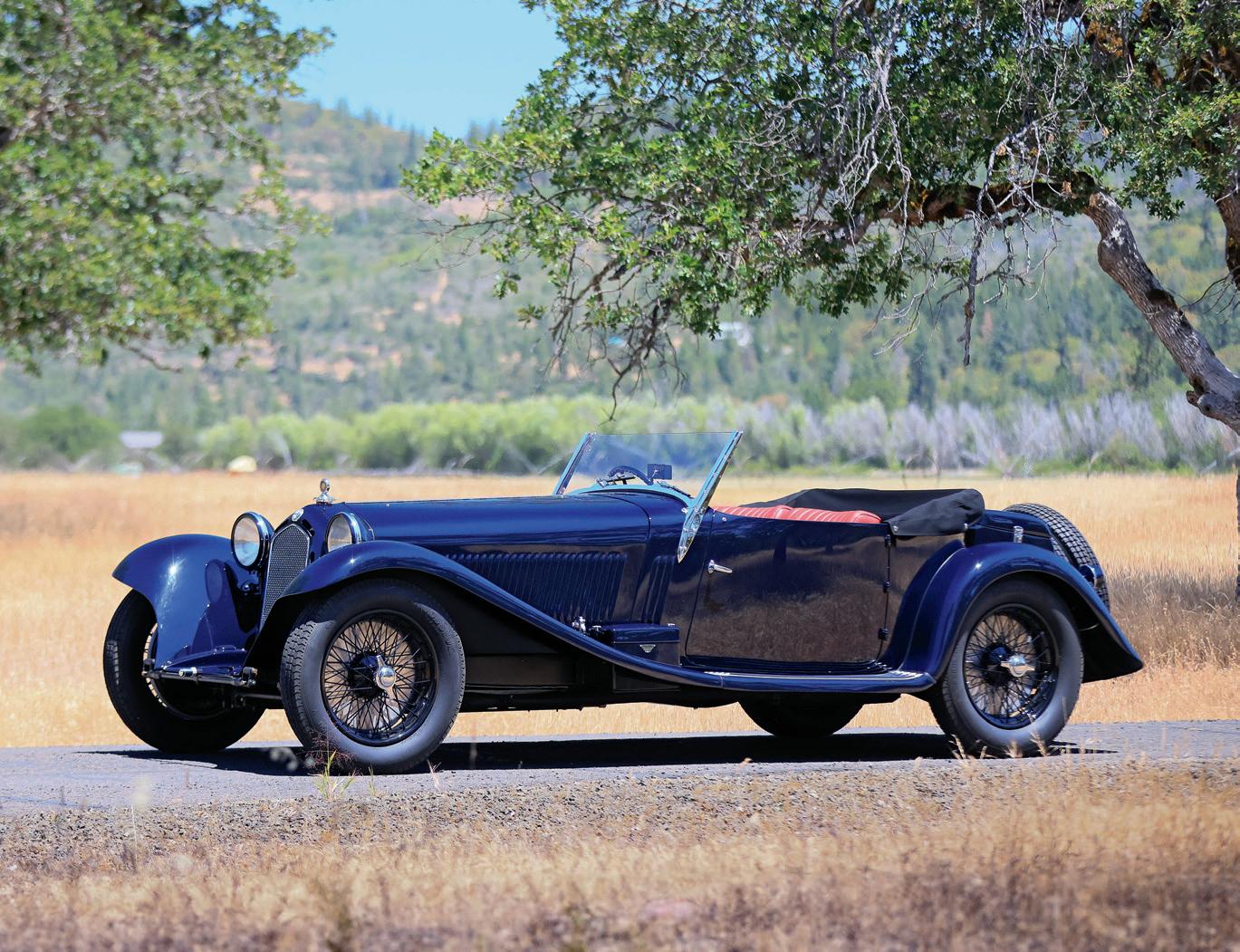












SATURDAY AUG 16 AT 11AM


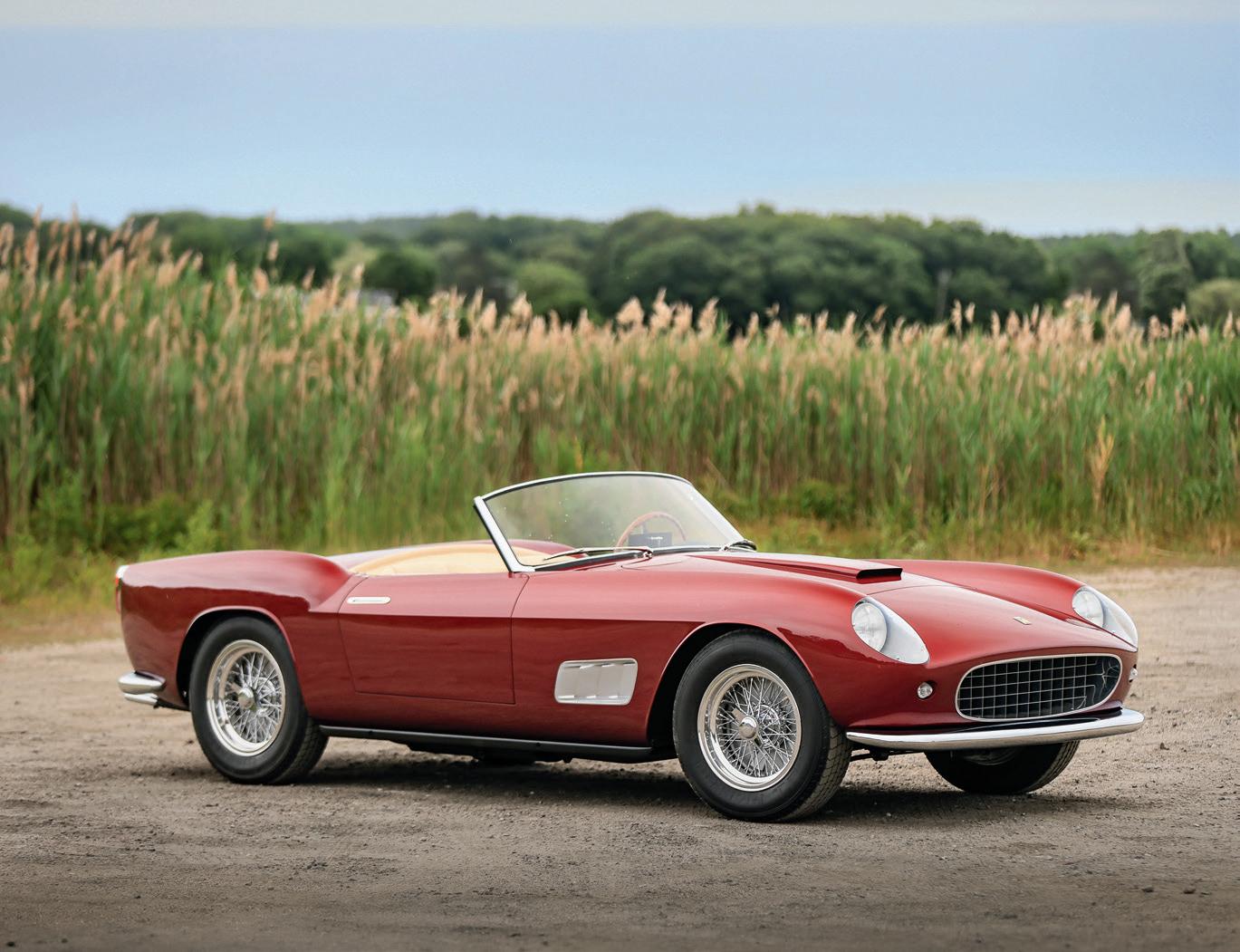
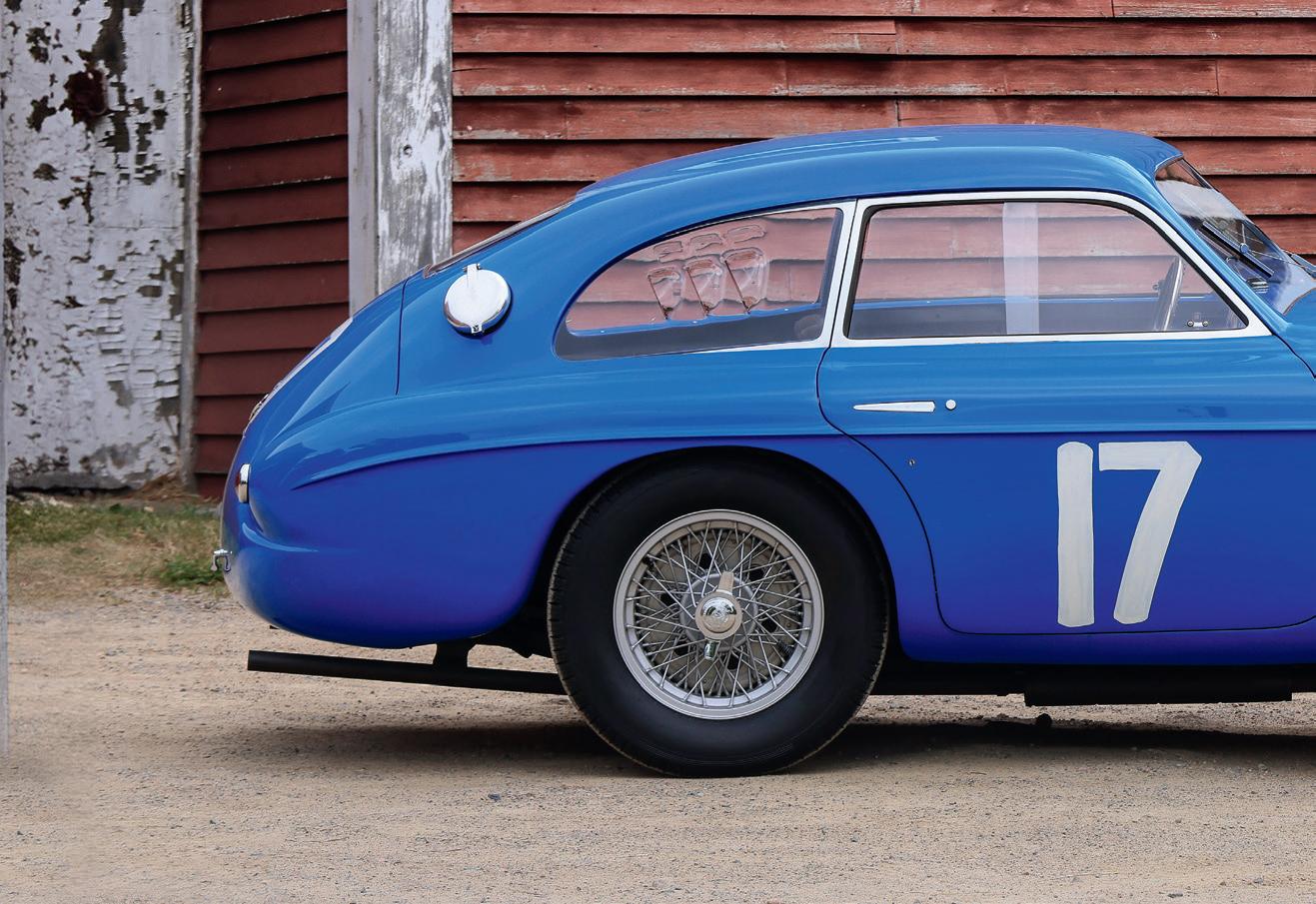
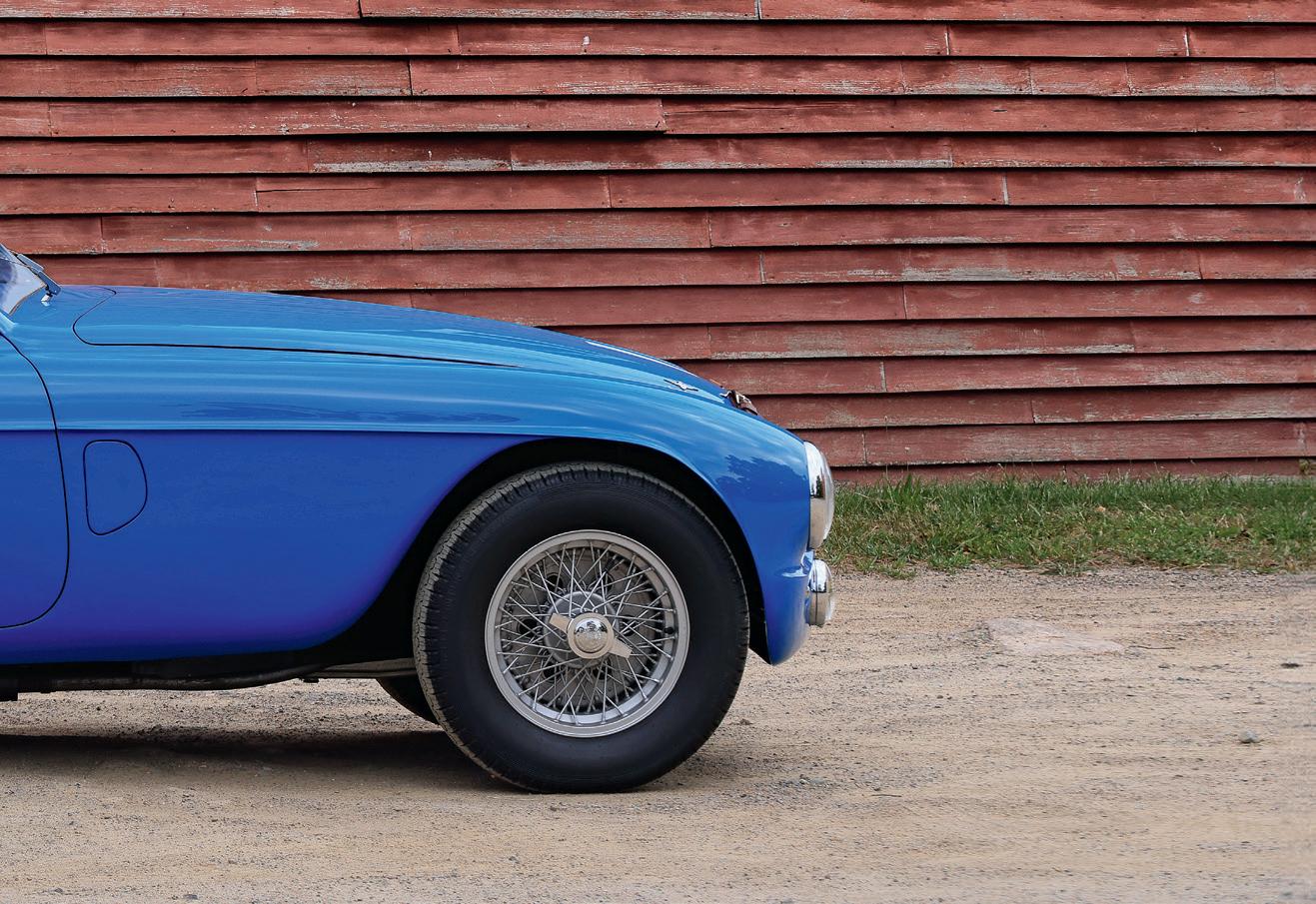














SATURDAY AUG 16 AT 11AM





Friday, August 15 4:00pm PDT
Saturday, August 1611:00am PDT
Food and drinks available for purchase
Catered by Pebble Beach Resorts®
View live auction – goodingco.com
Wednesday, August 13 10:00am–6:00pm
Thursday, August 14 9:00am–6:00pm
Friday, August 15 9:00am–9:00pm
Saturday, August 16 9:00am–5:00pm
Admittance – $50, admits one
Credit card only
Children under 12 free
AUCTION LOCATION
Parc du Concours
Corner of Stevenson Drive and Portola Road
Gooding Christie’s
1120 Forest Ave., Box 101
Pacific Grove, CA 93950-5145
$200, includes admission for two to the viewing and auction with two reserved seats, subject to availability. Submit your Bidder Registration Application online at goodingco.com/register.
In addition to the final bid price, the Buyer is required to pay
Gooding Christie’s a percentage of the final bid price, the Buyer’s Premium. This Auction will have the following Buyer’s Premiums:
• For Vehicle Lots: (a) For a final bid price of $250,000 and below, Gooding Christie’s will receive a Buyer’s Premium of 12% of the final bid price; and (b) for a final bid price of above $250,000, Gooding Christie’s will receive a Buyer’s Premium of 12% on the first $250,000 and 10% on the remainder of the final bid price.
• For Automobilia Lots: Gooding Christie’s will receive a Buyer’s Premium of 25% of the final bid price.
Gooding Christie’s is pleased to offer online bidding on select lots bearing the icon. To learn more, visit bid.goodingco.com or scan the QR code to download our iOS or Android app.
Telephone: 310.899.1960
Fax: 310.526.6594
E-mail: info@goodingco.com
CA Dealer Number 60836
Auctioneer: Charlie Ross, CA Bond Number 70452313
Pebble Beach® and Pebble Beach Concours d’Elegance® are trademarks and service marks of Pebble Beach Company. Used by permission.
From Wednesday to Saturday, general parking will be found in Lot 12, immediately adjacent to our auction location (see Event Map). The entrance to this parking lot is on Forest Lake Road, just a short walk to the viewing and auction.
When Lot 12 has reached capacity, guests will be redirected to parking in Lot 8. The entrance to this lot is on Alva Lane, between Portola Road and Ondulado Road.
ADA parking spaces can be found in Lot 9, at the Pebble Beach Equestrian Center all week long. Shuttles will bring those guests to a shuttle stop at the corner of Stevenson Drive and Portola Road.
The roads immediately around the Gooding Christie’s auction location will be closed Thursday through Sunday by the California Highway Patrol. Guests and vendors with Lot 14 parking passes may bypass the road closures, but only through the gate at Stevenson Drive and Drake Road.
Please read the Conditions of Sale at the end of this Auction catalogue for the full terms and conditions of sale. Each capitalized term used but not defined below will have the meaning assigned in the Conditions of Sale.
Prospective bidders may submit a written Bidder Registration Application or Telephone and Absentee Bidder Registration Application (1) by mail, (2) by email to bidders@goodingco.com, (3) by fax to 310.526.6594, (4) on-site at a Gooding & Company, LLC (“Gooding Christie’s”) auction event, or (5) through online bidder registration available at goodingco.com or through Gooding Christie’s mobile apps for iOS and Android. After submitting your application, a Gooding Christie’s representative will contact you to finalize your registration.
Prospective bidders will be required to complete and execute the applicable registration application forms, provide identification (Driver’s License or Passport for individuals and corporate documentation for companies), and provide an original Bank Letter of Guarantee or other form of proof of ability to pay for purchases, in either case, in an amount and in a form acceptable to Gooding Christie’s in its sole discretion (the “Guarantee”).
Prospective bidders authorize the release of financial information to Gooding Christie’s for the purposes of verifying ability to pay for purchases.
Please ensure that Gooding receives your completed bidder registration form and Guarantee no later than 24 hours before the start of the Auction session in which you wish to bid.
For more information about bidding or registration, please visit goodingco.com/register or email bidders@goodingco.com.
As explained more fully in the Conditions of Sale, bidders are provided an opportunity to inspect all Lots prior to bidding and are invited and strongly encouraged to conduct, and must solely rely upon, their own independent inspection and examination of any Lot and all matters relating thereto before placing any bid. For assistance in inspecting any Lot –including assistance in moving any Lot or in raising any Vehicle to conduct an underside inspection – please contact clientservices@goodingco.com.
While prospective bidders may register to bid in the room prior to the Auction and during viewing hours, it is recommended that registration be completed prior to arriving at the Auction site.
For bidders whose registrations have been completed and accepted by Gooding Christie’s, bidder paddles will be available for collection at the Registration Desk at the front of the Auction venue during viewing hours and the Auction.
Each bidder is personally responsible for any use of the paddle provided to such respective bidder for purposes of identification, and each bidder agrees that it is personally liable for the full Purchase Price (as defined in the Conditions of Sale) if the paddle is used in bidding on any lot whether by the respective bidder or by any other person.
Each bidder, Buyer, attendee or participant by entering the Auction site agrees to comply with all applicable policies and procedures Gooding Christie’s may communicate from time to time, including without limitation any posted signage pertaining to safety, health or other requirements.
In addition to the final bid price, the Buyer is required to pay Gooding Christie’s a percentage of the final bid price, the Buyer’s Premium. This Auction will have the following Buyer’s Premiums:
• For Vehicle Lots: (a) For a final bid price of $250,000 and below, Gooding Christie’s will receive a Buyer’s Premium of 12% of the final bid price; and (b) for a final bid price of above $250,000, Gooding Christie’s will receive a Buyer’s Premium of 12% on the first $250,000 and 10% on the remainder of the final bid price.
• For Automobilia Lots: Gooding Christie’s will receive a Buyer’s Premium of 25% of the final bid price.
The Buyer is responsible for all applicable state and local sales and/or use taxes, duties, tariffs, and license fees on any lot purchased. If Gooding Christie’s is required to collect sales tax on any lot purchased, Gooding will outline that additional tax on the invoice. If Gooding Christie’s is not required to collect sales tax, the Buyer may be required to pay taxes directly to the state or local tax authority. For more information we recommend that you consult with your tax advisor.
Payment of the full Purchase Price must be received by Gooding Christie’s by 5:00pm Pacific Time on Wednesday, August 20, 2025.
The Buyer must make immediate arrangements for the collection and transport of all purchased lots. All lots must be removed from the Auction site at Buyer’s risk and expense no later than 5:00pm Pacific Time on Wednesday, August 20, 2025. Please contact clientservices@goodingco.com for assistance in making removal arrangements.
The Buyer is solely responsible for making arrangements for the collection and transport of any purchased lot, but Gooding Christie’s offers Buyers the following referrals for vehicle transportation:
Domestic Transportation Intercity Lines, Inc.
Jim Bergeron 800.221.3936
jim@intercitylines.com
International Transportation CARS Worldwide Jenny Rixford 415.914.1504
jenny.rixford@carsworldwide.com
Any lot not removed by Wednesday, August 20, 2025, will be assessed a storage fee of up to $50 per day in addition to a fee for removal from the Auction site. Buyer hereby grants Gooding Christie’s an irrevocable power of attorney to remove and store purchased lots at a third-party or other warehouse at Buyer’s risk and expense.
Gooding Christie’s does not permit any photography, audio, video, or other recording or broadcast of any kind inside any bidding tent without an official Gooding Christie’s-issued press pass and an executed photography and video agreement, and any photography, audio, video, or other recording captured outside the bidding tent is solely for personal use and shall not be redistributed or rebroadcast in any medium, nor used for any commercial purpose.
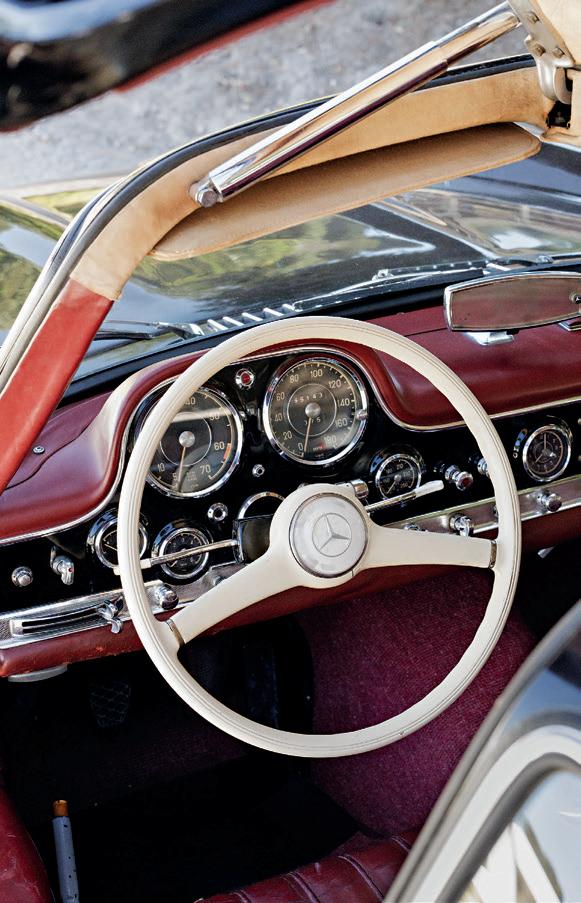
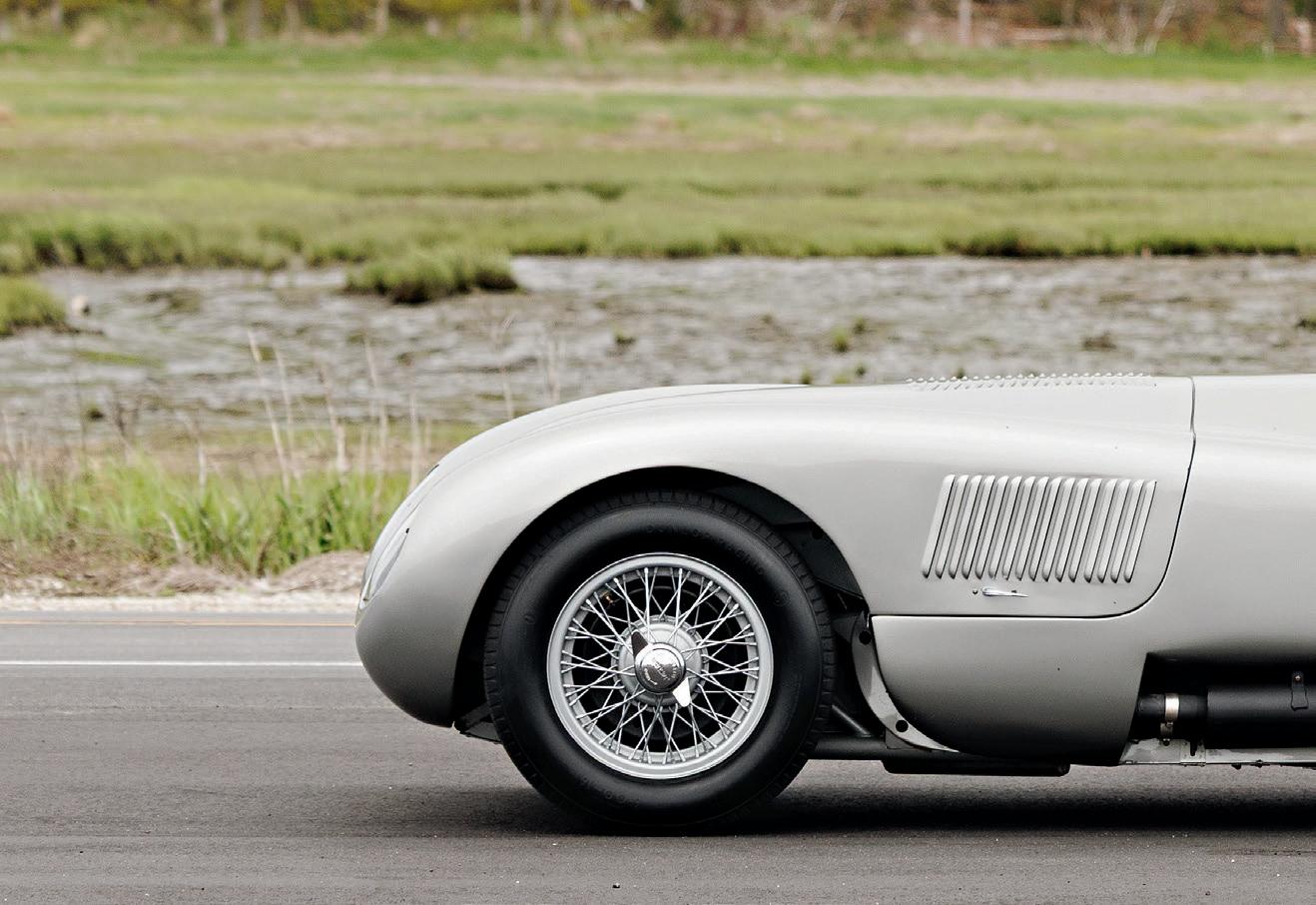
148 | 1952 JAGUAR C-TYPE

310.899.1960
SPECIALISTS
David Gooding President david@goodingco.com
Rupert Banner 929.709.1959
rupert@goodingco.com
David Brynan
310.701.4323
dbrynan@goodingco.com
Lance Butler
310.384.8015 lance@goodingco.com
Angus Dykman
310.266.0699 angus@goodingco.com
Justin Gosaynie
310.699.7796 justin@goodingco.com
Chubb Insurance
866.324.8222
www.chubb.com/personal
Garth Hammers
310.266.0065 garth@goodingco.com
Cameron Luther 571.438.5662 cameron@goodingco.com
Ben Willis +44.7506.526.075 ben@goodingco.com
Mathieu Heurtault
Consultant (European Specialist) +33.6.653.50240 mathieu@goodingco.com
Anna Meldau
Specialist Manager 310.699.9030
anna@goodingco.com
Intercity Lines, Inc.
800.221.3936
413.436.9511
jim@intercitylines.com
www.intercitylines.com
Casey Ley
Executive Assistant to David Gooding
310.795.3069 casey@goodingco.com
Kate Galston Vice President & General Counsel 310.694.6570 kate@goodingco.com
CLIENT SERVICES
clientservices@goodingco.com
MARKETING
marketing@goodingco.com
MEDIA
Pauline Pechakjian
310.383.7437 pauline@goodingco.com
www.carsworldwide.com
FINANCE/OPERATIONS
Morgan Carter Vice President
310.266.0669 morgan@goodingco.com
Nathan McNeil 805.407.2428
Gooding & Company, LLC is now part of the Christie’s group of companies. Founded in 1766, Christie’s is a world-leading art and luxury business with a physical presence in 46 countries throughout the Americas, Europe, Middle East, and Asia Pacific, and flagship international sales hubs in New York, London, Hong Kong, Paris and Geneva. Please visit christies.com for more information.

SECOND EDITION
BY DR. FREDERICK A. SIMEONE, WITH HARRY HURST
PHOTOGRAPHY BY MICHAEL FURMAN
$5,000–$8,000 without reserve
AUTOMOBILIA
The Simeone Foundation Automotive Museum opened in 2008 to showcase the extraordinary collection of racing and sports cars assembled by Dr. Frederick Simeone. That same year, Dr. Simeone and photographer Michael Furman published The Spirit of Competition, a book describing each vehicle’s history, condition, and social impact. Featuring Dr. Simeone’s personal narratives and Furman’s stunning photography, the book became a collector’s favorite and has been sold out for over three years.
Over time, Dr. Simeone’s preservation philosophy – his “automotive Hippocratic oath” to “Do No Harm” – became a globally respected standard. Although Dr. Simeone passed away in 2022, he had already planned a second edition to reflect the museum’s continued growth, now spanning a century of automotive history from a 1907 Renault Vanderbilt Racer to a 2007 Porsche GT3 RSR.
This expanded edition includes all of the original material by Dr. Simeone as well as new commentary by automotive historian Harry Hurst, a longtime collaborator. Michael Furman again provides masterful photography, supplemented by period imagery, advertisements, and rare ephemera.
Coachbuilt Press has reimagined the book in a 12-inch square format, now 444 pages, with 60 additional pages and a refined layout by designer Kerry Polite.
This one-off, special collector’s edition has been hand-bound in imported Florentine calfskin, with a matching clamshell case and custom metal logo. Included are spark plugs from four iconic cars: the 1936 Bugatti 57G, 1938 Alfa Romeo 8C-2900B, 1964 Cobra Daytona Coupe, and 1970 Porsche 917 LH.
The book will be on display at the auction, and the proceeds from the sale will benefit The Simeone Foundation Automotive Museum.
A One-Off Version of the Premium Collector’s Edition Featuring Calfskin Cover, Clamshell Case, and Metal Logo Plate
Revised, 444-Page, Enlarged-Format Book of The Simeone Foundation Collection
Includes Spark Plugs Removed from Four of the Collection’s Most Prominent Cars
Sold to Benefit The Simeone Foundation Automotive Museum
*Please note that the full purchase price for the Lot (which includes the final bid price plus the Buyer’s Premium) will be invoiced directly by the Frederick A. Simeone MD Foundation and that full payment must be made by the buyer directly to the Frederick A. Simeone MD Foundation no later than 5pm on Wednesday, August 20, 2025.
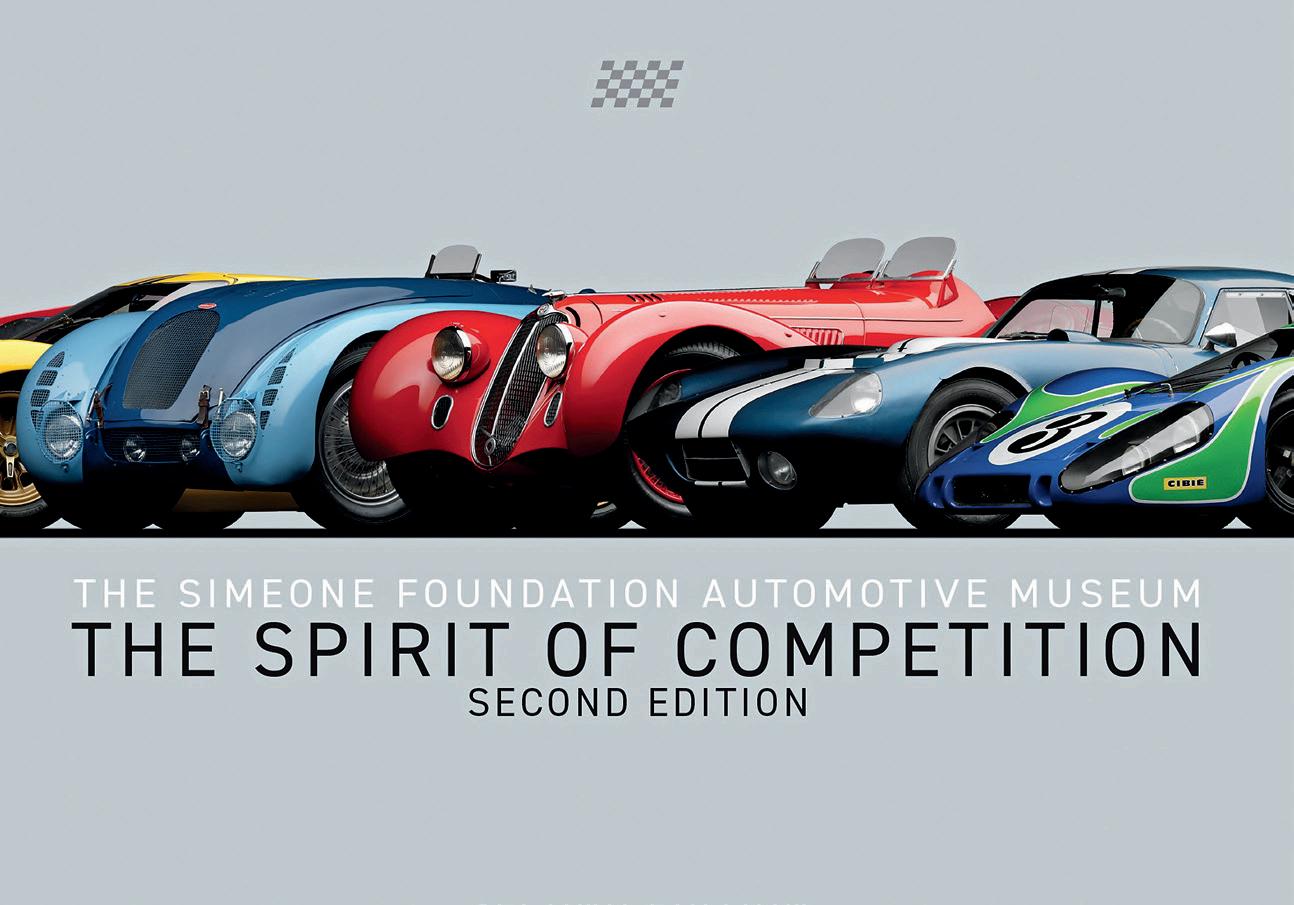

COACHWORK BY HERCULES
ENGINE NO. N2362070AL
$70,000–$90,000 without reserve
Facing a challenging market in 1937, Packard introduced a competitively priced model, the Packard Six. It shared most specifications with the larger 120, yet was priced less than $200 above a comparably equipped Ford. Sales of the more affordable model helped the company endure hard economic times. In 1940, Packard moved the entry-level price point up slightly with the launch of the six-cylinder 110 line. It was an immediate success, selling 63,000 units in the first year. The 110 was available as a two-door or four-door sedan, a convertible, and a station wagon. By the eve of WWII, station wagons had become a symbol of gracious living on country estates and beachside villas alike, and the Packards were the most exclusive available.
In 1941, coachbuilder Hercules supplied 358 bodies to Packard for 110 and 120 chassis, 300 of which were bound for the 110. This 110 Station Wagon is believed by the consignor to be a California car from new. It possesses a charming patina and was exhibited at Movieworld Cars of Stars museum in Buena Park, California, for many years. Following its use in the 1976 film Gable and Lombard, the Packard was purchased by a previous owner from whom the consignor acquired the car in July 1985. Having been recently serviced following long-term static storage, this seldom-seen Packard 110 Station Wagon with wooden coachwork by Hercules would be an ideal example for a concours restoration or enjoyment as is.
One of 300 Packard 110 Station Wagons Built for 1941 Packard’s Six-Cylinder Chassis Paired with Wooden Coachwork by Hercules
Exceptional Provenance with Just One Collector-Owner Since 1985
Exhibited at the Movieworld Museum and Featured in the 1976 Film Gable and Lombard
A Desirable and Versatile Packard Ideal for Touring, Show, and Lifestyle Events
245 CID Inline 6-Cylinder Engine
Single Downdraft Carburetor
100 BHP at 3,000 RPM
3-Speed Manual Gearbox
4-Wheel Hydraulic Drum Brakes
Front Independent Suspension with Coil Springs
Rear Live Axle with Semi-Elliptical Leaf Springs and Shock Absorbers
*Please note that this vehicle is titled by its engine number. Please also note that this vehicle has been in long-term static storage and may not be currently operational. It will require mechanical attention prior to road use.
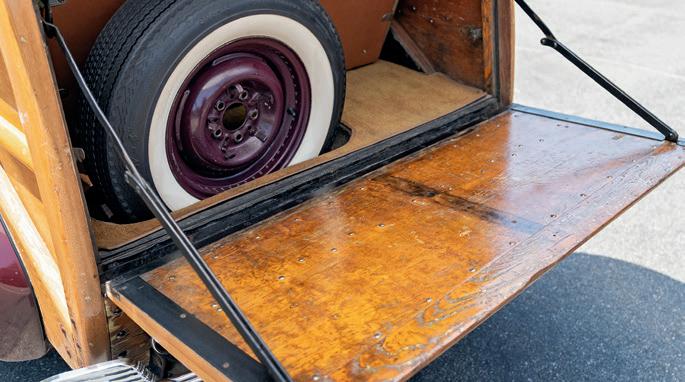

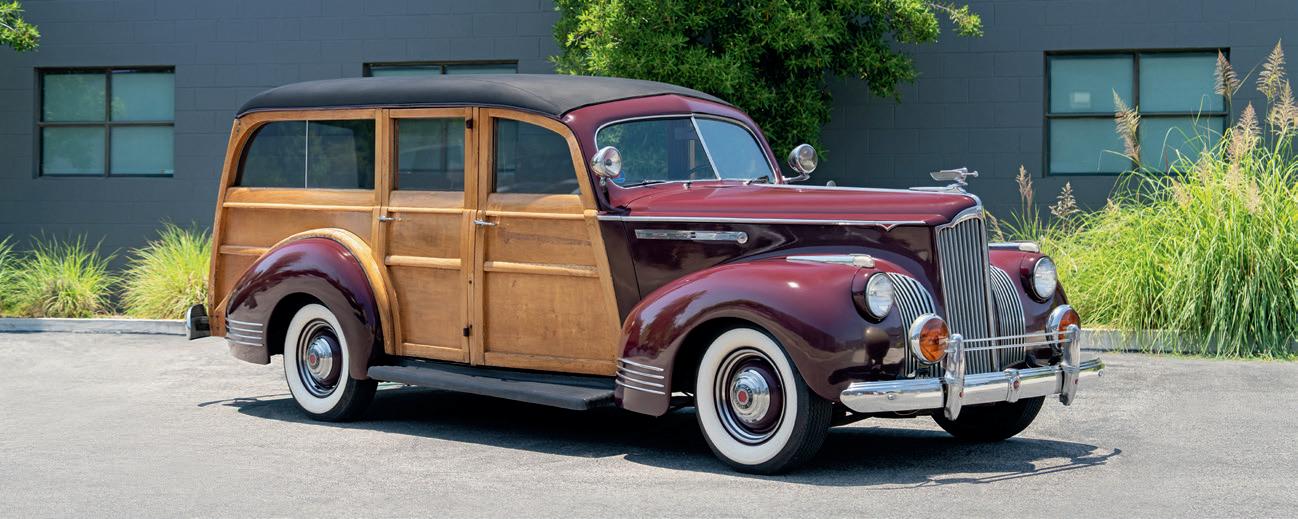

CHASSIS NO. 23132
ENGINE NO. 100 GLC
$50,000-$70,000 without reserve
White began producing steam-powered cars in 1900, quickly earning a reputation for quality. As the industry shifted toward internal combustion engines, White introduced its own gasoline model in 1910. The new cars were so successful that steam production ended by 1911, marking White’s full transition to gasolinepowered automobiles.
This White Model 4-45 is a time-capsule example of what is regarded as the first dual-cowl production car built in America, with handsome styling by Leon Rubay. It was purchased new in 1915 by William Mohr, a noted iris-hybridizer and plant breeder from Central California. Little is known about Mr. Mohr’s use of this White. In summer 1923, while en route to a picnic in a friend’s car,
Offered from Single Family California Ownership from New A Rare Gasoline-Powered White; Only Offered in 1915 and 1916
Rare Seven-Passenger Touring Model with Styling by Leon Rubay
Incredibly Untouched Example with Remarkable Patina
Accompanied by Extraordinary File of Original Documentation Including Its Instruction, Bosch Magneto, and Stewart Vacuum Gasoline System Manuals
Mr. Mohr and his family were struck by a train at the S. P. railroad crossing on the Hayward-Mt. Eden Highway. Tragically, the accident claimed the lives of William, his wife, and 3 others. Only their daughter, Marian Mohr, survived the incident. Marian retained the family cars, carriages, and bicycles in the farm barn. Benefiting from the relatively mild climate of Northern California, the White has remained in outstanding, unrestored condition for the past 102 years, complete with its original documentation and California license plates. Not only does this present a rare opportunity to acquire a White Model 4-45, but it is also an exceptionally remarkable chance to obtain a highly preserved, unrestored Nickel Era automobile that has remained in single family ownership since new.
361 CID 4-Cylinder Inline Engine
Single Carburetor
45 HP
3-Speed Manual Gearbox
Rear Hand-Operated Mechanical Drum Brakes
Front and Rear Leaf-Spring Suspension



FROM THE MOHR-FRY COLLECTION
CHASSIS NO. 6005
ENGINE NO. L238
$100,000-$150,000 without reserve
Founded in 1858 by Thomas White, the White Manufacturing Company originally produced sewing machines, before shifting to building automobiles in the emerging auto industry. In 1900, Thomas’ son, Rollin, received a patent for his semi-flash boiler, and by October the first car had been completed. White automobiles quickly earned a reputation for quality, reliability, and performance.
This 1908 White Model L was purchased new by William Mohr, a noted iris-hybridizer and plant breeder in California. Little is known about Mr. Mohr’s use of this White. In summer 1923, while en route to a picnic in a friend’s car, Mr. Mohr and his family were struck by a train at the S. P. railroad crossing on the Hayward-Mt. Eden Highway. Tragically, the accident claimed the lives of William, his wife, and 3 others. Only
HIGHLIGHTS
Exceptional Single Family Ownership from New Incredibly Well-Preserved Example with Attractive “Roi des Belges” Coachwork
One of the Most Sought-After Steam-Powered Automobiles
One of Only Twelve 1908 Examples Known to Exist
Exciting Preservation Class Candidate
their daughter, Marian Mohr, survived the incident. Marian retained the family cars, carriages, and bicycles in the farm barn. The mild climate helped preserve this White in remarkably good condition – most notably the leather interior, which looks untouched. Moreover, on initial inspection the factory-supplied owner’s and operation manuals were found safely housed beneath the driver’s seat.
This is a once-in-a-lifetime opportunity to acquire an exceptionally high-quality 1908 White Model L – one of only 12 known survivors – retained in single family ownership since new, fantastically preserved in a barn since 1923, and never restored. This extraordinary automobile would make an outstanding addition to an early automobile collection.
SPECIFICATIONS
2-Cylinder Steam Engine
20 HP
2-Speed Manual Transaxle
Hand- and Foot-Operated Rear Mechanical Drum Brakes
Front and Rear Solid Axles with Semi-Elliptical Leaf Springs
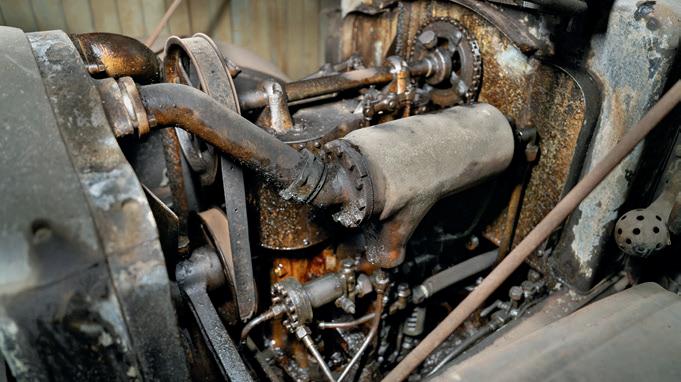
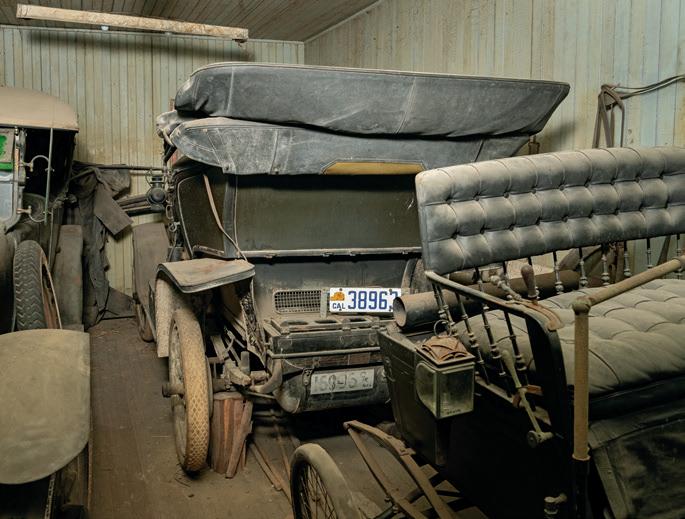
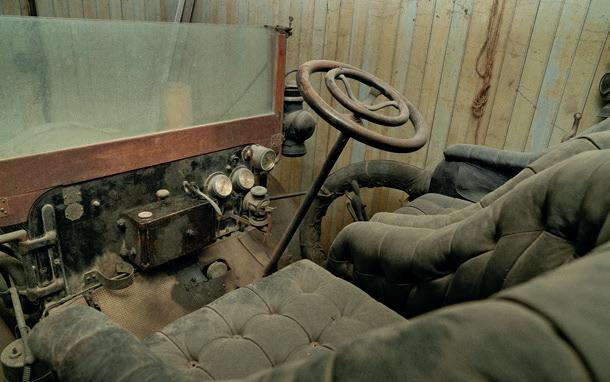
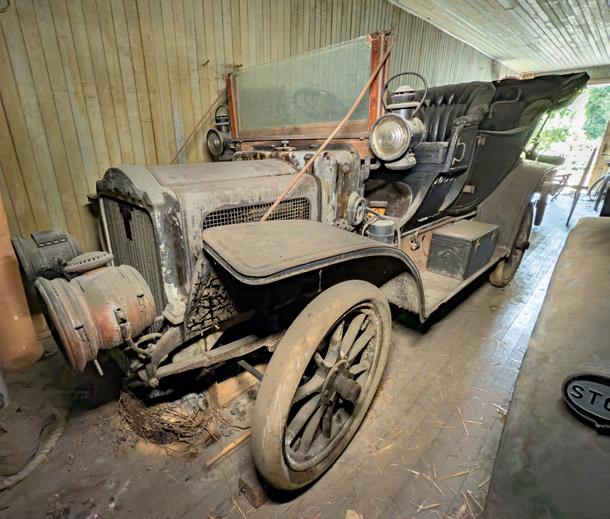

CHASSIS NO. 500418S
ENGINE NO. 961767
$250,000–$325,000
The 1967 model year was a particularly pivotal one for Porsche. The 911’s third full-production year saw the introduction of the high-performance S model, as well as the first variant to include a removable roof panel, dubbed the Targa. The 911 S featured 23% more horsepower, as well as an upgraded suspension with adjustable KONI shocks. The earliest examples of the Targa featured a zip-out, “soft” rear window, which provided a more complete open-air experience. The S was sold in both Coupe and Targa body styles, with the sought-after latter version being exceptionally rare, as just 483 of the 2.0 S Targas were built for the 1967 model year.
This 911 2.0 S Targa has undergone a meticulous, ground-up restoration utilizing
HIGHLIGHTS
One of Just 483 Examples Built for 1967
Documented, Concours-Level Restoration Performed by Noted Specialists; Class Winner at 2016 Carmel Concours on the Avenue
Retains Matching-Numbers Engine and Transaxle per Accompanying Porsche COA
Accompanied by Books, Tools, Jack, and Extensive Volume of Records
An Exceedingly Rare Short-Wheelbase 911; A First-Year S Soft-Window Targa
respected specialists and materials. The engine was rebuilt by the renowned David Loop European in Monterey, while the body was refinished utilizing Glasurit products. The original Fuchs wheels were refinished by Harvey Weidman. Each component has been refurbished to superb condition, down to the steering wheel, wipers, and instruments.
Accompanied by extensive restoration records, fitted with a pair of rare, optional Recaro sport seats, and presented in its original Polo Red color, this refined, short-wheelbase 911 S Targa welcomes your thorough inspection and represents a seldom-seen opportunity to acquire a landmark piece of Porsche 911 history in outstanding form.
1,991 CC Air-Cooled SOHC Flat 6-Cylinder Engine
Twin Weber 40 IDS Carburetors
160 BHP at 6,600 RPM
5-Speed Manual Transaxle
4-Wheel Hydraulic Disc Brakes
4-Wheel Independent Suspension with Torsion Bars
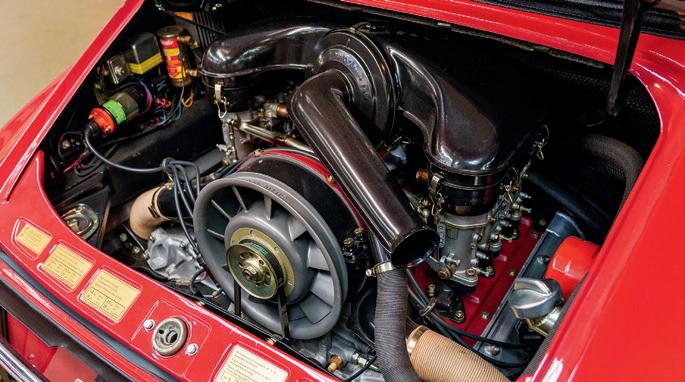



CHASSIS NO. KB016
$275,000–$325,000 without reserve
Frank Kurtis of American racing fame built the first prototype Kurtis Sports Car in 1948. It caused such a sensation that he began manufacturing the curvaceous automobile in 1950. Divinely understated, the Kurtis was powered by the formidable 331 cid Cadillac V-8 engine and Cadillac three-speed gearbox. The first production model achieved 142 mph at Bonneville and made the front cover of the premier issue of Motor Trend magazine. Only 16 Kurtis cars were built in Glendale, California, before Earl “Madman” Muntz moved production to Illinois under the Muntz Jet banner.
This Kurtis Sports Car is the final example of the 16 built by Frank Kurtis in California and is believed to be the only one retaining its original Kurtis brass
The Last of 16 Cars Built in Glendale, California, by Frank Kurtis
Featured in the Film Johnny Dark (1954) Starring Tony Curtis
Sold New to IndyCar Team Owner Jack B. Hinkle
Concours-Standard Restoration by Arlen Kurtis, Son of Frank Kurtis
Accompanied by a Copy of Automobile Quarterly Signed by Arlen Kurtis
firewall chassis plate. It was purchased new by IndyCar team owner Jack B. Hinkle, who loaned the Kurtis to Hollywood for the 1954 film Johnny Dark, starring Tony Curtis. Becoming the car’s fourth owner in 1995, Steve Gilkey commissioned Arlen Kurtis, son of Frank Kurtis, to perform a concours-standard restoration, and retained ownership until 2017. In present ownership, the Kurtis has received further refinement including work to the suspension and installation of appropriately sized tires to further improve its ride quality. The rare Kurtis is offered with restoration records and a copy of Automobile Quarterly signed by Arlen Kurtis. Highly prized for its provenance and heritage as one of America’s earliest pure sports cars, this Kurtis offers a unique snapshot of automotive history.
331 CID OHV Cadillac V-8 Engine
Twin Downdraft Carburetors
Estimated 160 BHP at 4,000 RPM
3-Speed Manual Gearbox
4-Wheel Hydraulic Drum Brakes
Front Independent Suspension
Rear Live Axle with Semi-Elliptical Leaf Springs




CHASSIS NO. 189.033.12.9500367
$250,000–$350,000
Recalling the grandeur of the marque’s prewar luxury models, Mercedes-Benz’s 300 series, introduced in 1951, was a true luxury automobile built on a long wheelbase of near-limousine proportions. Equipped with a stout overhead cam, inline-six, the 300 offered hand-built quality and superior performance.
In 1957, the ultimate variant appeared in the significantly updated and revised 300 D, with advanced Bosch mechanical fuel injection and an optional BorgWarner automatic transmission. These features resulted in greatly improved performance, with the engine developing 180 hp and propelling the car to a top speed of over 100 mph. Though nearly 3,100 sedans were built between 1957 and 1962, just 65 open cars were built during this period, making the 300 D cabriolet one of
HIGHLIGHTS
One of Only 65 W189 Cabriolets Built; Just 23 Examples for 1959
Fitted with Artic Kar Air-Conditioning and Power-Operated Windows
Strikingly Finished in Dark Green over Black; Presented with Jack, Manuals, and Spare
Desirably Equipped with Bosch Fuel Injection and Automatic Transmission
A Rare and Important Member of Any Serious Collection of Mercedes-Benz Touring Cars
*Please note that this vehicle is titled as 9500367.
the most exclusive luxury automobiles of the era as well as one of the rarest Mercedes-Benz convertibles. It had the distinction of being one of very few true six-passenger automobiles capable of high-speed touring. Popular among the world’s elite, as well as West German government officials, the model earned its nickname from its most notable owner, chancellor Konrad Adenauer.
According to a copy of its factory build record on file, this elegant 300 D Cabriolet was delivered on October 6, 1959 to a Mr. Fairchild, via the firm’s South Bend, Indiana, distributorship. The document indicates that the car was finished in Tobacco Brown (DB 423), with Natural leather interior (code 1068) and a beige canvas top. It was further optioned with the automatic transmission,
2,996 CC Inline SOHC 6-Cylinder Engine
Bosch Mechanical Fuel Injection
180 BHP at 5,300 RPM
3-Speed BorgWarner Automatic Transmission
4-Wheel Vacuum-Assisted Drum Brakes
Front Independent Suspension with Coil Springs
Rear Swing-Axle Suspension with Coil Springs



power-assisted steering, a special clock, and a Becker Mexico radio. It has since been fitted with an aft-mounted Artic Kar air-conditioning unit as well as the intriguing update of power-operated windows.
This 300 D Cabriolet presents today in a beautiful and highly appropriate Dark Olive Green (DB 291), accented by black leather displaying an inviting light patina, piped in white throughout the spacious passenger compartment, and finished with a black canvas top and boot. The interior is lavishly appointed with varnished wooden door caps and dash panels, which are fitted with dozens of pieces of chrome-plated switchgear. White sidewall tires and chrome wheels beautifully balance the 300 D’s massive presence as does the exterior brightwork. In recent years, the 300 D has been a fixture in respected collections prior to its acquisition by the consignor. Recent tuning was performed by a factory-trained Mercedes-Benz mechanic, which included the replacement of the fuel pump, and the Cabriolet is offered with its jack and manuals in their proper folio.
The most exclusive European touring car of its day, and the largest open, owner-driver postwar model offered by Mercedes-Benz, the 300 D is truly in a class by itself and is a showcase of mid-century opulence, in terms of both style and engineering.
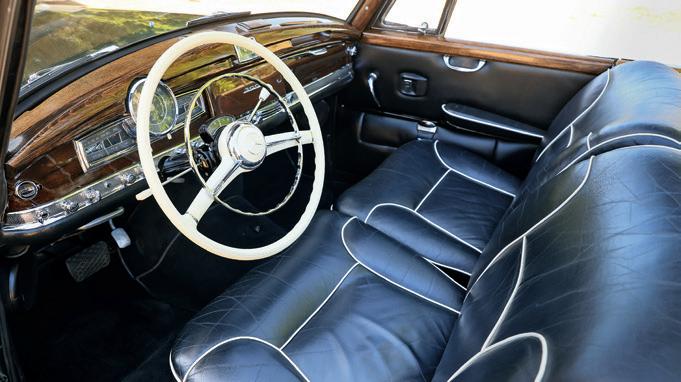


CHASSIS NO. 5691221
$100,000–$120,000 without reserve
Ford Motor Company’s flagship Continental Mark II was the launch product of the Continental Division of Ford Motor Company, with dedicated assembly facilities in Wixom, Michigan. Emphasizing elegance over flamboyance, with uncluttered styling, the Continental Mark II was largely hand built using only the finest materials. Power was provided by a purpose-built, dynamometer-tested 368 cid V-8 engine, developing 285 hp and paired with Lincoln’s proprietary three-speed Turbo-Drive automatic transmission. Continental Mark II buyers could choose from 19 standard exterior colors and 43 interior schemes with five fabric options. Despite an initial sticker price nearing $11,000, Ford reportedly lost thousands on every Mark II built. Conceived at the height of postwar automotive fashion, the 1955 debut of the Continental Mark II in Paris
HIGHLIGHTS
Celebrated Automotive Design Statement
One of Just 3,005 Examples Built from 1956 to 1957
Equipped with Rare, Optional Air-Conditioning
Formerly Part of the Ronald Lauder Collection
AACA Senior National First Prize Winner in 1990
was fitting. Production included 16 pre-production vehicles in addition to 2,417 units for 1956 and 572 for 1957.
Formerly part of the noted Ronald Lauder Collection, this Continental Mark II earned the AACA Senior National First Prize award in 1990. Featuring a well-preserved restoration, this Continental Mark II features striking livery, comprising a black exterior finish over a white leather interior accented by green carpets and trim. Desirably equipped with factory air-conditioning, this Mark II is completed by distinctive turbine-style wheel covers, shod in wide whitewall tires. As offered, this rare, elite-level 1950s classic marks an outstanding example of mid-century style, power, and opulence.
368 CID OHV V-8 Engine
Single 4-Barrel Carburetor
285 BHP at 4,800 RPM
3-Speed Turbo-Drive Automatic Transmission
Front Independent Suspension with Coil Springs
Rear Live Axle with Semi-Elliptical Leaf Springs
*Please note that this vehicle is registered as a Lincoln.
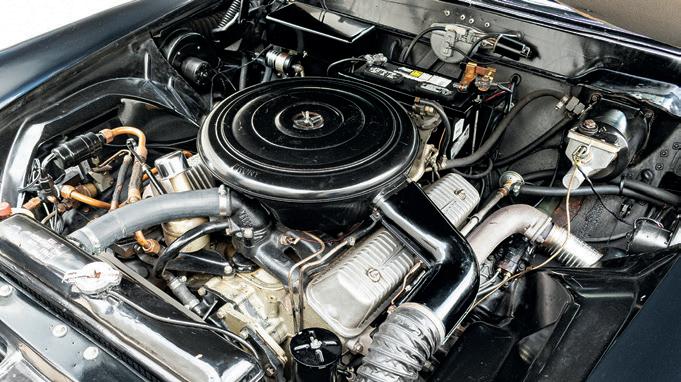

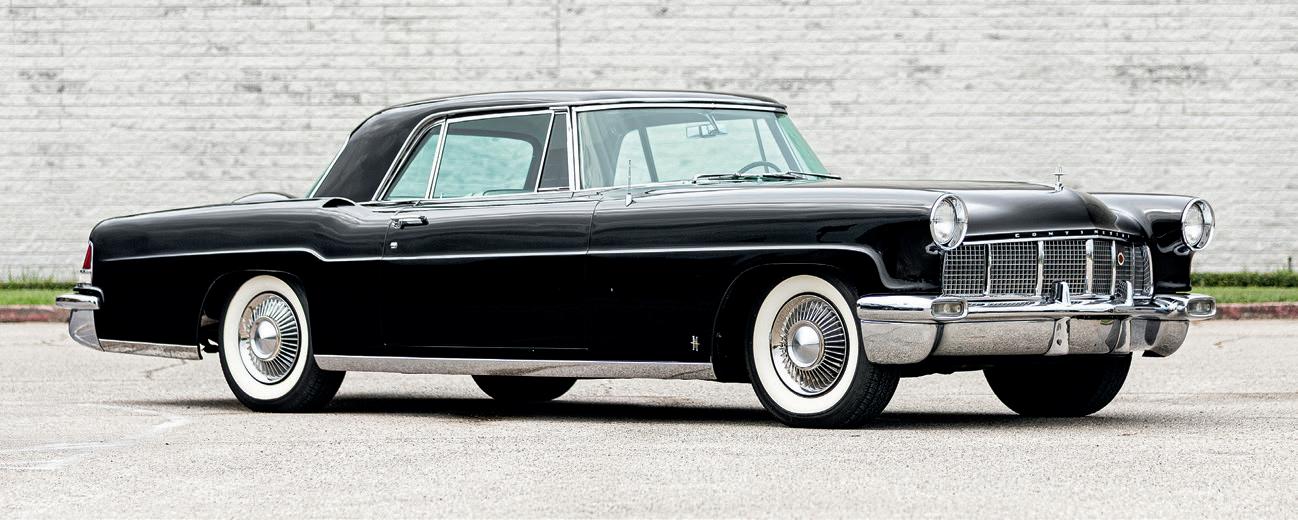

CHASSIS NO. 40661
ENGINE NO. 565
$375,000–$450,000
According to copies of the Bugatti ledgers, reproduced in the American Bugatti Club Register, the Type 40 Grand Prix presented here was built much as it appears today. The original format was the iconic, four-place Grand Sport, which cleverly played on the hugely successful Grand Prix cars’ looks – only with space for passengers. It was fitted from new with engine no. 565, the unit it retains today. Long-established Lyon agency Christy, Pangaud & Monestier appears to have purchased the car for stock, as it was invoiced to them on September 10, 1928. Within a week, the firm had sold the car to its first owner, Jean Tisseyre, who used regional dealer plates to drive the car from Molsheim back to Lyon.
To remain in the authentic state it is in today, the first chapter of this car’s life
HIGHLIGHTS
An Original-Bodied Example with Matching-Numbers Engine per Factory Records
Iconic, Popular, Entry-Level Bugatti Model
Long-Term US Car; Known in Club Circles Since the 1970s
Recent Maintenance and New Top, with Work Managed by Sargent Metal Works
Potentially 1000 Miglia Eligible, Subject to Registro Acceptance
*Please note that this
cannot have been too complicated. However, its trail only begins upon its arrival in the US, when it was owned by Joe Dickie. Despite there being a well-known cache of European dealers – such as de Dobbeleer and Loyens – supplying Bugattis to the US, it is not documented as passing through these channels.
From Mr. Dickie, this car passed to noted Bugatti collector Carlton Coolidge, then to his wife upon their divorce. At this point, as with others in the Coolidge’s stable, the Bugatti was given a glitzy concours restoration in Bugatti blue with black fenders, highly polished castings, brightwork, and chrome wire wheels. By the time Ms. Coolidge decided to sell the car, it had been with her for 30 years, tracking the Coolidge family’s ownership back to the 1970s.
SPECIFICATIONS
1,496 CC SOHC Inline 4-Cylinder Engine
60 BHP at 4,500 RPM
4-Speed Manual Gearbox
4-Wheel Mechanical Drum Brakes
Front Solid Axle with Semi-Elliptical Leaf Springs and Lever Shock Absorbers
Rear Live Axle with Quarter-Elliptical Leaf Springs and Lever Shock Absorbers
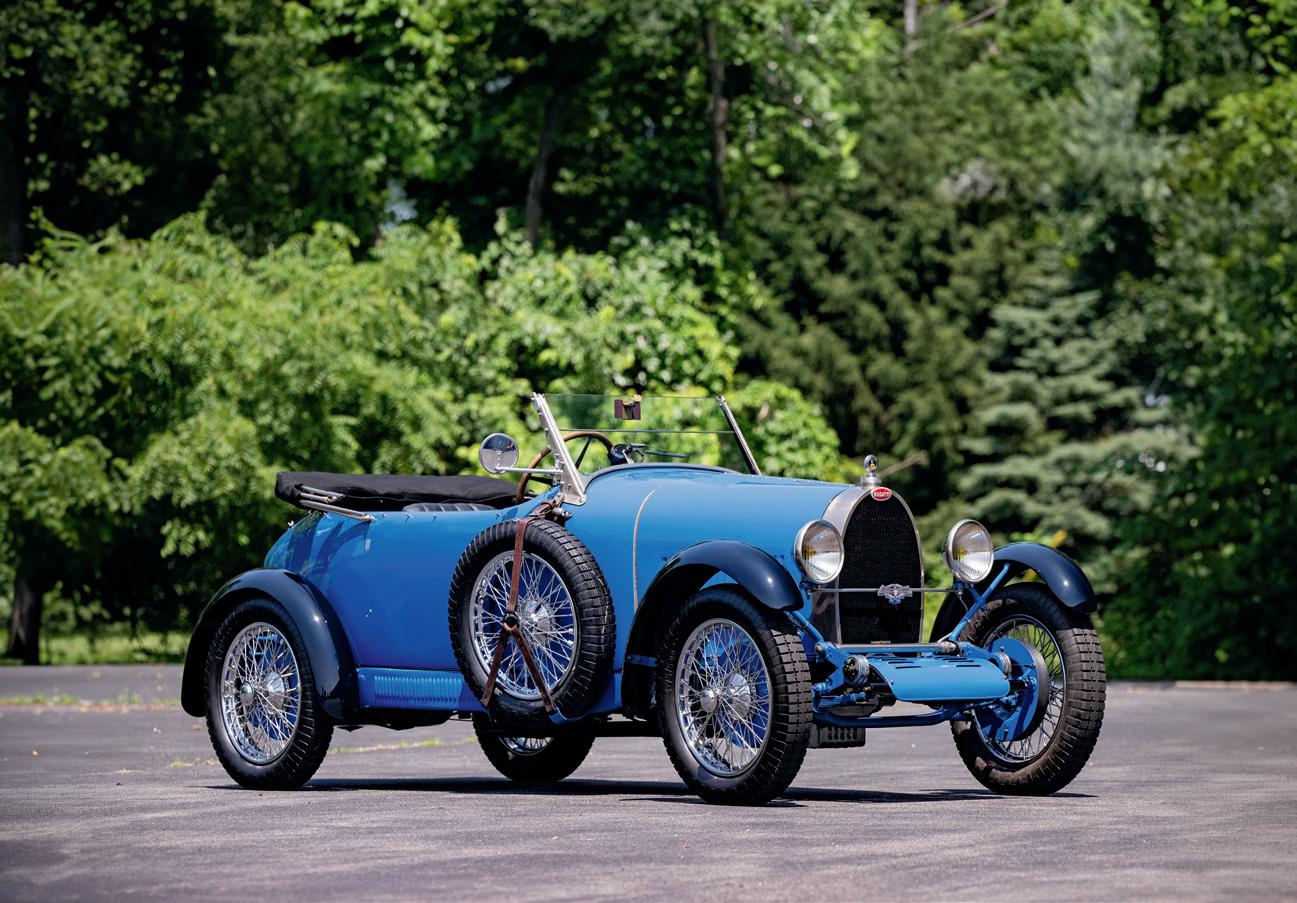

Jean Tisseyre, Lyon, France (acquired new via Christy, Pangaud & Monestier in 1928)
Joe Dickie, US (acquired by 1960s)
Carlton Coolidge, California (acquired from the above circa 1970s)
Cynthia Coolidge, California (acquired from the above)
Blackhawk Collection, California (acquired from the above)
Fred Guyton, St. Louis, Missouri (acquired from the above circa 2000)
Current Owner (acquired from the estate of the above)
Celebration of Automobiles at the Indianapolis Motor Speedway, 2012 (First Place)

Chassis 40661 was next acquired by the Blackhawk Collection, before being sold to St. Louis-based collector Fred Guyton.
Guyton retained the car for 17 years, during which time it was believed to have been among his favorites in his extensive collection. Notably, it was exhibited at the 2012 Celebration of Automobiles at the Indianapolis Motor Speedway, where it earned a First Place award. When eventually sold, 40661 was bought by another serial Bugattiste, who has enjoyed the car over the ensuing eight years, all the while maintaining it and generally improving its already excellent presentation. A new full-length top and weather equipment have been supplied, as well as the wheels shod with new tires, all being managed by Sargent Metal Works.
In its design, the Type 40 balances all of the wonderful ingredients of the marque in this period. It is eminently usable in club events and – owing to its period history – carries the additional benefit of being eligible for the 1000 Miglia, subject to Registro acceptance. This fine, well-kept Type 40 Grand Sport is worthy of close consideration.


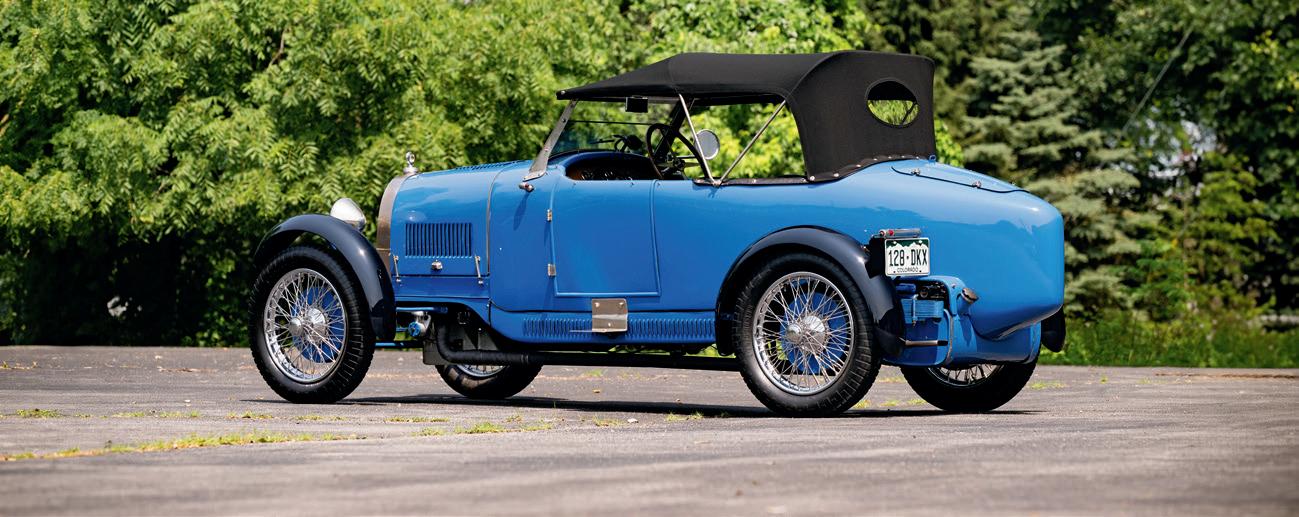
CHASSIS NO. 111.027.12.003442
ENGINE NO. 116.980.12.003047
$300,000–$400,000
Introduced in 1959, Mercedes-Benz’s W111 platform was nothing less than a benchmark of its time: an unmistakable signal of Mercedes-Benz’s reemergence as Europe’s preeminent manufacturer of fine automobiles. Engineered to an exacting standard and styled with graceful modernity by design genius Paul Bracq, the W111 combined restraint and elegance with genuine technological ambition.
That model line reached its most refined and exclusive expression in the 280 SE 3.5 Cabriolet, assembled in Stuttgart between 1969 and 1971. This final iteration elevated the W111 to its apex – both in mechanical sophistication and old-world craftsmanship. Its stately silhouette remained fundamentally Bracq’s,
Offered from over a Decade in a Renowned Private Collection of the World’s Most Important Automobiles
Retains Matching-Numbers Engine per Copy of Factory Data Card
Remains in Its Rare Original Colors of Sand Beige Metallic over a Dark Brown Leather Interior
The Recipient of over $27,000 in Documented Work Since 2019
Accompanied by Original Owner’s Manual, Warranty Plate, and Stamped Service Booklet
but beneath the surface lay the new M116 V-8 engine, a 3.5-liter unit marking Mercedes-Benz’s entry into mass-market, eight-cylinder power. Mated to a four-speed automatic transmission and refined by Bosch’s trailblazing D-Jetronic electronic fuel injection, the 3.5 was both swift and supremely civilized. Just 1,232 cabriolets were built, each painstakingly hand built at a rate of fewer than two per week to standards befitting the model’s not-insubstantial price.
This stunning 3.5 Cabriolet was sold new to Terry Thornton of Palm Springs, California, in February 1971, as documented in its stamped original service book, which also chronicles its early service history at dealers in Hollywood and Riverside. The Mercedes-Benz eventually made its way to the Midwest, where
3,499 CC SOHC V-8 Engine
Bosch D-Jetronic Electronic Fuel Injection
230 BHP at 5,800 RPM
4-Speed Automatic Transmission
4-Wheel Servo-Assisted Hydraulic Disc Brakes
4-Wheel Independent Suspension with Coil Springs
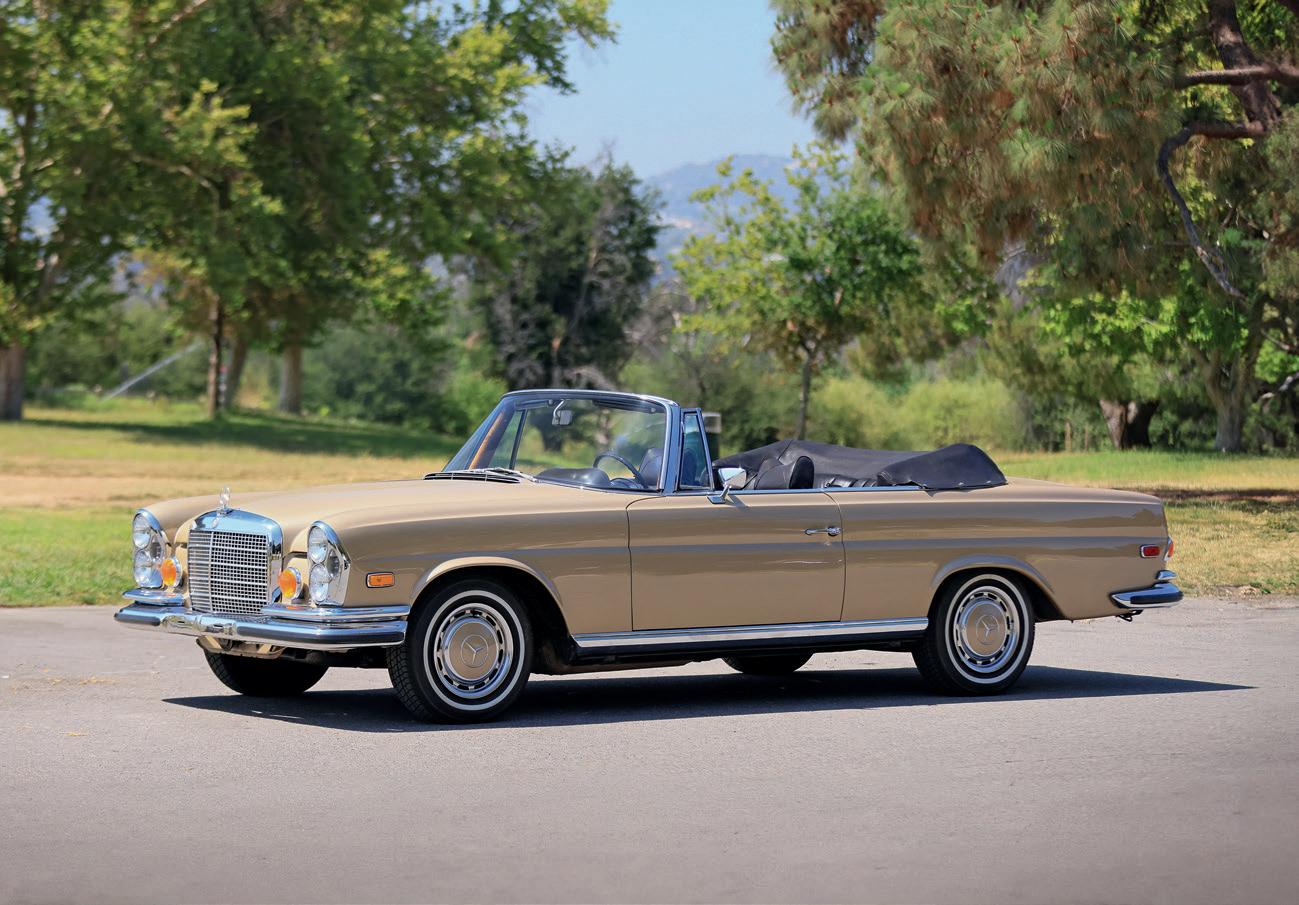

Terry Thornton, Palm Springs, California (acquired new in 1971)
Bill Wirtz, Chicago, Illinois
Merrill Ferguson, Greenwood, Minnesota (acquired in 2003)
Current Owner (acquired from the above circa 2011)

it joined the collection of Bill Wirtz, a friend of noted collector Bill Jacobs and the owner of the Chicago Blackhawks. The consignor, a collector of some of the most significant automobiles in the world, acquired this 3.5 Cabriolet about 11 years ago and it has benefited from over $27,000 in documented work since 2019, including the installation of new speakers and a Becker Europa radio with Bluetooth capability. A testament to its careful ownership, the Cabriolet even retains its original owner’s manual, metal warranty plate, and stamped service booklet, and the consignor believes some of the interior upholstery is original as well.
Today, the 280 SE 3.5 Cabriolet is widely regarded as one of the most collectible Mercedes-Benz models of the postwar era. Its appeal lies not only in its beauty and exceptional build quality but in its unique position at the crossroads of tradition and progress: the end of hand assembly, the beginning of V-8 power, and a design that has only grown more compelling with time. Few cars offer such a satisfying blend of tactile quality and everyday driveability, with true four-passenger capability. For collectors seeking a true grand touring cabriolet – one with pedigree, presence, and the unmistakable aura of classic Mercedes-Benz excellence – this car offers an exceptional opportunity.
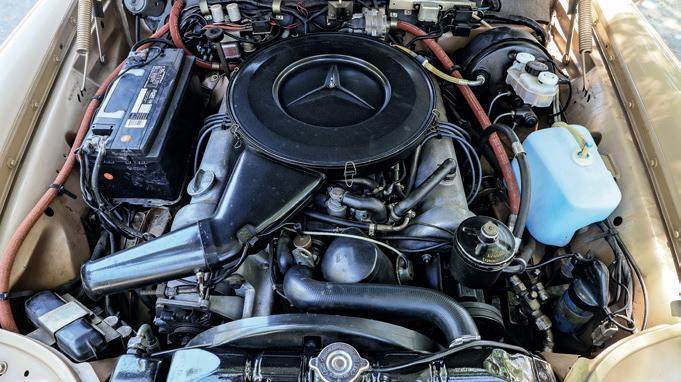

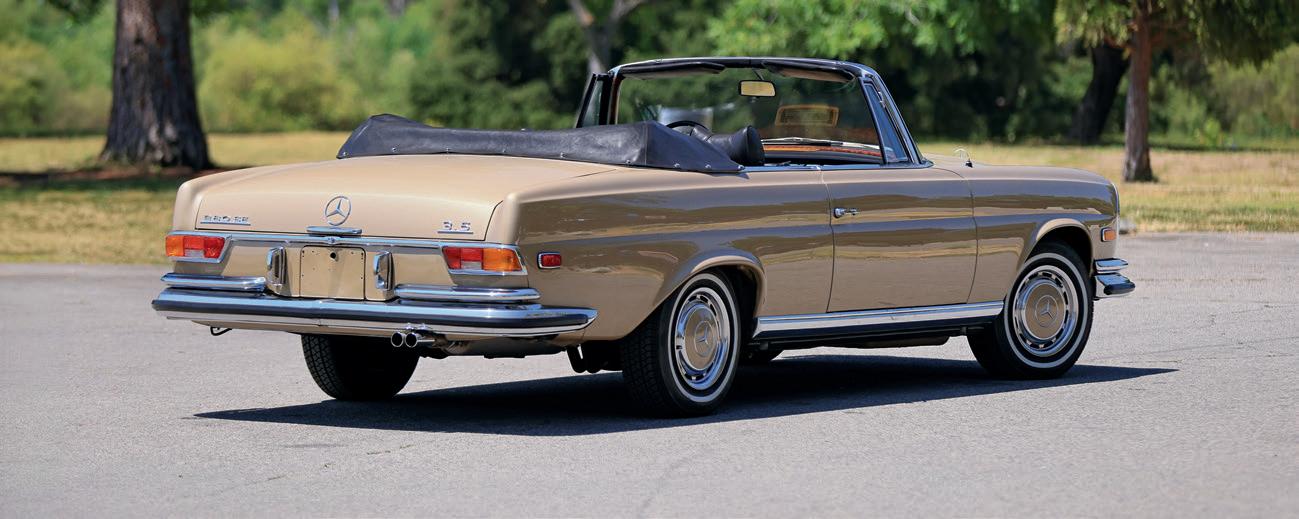
Francis Ford Coppola is one of the most talented and respected filmmakers in the history of cinema. As a director, producer, and writer, many of his films, including The Godfather trilogy, The Conversation, and Apocalypse Now, define their genres. A lesser-known fact is that Mr. Coppola has long had an affection for automobiles, both as a personal passion and as a thematic presence in his work. For many years, Mr. Coppola has maintained a small collection of cars on his idyllic properties that hold special memories and significance for himself and his family.
In 1988, Mr. Coppola directed and released the biographical film Tucker: The Man and His Dream, which had been a project he had hoped to pursue for some time. In the film, Mr. Coppola elevates Preston Tucker to heroic status of David-and-Goliath proportions, as the Tucker Corporation faces overwhelming opposition from the Big Three automakers. A true visionary, Mr. Tucker seeks to revolutionize the automobile in early post-WWII America, with brilliant advancements in safety and design – a goal he is systematically thwarted from achieving. Mr. Coppola’s interest in Tucker went beyond the nostalgic: the
car itself represented disruption and ambition, which in many ways parallels Mr. Coppola’s approach to filmmaking. His personal Tucker automobile is offered here today; it is the 14th of the 51 examples built. The car makes onscreen appearances in the film.
The Ford Model T Touring on offer was purchased in homage to the cars that were used on set in The Godfather Part II. Additionally, the Volkswagen Vanagon Westfalia, while not a star of the big screen, has served an important role as a longtime writing refuge for the highly awarded filmmaker and vintner. Mr. Coppola has often driven the Vanagon, fitted with a custom audio/video system, to various vistas on his vineyard properties to escape the confines of an office and let the creative juices flow; and the car has been a Coppola family favorite for decades.
Gooding Christie’s is honored to have been chosen by Francis Ford Coppola and his family to represent selections from his collection, and we thank him for sharing his unparalleled genius with the world over the past half century.
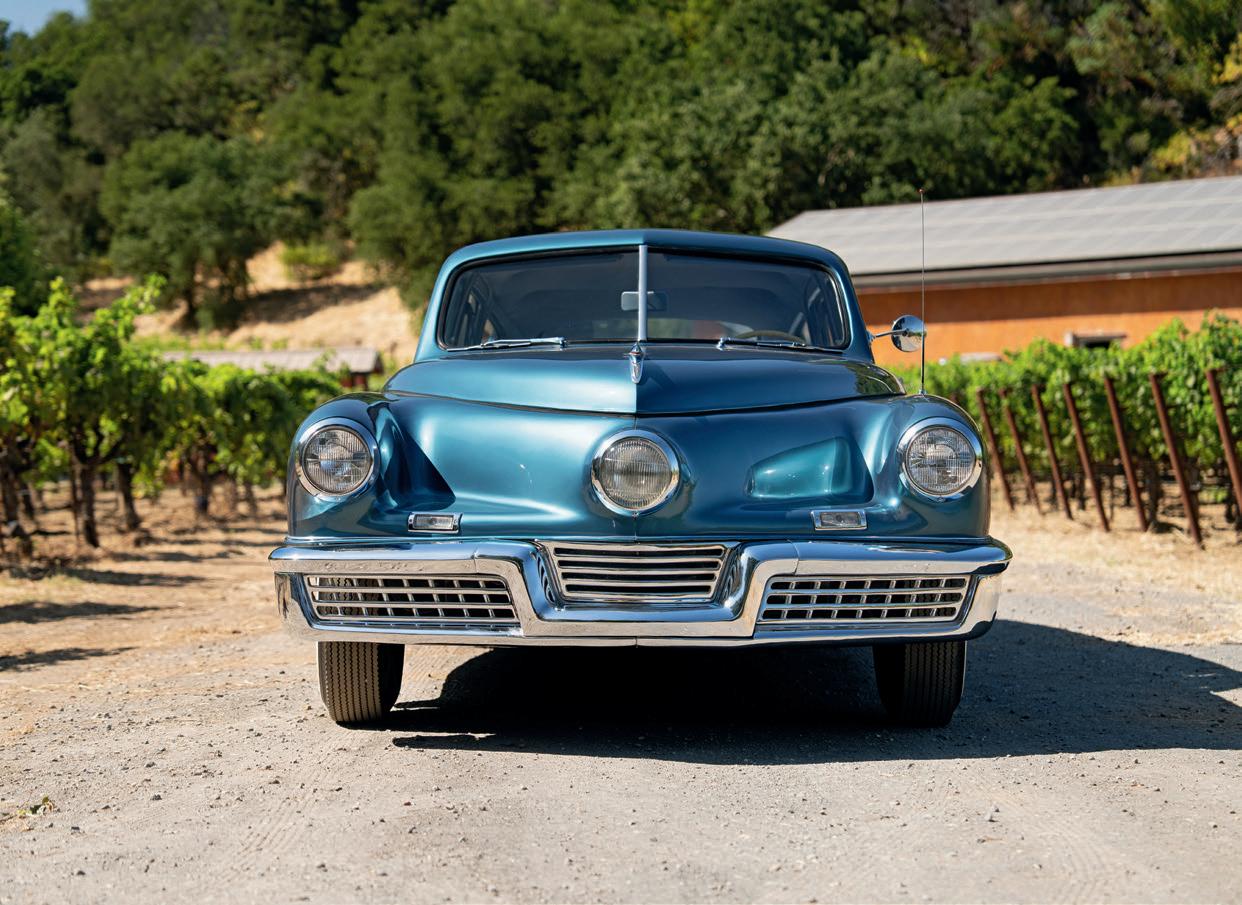
SELECTIONS FROM THE FRANCIS FORD COPPOLA COLLECTION
ENGINE NO. 13182447
$15,000-$25,000 without reserve
Ford introduced the Model T in October 1908 and it remained in production until May 1927, with over 15 million units sold to eager Americans excited to experience the joys and conveniences of motoring. For 1913, the model received several updates, including redesigned bodies, and new fenders. Though Henry Ford famously said, “Any color the customer wants, as long as it’s black,” the policy did not take effect until 1914. In 1913, the Model T was still available in red, blue, gray, and green – the latter option being the striking color of this particular example.
Like many cars from this era, the early history of this Model T is unknown. Following the filming of The Godfather Part II in 1974, Francis Ford Coppola
HIGHLIGHTS
Final Year for Non-Black Exterior Finish
Accompanied by Additional Engine (No. 218122) Dating to 1913
Well Preserved and Original Example
Offered from Esteemed Hollywood Ownership
A Charming Example of Ford’s Model T
*Please note that this vehicle is titled as 218122, which is stamped on the accompanying engine.
developed a fascination with automobiles of this period, which led him to acquire this car. During Mr. Coppola’s ownership, the engine was converted to an electric starter; fortunately, a 1913-series engine remains intact and will accompany the car. Mr. Coppola enjoyed driving the Model T and recalls fond memories of a spirited family trip to Bodega Bay.
Although this particular Model T is not currently in running condition, it represents an excellent basis for a restoration or preservation project. Alongside its spare engine, the car is accompanied by an uninstalled double-pane windshield frame. This Model T Touring presents itself as an exceptional opportunity for any enthusiast of early brass motoring to make tour- or show-ready.
177 CID Inline 4-Cylinder Engine
Single Carburetor
20 HP at 1,600 RPM
2-Speed Planetary Transmission
Dual System Hand-Operated Rear Mechanical Brakes and Foot-Activated
Transmission Brake
Front and Rear Solid Axles with Transverse Leaf Springs
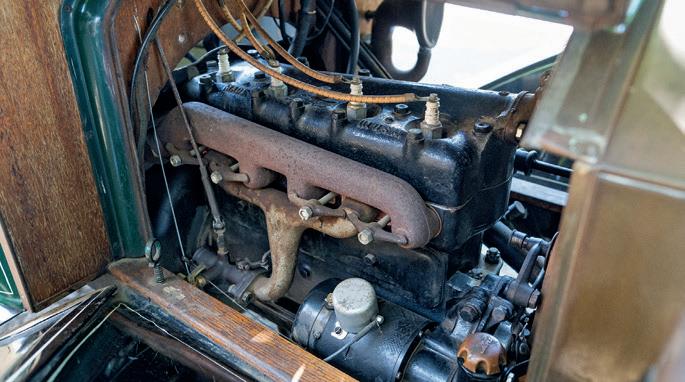
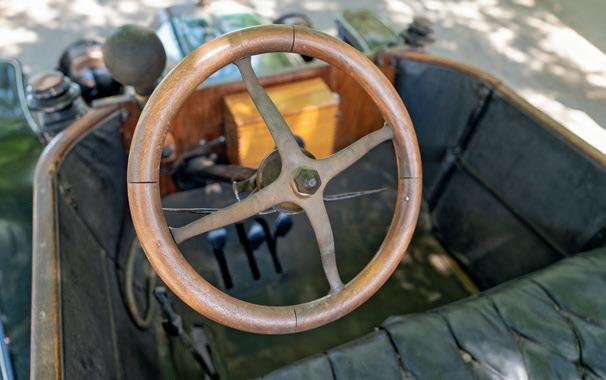
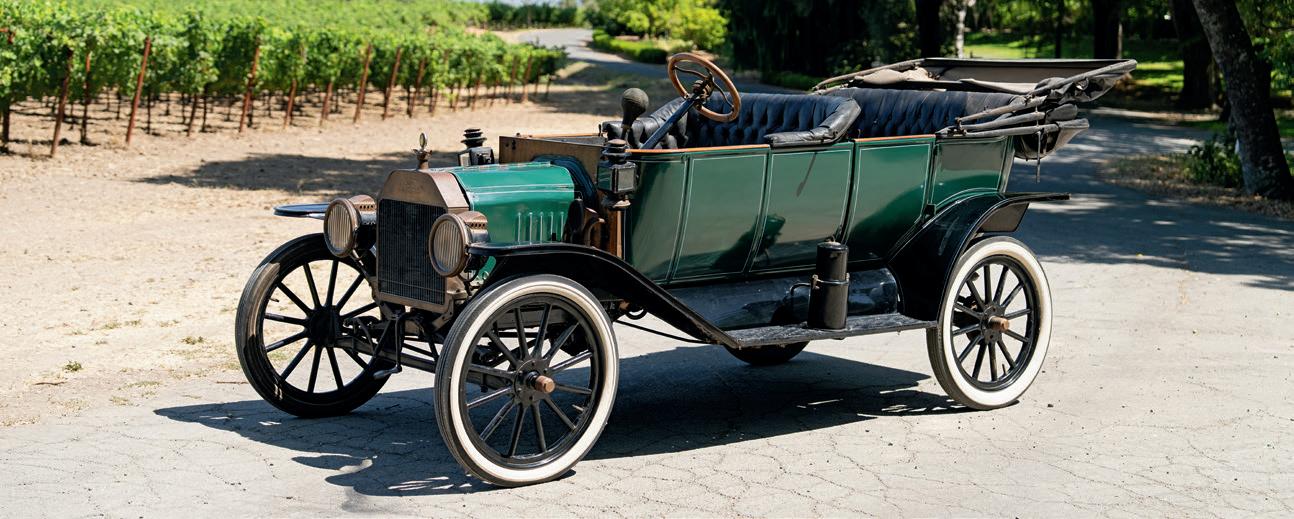
SELECTIONS FROM THE FRANCIS FORD COPPOLA COLLECTION
CHASSIS NO. 1014
$1,500,000–$2,000,000
While America’s “Big Three” manufacturers concentrated on producing lightly updated prewar models to meet the incredible pent-up demand for new automobiles in the years immediately following WWII, smaller independent manufacturers and brash startups launched bold, new designs. Successful industrialist Preston Tucker remains among the most famous of all, with his drive to revolutionize the auto industry with his radical, eponymous creation.
Tucker’s company famously closed in 1949, and conjecture remains as to the causes to this day. His innovative, rear-engine car was poised to set the industry on its ear with its advanced engineering, comprehensive safety features, and futuristic design cues – many of which were later adopted by the Big Three.
Owned by Francis Ford Coppola Since the Late 1970s
Featured in the 1988 Film Tucker: The Man and His Dream
One of Just 12 Tuckers Originally Finished in #200 Waltz Blue Metallic
Road Tested by Famed Automotive Journalist Tom McCahill in 1971
Held in California Ownership Since New
Visionary passenger-safety features included pop-out windshield panels and a padded dash with a safety space below on the passenger-side, affording front-seat occupants safe haven in a collision. Further, a central headlamp switched on and tracked the driver’s steering-wheel inputs beyond 10 degrees to the left or right.
The roomy and sleek fastback body design was penned by talented stylist Alex Tremulis, whose many design credits include work with Gordon Buehrig on the Cord 810/812, the 1941 Chrysler Thunderbolt, and later a lifting-body aircraft design which foreshadowed NASA’s Space Shuttle.
SPECIFICATIONS
355 CID Franklin OHV Flat 6-Cylinder Engine
Single Stromberg Downdraft Carburetor
166 BHP at 3,200 RPM
4-Speed Manual Y-1 Gearbox with Vacuum-Electrical Preselector
4-Wheel Hydraulic Drum Brakes
Front Independent Vulcanized Rubber Sandwich Suspension
Rear Independent Torsilastic Suspension with Coil-Over Shock Absorbers


Charles DeCosta, Auburn, California (acquired new via San Francisco Auto Sales in 1949)
Isadore Rasinsky, California (acquired in 1951)
William Hamlin, Ontario, California (acquired in 1952)
Beverly Ferreira, San Francisco, California (acquired in 1979)
Francis Ford Coppola (acquired from the above circa 1979)
Pebble Beach Concours d’Elegance®, 2018
A proprietary 589 cid engine and dual torque-converter drivetrain were under development but challenges forced replacement by the Franklin O-335 “flat-six” modified from its application in the Bell 47 helicopter. It was converted to liquid cooling and linked to a four-speed, vacuum-electric preselector gearbox adapted and updated from the Cord 810/812 design. Fuel injection and disc brakes were planned features but did not appear on the pilot run of 50 Tuckers built.
The now legendary automotive journalist Tom McCahill was the first member of the press to be invited to road test the all-new Tucker. For the August 1948 issue of Mechanix Illustrated, he drove a Tucker at 105 mph on Cicero Avenue in Chicago, and proclaimed it to be “the greatest performing passenger automobile ever built in this country.”
According to Tucker historical records, this Tucker, the 14th production car built, chassis 1014 finished in Waltz Blue, was dispatched to San Francisco and was purchased new in 1949 by Charles DeCosta, before passing to Isadore Rasinsky two years later. In 1952, 1014 was purchased by the already noted multiple Tucker owner, mechanic, and historian William Hamlin of Ontario, California, showing some 70,000 miles.
Mr. Hamlin provided Tom McCahill with the opportunity to reprise his article
for Mechanix Illustrated in 1971, road testing Tucker 1014. Mr. Hamlin is known to have driven 1014 extensively; in fact, at the time of the 1971 road test, the car had logged over 155,000 miles, making it one of the most road-proven Tuckers of all. For his new article, McCahill drove 1014 on the freeways of Southern California, again attaining 105 mph before easing off the throttle. A brass plaque in 1014’s engine compartment memorializes the event, which also marked the occasion of Tom McCahill’s 25th year with the magazine.
Mr. Hamlin passed away in 1979, and 1014 was soon in the inventory of San Francisco dealer and Tucker specialist Beverly Ferreira. Around that time, Mr. Ferreira sold the Waltz Blue Tucker to Francis Ford Coppola, and a few years later, it was readied for yet another closeup – this time on the big screen.
A native of Detroit, Francis Ford Coppola was drawn to automobiles from an early age, and recalls the excitement that the advertised release of the Tucker generated in the late 1940s. Later in life, when the by-then celebrated filmmaker began to research Preston Tucker, he felt a strong kinship with him. Being a creative idealist and a visionary himself, who has had to contend with powerful hindering forces, there are certainly similarities between the two famous and influential men. It was not long before Mr. Coppola began development on the film, Tucker: The Man and His Dream. The 1988 film was directed by Mr. Coppola,

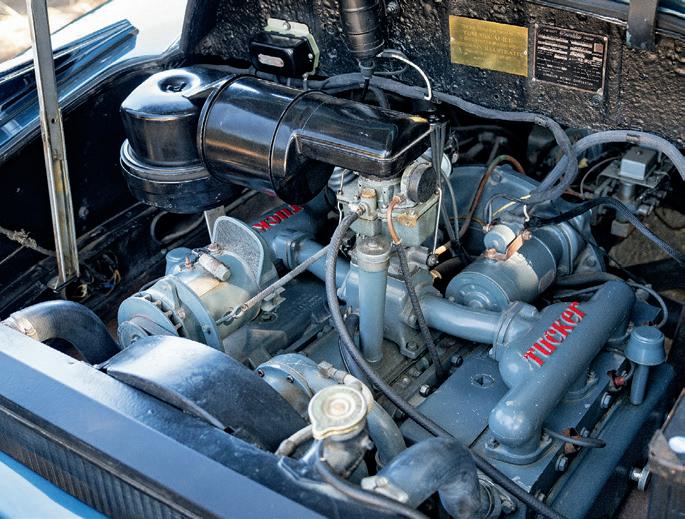
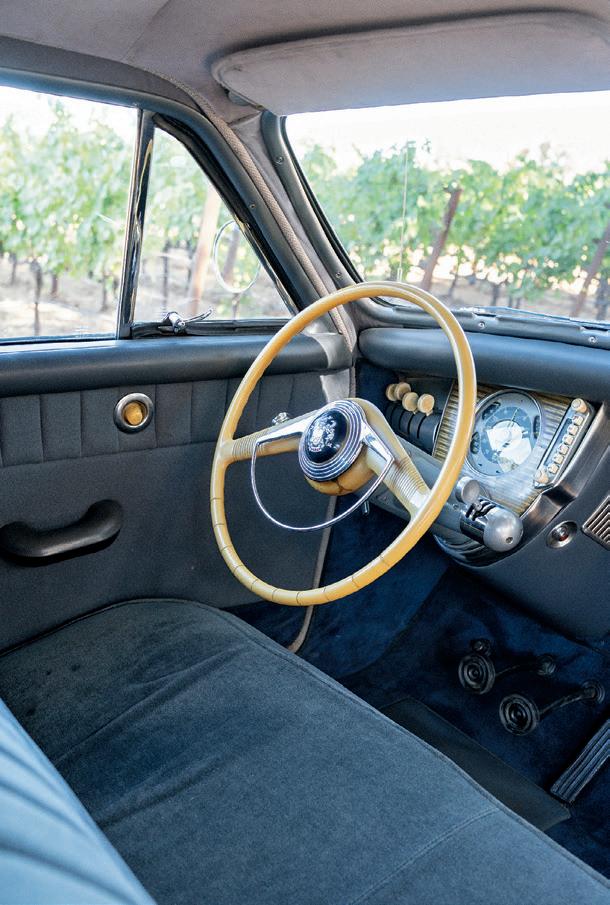
Car Classics, October 1972, “Tucker, Dream or Lame Duck?”
by William B. Hamlin
Mechanix Illustrated, August 1948, “Mechanix Illustrated Drives and Tests the NEW Tucker,” by Tom McCahill
Mechanix Illustrated, February 1971, “Tom McCahill Retests the 1948 Tucker,” by Tom McCahill
Tucker: The Man and His Dream, 1988, Film
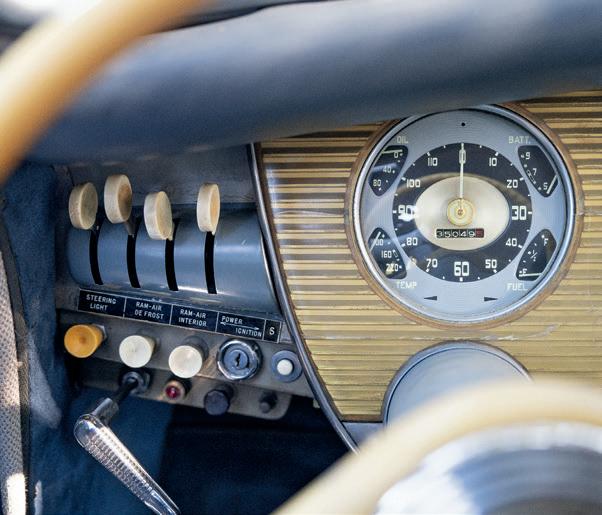
and through Jeff Bridges’ memorable portrayal of Preston Tucker, the story of these would-be revolutionary cars was vividly told for the first time.
Tucker 1014 appears in several scenes in the production, and Mr. Coppola allowed it to be substantially disassembled for sequences filmed on the set of the Tucker factory assembly line. Following the release of the film, which raised worldwide appreciation of the cars and contributed greatly to their value, Tucker 1014 has served as the centerpiece of Mr. Coppola’s collection. An attraction in itself, the car is driven occasionally, and has been placed on public display from time to time at Inglenook, the Coppola family’s renowned Napa Valley winery.
The importance and allure of the surviving Tuckers to astute collectors is well understood; however, there are not enough to satisfy all of the collectors who would like to own one, and opportunities to acquire one are rare. Tucker 1014 stands as proof of Preston Tucker’s valiant effort to change the world, and it has been lovingly preserved for over 40 years by perhaps the most influential Tucker aficionado of all. Gooding Christie’s is proud to present Francis Ford Coppola’s Tucker, an important and most unexpected opportunity.

SELECTIONS FROM THE FRANCIS FORD COPPOLA COLLECTION
VIN. WV2ZB0257HG037786
$30,000–$40,000 without reserve
Few vehicles embody the spirit of global exploration and creative freedom quite like the Volkswagen Westfalia camper van. Beloved by travelers and artists alike, the Westfalia is a canvas for adventure, a haven for the wandering spirit, and a symbol of unbound creativity. The spirit is captured completely in this 1987 Volkswagen Vanagon GL Westfalia owned from new by legendary filmmaker Francis Ford Coppola, and used by him as a mobile writing studio.
For Mr. Coppola, the Volkswagen van was more than a vehicle, it was a sacred workspace. Dating back to the filming of The Rain People in 1968, he adopted a Westfalia as a creative refuge, continuing a ritual of retreating to remote places to write, reflect, and create. Over the years, as earlier vans aged,
HIGHLIGHTS
Single-Owner, Purchased New by Legendary Filmmaker Francis Ford Coppola
Used as Mr. Coppola’s Mobile Writing Retreat
Showing Just 16,570 Original Miles from New
Fully Equipped Westfalia Camper with Pop-up, Kitchenette, and Sleeping Quarters
Outfitted by Mr. Coppola with Sony Sound System and Drop-Down Video Monitor
Mr. Coppola replaced each with near-identical successors, culminating in this final 1987 example. “The VW is where I wrote many of my scripts,” Mr. Coppola remarks, a fact featured in George Lucas’s documentary Filmmaker: A Diary.
Factory-finished in Wolfram Grey Metallic over light gray velour upholstery, this Vanagon GL Westfalia shows just 16,570 miles from new at the time of cataloguing. In a nod to personal comfort and creativity, Mr. Coppola outfitted the cabin with a Sony sound system and a drop-down video monitor, transforming the interior into a warm, lived-in, creative escape.
SPECIFICATIONS
2,100 CC Water-Cooled Flat 4-Cylinder Engine
Bosch Fuel Injection
95 HP at 4,800 RPM
5-Speed Manual Transaxle
Front Disc, Rear Drum Brakes
Front and Rear Independent Suspension with Coil Springs and Shock Absorbers
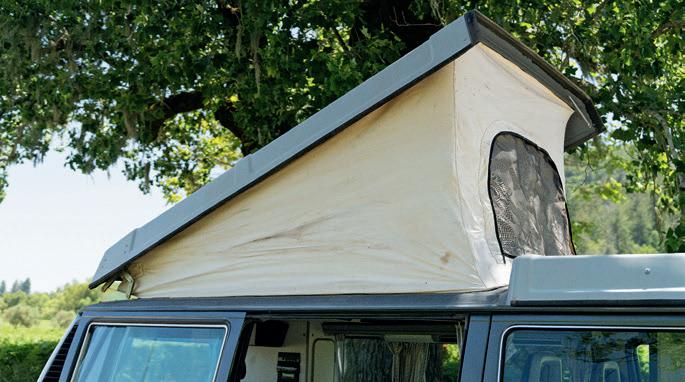

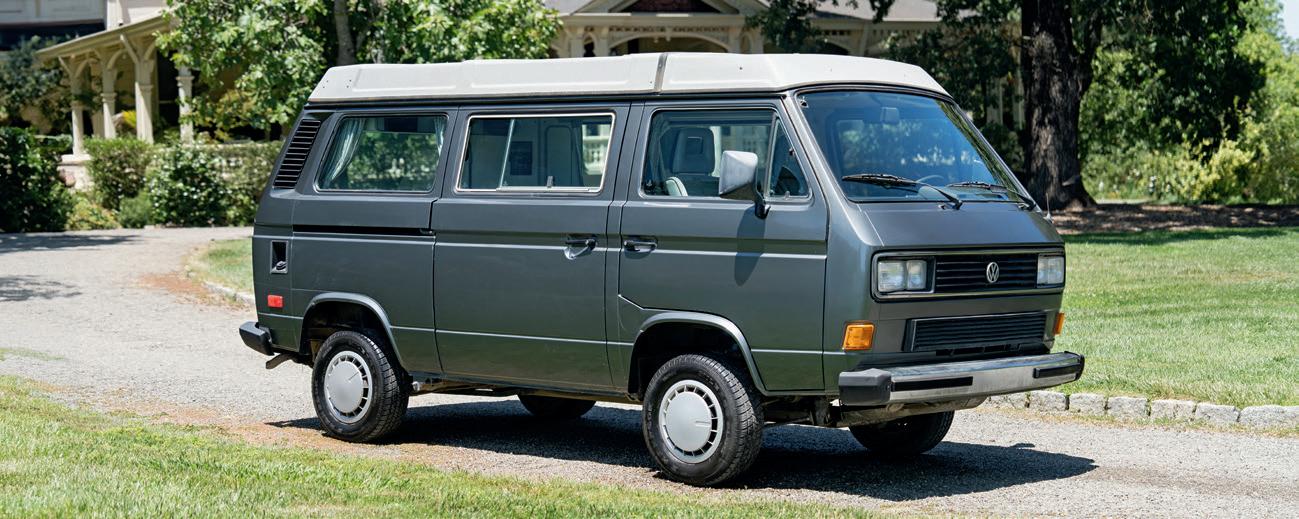
SELECTIONS FROM THE FRANCIS FORD COPPOLA COLLECTION
CHASSIS NO. 2360F
ENGINE NO. FB637
$90,000-$120,000 without reserve
An enduring symbol of American innovation and Art Deco elegance, the Cord 810 remains one of the most groundbreaking automobiles of the 20th century. This 1936 Cord 810 Cabriolet carries added distinction as the personal car of legendary filmmaker Francis Ford Coppola, who acquired it in part due to its deep ties to another automotive visionary, Preston Tucker.
Mr. Coppola, who directed Tucker: The Man and His Dream (1988), regarded the Cord as a critical design precursor to the Tucker 48. “The Cord has fascinated me for years,” he remarked, “especially because I knew the Tucker had been built with a Cord transmission.”
Designed by Gordon Buehrig, the Cord 810 stunned the world upon its debut with its radically modern features: hidden headlights, a streamlined “coffin nose” grille, front-wheel drive, and an advanced semiautomatic pre-selector gearbox. Beneath the hood lies a 289 cid Lycoming V-8, mated to a four-speed gearbox, delivering 125 hp.
Only approximately 195 Cabriolets were built between 1936 and 1937, and this example stands as a rare survivor of that limited production. It is presented in vibrant yellow paintwork over red leather upholstery, a fittingly bold livery for such an avant-garde design. Recognized as a Full Classic by the Classic Car Club of America, the Cord 810 offers eligibility for tours and concours events.
HIGHLIGHTS
Striking Example of the Cord 810 Cabriolet
Groundbreaking Gordon Buehrig Design
One of Approximately 195 Cabriolets Built in 1936 and 1937
CCCA Full Classic with Wide Event Eligibility
Enjoyable and Attractively Presented
SPECIFICATIONS
289 CID Lycoming V-8 Engine
Stromberg FE15 Carburetor
125 BHP at 3,500 RPM
4-Speed Pre-Select Gearbox
4-Wheel Hydraulic Drum Brakes
Front Independent Suspension with Coil Springs
Rear Solid Axle with Semi-Elliptical Leaf Springs
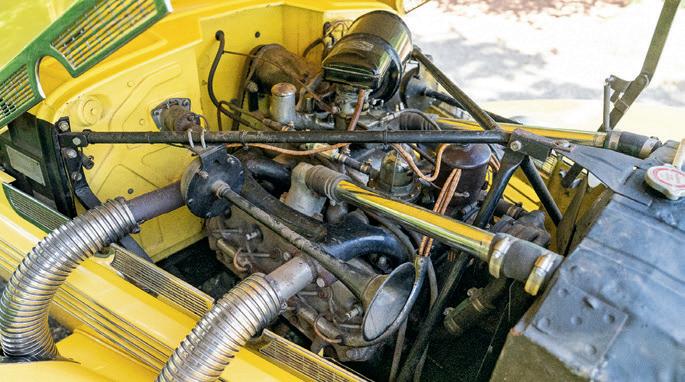



VIN. WP0AC29967S793022
$275,000–$325,000
Named after the FIA racing class it was designed for, the GT3 moniker was introduced in 1999. For 2006, Stuttgart unveiled the updated 997 GT3, featuring a 3.6-liter, 415 hp engine and Porsche Active Suspension Management with zero-lift aerodynamics. Shortly thereafter, a more focused RS version upped the ante by shedding more weight and increasing grip and stability via a wider rear track and revised bodywork.
The 997 GT3 RS 3.6 offered here is one of 452 examples built for North America during 2007–2008. It is finished in Carrara White over a full black leather interior and is well optioned with the desirable $8,840 Porsche Carbon Ceramic Disc Brakes, bi-xenon headlights, and silver seat belts, resulting in
HIGHLIGHTS
Presented in Desirable Carrara White over a Black Interior
Highly Optioned with Full Leather, Ceramic Brakes, and Bi-Xenon Headlights
Displaying Less than 10,800 Miles when Catalogued
Offered with Its Manual, Window Sticker, Service Records, and CARFAX Vehicle History Report
Rare First Generation 997 GT3 RS
a total of $144,445, as documented on its accompanying window sticker. In previous ownership, JCR side muffler bypass pipes were installed and the radio was upgraded to a Porsche Classic PCM unit featuring useful modern amenities. The original mufflers and radio accompany the Porsche at auction and the RS has also had paint protection film applied.
Offered with its manual, window sticker, and records, this outstanding GT3 RS displayed just under 10,800 miles when catalogued. Limited production and desirable options, in addition to the fact that the model is one of the most visceral and exciting Porsches ever built, make this example not only a thrilling performance car but a true collectible.
SPECIFICATIONS
3,600 CC DOHC Flat 6-Cylinder Engine
Bosch Motronic Fuel Management
415 BHP at 7,600 RPM
6-Speed Manual Transaxle
4-Wheel Ventilated Disc Brakes
Front and Rear Independent Suspension with Coil Springs and Monotube Dampers




COACHWORK BY VANVOOREN
CHASSIS NO. 27065
ENGINE NO. 27065
BODY NO. 765
$450,000–$650,000
When other manufacturers leaped ahead of Panhard-Levassor’s pioneering designs, the company looked to the future and decided to adopt the silent and innovative sleeve-valve engine created by Charles Knight in the US.
One hundred thirteen years after its delivery, this Panhard stands as a remarkable example of the design, features, and finishes with which it was supplied, as it is believed to have eluded restoration throughout its entire life. According to surviving factory records, its path began with a journey across the Atlantic to the South American agent Recht & Lehmann of Buenos Aires, Argentina, costing some FF 13,000 when new.
It is believed that the car saw only modest use in period before being laid up for decades. It was finally discovered, reportedly, by arch car sleuth Colin Crabbe in the 1980s. After passing to British collector Peter Fowler and residing in the UK during the early 1990s, the car was acquired by a Dutch enthusiast, before ultimately making its way to Germany.
Collectors habitually choose specific themes for their collections and the German enthusiast Martin Waltz selected Vanvooren coachwork as one such focus within his stable. This car served as the opening salvo, being one of the earliest known survivors showcasing Achille Vanvooren’s craftsmanship applied to automobiles, following the firm’s origins as a carriage builder in 1888. Vanvooren’s mark is
HIGHLIGHTS
Exceptionally Preserved Example and Potential Show Candidate
Originally Delivered to South American Agent in Buenos Aires, Argentina
One of the Earliest Surviving Examples of Vanvooren Coachwork
Features American Charles Knight’s Patented Sleeve-Valve Engine
Never Shown or Toured in the US
SPECIFICATIONS
4,398 CC Sleeve-Valve Inline 4-Cylinder Engine
Panhard-Levassor Updraft Carburetor
20 HP
4-Speed Manual Gearbox
2-Wheel, Double-Acting Rear Brakes
Front Solid Axle with Semi-Elliptical Leaf Springs
Rear Live Axle with Three-Quarter Elliptical Leaf Springs
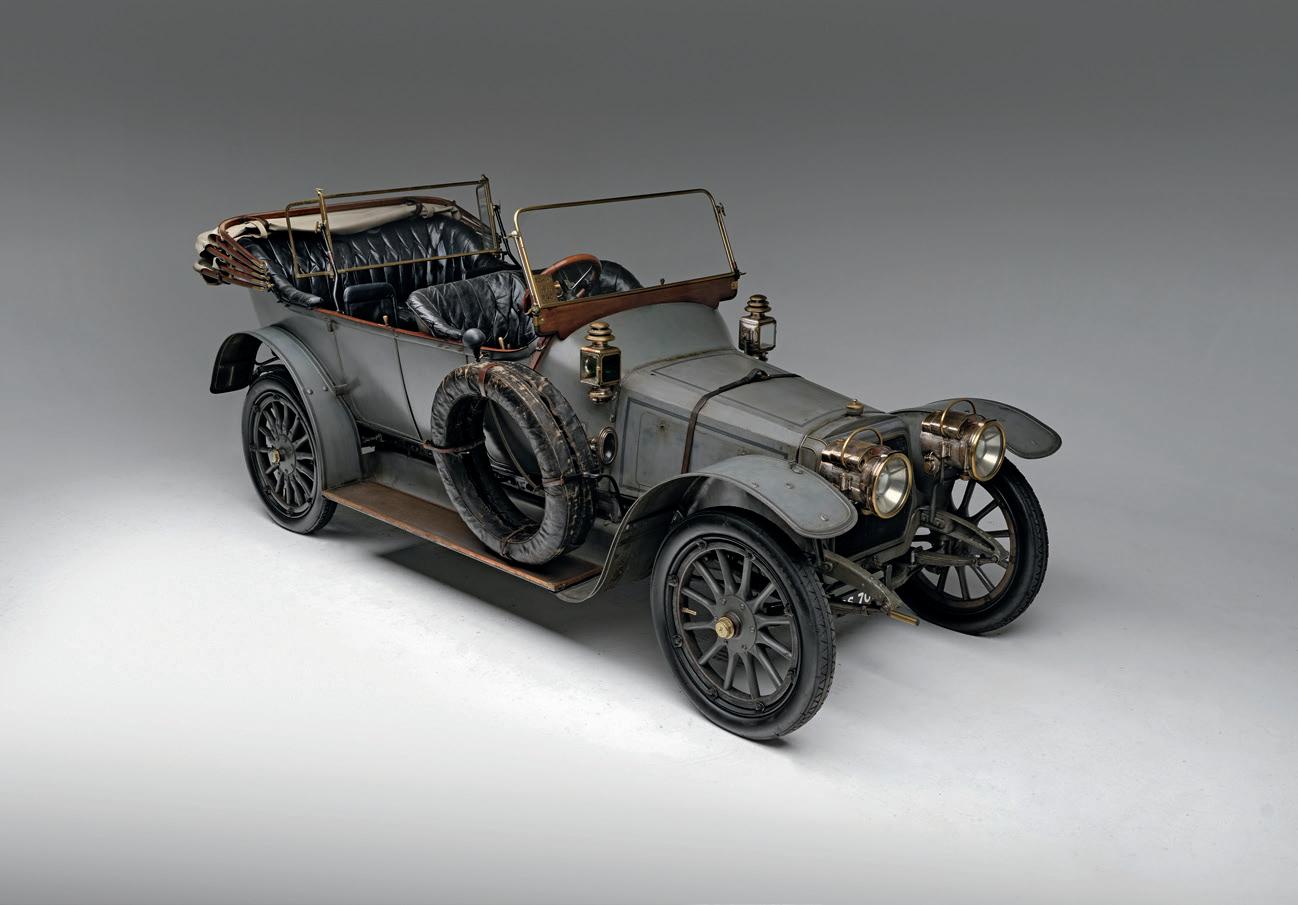

First Owner (acquired new via Recht & Lehmann, Buenos Aires, Argentina in 1912)
Peter Fowler, Ascot, UK (acquired in 1993)
Andrew van Nimwegen, Netherlands (acquired in 1995)
Martin Waltz, Volante Collection, Germany (acquired in 2014)
Private Collection (acquired from the above in 2018)
Current Owner (acquired from the above)

evident both in the small rectangular plates on the side of the chassis as well as in the embossed door kicker plates declaring their Rue Marbeuf premises in Paris.
In 2018, the Volante Collection of Vanvooren cars was dispersed with this Panhard passing into new ownership, where it resided for seven years. Under its most recent ownership, the Panhard’s engine was rebuilt and it is reported to be running very smoothly, replete with its wisp of oil smoke generated from the routinely bathed sleeves.
A remarkable time warp, with delightfully aged paintwork and upholstery, this Panhard is considered authentic from stem to stern and is the “complete package” – from contemporary sales brochures for the model to the extremely rare Panhard-Levassor embossed leather tool and spares cases and tools. Its only noted addition is a period adjustable windshield to protect the rear passengers and an older top replacement.
Preservation cars continue to be a fascination on concours lawns across the country – and indeed around the world – with the most honored examples appearing on the 18th fairway at the Pebble Beach Concours d’Elegance®. This Panhard-Levassor X14 20CV Torpédo represents an instant ticket to compete among those highly prized categories.
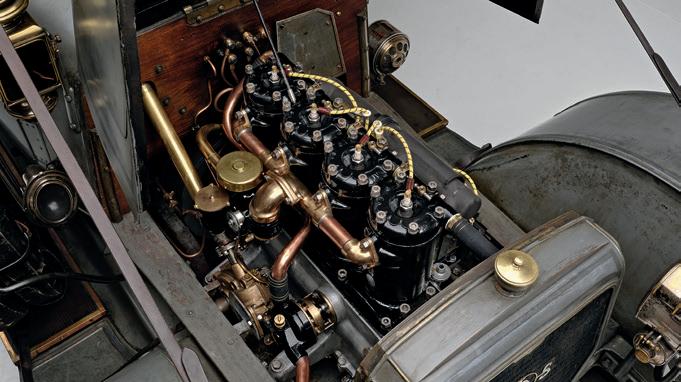


CHASSIS NO. 1E10437
ENGINE NO. 7E2200-9
$150,000–$200,000 without reserve
This stunning E-Type Roadster was originally manufactured on December 31, 1964, and dispatched to Jaguar Cars in New York on January 18, 1965. After years spent turning heads on the road, this Jaguar was carefully restored by renowned specialist Dave Ferguson at Images Autobody in Campbell, California, and completed in 2004. During this nut-and-bolt restoration, every body panel was taken down to bare metal and refinished with multiple coats of Glasurit primer and urethane enamel paint. The Jaguar’s engine, gearbox, and suspension were rebuilt, and specific attention was paid to ensure that components received their correct finishes, for complete authenticity.
The restoration was well documented, with over 400 photographs, and digital
HIGHLIGHTS
Ground-Up Restoration by Noted E-Type Specialist Dave Ferguson
Documented with over 400 Restoration Photographs
Fitted with Matching-Numbers Engine per Its JDHT Certificate
Multiple First in Class Concours Award Winner
Accompanied by Service Records and Tool Kit
copies remain on file. Upon completion, the Jaguar won First in Class at the 2004 Classics by the Sea Concours in Half Moon Bay, California, and at the 2005 Palo Alto Concours d’Elegance in California. This gorgeous E-Type has been driven extremely sparingly under current ownership, mostly remaining stored in the consignor’s collection. The Jaguar is finished today in Opalescent Silver Gray metallic over red leather upholstery, offset with a beige canvas top. The car is accompanied by its JDHT Certificate, tool kit, records, and a copy of a detailed magazine article chronicling the restoration. This exceptionally beautiful E-Type, retaining its matching-numbers engine and benefiting from a meticulous, concours-quality restoration by one of North America’s foremost Jaguar specialists, is an example worthy of close consideration.
SPECIFICATIONS
4,235 CC DOHC Inline 6-Cylinder Engine
Three SU Carburetors
265 BHP at 5,500 RPM
4-Speed Manual Gearbox
4-Wheel Disc Brakes, Inboard Rear
4-Wheel Independent Suspension


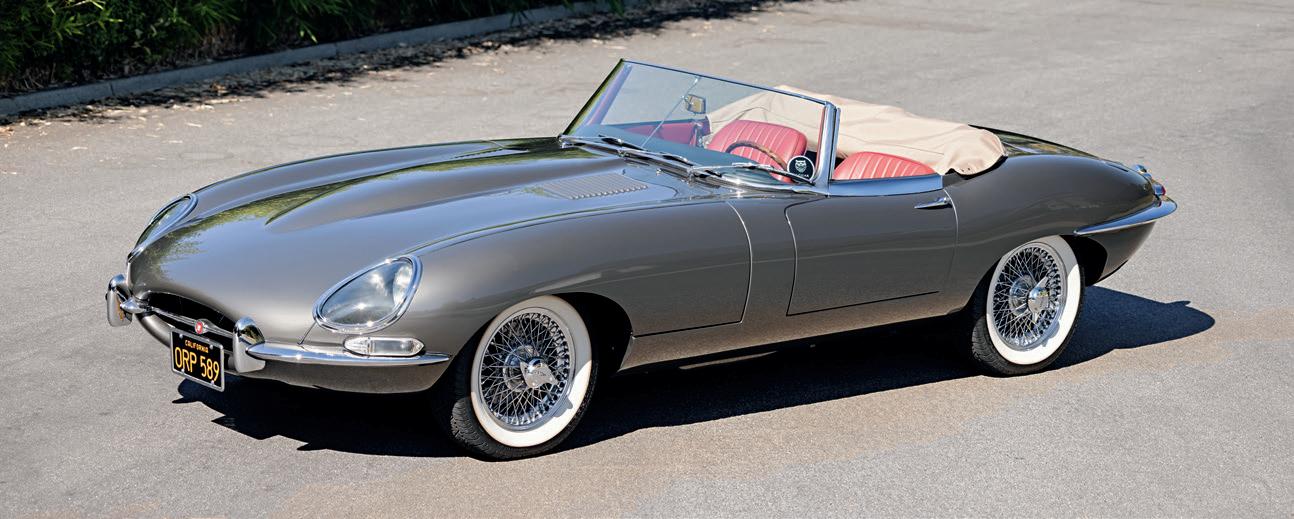

COACHWORK BY VANDEN PLAS
CHASSIS NO. B25MX
ENGINE NO. S9BV
$400,000–$500,000
Launched at the Olympia Motor Show in October 1933, the resurrection of the Bentley nameplate, now under Rolls-Royce ownership, introduced the world to the Silent Sports Car. Rolls-Royce quality and refinement coupled with Bentley performance and handling won legions of fans upon introduction, not the least of whom was W.O. Bentley himself, who remarked, “Taking all things into consideration, I would rather own this Bentley than any car produced under that name.” This example, chassis B25MX, benefits from the continuous improvements made during the production run and is one of the last 200 equipped with an overdrive transmission as well as the Marles cam and roller steering gear. Complementing these improved mechanicals is the rarest of Vanden Plas tourer coachwork.
HIGHLIGHTS
One of the Final MX Series Overdrive Examples Built
One of Four “Swept Wing” Vanden Plas Tourers
Expertly Restored by Noted Marque Specialists P & A Wood
One of Just 25 Overdrive Cars Listed with the RROC Retains Matching-Numbers Engine per Copies of Factory Records and Accompanied by Spare 4 1/4 Block
Referencing the body and equipment section of B25MX’s build sheet is the notation, “Dismount body from B152LS & remount on B25MX.” Thus equipped, this car shows a delivery date of March 29, 1939, with H.D. Clark listed as its first owner. Vanden Plas was responsible for approximately 200 bodies on the Derby Bentley chassis and four tourer variants were offered, the scarcest among those known as a “Swept Wing” design. Vanden Plas company records identify this as design no. 1459, with B25MX carrying body no. 3619, one of four Derby Bentleys so equipped.
The car remained in England for many years and then moved to the highly respected stable of Nicolaus Springer in Zürich in 2006, followed by its current
SPECIFICATIONS
4,257 CC OHV Inline 6-Cylinder Engine
Twin SU Carburetors
126 HP at 4,500 RPM
4-Speed Manual Gearbox with Overdrive
4-Wheel Servo-Assisted Mechanical Drum Brakes
Front Solid Axle with Semi-Elliptical Leaf Springs and Hydraulic Shock Absorbers
Rear Live Axle with Semi-Elliptical Leaf Springs and Hydraulic Shock Absorbers


H.D. Clark, England (acquired new in 1939)
B.M. Russ-Turner, Surrey, England (acquired circa 1960s)
Peter Michael Salmon, Cobham, England (acquired in 1987)
Nicolaus Springer, Zürich, Switzerland (acquired from the above in 2006)
Current Owner (acquired from the above in 2010)
Rétromobile, France, 2010
The Quail, A Motorsports Gathering, California, 2011

Bentley: The Silent Sports Car, 1931–1941, by Michael Ellman-Brown
Bentley Beauty: The Art of the Coachbuilder on the Derby Bentley, 1933–1940, by Neill Fraser and Tomas Knapek
The Flying Lady, March/April 2004,
A Pride of Bentleys, by John Adams and Ray Roberts
Vanden Plas Coachbuilders, by Brian Smith
owner, a noted collector of fine automobiles, who acquired this tourer in May 2010. Restoration began that year and was entrusted to the celebrated RollsRoyce and Bentley specialists P & A Wood of Dunmow, England. This thorough and exacting effort spanned more than two years with receipts in excess of $250,000. Some time prior to 1971, this Bentley’s original engine, S9BV, was removed and replaced with 4 1/4 engine R5BW. In a quest to return the Bentley to the highest standards, the consignor acquired S9BV and installed it in the Bentley, with R5BW accompanying the car at auction.
At the top of the Derby Bentley pecking order lies the 4 ¼-litre overdrive car.
Land speed record holder Sir Malcolm Campbell, who owned three Derby Bentleys, noted, “The engine, steering, suspension and brakes are absolute perfection. I have never driven a car that holds the road so well. The 4 1/4 Litre Bentley is the most amazing proposition which it has ever fallen my lot to handle.”
This car has all the mechanical boxes checked, plus commensurate visual appeal courtesy of a most desirable Vanden Plas “Swept Wing” tourer body style, all presented in authentic condition prepared by marque experts. Combined, these elements make for the ideal and ultimate interpretation of the Silent Sports Car. Whether at rest or at speed, it eagerly awaits its next driving assignment.

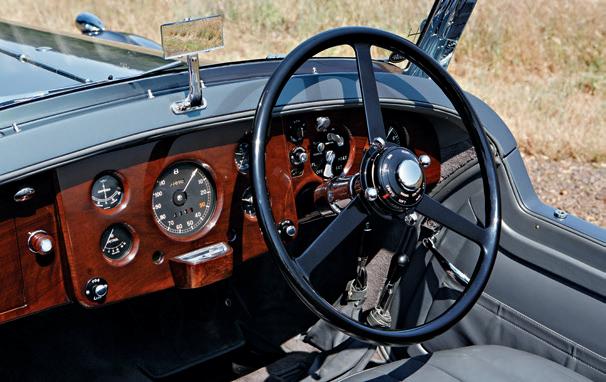
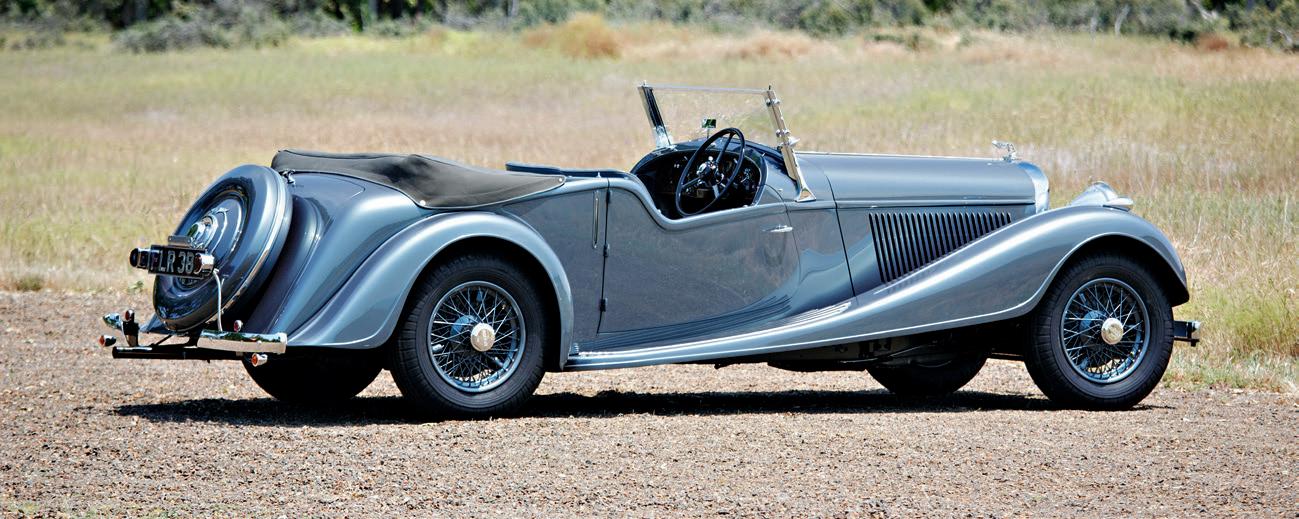
VIN. WDDAK76F89M001881
$400,000–$500,000
Unveiled as the Vision SLR concept in 1999, Mercedes-Benz’s ambitious supercar project paid homage to the legendary 300 SLR of the 1950s while signaling a bold, modern direction. Developed in collaboration with McLaren, the Formula One powerhouse and longtime Mercedes-Benz partner, the production SLR McLaren fused grand touring luxury with cutting-edge motor sports engineering. With Mercedes-Benz responsible for design and McLaren overseeing engineering and assembly in Woking, England, the result was one of the most technologically advanced and distinctive cars of its era.
At the heart of the SLR is a hand-built, 5.4-liter, supercharged V-8 producing 617 hp and 575 lbs./ft. of torque. This formidable engine is mounted well behind
HIGHLIGHTS
An Exceptional Example from the Final Year of SLR Roadster Production Nearly New Condition, Showing Just 507 Miles at the Time of Cataloguing Distinctive Crystal Galaxit Black Metallic over Tan and Anthracite Interior
Two-Owner Example Offered from a Significant Mercedes-Benz Collection Accompanied by Original Owner’s Manuals and Service Book
the front axle, giving the car a balanced front-mid-engine layout. The SLR featured carbon ceramic brakes, an active rear airbrake, and extensive use of carbon fiber throughout its construction, contributing to both performance and durability.
Originally offered only as a coupe, the SLR Roadster debuted in 2007, trading the fixed roof for a lightweight fabric top that retracts in just 10 seconds. Remarkably, the Roadster retained its scissor-style doors and 208 mph top speed, making it one of the fastest open-top cars of its time.
This exceptional 2009 Mercedes-Benz SLR McLaren Roadster represents the
5,439 CC SOHC Supercharged V-8 Engine
Sequential Multi-Port Fuel Injection
617 BHP at 6,500 RPM
5-Speed AMG Speedshift R Automatic Transmission
4-Wheel Carbon Ceramic Disc Brakes
4-Wheel Independent Double-Wishbone Suspension
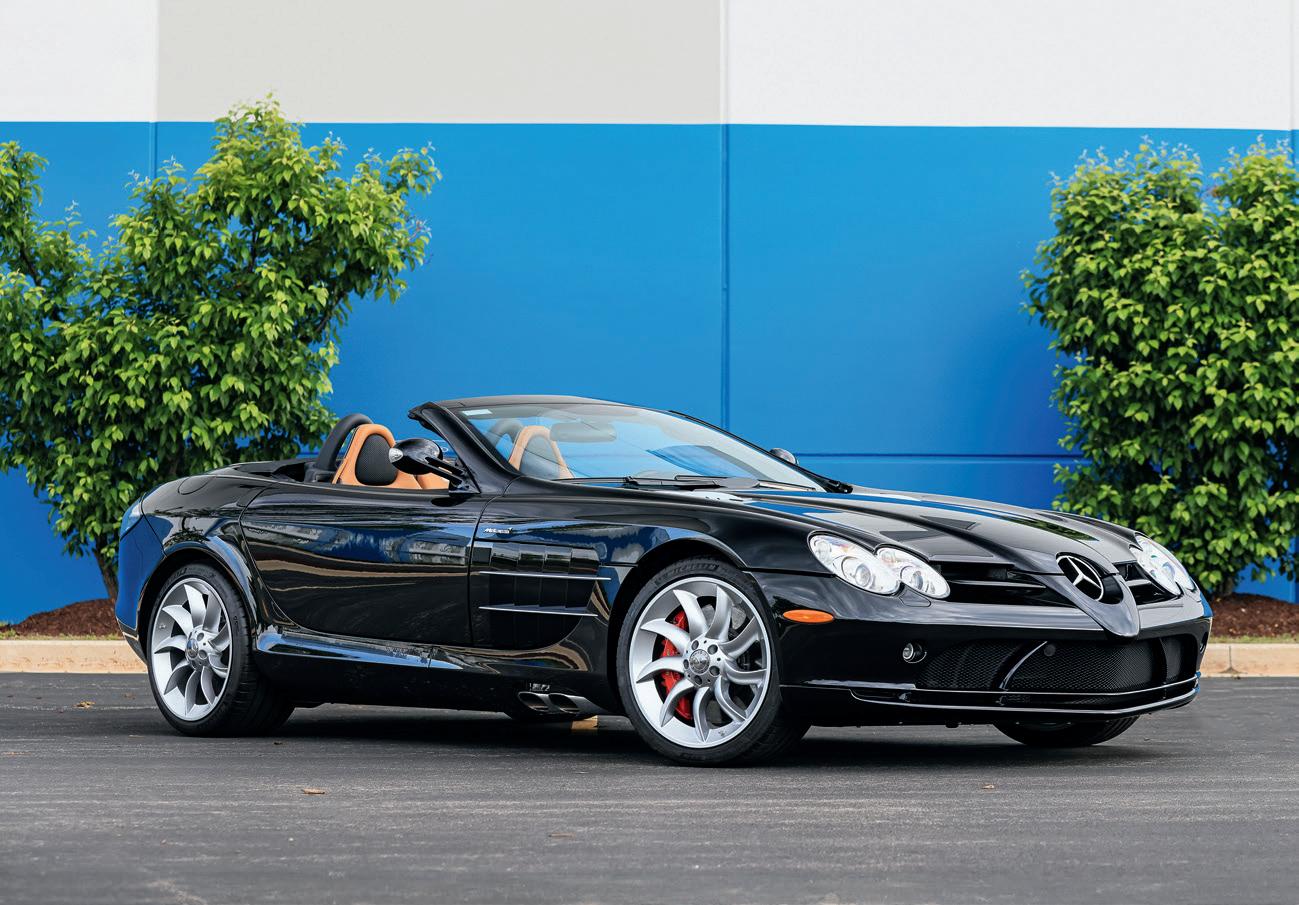

First Owner, Quebec, Canada (acquired circa 2009)
Current Owner (acquired from the above)

final year of SLR production and is a true collector-grade example. Finished in the rare and elegant Crystal Galaxit Black Metallic, it is complemented by a striking two-tone Anthracite and Tan leather interior – a seldom-seen color combination that underscores the car’s exclusivity and sophisticated character.
Showing just 507 miles from new, this SLR is offered from an esteemed, private Mercedes-Benz collection and remains in virtually as-new condition. Originally delivered to Quebec, Canada, it was imported to the US in March 2021. In May of that year, the car received an extensive service at Mercedes-Benz of Westmont in Illinois. Since then, it has been driven less than 60 miles, ensuring its pristine condition has been meticulously preserved.
Accompanied by its original owner’s manual and service book, this final-year SLR Roadster is a rare opportunity to acquire one of the most significant high-performance grand tourers of the 21st century. Combining timeless styling, Formula One pedigree, and ultra-low mileage, this Crystal Galaxit Black Metallic example stands out as a particularly desirable and well-preserved specimen of the celebrated Mercedes-Benz SLR McLaren legacy.
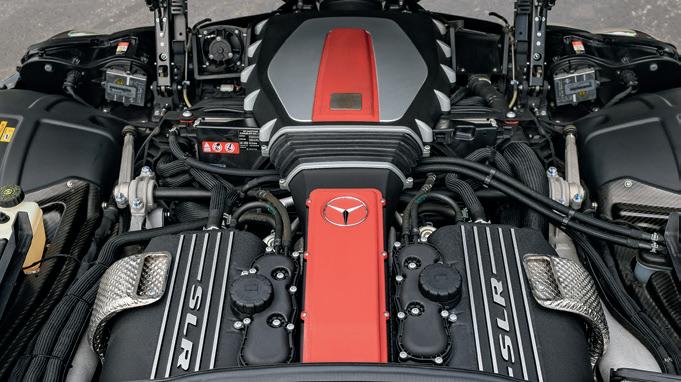
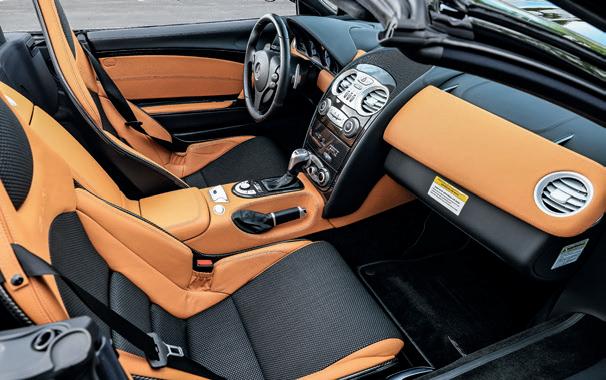

COACHWORK BY SCAGLIETTI
CHASSIS NUMBER. 4945 GT
ENGINE NUMBER. 4945
$1,400,000–$1,600,000
An Italian gran turismo of inimitable style, the 250 GT Lusso seamlessly combined the finest qualities of Ferrari engineering with the elegance and restraint of Pininfarina design. Introduced at the 1962 Paris Motor Show, the Lusso was envisioned as a more refined successor to the sporting 250 GT SWB Berlinetta, offering clients a road car that emphasized comfort and beauty without compromising performance.
As the final iteration of the legendary 250 GT series, the Lusso marked the culmination of over a decade of continuous development. Built on a 2,400 mm wheelbase chassis and fitted with Ferrari’s potent three-liter Colombo V-12, the Lusso boasted a top speed in excess of 140 mph, all while delivering a
HIGHLIGHTS
One of the All-Time Great Ferraris; The 101st of Only 350 Lussos Built
Delivered New to Modena, Italy; Maintained by US Collectors Since 1964 Elegant, Seldom-Seen Black over Black Color Scheme
Retains Matching-Numbers Engine per Factory Records
Offered with Handbooks, Tool Roll, and Marcel Massini Report
civilized driving experience. It featured four-wheel Dunlop disc brakes, a fully independent front suspension, and a live rear axle located by trailing arms and a Watt’s linkage – an improvement derived directly from Ferrari’s 250 GTO.
The Lusso’s calling card, however, has always been its arresting design. The sensuous lines, penned by Battista “Pinin” Farina and executed in steel by Carrozzeria Scaglietti, feature a delicately curved beltline, subtly flared fenders, and a Kamm tail – details that give the car a sense of poised dynamism. Its minimal chrome trim, slim pillars, and expansive greenhouse lend an understated sophistication. As GM design chief Chuck Jordan once observed, “Pininfarina’s Ferrari Berlinetta Lusso exhibits for all time that transformation of form and
SPECIFICATIONS
2,953 CC SOHC Tipo 168 U 60º V-12 Engine
Three Weber 36 DCS Carburetors
240 BHP At 7,000 RPM
4-Speed Manual Gearbox
4-Wheel Vacuum-Assisted Dunlop Disc Brakes
Front Independent Suspension with Coil Springs and Shock Absorbers
Rear Live Axle with Radius Arms, Semi-Elliptical Leaf Springs, and Shock Absorbers
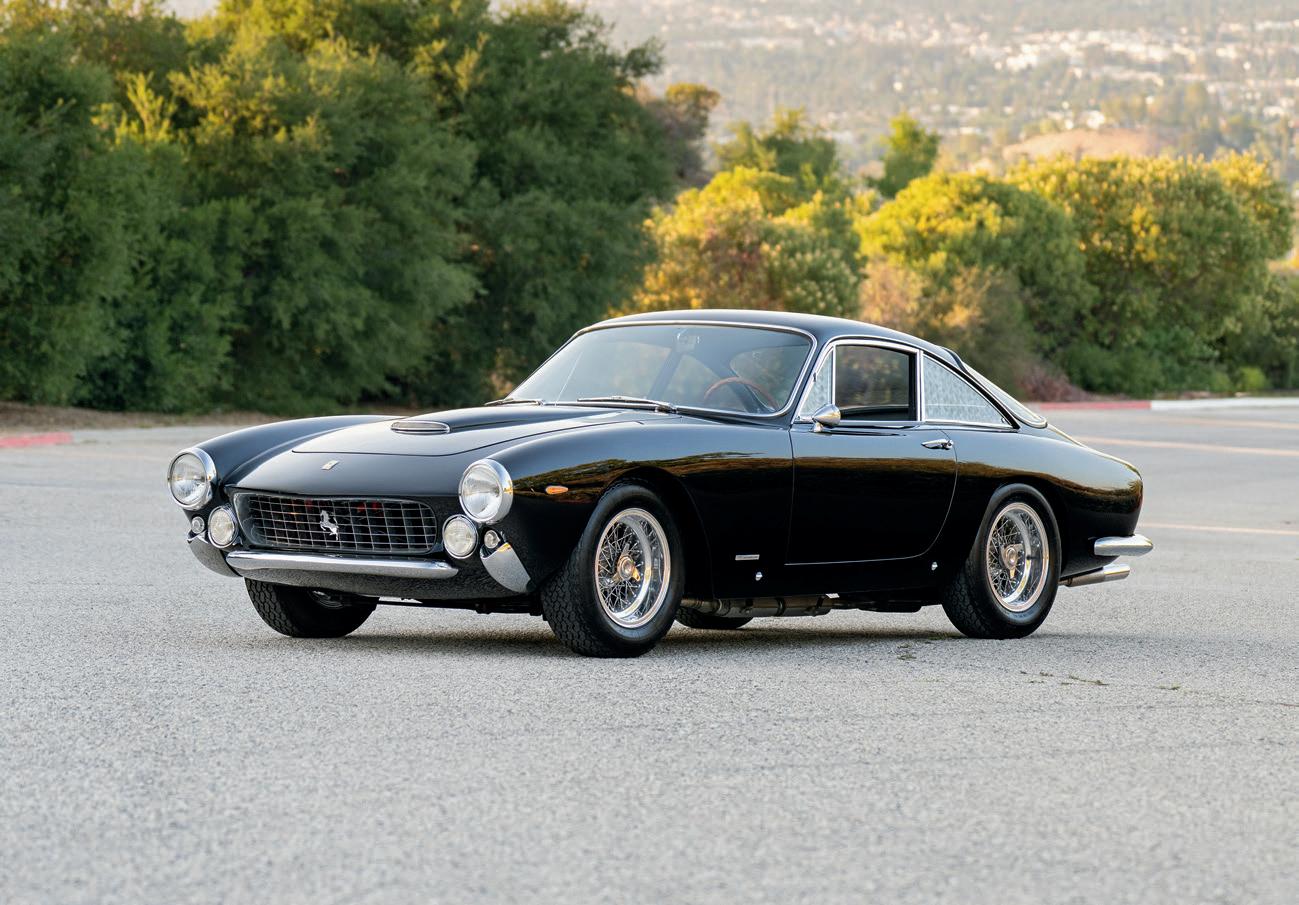

Ermanno Montorsi, Modena, Italy (acquired new via Interauto S.p.A. in 1963)
Pubblicità Fraire S.r.l., Rome, Italy (acquired from the above in 1963)
Peter G. Sachs, Boston, Massachusetts (acquired in 1964)
Arcal Imported Cars, Somerville, Massachusetts (acquired from the above in 1964)
Private Collection, Arlington, Massachusetts (acquired by 1976)
Charles D. Casarella, Pound Ridge, New York (acquired by 1997)
Bradley Hoyt, Minneapolis, Minnesota (acquired circa 2000)
Current Owner (acquired from the estate of the above)
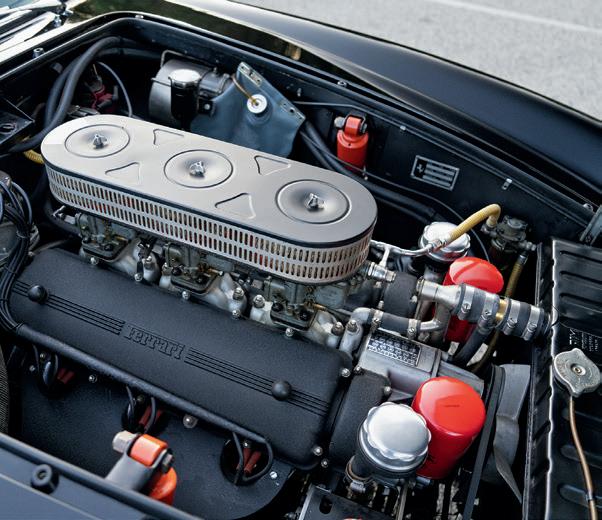
function into the spiritual presence by which great art transcends mere art.”
Only 350 Lussos were built between 1963 and 1964, ensuring its rarity. Revered by collectors and enthusiasts from the outset, the Lusso’s reputation has only grown with time, bolstered by its associations with 1960s icons such as Steve McQueen, who famously owned one. Today, the model is widely regarded as one of the most beautifully designed Ferraris ever built, occupying a unique place between the marque’s pure competition machines and luxurious, custom-bodied grand tourers.
The history of chassis 4945 GT begins in August 1963, when it was completed at the Ferrari factory. As documented by Ferrari historian Marcel Massini, this European-specification Lusso – the 101st built – was finished in Rosso (Italver 19374) over Beige Connolly leather and delivered new through official dealer Interauto S.p.A. to its first owner, Ermanno Montorsi of Modena. Registered as “MO 95716,” the car soon passed to Pubblicità Fraire S.r.l. in Rome and was serviced by Ferrari’s Assistenza Clienti department in November 1963, then showing 3,010 km.
In 1964, chassis 4945 GT was imported into the US, where it was first owned by noted collector Peter G. Sachs. After a brief period in Sachs’ care, it passed
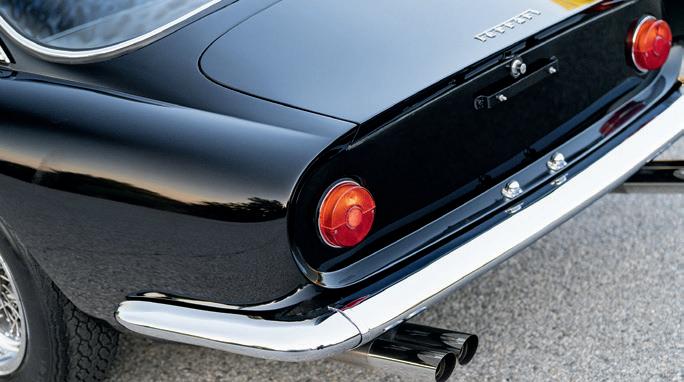

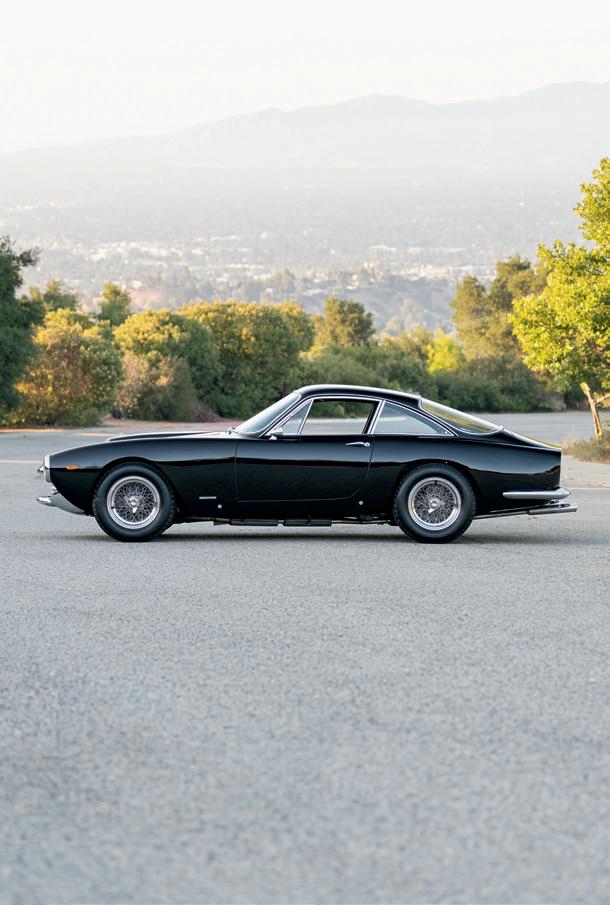

Hilary A. Raab Jr.
Kurt H. Miska
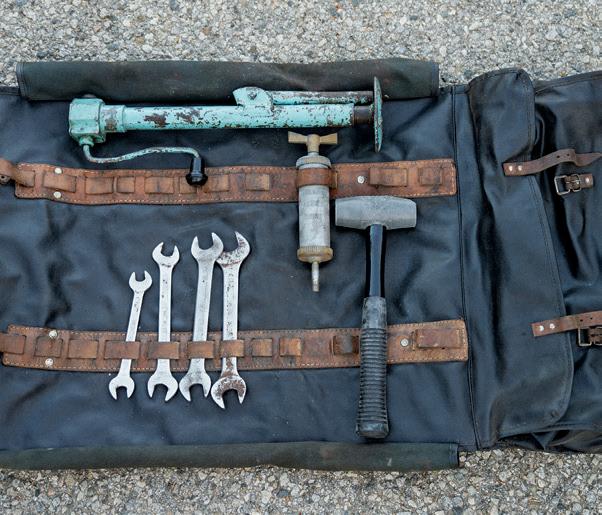
through Arcal Imported Cars in Massachusetts and remained in the state until at least 1976. It subsequently found its way to New York, where it was owned by Charles D. Casarella of Pound Ridge.
Roughly 25 years ago, the Lusso was acquired by Bradley Hoyt of Minneapolis, a dedicated enthusiast and vintage racer whose collection included other notable Ferraris, such as a 330 GTC, 275 GTB/4, and even a 1969 312 Formula 1 car. Mr. Hoyt refinished the Lusso in its current, elegant black over black color scheme and enjoyed it on fair-weather weekend outings. Upon his passing, 4945 GT was sold to the current owner.
Presented today in well-kept, driver-quality condition, the car is offered with its matching-numbers engine (internal no. 1488/62 E), a tool roll, owner’s manual, and a Massini report with copies of the period Italian registration documents.
A truly captivating example of Ferrari’s grand touring legacy, 4945 GT embodies the enduring appeal of the Lusso: timeless design, mechanical purity, and refined road manners. Whether enjoyed as a rolling sculpture, a candidate for vintage rallies, or a highlight of any distinguished collection, this Lusso offers the rare opportunity to acquire a Ferrari of grace, pedigree, and lasting significance.
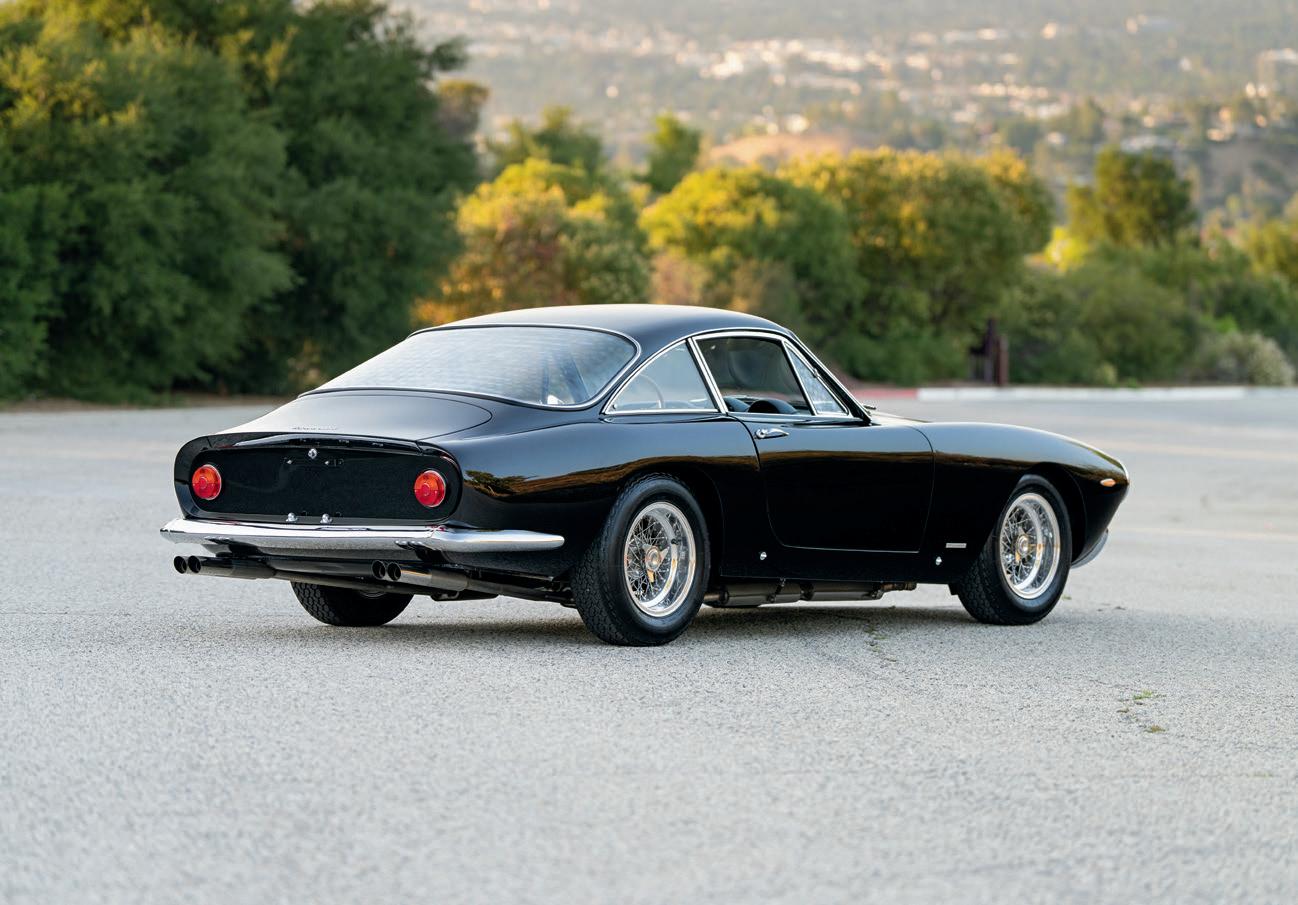
CHASSIS NO. 121.042.6502590
ENGINE NO. 121.921.6502685
$175,000–$225,000 without reserve
Conceived from Max Hoffman’s vision of a stylish, approachable alternative to the 300 SL, the 190 SL Roadster was launched at the 1955 Geneva Motor Show and sold alongside the 300 SL until 1963. In all, 25,881 of the 190 SLs were built, 70% of which were exported to the US. At $3,998, the 190 SL cost approximately half the price of the Gullwing.
This example, one of just 4,032 built in 1956, was completed on June 9, 1956, and delivered to Mercedes-Benz of Los Angeles. Finished in its stunning original color combination of Erdbeerrot Metallic (Strawberry Red, DB 543) over black leather upholstery, this 190 SL is equipped with rare factory options, as seen on the Mercedes-Benz data card, including a transverse rear seat and a color-matched
HIGHLIGHTS
Beautiful Factory Delivered Colors of Strawberry Red Metallic over Black Leather
Restored by Renowned Mercedes Expert Bob Platz
AACA National First, Senior, and Grand National Winner
Offered with Rare Third-Passenger Transverse Seat
Accompanied by a Factory Hardtop
Retains its Matching-Numbers Engine per a Copy of its Factory Data Card
*Please note that this vehicle is titled 1957.
hardtop. A Becker FM shortwave radio, black cloth soft top, and boot round out the period features. In the early 1990s, owner Tom Reiger commissioned a restoration of this car by acclaimed Mercedes-Benz restorer Bob Platz. Upon completion, this 190 SL won Best of Show honors at the International 190 SL Group meet and was recognized by the AACA with First, Senior, and Grand National accolades.
The car presents beautifully today, with its award-winning restoration carefully preserved and showing only limited use since completion. For collectors seeking a 190 SL that checks every box, including 1000 Miglia eligibility, this Mercedes-Benz is an unmissable opportunity to own a truly rare and celebrated example of 1950s European motoring excellence.
1,897 CC SOHC Inline 4-Cylinder Engine
Twin Solex Carburetors
105 BHP at 5,700 RPM
4-Speed Manual Gearbox
4-Wheel Servo-Assisted Hydraulic Drum Brakes
Front Independent Wishbone Suspension with Coil Springs
Rear Swing-Axle Suspension with Trailing Arms and Coil Springs

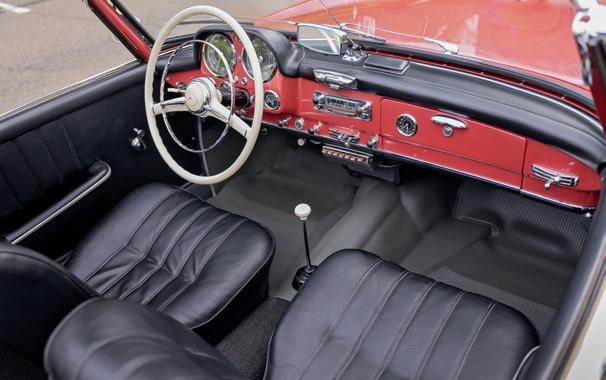
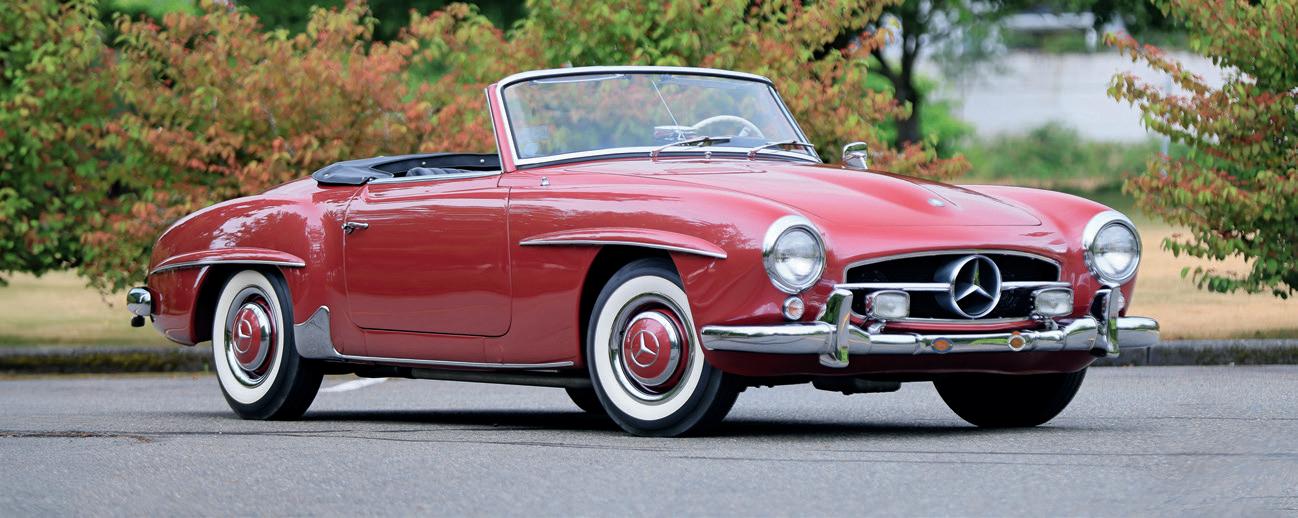

COACHWORK BY SCAGLIETTI
VIN. ZFFJA09B000050351
$325,000–$400,000
At its 1971 debut, the 365 GT4 BB (Berlinetta Boxer) represented a stark departure from Ferrari’s flagship road cars, which had always used front-mounted V-12s. Enzo Ferrari was apprehensive about putting the less-forgiving handling characteristics of a mid-engine high-horsepower car in the hands of the public. Even in racing cars, he was reluctant to adopt the mid-engine layout, although Ferrari did eventually begin racing mid-engine 12-cylinder cars in 1960, and debuted the nominally road-going 250 LM in 1963. However, Ferrari still lacked a 12-cylinder mid-engine production car to rival Lamborghini’s groundbreaking Miura of 1966. That changed with the Boxer, launching Ferrari’s 20-plus-year experiment with a mid-mounted flat-12 engine – an era that sired both the Boxer and Testarossa lines.
HIGHLIGHTS
Ferrari Classiche-Certified, Late-Production 512 BBi
Finished in Its Striking Original Color Combination of Blu Scuro over Crema Extensively Documented, with Invoices Dating Back to the 1980s
Accompanied by Ferrari Classiche Red Book, Original Books, Tools, and Jack
The Ultimate Evolution of Ferrari’s First Mid-Engine 12-Cylinder Production Car
The Boxer was technically advanced, with a horizontally opposed alloy, quad-cam 12-cylinder engine, derived from the powerplant of the 312 B Formula 1 car. The engine was mounted atop the five-speed transaxle, which kept the powertrain dimensionally compact. The chassis used semi-monocoque construction, with double-wishbone suspension all around. The Pininfarina styling was penned by the legendary Leonardo Fioravanti, who also designed the Dino 206/246, Daytona, 308/328/288, Testarossa, and several other Ferraris.
The Boxer was developed over three major variants: the carbureted 365 BB and 512 BB, followed by the Bosch CIS fuel-injected 512 BBi. The Boxer was never officially sold in the US because of emerging safety and emissions regulations,
4,943 CC DOHC Flat-12 Engine
Bosch K-Jetronic Fuel Injection
340 BHP at 6,000 RPM
5-Speed Manual Transaxle
4-Wheel Ventilated Disc Brakes
4-Wheel Independent Double-Wishbone Suspension with Coil Springs and Shock Absorbers
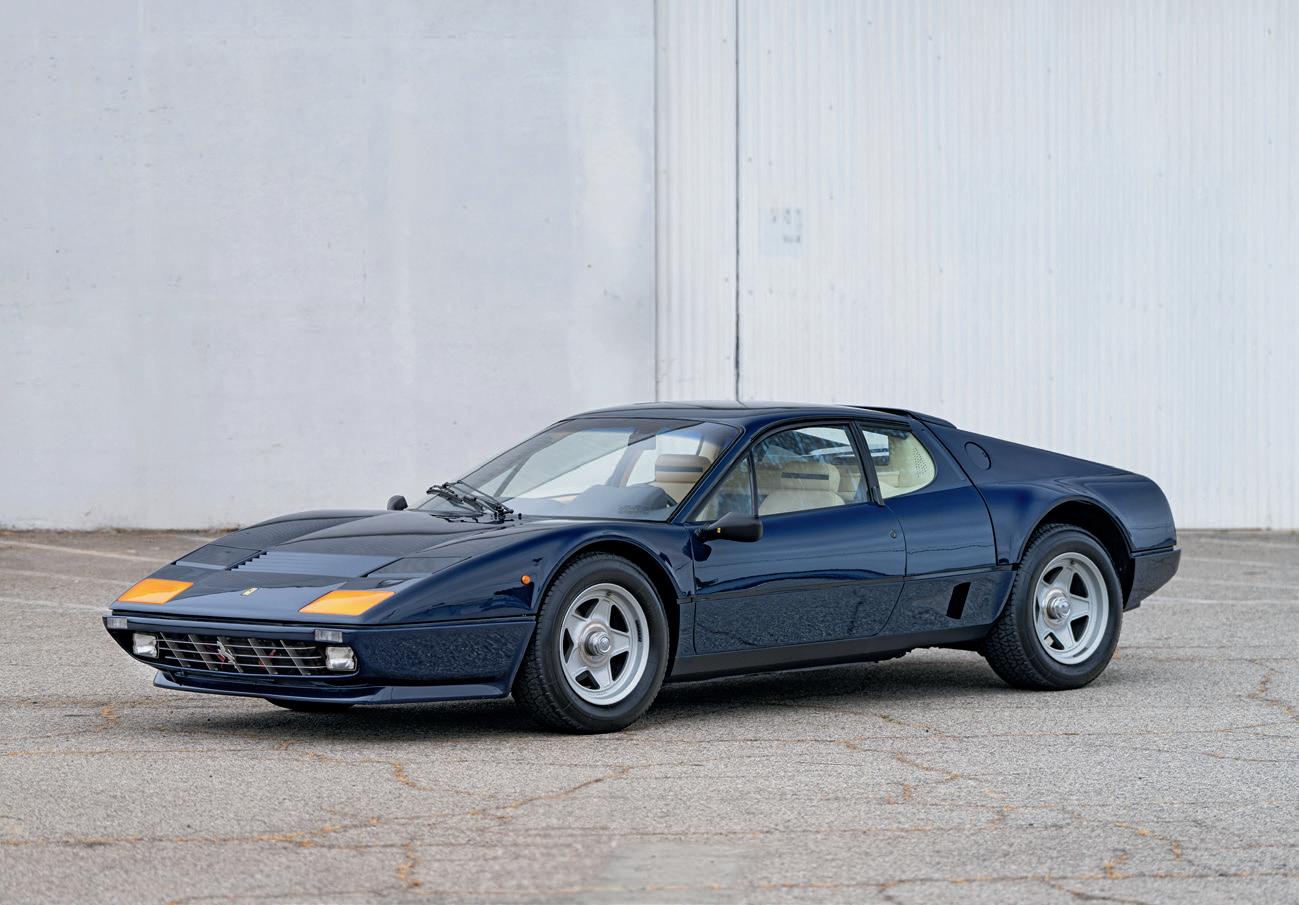

Gregory Packer, Balboa Island, California (acquired new in 1984)
Barry Applebaum, San Diego, California (acquired by 1988)
Symbolic Motors, La Jolla, California (acquired in 1999)
Charles Penn, Reidsville, North Carolina (acquired in 2004)
George Edward-Bell Holding, Raleigh, North Carolina (acquired in 2005)
Private Collection, New York (acquired from the above in 2005)
Wayne Carini, Portland, Connecticut (acquired from the above in 2014)
Current Owner (acquired from the above)

although some gray market imports made their way to the US with private owners.
This is one such Boxer, a late-production car completed in March 1984. Originally supplied by Newport Imports of Newport Beach, California, for Gregory Packer of Balboa Island, it remained in Southern California until 2001. The car then spent four years in the South, and was relocated to the Northeast in 2005, where it has since resided with two well-known keepers, one of whom was Wayne Carini, who featured it on his show Chasing Classic Cars. The car was Classiche certified in 2013, and the included Red Book confirms that the car retains its matching-numbers engine and transaxle, as well as its original, striking color combination of Blu Scuro (Dark Blue) over Crema (Cream).
Included are the car’s original books, tools, and jack, as well as extensive service records and ownership documentation dating back to the 1980s. Only 2,300 Boxers were built, compared to the nearly 10,000 examples of the Testarossa line. The Boxer has always been a connoisseur’s choice, especially in the US, and possesses a visceral, experientially immersive character that was mostly refined out of the Testarossa. This example is exceedingly complete, Ferrari Classiche Certified, and finished in a handsome and rare color combination, adding further to its appeal for the discerning Boxer enthusiast.

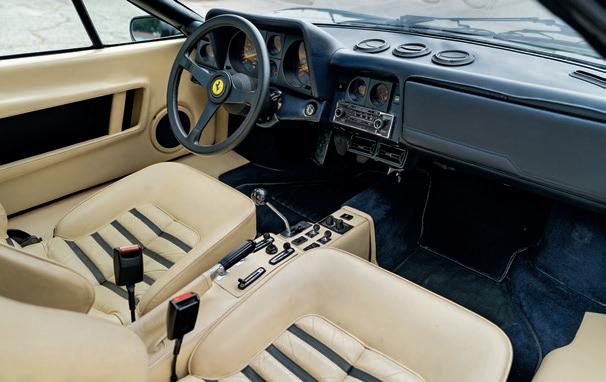
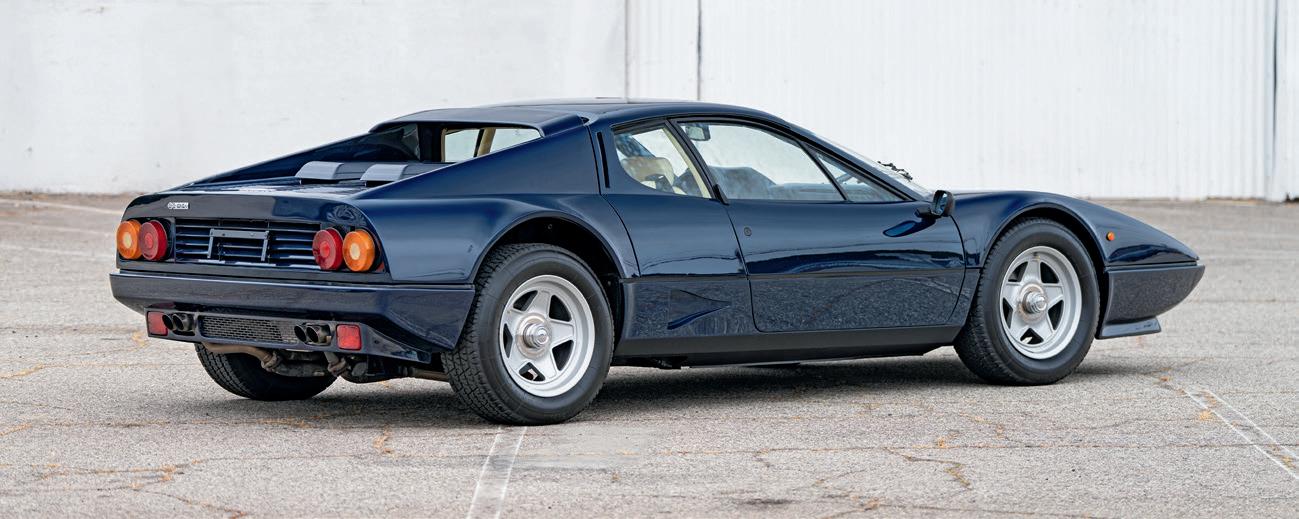
VIN. WP0AA2997WS321013
$300,000–$350,000
For many Porsche enthusiasts, the 993 represents the pinnacle of the air-cooled 911 era – the final evolution of a lineage that dates back to 1964. Produced from 1995 to 1998, the 993 offered major advancements over its predecessors, including a redesigned multi-link rear suspension, updated styling, and a more powerful 3.6-liter flat-six. Widely regarded for their ideal blend of analog driving engagement and modern engineering, 993s remain a favorite among collectors and purists alike.
For the 1996 model year, Porsche introduced the Carrera 4S (C4S) – a compelling variant that combined the naturally aspirated, all-wheel-drive powertrain of the Carrera 4 with the wide-body shell of the 911 Turbo. As with the Turbo, it
HIGHLIGHTS
An Exceptional Wide-Body 993 from the Final Year of Production
One of Only 298 Carrera 4S Models Built for North America in 1998 Tastefully Finished in Special-Order Oak Green Metallic over Classic Gray
Exceptional Specification Features Numerous Exclusive Department Options
Meticulously Maintained, Collector-Owned Example Showing Just 27,500 Miles
Offered with Original Books, Tools, Spare, Jack, Compressor, and Records
also featured larger brakes, 18" Turbo-Look wheels, and a lowered ride height, giving the C4S a uniquely aggressive stance and enhanced dynamic capability. According to Porsche Cars North America, just 2,326 examples were built for the North American market, with a mere 298 produced for the 1998 model year – the final year of air-cooled 911 production and the end of an era.
Not only is the 993 Carrera 4S rare, but this particular example is a standout – a one-off creation custom-tailored by Porsche’s Exclusive Department. Finished in elegant Oak Green Metallic (code L22L) – a special-order ( sonderfarbe) color rarely seen on the 993 – it features a Classic Gray leather interior and a suite of distinctive trim appointments. Highlights include burlwood accents on the
3,600 CC SOHC Air-Cooled Flat 6-Cylinder Engine
Bosch Multi-Port Fuel Injection
282 BHP At 6,300 RPM
6-Speed Manual Transaxle with Permanent All-Wheel Drive
4-Wheel Ventilated Disc Brakes
Front and Rear Independent Suspension


William Willert, Cave Junction, Oregon (acquired new in 1998)
Harvey Wilson, Ventura, California (acquired from the above in 2003)
Current Owner (acquired from the estate of the above)
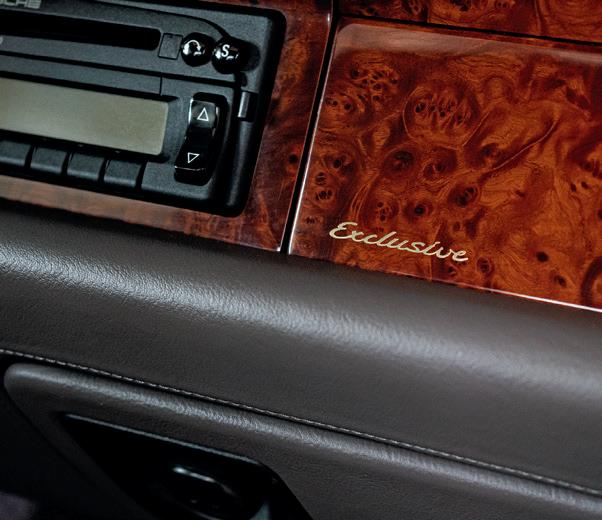
dashboard (X17), steering wheel (X38), handbrake lever (X31), and gearshift knob (XC8), as well as carbon fiber inner door latches (XTA), stainless-steel door entry guards (X70), and oval chrome tailpipes (X54). Additional desirable factory options include a power sunroof, engine sound package, rear window wiper, eight-way power and heated seats, leather-covered dashboard and door panels, and a hi-fi sound package paired with the CDR-210 stereo.
Delivered new in February 1998, this Porsche remained with its original owner until 2003, when it was sold with just 13,500 miles to collector Harvey Wilson of Ventura, California. Known for his outstanding stable of European classics – including Mercedes-Benz 300 SLs and Porsche 356 Carrera Speedsters – Mr. Wilson cherished the car for nearly two decades, preserving it in exceptional condition until it left his family’s ownership following his passing in 2022.
Now showing just 27,500 miles, this C4S has recently benefited from a full detailing and an extensive service performed by Porsche West Houston, totaling $7,800. It is reported by the consignor to retain its original paint and interior finishes, and it presents in pristine, well-preserved condition throughout. Offered with its original books, manuals, and a file of service records, this bespoke 993 represents a unique opportunity to acquire one of the most distinctive air-cooled 911s ever built.

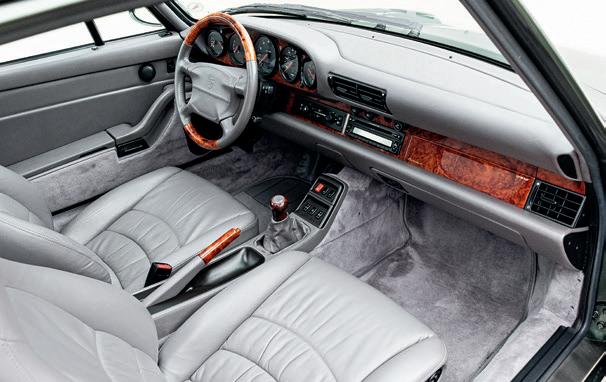
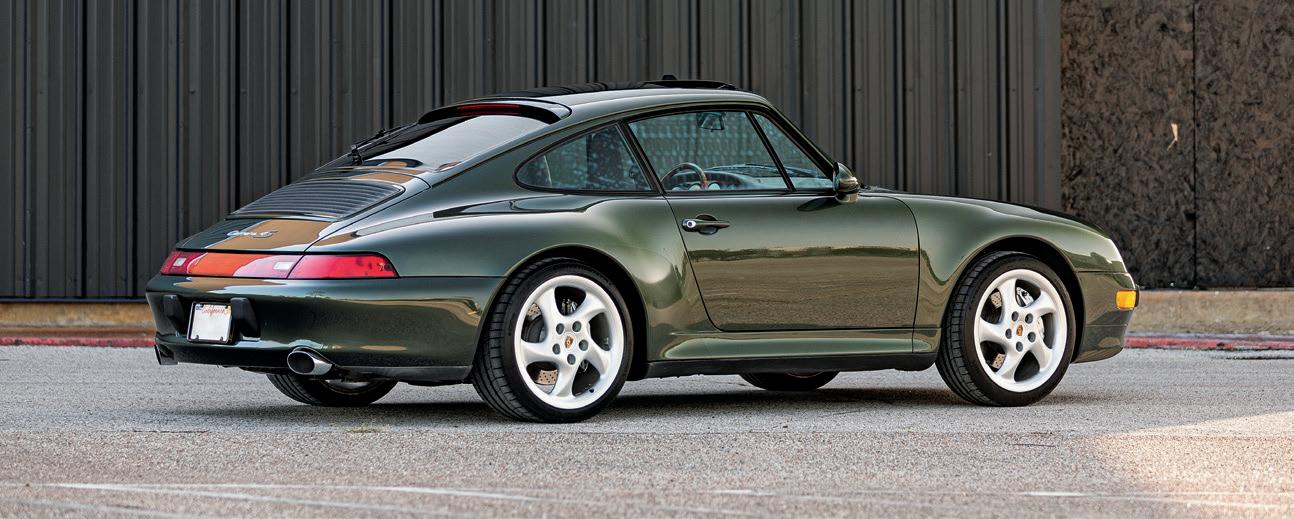
CHASSIS NO. 188.015.7500010
$450,000–$500,000 without reserve
Introduced at the Paris Motor Show in October 1951, Mercedes-Benz’s W188 line of coupes, cabriolets, and roadsters represented the pinnacle of the marque’s early postwar production –bespoke, handwrought flagships for the world’s most discerning motorists. Substantially scarcer – and markedly more expensive – than the contemporary 300 SL, the 300 S and its ultimate evolution, the fuel-injected 300 Sc, shared much of that gull-winged icon’s exotic, competition-bred underpinnings, including a broadly similar overhead cam straight-six, mechanical fuel injection, and four-wheel independent suspension.
Though its exquisitely elegant, if relatively reserved, artisan-formed bodywork belied the supercar roots beneath, the W188 nonetheless cut quite a rakish figure for its
HIGHLIGHTS
Exceptionally Rare as One of Just 53 Hand-Built Examples
Owned by Blue Angels Pilot and Emmy-Winning Producer E. Duke Vincent
Features Fitted Luggage, Owner’s Manuals, and Tool Kit
Accompanied by Extensive Documentation of an Extraordinary Provenance
An Exquisite Grand Touring, Fuel-Injected Roadster
day, particularly in roadster form. Much of the credit for this is due to a brilliantly engineered convertible top, which made do without the landau irons and padded headliner typical of the era and stowed neatly beneath a leather boot, preserving the car’s uninterrupted lines. From any angle, it was a machine of substance and grace – imposing, but never ostentatious.
One of just 53 examples built and representing the most desirable and refined of all W188 variants, chassis 00010 hails from the penultimate year of 300 Sc production. According to a copy of the factory build record on file, this handsome Roadster was delivered in April 1957 to a Mercedes-Benz dealer in Cologne, Germany. Originally finished in black with a beige brown leather interior,
2,996 CC SOHC Inline 6-Cylinder Engine
Bosch Mechanical Fuel Injection
175 BHP at 5,400 RPM
4-Speed Manual Gearbox
4-Wheel Servo-Assisted Drum Brakes
Front Independent Double-Wishbone Suspension with Coil Springs
Rear Swing-Axle Suspension with Coil Springs
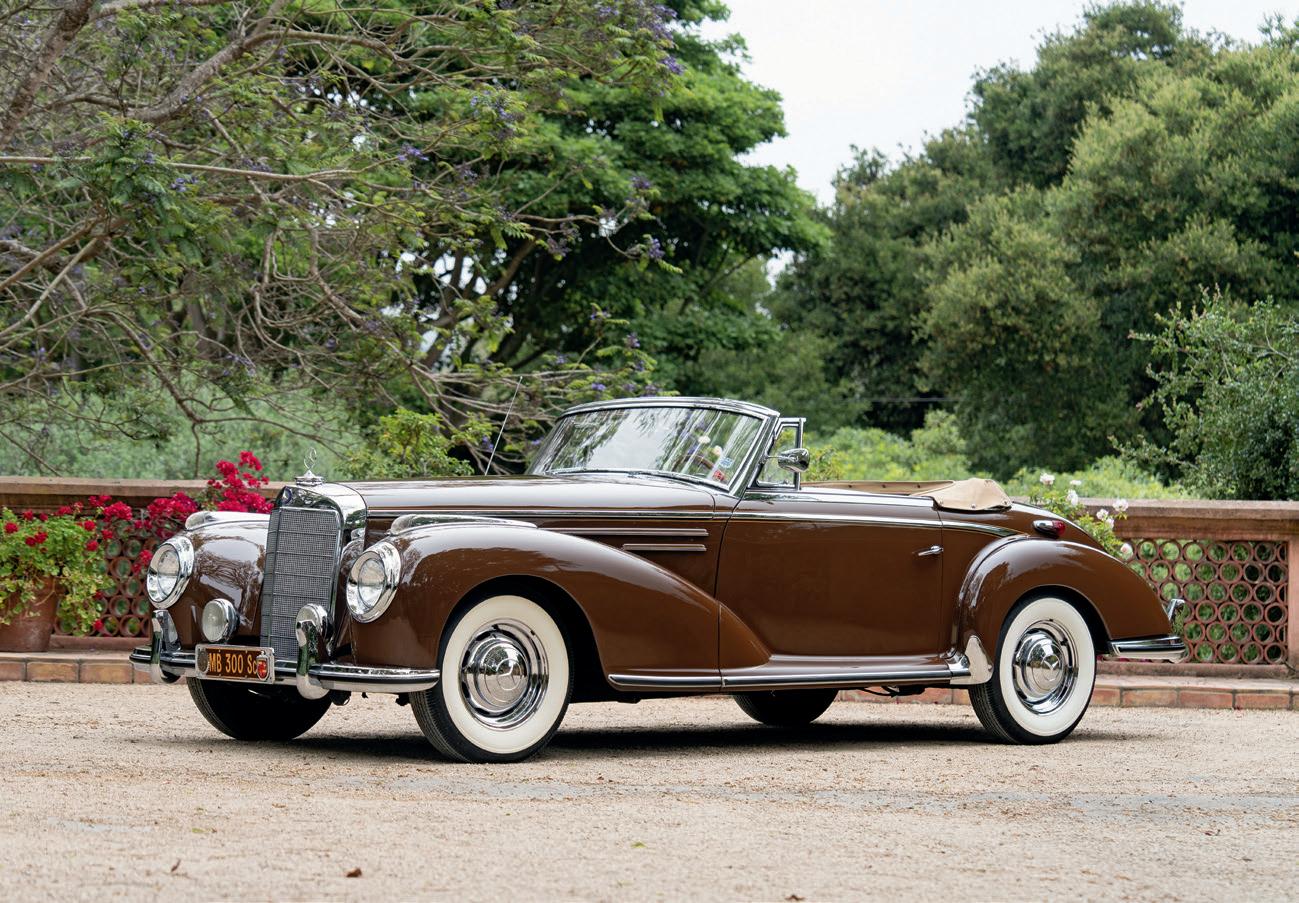

E. Duke Vincent, Los Angeles, California (acquired by 1965)
Current Owner (inherited from the above)
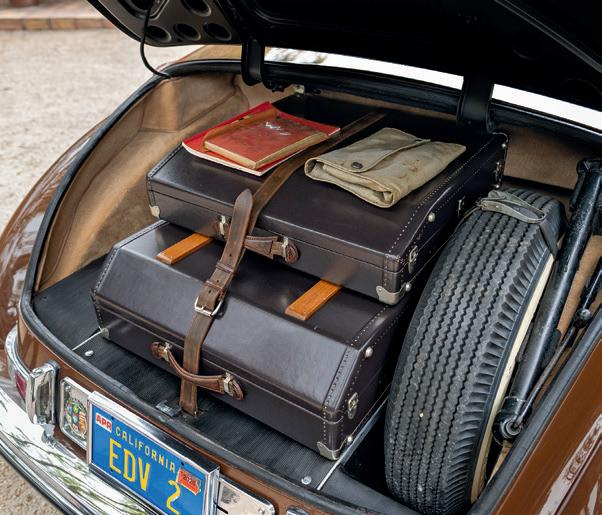
the car’s first known owner was noted Hollywood television producer and former US Navy Blue Angels pilot E. Duke Vincent. The car remained in his doting care for close to 60 years, meticulously maintained, a testament to the enduring appeal of its quality and design.
Repainted to its current lovely dark brown color scheme during the 1980s, this beautiful 300 Sc Roadster otherwise remains largely unrestored, with the exception of a factory replacement engine installed early in its life. Of particular note is its floor-shift configuration, which enhances driveability and better suits the model’s subtly sporting intent than the factory column-mounted shifter. The car is offered with a two-piece fitted luggage set, factory tools, manuals, and a trove of fascinating ownership documentation. This rare model was the longtime pride of celebrated television producer and writer E. Duke Vincent, who maintained it in superb condition in his home in Montecito, California. Vincent’s 40-year Hollywood career included becoming Aaron Spelling’s partner in 1978 and ultimately Executive Producer and Vice Chairman of Spelling Television. Vincent’s dozens of program credits include Dynasty, Melrose Place, Beverly Hills, 90210, and two Emmy Award-winning movies: And The Band Played On and Day One. In his earlier life Vincent was a member of the US Navy’s Blue Angels, one of the most elite and awe-inspiring aviation units in the world. A masterwork of postwar Teutonic engineering and design, it is among the most elegant and exclusive Mercedes-Benz production cars ever built.


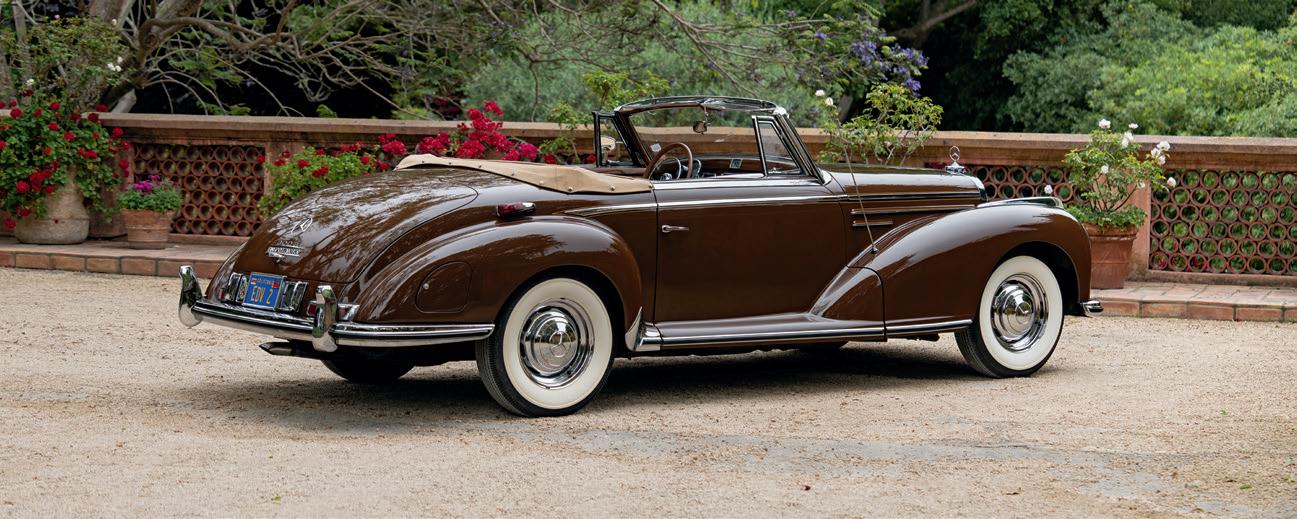
CHASSIS NO. 198.042.7500038
ENGINE NO. 198.980.7500036
$1,500,000–$1,800,000
In March 1957, Mercedes-Benz unveiled the 300 SL Roadster, employing a host of mechanical advancements and stylistic revisions to create a new, open version of the successful Gullwing. Chief among these were a new rear-axle design that improved high-speed handling and a modified space-frame chassis, which allowed for conventionally hinged doors. The new Roadster offered improved ingress, roll-up windows, a useful trunk, and of course, the thrill of high-performance open-air motoring.
In total, Mercedes-Benz built 1,858 examples of the 300 SL Roadster, steadily updating the model until production ceased in 1963. Among the most collectible Roadsters are those built at the very start of production, which contained
The Second 300 SL Roadster Built; Features Numerous Early-Production Details Displayed at the 1958 New York International Auto Show Just Three Owners and Less than 42,000 Miles from New Original Color Scheme and Matching-Numbers Engine per Factory Records
Recent Attention by SL Specialists HK Engineering and Hjeltness Restoration Offered with Original Karl Baisch Luggage, Books, Tool Kit, Jack, and Records
carryover Gullwing components and unique, hand-tooled features, and those completed at the end of the run, which had alloy engine blocks and four-wheel disc brakes.
The 300 SL presented here, chassis 7500038, is particularly noteworthy, as it is the second production Roadster built. According to a copy of its factory data card, this car was completed in March 1957, fitted with body no. 7500002 and engine no. 7500036.
According to the Daimler-Benz archives, 618 production Roadsters were made for the 1957 model year. Of these, only the first three – chassis 7500037,
3,400 CC SOHC Inline 6-Cylinder Engine
Bosch Mechanical Fuel Injection
Estimated 275 BHP
4-Speed Manual Gearbox
4-Wheel Hydraulic Drum Brakes
Front Independent Double-Wishbone Suspension with Coil Springs
Rear Swing-Axle Suspension with Coil Springs
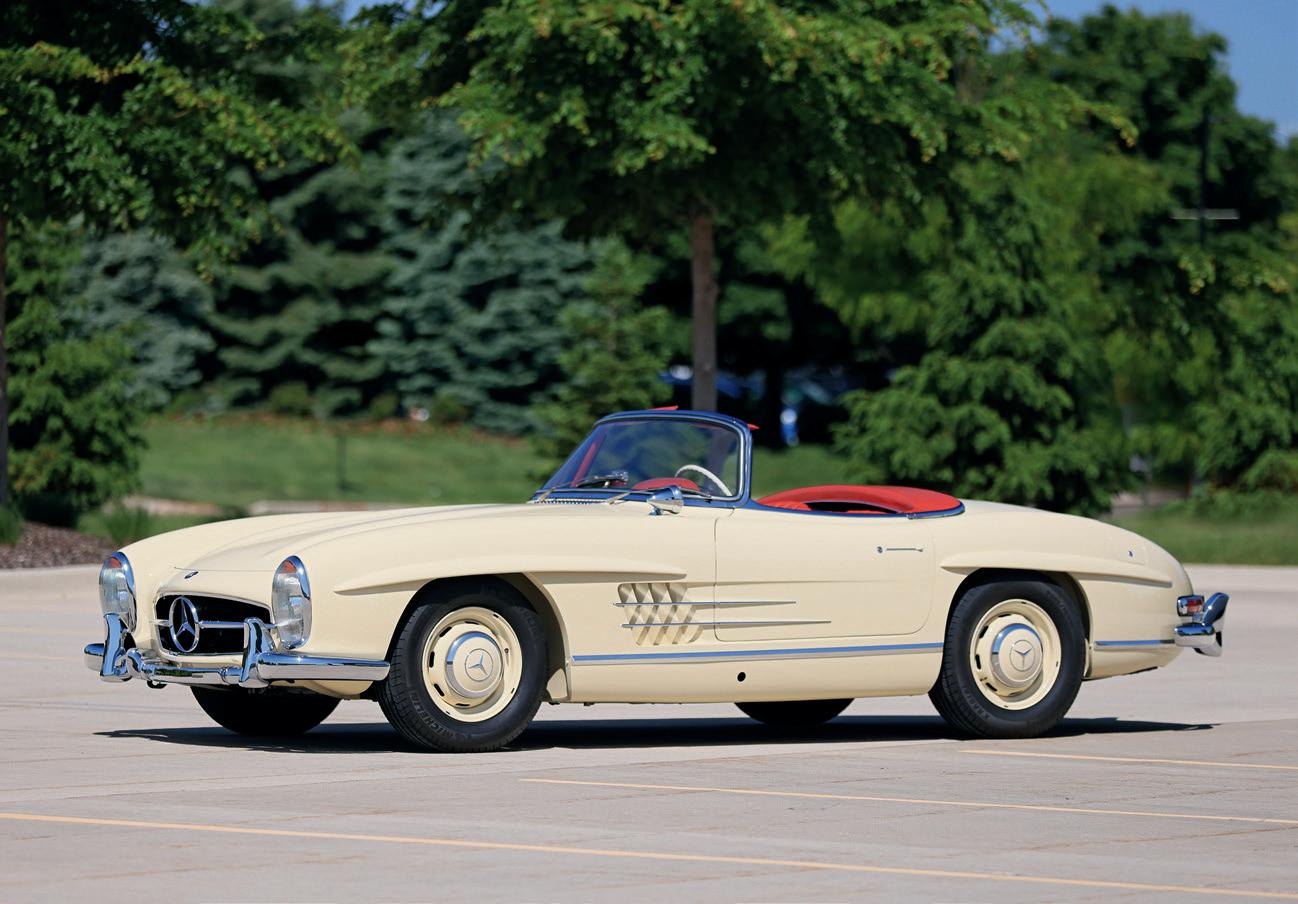

George R. Hill, Mahwah, New Jersey (acquired new in 1958)
Charles Selick and Family, Rumson, New Jersey (acquired from the estate of the above in 1975)
Current Owner (acquired from the above)
7500038, and 7500060 – used 1957 Gullwing chassis numbers and were built prior to the standard Roadster chassis number sequence, which began with 7500080 and continued, uninterrupted, through 7500694.
When new, this 300 SL was elegantly finished in Elfenbein (Ivory, DB 608) with red leather upholstery and a black soft top. Optional equipment included a Becker Mexico radio, fitted luggage, driver-side rearview mirror, and US-market lighting and instrumentation. The car’s build record also carries the important notation “Internat. Automobil Salon New York Standwagen,” indicating that this Roadster served as the official New York show car. As the 1957 show was held during December 1956, 7500038 was likely retained for promotional duties and displayed at the 1958 New York International Auto Show, held April 5–13.
Two weeks later, on April 30, 1958, the 300 SL was sold to its first private owner, George R. Hill, a businessman living in Mahwah, New Jersey. After Mr. Hill’s death, his wife Henriette sold the prized Roadster to a local car collector named Charles Selick. When Mr. Selick purchased the car in December 1975, it had covered just 37,523 miles and was repainted in traditional Mercedes-Benz silver. Throughout his decades-long ownership, Mr. Selick admired and maintained the SL, but rarely drove it, accruing fewer than 100 miles over 25 years.
After inheriting the 300 SL Roadster, his son Barry commissioned the renowned Mercedes-Benz specialist Hjeltness Restoration of Escondido, California, to perform a sympathetic, body-on restoration. This work, carried out between 2016 and 2019 at a cost of nearly $600,000, returned this important Mercedes-Benz to its original color scheme, while taking care to preserve as much originality as possible. As a result, the Roadster retains most of its nicely patinated original upholstery, except for the seats, which have been retrimmed in proper unperforated red leather.
Since joining the consignor’s magnificent sports car collection in 2023, the 300 SL has participated in the Colorado Grand, and has had its engine completely rebuilt by the respected German Mercedes-Benz specialists HK Engineering. According to an invoice on file the rebuild incorporated several sport options, including upgraded camshaft, pistons, and connecting rods, as well as an improved oil pump and HK Engineering’s ‘ready to race’ option. Now displacing 3.4 liters and producing approximately 275 horsepower, the 300 SL Roadster is reported to offer outstanding performance and increased torque, making it ideal for future event use.
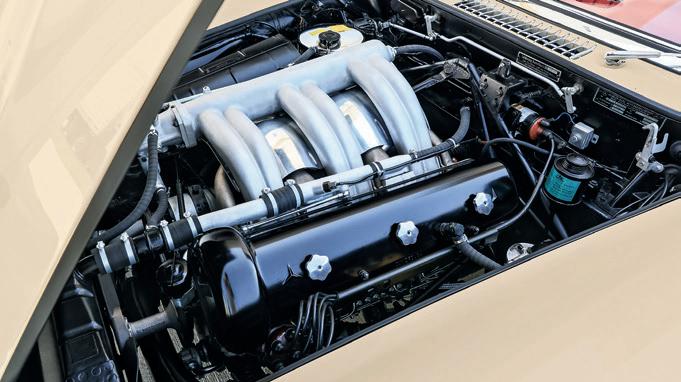



New York International Auto Show, 1958
Colorado Grand, 2023

Beautifully presented in all respects, this significant SL displayed just 41,845 miles at the time of cataloguing. Resplendent in its attractive original color scheme, 7500038 is accompanied by its original Karl Baisch luggage set, Becker Mexico radio, tool kit, jack, instruction manual, parts catalog, and service book, as well as its Becker manual and warranty card. Contained in the history file is a copy of the factory data card, which confirms that 7500038 retains its matching-numbers engine, together with various records dating from 1975, all the way through to recent invoices from Hjeltness Restoration and HK Engineering.
Of all the 300 SLs built, a few special examples stand apart in the minds of connoisseurs. The car presented here is among the best of the highly collectible, early-production Roadsters. Just the second example built, this factory New York show car retains its original colors, engine, and important accessories. Its history is well documented, and its presentation is superb, benefiting from nearly 50 years of single family ownership and recent restoration work undertaken by the foremost marque specialists.
For the collector in search of a truly special 300 SL, this early Roadster is worthy of serious consideration.

VIN. ZA9RU31B0XLA12406
$425,000–$475,000
Throughout the first 35 years of Lamborghini’s history, the company had more than half a dozen owners, and spent many years being unprofitable. Despite this tumultuous environment, the cars wearing the raging bull were remarkably consistent: exotic, extroverted, and extremely high-performance. The follow-up to the sensational, but aging, Countach, the Diablo emerged from this environment. Its gestation was waylaid by Chrysler’s 1987 acquisition of Lamborghini, which necessitated substantial rework to please the new management, but the resulting car was a sensation when it finally debuted in January 1990.
The Lamborghini Diablo redefined the modern supercar with its blend of outrageous styling, extreme performance, and surprising usability. As the brand’s
HIGHLIGHTS
One of Just Two Examples Finished in Blu Scuro over Glacier White Leather Interior
One of Less than 50 Diablo VT Roadsters Built for the US Market Showing Just 9,293 Miles when Catalogued Offered with Service Records, Books, Manuals, and Tools
A Rare and Desirable Second-Generation Diablo VT
first model capable of exceeding 200 mph, the Diablo carried Lamborghini into the 1990s with flair – and in 1995, the introduction of the VT Roadster added all-wheel-drive traction and open-air theater to the mix.
The “VT” designation stands for Viscous Traction, referring to the viscous center differential that marked Lamborghini’s first foray into all-wheel drive. Capable of sending up to 25% of power to the front wheels, the system made the VT significantly more composed under acceleration – offering supercar thrills with greater control.
The initial response from the media and public was overwhelmingly positive,
SPECIFICATIONS
5.7-Liter DOHC V-12 Engine
Electronic Fuel Injection
530 BHP at 7,100 RPM
5-Speed Manual Transaxle
4-Wheel Ventilated Disc Brakes with ABS
4-Wheel Independent Automatic-Leveling Suspension


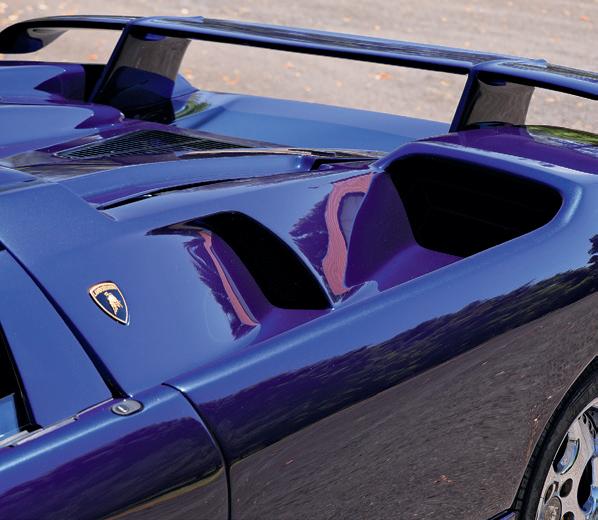
with strong demand from Lamborghini dealers and their customers. Fewer than 470 Diablo VT Roadsters were built globally between 1995 and 1999, with only around 100 produced for the final 1999 model year. Of these, just 80 are believed to have been delivered to the US, marking this as an exceptionally rare opportunity to acquire one of the most desirable open-top Lamborghinis ever built.
This VT Roadster, chassis 12406, was finished in Blu Scuro (Dark Blue) – an $11,000 option – and is complemented by Glacier White leather, creating a stunning example of Italian technology and taste. Factory options included short-ratio gearing (a $4,800 option), chrome wheels, gold accents, optional rear wing, high-performance X-pipe merge exhaust, and original Alpine stereo system.
Showing just 9,293 miles at the time of cataloguing, and with just three owners, 12406 is documented with service records, original window sticker, books, manuals, tools, and emergency parts kit. This car represents a rare opportunity to acquire a limited-production, coachbuilt Lamborghini from the twilight of the analog era – hand-assembled in Sant’Agata before Audi’s influence took hold. As the market continues to celebrate 1990s icons, the Diablo VT Roadster stands tall – an exotic that defined an era and continues to inspire awe. Few cars so clearly embody the Lamborghini ethos, and fewer still offer it with the roof down.
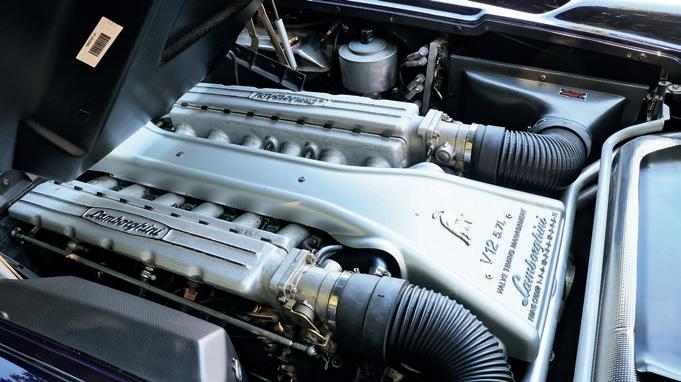
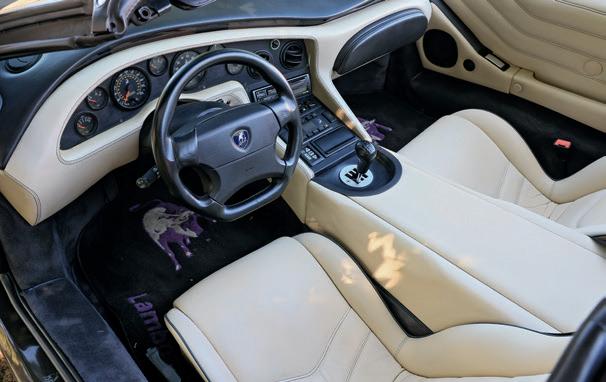
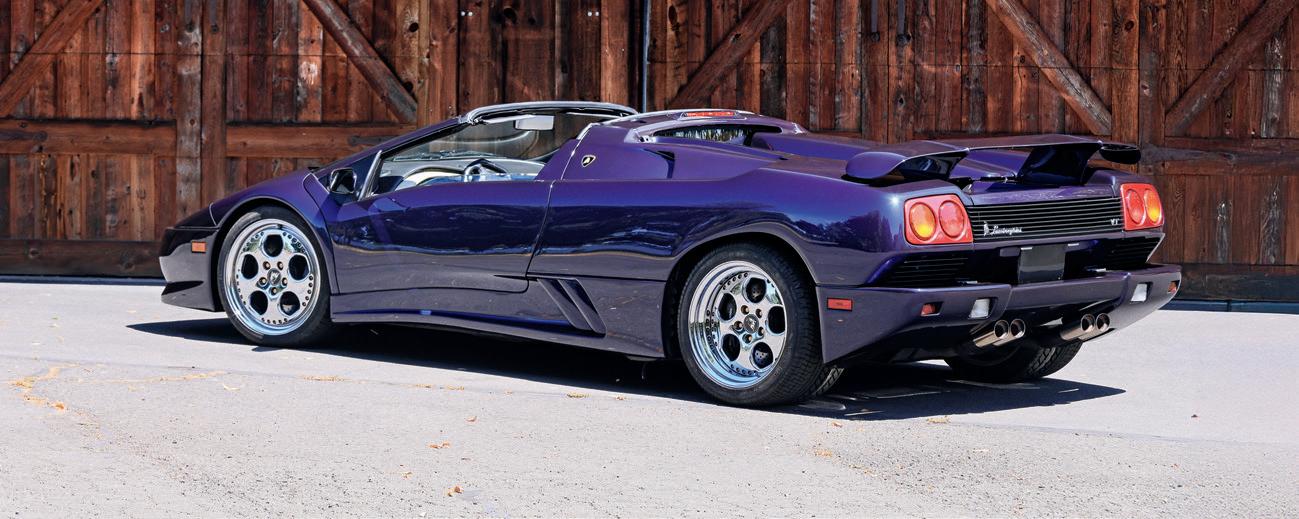
COACHWORK BY GHIA
CHASSIS NO. 7252857
ENGINE NO. C542-8-20290
$300,000–$400,000 without reserve
The unlikely friendship between Virgil Exner, Chrysler’s design boss, and Luigi “Gigi” Segre, Commercial Director for Carrozzeria Ghia in Italy, sparked a fruitful period for the marque, as Italian style met American bravado with Chrysler’s spectacular line of “Idea Cars.” One of these was a stylish New Yorker, built for Chrysler’s Export Boss C.B. Thomas. This car spurred plans for a line of prestigious coupes, sold exclusively through the official French Chrysler distributor, Société French Motors. However, official support from Chrysler quickly waned, as domestic business took precedence, so just a smattering of cars in three series – the Ghia Special, the GS-1, and the ST – were built. The Idea Cars project revitalized Chrysler’s image, injecting Mr. Exner’s team with the inspiration needed to turn out beautiful production cars in the ensuing years.
HIGHLIGHTS
An Exceptionally Rare Coachbuilt Chrysler Features Distinctive and Unique Styling Touches
The Subject of an Extensive 10-Year Restoration
Exhibited at the Pebble Beach Concours d’Elegance® in 2012
American Bravado Meets Exclusive European Styling
Hailing from 1954, chassis 7252857 counts among the GS-1 Series cars, defined by its distinct body swage lines. However, what truly sets this car apart are its unique, low-set quad headlamps, flanking a rounded grille not seen on any other Chrysler Ghia Specials – recalling another famous Ghia-bodied car: Rita Hayworth’s fabulous 1953 Cadillac Special. Little is known about the early history of 7252857, as it is believed to have gone to Argentina early on. Its time there is shrouded in mystery, but the story picks up in the late 1990s, when rumor of the car’s existence found its way to respected car collector Robert Pass of St. Louis, Missouri. Mr. Pass exported the car from Argentina to Miami, reportedly with considerable difficulty. In 1996, the current owner found it advertised by Mr. Pass as needing restoration, and took the plunge on the project.
SPECIFICATIONS
331 CID OHV “FirePower” Hemi V-8 Engine
Single 4-Barrel Carter Downdraft Carburetor
235 BHP at 4,400 RPM
2-Speed PowerFlite Automatic Transmission
4-Wheel Hydraulic Drum Brakes
Front Independent Suspension with Coil Springs
Rear Live Axle with Semi-Elliptical Leaf Springs
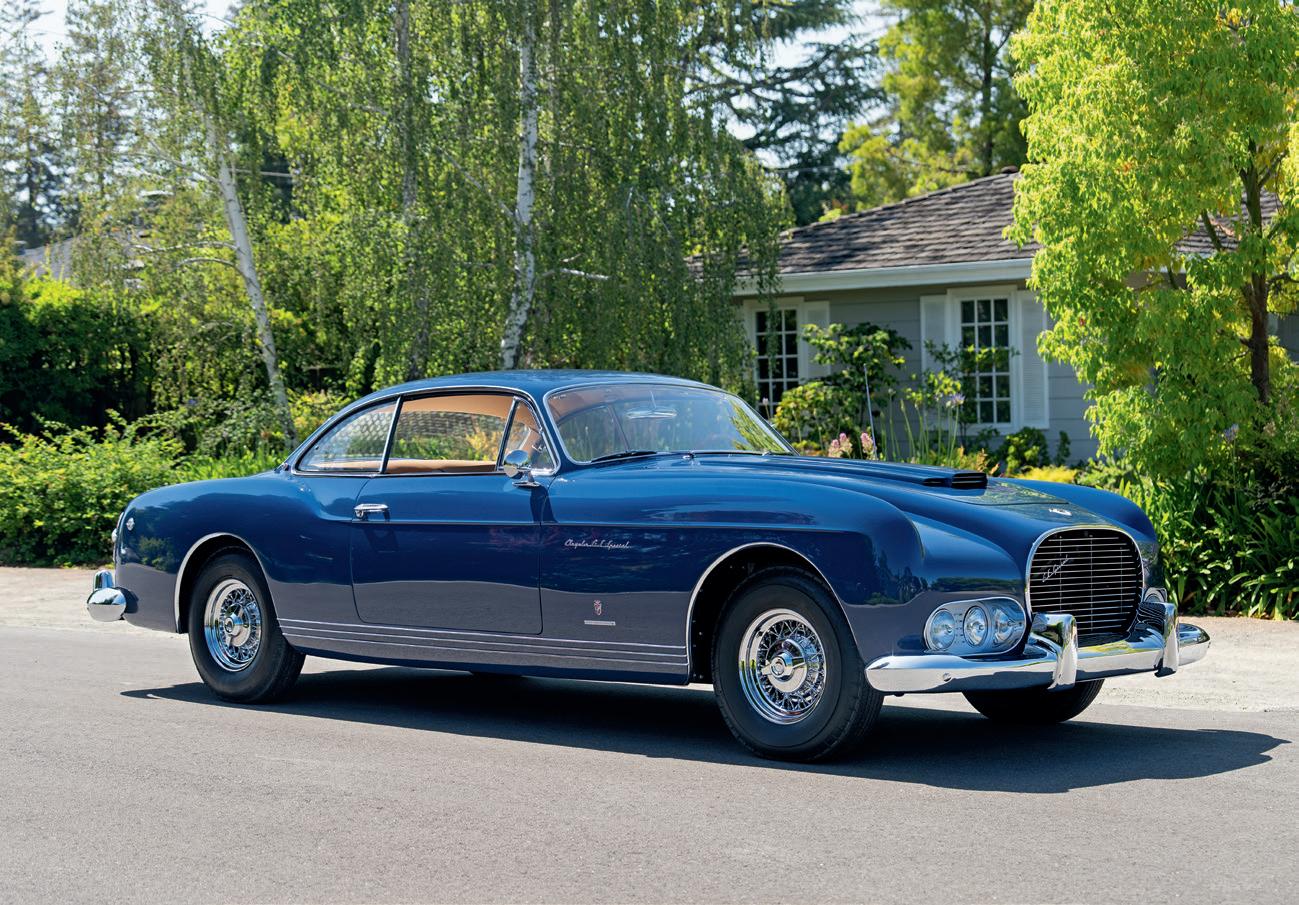

Pebble Beach Concours d’Elegance®, 2012 Hillsborough Concours, 2016
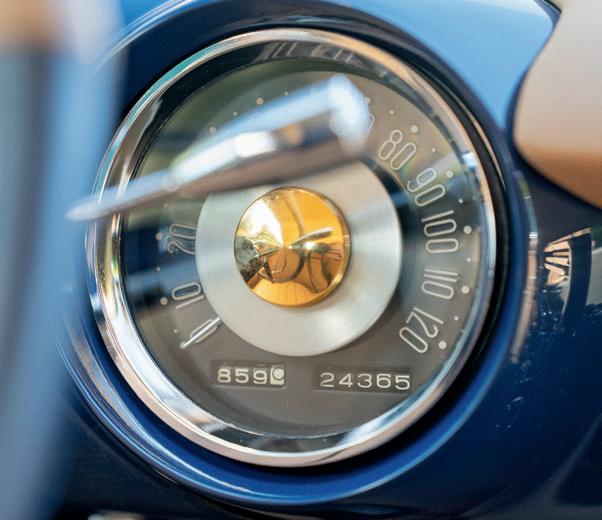
Between 2000 and 2010, chassis 7252857 was restored in California to its current state. Upon stripping back the old paint, restorers noted the front-end metalwork bore tool marks and a construction style consistent with the rest of the body, suggesting that the unique headlamp treatment dates to the car’s original construction.
Finished handsomely in a lively deep blue over tan upholstery, the Chrysler has been minimally shown since its restoration – with appearances at the Pebble Beach Concours d’Elegance® in 2012 and the Hillsborough Concours in 2016. Stylish and unique, it presents a significant opportunity for concours display or touring pleasure. A milestone automobile for both Chrysler and Carrozzeria Ghia, the Chrysler Ghia GS Special represents a fascinating crossroads of Italian styling and American engineering. Its next owner will have the privilege to enjoy one of the most glamorous motorcars of the 1950s, restored to an exquisite level.

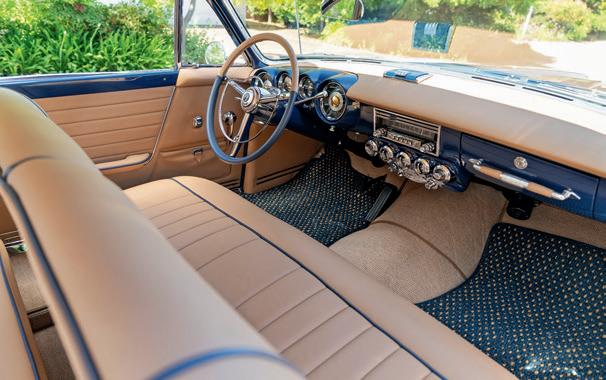
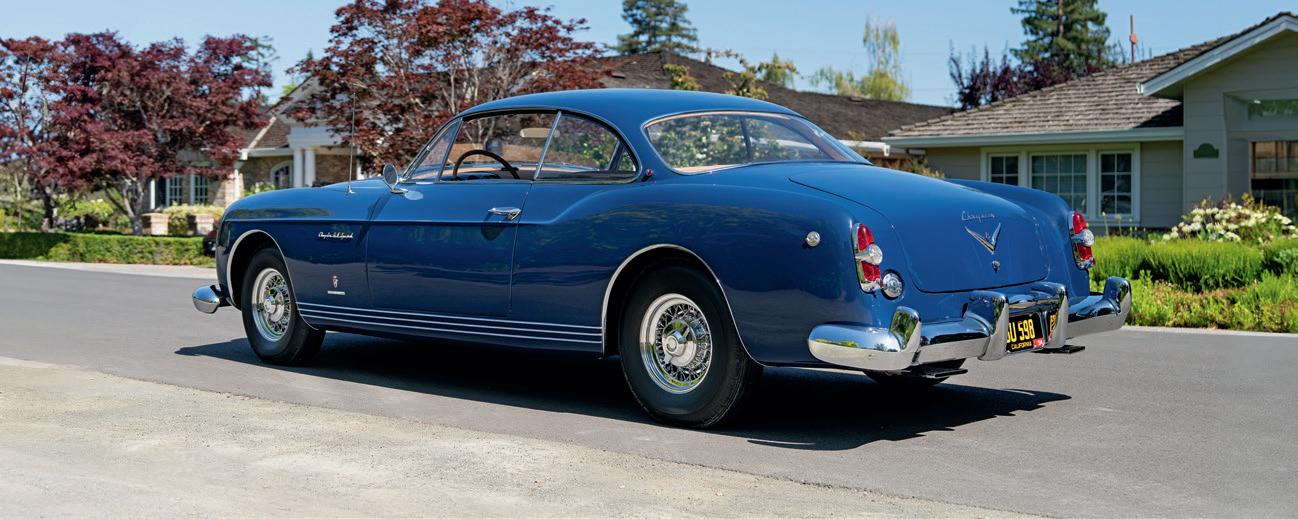
COACHWORK BY ABBOTT OF FARNHAM
CHASSIS NO. 1011
ENGINE NO. 1012
$275,000-$350,000
The Atalanta company was founded with the greatest of intentions, inspired by its leader, Alfred Gough, and his remarkable OHC engines. As advanced as the engine was, the chassis was even more so. The technically advanced suspension was fully independent, and exotic alloys were used, including Hiduminium for strength and Electron to save weight. All of this innovation came at a price: at £750, it was essentially double the price of a Jaguar SS100 or Riley Imp. The enterprise was initially well financed, however only about 20 Atalantas of all variants are thought to have been built, and possibly only two on the short chassis, including the car offered here.
This strikingly handsome and sporting 1938 Atalanta, chassis 1011, was initially
HIGHLIGHTS
One of Approximately 20 Original Atalanta Cars Built
Believed to be One of Two Short-Chassis Examples; Fitted with Sporting Open Roadster Coachwork
Engineered with Advanced Features Including Overhead Cam and Fully Independent Suspension
Recipient of over £280,000 in Mechanical Restorative Work by Blakeney Motorsports Ltd.
Among the Rarest and Most Advanced Prewar British Sports Cars
the property of Violet “Midge” Wilby, who was one of the firm’s investors. Ms. Wilby was a proficient rally driver, who contested various events around Europe in the 1930s. Her team was rounded out by drivers Joan Brotchie and Gordon Wilkins, who went on to win the Manufacturer’s Team Prize at the Welsh Rally in this car. She would eventually own three Atalantas.
According to one account, this Atalanta has been enthusiast owned since 1945. In the custody of a later owner, Werner Oswald, it was the subject of a $250,000 restoration by TT Workshops of Wiltshire in the 1990s and won its class at the Louis Vuitton Concours d’Elegance at the Hurlingham Club in 1997.
1,800 CC SOHC Inline 4-Cylinder Engine
Estimated 85 HP
Dual SU Sidedraft Carburetors
4-Speed Manual Gearbox
4-Wheel Hydraulic Drum Brakes
4-Wheel Independent Suspension with Coil Springs and Friction Shock Absorbers


Violet “Midge” Wilby, UK (acquired new in 1938)
Ryan Hodges, Woodcote, UK (acquired after 1963)
Werner Oswald, Brockton, Staffordshire, UK (acquired circa 1993)
Craig Davis, Pebble Beach, California (acquired in 1996)
Brian Classic, Cheshire, England (acquired circa 2006)
Patrick Ryan, Fletcher, North Carolina (acquired from the above in 2007)
Matthew LeBreton, England (acquired in 2007)
Current Owner (acquired from the above in 2020)
Louis Vuitton Concours d’Elegance, Hurlingham Club, England, 1997 (Best in Class)
Goodwood Festival of Speed, Cartier Style et Luxe, 2007 (Best of Show)
The Concours of Elegance at Hampton Court Palace, England, 2014
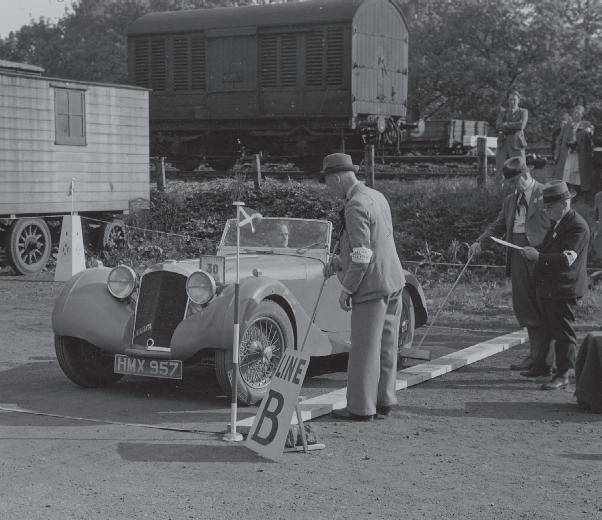
Joining the current owner’s collection in 2020, the Atalanta was sent to the renowned Blakeney Motorsports Ltd. in Hertfordshire, UK, for a major mechanical overhaul. The Gough engine, installed upon its arrival, no. 1009, was found to be worn beyond repair and, in an extreme stroke of luck, a replacement unit no. 1012 was located, assembled with new internals, tested, and installed. One look underneath the car, and the beautifully finished 16” Lockheed brake drums and sophisticated suspension components are immediately revealed to show the same level of finish as the engine compartment. All told, the mechanical work performed by Blakeney Motorsports Ltd., which concluded in 2024 on this incredibly rare and exotic British sports car, totaled over £280,000.
Going the way of the Squire and Pegaso – among other short-lived marques that incorporated genuine advancements and sophisticated, cutting-edge designs into their handcrafted automobiles – the transition from development to series production proved impossible for the brilliantly engineered Atalanta. Fortunately, a handful of the original cars survive – perhaps as many as 10 – but it is likely that none of the others combine the short-chassis proportions, sporting lines, and mechanical preparation of this rakish Atalanta. Rare beyond measure, it represents a most appealing and intriguing opportunity.



COACHWORK BY PARK WARD LTD.
CHASSIS NO. BC42LDJ
ENGINE NO. BC41D
$1,200,000–$1,700,000
Bentley Motors needs little introduction to automotive enthusiasts – the company has cemented a legacy of opulent performance that lasts to this day. From their prewar efforts in the era’s most prestigious racing events to the creation of luxury cars fit for kings and queens, Bentleys have always been highly regarded for their sporting heritage and beautiful craftsmanship.
Following their acquisition by Rolls-Royce circa 1932, most of Bentley’s racing exploits ceased, but the marque was well positioned to succeed, and their introduction of the Rolls-Royce-based 3 ½- and 4 ¼-Litre models confirmed that Bentley was far from dead. Ensuing decades saw further innovation, and some of the world’s greatest performance-oriented luxury cars came from the
HIGHLIGHTS
One of Just 31 Left-Hand-Drive S1 Continental Drophead Coupes
Late-Production Example with Desirable Features
The 1958 Amsterdam International Motor Show Car
Extensive Work Performed by Marque Experts
Documented by Copies of Original Build and Service Records
The Ultimate Mid-Century Open British Luxury Car
company’s factory in Crewe, England.
Introduced in 1955, the Bentley S-Type followed the successful R-Type, incorporating significant improvements such as a longer wheelbase, electrically adjustable rear shock absorbers, lighter steering, better braking, and a four-speed automatic transmission as standard. The standard engine was now a 4.9-litre inline-six that was formerly available only in top-specification models. This new platform served as the firm’s sole offering for the next decade, and 3,072 S1 models were built through 1959. Of these, less than 5% were equipped with custom coachwork, most often by British coachbuilders.
SPECIFICATIONS
4,887 CC Inline 6-Cylinder Engine
Twin SU HD6 Carburetors
Estimated 178 BHP
4-Speed Automatic Transmission
4-Wheel Power-Assisted Drum Brakes with Mechanical Servo
Front Independent Suspension with Coil Springs and Wishbones
Rear Semi-Elliptical Springs with Electrically Controlled Piston-Type Dampers


Mme. S. Mayne, Brussels, Belgium (acquired new in 1958)
Mr. Hersov, London, England (acquired by 1965)
Alfredo Brener, Houston, Texas (acquired by 2005)
Richard Gorman, Miami, Florida (acquired by 2009)
Tim Montgomery, Burlingame, California (acquired in 2009)
Current Owner (acquired from the above in 2014)
In addition to the standard S1 production, 431 high-performance Continental models were built, utilizing lighter-weight aluminum coachwork, done predominantly by Park Ward Ltd., James Young, H.J. Mulliner, and Freestone & Webb. Of these 431 examples, just 94 were drophead coupes, the ultimate Bentley S1 Continental body style.
The S1 Continental offered here is a left-hand-drive drophead coupe, bodied by Park Ward Ltd., and is one of just 31 examples built in this configuration. Adding to its rarity, it is believed to be one of just three that were fitted from new with both power steering and a powered soft top.
According to copies of Bentley factory records on file, chassis BC42LDJ was tested on January 24, 1958, then shipped early the next month on the SS Rijnstroom from London to Amsterdam for display at the Amsterdam International Motor Show. In June of that year, the S1 was delivered to its first owner, Mme S. Mayne of Brussels, Belgium. Originally finished in Steel Blue over a blue leather interior, it was fitted with Dunlop Road Speed tires.
Records indicate that by 1965 the Bentley was owned by Mr. Hersov, a resident of the Mayfair neighborhood of London. By 2005, the car was imported into the US for noted collector Alfredo Brener by Rolls-Royce and Bentley specialist
Vantage Motorworks. Tim Montgomery of Burlingame, California, bought the Bentley from Vantage Motorworks in 2009, and receipts on file from his ownership show extensive work performed. This included new paint and plating by Automotive Services Ltd. of Burlingame, an engine rebuild by R. Gross of Hayward, California, and subsequent engine work by Pacific Performance of San Mateo, California. It is believed that the current cream leather interior was installed around this time.
In 2014, the Bentley was advertised for sale on behalf of Mr. Montgomery by J.D. Classics in the UK, and was discovered by the consignor, an American collector with a world-class assemblage of classic and sports cars who wanted the ultimate example of a Bentley S1 Drophead: a late series, left-hand-drive car with the most desirable taillights. A report and invoice on file document a presale inspection by the experts at P & A Wood, who made a comprehensive list of items that needed attention. Between January and May of 2015, J.D. Classics performed extensive sorting, attending to the items listed by P & A Wood.
In current ownership, the Bentley has been carefully maintained by the consignor’s in-house technicians and regularly exercised. It presents beautifully, wearing its original shade of Steel Blue, and benefiting from proper detailing and storage. It is accompanied by records, a tool kit, jack, and top boot.
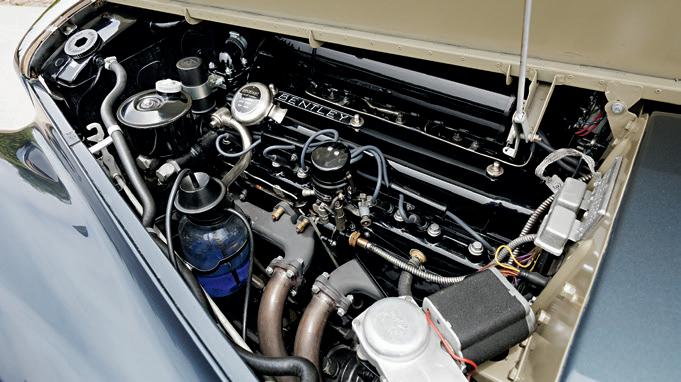

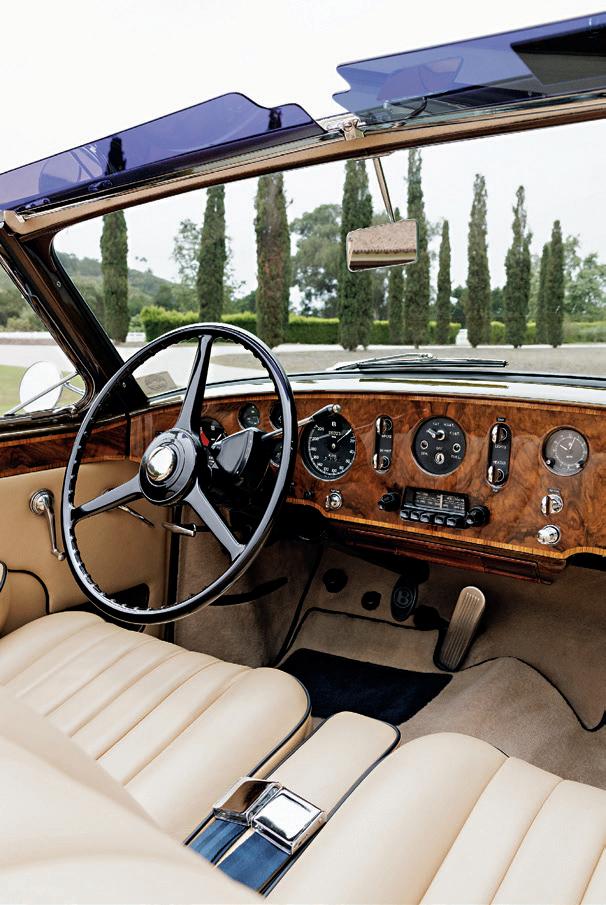

Bentley Continental: Corniche & Azure 1951-2002, by Martin Bennett
Continental Journeys, by Davide Bassoli
Every Cloud Has a Silver Lining, by Davide Bassoli
Original Rolls-Royce & Bentley 1946-1965, by James Taylor
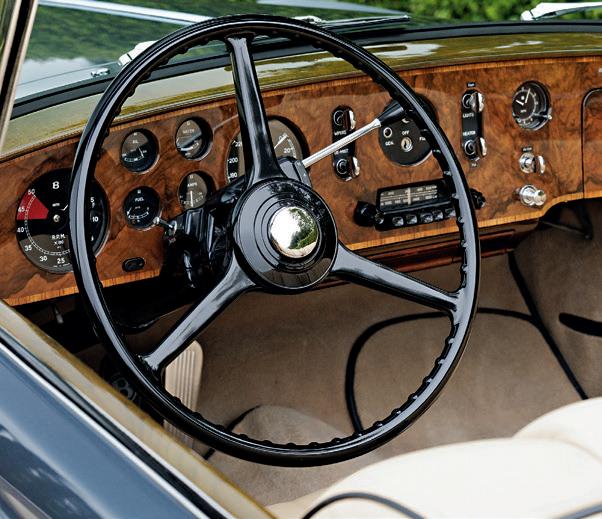
This rare and stunning original, left-hand-drive Bentley S1 Continental Drophead Coupe is the ultimate mid-century luxury car. Its beautiful styling, smooth powertrain, and luxurious road manners combine to create an experience that transcends its peers. As an eminently capable and event-eligible machine, this Bentley deserves a place in any fine collection.

COACHWORK BY ZAGATO
CHASSIS NO. AR10126.00202
ENGINE NO. AR00121.01956
$375,000–$450,000
Introduced in 1960, the Giulietta Sprint Zagato – or SZ – was a dual-purpose competition machine designed to replace the successful Sprint Veloce Alleggerita.
Inspired by the few Sprint Veloces that Zagato had bodied for privateer racers in the late 1950s, the SZ was constructed on a short-wheelbase platform and specially equipped with a high-performance engine, five-speed gearbox, finned alloy drum brakes, and a large-capacity fuel tank. In typical Zagato practice, the SZ’s coachwork was minimal to the extreme, featuring lightweight aluminum panels, Plexiglas windows, and tube-frame bucket seats.
In all, just 200 Giulietta SZs were built, including approximately 40 examples of the updated “Coda Tronca” variant. Featuring an aerodynamically effective long-nose,
HIGHLIGHTS
Among the Most Collectible and Sought-After Postwar Alfa Romeos
Late-Production “Coda Tronca” Variant; One of Approximately 40 Built
Formerly Part of Peter Kaus’ Legendary Rosso Bianco Collection
First in Class at Pebble Beach and Best in Show at the Desert Classic Concours
Tastefully Presented Example of a Quintessential Zagato Design
Kamm-tail design, these late-production SZs were developed for high-speed circuits like Monza and Le Mans. The final evolution of the racing Giulietta and direct predecessor to the Giulia TZ, the SZ was the premier small-displacement GT car of the early 1960s and now ranks among the top tier of collectible Alfa Romeos.
According to Angelo Tito Anselmi’s definitive book Alfa Romeo Giulietta, this SZ Coda Tronca, chassis 00202, was completed in February 1962, originally finished in Metallic Grey and retailed through the official agent in Lugano, Switzerland. While its earliest history is unknown, the SZ’s first recorded owner was Swiss collector Hans Wild of Affoltern am Albis, who also owned a Giulia TZ during the mid-1970s.
SPECIFICATIONS
1,567 CC DOHC Alloy Inline 4-Cylinder Engine
Twin Weber 40 DCOE Carburetors
Estimated 110 BHP at 6,500 RPM
5-Speed Manual Gearbox
4-Wheel Finned Aluminum Drum Brakes
Front Independent-Wishbone Suspension with Coil-Over Shock Absorbers
Rear Live Axle with Radius Arms and Coil-Over Shock Absorbers
*Please note that this vehicle is titled 1961.


Hans Wild, Affoltern am Albis, Switzerland (acquired circa mid-1970s)
Peter Kaus, Aschaffenburg, Germany (acquired from the above in 1979)
Scott Gauthier, Scottsdale, Arizona (acquired by 2005)
Current Owner (acquired from the above)
Pebble Beach Concours d’Elegance®, 2005 (First in Class)
Desert Classic Concours, California, 2009 (Best in Show)
Alfa Romeo Giulietta, by Angelo Tito Anselmi
Alfa Romeo-Zagato SZ TZ, by Marcello Minerbi
Alfa-Romeo Veloce: The Racing Giuliettas, 1956–1963, by Donald Hughes and Vito Witting da Prato
Rosso Bianco Collection: The Biggest Private Collection of Sports Cars in the World, by Mike Riedner

In 1979, the Coda Tronca was acquired by prolific collector Peter Kaus and, for many years, remained a fixture in his legendary Rosso Bianco Museum in Aschaffenburg, Germany. Photos of the SZ appear in Mike Riedner’s book Rosso Bianco Collection: The Biggest Private Collection of Sports Cars in the World, showing it displayed among other Zagato-bodied Alfas including an SVZ, SZ, TZ, and TZ2.
From there, the Coda Tronca passed to Scott Gauthier of Scottsdale, Arizona, another collector with a passion for Zagato-bodied sports cars. Restored under his ownership and finished in the striking color scheme of beige with green and black upholstery, the Alfa Romeo went on to win several significant awards. In 2005, it won First in Class at the Pebble Beach Concours d’Elegance® and, in 2009, was selected as Best in Show at the Desert Classic Concours in Palm Springs, California.
Rarely offered for public sale and exclusive in numbers, the Giulietta SZ is among the most desirable postwar Alfa Romeos and one of the finest GT cars of the early 1960s. This rare Coda Tronca, which has been part of several significant collections in Europe and the US, is a particularly attractive, tastefully presented example. Eligible for numerous events, thrilling to drive, and aesthetically satisfying, the Giulietta SZ offers the quintessential Alfa Romeo experience in a lightweight Zagato-bodied package.



FROM THE BETHEL COLLECTION
CHASSIS NO.
DB5/1759/R
ENGINE NO. 400/1807
$725,000–$825,000 without reserve
Introduced in 1963, the DB5 was the product of nearly five years of Aston Martin’s development and refinement of its predecessor, the DB4. The DB4 innovated considerably, and saw substantial improvements throughout its production. The DB5 combined these lessons and incorporated additional improvements, including a larger engine and many detailed refinements. Designed by Tadek Marek, an all-new, twin-cam engine replaced the LB6 engine that W.O. Bentley had originally designed at Lagonda. The now-iconic engine displaced 3.7 litres in the DB4 but grew to 4.0 litres in the DB5. Initially equipped with twin carburetors, the engine was optionally available with three SU carburetors in late DB4s – an arrangement that became standard on the DB5, as did the previously optional oil cooler. Other sophisticated characteristics
HIGHLIGHTS
Recipient of a Photo-Documented, over-2,600-Hour Rotisserie Restoration Retains Matching-Numbers Engine per Its BMIHT Certificate
Benefits from a LHD Conversion, 4.2-Litre Upgrade and Modern Five-Speed Gearbox
Complete with Workshop and Owner’s Manuals, Parts Catalogue, Tool Roll, Knock-Off Hammer, and ZF Gearbox
Documented with More than 200 Pages of Restoration Records
shared by the cars included rack and pinion steering, four-wheel disc brakes, and a fully synchronized gearbox. Relatively early in the DB5’s production, the David Brown four-speed was replaced with a ZF five-speed gearbox.
This fantastic DB5, chassis DB5/1759/R, is an original ZF five-speed example and was first delivered in the UK finished in Dubonnet Rosso (Deep Burgundy Red) with a Fawn interior. By the late 1980s, the car was in California, and was later exported to British Columbia, Canada, where it received substantial restoration work in 1994. At that time, a left-hand-drive conversion was performed and the engine was rebuilt to displace 4.2 litres. In 2003, a five-speed Toyota gearbox was fitted using a kit supplied by Conversion Components Ltd., which
4,235 CC DOHC Alloy Inline 6-Cylinder Engine
Three SU Carburetors
Estimated 290 BHP at 5,500 RPM
5-Speed Manual Gearbox
4-Wheel Servo-Assisted Disc Brakes
Front Independent Suspension with Wishbones and Coil Springs
Rear Live Axle with Trailing Links and Watts Linkage

First Owner, UK (acquired new via Plough Motors Ltd. in 1964)
Peter Burchell, California (acquired by 1989)
Aston Martin Vintage Racing Services, Stamford, Connecticut (acquired from the above in 1989)
Gabriel Gedak, Surrey, British Columbia, Canada (acquired from the above in 1994)
Current Owner (acquired from the above in 2016)
The Quail, A Motorsports Gathering, 2016 Park Place Luxury & Supercar Showcase Collector’s Concours, Texas, 2019 (Chairman’s Choice Award)

has specialized in fitting more modern gearboxes to classic British cars for over 30 years. The Toyota unit is quieter and more user-friendly than the stock ZF five-speed, which is included in the sale.
From 2013 to 2015, the Aston received a photo-documented, over-2,600-hour rotisserie restoration by St. Pierre Restorations of Surrey, British Columbia, which included a respray in the iconic shade of Silver Birch. The interior was retrimmed using new Vaumol Connolly leather and the suspension, electrical, and braking systems also received restoration work. The driveline was inspected and serviced at this time, including the engine, which still had less than 4,000 miles since being previously rebuilt. A new stainless steel exhaust system was fitted, and the shock absorbers were renewed as well.
Shown at The Quail, A Motorsports Gathering, and offered with workshop and owner’s manuals, parts catalogue, tool roll, extensive documentation and BMIHT Certificate, this DB5 has been used sparingly since its restoration and presents beautifully. Benefiting from desirable driveability upgrades, this DB5 represents an ideal combination of elegance, mechanical attention, and substantial performance.
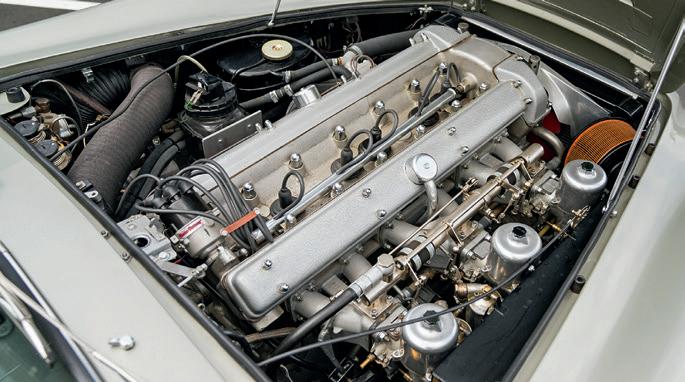
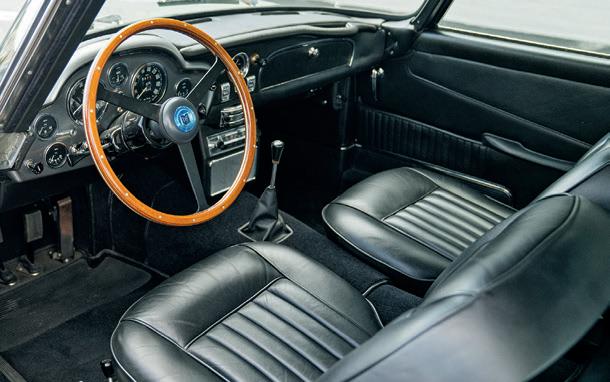
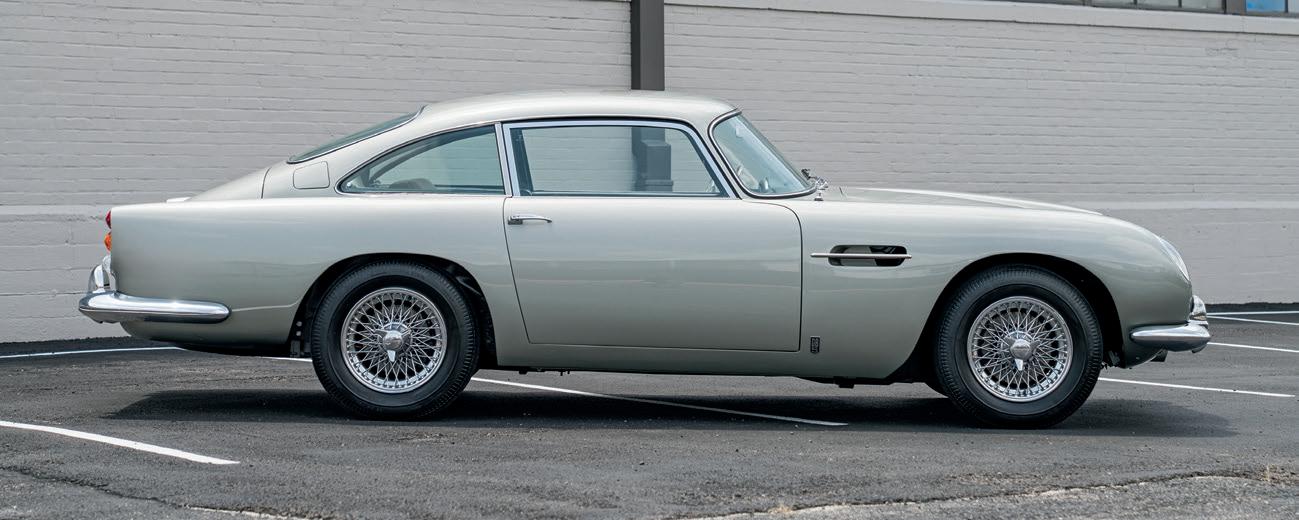
FROM THE BETHEL COLLECTION
CHASSIS NO. FJ4365659
$70,000–$90,000 without reserve
The Toyota Land Cruiser is a nameplate legendary for its reliability in many of the world’s most demanding environments. Inspired by the products built by both Jeep and Land Rover, the Land Cruiser underwent several major revisions over the years. However, the FJ40 is what many cite as the truck that made the Land Cruiser name widely recognized. Built in many configurations from 1960 to 2001, the FJ40 was available in multiple body styles and wheelbases, with soft or hard roofs, and the buyer’s choice of four- or six-cylinder engines powered by gasoline or diesel.
This 1980 Toyota FJ43 is a sought-after medium-wheelbase model with a soft top. In the 2010s, it received an extensive restoration by marque experts
HIGHLIGHTS
An Uncommon Soft-Top, Medium-Wheelbase Combination Recommissioned by Marque Experts The FJ Company Finished in John Deere Green over Gray Upholstery
Equipped with Power Steering and Front Disc Brakes
A Special Variant of Toyota’s Classic Off-Roader
The FJ Company in Miami. This example features a very appealing specification, which made it a perfect candidate for restoration. The truck is equipped with a 2F gasoline inline-six engine, power steering, four-speed manual gearbox, and front disc brakes. The engine and gearbox were recommissioned, new disc brakes were fitted, and the body was stripped to bare metal before being repainted in striking John Deere Green.
This rare FJ43 variant is a stunning and capable off-roader that has been finished to an impressively high standard by The FJ Company and worthy of serious consideration.
SPECIFICATIONS
4,230 CC OHV Inline 6-Cylinder Engine
Single Aisan Carburetor
135 BHP at 3,600 RPM
4-Speed Manual Gearbox with 2-Speed Transfer Case and 4-Wheel Drive
Front Disc, Rear Drum Servo-Assisted Hydraulic Brakes
Front and Rear Live-Axle Suspension with Semi-Elliptical Leaf Springs


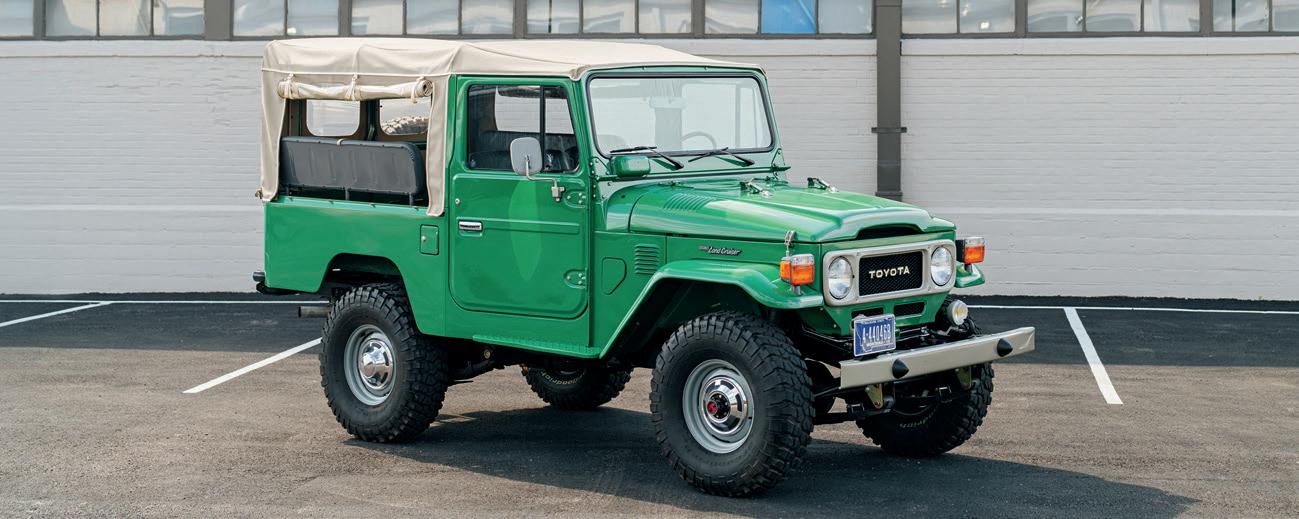
FROM THE BETHEL COLLECTION
VIN. WP0CA298X5L001466
$1,250,000–$1,500,000 without reserve
First unveiled as a concept at the 2000 Paris Motor Show, the Porsche Carrera GT marked a dramatic shift in the company’s design and engineering philosophy. More extreme than any previous road model, the Carrera GT drew such overwhelming interest that Porsche committed to a limited production run beginning in 2003. Just 1,270 examples were built before production concluded in May 2006.
Visually distinct from the 911 lineage, the Carrera GT featured a low, purposeful shape with a clean front fascia, taut surfaces, and radiused wheel arches. The cabin combined carbon fiber, magnesium, and leather in a focused layout anchored by a central control console. A laminated beechwood shift knob paid
HIGHLIGHTS
Porsche’s Analog Supercar, Featuring a 605 HP V-10 and Manual Gearbox
One of Only 1,270 Built; One of Just 644 for the US Market
Classic Color Scheme of GT Silver Metallic over Dark Grey Leather
Displaying Just 7,652 Miles at the Time of Cataloguing
Factory Recall Performed by Park Place Porsche of Dallas in March 2025
Accompanied by Books, Tools, Battery Tender, Records, and Luggage
homage to the 917 prototypes that claimed Porsche’s first overall wins at Le Mans in 1970 and 1971.
Technically, the Carrera GT broke new ground. It was the first production car to utilize a full carbon fiber-reinforced plastic (CFRP) monocoque chassis, developed with the Italian aerospace supplier ATR Composites Group. A ground-effect underbody delivered meaningful downforce, while the pushrod suspension system, mounted inboard to reduce unsprung mass, used stainless-steel components for maximum precision.
At its core was a 5.7-liter V-10 developed for a shelved racing program. Positioned
SPECIFICATIONS
5,733 CC DOHC V-10 Engine
Bosch Motronic Electronic Fuel Injection
605 BHP at 8,000 RPM
6-Speed Manual Transaxle
4-Wheel Carbon Ceramic Ventilated Disc Brakes
4-Wheel Independent Suspension with Pushrod Linkage

Original Owner, New York (acquired new via Porsche of Roslyn in 2006)
Unknown Owner, New York (acquired in 2010)
Jerome Jacalone, New York City, New York (acquired in 2012)
Mario Montoya, East Setauket, New York (acquired in 2013)
Private Collection (acquired from the above)
Current Owner (acquired in 2017)
midship, the naturally aspirated engine produced 605 hp at 8,000 rpm and 435 lbs./ft. of torque at 5,750 rpm, channeled through a six-speed manual gearbox with a race-bred ceramic twin-plate clutch. Porsche Ceramic Composite Brakes (PCCB) provided extraordinary stopping power with minimal rotational mass. Notably, the car was delivered without electronic stability control, an intentional decision reflecting Porsche’s confidence in its balance and driver feedback.
In its June 2004 test, Car and Driver recorded a 0–60 mph sprint in 3.5 seconds, 0–100 mph in 6.8 seconds, and a top speed of 205 mph. Reviewer Larry Webster wrote, “Ferdinand Porsche would be proud of the Carrera GT... The exotic $448,400, 605-hp Carrera GT revealed here is arguably the finest sports car the company has ever produced.”
This 2005 Porsche Carrera GT is finished in GT Silver Metallic over Dark Grey leather with black carpeting. One of 644 US-delivered examples, it was previously owned by a succession of New York-based collectors. According to records on file, paint protection film was applied to the front fascia in 2013. In October 2014, a full engine-out service was reported, addressing coils, water pump, fluids, and filters. In June 2016, the rear main seal and clutch were replaced, along with a routine service. The current owner acquired the Carrera GT in January 2017, with the car showing just 5,150 miles at the time.
Under current ownership, the Carrera GT has continued to receive careful maintenance. An annual service was performed in January 2022, followed by a new battery in January 2024. In September 2024, the clutch was measured at 30.54 mm, just below the factory-new specification of 31.15 mm and well above the 28.00 mm wear limit, underscoring the car’s careful use and mechanical integrity.
In March 2025, Park Place Porsche in Dallas carried out the factory recall to address flaws in the spherical joints of the wishbone suspension. Updated components were installed, and the car received a full inspection. As part of the same service campaign, a new set of Michelin Pilot Sport Cup 2 tires, developed specifically for the Carrera GT, was fitted. These modern tires improve grip and safety, offering quicker lap times and reinforcing Porsche’s commitment to the model two decades after launch.
Since 2017, this Carrera GT has been selectively driven and thoughtfully shown, including an exhibition at The Quail, A Motorsports Gathering in Carmel, California, in August 2024, highlighting its continued appeal and presentation quality. Under current ownership, approximately 2,500 miles have been added, bringing the total to 7,652 miles at the time of cataloguing. It is offered with its original books, battery tender, service records, and a seven-piece leather

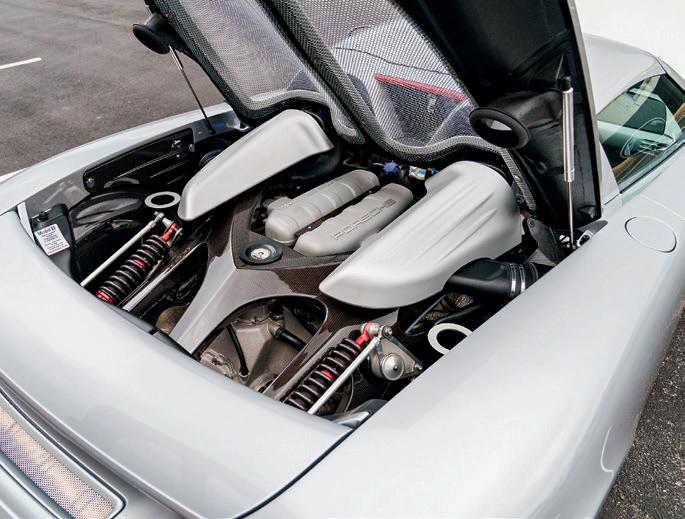

The Quail, A Motorsports Gathering, 2024
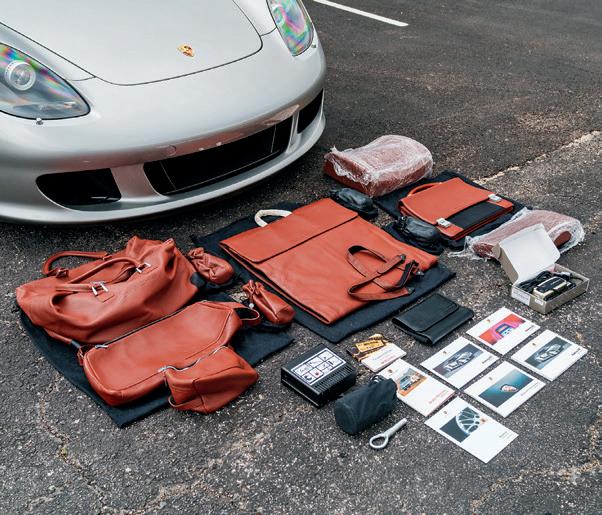
luggage set, including a travel bag, briefcase, shoulder bag, suit bag, center console bag, and two tool rolls.
As one of the last great analog supercars, the Carrera GT delivers unmatched driver engagement and technical brilliance. For the discerning Porsche collector, this well-preserved and properly maintained example presents a rare opportunity to acquire a true icon of modern performance motoring.
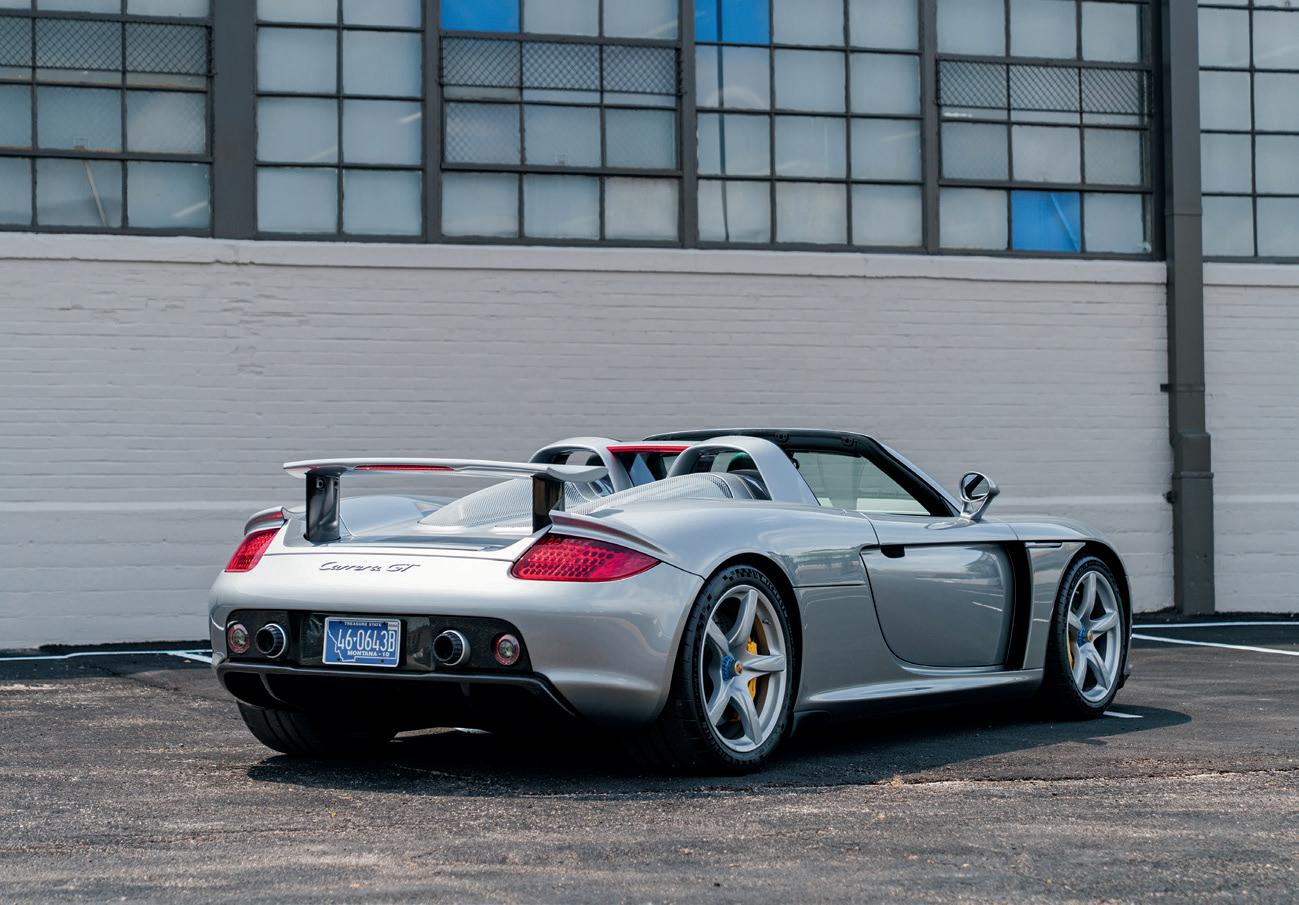
FROM THE BETHEL COLLECTION
COACHWORK BY DRAUZ
CHASSIS NO. 88316
ENGINE NO. 87462
$190,000–$230,000 without reserve
Introduced in 1948, the 356 was Porsche’s first production car and evolved steadily throughout its lifespan. For 1960, the revised 356 B featured raised headlights, recontoured bumpers, and improved steering and brakes. This 1961 Porsche 356 B Roadster is one of approximately 2,653 T-5 body examples built by Karosserie Drauz from 1960 to 1961. As documented by its Porsche Certificate of Authenticity on file, this car was originally finished in Slate Grey and factory-equipped with the optional type 616/2 “Super” engine, rated at 75 hp – a 25% increase in output over the “Normal” engine.
Formerly owned by noted collector Ted Gildred and acquired by the current caretaker in 2016, this 356 B Super Roadster remains in lovely condition
HIGHLIGHTS
One of Approximately 2,655 T-5 Roadsters Built by Drauz
Well-Preserved Older Restoration in Attractive Color Scheme
Equipped with Higher-Performing Type 616/2 “Super” Engine
Thoughtfully Upgraded with 12-Volt Electrical System and Disc Brakes
Offered with Books, Tools, and Porsche Certificate of Authenticity
throughout. Under the consignor’s ownership, the Porsche has been regularly serviced by Norwood Auto Italia in Carrollton, Texas, and benefits from thoughtful upgrades, including a 12-volt electrical conversion, disc brakes, and improved headlight performance. It is fitted with 4 1⁄2" chrome wheels that accommodate slightly wider tires, enhancing grip while retaining a period-correct appearance. Though not original, the engine is a correct-type 616/2 Super, close in sequence to the original unit.
Offered with books, tools, and documentation, it represents one of the rarest and most desirable 356 variants. Attractive, well sorted, and highly usable, this 356 B Super Roadster is an ideal candidate for a variety of driving events.
1,582 CC Type 616/2 Flat 4-Cylinder Engine
Twin Zenith Carburetors
75 BHP at 5,000 RPM
4-Speed Manual Transaxle
4-Wheel Disc Brakes
4-Wheel Independent Suspension
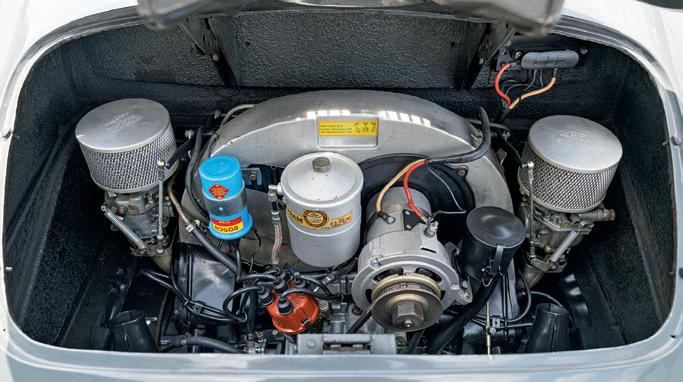
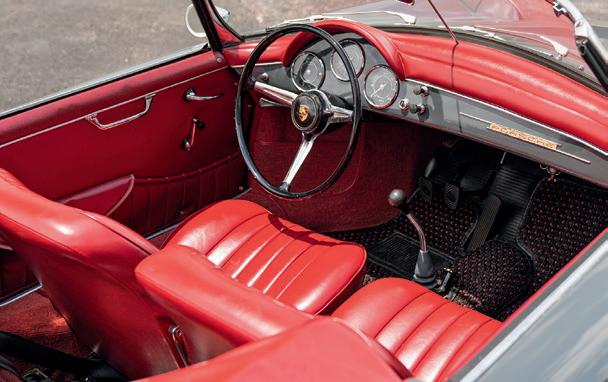

FROM THE BETHEL COLLECTION COACHWORK BY PININFARINA
CHASSIS NO. 9237
ENGINE NO. 9237 (SEE TEXT)
$500,000–$600,000 without reserve
Ferrari’s GTC is an interesting model that had no direct predecessor or successor, yet remains one of the best-liked and most sought-after vintage Ferraris. The 330 GTC combines the sophisticated chassis and transaxle layout of Ferrari’s raciest road cars like the 275 GTB with the visibility, trunk space, and flexibility of the 2+2 models. The 330 GTC’s 4.0-liter V-12 delivers the same 300 hp peak output as the 3.3-liter 275 GTB/4, but does so at a full 1,000 rpm sooner at a still lofty 7,000 rpm, while also making more torque at lower rpm. The resulting car still feels like a Ferrari, but has an effortlessness that is welcome in modern traffic.
The elegant Pininfarina styling is supremely attractive but also understated:
HIGHLIGHTS
Classiche-Certified Example of One of the Best-Driving Ferrari Road Cars of the Era
Finished in Its Elegant Original Color Combination of Argento with Nero Leather Interior
Extensive Restoration Work Overseen by Marque Experts
Accompanied by Original Engine, Books, Tools, Red Book, and Massini Report
The Connoisseur’s Ferrari, Combining Understated Pininfarina Styling with Transaxle and V-12
*Please note that this vehicle is
if Ferrari intended the 275 GTB for the playboy, then the GTC was for the gentleman who wanted to drive a Ferrari but did not need everyone to know it.
By the late 1960s, Ferrari’s 2+2 models gained independent rear suspension, and the 275 GTB’s replacement, the Daytona, had so much power and torque that the GTC’s niche narrowed. Thus ended production of a car that Ferrari connoisseurs agree is among the best classic Ferraris to own and drive. Just 600 of the 330 GTCs were built – a small number in absolute terms, but a commercial success for Ferrari, demonstrating the market for a car that went like a Ferrari but did so tastefully and respectably.
3,967 CC Tipo 209 SOHC 60° V-12 Engine
Three Weber Downdraft Carburetors
300 BHP at 6,600 RPM
5-Speed Manual Transaxle
4-Wheel Girling Vacuum-Assisted Disc Brakes
4-Wheel Independent Double-Wishbone Coil-Spring Suspension

Mr. Ardemagni, Milan, Italy (acquired new in 1966)
Fred Coder, St. Joseph, Missouri (acquired in 1975)
Bruce Clemons, Topeka, Kansas (acquired in 1978)
William Kline, Waterloo, Indiana (acquired in early 1979)
George and Cheryl Walker, High Point, North Carolina (acquired via Foreign Cars Italia Inc. in 1983)
Thomas Harrow, New York City, New York (acquired via Foreign Cars Italia Inc. in 1986)
Private Collection, Los Angeles, California (acquired in 2007)
Current Owner (acquired from the above in 2015)
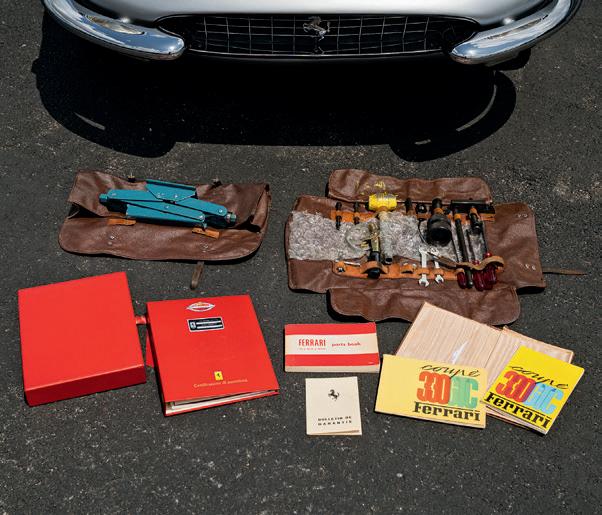
FCA National Meeting, Wisconsin, 1979
The Quail, A Motorsports Gathering, California, 2010
Consistent with that ethos, this 330 GTC, chassis 9237, was originally finished in silver with a black leather interior. Documented by Ferrari historian Marcel Massini, this car was originally supplied by Crepaldi, the official Ferrari dealer in Milan. It was imported to the US in 1975, when it was repainted red. Chassis 9237 spent time with owners in the Midwest between 1975 and 1983, and was displayed at the 1979 FCA National Meeting at Elkhart Lake, Wisconsin. The car was relocated by a new owner to the East Coast in 1986, where it remained for over two decades.
From 2008 to 2010, chassis 9237 received a cosmetic restoration, during which it was returned to its original color combination. The consignor acquired the car in 2015, and spent approximately $300,000 on further restoration, mostly mechanical, including sourcing and installing a correct tipo 209 replacement engine from GTO Engineering – although the car’s original, disassembled engine (no. 9237) is included. Since the completion of the work, 9237 has been classiche certified and has proven to be an ideal example to drive and enjoy. This fine example is offered with books, tools, jack, and Ferrari Classiche Red Book and stands ready for a new owner to enjoy one of the best-driving and most-respected Enzo-era Ferraris.
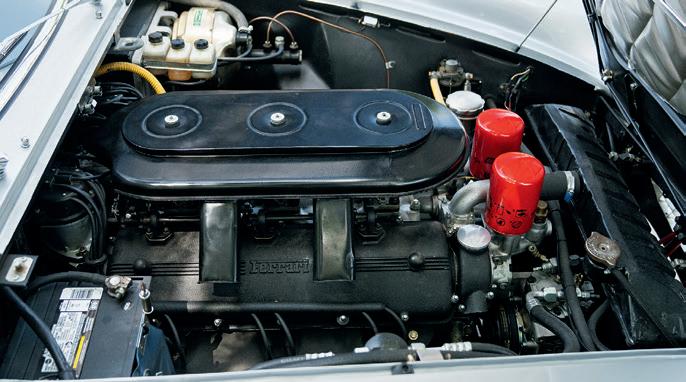

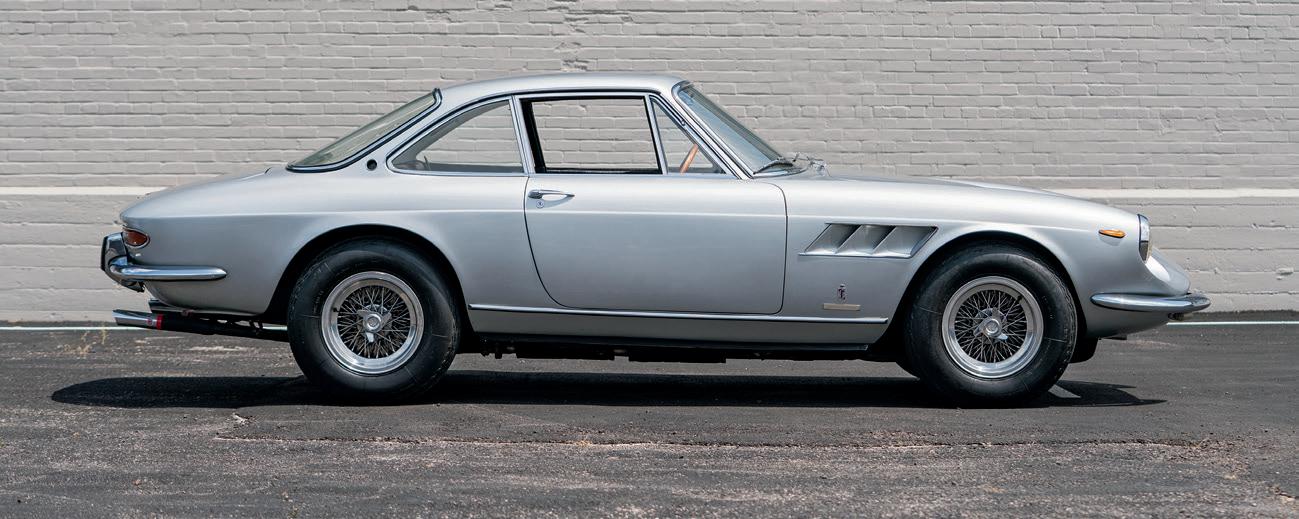
FROM THE BETHEL COLLECTION
CHASSIS NO. 0F02G171817
$120,000–$150,000 without reserve
Developed to meet SCCA Trans Am racing homologation requirements, the Boss 302 was a track-focused variant of the Mustang that could be purchased straight off the showroom floor. Competing with the Camaro Z/28, the Boss 302 featured a heavily redesigned variant of Ford’s 302 cid V-8 with solid lifters, better flowing heads, and four-bolt main bearing caps. By selecting the Boss 302 package, the car was automatically equipped with a four-speed manual gearbox, front disc brakes, front and rear aerodynamic upgrades, and a lower, stiffer suspension. Built only in 1969 and 1970, the Boss 302 was an exciting road car and a successful race car, winning the Manufacturer’s Championship in the 1970 Trans Am season.
Ford’s Road-Going Homologation Special for Trans Am Competition
Finished in Grabber Orange over Black Clarion Knit and Corinthian Vinyl
Restored to a Very High Standard by Specialist Andy Adelson
Ordered with Traction-Lok Differential, Shaker Hood, Power Steering, and Magnum 500 Wheels
Offered with an Elite Marti Report
This 1970 Ford Mustang Boss 302 is finished in Grabber Orange, over a black Clarion knit and Corinthian vinyl interior. The accompanying Elite Marti Report indicates it was delivered new to HP Smith Motors of Omaha, Nebraska, with options including Magnum 500 chrome wheels, power steering, a shaker hood scoop, and a 3.91 Traction-Lok differential.
This Mustang benefits from an extensive restoration by marque specialist Andy Adelson of Detroit, Michigan, which was carried out in the mid-2000s. It remains in exceptional condition and is a beautiful representation of Ford’s famous road-going race car.
302 CID Solid-Lifter OHV V-8 Engine
Single 4-Barrel Holley Downdraft Carburetor
304 BHP at 5,800 RPM
4-Speed Manual Gearbox
Front Disc Brakes, Rear Drums
Front Independent Suspension with Coil Springs
Rear Live Axle with Semi-Elliptical Leaf Springs
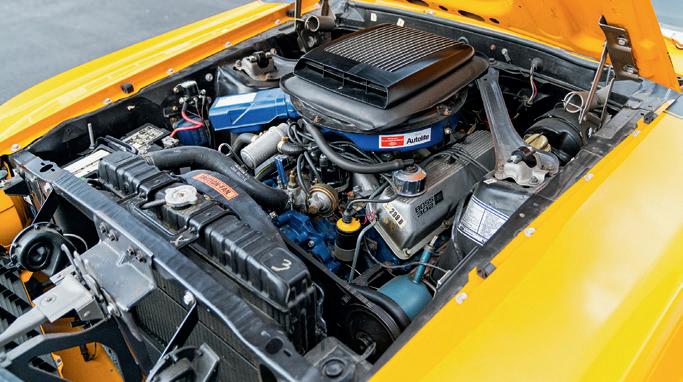


VIN. WDDRJ7JA7EA010360
$190,000–$230,000 without reserve
When the Mercedes-Benz SLS AMG debuted in 2009, it was a clear throwback to the W198 300 SL and the first production Mercedes-Benz since 1957 to feature its famed top-hinged doors. Designed as a limited-production halo car for Mercedes-Benz, the SLS was the first completely clean-sheet design carried out by the team at AMG. It was significantly lighter and some say more comfortable to pilot than the SLR McLaren that had previously filled Mercedes-Benz’s supercar spot, and is powered by a thrilling, naturally aspirated 6.2-liter V-8. In 2012, Mercedes-Benz introduced the SLS AMG GT, a heavily revised version of the SLS featuring increased power, a faster-shifting gearbox, and revised suspension.
This 2014 SLS AMG GT is from the final year of production and is finished in the appealing color combination of AMG Imola Gray over a two-tone Mystic Red and cream leather interior. This car was purchased at Park Place Mercedes-Benz in Dallas, Texas, and has been under the care of the consignor since new. Showing 17,433 miles at the time of cataloguing, this car was optioned with extended carbon fiber trim, featuring gloss carbon on the center console and door sills, as well as the optional 10-spoke forged wheels, finished in black. This SLS GT stands as a fitting tribute to the original 300 SL, and is eligible for Gull Wing Group tours and events. This end-of-the-run example, coming from single ownership, is a great way to experience the modern Gullwing.
HIGHLIGHTS
Mercedes-Benz Modern Tribute to the 300 SL Gullwing Rare Color Combination of AMG Imola Gray over Two-Tone Mystic Red Leather
Updated GT Variant with Increased Power, Revised Suspension, and an Improved Gearbox
Late-Production Example with Single Ownership Since New Eligible for Use on Gull Wing Group Events
SPECIFICATIONS
6,208 CC DOHC V-8 Engine
Sequential Multi-Port Fuel Injection
583 BHP at 6,800 RPM
7-Speed Dual-Clutch Automatic Transmission
4-Wheel Ventilated Disc Brakes
4-Wheel Double-Wishbone Suspension with Coil Springs
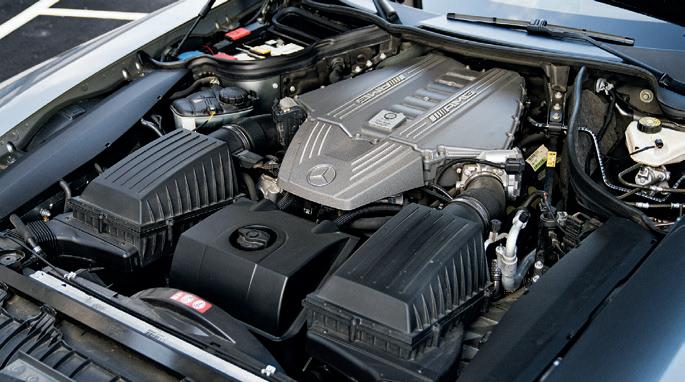
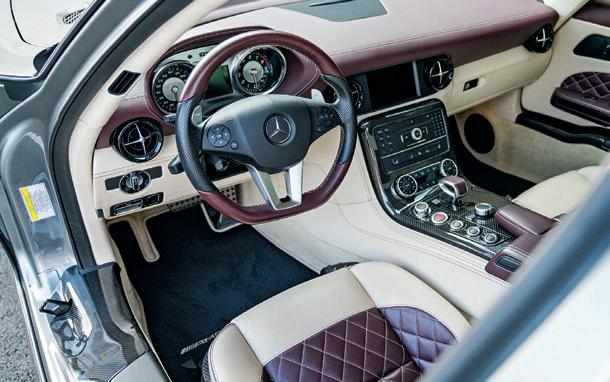

COACHWORK BY SCAGLIETTI
CHASSIS NO. 0769 GT
ENGINE NO. 0769 GT
$7,500,000–$9,000,000
The Ferrari California Spider offered here is not merely the first of its kind – it is the prototype, the genesis of one of the most iconic and desirable series of sports cars ever built. Unique in every respect, chassis 0769 GT is the original vision that set the tone for all that followed.
The California Spider was born of a bold idea championed by two key figures in Ferrari’s American expansion: Luigi Chinetti, Ferrari’s East Coast importer, and John von Neumann, his West Coast counterpart. Their request was simple but ambitious: create a dual-purpose, open-top sports car tailored for the American market – something equally at home on the street or the track. Ferrari responded by building the California Spider on its versatile and highly
HIGHLIGHTS
The Original California Spider Prototype; A Cornerstone of Ferrari History Photographed to Launch the California Spider; Featured in Factory Literature Delivered New to George Arents, Amateur Racer and Key Ferrari Patron Award-Winning Restoration by Renowned Ferrari Specialist Rare Drive Inc.
First in Class at Pebble Beach, Rosso 70 Maranello, and Amelia Island Offered with Ferrari Classiche Red Book, Massini Report, Books, and Tools
developed Tipo 508C chassis, the same foundation used for models ranging from the elegant Ellena coupe to the race-bred Tour de France (TdF) Berlinetta.
That foundational chassis for the prototype was 0769 GT.
Under the hood, Ferrari installed a state-of-the-art, inside-plug Tipo 128C Colombo V-12, featuring six-port cylinder heads, hairpin valve springs, a single rear-mounted distributor, and three Weber 36 DCL3 carburetors. While the engine was proven in prior GT models, the driveline mated to it in this prototype was somewhat unusual. It featured a reverse-pattern gearbox with Porsche-type synchromesh and a non-limited-slip differential – a mechanical configuration
2,953 CC SOHC Tipo 128C V-12 Engine
Three Weber 36 DCL3 Carburetors
220 BHP at 7,000 RPM
4-Speed Manual Gearbox
4-Wheel Hydraulic Drum Brakes
Front Independent Coil-Spring Suspension
Rear Live Axle with Trailing Arms and Shock Absorbers
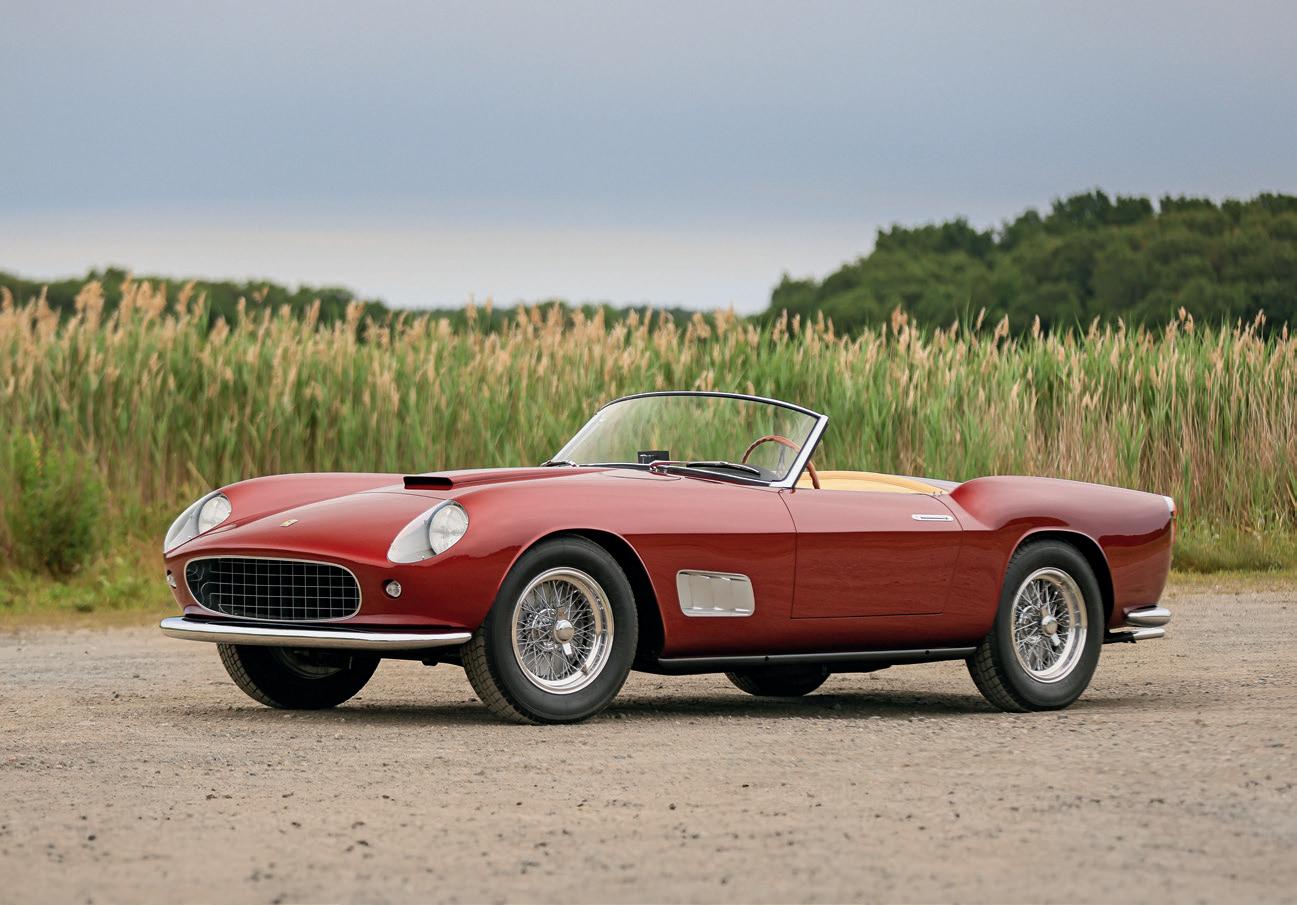

George Arents, Coconut Grove, Florida (acquired new via Luigi Chinetti in 1958)
Frank Ramirez de Carellano, Puerto Rico (acquired from the above in 1960)
Basil Davila, Santurce, Puerto Rico (acquired from the above circa 1965)
Orval Sifontes, Puerto Rico (acquired by 1975)
Warren Weiner, Villanova, Pennsylvania (acquired in 1986)
Thomas Knudson, San Francisco, California (acquired from the above in 2004)
Brandon Wang, London, England (acquired in 2006)
Current Owner (acquired from the above in 2012)
Puerto Rico Festival Race, 1961, Rosales (1st)
Antilles De Diego Trophy, 1961, Merino (1st)
not seen on production Californias and a curious insight into the experimental nature of this prototype.
With the chassis and engine complete, 0769 GT was sent to Carrozzeria Scaglietti in Modena for bodywork. Though Scaglietti was primarily responsible for Ferrari’s competition cars, they took inspiration from Pinin Farina’s Series I Cabriolet – an elegant open-top road car – for the design of the California Spider.
The resulting design drew on both sources: the elegance of the Series I Cabriolet and the aggression of Ferrari’s racing berlinettas. It was, in essence, a one-off blend that previewed the distinctive California Spider DNA: covered headlights, a bold hood scoop, full-width bumpers, and purposeful detailing throughout.
Ferrari historian Stanley Nowak offers a detailed appraisal of 0769 GT in his authoritative book Ferrari Spyder California, writing that “the prototype design executed by Scaglietti was a simplified and more rakish version of the earlier Pinin Farina designs... The windscreen angle was very important; it gave the whole car a distinctly racing look. Another unusual feature was the sharp corner formed where the forward parts of the rear fenders intersected the lower panel coming back from the door. This particular sharpness was not duplicated on the production versions.”
The prototype borrowed the grille, side vents, and taillights from the 250 GT Tour de France, as well as interior elements such as its gauge cluster, Nardi steering wheel, and wrinkle-finish dashboard. Details like the offset shifter, reverse-cut hood scoop, and competition-style rubber mats instead of carpets made it clear: this was not a boulevardier’s car – it was a driver’s machine.
Completed on December 16, 1957, six months before the first production California Spiders, 0769 GT was used extensively by the factory to promote the model. A series of official Ferrari photographs taken in the Modena botanical gardens showcased the car, and several of these images appeared in the original California Spider brochure and related sales literature.
On January 3, 1958, the prototype arrived in New York and was sold through Luigi Chinetti Motors to George Arents, Chinetti’s first business partner and a longtime Ferrari patron. In correspondence with Nowak, Arents recalled, “It was John von Neumann who came up with the idea of a chop top TDF and Luigi who saw it through. The name was chosen by Luigi partly for John and partly as Coco says because of his father’s growing pride in his American citizenship… I agreed to accept the first prototype for generalized road testing and a little local racing in Florida.”


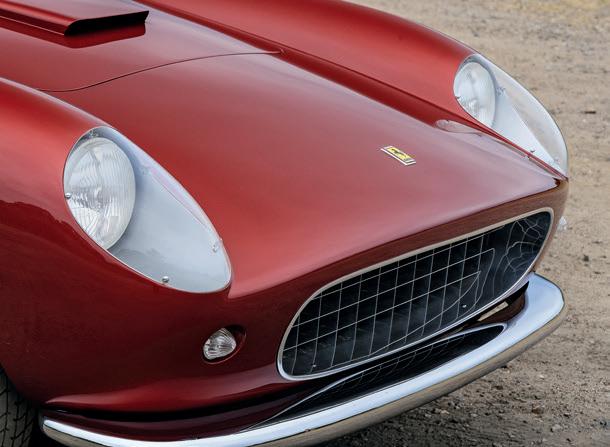
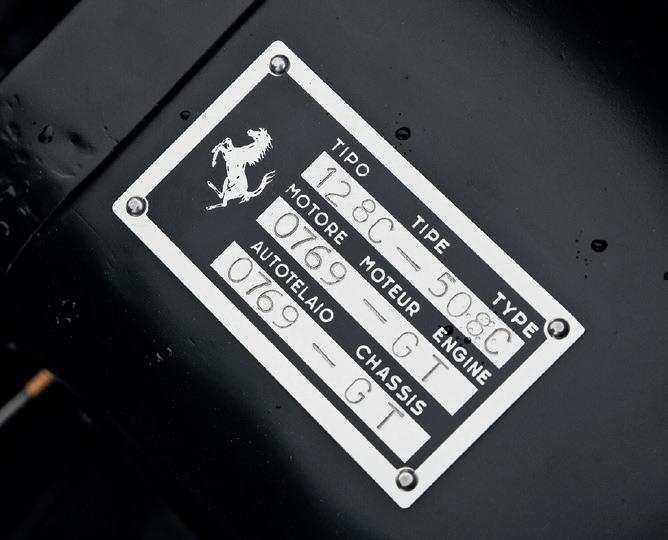
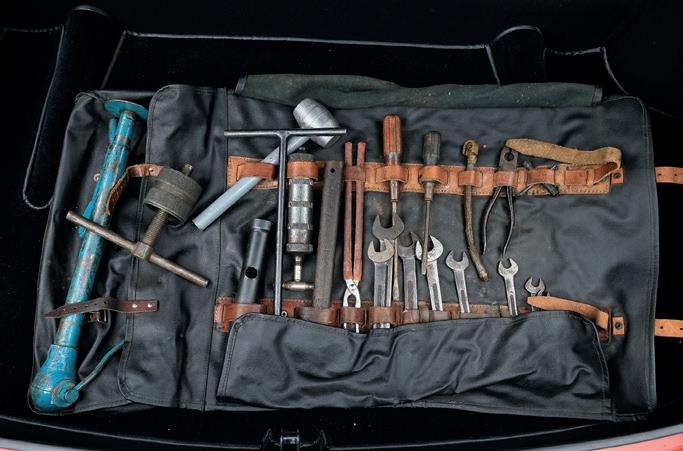
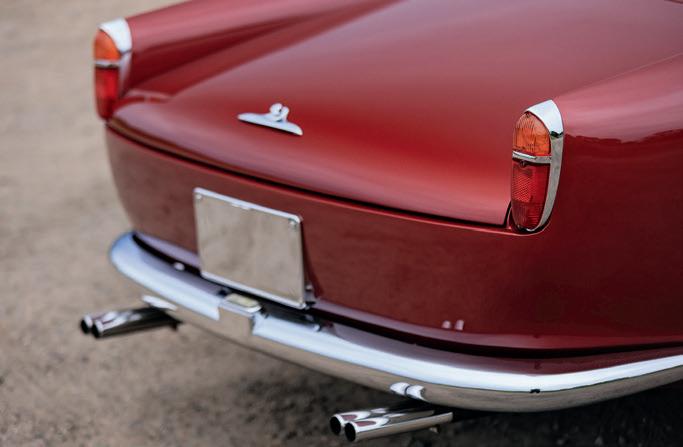


FCA International Ferrari Concours, Monterey, California, 1994
Concorso Italiano, Carmel, California 1994
Rosso Rodeo III, California, 1995
Giro del Amalfitano Classic, Italy, 2007
Ferrari 60th Anniversary Concorso d’Eleganza, Italy, 2007
Pebble Beach Concours d’Elegance®, 2008
Hublot Concours d’Elegance, Japan, 2012
Cavallino Classic, 2016 (La Coppa per Dodici Cilindri, Platinum Award)
Pebble Beach Concours d’Elegance®, 2016 (First in Class)
Concorso d’Eleganza Villa d’Este, Italy, 2017 (Mention of Honor)
Ferrari 70th Anniversary Concours, Maranello, Italy, 2017 (Best in Class)
Amelia Island Concours d’Elegance, 2020 (Best in Class)

Though Arents noted some early issues with the prototype – expected for a one-off development car – he clearly recognized its historic value.
In 1960, the car was sold to Frank Ramirez de Carellano of Puerto Rico. A year later, it made two competitive appearances. At the Puerto Rico Festival, Rafael Rosales drove it to a 1st place finish. Later, Victor Merino took victory at the De Diego Trophy held at the Antilles auto racetrack. Following these successes, the car was stored for many years under the ownership of Basil Davila and Orval Sifontes.
In the 1980s, 0769 GT was shipped to the US for restoration. At that point, the original engine was removed and temporarily installed in a 500 TRC (chassis 0672 MDTR). Restoration efforts began with Stanley Nowak and Vintage Auto Restorations of Connecticut and were later taken over by Bob Smith Coachworks of Texas. While still mid-restoration, the car was acquired by Warren Weiner of Villanova, Pennsylvania, who completed the work and began showing the car at high-profile concours events.
In 2004, Weiner located and reunited the original engine with the chassis. Though the primary engine number had been altered, the crucial internal number “058C” confirmed the match.

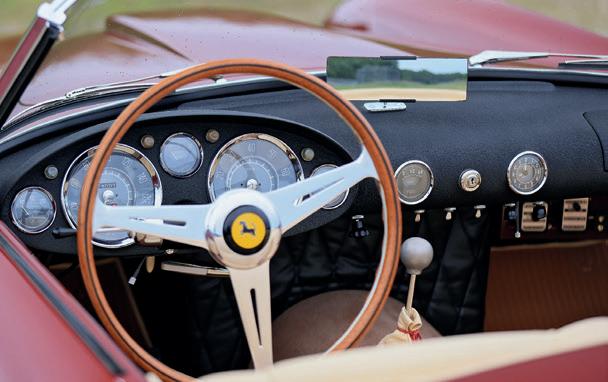
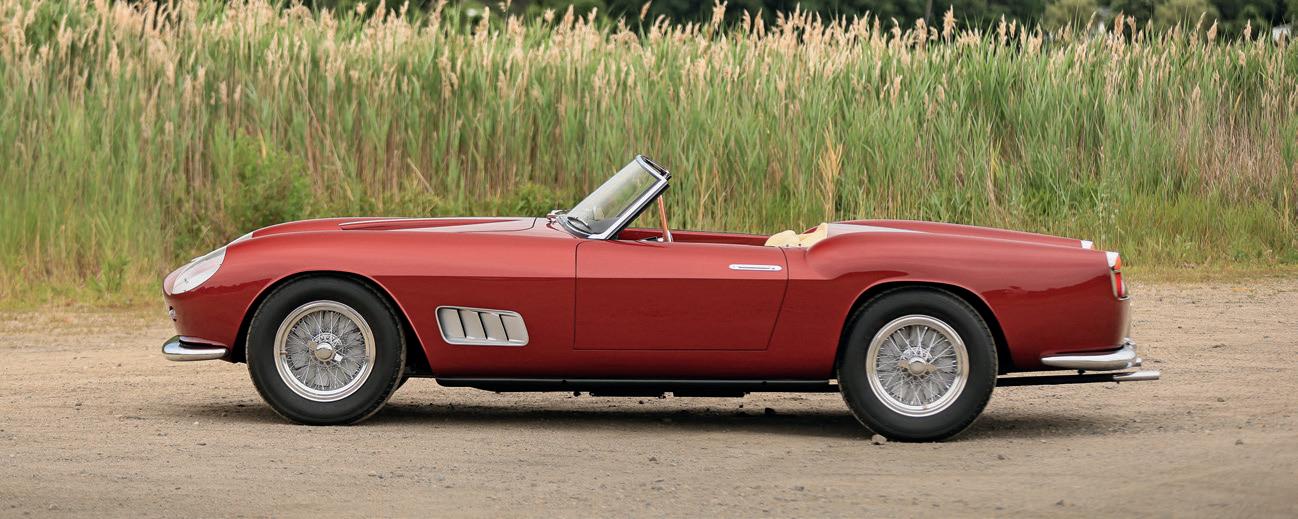

Cavallino, No. 104, April/May 1998, “California Prototipo” by Mark Wallach Cavallino, April/May 2018, “Prototipo” by Alan Boe
Ferrari Serial Numbers, Part I, by Hilary A. Raab Jr.
Ferrari Spyder California, by Stanley Nowak
Forza, June 2011, “Generational Divide,” by Winston Goodfellow
The Spyder California: A Ferrari of Particular Distinction, by George M. Carrick
Two years later, 0769 GT joined the esteemed collection of Brandon Wang, a respected Ferrari connoisseur. Under his ownership, the car was certified by Ferrari Classiche, which confirmed its authenticity and restamped the engine pad in the proper font.
Between 2007 and 2008, the prototype participated in several major Ferrari celebrations, including the Giro del Amalfitano Classic rally, Ferrari’s 60th Anniversary Concorso d’Eleganza in Italy, and the Pebble Beach Concours d’Elegance®, where it starred in the California Spider 50th anniversary class.
In 2012, the current owner – a prominent East Coast collector with a passion for Italian sports cars of the 1950s – entrusted Rare Drive Inc. of New Hampshire with a concours-level restoration. Known for Pebble Beach-winning restorations, Rare Drive returned 0769 GT to its original glory, refinishing the California in its striking original color scheme.
Completed in 2016, the restoration immediately garnered the highest honors, beginning with a Platinum Award and the La Coppa per Dodici Cilindri at the Cavallino Classic. The accolades continued: First in Class at Pebble Beach, Mention of Honor at Villa d’Este, Best in Class at Amelia Island, and Best in Class at the Ferrari 70th Anniversary “Rosso 70” Concours in Maranello – where it
outshone even the most exquisite SWB and LWB examples.
Its reputation has been further cemented by a prominent cover feature in Cavallino magazine (Issue No. 224), titled “Prototipo” by Ferrari historian Alan Boe. Over the years, 0769 GT has also been documented in Nowak’s Ferrari Spyder California, Carrick’s The Spyder California: A Ferrari of Particular Distinction, and extensively chronicled by marque expert Marcel Massini, whose report accompanies the car.
As the prototype for one of the most important Ferrari models, 0769 GT stands alone. It is the genesis of a legend, bearing experimental features found on no other car, driven by important figures in Ferrari’s American expansion, raced successfully in period, and restored to a standard worthy of the world’s finest concours d’elegance. From its Scaglietti-built, hand-fabricated bodywork to its reunited, classiche-certified engine, this car tells the complete story of the California Spider’s evolution – from inspiration to icon.
For collectors seeking not just rarity, but historic significance, 0769 GT represents a singular opportunity. This is not merely a Ferrari – it is the California Spider that started it all.

CHASSIS NO. H102085
$80,000–$100,000 without reserve
Following a restoration in 2002, overseen by a dedicated Lincoln specialist, this Continental Convertible has garnered numerous awards, including several important honors from the Lincoln & Continental Owners Club, such as the best primary Lincoln Continental in 2003 and the Best Senior Lincoln Continental in 2004 – a testimony to both the quality of the restoration and the attention to authenticity. Its black nitrocellulose lacquer paint is complemented by a matching black canvas roof accented with red piping. The interior is finished in striking oxblood red leather and the dashboard houses a radio, heater, and a full array of gauges. The power-operated convertible top lowers neatly behind the rear seat and is covered by a matching canvas boot.
Power is provided by the 12-cylinder Lincoln H-series engine – enlarged to a displacement of 292 cid for 1940 – and this example features the optional Columbia overdrive unit, which allows for comfortable high-speed cruising. The car benefited from a mechanical refresh in 2022 and still presents in show quality today.
Welcome at all CCCA judging and tour events, just 16 of Continental’s 1940 convertibles are listed in its current roster. Authentically restored to exacting standards, this impressive example is ready to be appreciated for its design significance as well as its multi-cylinder touring ability.
HIGHLIGHTS
One of Just 350 Convertibles Built for 1940
Landmark Continental Design by Eugene T. Gregorie
Authentic High-Quality Restoration in Striking Colors
Recipient of Numerous Trophies Including Multiple LCOC Awards
Well Equipped with Columbia Overdrive, Radio, and Heater
Eligible for CCCA Judging and Tours
292 CID L-Head V-12 Engine
Zenith Downdraft Carburetor
120 BHP at 3,500 RPM
3-Speed Manual Gearbox with Overdrive
4-Wheel Hydraulic Drum Brakes
Front Independent Suspension
Rear Three-Quarter Floating Axle with Semi-Elliptical Leaf Springs
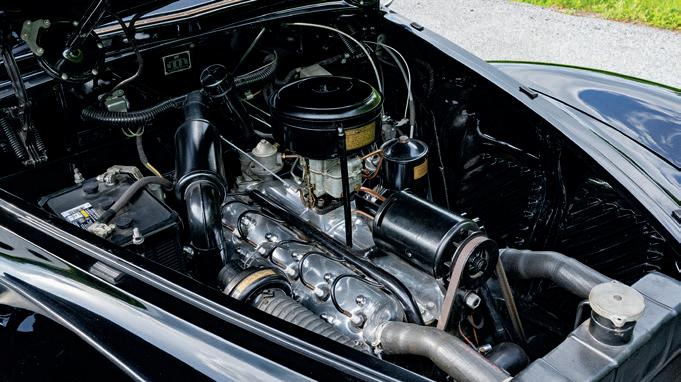

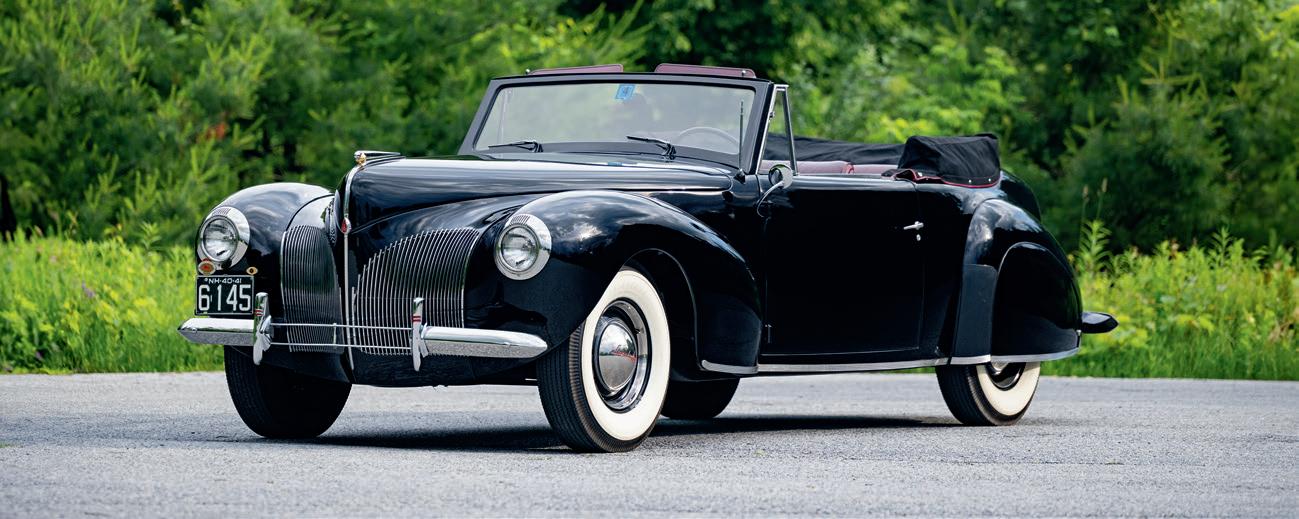

CHASSIS NO. 9113600302
ENGINE NO. 6630327
$900,000–$1,200,000
The 1973 Carrera RS was born of necessity – a homologation special, designed to qualify Porsche’s 911 for FIA Group 4 GT competition. A minimum of 500 road-going examples were required, and what Porsche produced not only met the brief, but also became one of the most revered sports cars of all time. Starting with the formidable 2.4-liter 911 S as a foundation, engineers increased displacement to 2.7 liters, implemented strategic weight-saving measures, upgraded the suspension, and added functional aerodynamic enhancements. The result was a car that redefined the limits of a road-going GT.
A total of 1,580 Carrera RS 2.7s were built, of which 1,380 were configured in M472 Touring specification – retaining the 911 S trim and comforts, while
HIGHLIGHTS
Among the Finest Examples of the Iconic 1973 Carrera RS
First-Series M472 Touring in Definitive Grand Prix White Livery
Delivered New to Rome, Italy via German Dealer Autohaus Max Moritz
Low-Mileage Example Carefully Restored by RS Specialist Nate Cantwell
Retains Matching-Numbers Engine and Transaxle per Factory Records
Accompanied by Original Pflegepass, Books, Tools, and Records
delivering thrilling performance. As production ramped up, Porsche eased some of the expensive lightweight construction methods, making the earliest examples particularly desirable. The first 500 or so cars were built with thinner-gauge steel and lightweight Glaverbel glass, marking them as the purest distillation of the RS ethos. Among collectors, these early-production cars are the most highly prized.
Chassis 9113600302 is one such desirable first-series Touring model, completed in December 1972 and finished in the iconic RS color scheme of Grand Prix White with Red graphics (paint code 2225). According to the authoritative reference Carrera RS by Dr. Thomas Gruber and Dr. Georg Konradsheim, just
SPECIFICATIONS
2,681 CC Type 911/83 SOHC Air-Cooled Flat-6-Cylinder Engine
Bosch Mechanical Fuel Injection
210 BHP at 6,300 RPM
5-Speed Type 915 Manual Transaxle
4-Wheel Ventilated Disc Brakes
Front Independent Suspension with Shock Absorbers
Rear Torsion-Bar Suspension
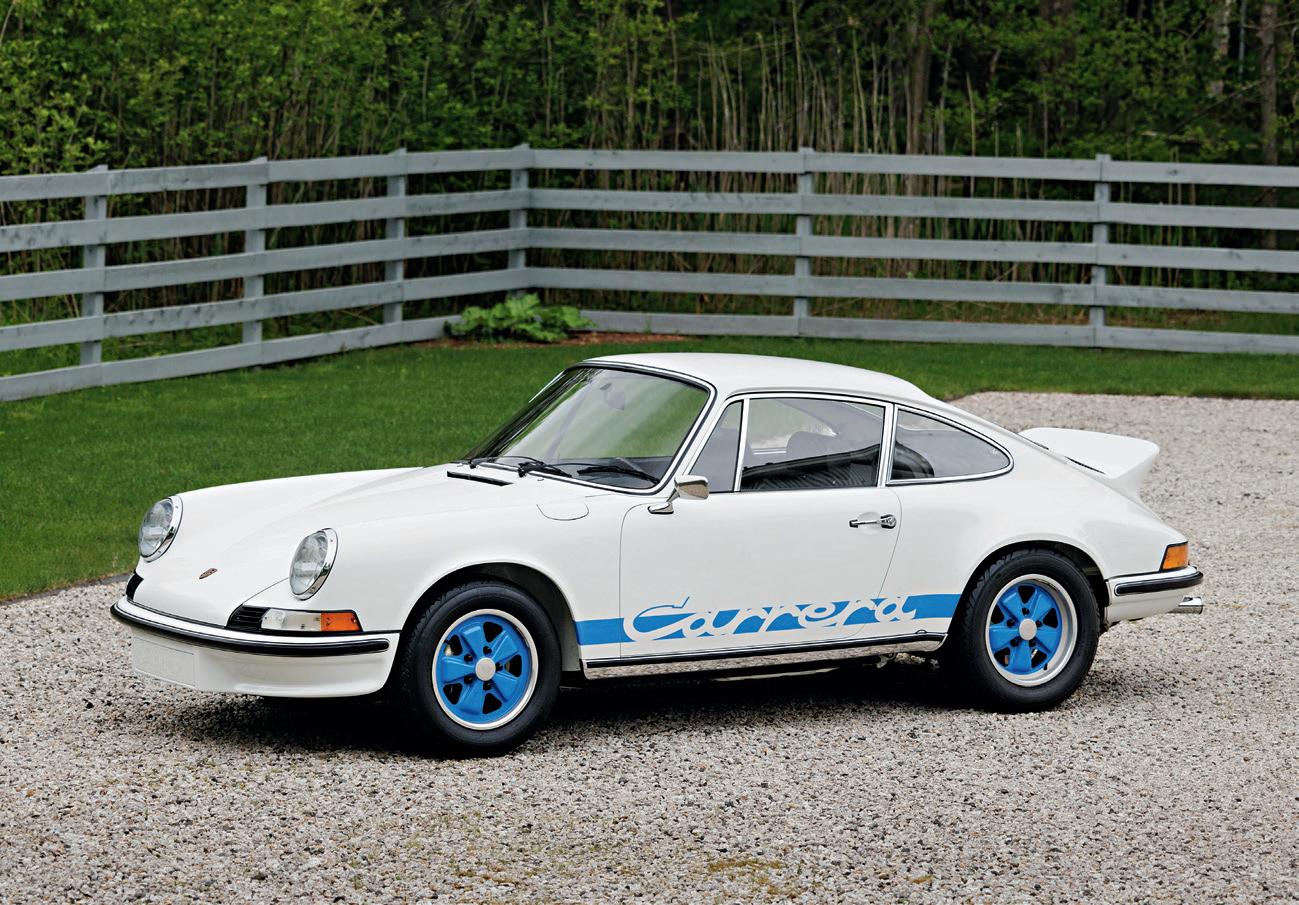

Carlo Piccirilli, Rome, Italy (acquired new via Autohaus Max Moritz GmbH in 1973)
Roberto Giovanini, Rome, Italy (acquired by 1999)
David Mohlman, Coconut Grove, Florida (acquired from the above in 2001)
Edward Buliavac, Los Angeles, California (acquired from the above in 2002)
Dr. Richard Moran, Irvine, California (acquired circa mid-2000s)
Private Collection, California (acquired from the above circa 2010)
Private Collection, Colorado (acquired from the above in 2013)
Current Owner (acquired from the above)
185 RS 2.7s were delivered in this striking livery. Factory records confirm original equipment, including a driver-side sport seat, limited-slip differential, Pirelli tires, and black leatherette upholstery with corduroy inserts.
Originally slated for delivery within Germany, this RS was sold new to Carlo Piccirilli of Rome, Italy, through Autohaus Max Moritz GmbH in Reutlingen. The Porsche Pflegepass (maintenance record) notes a delivery date of January 25, 1973, and the car was issued a temporary German registration: 855 Z-4367. The RS remained in the Rome area until 2001, when it was acquired by noted Porsche specialist David Mohlman and exported to the US. At the time, the car showed just over 30,000 km and was described as largely original, retaining its factory Glaverbel windscreen, original interior, tool kit, handbooks, and documentation.
The next owner, Ed Buliavac, commissioned Nate Cantwell, one of the world’s foremost Carrera RS authorities, to perform a comprehensive restoration. His meticulous work focused on preserving originality while elevating the car to exquisite, show-quality condition. All aspects of the restoration were executed to an exceptional standard, with particular attention paid to maintaining correct finishes and details throughout.
Since the restoration was completed approximately 20 years ago, this RS has resided in several prominent West Coast collections, including that of Dr. Richard Moran of Irvine, California. A well-regarded figure in Porsche circles, Dr. Moran was an early connoisseur of the Carrera RS and once owned an example in nearly every original color. A discerning enthusiast, he favored highly original, early production cars like 0302, which retains its matching-numbers engine and transaxle, along with rare factory components.
Under current ownership, the car has continued to receive careful maintenance, regular exercise, and professional detailing. It remains in superb cosmetic and mechanical condition and is sure to impress even the most fastidious collector. The only notable deviations from factory specification are blue graphics and wheels – a reversible cosmetic choice by the consignor – and the addition of a passenger-side sport seat.
Included in the sale is the original Pflegepass, Wagenpass, a 1973-dated service document, factory tool roll, jack, spare assembly, and owner’s manual – elements that further underscore this example’s extraordinary provenance and preservation.
As the most celebrated 911 of its era, the Carrera RS 2.7 Touring occupies a
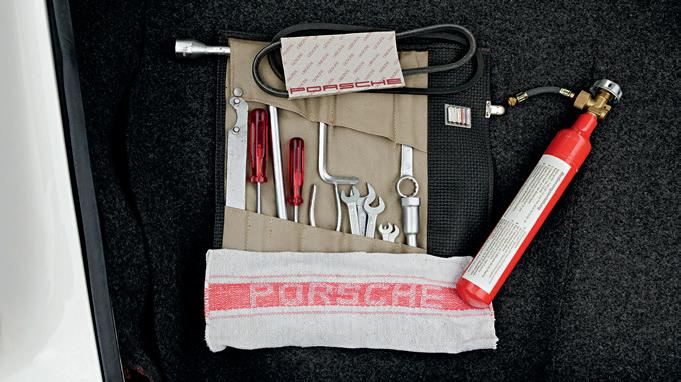
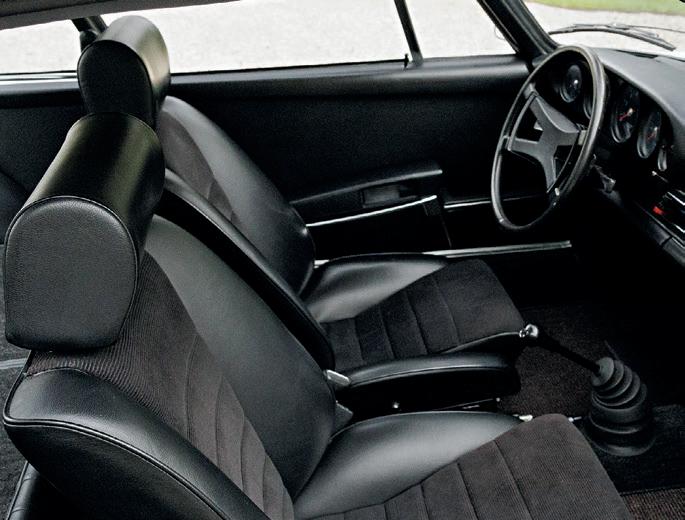


Carrera RS, by Dr. Thomas Gruber and Dr. Georg Konradsheim
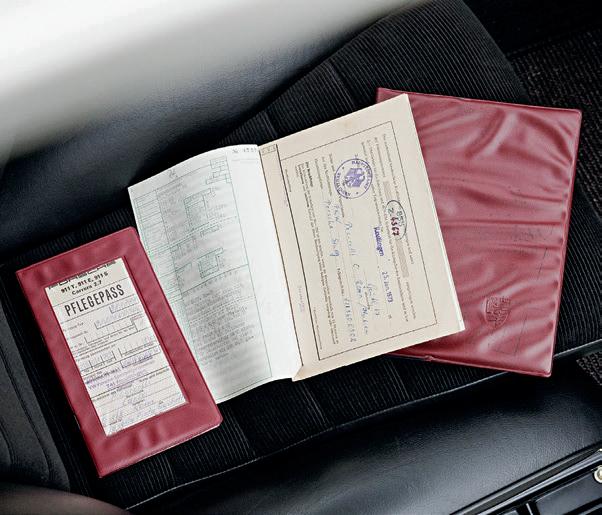
place of honor in Porsche’s storied legacy. It is a foundational model – one that inspired every GT-focused 911 that followed, and which continues to be the benchmark against which all others are judged. Rarely does an example of this caliber appear for public sale, especially a first-series car with matching-numbers components, impressive originality, and a carefully executed restoration overseen by a recognized expert.
For the collector who demands the finest, this Carrera RS represents an unmissable opportunity.
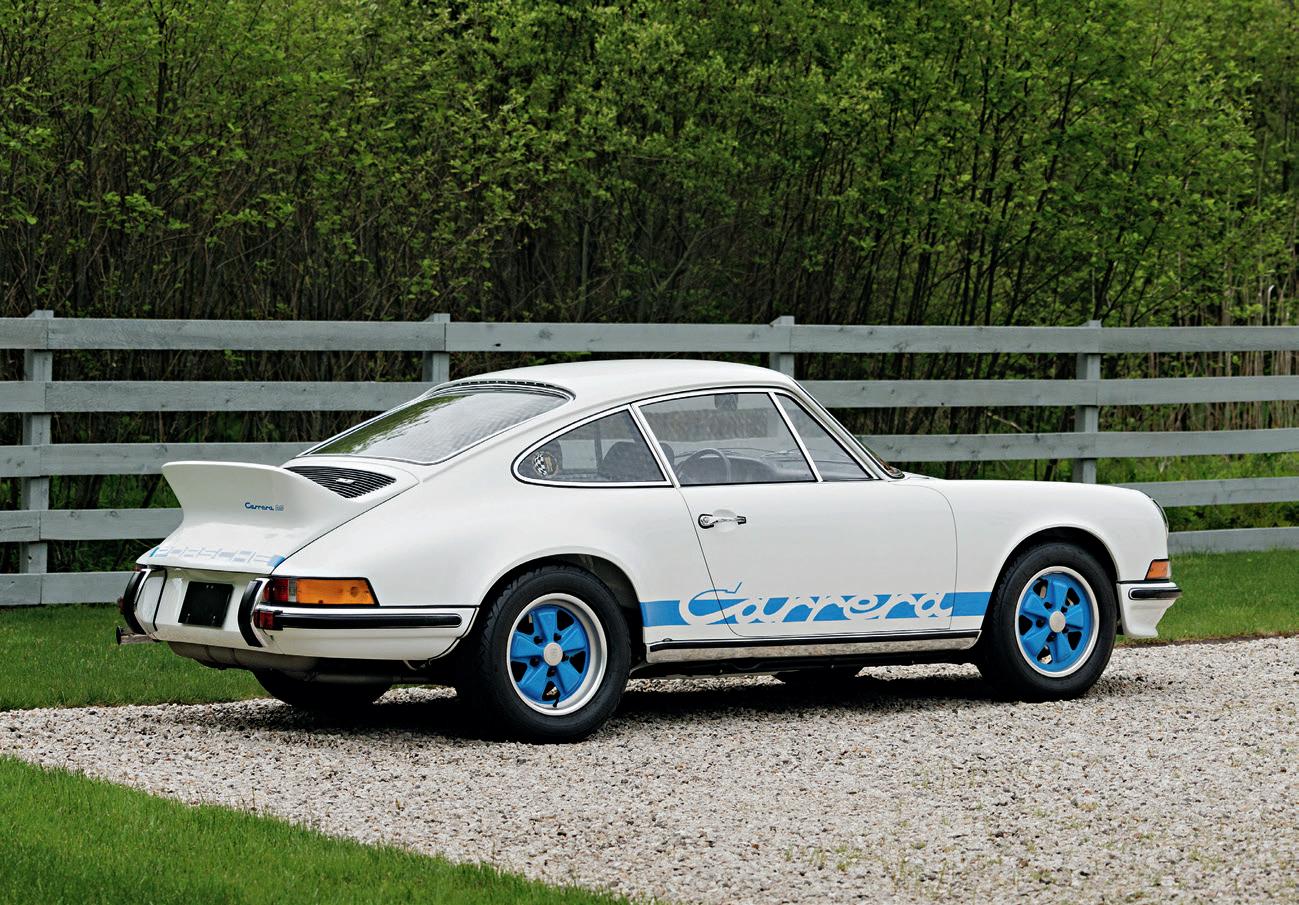
COACHWORK BY JAMES YOUNG
CHASSIS NO. LLCC2
ENGINE NO. LC2C
$175,000–$225,000 without reserve
James Young’s SCT100 design was much more harmonious and well-proportioned than the H.J. Mulliner offerings on the long-wheelbase chassis, with their hallmark fenders, closed rear quarter, and swept tail. With only 37 examples built, they have always been coveted for their looks and rarity.
In February 1961, this Silver Cloud II LWB Saloon was ordered new by Alan Prest of Darien, Connecticut – quite possibly as a retirement gift, as he had recently left PricewaterhouseCoopers as a partner. On his passing, The New York Times wrote that he had retired to focus on his car collection. One of only three left-hand-drive SCT100s, chassis LLCC2 was delivered in Pacific Green with family crests on the body and a beige interior. Detail features included a
HIGHLIGHTS
US-Delivery, Long-Wheelbase Silver Cloud II
One of Only 37 SCT100 Silver Cloud IIs; Only Three in Left-Hand Drive
Features Original Build Details, Including Rear Luggage Rack
Offered from a Prominent Private Collection
Refinished in Two-Tone Paintwork Accentuating Coachbuilt Lines
chrome luggage rack, air-conditioning, and Motorola radio. Perhaps referring to his former accounting days, his license plate was “1CGT.” Following Mr. Prest’s death in 1974, the car was sold to Carriage House Motor Cars in Manhattan, New York. It is likely around this time that the car was enhanced with the large P100 Lucas headlights – which a number of Silver Wraiths also wore – and was later refinished in two-tone paintwork, accenting the SCT100 lines well.
Chassis LLCC2 was acquired into current ownership in the 1990s, where it has rubbed shoulders with a number of the most important examples of its breed and has been well appreciated.
SPECIFICATIONS
6,230 CC V-8 Engine
Twin Sidedraft SU Carburetors
185 BHP at 4,500 RPM
4-Speed Automatic Transmission
4-Wheel Servo-Assisted Drum Brakes
Front Independent Suspension with Coil Springs
Rear Live Axle with Semi-Elliptical Leaf Springs

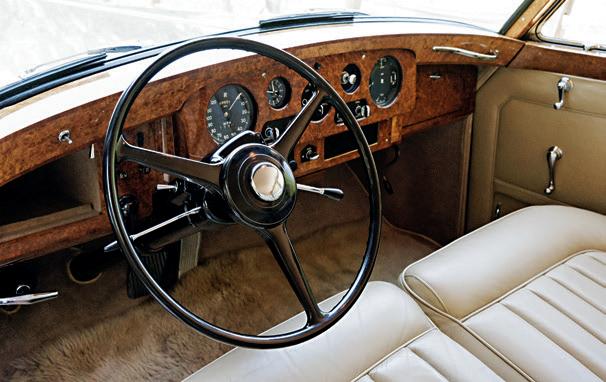
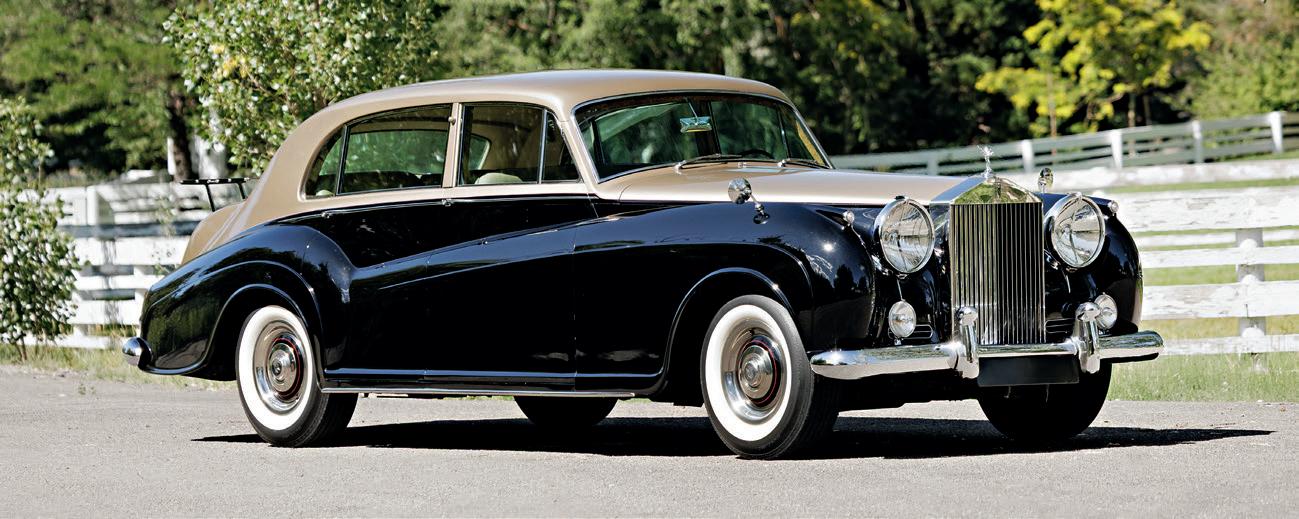

COACHWORK BY BOANO
CHASSIS NO. 0673GT
ENGINE NO. 0673GT
$750,000–$950,000
This outstanding Ferrari, chassis 0673GT was the penultimate 250 GT Low-Roof Boano, specified in black over red, and equipped with the elegantly designed side vents, which only about three of these late examples received. This car was delivered to its first custodian, Mr. Lefranc, via the Belgian Ferrari importer Jacques Swaters’ Garage Francorchamps SA in Brussels. By the early 1960s, this Boano had been exported to the US and was acquired by John Calley, the famed movie producer and noted Ferrari collector of Los Angeles.
Between 1966 and 1987, this car was in the hands of Gene Curtis, the former head mechanic for McAfee Motors in Los Angeles. A prized possession, it remained with him until his passing, when the car was inherited by Patricia
HIGHLIGHTS
One of 63 Low-Roof 250 GT Boanos; the Penultimate Example Built Retains Matching-Numbers Components per Ferrari Classiche Red Book
Formerly the Property of John Calley and Gene Curtis
Equipped with Rare and Desirable Side Vents
An FCA Platinum Award-Winning Restoration
Certified by Ferrari Classiche and Documented by Marcel Massini
Potter of Thousand Oaks, California, and by 1988 the car belonged to Robert Butler of Valencia, California. The Ferrari was later sold to Rick Peterson as partial payment of a loan to Mr. Butler. By September 1995, Mr. Peterson had Norbert Hofer advertise the car in Ferrari Market Letter as “low roof, steel body, excellent condition, all numbers-matching.”
Between 1999 and 2001, Black Horse Restorations and Mr. Hofer were tasked with restoring the Boano which was then still owned by Mr. Petersen. When completed, in its deep red paint over a gray leather interior, the quality of the restoration was proven at the 2001 Orange County Concours d’Elegance, where the FCA honored the car with a prestigious Platinum Award. Further show
SPECIFICATIONS
2,953 CC SOHC Alloy V-12 Engine
Three Weber 36 DCL3 Carburetors
260 BHP at 7,000 RPM
4-Speed Manual Gearbox
4-Wheel Hydraulic Drum Brakes
Front Independent Suspension with Coil Springs and Houdaille Shock Absorbers
Rear Live Axle with Semi-Elliptical Leaf Springs and Houdaille Shock Absorbers


Mr. Lefranc, Brussels, Belgium (acquired new via Garage Francorchamps SA in 1957)
John Calley, Los Angeles, California (acquired circa early 1960s)
Larry Armi, Pasadena, California (acquired circa 1965)
Gene Curtis, Los Angeles, California (acquired circa 1966)
Patricia Potter, Thousand Oaks, California (inherited from the above in 1987)
Robert Butler, Valencia, California (acquired by 1988)
Rick Peterson, Los Angeles, California (acquired from the above in 1995)
Rick Intile, New York (acquired from the above in 2001)
Tony Schwartz, Calabasas, California (acquired from the above in 2006)
( continued )
Michael Schudroff, Greenwich, Connecticut (acquired circa 2007)
Dennis Roberts, Hillsborough, New Hampshire (acquired from the above in 2009)
Private Collection (acquired in 2011)
Current Owner (acquired from the above in 2012)
FCA Orange County Concours d’Elegance, California, 2001 (Platinum Award)
Cavallino Classic, 2003 (Gold Award)
California Concours d’Elegance, 2003 (Platinum Award)
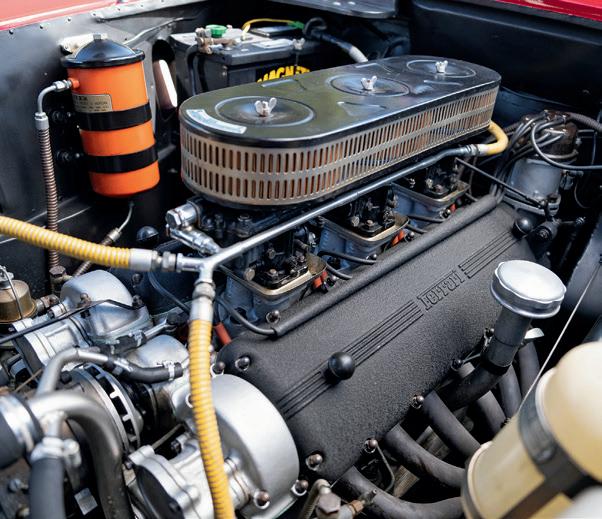
successes came in the form of both Gold and Platinum Awards, respectively, at the 2003 Cavallino Classic and the California Concours d’Elegance. In 2006, Ferrari’s Classiche Certification Program issued this exquisite Boano its Red Book after it had passed a stringent inspection process, in which all major components were confirmed to be original to the car.
Since late 2012, the Boano has been a mainstay in the consignor’s collection. During this time, it has continued to be maintained primarily by Norbert Hofer of Gran Touring Classics Inc. in Long Beach, California, who has ensured that it has remained in proper tune. Significantly, the owner revised the original gearbox to shift in a conventional pattern and had a pair of SWB-style seats built and matched to the interior leather to enable more spirited drives. The original bench-type seats accompany the sale.
The Ferrari remains in outstanding condition inside and out – the result of consistent maintenance and respectful stewardship throughout its existence. Even ancillary components, from the Marchal driving lights to the Houdaille shock absorbers appear factory correct. A beautifully presented example, the second-to-last built, this event-eligible Ferrari 250 GT Low-Roof Berlinetta is sure to inspire la dolce vita for its new owner.
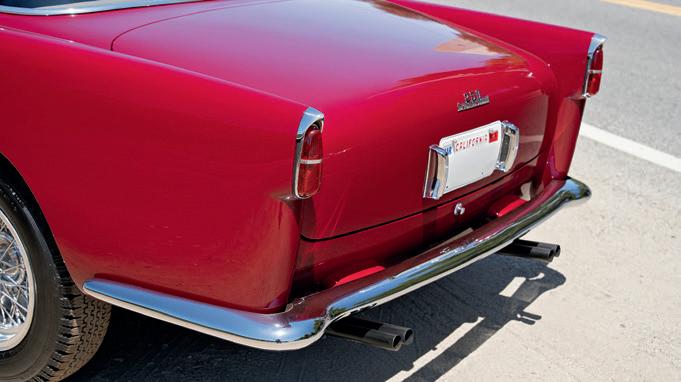
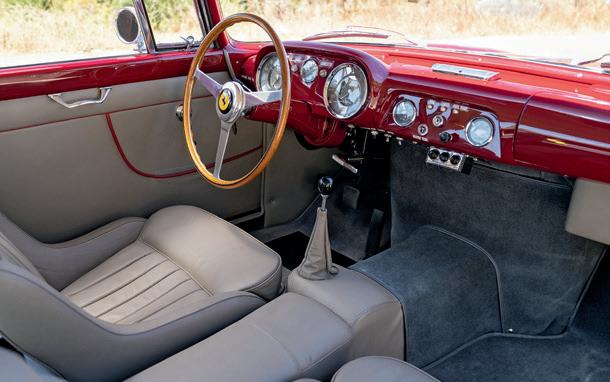
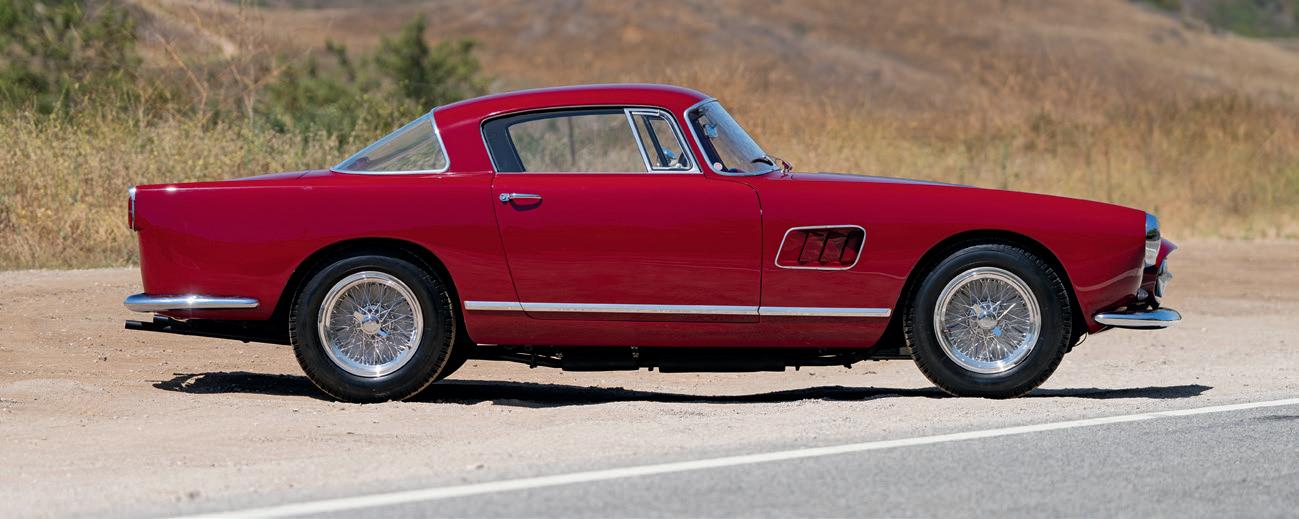
COACHWORK BY BERTONE
CHASSIS NO. GL 840212
ENGINE NO. 1087
$350,000–$450,000 without reserve
The Iso Grifo was a limited-production 1960s Italian sports coupe, styled by the emerging genius of Giorgetto Giugiaro and developed under the watchful eye of Giotto Bizzarrini, the ex-Ferrari engineer who was largely responsible for the 250 GTO. A long-hood, short-deck gran turismo, stunningly proportioned and exquisitely detailed, the Grifo was powered by either a big- or small-block Corvette V-8 or, in later models, a Ford 351 Cleveland engine.
Compared with other Italian marques utilizing more complex V-12 engines, the addition of American V-8 power meant greater reliability, outstanding torque, low operating costs, not to mention the fantastic performance that was a direct result of Chevrolet and Ford’s world-beating racing programs of the 1960s.
HIGHLIGHTS
One of Just 330 Series I Iso Grifos Built
Italo-American Icon Pairing Giugiaro Styling, Bizzarrini Chassis, and V-8 Power
Finished in Elegant Silver Metallic over Tan Leather and Equipped with AirConditioning
Previously Owned by Collectors Randy Simon and Sam and Emily Mann
Ideally Specified with 350 HP Corvette Engine and Four-Speed Manual Gearbox
*Please note that this vehicle is titled as 840212.
According to Chris Lackner’s Iso Grifo Registry, this stunning example, chassis 840212, was completed on October 15, 1968, in Iso’s Bresso, Italy workshops, delivered new to an Italian owner and specified with a 350 hp Chevrolet 327 cid V-8, four-speed manual gearbox, and air-conditioning. The Grifo is also equipped with power windows, a Becker Europa II AM/FM radio, knock-off wheels, and Veglia instrumentation. Warm wood veneer, a Nardi three-spoke, wood-rimmed steering wheel with Grifo center cap, and sumptuous tan leather round out the inviting, luxuriously appointed cabin. Exterior highlights include delicate push-button door releases, signature vented flanks, and a striking collection of Bertone and Iso badging – the centerpiece being a nose-mounted rearing griffon, the mythical namesake of the Grifo itself.
327 CID OHV V-8 Engine
Single 4-Barrel Carburetor
350 BHP at 5,500 RPM
4-Speed Manual Gearbox
4-Wheel Disc Brakes
Front Independent Double-Wishbone Suspension
Rear Semi-Independent De Dion Suspension


First Owner, Italy (acquired new in 1968)
Mark Goyette, Bennington, Vermont (acquired by 2007)
Randy Simon, Beverly Hills, California
Sam and Emily Mann, Englewood, New Jersey (acquired from the above)
The Elkhart Collection (acquired from the above in 2019)
Private Collection, US
Current Owner (acquired from the above)

840212 also enjoys distinguished provenance, having been a part of Californiabased Iso Grifo enthusiast Randy Simon’s collection. Simon sold it to noted collectors and multiple Pebble Beach-award winners Sam and Emily Mann, who had the car repainted silver, reupholstered in tan leather, and had various mechanical systems attended to.
The Grifo today makes a striking impression, with fantastic details throughout – among them diamond-quilted engine bay insulation and finned aluminum rocker covers proudly bearing “Corvette” script. As of 2022, the Grifo had reportedly received a carburetor tune, replacement of control arm bushings, five new tires and the installation of new wheel spinners. In current ownership, it has received attention to its air-conditioning system, clutch, and gearbox, documented by records on file.
One of the most charismatic Italian GTs of the era, the Grifo was born of rare, creative alignment between three automotive titans – Giugiaro, Bizzarrini, and Chevrolet – and it offers an experience that is as distinctive as its bloodline: expressive, elemental, and unforgettable.
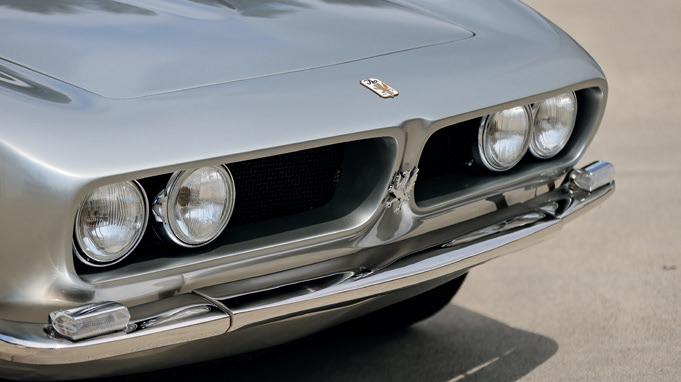
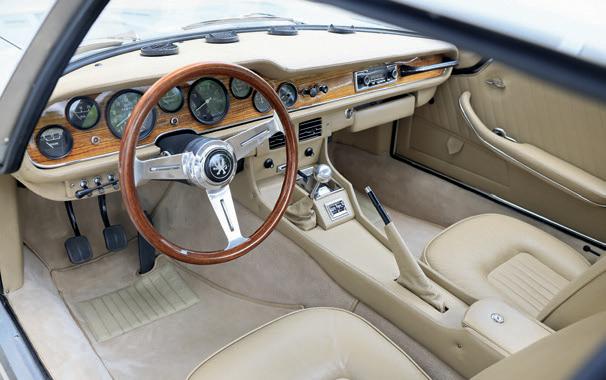
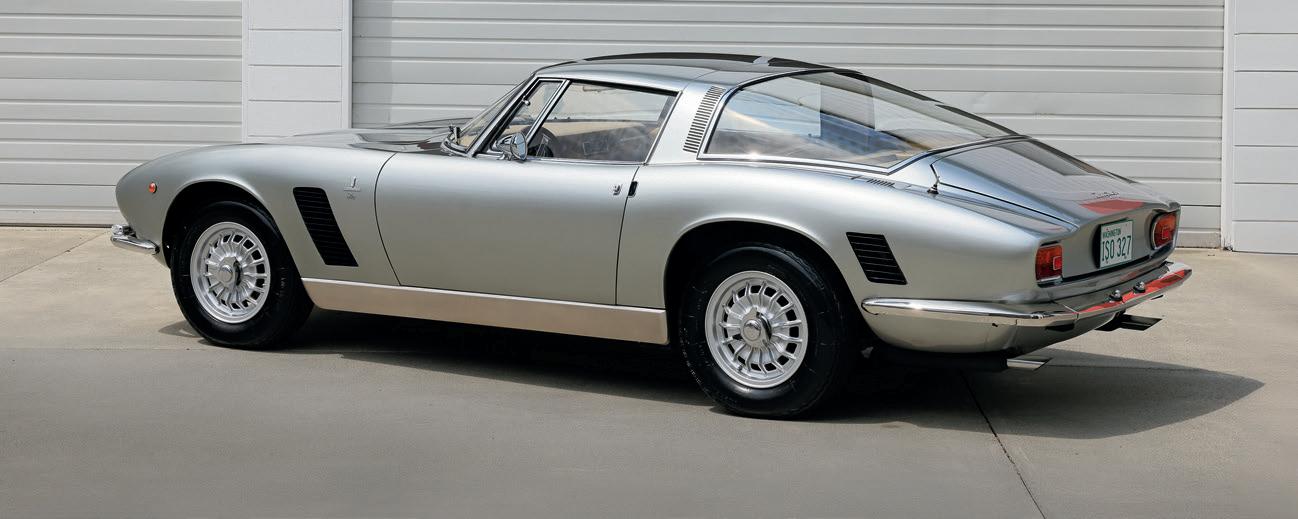
COACHWORK BY FIGONI
CHASSIS NO. 2311207
ENGINE NO. 2311207
$4,000,000–$5,500,000
When introduced in 1931, the Alfa Romeo 8C 2300 established new standards for high-performance sports cars. Developed by the brilliant engineer Vittorio Jano – who had already delivered to Alfa Romeo the highly successful 6C 1750 and P2 Grand Prix – the 8C boasted an all-aluminum, 2.3-liter twin-cam straight eight, supercharged to produce 140 bhp.
Throughout the early 1930s, the 8C 2300 dominated sports car racing, capturing multiple wins at the 24 Hours of Le Mans, the 1000 Miglia, and the Targa Florio. In single-seater form, the Monoposto “Tipo B” or P3 won six races in its debut season, including the major Grands Prix of France, Germany, and Italy. In typical Alfa Romeo fashion, the 8C 2300 was offered to private customers in
HIGHLIGHTS
Magnificent Example of the Premier Prewar Italian Sports Car
Highly Developed Third-Series 2.3 with Matching-Numbers Engine
Original Open Coachwork by Famed Parisian Coachbuilder Joseph Figoni, Featuring Desirable Monza Cowl
Featured in Simon Moore’s Definitive Books on the Alfa Romeo 8C 2300
Provenance Includes Bill Serri, David Cohen, and Henry Petronis
Displayed at the Pebble Beach Concours d’Elegance® in 2013 and 2022
road-going form, sold as a bare chassis in short- and long-wheelbase variants, intended for bespoke coachwork by firms such as Touring and Zagato.
Another firm renowned for its coachwork on the 8C 2300 was Carrosserie Figoni. Established by Italian expatriate Giuseppe “Joseph” Figoni and headquartered in Boulogne-sur-Seine on the outskirts of Paris, the firm rose from humble beginnings to become one of Europe’s most influential coachbuilders. Exceptionally high build quality, fine woodwork, luxurious interiors, and elegant styling characterized Figoni bodies of the late 1920s and early 1930s. Figoni’s later partnership with Ovidio Falaschi would lead to some of the most flamboyant and dramatic coachwork of the Art Deco era, defining the streamlined aesthetic
SPECIFICATIONS
2,336 CC DOHC Inline 8-Cylinder Engine
Gear-Driven Roots-Type Supercharger
Single Memini Carburetor
140 BHP at 4,800 RPM
4-Speed Manual Gearbox
4-Wheel Mechanical Drum Brakes
Front Solid Axle with Semi-Elliptical Leaf Springs and Shock Absorbers
Rear Live Axle with Semi-Elliptical Leaf Springs and Shock Absorbers
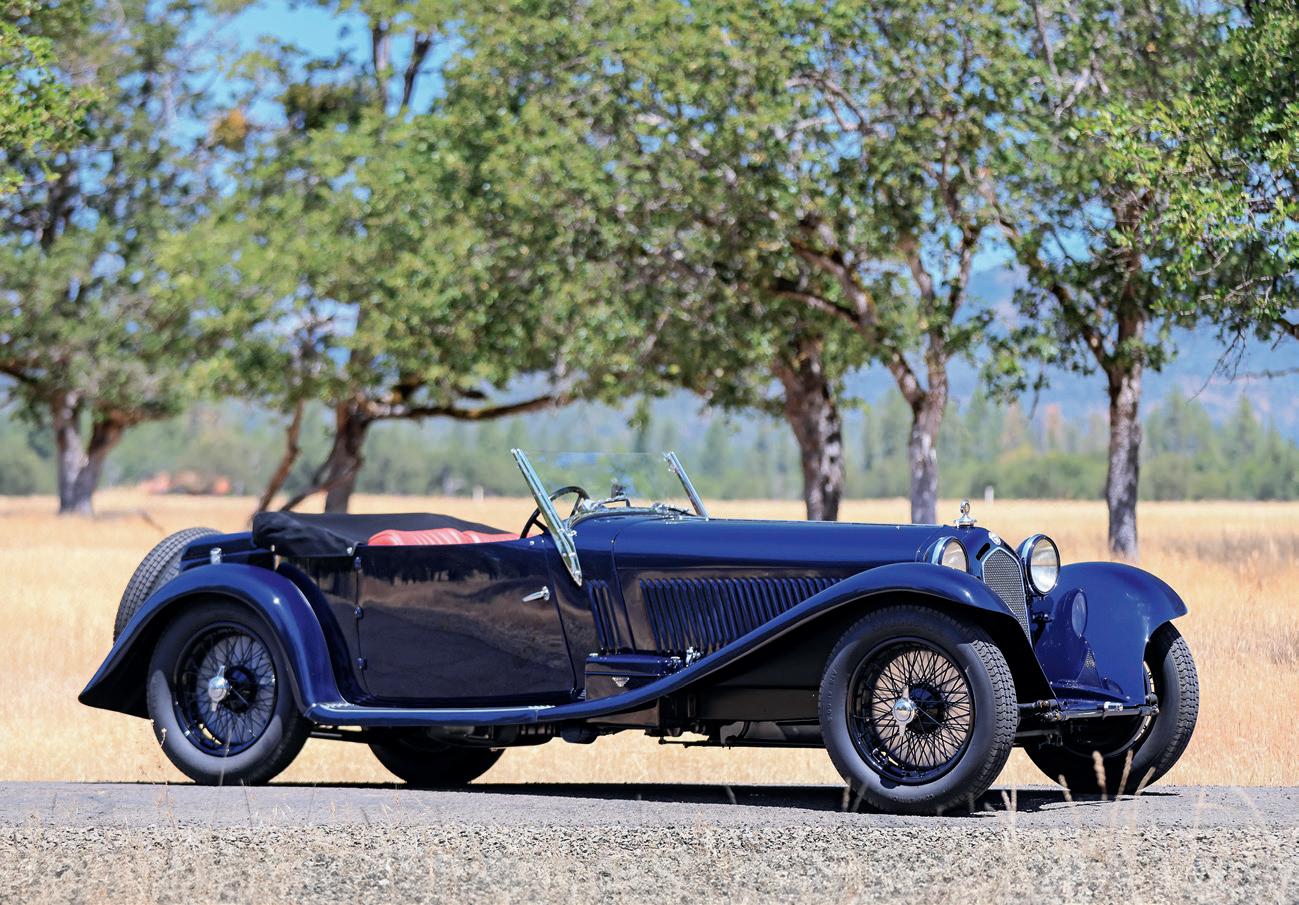

Louis Jeantet, Paris, France (acquired new in 1933)
Henry Simms Norman Adams, Norfolk, England (acquired by 1953)
Geoffrey Edwards, Harpenden, England (acquired from the above circa 1960)
Joel Finn, Syracuse, New York (acquired via Prospect Motors in 1961)
Stanford Landell, Lansing, Michigan (acquired from the above in 1962)
Bill Serri, Merchantville, New Jersey (acquired from the above circa 1983)
Peter Agg, Surrey, England (acquired from the above circa 1983)
David Cohen, Johannesburg, South Africa (acquired from the above in 1984)
Karl Eric Fröjd, Landskrona, Sweden (acquired in 1985)
Henry W. Petronis, Easton, Maryland (acquired from the above in 1988)
Current Owner (acquired in 2010)
of late 1930s French automobiles.
The first body that Figoni built on an Alfa Romeo chassis was a lightweight tourer for Raymond Sommer’s short-chassis 8C 2300. It proved an auspicious beginning, as the car went on to win the 24 Hours of Le Mans in 1932, with Sommer and co-driver Luigi Chinetti. In addition to lightweight racing bodies, Figoni also built elegant, custom coachwork for road-going 2.3s.
As chronicled in Peter M. Larsen and Ben Erickson’s Joseph Figoni: Le Grand Couturier de la Carrosserie Automobile Alfa Romeo, Figoni built coachwork for seven road-going 8C 2300s between 1932 and 1935: one Faux Cabriolet and six open-body styles. Each was built to order, and this striking two-seater, roadster-type Torpédo, mounted on the highly developed third-series 8C 2300 chassis 2311207, is certainly no exception.
According to the Archives Claude Figoni, this body was originally ordered in November 1933 for the Alfa Romeo’s first owner, Louis Jeantet. Born in 1897, Jeantet was a successful industrialist and, during the 1920s, the official French importer for Firestone tires. In 1924, he married Simone Violet, co-owner of the famous Byrrh aperitif company, and the couple lived in Paris until 1939, when they relocated to Geneva, Switzerland.
Jeantet’s 8C 2300 is a particularly striking example, possessing several distinctive features: a Monza-style cowl with a rare Alfa Romeo Paris badge, a lightweight folding soft top with exposed bows, long, flowing fenders, a separate trunk, and dual rear-mounted spares. As Larsen and Erickson note: “The body has no side windows, side curtains, beltline or other ornamentation. It is a body that would be plain from the hand of any other carrossier, but its austerity is alleviated by handsome and perfectly balanced proportions that achieve an understated yet exciting look…It is a classic sportscar style conceived at the cusp in time just before aerodynamic thinking changed car design forever.”
It is believed that chassis 2311207 remained in France throughout WWII and was eventually exported to the UK in 1953, where it was first owned by Henry Simms Norman Adams and registered in Norfolk. Around 1961, Adams sold the Alfa Romeo, and it was exported to the US, where it was acquired by noted collector and historian Joel Finn of Syracuse, New York. After a brief period, the car passed into the hands of Stanford Landell, a General Motors executive who purchased the Alfa Romeo on the advice of his colleague, the legendary collector Charles Chayne.
Landell undertook the car’s first restoration, a painstaking multi-year project that was completed in 1965. His work was handsomely rewarded with Best of
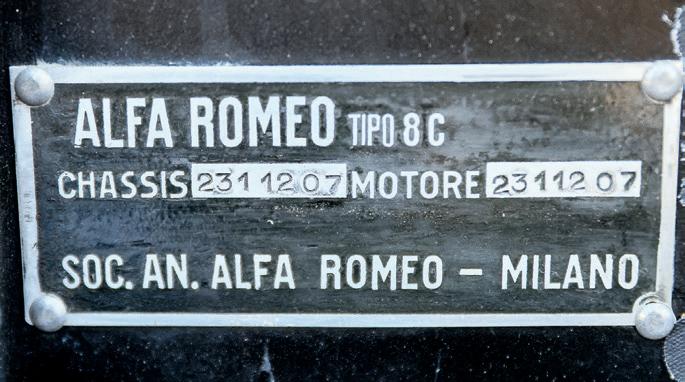





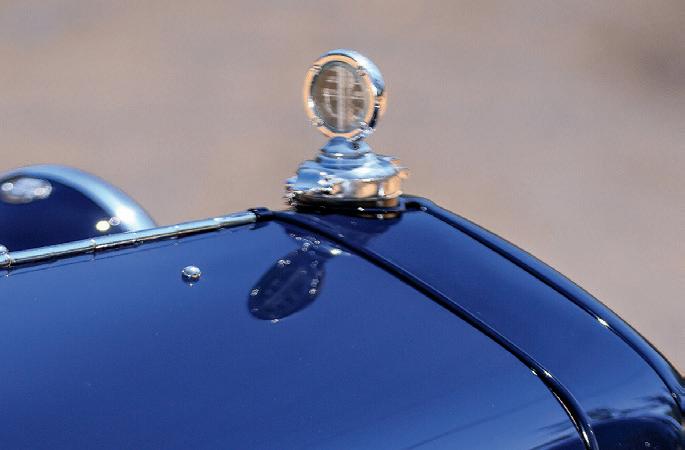
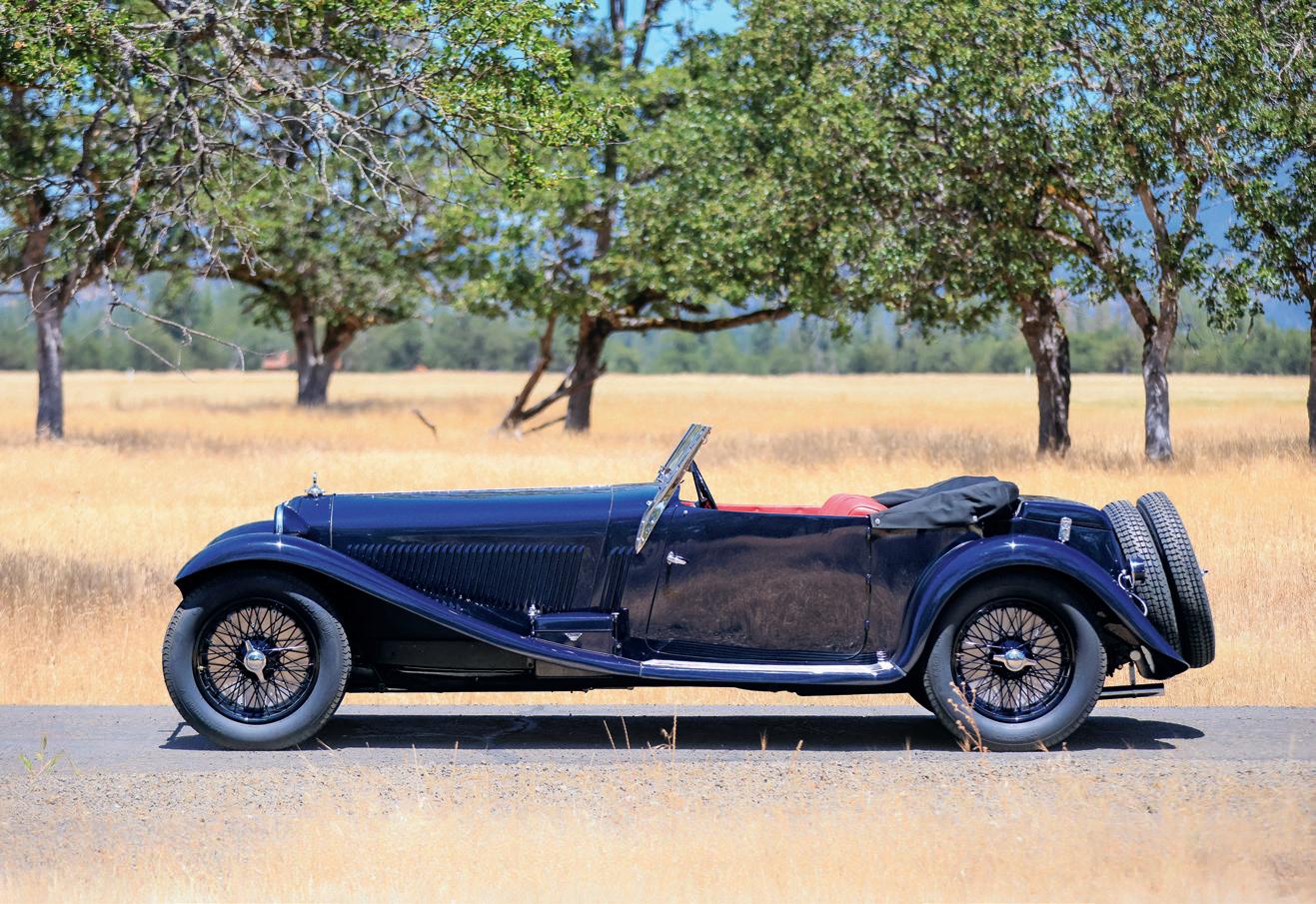

Carnival of Cars, Michigan, 1965 (Best of Show)
Pebble Beach Concours d’Elegance®, 2013
Pebble Beach Concours d’Elegance®, 2022

Show honors at the Carnival of Cars in Detroit and a First Place award at the AACA Fall Meet in Hershey, Pennsylvania. During Landell’s ownership, the Figoni-bodied 2.3 was joined by a Monza and was featured in several notable publications, including The Alfa Romeo Story and Automobile Quarterly.
The car remained with Landell until the early 1980s, after which it passed through a succession of respected Alfisti, including Bill Serri, Peter Agg, and David Cohen. In 1985, it was acquired by Swedish collector Karl Eric Fröjd, who – like Landell – kept the Figoni Torpédo as a stablemate to a Monza.
Since 1988, chassis 2311207 has had just two long-term owners: first, Henry W. Petronis of Maryland, who maintained it for over two decades among his stable of superb prewar classics. The current owner acquired the Alfa in 2010, adding it to a collection of the world’s most celebrated prewar and postwar sports cars. During this stewardship, the 8C 2300 has been exhibited twice at the Pebble Beach Concours d’Elegance®, first in 2013 and again in 2022, following a concours-quality repaint by the respected specialists at Dennison International. Today, it presents in a tasteful color scheme of dark blue over red, which perfectly suits its elegant, understated design.
By any measure, a Figoni-bodied Alfa Romeo 8C 2300 ranks among the
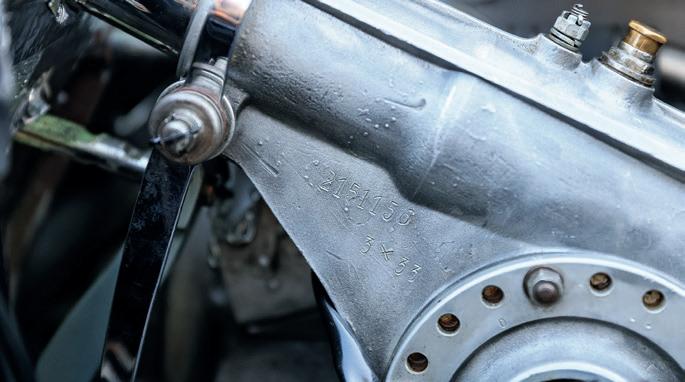
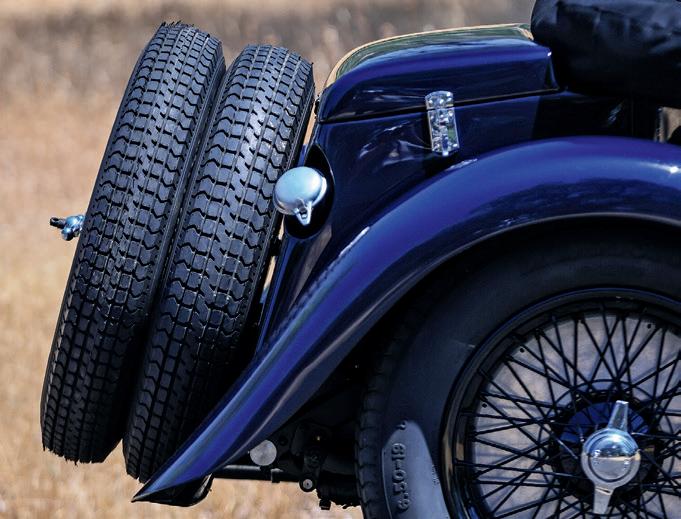
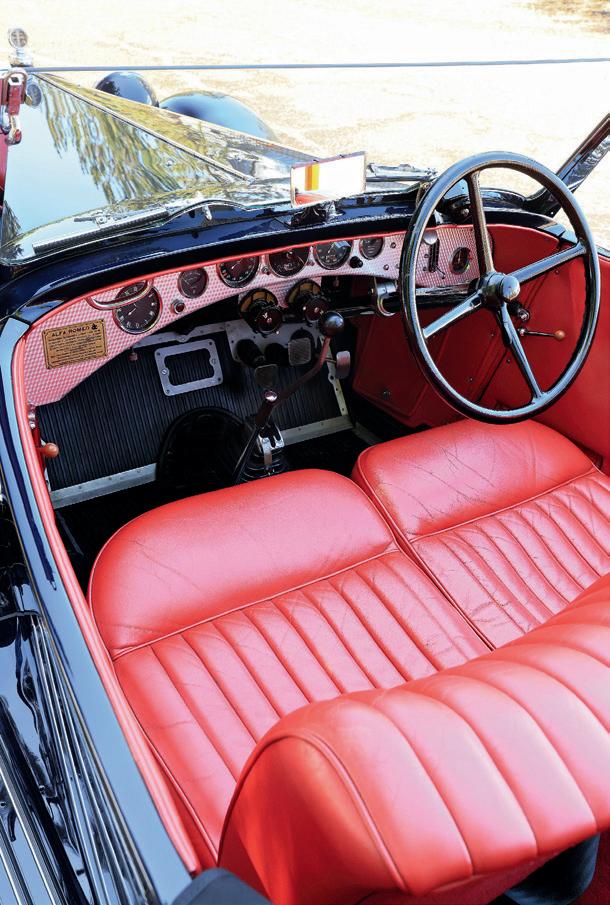

The 8C Story Continues, by Simon Moore Automobile Quarterly, Vol. 20, No. 1, 1982, “Figoni et Falaschi: The Coachbuilder as Sculptor,” by Griffith Borgeson
The Alfa Romeo Story, by Joseph H. Wherry Car Collector and Car Classics, November 1983, “8C 2300: The Golden Anniversary of One of the Greatest Alfa Romeos”
Joseph Figoni: Le Grand Courtier de la Carrosserie Automobile Alfa Romeo, Vol. 1, by Peter M. Larsen and Ben Erickson
The Legendary 2.3, by Simon Moore

most exclusive and sophisticated automobiles of its era – a stylish, luxuriously appointed touring car built on one of the greatest sporting chassis of all time. The unmistakable sound of the gear-driven, supercharged straight eight still stirs the soul, just as it did in 1933. Few automobiles of the period can rival an eight-cylinder Alfa Romeo in terms of performance, beauty, and engineering excellence.
Fittingly, this remarkable Figoni-bodied Torpédo has earned the admiration of even the most discerning marque historians. In The Legendary 2.3 , Simon Moore writes: “It is really nice that a few long chassis cars survive in sympathetic hands rather than being cut up into short chassis or Monzas, or rebodied with new Le Mans-style bodies. This is a lovely car and bears close examination if you get the chance.”
Presented here is that rare chance.

CHASSIS NO. 187.012.02983/52
$140,000–$180,000 without reserve
Introduced in 1951, the W187 220 heralded the triumphant postwar return of traditional Mercedes-Benz excellence. Beneath elegant and dignified but distinctly prewar styling, the car concealed advanced contemporary engineering, including fully independent suspension, hydraulic brakes, and an overhead-camshaft engine, the latter being the marque’s first new six-cylinder in nearly 15 years. Handcrafted in limited numbers, it bridged old-world tradition and modern postwar design.
A truly exceptional example of the breed, this 1952 Mercedes-Benz 220 Cabriolet A showcases what is arguably the most elegantly proportioned and visually refined body style of the entire W187 range. Painstakingly restored
HIGHLIGHTS
Superb Example of Mercedes-Benz’s First Postwar Six-Cylinder
One of Just 1,278 Cabriolet A Models Built
Recent Show-Quality Restoration in Elegant Colors
Offered with Karl Baisch Luggage, Tool Kit, and Restoration Records
From the Collection of a Noted Collector and Pebble Beach Entrant
over nearly a decade for a renowned collector of fine European automobiles and motorcycles – as well as an active presence on the Pebble Beach Concours scene – the refurbishment encompassed extensive mechanical and cosmetic work as detailed by dozens of documents and nearly 200 photographs on file.
Impressively documented, beautifully restored, and rare even when new, this 220 Cabriolet A embodies the craftsmanship, engineering ingenuity, and understated glamor that define the best of early postwar Mercedes-Benz. For the discerning collector, it offers not only provenance and presence, but a tangible connection to the moment Mercedes-Benz reestablished itself as a global standard-bearer.
SPECIFICATIONS
2,195 CC SOHC Inline 6-Cylinder Engine
Solex 30 PAAJ Twin-Choke Carburetor
79 BHP at 4,850 RPM
4-Speed Manual Gearbox
4-Wheel Hydraulic Drum Brakes
4-Wheel Independent Suspension
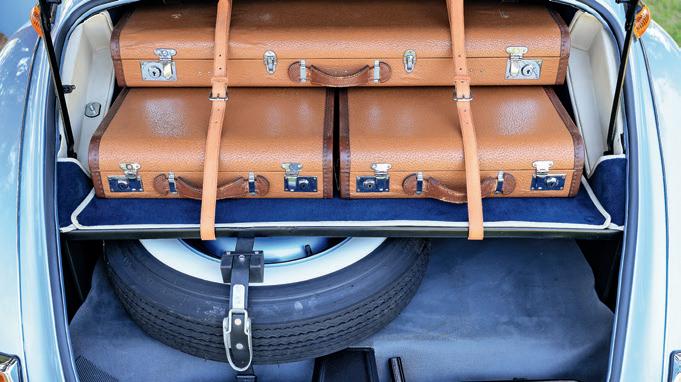

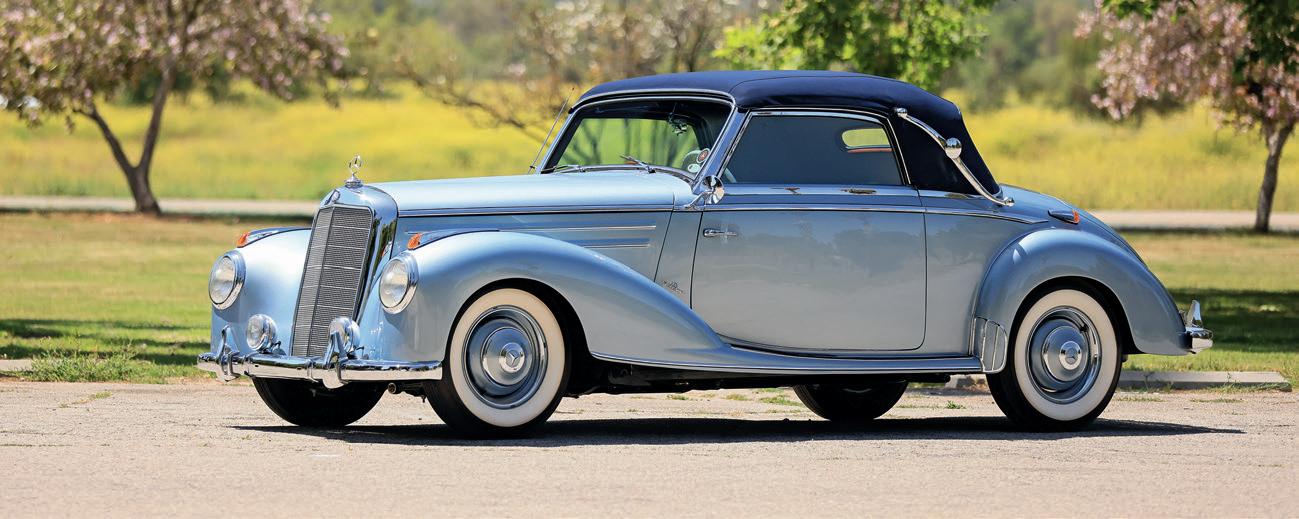

COACHWORK BY BERTONE
CHASSIS NO. 3739
ENGINE NO. 2502
$1,750,000–$2,250,000
The trajectory of the automobile was forever changed by Lamborghini’s introduction of the Miura. However, this was not the intent at the time. Ferruccio Lamborghini allowed his engineers to develop it merely as an exercise. But when the Miura debuted, initially as a naked chassis, and then four months later at the Geneva Motor Show in March 1966 with spectacular Marcello Gandini-designed Bertone bodywork, the car created so much impact that it could not simply circulate a few motor shows and pass into a museum. Thus, Lamborghini put it in production, effectively creating a genre of car that still exists today at the top of the automotive desirability hierarchy: the supercar.
Nearly everything about the Miura is super: its styling, its packaging, its technical
HIGHLIGHTS
Delivered New to Geneva Finished in Rare Bleu over Senape Factory Equipped with Numerous Special Features as Confirmed by Lavori Speciali Build Card
Restored by Lamborghini’s Centro Restauro Under the Direct Supervision of Valentino Balboni
Desirable Thick-Gauge Chassis; Retains Matching-Numbers Engine
Displayed in the Centro Eccellenza at the Sant’Agata Bolognese Factory Following Restoration
specifications, and its performance. It is powered by a transversely mounted quad-cam V-12, paired with a five-speed transaxle that sits in a monocoque chassis, from which double-wishbone suspension and disc brakes hang at all four corners. With specifications like these, the Miura instantly transformed Lamborghini Automobili, then just three years old, into the makers of the world’s most coveted car.
Although the car was not designed with production in mind, barely a year later, Lamborghini was building a few Miuras per month. Early owners served as de facto development drivers, and the model was developed continuously over its production. One of the most substantial early changes was a switch to thicker
SPECIFICATIONS
3,929 CC DOHC V-12 Engine
Four Weber 40 IDL Carburetors
350 BHP at 7,000 RPM
5-Speed Manual Transaxle
4-Wheel Girling Disc Brakes
4-Wheel Independent Double-Wishbone Suspension with Coil Springs and Shock Absorbers
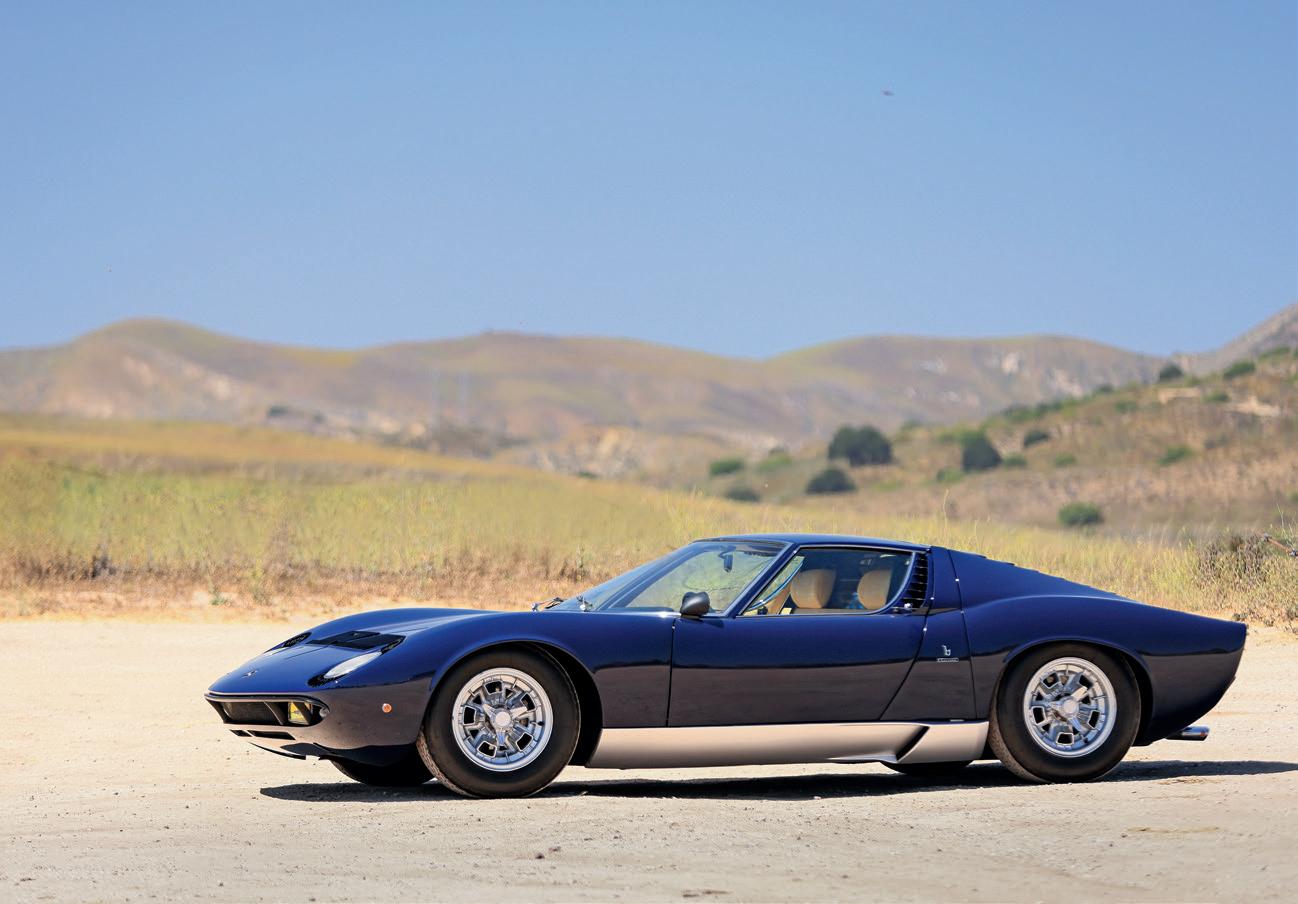

Private Owner, Switzerland (acquired in 1968)
Maurice Girard, Rue, Switzerland (acquired by 1988)
Louis Roulet, Geneva, Switzerland (acquired in 2005)
Eric Everard, Woluwe-Saint-Pierre, Belgium (acquired in 2013)
John Binnie, Faringdon, United Kingdom (acquired in 2017)
Current Owner (acquired from the above)

gauge steel for the chassis, which improved the car’s structural integrity. This P400, chassis 3739, incorporates this change. It was completed on October 30, 1968, and delivered to Grand Garage des Nations in Geneva, Switzerland, where it was registered for the first time the following day.
Copies of the original Lamborghini build sheets on file show that the car was originally finished in Bleu with Senape (Mustard) interior and confirm that it retains its matching-numbers engine today. The build sheets also include the notes by the factory test driver from his pre-delivery road test on the autostrada, as well as lavori speciali (special work) card that describes deviations from standard specification – including wider wheels, a quieter exhaust system, and non-standard horn and lighting.
This car remained in Switzerland for decades, and had at least two owners prior to a Geneva owner, who purchased the car in 2005 and commissioned Lamborghini to restore it under the watchful eye of Valentino Balboni. The car comes with correspondence about the restoration between that owner and various parties at Lamborghini, including CEO Stephan Winkelmann and Balboni. The letters and emails outline the scope and progress of this work, which is corroborated by invoices on Lamborghini letterhead and an album containing hundreds of photos of the restoration, many of which depict
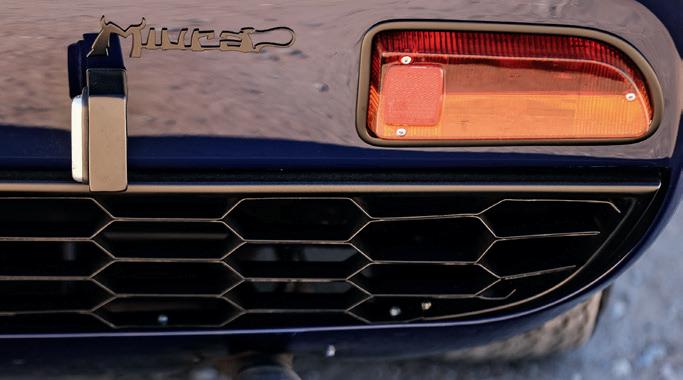



Auto Collector and Classic, November 2010
Lamborghini Miura, by Peter Coltrin and Jean-François Marchet
The Lamborghini Miura Bible, by Joe Sackey
The Lamborghini Miura Register, by Simon Kidston

Mr. Balboni himself with 3739 throughout the process. The restoration reportedly required 4,000 hours of work and encompassed all cosmetic and mechanical aspects of the car, including bodywork, paint, interior, engine, transaxle, driveline, suspension, and brakes. The work was completed in May 2008, a few months before Balboni officially retired from Lamborghini in October 2008. In a letter he wrote that same month, Balboni confirms that 3739 was restored in its entirety by the Centro Restauro (Restoration Center) section of Lamborghini’s Customer Service Department, describes the scope of the work, and thanks the car’s owner as well.
Upon its completion, the car was displayed at the Lamborghini factory’s Centro Eccellenza in Sant’Agata Bolognese before returning to Switzerland, where it was enjoyed by its owner for several years before being sold to a Belgian owner in 2013. In 2017, chassis 3739 was acquired by an owner in the UK, who then imported it to the US, where it has remained since.
Today, 3739 remains a striking example of this landmark model, finished in its rare, original color scheme. Since the completion of the restoration, 3739 has been carefully used and remains in excellent order, making this an ideal example for its new owner to share with the adoring public, as one of the rare cars whose appeal transcends nearly every generation of car enthusiast.
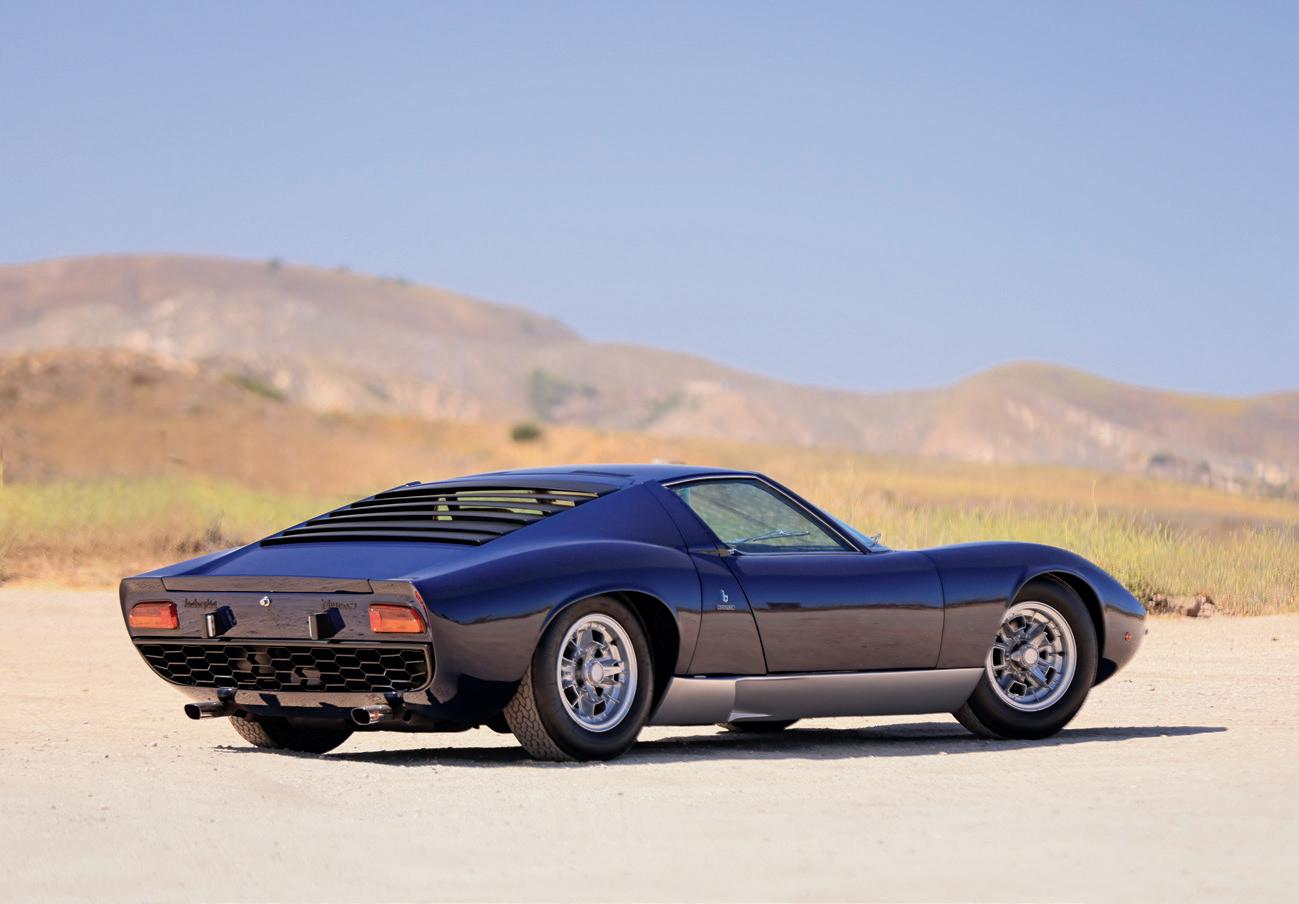
CHASSIS NO. 9110101579
ENGINE NO. 6109080
$130,000–$160,000 without reserve
This sensationally original 911 T was sold new in mid-1970 to Harry E. Brandenburg Jr., a young US-based government contractor, who arranged European delivery of the car through a Porsche dealership in Dublin, Ireland. After driving it in Europe, he shipped the car to his hometown of Vienna, Virginia. Finished in Blutorange (Code 2323) with an unusual beige leatherette interior, this 911 T is particularly desirable as it features a dogleg-pattern five-speed transaxle – a rare option for the model. Registration cards on file chronicle the vehicle’s light use, with just 15,112 miles showing at the time of cataloguing.
After nearly 46 years under one owner, and over 33 years in storage, the car was sold in January 2016. The longtime owner attested that the original paint on
One Owner from New Through 2016; Accompanied by Copy of its FahrzeugAuftrag
Displays Just over 15,100 Documented Miles Since New Remained in Static Storage for More than Three Decades
Finished in Desirable Blutorange with Rare Optional Dogleg 5-Speed from New Retains its Matching-Numbers Engine per Original Factory Maintenance Manual
this 911 saw rain only twice – when he encountered unexpected weather – and that the car was never driven over 80 mph. The consignor purchased the 911 in 2016, and had marque specialist Klub Sport Racing of Riviera Beach, Florida, recommission it to running and driving condition, with records on file. Cosmetically, the car was only carefully cleaned; the consignor believes the paint to be original, with the only refinished area being on the right side of the car, after brake fluid dripped on it during transport. The Porsche is complete with manuals, service documents, Irish tourist license plate and registration book, tools, and jack. Exceedingly rare in its current state, this irreplaceable 911 would be ideal for preservation-class display.
SPECIFICATIONS
2,195 CC Air-Cooled SOHC Flat 6-Cylinder Engine
Two Triple-Throat Zenith 40 TIN Carburetors
125 BHP at 5,800 RPM
5-Speed Manual Transaxle
4-Wheel Hydraulic Disc Brakes
4-Wheel Independent Suspension with Torsion Bars
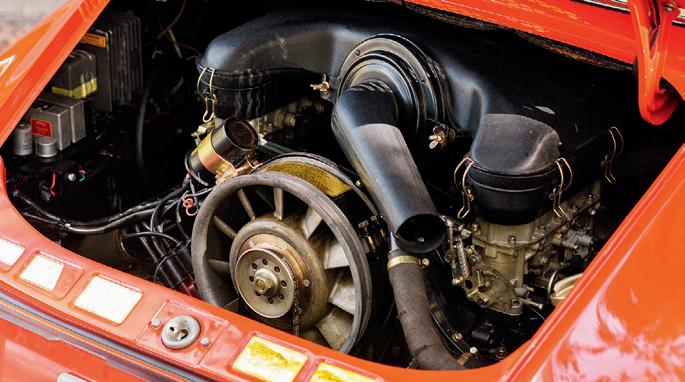

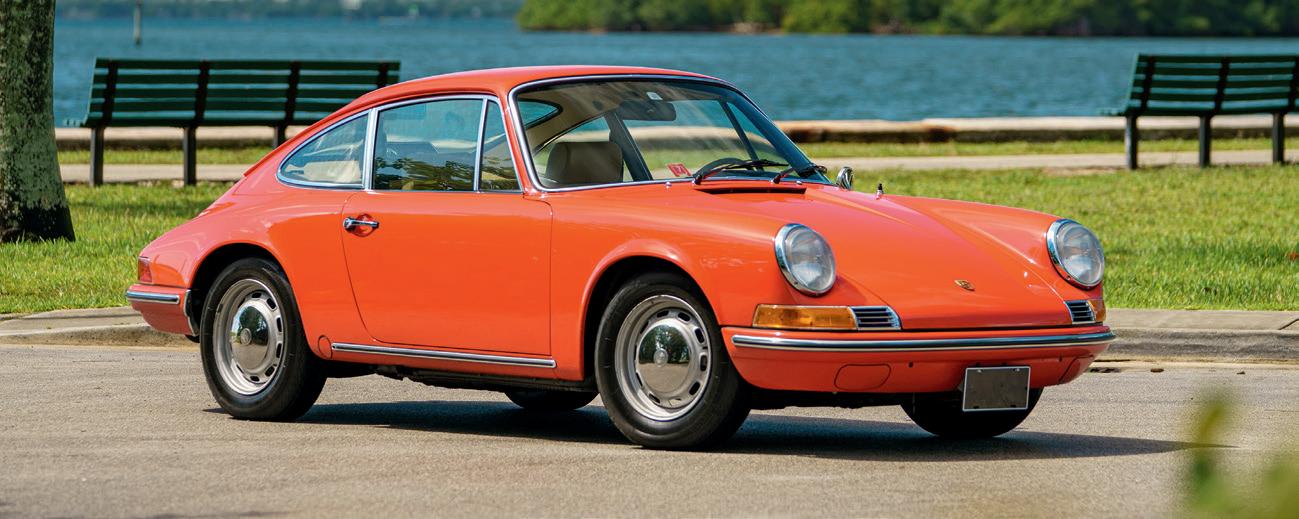

CHASSIS NO. XKC 028
ENGINE NO. E1028-8
$3,750,000–$4,500,000
In the aftermath of WWII, the automotive landscape underwent a dramatic transformation. Amid this period of rebirth and innovation, Jaguar emerged as a formidable force in motor sports, quickly gaining recognition for producing fast, beautiful, and competitive sports cars. The company’s early postwar success was spearheaded by the elegant XK120, a model that stunned enthusiasts and the industry alike with its speed and style. However, it was the arrival of the C-Type that truly signaled Jaguar’s arrival on the international stage.
Introduced in 1951, the Jaguar C-Type (short for “Competition Type”) was a machine engineered with a singular purpose: to win races. Designed by aerodynamicist Malcolm Sayer and incorporating the XK120’s well-proven mechanicals, the
HIGHLIGHTS
Among the Finest and Most Desirable of All Jaguar Sports Racers
One of Only 53 C-Types Built: Just 43 for Customer Use
Delivered New to the US Finished in Distinctive Silver Livery
Well-Documented Provenance Includes Distinguished Collectors
Exceptional Example Retaining Original Chassis, Body, and Engine per Factory Records
Offered with Detailed Report by Marque Authority Chris Keith-Lucas
C-Type featured a lightweight tubular frame, advanced suspension, and streamlined aluminum body that made it both swift and aesthetically pleasing. Powered by a modified version of the 3.4-litre XK engine, the C-Type offered both performance and reliability – critical traits in endurance racing.
The new Jaguar made an immediate impact in competition. While Ferrari reigned supreme at the 1000 Miglia, it was Jaguar who triumphed at the prestigious 24 Hours of Le Mans, winning the French endurance race in 1951 and again in 1953. These victories were significant – they marked the beginning of Jaguar’s dominance at Le Mans throughout the 1950s and cemented the C-Type’s legacy as a world-class sports racer.
3,442 CC DOHC Inline 6-Cylinder Engine
Twin SU H8 Carburetors
200 BHP at 5,800 RPM
4-Speed Manual Gearbox
4-Wheel Hydraulic Drum Brakes
Front Independent Suspension with Torsion Bars
Rear Live Axle with Transverse Torsion Bar and Panhard Rod


Doug Maier, Cleveland, Ohio (acquired new via Imported Motors Inc. in 1953)
William Franz, Ohio (acquired from the above in 1968)
Pat Black, Cleveland, Ohio (acquired from the above in 1974)
Joe Egle, Kansas City, Missouri (acquired from the above in 1981)
Bob Baker, Omaha, Nebraska (acquired from the above in 1988)
Dr. Philippe Reyns, Chandler, Arizona (acquired from the above in 1995)
William Ainscough, Jersey, UK (acquired from the above in 2018)
Current Owner (acquired from the above)
Beyond the factory team’s success, the C-Type also proved highly effective in private hands. With only 43 production examples built, these cars were eagerly acquired by skilled privateers around the world. From major circuit races to genteel club events, the C-Type showcased its prowess in a wide array of competitive settings. More than just a race car, it was a proper dual-purpose sports car that could be bought “over the counter,” driven to the track, raced with success, and then driven home – albeit with white knuckles and a pounding heart.
In every sense, the Jaguar C-Type was a brilliant sports car: fast, balanced, and undeniably beautiful. It not only elevated Jaguar to new heights in motor sports but also laid the foundation for the company’s future successes, including the legendary D-Type and E-Type that followed.
The C-Type presented here, chassis XKC 028, is among the finest surviving examples of this legendary Le Mans-winning sports racer.
One of the 43 C-Types built for customer use, XKC 028 was dispatched from Jaguar’s Coventry works on November 24, 1952, handsomely finished in silver and fitted with engine no. E1028-8, gearbox no. JH13314, and body no. K1028.
As recorded in The Complete Register of Jaguar C-Types, D-Types, & Lightweight
E-Types, XKC 028 was originally delivered via Jaguar distributor Charles Hornburg to Imported Motors Inc., a Denver, Colorado-based dealer operated by Charles Hughes and Kurt Kircher. It was from there that the C-Type was sold to its first private owner, Doug Maier of Cleveland, Ohio, who took delivery in June 1953.
A profile of XKC 028, published in the April 1982 issue of EJAG News Magazine, provides a wonderful snapshot of Maier’s ownership:
“Doug Maier was notorious among the Cleveland Jaguar owners of the day because he would never respond to their waves and horn honks. He drove the C-Type on the street with his ‘nose in the air’ and a cigarette holder clenched between his teeth, FDR-like. According to legend he never acknowledged the friendly salutes of the other Jaguar owners when he was in the C-Type.”
Maier used XKC 028 exclusively as a road car, accumulating approximately 23,000 miles before selling it to second owner William Franz in 1968. Pat Black purchased the C-Type from Franz in 1974, had the engine rebuilt by Jaguar specialist Lou Fidanza, and then took it around the concours circuit, winning several prizes.
The C-Type’s next caretaker was Joe Egle of Kansas City, Missouri. Following his


Elkhart Lake Vintage Grand Prix and Concours, 1981
Atlanta Vintage Grand Prix and Concours, 1981
Sebring Vintage Race, 1982
Folly Classic Vintage Grand Prix, Kansas City, Missouri, 1985
Jaguar Factory Cavalcade to the 24 Hours of Le Mans, 1991
Monterey Historic Automobile Races, Laguna Seca, 1992
Monterey Historic Automobile Races, Laguna Seca, 1996
Wine Country Classic, Sonoma, California, 2000
Colorado Grand, Multiple Editions
Jaguar C- & D-Type Reunion Tour, Multiple Editions
successful career as a British car dealer, Egle began collecting the kind of cars he had previously sold, focusing primarily on the Jaguar marque. During the mid-1970s, he owned an example of virtually every postwar Jaguar, including an XK120, XK150S, E-Type, D-Type, and XKSS. The C-Type was one of the last important models he acquired, purchasing XKC 028 from Pat Black in 1981.
The April 1982 EJAG profile on XKC 028 notes that Egle “acquired the car last year after a marathon telephone session, covering the eastern half of the country, that led him to Black’s door. But Pat Black did not want to sell and it took all of Joe’s persuasive powers to finally see XKC028 parked comfortably next to the MG TD and the other Britons in the Egle garage.”
After performing some light restoration work, Egle debuted the C-Type at the Elkhart Lake vintage races, winning first place in the concours d’elegance. Next, he entered the Jaguar in the Atlanta Vintage Grand Prix, capturing first place in the pre-1956 race and the concours. He continued to campaign the C-Type in historic events, including races at Laguna Seca, Road Atlanta, and Sebring, throughout his ownership. In 1985, Egle loaned XKC 028 to famed C-Type racers Phil Hill and Masten Gregory for a parade lap of the Folly Classic Vintage Grand Prix in Kansas City, Missouri.
Joe Egle retained the C-Type until 1988, when it was sold to Bob Baker of Omaha, Nebraska. A connoisseur who owned some of the most significant postwar sports and racing cars, Baker entered XKC 028 in the Colorado Grand, the Monterey Historic Automobile Races, and the Jaguar factory cavalcade to Le Mans in 1991.
Arizona-based collector Dr. Philippe Reyns acquired the C-Type in 1995 and continued putting it to good use on both road and track, taking part in vintage races like the Monterey Historics and the Wine Country Classic, as well as several editions of Terry Larson’s exclusive C- and D-Type Reunion Tour.
In 2018, XKC 028 returned to the UK when it was acquired by British collector William Ainscough. During his ownership, a sympathetic restoration was carried out in a joint effort by respected marque specialists Chris Keith-Lucas and Julian Parker. Contained in the car’s history file is a detailed report prepared by Mr. Keith-Lucas that concludes:
“XKC 028 is a particularly complete and correct C type, indeed I cannot think of a more original example. The condition is excellent, and I believe it has had the most sensitive of restorations. I would particularly recommend it as a chance to see just how these cars looked on day one. Perhaps rather counter-intuitively,


The Complete Register of Jaguar C-Types, D-Types & Lightweight E-Types, by Den Carlow, Anders Ditlev Clausager, Paul Skilleter, and Penny Woodley
The EJAG News Magazine, Vol. 9, No. 4., April 1982
Jaguar Sports Racing & Works Competition Cars to 1953, by Andrew Whyte
Jaguar Sports Racing Cars: C-Type, D-Type, XKSS, Lightweight E-Type, by Philip Porter
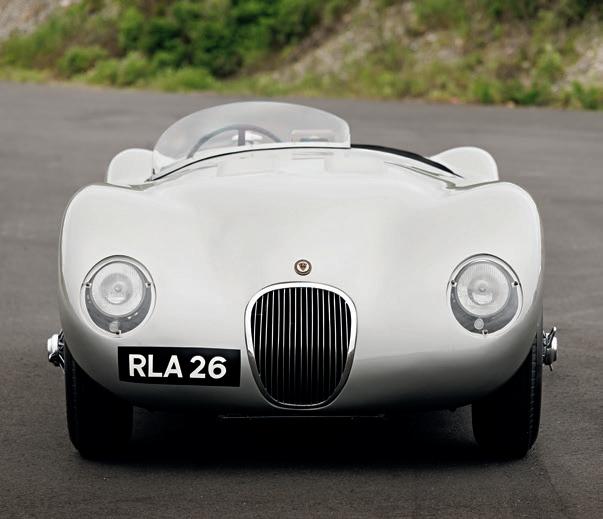
what is good about XKC 028 is that it actually did not race in period. This has saved it from the typical damage and crude modification that some cars suffered in racing at the time they were at their lowest value. It is absolutely a car to cherish and I would love to own it.”
Indeed, it was XKC 028’s sheltered early existence as a fair-weather sports car on the backroads of Cleveland that contributed to its wonderfully intact and original condition today. A real rarity among C-Types, it is correct in all major respects, retaining its original chassis, body, engine, and gearbox among other rarely seen authentic details. Its uncommon, as-supplied silver paintwork perfectly highlights Malcolm Sayer’s breathtaking design, which still looks fresh and modern after more than 70 years.
A truly exceptional C-Type, XKC 028 is worthy of your closest inspection and consideration.
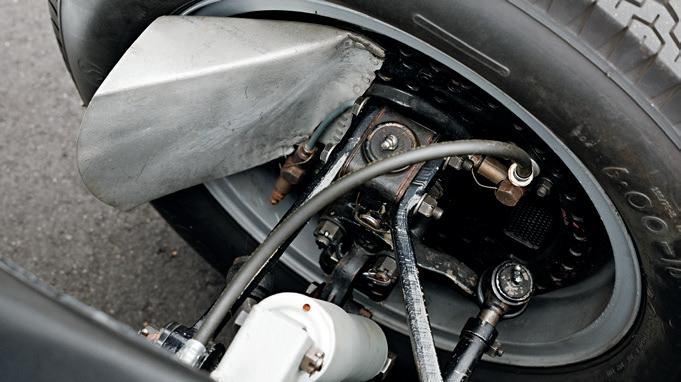

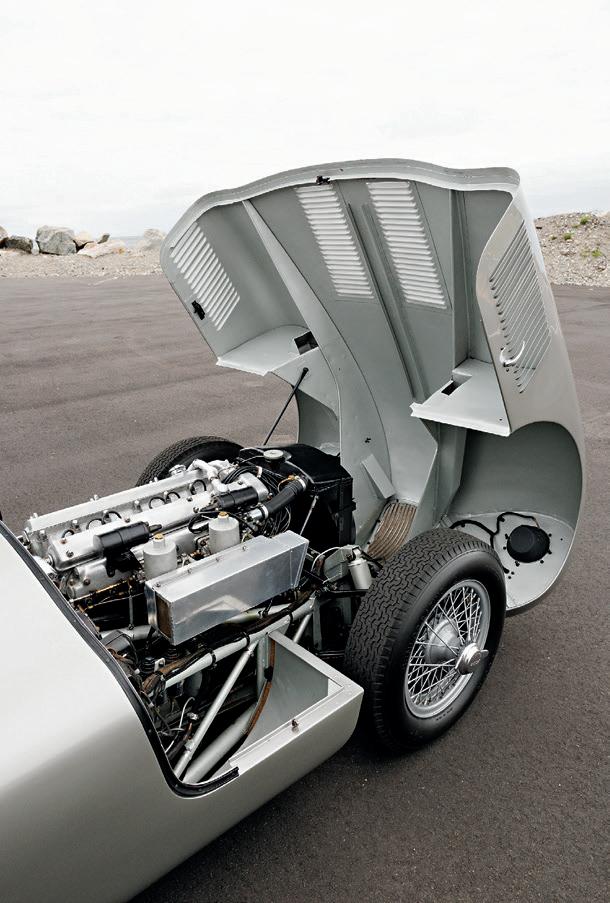
CHASSIS NO. 670060
ENGINE NO. W1113-8
$300,000–$400,000 without reserve
Arriving during Britain’s austere early postwar years, the XK120 was positively shocking when it debuted in 1948. It was impossibly modern, both aesthetically and technically. This latter part was especially important, as the car was originally introduced to showcase Jaguar’s exciting new twin-cam engine, since the new saloon for which it was developed was not yet ready. Intended for low-volume production, the XK120 featured handmade aluminum bodywork. However, strong demand persuaded Jaguar to retool for mass production with steel bodies after 242 alloy-bodied examples had been built.
These alloy-bodied cars represent a small fraction of the more than 12,000 XK120s built and are therefore prized by collectors. Accordingly, this example
HIGHLIGHTS
Attractive Example of the Most Desirable Road-Going XK120 Variant
One of 242 Alloy-Bodied XK120s Built; Just 184 in Left-Hand Drive
Finished in Its Elegant Original Color Combination of Black with Biscuit and Pigskin Interior
Retains Matching-Number Engine Block per Accompanying JDHT Certificate
Widely Event-Eligible Sports Car, an Ideal Example to Use
received an extensive bare-metal restoration to high standards during the late 1980s. According to its accompanying JDHT certificate, the car was restored in its handsome as-delivered color combination and retains its original engine block. The certificate also confirms that this example was originally delivered to the US, as many XK120s were, and sold new to J.L. Albert via Clayrich Motors of St. Louis, Missouri. Since its restoration, this Alloy Roadster has been carefully owned by several knowledgeable collectors including Terry Larson and Mark J. Smith. It remains a handsome example of the most desirable road-going XK120 – ideal for extensive use, including participation in the numerous driving events for which it is eligible.
SPECIFICATIONS
3,442 CC DOHC Inline 6-Cylinder Engine
Twin SU H6 Carburetors
160 BHP at 5,200 RPM
4-Speed Manual Gearbox
4-Wheel Lockheed Hydraulic Drum Brakes
Front Independent Suspension with Wishbones, Torsion Bars, and Telescopic Dampers
Rear Live Axle with Semi-Elliptical Leaf Springs and Lever-Type Dampers
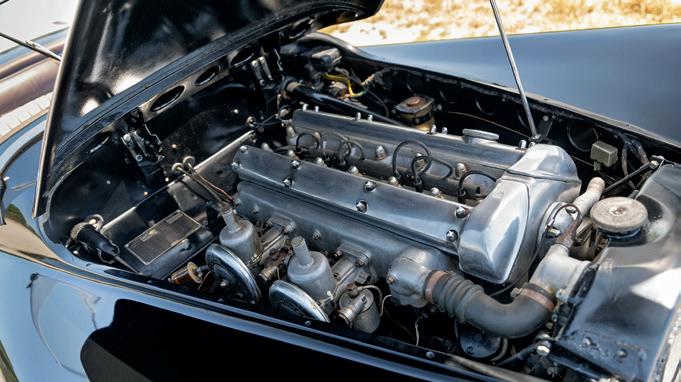

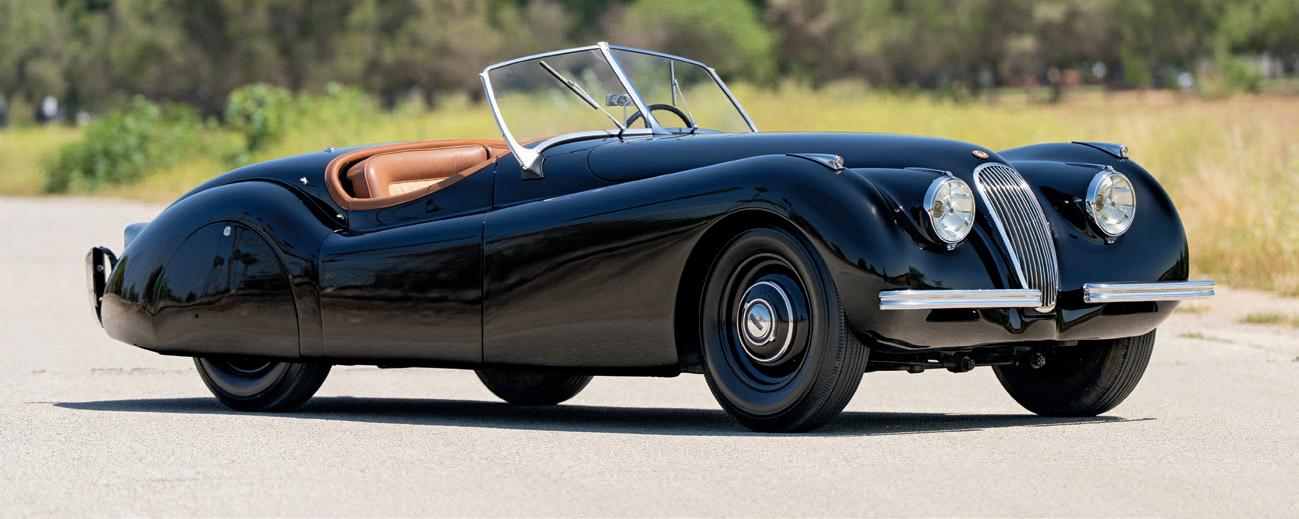

CHASSIS NO. 198.040.6500053
ENGINE NO. 198.980.6500072
$1,600,000–$2,000,000
According to its factory data card, this outstanding 300 SL Gullwing, chassis 6500053, was completed on March 14, 1956. It was finished in the rare and highly desirable color scheme of Black (DB 40) with Dark Red (1080) leather upholstery.
Noted as a special-order car, it was factory-equipped with chrome-plated wheels, Continental tires, and was originally destined for delivery in Germany.
While the data card does not list it among the factory options, the original matching-numbers engine block – no. 6500072 – is stamped with the letters “NSL,” denoting the factory’s high-performance sport package. This NSL specification, which included a hotter camshaft, Bosch R3 mechanical injection pump, and a special distributor, was standard on the 29 alloy-bodied Gullwings,
HIGHLIGHTS
Special-Order Gullwing Originally Finished in Black over Dark Red Leather
Sold New to Racing Driver Rolf-Friedrich Götze and Entered in the 1956 Rallye Trifels
Carefully Maintained by One New York-Based Enthusiast for over 50 Years
Presented in Well-Preserved, Unrestored Condition with Outstanding Patina
Retains Matching-Numbers Engine and Features “NSL” Components
Accompanied by Tool Kit, Belly Pans, Data Card Copy, and History File
*Please note that this vehicle is titled as 6500048, which is its body number.
and occasionally fitted to steel cars destined for competition. Whether these upgrades were installed at the factory before delivery or retrofitted shortly afterward is unclear. However, their presence is fitting, given the racing pedigree of the Gullwing’s first owner: Rolf-Friedrich Götze of Burscheid, Germany.
Götze served as General Director of Götze Werke AG, a major manufacturer of piston rings, gaskets, and engine components. He began racing in the early 1950s with a 1.1-liter Porsche 356 and competed in many top-tier European events, including the Nürburgring 1000 Km, 1000 Miglia, Coupe de Vitesse at Montlhéry, and Coppa Inter-Europa at Monza. After an accident at Spa in the late 1950s, he transitioned to powerboat racing, where he won both National
2,996 CC SOHC Inline 6-Cylinder Engine
Bosch Mechanical Fuel Injection
250 BHP at 6,200 RPM
4-Speed Manual Gearbox
4-Wheel Hydraulic Drum Brakes
Front Independent Double-Wishbone Suspension with Coil Springs
Rear Swing-Axle Suspension with Coil Springs
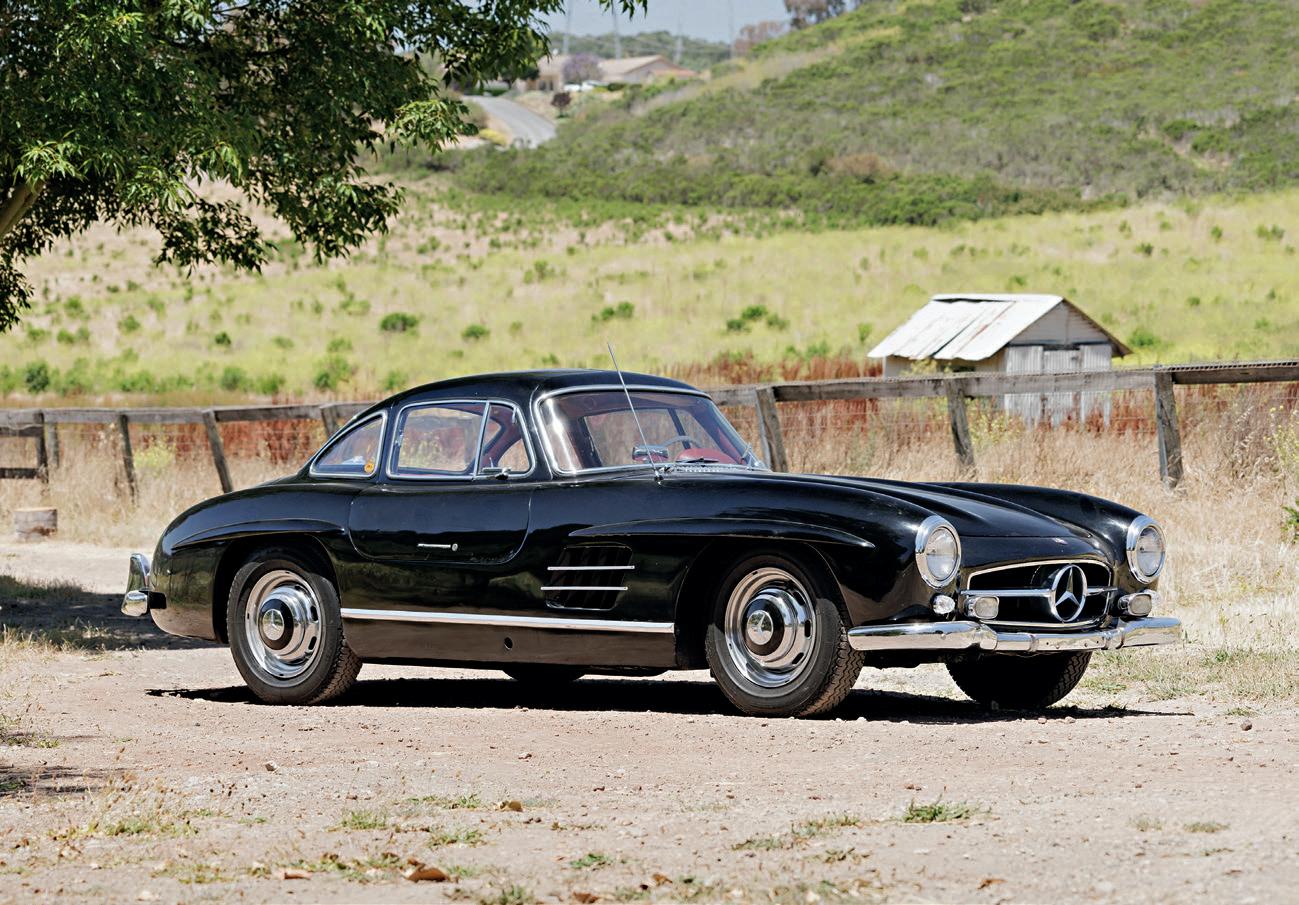

Rolf-Friedrich Götze, Burscheid, Germany (acquired new in 1956)
Dr. Robert B. Robertson, Rumson, New Jersey (acquired in 1959)
Michael Quigley, Skaneateles, New York (acquired from the above in 1970)
Current Owner (acquired from the above)
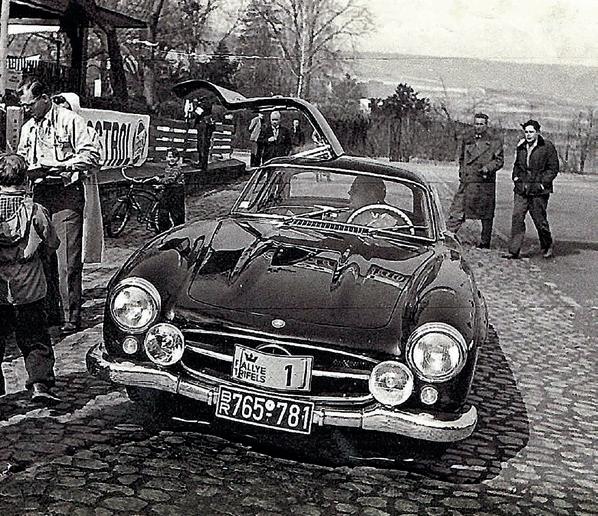
and European Championship titles. As evidenced by a period photograph in the car’s history file, Herr Götze entered this black Gullwing in the 1956 Rallye Trifels, a competitive event organized by the Automobilclub von Deutschland International Sports Car Club.
Götze’s ownership of the Gullwing appears to have been short-lived; he later traded it for a new 300 SL Roadster. The Gullwing was subsequently exported to the US, where its first reported American owner was George Huntington Hartford II – an heir to the vast A&P supermarket fortune. The car then passed to an owner in Staten Island before being sold in 1959 to Dr. Robert B. Robertson of Rumson, New Jersey.
In April 1970, Dr. Robertson sold the car to Michael Quigley of Skaneateles, New York. According to handwritten notes on file, Quigley discovered the Gullwing in a New York Times classified ad with an asking price of $5,000. At the time, the car had covered approximately 49,500 miles and was equipped with a Becker radio, fog lights, an outside air temperature gauge, 3.25:1 rear-axle gears, and a “racing camshaft.”
Soon after acquiring the car, Quigley joined the Gull Wing Group and remained an active member throughout his 53 years of ownership. He added roughly 15,000
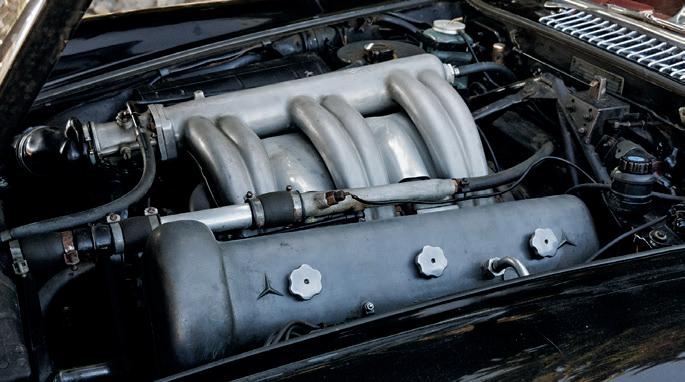
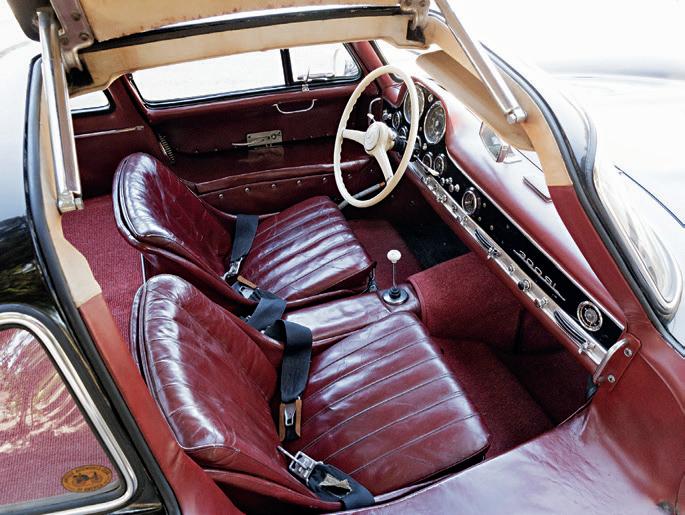


Rallye Trifels, Germany, 1956, Goetze, No. 1
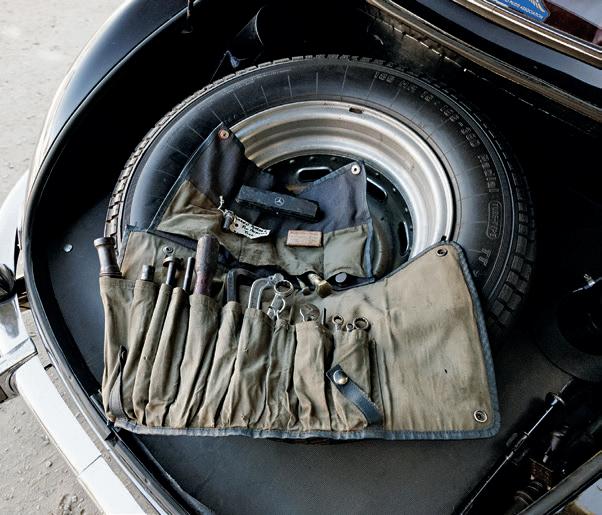
miles, driving it to the 1981 Gull Wing Group convention in Pennsylvania, the 1991 Watkins Glen historic races, and on weekend drives throughout New York’s scenic Finger Lakes region. A detailed logbook documents the attentive care and regular maintenance the Gullwing received under Quigley’s stewardship. His remarkable half-century of ownership came to a close in 2023, when the car was acquired by the current caretaker.
Today, this cherished Gullwing presents with a distinctive patina that only an original, unrestored example can display. At the time of cataloguing, the odometer showed just over 65,000 miles. The car features beautifully aged black nitrocellulose paint and exceptionally well-preserved original upholstery. Included in the sale are the original belly pans, tools, and a comprehensive history file containing a copy of the factory build record, decades of correspondence, and registration documents tracing the car’s ownership for more than 50 years.
For the collector seeking a truly charismatic 300 SL, this car checks every box: a factory black-over-red, German-delivered Gullwing with a well-documented history, matching-numbers engine with rare NSL components, and a provenance that includes an industrialist amateur racer and a devoted long-term enthusiast. It stands as one of the most compelling Gullwings to come to market in recent years and represents an opportunity that is unlikely to repeat itself.

VIN. 1FAFP90S25Y400006
$325,000–$400,000 without reserve
The Ford GT40 is one of the most significant cars in the history of endurance racing. With four consecutive Le Mans victories between 1966 and 1969, the GT40 comfortably secured its place in motor sports lore. In the early 2000s, Ford’s 100th anniversary was approaching rapidly, and the company wanted to create a special car to mark the occasion.
First shown as a styling exercise at the 2002 Detroit Auto Show, the GT40 Concept drew significant inspiration from the classic race car whose name it shared, yet was uniquely its own design. Penned by American designer Camilo Pardo, the aluminum-bodied GT40 Concept was the ultimate iteration of the “retro-modern” styling of the era, drawing acclaim from automotive publications and enthusiasts alike.
HIGHLIGHTS
The Sixth Production Ford GT
Finished in Mark IV Red with White Over-the-Top and Door Stripes
A Four-Option Car: Fitted with Stripes, Forged Wheels, Gray-Painted Brake Calipers, and McIntosh Stereo
Showing Just 10,082 Miles at the Time of Cataloguing
Ford’s Modern Interpretation of Its Most Famous Race Car
Within six weeks of the concept being shown, Ford announced that it was going to put a road-going variant of the GT40 Concept into production under the name “Ford GT.” Production began in July 2004 as 2005 model year vehicles, and 4,038 examples were built in just over two years. Although Ford was unable to begin deliveries of the GT during its centennial year, the designers integrated a hidden “100” in the left headlight in celebration of the achievement.
Powered by a mid-mounted 5.4-liter V-8 with an Eaton 2300 supercharger sitting on top, the GT produces 550 hp and 500 lbs./ft. of torque. Power is sent
5,409 CC DOHC Supercharged V-8 Engine
Sequential Multi-Port Electronic Fuel Injection
550 BHP at 6,500 RPM
6-Speed Manual Transaxle
4-Wheel Brembo Ventilated Disc Brakes
4-Wheel Independent Suspension with Coil Springs

Ford Motor Company, Dearborn, Michigan (retained from new in the Ford Motor Company collection)
Private Collection, California (acquired from above in 2009)
Current Owner (acquired from above in 2015)
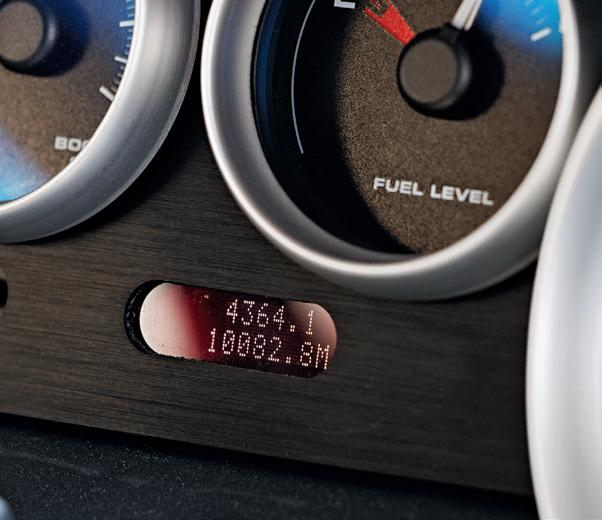
through a six-speed Ricardo transaxle with a limited-slip differential to the rear wheels. While the Ford GT’s European competitors were moving towards paddle shifters and multimode traction control, the GT was designed as a driver’s car, offering no automated gearbox or safety systems.
This 2005 Ford GT is the sixth car off the production line and is finished in striking Mark IV Red with white over-the-top and side stripes. Initially retained by Ford, this car was auctioned off in 2009 in excellent condition, showing 4,065 miles, to raise money for the Juvenile Diabetes Research Foundation. Under the care of two private owners since, the car showed 10,082 miles at the time of cataloguing.
To keep the production process simple, the Ford GT was only available with four options: over-the-top stripes, forged BBS wheels, a McIntosh stereo, and painted brake calipers. This example is a “four-option” car, ordered with the calipers finished in gray.
This Ford GT presents a unique opportunity to acquire one of the earliest publicly owned examples of this iconic American supercar. Finished in an appealing color combination and kept in overall excellent condition, this GT promises a thrilling drive every time you get behind the wheel.


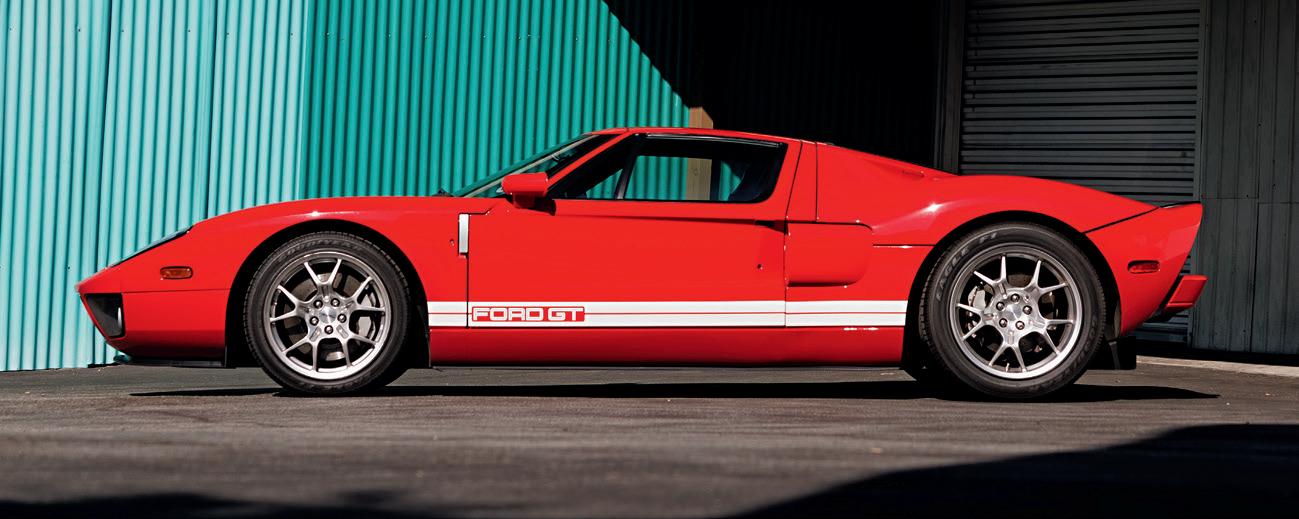
COACHWORK BY PININFARINA
CHASSIS NO. 2407 SA
ENGINE NO. 2407 SA
$5,500,000–$6,500,000
Ferrari’s “America” series of custom-bodied, large-displacement grand touring cars were created for the most elite clientele – discerning motorists for whom cost was immaterial, provided that exclusivity, performance, and sophistication were assured. Among the original owners of these magnificent machines were royals like Shah Reza Pahlavi of Iran and Emperor Bao Dai of Vietnam; prominent Italian industrialists such as Gianni Agnelli, Renato Bialetti, Pietro Barilla, and Dott. Enrico Wax; and wealthy American enthusiasts including Bill Harrah, Tony Parravano, and Robert Wilke.
Joining this exclusive circle was Niccolò De Nora, an Italian entrepreneur with longstanding ties to the Ferrari marque.
HIGHLIGHTS
One of Only Six Series I 400 Superamerica Cabriolets Built by Pininfarina
Delivered New to Italian Industrialist and Ferrari VIP Client Niccolò De Nora
A Fixture in the Esteemed Greg Garrison Ferrari Collection for over 20 Years
Exquisite Award-Winning Restoration by Bob Smith Coachworks
Featured on the Cover of Cavallino Magazine
Documented by Marcel Massini; Retains Matching-Numbers Engine per Factory Records
Born in Milan in 1931, Niccolò was the son of Oronzio De Nora, an influential engineer and scientist who, in 1923, founded Industria De Nora S.p.A., a firm specializing in electrochemical technologies. Under the leadership of the De Nora family, the company became a global powerhouse in the production of chlorine, caustic soda, and later, in pioneering advancements in water treatment, green hydrogen, and energy transition technologies.
Although the De Nora legacy was firmly rooted in Milan’s industrial sector, Niccolò ventured into the automotive realm, supplying Ferrari with exhaust components through his firm SNAP. In 1962, he founded Autocostruzioni Società per Azioni (ASA), with the goal of building a small, stylish gran turismo. The ASA
3,967 CC Tipo 163 SOHC V-12 Engine
Three Solex C40 PAAI Carburetors
320 BHP At 6,600 RPM
4-Speed Manual Gearbox
4-Wheel Vacuum-Assisted Dunlop Disc Brakes
Front Independent Suspension with Coil Springs and Shock Absorbers
Rear Live Axle with Radius Arms, Semi-Elliptical Leaf Springs, and Shock Absorbers


Niccolò De Nora, Milan, Italy (acquired new in 1961)
Ted Dibble, Coos Bay, Oregon (acquired by 1965)
Bruce D. Russell, Vancouver, Canada (acquired from the above in 1968)
Dr. Anthony Service, Vancouver, Canada (acquired from the above in 1972)
Harley E. Cluxton III, Phoenix, Arizona (acquired from the above in 1976)
Rex H. De George, Beverly Hills, California (acquired from the above in 1977)
Greg Garrison, Thousand Oaks, California (acquired in 1979)
Current Owner (acquired from the above in 2001)
1000 GT, powered by a one-liter, four-cylinder engine developed in Modena by Vittorio Bellentani, was engineered with significant input from former Ferrari technicians. Though ASA had no official affiliation with Ferrari, its refined design and engineering pedigree earned the 1000 GT the nickname “Ferrarina.”
As both a favored client and a component supplier, Niccolò enjoyed a respectful, professional relationship with Enzo Ferrari, who even recommended Romolo de Stefani, a former Autobianchi executive, to lead ASA as its general manager.
It is only fitting, then, that De Nora was among the first to place an order for Ferrari’s newest and most exclusive grand touring model: the 400 Superamerica. This flagship Ferrari was introduced to the public as the ultimate expression of road-going luxury and performance.
De Nora’s 400 Superamerica, chassis 2407 SA, was one of just six short-wheelbase Series I chassis to receive Cabriolet coachwork by Pininfarina. Rarer than the coachbuilder’s more widely seen Coupe Aerodinamico, which was based on the celebrated Superfast II show car, the Cabriolet was a more traditional yet equally imposing design. With crisp lines, a commanding hood scoop adorned with chrome brightwork, and elegant GTE taillamps, it blended elements from earlier 250 GT Cabriolets with distinctive new flourishes. Most were fitted with
removable hardtops and bespoke interiors, luxuriously appointed with Veglia instrumentation and the latest motoring accessories.
Completed in spring 1961, De Nora’s Cabriolet, bearing body no. 99502, was finished in Grigio Argento (Silver Gray) over black Connolly leather. Ferrari factory build sheets note its rare mechanical specification: Solex carburetors and Bosch distributors, rather than the more typical Weber and Marelli combination. The engine, internal no. 18 SA, remains original to the car today.
Shortly after its delivery, 2407 SA made a high-profile appearance at the 1961 Monaco Grand Prix, where it served as the official car for the Directeur de Course, or course marshal. In August 1962, De Nora acquired another 400 Superamerica – Pininfarina’s sensational, one-off Superfast IV show car, chassis 2207 SA. Exactly how long he retained the Cabriolet remains unclear.
By 1965, chassis 2407 SA had been exported to the US, where it was owned by Ted Dibble, a real estate developer in Coos Bay, Oregon. He repainted it in Ford Mustang Poppy Red and added a roll bar. Three years later, it passed to Bruce Russell of Vancouver, who removed the roll bar and refinished the car in light yellow.

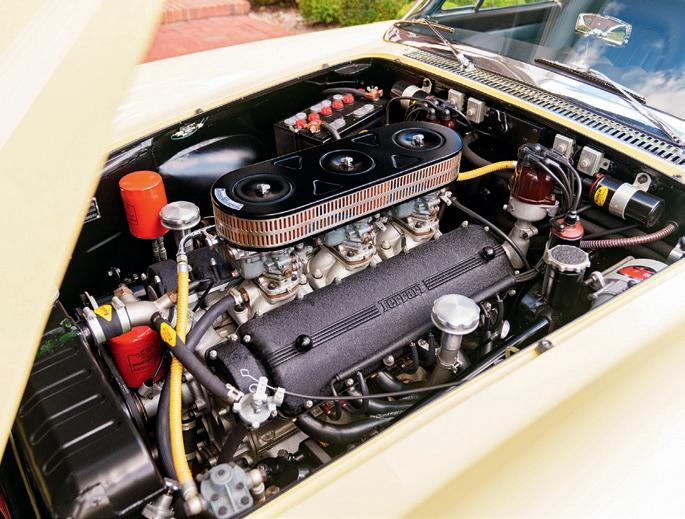
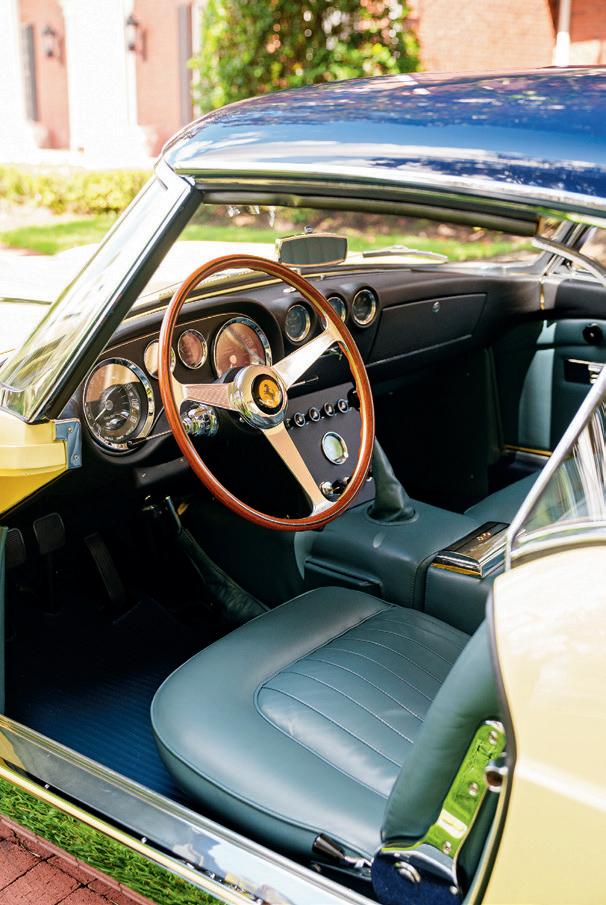



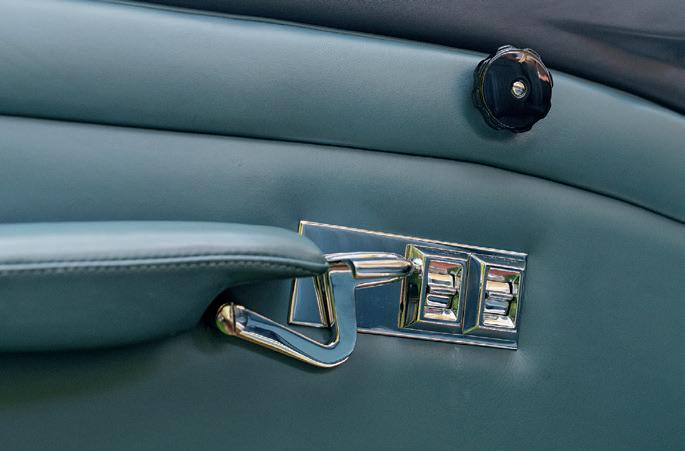
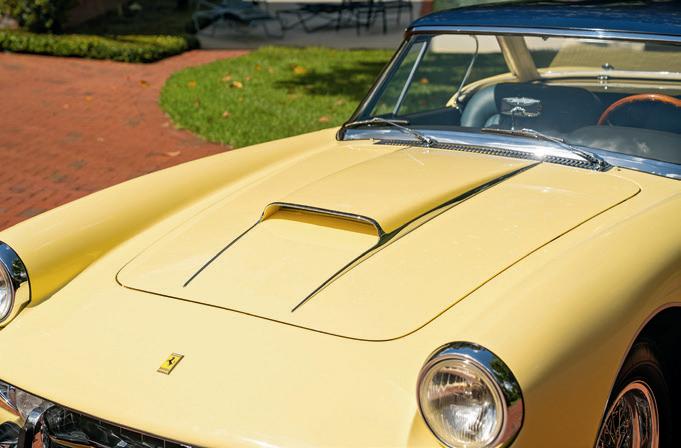
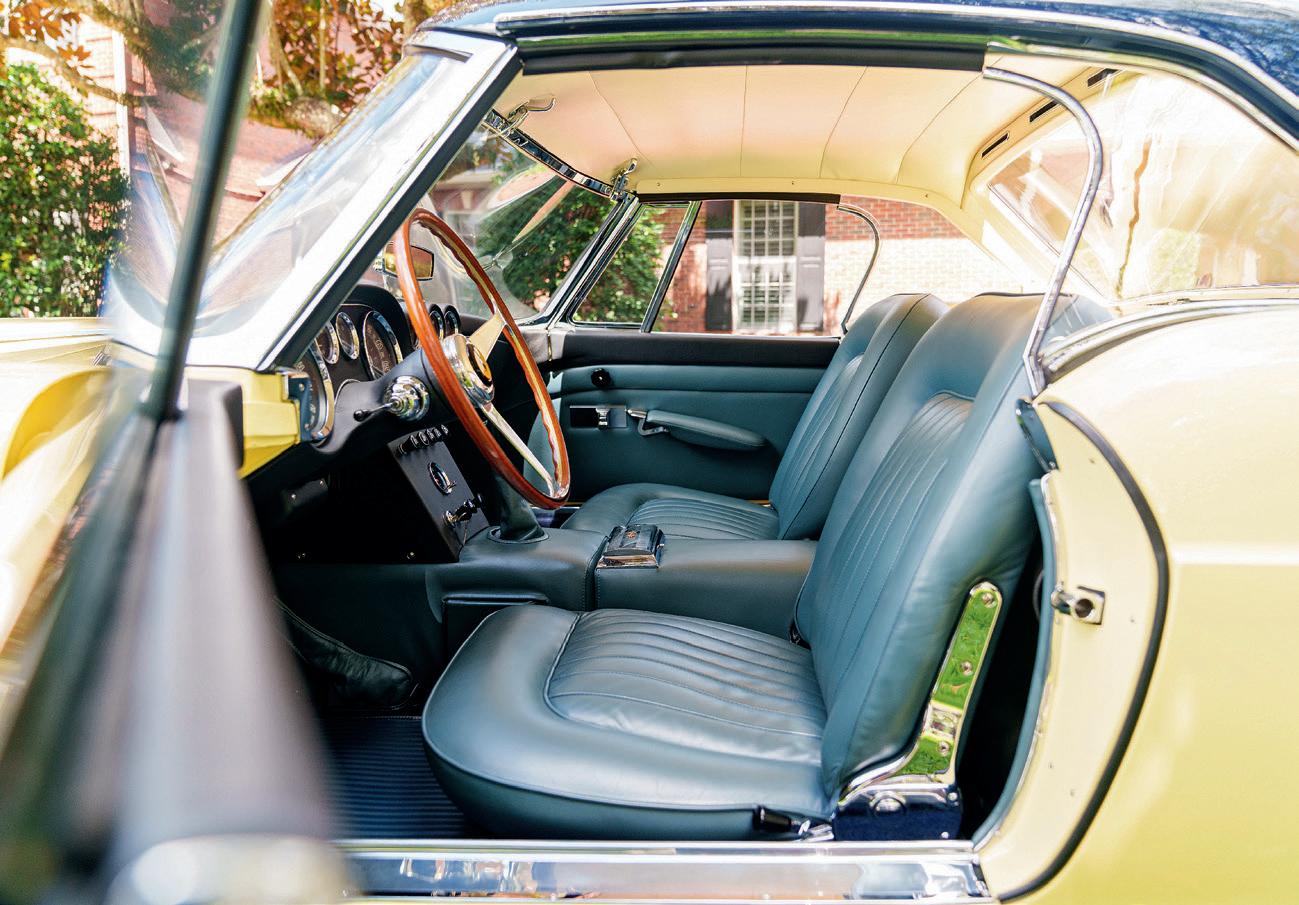

Cavallino Classic, 2008 (Platinum Award, Excellence Cup)
Classic & Sports Sunday at Mar-a-Lago, 2008 (People’s Choice)
Pebble Beach Concours d’Elegance®, 2008 (Third in Class)
Amelia Island Concours d’Elegance, 2010
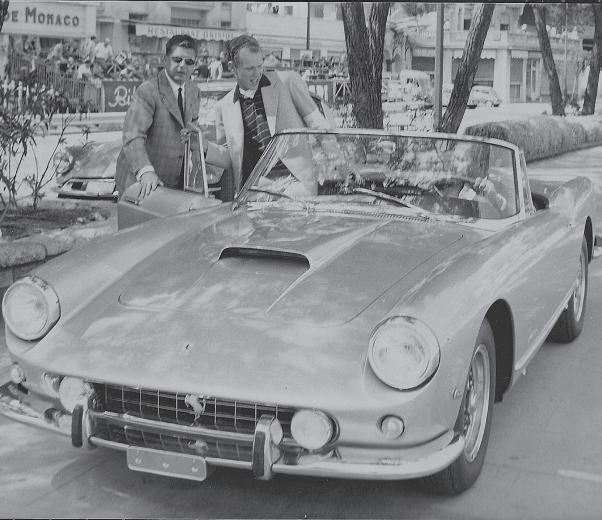
Remaining in the Pacific Northwest for another decade, the Superamerica was traded in 1976 to Harley Cluxton’s Grand Touring Cars of Scottsdale, Arizona, toward a new 308 GT4 Dino. In 1977, it was included in a package deal to Rex H. De George of Beverly Hills, California.
In 1979, the car entered the esteemed collection of Greg Garrison, a prominent television producer and avid Ferrari aficionado. Over the next 22 years, 2407 SA was a centerpiece in Garrison’s stable of coachbuilt Ferraris, which included legendary models such as Superfast I, 4.9 Superfast, 365 California, and 330 GTC Speciale. The Cabriolet resided in both his Southern California barn and Montana summer retreat until 2001, when it passed to its current owner.
A passionate Ferrari collector with experience restoring some of the marque’s most significant coachbuilt models – including a 410 Superamerica, 500 Superfast, and several 400 Superamericas – the consignor commissioned Bob Smith Coachworks of Gainesville, Texas, for a no-expense-spared, concours-quality restoration. The car was refinished in the arresting combination of light yellow with a dark blue hardtop and medium blue leather upholstery.
Completed in 2008 and shown selectively over the following two years, 2407 SA received numerous accolades, including a Platinum Award and Excellence

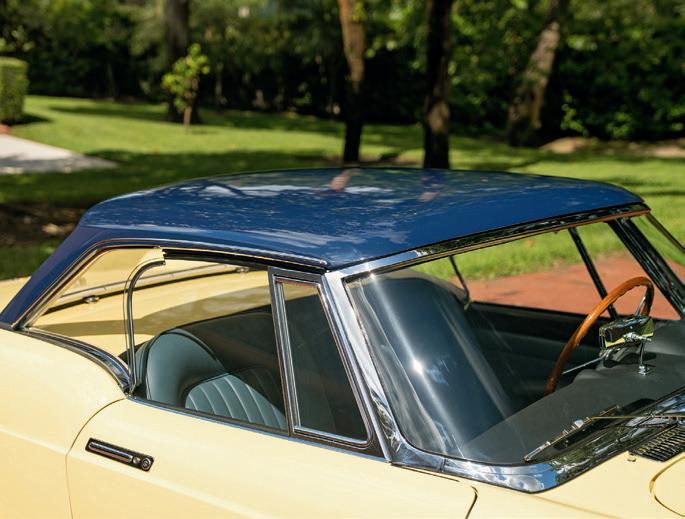
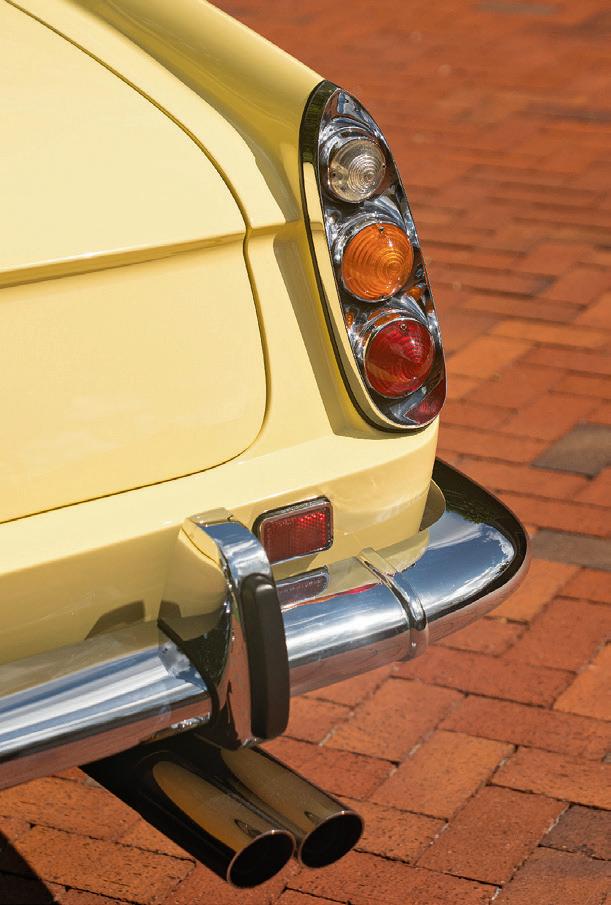

Cavallino, No. 165, June/July 2008
Ferrari: America, Superamerica, Superfast, by Bruno Alfieri
Ferrari by Pininfarina, by Etienne Cornil
The Ferrari Legend: The Road Cars, by Antoine Prunet Le Ferrari di Pininfarina, by Angelo Tito Anselmi
Pininfarina: Architect of Cars, by Michael Frostick
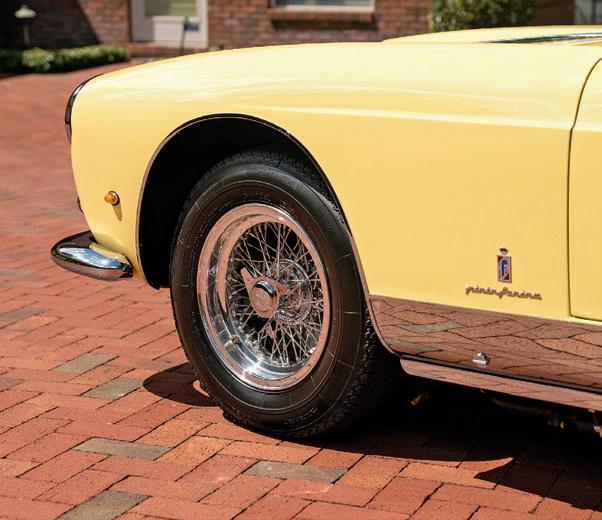
Cup at Cavallino and a Third in Class at the Pebble Beach Concours d’Elegance®. It also graced the cover of Cavallino magazine and was the subject of a featured article by marque historian Alan Boe. Its last public showing was in 2010, at the Amelia Island Concours d’Elegance.
A rare and evocative example of early 1960s Italian craftsmanship, this 400 Superamerica Series I Cabriolet epitomizes the exclusivity and bespoke artistry of Ferrari’s golden era. Among the most expensive road cars of its time and limited to just six examples in this specification, 2407 SA is remarkable not only for its rarity, but also for its impeccable provenance. Commissioned by Niccolò De Nora – an industrialist with deep Ferrari connections – owned for decades by legendary collector Greg Garrison, and restored to world-class standards, this Pininfarina masterpiece remains a crowning achievement.

CHASSIS NO. 7406876
$90,000–$120,000 without reserve
Highly desirable among Chrysler’s Town and Country offerings are its convertible models, providing an unmatched combination of open-air touring and handcrafted wood work. Less than 8,400 examples were built during the three-year production run, including the example offered here. The intricate handwork is evident in the details of the wood joinery, painstakingly crafted by the Pekin Wood Products Company of Helena, Arkansas. The extensive labor combined with the transportation costs back to Detroit contributed to the cost premium for these cars, making them the most expensive model in the Chrysler New Yorker lineup. Old-world body craftsmanship is coupled with Chrysler’s powerful Spitfire straight-eight engine with power delivered through the Fluid Drive semiautomatic transmission. Open-air motoring is provided by
HIGHLIGHTS
Ideal Example of Chrysler’s Signature Wood-Bodied Convertible
Exquisite Hand-Crafted Woodwork by Pekin Wood Products Company
Pleasing Light Blue and Tan Colors Throughout
AACA Senior First Place Winner in 2000
Eligible for CCCA Judging and Touring Events
the power-operated convertible top, which folds flush behind the rear seat.
This car is presented with light blue paintwork and a tan canvas top, accented by the mahogany wood panels. Its interior is finished in complementary blue leather and tan corded fabric and comfort and convenience features include a radio, heater, clock, fog lights, driver’s spotlight, and dual outside rearview mirrors. It received an AACA Senior First Place Award in 2000 and still presents well today. Just 35 of the 1948 Town and Country Convertible models are listed with the Classic Car Club of America and this example is eligible for all CCCA judging and touring events. Style, driving ease, and old-world craftsmanship await its next owner.
324 CID L-Head Inline 8-Cylinder Engine
Single Downdraft Carburetor
135 BHP at 3,400 RPM
3-Speed Fluid Drive Semiautomatic Transmission
4-Wheel Hydraulic Drum Brakes
Front Independent Suspension with Coil Springs
Rear Live Axle with Semi-Elliptical Leaf Springs
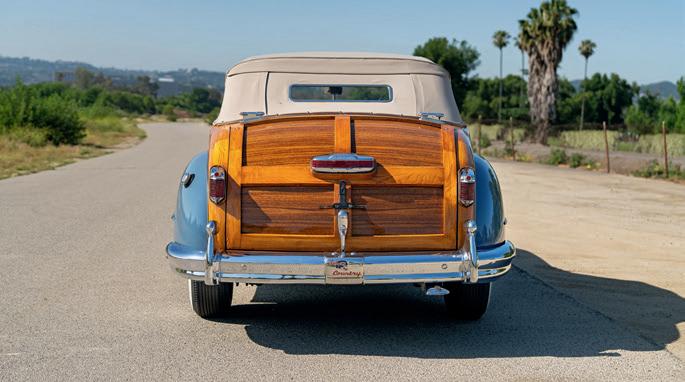

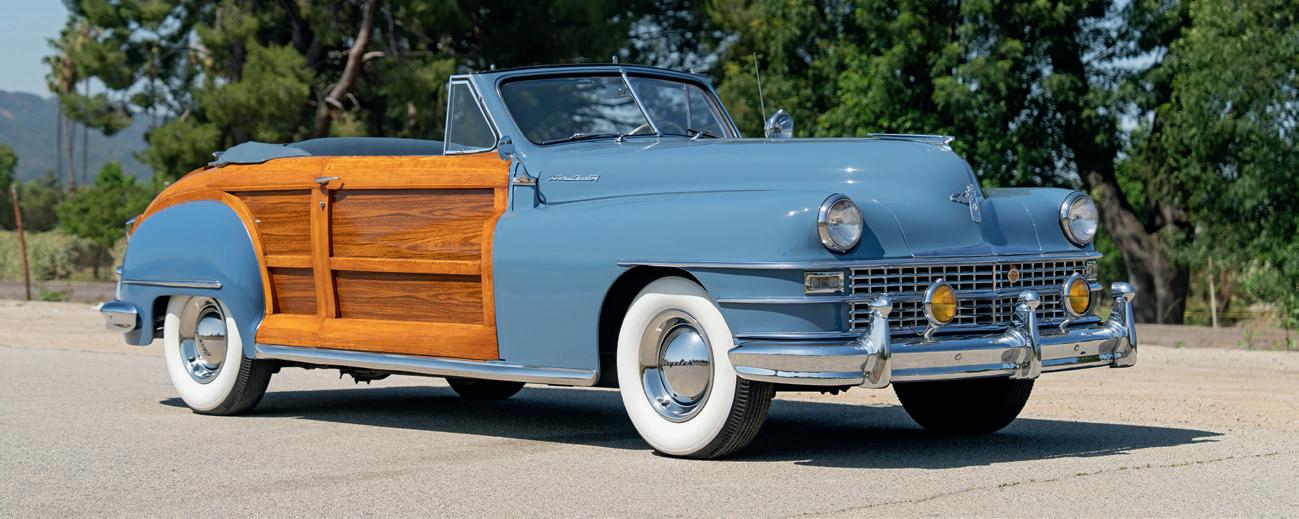

CHASSIS NO. 1451
ENGINE NO. 1451
$1,250,000–$2,000,000
One hundred and twenty-seven years ago, this Panhard-Levassor lined up to compete at the latest of the arduous tests for the incubatory automobile industry: the city-to-city races. This particular race – from Paris to Amsterdam and back – was the most ambitious.
The event was held over seven days, split into categories of racing, touring, and motorcycles, and the vehicles were to make a series of daily journeys or races.
The Panhard-Levassor journeyed from Paris to the Chateau d’Ardennes (294 km), then onto Nimegue (251 km), arriving in Amsterdam (112 km) on July 9th, where the fleet of racers rested for three days. For the return, they traversed to Liège (270 km), through Luxembourg to Verdun (260 km) and arrived back
A Genuine Factory “Course”-Specification Paris-Amsterdam Car
The Model That Debuted a Steering Wheel and Aluminum Engine and Gearbox Castings
Retains Original Coachwork and Supplemental Course/Racing-Style Body
Extensively Documented with Factory Records and History
A Proven London to Brighton Veteran Car Run Entrant and First Across the Finish Line Three Times
Veteran Car Club Dated and Entered for the 2025 London to Brighton Run
in Paris on Bastille Day (243 km). For the touring cars, a less arduous 11-day route was planned.
In eight short years, Panhard et Levassor had grown from building a handful of cars a year to supplying passenger and commercial vehicles, but its most innovative edge was in racing. After four years of experience in racing and tours, the company carefully honed a format which would become the industry standard – the Système Panhard.
The cars entered at the Paris-Amsterdam were specifically refined in a number of key respects. Firstly, they were immediately distinguishable from any that
2,143 CC Side-Valve Inline 4-Cylinder Engine
8 HP
Panhard-Levassor “Krebbs” Carburetor
4-Speed Manual Gearbox with Forward/Reverse Selector
Rear Mechanical Drum and Transmission Brakes
Front Solid Axle with Semi-Elliptical Leaf Springs
Rear Live Axle with Semi-Elliptical Leaf Springs


Panhard-Levassor Ex-Works (retained by factory for racing)
Louis Laveissière, Paris, France (acquired from the above in 1899)
Lucien Laveissière, Paris, France (acquired circa 1900)
Charles Maye, Poitiers, France (acquired in 1921)
Bernard de Lassée, Poitiers, France (acquired from the above in 1960)
Jean Claude de Lassée, Poitiers, France (acquired from the above in 1977)
M. Ferrand (acquired from the above circa 1989)
G. Moed, Netherlands (acquired from the above in 1990)
M. Timms, UK, (acquired from the above in 1995)
Current Owner (acquired from the above)
preceded them, for they debuted a steering wheel in place of the tiller steering, which was present even months earlier at the Paris-Dieppe. This was a logical innovation due to the ever-increasing performance of Panhard’s race cars and the need to manage turns at greater speeds. The steering wheel may not sound like groundbreaking technology today, but it was and it is a watershed moment in racing technology. Steering and roadholding were also improved by the use of Michelin pneumatic tires.
These Panhard race cars were all powered by the latest M4E-Phènix engines, their nominal 8 hp providing at least 40 mph performance on the road. In true racing fashion, both running gear and coachwork were lightened, with the normally bronze castings for crankcase and gearbox replaced by aluminum. The same was true of the skimpy two-seater bodywork, which took a variety of forms, but also utilized aluminum; contemporary reports state many of these were built by J. Rothschild et Fils.
These Panhard-Levassors dominated the city-to-city races entirely. The winning drive of the Paris-Amsterdam propelled Fernand Charron the 1,432 km in precisely 33.4 hours, or an average of 43kph over the course of six driving days. The Automotor and Horseless Vehicle Journal summarized: “It will be seen that the speeds attained were really very high, the highest being more than
twice that allowed by the British law.”
In March 1899, despite not having sold any four-cylinder racing cars in 1897 or 1898, Panhard et Levassor sold five cars with consecutive engine numbers: 1451, 1452, 1453, 1454, and 1455, as well as engine number 1516. These were likely the cars campaigned in the previous year. Of that batch of cars, this is the sole surviving example. Interestingly, if one analyzes the Panhard entries at the Paris-Amsterdam in summer 1898, no two were identical, and each had a variation in details: some with brass trim, others without, and each with distinct hood shapes, fender treatments, foot-steps, dashboards, and lamp mountings. When examined at this level of detail, and assuming the hoods were retained despite the possibility of later rebodying with passenger coachwork, the strongest correlation for 1451 is with the car owned by M. Adam and driven by the Comte Bozon de Perigord. However, this is likely a question that will never be definitively answered.
Later that summer, another Paris-Amsterdam-specification car (1617) was acquired by none other than Charles Rolls, who brought it to the UK and, undoubtedly impressed by the marque’s performance and superior engineering, quickly became a Panhard et Levassor agent before founding his eponymous company. That car, 1617, still resides in a British institution today.
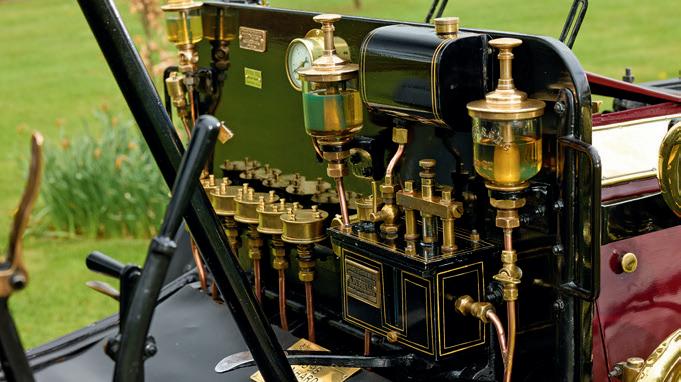



Musée de L’Automobile de la Sarthe (1961-1990s)
London to Brighton Veteran Car Run (1962, 1996, 1997, 1998)
Cartier Style et Luxe, Goodwood Festival of Speed, 2016
Windsor Castle Concours d’Elegance, 2016
One family that was keenly interested in this burgeoning scene was the Laveissière family of Paris. Their business was in metals, with a large factory located in Deville-les-Rouen, just north of Paris. Both Louis Laveissière and his brother were sponsors of the 1896 Paris-Marseille-Paris race, alongside other luminaries of the day such as J. Gordon Bennett, Baron van Zuylen, and the Comte de Dion.
Witnesses to Panhard’s development and racing, the Laveissières would likely have had an inside track with the company, and in March 1899, Louis Laveissière is recorded in the Panhard ledgers as the buyer of 1451.
Remarkably, while a former owner was conducting research in the Peugeot archives in the mid-1990s, a photo of 1451 was found, which was annotated “Paris-Amsterdam.” Interestingly, the design of the coachwork was termed “Americaine,” most likely referencing a type of carriage of the period, which was of particular lightweight construction and saw a format with a step-through front seat to a bench rear seat.
According to notes on the factory ledgers, very early on, Louis passed 1451 on to his brother Lucien, who was resident at Hotel Said, in Paris. As with many of its kind, 1451 was updated by the factory with the latest innovations and
upgrades available for their elite clientele. A recently discovered photograph shows 1451 in the form we see today, with its radiator repositioned at the front and a battery box on the side, suggesting it was fitted with new electric ignition, but still with its fully-elliptical rear leaf springs. The distinctive background of this photograph, featuring immaculate topiary in boxes, can be traced to the Laveissière-owned Chateau de la Folie at Draveil in southern Paris, where such trees lined the driveway. The photograph was taken between 1901 and 1903, and it appears to show Lucien looking on as the car is tested on the front drive of the Chateau.
We know few details of Lucien’s ownership, except for annotations to the works records. These note that the radiator was moved to the front of the car early on, and in August 1903, it received “metal brakes.” Below this is a note that it received a “Carb Auto,” the abbreviation for chief designer Krebbs’s more manageable ratchet “automatic” carburetor system.
Between 1959 and 1960, noted collector Bernard de Lassée applied to the Federation Nationale des Clubs Automobiles de France “Les Teuf Teuf,” listing 1451 among other cars that he owned, and noting its license plate as “387AT86.”
This license plate can be traced to former owner Charles Maye of Poitiers, and, more interestingly, the 1954-issued plate appears to be an update of the
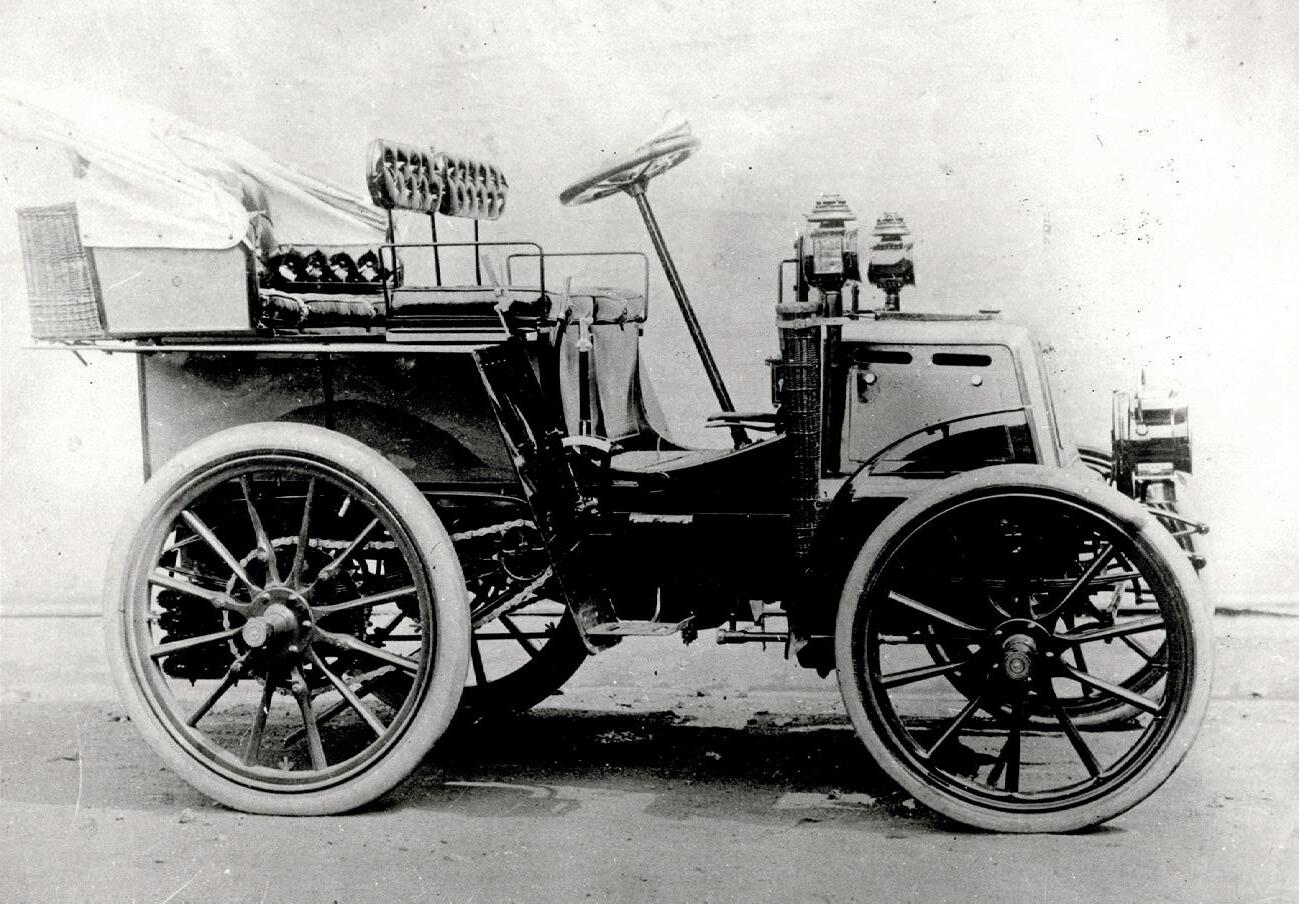

Automobile Magazine, August 2024
Panhard: La Doyenne d’Avant Garde, by Benoit Pérot
number rather than owner. The prior license plate, “1B1334,” was another Poitiers region plate, first assigned in April 1921, around the time Mr. Maye acquired 1451. Mr. Maye’s flamboyant “Ch. Maye Fils” letterhead of 1916 describes his business as being a specialist in art for building and an entrepreneur, while his father’s business specialized in petrol and gas engines. It is likely that by 1921 the Panhard was quite a curiosity to them.
Bernard de Lassée’s collection was the basis for the original Musée de L’Automobile de la Sarthe, which celebrated the history of the motorcar at the Le Mans circuit. On June 11, 1961, at the opening of the Le Mans Museum, 1451 still wore the physical Poitiers license plate “1B1334,” supporting the fact that Mr. Maye had been the owner since 1921. It also retained its lightweight bodywork and metal fenders. However, within the n ext year it appears to have been restored, and the fenders replaced with wood. A small circular motif, which is visible on the side of the rear seat in the ex-works photograph, was still present at that time, but appears to have been lost in a repaint that same year. Additionally, its rear wheels had been cut down to match the front ones, which was normal for most Panhards from 1902 onward.
Bernard de Lassée sold both 1451 and his 1912 S.P.A. Torpedo to his son Jean-Claude in 1977. According to a copy of an invoice on file, 1451 was listed
as Paris-Amsterdam, predating any access to the resources of the Panhard ledgers. Chassis 1451 remained on display as the collection moved in part to Châtellerault into the late 1980s. When that was dispersed, 1451 passed briefly to M. Ferrand, and then to G. Moed of the Netherlands.
Mike Timms of the UK, a noted collector of early motorcars, was in the process of building a formidable stable of “London to Brighton” cars in the 1990s, and purchased 1451 for his collection in 1995. Mr. Timm’s acquisition of 1451, combined with advice he received at the time, led him to dive deeply into the car’s history – and indeed the history of all racing cars of 1451’s era. Fueled by this curiosity, Mr. Timms submitted an application to the Veteran Car Club (VCC) of Great Britain for confirmation of 1451’s age. The resulting in-depth report allowed the VCC to conclude that 1451 was an ex-works racer, sold post-career, and that it was likely built in 1898.
Mr. Timms then embarked on a thorough restoration of 1451. In the course of this restoration, it became evident that at some point the car had been updated beyond just its carburetor. The wooden rectangle of its flitch-plated frame had been replaced with C-section metal longerons, and the rear springs had been converted from fully elliptical to semi-elliptical springs. Though the precise timing of those updates remains unknown, it is possible that they date
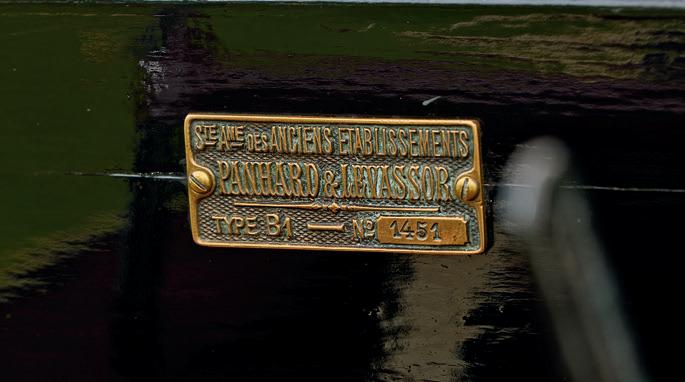

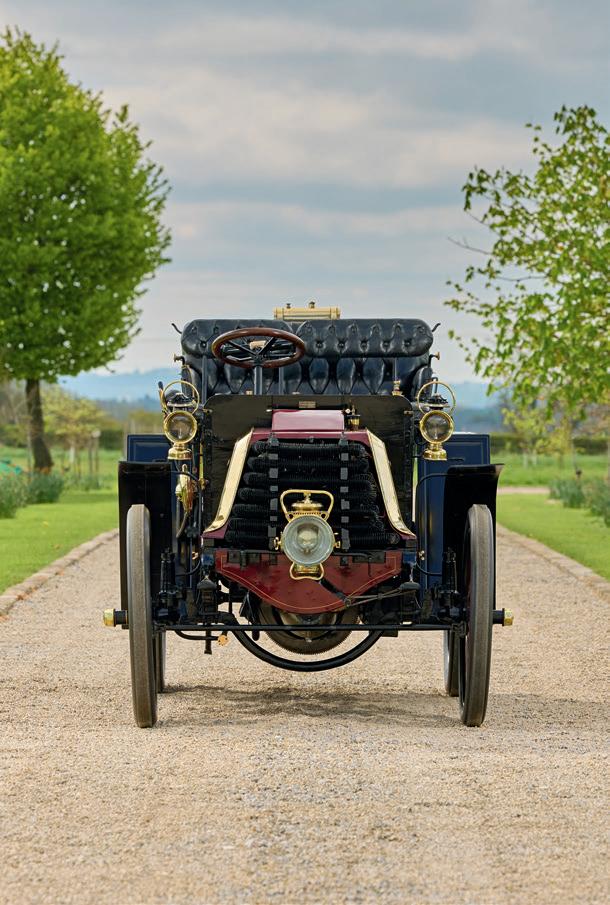


back to 1451’s earliest days, particularly given the Laveissière’s involvement in the metals business.
On completion of its restoration, 1451 ran successfully on the centennial London to Brighton Veteran Car Run in 1996. By merit of its performance and advanced mechanical specification, it quickly bypassed the more pedestrian early machinery and was first across the line not only that year, but the next two years as well.
Later in Mr. Timms’s 30-year ownership, a “Course”-type body was built for 1451, moving the rear-seat portion of the body forward to serve as the main seating. In that guise, 1451 was displayed around the UK and Europe. While undeniably sporting in this form, the majority of early touring events are sociable affairs, and 1451 was later returned to its original and current form as an Americaine four-person seater. This 19th century Course Type Paris-Amsterdam racer is both incredibly important and a testament to Panhard’s foresight in making automobiles practical by design. Chassis 1451 remains eminently usable today, further enhanced by the addition of a modern starter motor.
Never before shown or toured in the US, 1451 offers its next custodian the opportunity to do so – in addition to potentially serving as the opening statement in any major collection, few of which can claim 19th century origins, true racing specification, and the chance to experience Victorian-era motoring.
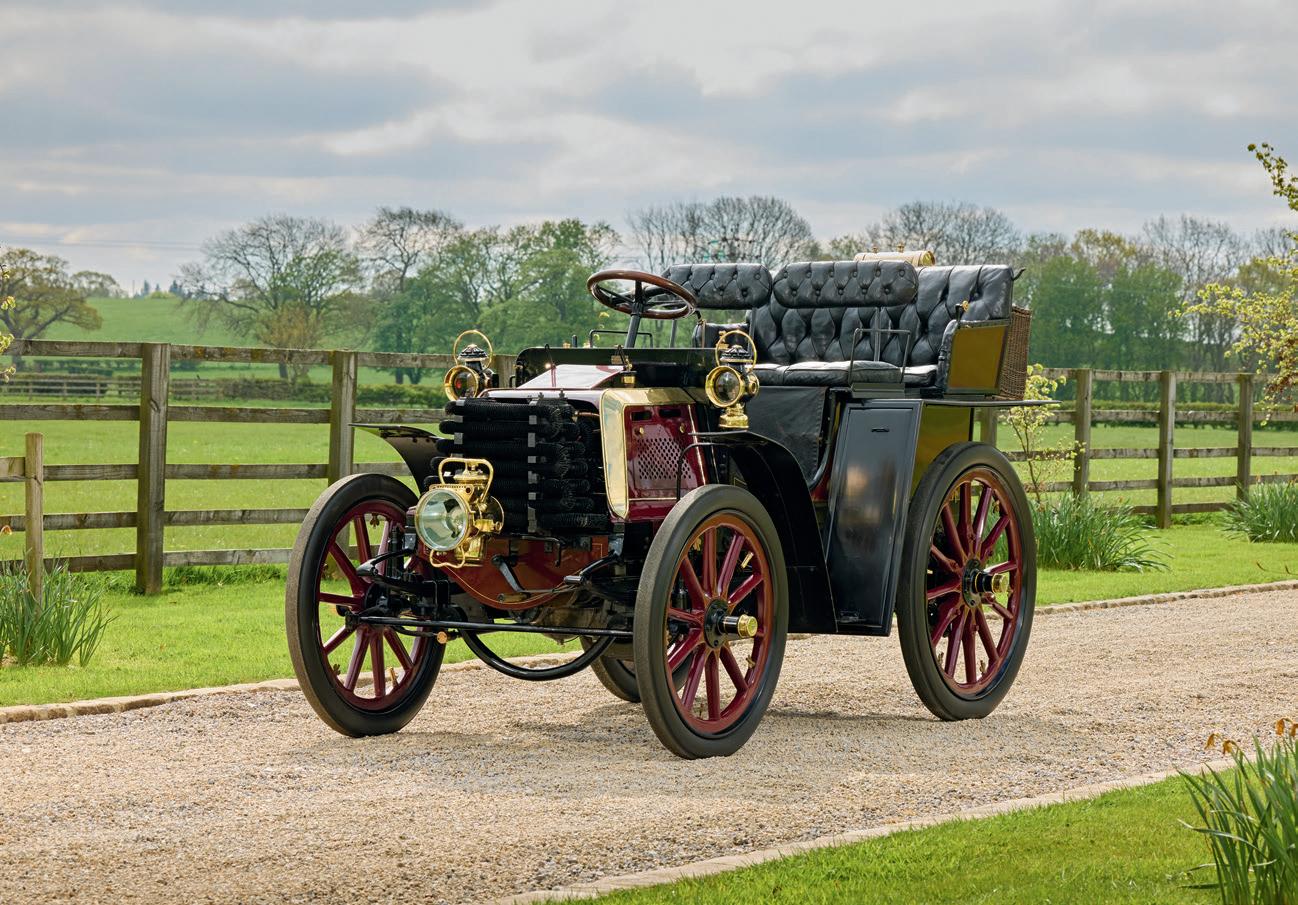

COACHWORK BY PININ FARINA
CHASSIS NO. 915829
ENGINE NO. 928142
$300,000–$400,000 without reserve
Introduced in 1938, but built well into the postwar era, the 6C 2500 represents Alfa Romeo’s final evolution of its classic coachbuilt straight-six sports cars – a lineage that began with the exotic and groundbreaking 6C 1500 of 1927. Among the most artfully engineered and successful racing and sports automobiles of all time, those early Alfa Romeos stood shoulder-to-shoulder with Ettore-era Bugattis and Hispano-Suizas – exquisite mechanical gems intended for glamorous international clientele. The tradition of excellence continued postwar, as exemplified by this lovely 6C 2500 Super Sport Cabriolet, chassis 915829.
Clothed in a variety of elegant coachbuilt bodies by esteemed carrozzerie, the 6C 2500 was perhaps most beautiful in Pinin Farina’s graceful coupe and cabriolet
HIGHLIGHTS
The Ultimate Expression of Coachbuilt Alfa Romeo Elegance Benefits from a Photo-Documented, Bare-Metal Restoration Retains Its Matching-Numbers Engine per its Alfa Romeo Certificate of Origin
Documented with Restoration Photos and FIVA Identity Card
Best of Show Finalist at the 2022 AutoClásica in Buenos Aires
designs. These shapes reflected both classic Italian lines and the burgeoning ethos of early European Modernism. The resulting forms, rich with flowing organic lines tempered by a studied restraint of ornament, rank among the most memorable and visually stunning automobiles ever crafted – the apogee of coachbuilt grandeur. Beneath hand-beaten panels lay mechanical sophistication: dual overhead camshafts, hemispherical combustion chambers, and fully independent suspension. Super Sport versions added further distinction with three Weber carburetors, higher compression ratios, and other enhancements aimed at extracting greater performance from an already superlative platform.
According to the research of Alfa Romeo historian Angelo Tito Anselmi, this
SPECIFICATIONS
2,443 CC DOHC Inline 6-Cylinder Engine
Three Weber 36 DO2 Carburetors
110 BHP at 4,800 RPM
4-Speed Manual Gearbox
4-Wheel Hydraulic Drum Brakes
Front Independent Suspension with Coil Springs
Rear Swing-Axle Suspension with Torsion Bars and Trailing Arms


Ferruccio Guidi, Montevideo, Uruguay (acquired new in 1949)
Tulio Tartaglia, Uruguay
Current Owner

AutoClásica, Argentina, 2022 (Best of Show Finalist)
6C 2500 was first sold on December 30, 1949, to Ferruccio Guidi of Montevideo, Uruguay. Much later, it was reportedly owned by Tulio Tartaglia, still in the same country. Chassis 915829 remained in Uruguay for many decades before eventually traveling west into Argentina, where it underwent a bare-metal, photo-documented restoration by a select group of highly regarded local specialists, beginning in 2014. The results speak for themselves: gorgeous black paintwork, gleaming brightwork, and a richly textured cabin adorned with leather, metal, and Bakelite switchgear. This Alfa Romeo is documented with a FIVA Identity Card, an Alfa Romeo Certificate of Origin, and was a Best of Show finalist at the 2022 AutoClásica in Buenos Aires.
One of just 383 examples of the 6C 2500 SS built, 915829 represents not only a rare opportunity to acquire one of the marque’s most evocative open cars, but it has been brought back to the road with the time and energy befitting its historical and aesthetic importance. Given its year of manufacture, this 6C 2500 is eligible for myriad vintage driving events and has not been exhibited in the US or Europe, giving the new owner the exciting chance to debut it at local events or at a variety of concours d’elegance.
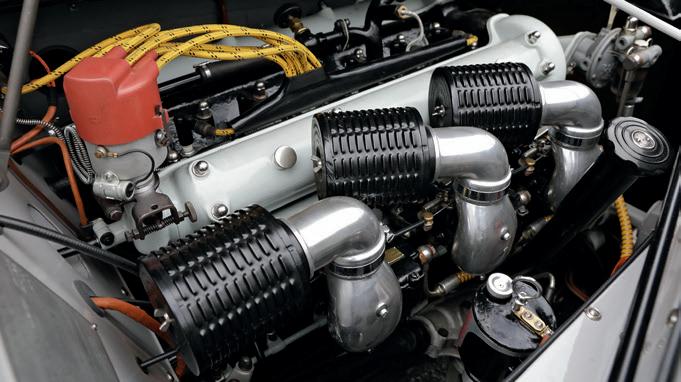
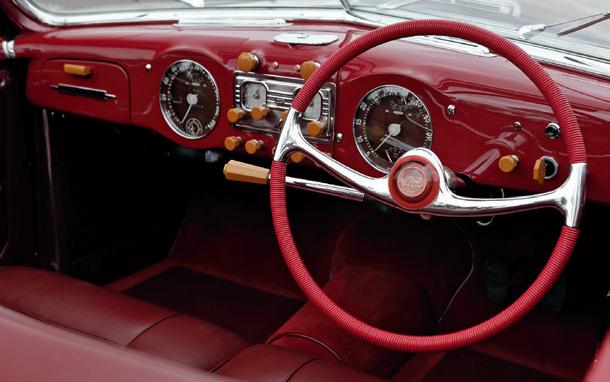
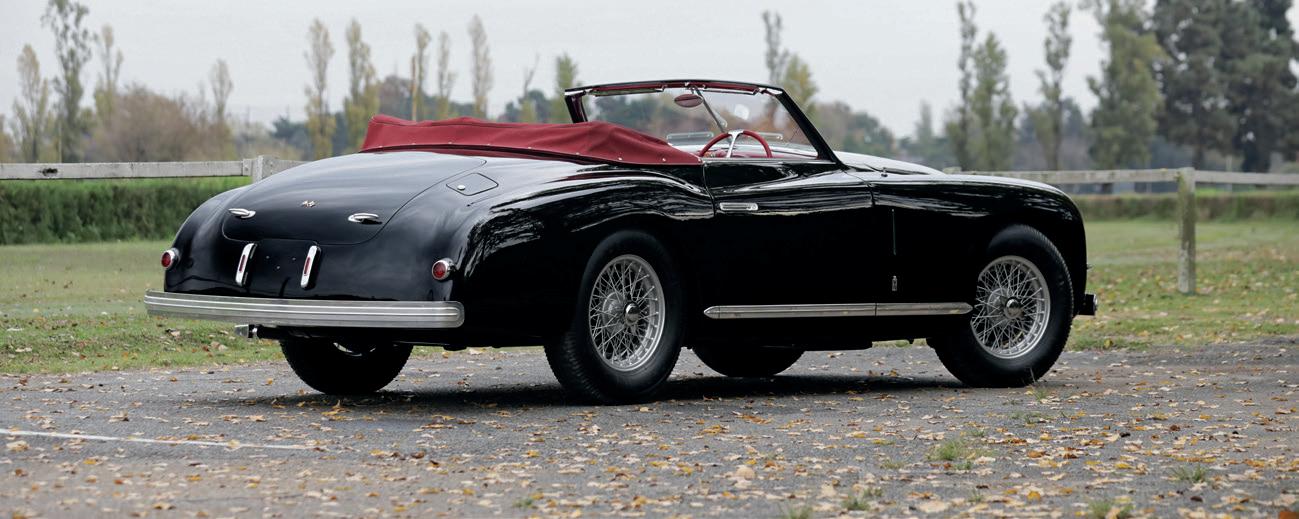
CHASSIS NO. DB4GT/0154/L
ENGINE NO. 370/0159/GT
$2,500,000–$3,000,000
Launched at the 1958 Paris Motor Show, the DB4 ushered in an exciting new era for Aston Martin. It would also serve as the basis for the competition-oriented DB4 GT, developed under racing manager John Wyer to create a GT-class customer car capable of defeating Ferrari’s 250 GT Tour de France. Based on the DP199 prototype – victorious in its debut at Silverstone with Stirling Moss – the production DB4 GT premiered at the London Motor Show in 1959, the same year as Aston Martin’s legendary 1-2 finish at Le Mans and its World Sportscar Championship title.
The DB4 GT was shorter, lighter, and more powerful than the standard DB4. It featured thinner 18-gauge aluminum-alloy body panels, a wheelbase shortened
One of Only 75 DB4 GTs Built; Just 30 in Left-Hand Drive
Delivered New to Famed Race Team Owner Georges Filipinetti
Raced in Period and Retained by One Swiss Owner from 1962 to 2010
Original Goodwood Green Livery; Matching-Numbers Engine per Factory Records
Meticulously Maintained Since Completing an Extensive Restoration
Offered with Original Instruction Book, Event Plaques, and Copy of Build Sheets
*Please note that this vehicle is titled as 0154L.
by nearly five inches, and, in most cases, the removal of rear seats – contributing to a 200-pound weight reduction.
Its Tadek Marek-designed 3.7-liter aluminum-block DOHC engine featured twin-plug ignition, a higher 9:1 compression ratio, and three Weber 45 DCOE carburetors. Factory-rated at 302 hp at 6,000 rpm, the DB4 GT delivered impressive performance. Girling four-wheel disc brakes with a dual-circuit system – shared with Aston Martin’s Works sports racers – ensured stopping power to match.
Visually, the DB4 GT was distinguished by its Perspex-covered headlamps,
3,670 CC Alloy DOHC Inline 6-Cylinder Engine
Three Weber 45 DCOE Twin-Choke Carburetors
302 BHP at 6,000 RPM
4-Speed Manual Gearbox
4-Wheel Girling Disc Brakes
Front Independent Suspension with Coil Springs and Anti-Roll Bar
Rear Live Axle with Watts Linkage and Coil Springs


Georges Filipinetti, Geneva, Switzerland (acquired new via Patthey Garage in 1961)
Dr. Gwen E. Reichen, La Chaux-de-Fonds, Switzerland (acquired from the above in 1962)
Constantin von Dziembowski, Starnberg, Germany (acquired in 2010)
Private Collection, Florida (acquired from the above in 2016)
Current Owner (acquired from the above)
lightweight rear and quarter windows, frameless side glass, and deleted bumper overriders. Twin quick-release fuel fillers, an extended-range fuel tank, and alloyrimmed Borrani wire wheels completed its competition-focused specification. And yet, in typical Aston Martin fashion, the cockpit was handsomely appointed with Wilton wool carpeting and Connolly leather covered the lightweight seats.
Raced from 1959 by both the Aston Martin Works team and John Ogier’s Essex Racing Stable, DB4 GTs were driven by many of the era’s greatest talents – including Stirling Moss, Roy Salvadori, Jim Clark, and Innes Ireland. In a telling episode at the 1959 Bahamas Speed Week, when Moss’s intended car failed to arrive, a freshly delivered DB4 GT was “borrowed” from a customer and driven to victory by the champion.
As Aston Martin’s answer to the Ferrari 250 GT Tour de France, the DB4 GT would soon face a new rival in the 250 GT SWB – an arms race that continued with the introduction of the DB4 GT Zagato and ultimately the Ferrari 250 GTO. Aston Martin built just 75 DB4 GTs between 1959 and 1962, plus 20 Zagato-bodied examples and a single Bertone-bodied special. Of the 75 standard cars, 45 were built in right-hand drive and 30 in left-hand drive for export.
This car, chassis DB4GT/0154/L, is one of those rare left-hand-drive examples, and
it boasts exceptional provenance. Delivered new to one of the most influential figures in European motor sports, it went on to enjoy a rich history in racing, rallying, and hill climbs under long-term Swiss ownership.
According to factory records, 0154/L was completed in June 1961, finished in the elegant color scheme of Goodwood Green over Red Connolly leather. The build sheet notes Dunlop RS5 tires, a 3.54:1 rear axle, and a Powr-Lok limited-slip differential. The car was shipped to Garage Hubert Patthey in Neuchâtel, Switzerland, and delivered new to Georges Filipinetti.
Based in Geneva, Filipinetti was a towering figure in mid-century motor sports, best known for founding Scuderia Filipinetti in 1961. His team became one of the most successful privateer operations in Europe, competing at Le Mans, Spa, Sebring, and even in Formula 1. He supported top Swiss talent – including Jo Siffert, Herbert Müller, Heinz Schiller, Dieter Spoerry, and Rico Steinemann – and was known for always fielding the most competitive cars.
Filipinetti retained the DB4 GT through the end of 1961, driving it approximately 3,800 km before trading it back to Garage Patthey. In February 1962, it was sold to its second owner, Dr. Gwen E. Reichen of La Chaux-de-Fonds. Soon after acquisition, Dr. Reichen sent the Aston Martin to Newport Pagnell, where it
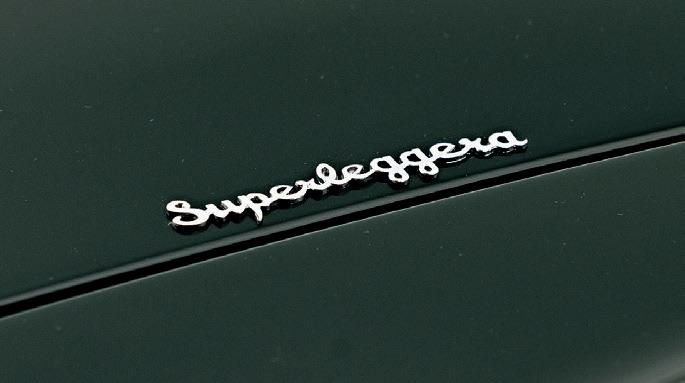
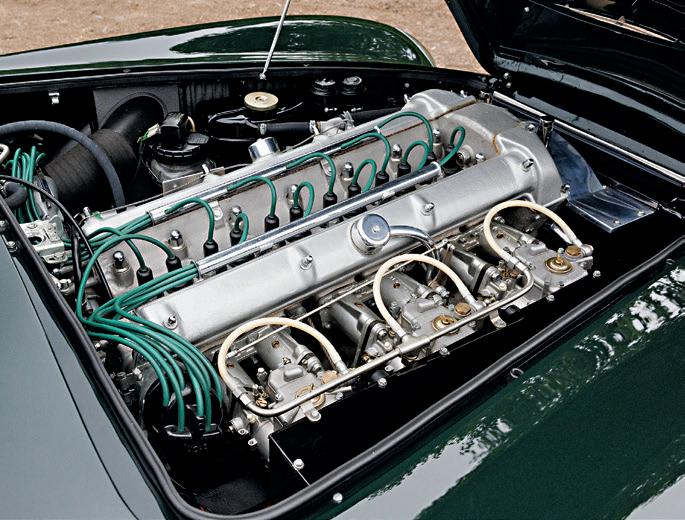


Dübendorf Slalom, 1963, Reichen, No. 102
St. Ursanne Hill Climb, 1964, Reichen, No. 101 (1st Overall)
Mitholz-Kandersteg Hill Climb, 1964, Reichen
Rallye International de Genève, 1964, Reichen/Vouga (DNF)
The Aston Martin DB4 GT, by Stephen Archer and Richard A. Candee

was prepared for competition with shorter gearing and a Bosch brake servo.
By year’s end, 0154/L had accrued an additional 10,000 km through road and competition use. According to various sources, the DB4 GT was entered in multiple hill climbs – including St. Ursanne-Les Rangiers, Mitholz-Kandersteg, and Rochefort-La Tourney – as well as slaloms at Dübendorf and Payerne. Several period photographs of the car in action are featured in The Aston Martin DB4GT by Stephen Archer and Richard A. Candee.
Throughout the 1960s, Dr. Reichen was a regular competitor in the European Rally Championship with various cars. In October 1964, he and co-driver Michelle Vouga entered the DB4 GT in the Swiss round of the ERC, the Rallye de Genève, organized by the Automobile Club de Suisse. Period coverage reports that the Aston Martin was involved in an accident during the multi-day event, prompting a replacement front body section to be ordered from the factory. In November, Garage Patthey repaired the car, repainted it blue, and fitted upgraded valve springs sourced from Oskar Ruegg of Pfäffikon – a noted spring maker and DB4 GT owner himself.
Dr. Reichen retained the car into the 1990s, regularly driving it for over three decades. By that time, the odometer showed nearly 100,000 km. During this
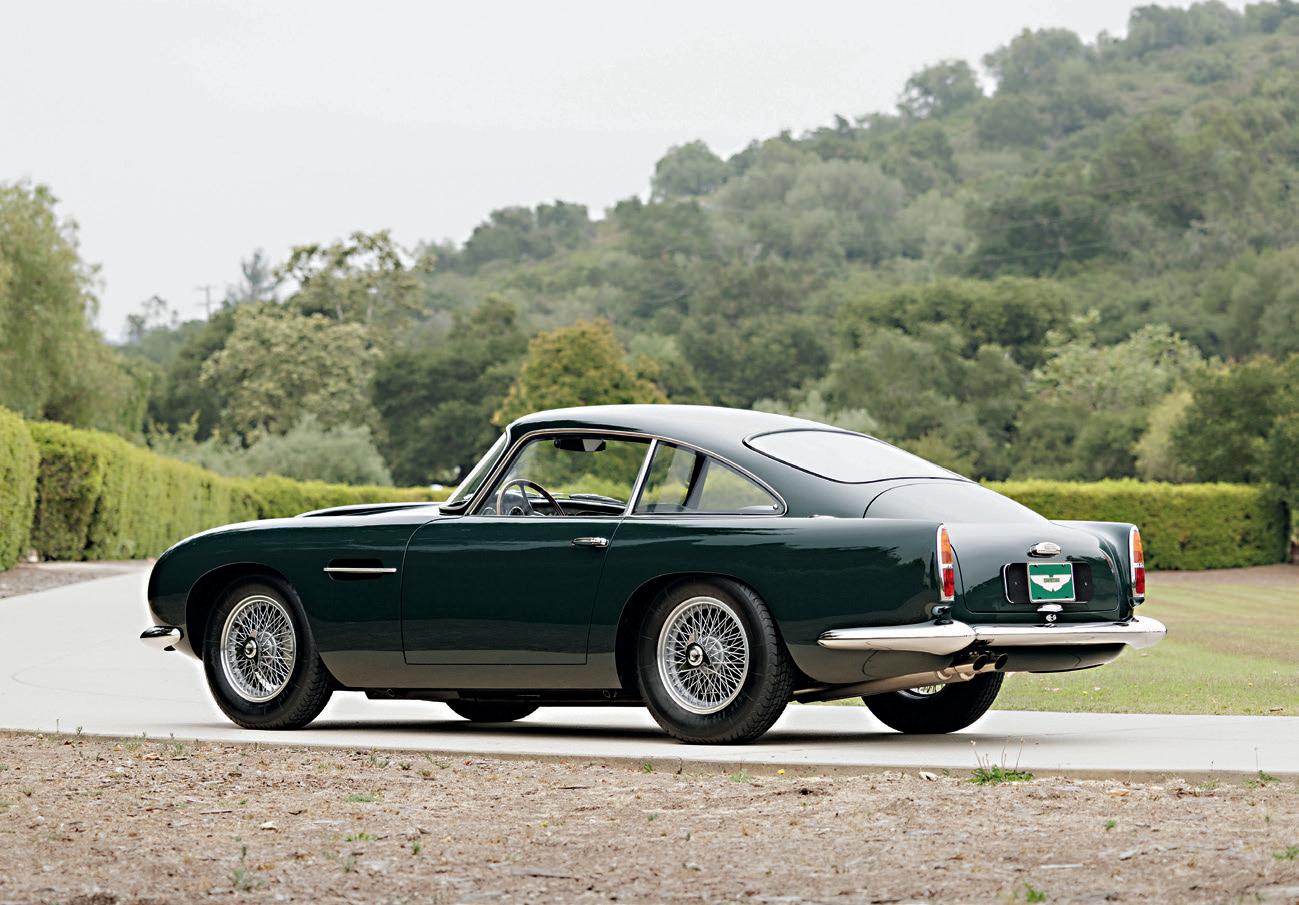


period, respected Swiss specialist Roos Engineering overhauled the engine, gearbox, and rear axle. In the early 2000s, Garage Eyra of Le Locle carried out additional restoration work, returning the car to its original road-going specification.
In 2010, 0154/L was displayed at Rétromobile and sold via Gregor Fisken to Constantin von Dziembowski. The car was sent to the UK and treated to a sympathetic restoration by Marksdanes Restorations Ltd. around 2012. Since 2016, the Aston Martin has been kept in two significant American collections and benefits from meticulous care and maintenance.
Today, 0154/L presents as the quintessential gentleman’s GT, finished in striking Goodwood Green over green leather. It retains its matching-numbers engine and is accompanied by an original DB4 GT instruction manual, period event plaques from Dr. Reichen’s racing years, recent service records, and a copy of the factory build sheet.
One of only 29 surviving factory left-hand-drive DB4 GTs, with superb provenance, documented competition history, and a well-documented chain of ownership, 0154/L is a DB4 GT of extraordinary pedigree and appeal. These purpose-built machines represent the pinnacle of the DB4 series and rank
among the most coveted dual-purpose GTs of the era, alongside Ferrari’s 250 GT SWB Berlinetta and Jaguar’s Lightweight E-Type.
Offered here is a rare opportunity to acquire a truly significant Aston Martin –delivered new to a motor sports legend, raced in period, and preserved through six decades with care and distinction. It is a car worthy of any collection and an ideal entry to the world’s most exclusive historic events.


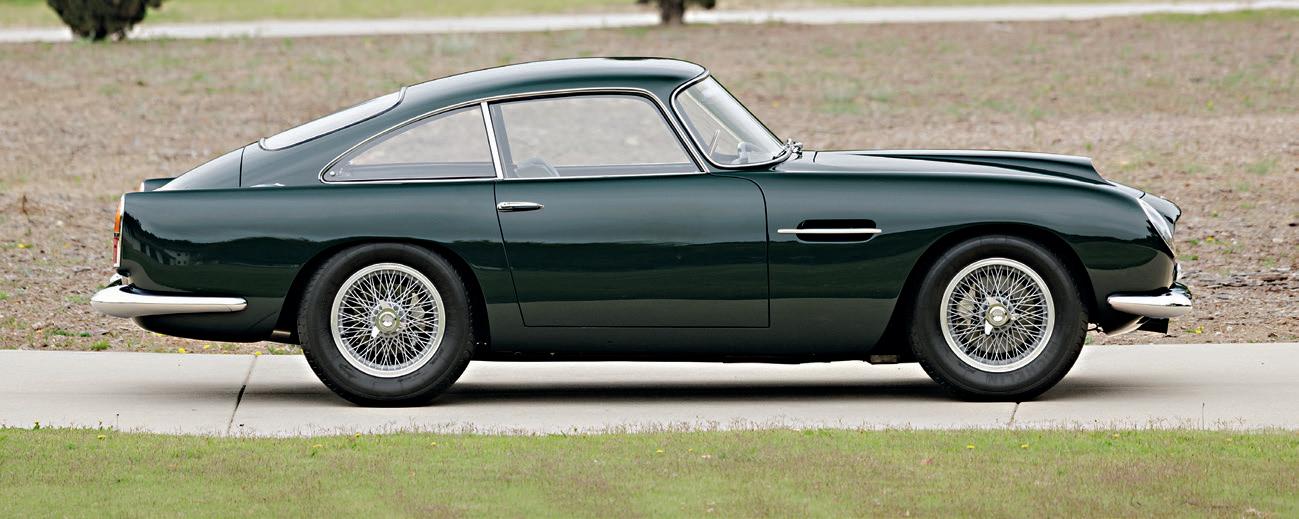

Born in Quebec, Canada, on May 6, 1947, Brian Pollock developed a passion for automobiles early in life – a passion that would define and enrich his entire journey.
A graduate in mechanical engineering, Mr. Pollock began his career in Montreal’s aeronautical industry before moving into electronics, eventually settling with his family on Mercer Island, Washington, where he spent the past four decades. His technical expertise and exacting standards have shaped every aspect of his automotive pursuits.
Mr. Pollock’s garage told the story of a life committed to excellence. He owned and cared for a remarkable variety of cars, performing much of the work himself and overseeing several meticulous restorations. Authenticity mattered deeply to him, and he strived to return each car to its correct and original condition. Some vehicles became lifelong companions: the L-Series Ferrari Dino he purchased new at the Ferrari factory during his honeymoon, and the Bugatti Type 57 acquired from the family of its original owner. These were cars that he cherished and kept for decades.
Mr. Pollock’s enthusiasm extended far beyond the garage. He was a regular participant in vintage rallies, often accompanied by his beloved wife, Randy, sharing the road and the camaraderie of fellow enthusiasts. His knowledge and eye for detail earned him a coveted role as a class judge at the Pebble Beach Concours d’Elegance®, a position he held with distinction for over 30 years. His own cars, including the Dino, Bugatti, and Morgan, all earned First in Class honors on the Pebble Beach lawn – a true testament to his dedication.
Gooding Christie’s is honored to present four exceptional motor cars from the Brian Pollock Collection at Pebble Beach – an event and setting that held special meaning for a man who gave so much to the world of collector cars.
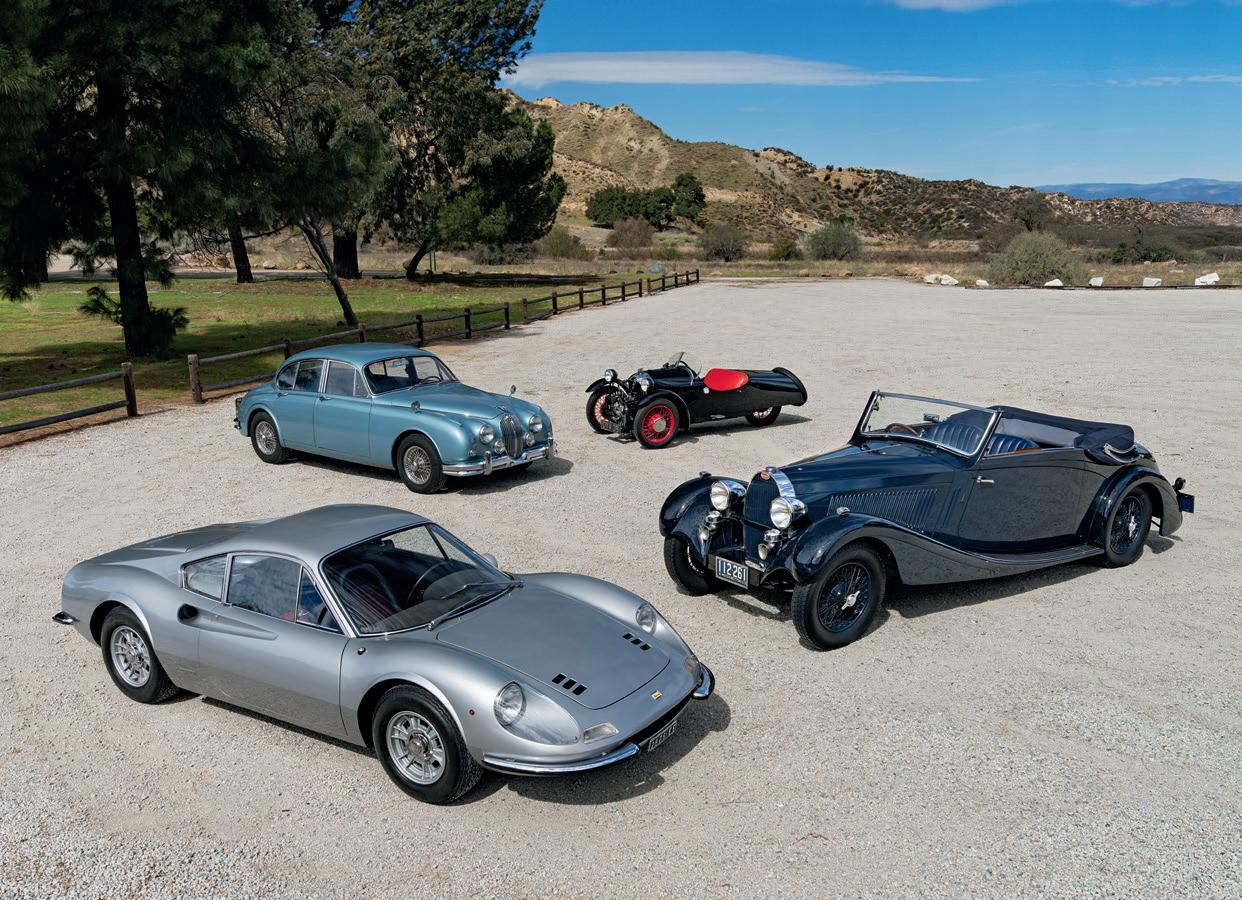
CHASSIS NO. D1777
ENGINE NO. MX1164
$60,000–$80,000 without reserve
From its 1909 inception, Morgan Motor Company produced three-wheeled cars, and it was not until 1936 that they introduced their first four-wheeled model. Morgan trikes offered a combination of low weight, high performance, and economical running, which made them successful, both commercially and in competition. Initially powered by V-twin motorcycle engines, three-wheeled Morgans became available with Ford four-cylinders with the 1932 introduction of the F-series, which supplemented the existing V-twins. When postwar production resumed, only four-cylinder trikes were offered, which survived until 1952, marking the end of three-wheeled Morgans until their 2011 reintroduction.
This 1937 Sports Two-Seater Barrelback, therefore, comes from the final years of V-twin production. It has exceptional integrity, retaining its original water-cooled, side-valve Matchless MX engine, as well as original gearbox, chassis, and body. Originally supplied to the London dealer Maskell with registration no. DYV 38, this car was imported from the UK in 1976 and acquired in 1984 by Mr. Pollock. He drove it regularly for many years before embarking on an exacting restoration in its original color scheme. The restoration was completed in time for the car to debut at the 2009 Pebble Beach Concours d’Elegance®, where it won its class: A Century of Morgan Motor Cars. The combination of this Morgan’s integrity and the quality of its restoration distinguish it as one of the finest examples in existence of this defining model, which put Morgan on the map.
HIGHLIGHTS
Among the Last Matchless Side-Valve Morgans Built Comprehensively and Correctly Restored in Its Original Color Combination
Exceptional Integrity, Retaining its Original Engine, Gearbox, Chassis, and Body
Awarded First in Class at the 2009 Pebble Beach Concours d’Elegance®
Extensively Documented with Build Records, FIVA Identity Card, Brochures, Literature, and Correspondence
990 CC Matchless MX Side-Valve V-Twin Engine
Single Sidedraft Carburetor
27.5 BHP at 4,000 RPM
3-Speed Manual Gearbox
3-Wheel Independently Operable Drum Brakes
Front Independent Suspension with Helical Springs
Rear Suspension with Two Quarter-Elliptic Springs
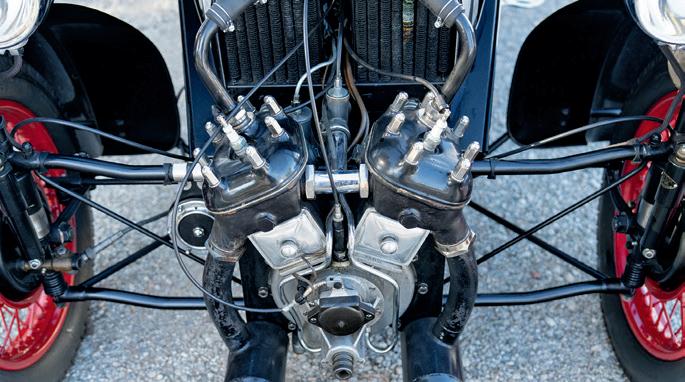



FROM THE BRIAN POLLOCK COLLECTION
COACHWORK BY SCAGLIETTI
CHASSIS NO. 00870
ENGINE NO. 135C0000005632/236
$500,000–$700,000
Of all the Dinos Ferrari produced, few possess the exceptional qualities of this early production 246 GT – a car that has been preserved, maintained, and cherished by its sole owner, Brian Pollock.
The story of this Dino begins in spring 1970, when newlyweds Brian and Randy Pollock were planning their honeymoon. Brian, an avid sports car enthusiast, suggested an adventurous idea: purchase a new Ferrari, collect it in Italy, and tour Europe. Brian contacted his local Ferrari dealer, George Woolley of Montreal, to place an order for a 246 GT, with plans to pick it up in Maranello that summer.
In June 1970, Woolley provided an update to Brian, confirming that a new
HIGHLIGHTS
Desirable, Early Production “L-Series” 246 GT; One of Only 355 Built
Offered from the Estate of Its First and Only Owner, Brian Pollock
Postwar Preservation Class Winner at Pebble Beach in 2018
Accompanied by Original Handbooks, Warranty Book, Tool Kit, Jack, and Literature
Extraordinary Documentation File Includes Records and Correspondence Dating to 1970
Unique Opportunity to Acquire One of the Finest Unrestored Dinos Extant
Dino would be available before the end of June, though the color was still unknown. Upon arrival at Ferrari’s Assistenza Clienti in Modena, the Pollocks were shown a silver 246 GT by sales manager Sig. Boni. When Brian asked about the possibility of buying a red car, Boni replied, “Your car is silver. If you want a red one, come back in three months.” After considering the options, Brian accepted the silver Dino – chassis 00870 – which had been completed that May, finished in elegant Argento Auteuil Metallizzato (Auteuil Silver Metallic) with black and red upholstery.
This 246 GT is one of the rare “L-Series” models, the original 246 GT variant, of which only 355 examples were built. These cars are highly sought after for
SPECIFICATIONS
2,419 CC Tipo 135C DOHC V-6 Engine
Three Weber 40 DCN F/7 Carburetors
195 BHP at 7,600 RPM
5-Speed Manual Transaxle
4-Wheel Girling Disc Brakes
Front and Rear Independent Suspension
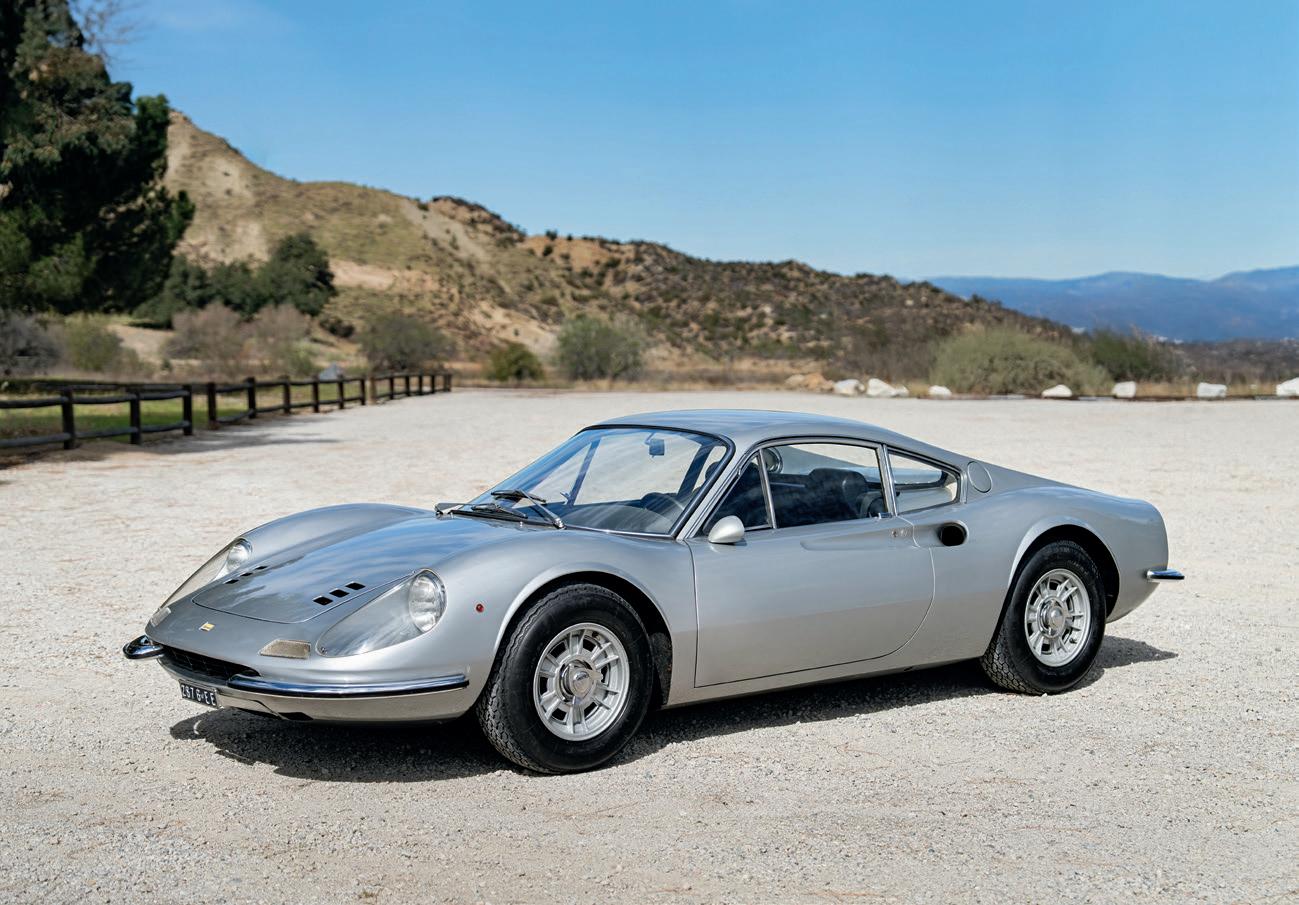

Brian Pollock (acquired new in 1970)
their limited production, purity of design, and unique details, which set them apart from later M- and E-Series Dinos. Notably, 00870 features lightweight aluminum doors, hood, and deck lid panels, central-locking Cromodora wheels with knock-off hubs, and several other distinguishing characteristics.
Before finalizing the purchase, Brian asked for a Voxson 8-track stereo and traditional Ferrari script to be installed, and arranged for a full tour of the factory. After taking delivery, the Pollocks drove the Dino through Italy, France, and Spain, before settling in London. While in England, Brian had Maranello Concessionaires – Ferrari’s official UK distributor – perform routine maintenance and repair a small dent in the nose, reportedly the only paint touch-up the car has ever received. Brian also had Plexiglas headlamp covers fitted and installed a Bulldog alarm system, purchased from Harrods.
In May 1971, before returning home aboard the RMS Empress of Canada, the Pollocks visited Ferrari again, collecting spare parts and touring the Scaglietti workshop.
The Dino was used as a daily driver for two years before being retired to weekend use. It has remained in the Pollocks’ collection ever since, always kept in good working order. Over the years, Brian occasionally entered the car in
FCA Annual Meet, Detroit, Michigan, 1973
FCA International Meet, Carmel-by-the-Sea, California, 2004 (Platinum Award, Ferrari Dino Award)
Kirkland Concours d’Elegance, Kirkland, Washington, 2013
FCA International Meet, Monterey, California, 2015 (FCA National Vintage Preservation Award, Platinum Award)
FCA Northwest Region Concours d’Elegance, Renton, Washington, 2016 (Best of Show, Platinum Award)
Pebble Beach Concours d’Elegance®, 2018 (First in Class)
concours events, starting with the 1973 FCA Annual Meet in Detroit, where it was displayed in the Contemporary GT class. In recent years, the 246 GT has garnered multiple accolades, including three Platinum Awards, the Ferrari Dino Award at the 2004 FCA International Meet, and the National Vintage Preservation Award at the 2015 FCA International Meet.
However, the car’s most impressive achievement came in 2018 at the Pebble Beach Concours d’Elegance®, where Brian served as a class judge for over three decades. That year, rather than trailering the Dino to the event, Brian drove it 1,500 miles from Seattle to Monterey as part of the Pebble Beach Motoring Classic. Upon arrival, the Dino participated in the Tour d’Elegance and won First in Class in the Postwar Preservation category – a fitting tribute to the car and its devoted owner.
This carefully preserved L-Series 246 GT still wears its original paint and upholstery. Thanks to regular service and use, the car has never required a mechanical rebuild. Given its time spent between Europe, Canada, and the US, it comes with two odometers – the original kph unit and the currently installed mph unit – which together record approximately 34,000 miles.
Consistent with its meticulous single-owner care, the Dino is supplied with
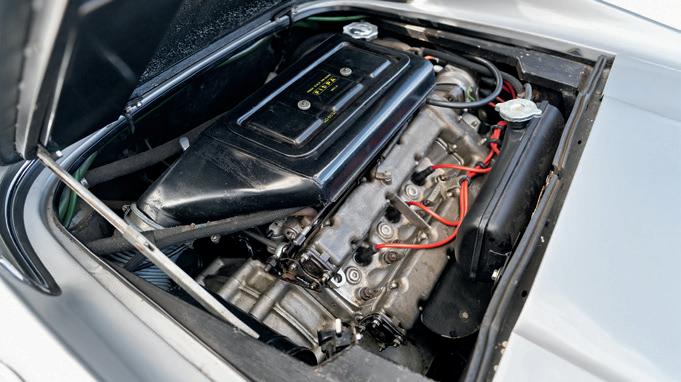

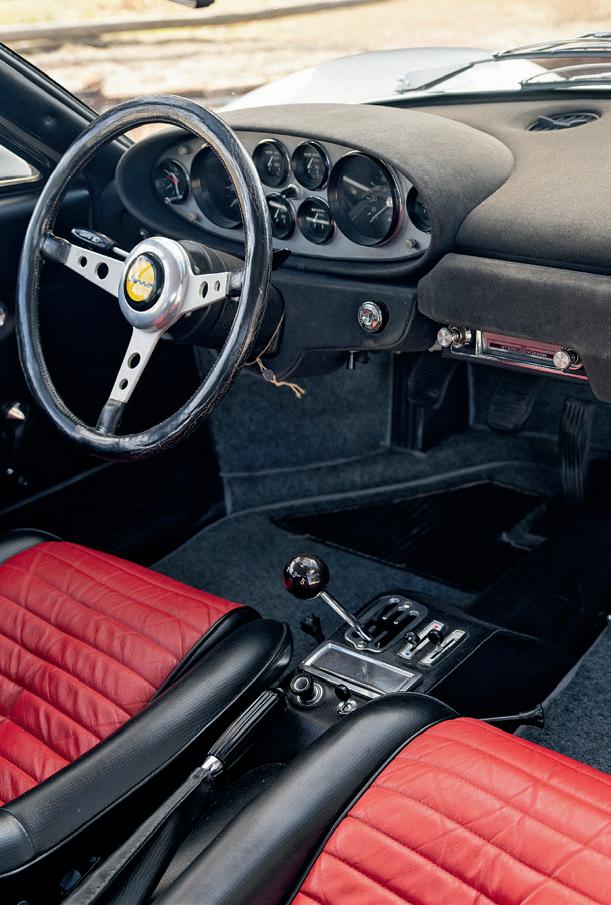

Dino Compendium, by Matthias Bartz Forza, January 2020, “Silver & Gold,” by Jay Gilotti

the original leather folio containing the owner’s manual, warranty card, dealer directory, and Voxson literature. It also includes the original keys, tool kit, jack, wheel chock, reflector, and tack cloth, as well as a factory spare parts catalog, technical instructions folio, workshop manual, and sales brochure.
The car’s remarkable provenance is documented with extensive records from 1970 onward. This includes original purchase documents, customs forms, insurance and registration papers, shipping records, Italian “EE” tourist plates and libretto, country code placards, and period photographs.
A superb and historically significant Ferrari, 00870 is a testament to Brian Pollock’s exceptional care and passion for automobiles. Gooding Christie’s is honored to pass this remarkable Dino 246 GT “L-Series” on to its second owner, who will be acquiring not just a car, but a cherished piece of automotive history.
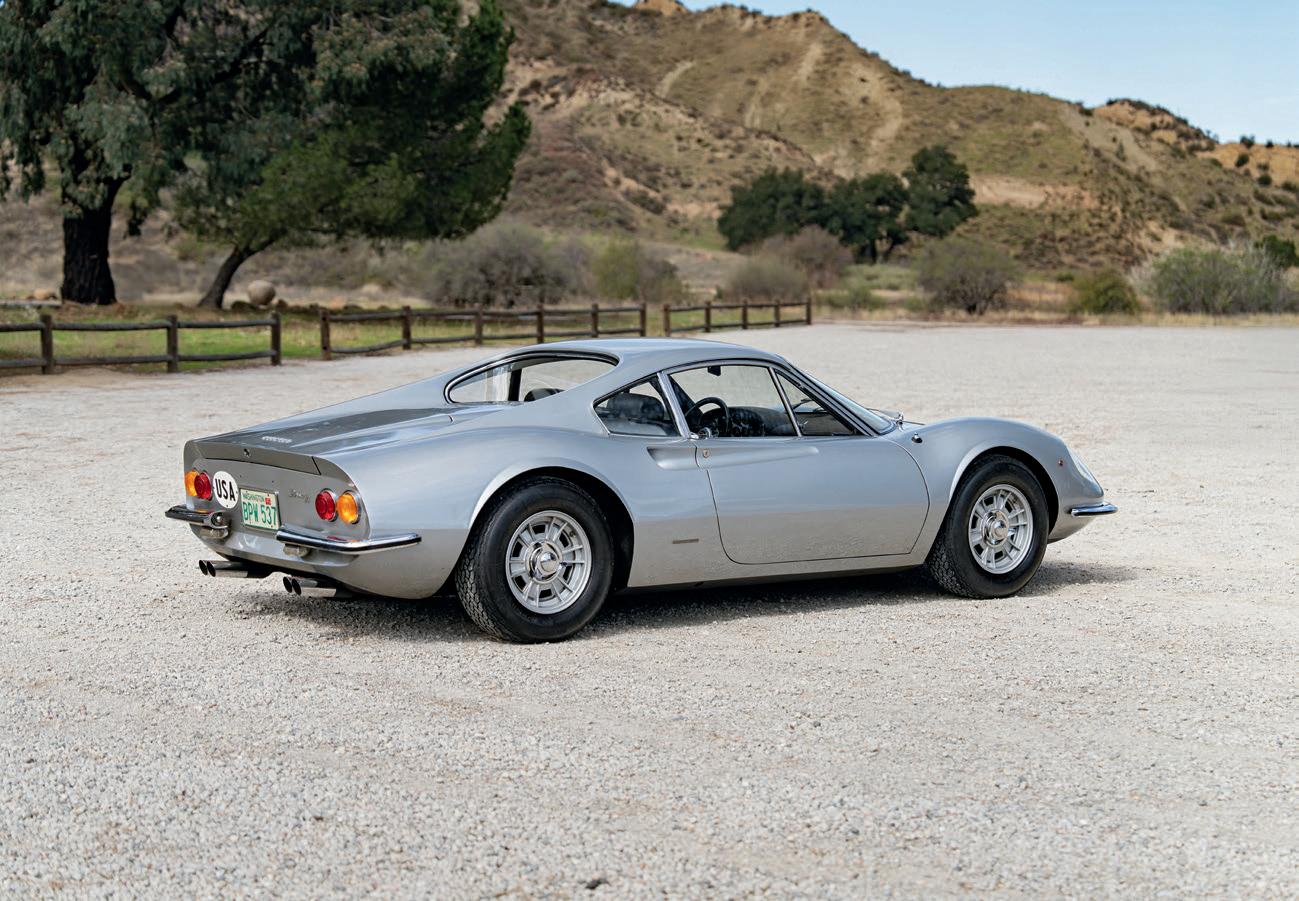
CHASSIS NO. 224252DN
ENGINE NO. LE2964-9
$35,000–$50,000 without reserve
Prior to the Mk I and its Mk II evolution, Jaguar had only offered two models: a two-seater sports car and a large sedan. Thus, the 1955 compact 2.4-litre Mk I represented a new category of Jaguar. Although it was smaller, it offered the traditional Jaguar qualities of grace, space, and pace thanks to its sophisticated – and Le Mans-winning – twin-cam XK engine.
As a newer design, it was more advanced than even the company’s sports cars, being Jaguar’s first unitary construction car and employing coil-spring rather than torsion-bar front suspension. The car was significantly improved over time, with the addition of disc brakes, 3.4- and 3.8-litre engines, and a substantial technical and cosmetic upgrade with the Mark II in 1959. The car’s performance and dimensions made it extremely successful in motor sports and it is arguably the world’s first sport sedan.
The Ultimate Specification Mk II: 9:1 Compression, 3.8-Litre Engine with Synchromesh Gearbox and Overdrive
Documented Two-Owner Car Acquired by Brian Pollock from the Original Owner’s Estate
Comprehensive Mechanical Restoration by John Maloney at Autosport Seattle Matching-Numbers Engine Block and Cylinder Head per JDHT Certificate Extensively Documented and Offered with Original Brochures, Manuals, and Jack
This 1966 Jaguar Mk II, featuring the 9:1 compression ratio, 3.8-litre engine and synchromesh gearbox with overdrive, represents the most desirable variant of the model. It is a highly-original, two-owner example acquired by Mr. Pollock from the original owner’s estate in 2006. He immediately set about performing a mechanical restoration over a two-year period, overseen by John Maloney at Autosport Seattle. This car’s extensive documentation, configuration, originality, provenance, and presentation distinguish it as an ideal example for the discerning buyer.
SPECIFICATIONS
3,781 CC DOHC Inline 6-Cylinder Engine
Twin SU HD6 Carburetors
220 BHP at 5,500 RPM
4-Speed Manual Gearbox with Laycock de Normanville Overdrive
4-Wheel Dunlop Disc Brakes
Front Independent Suspension with Wishbones, Coil Springs, and Telescopic Dampers
Rear Live Axle with Semi-Elliptical Leaf Springs and Telescopic Dampers
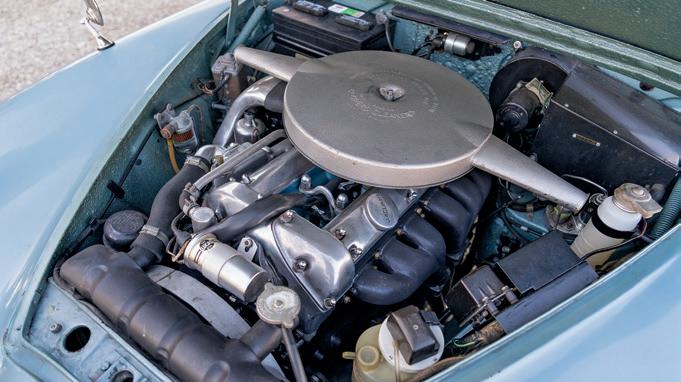

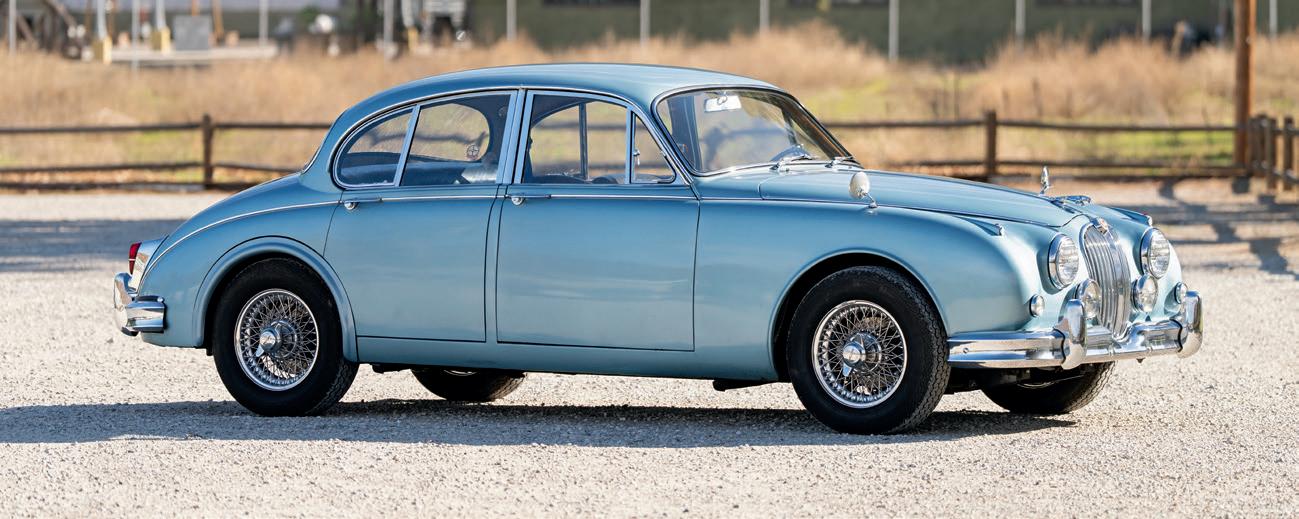

FROM THE BRIAN POLLOCK COLLECTION
COACHWORK BY JAMES YOUNG
CHASSIS NO. 57236
ENGINE NO. 136
$400,000–$550,000
By almost any measure, the Type 57 series of luxury touring and sports cars was the final, truly great Bugatti from Molsheim. Spearheaded by Ettore Bugatti’s supremely talented 25-year-old son, Jean, with in-house designers
Antoine Pichetto and Noel Domboy, it was one of Bugatti’s most commercially successful models. It was offered with several factory coachwork options: the four-door saloon “Galibier,” the two-door coach “Ventoux,” and the drophead coupe “Stelvio,” as well as a few more limited models including the Atalante and Aravis. The Type 57 chassis was also available to outside coachbuilders on the European Continent as well as in England.
Rolling chassis 57236, with engine no. 136, was delivered to England on
HIGHLIGHTS
One of Only Two Known Type 57s Featuring James Young Drophead Coupe Coachwork
Just Two Owners from New; Retains Original Chassis, Engine, and Body
First in Class for Prewar European Classics at the 1984 Pebble Beach Concours d’Elegance®
Frequent Rally and Concours Participant Under Brian Pollock’s Ownership
Beautifully Preserved, 40-Year-Old Restoration in Elegant Colors
Accompanied by Extensive History File that Includes Restoration Photos and Bugatti Literature
December 7, 1934, along with its sister car, chassis 57235. It had been ordered by Colonel Sorel in London as a chassis for Wilson Griffith McConnell, who had seen a Type 57 two-door, four-seater cabriolet with coachwork by James Young of Bromley (chassis 57169) at the 1934 London Motor Show.
Colonel Sorel ordered McConnell a nearly identical cabriolet, with the only difference being the relocation of the spare tire from the front left fender to the trunk. A native Canadian, McConnell already owned another Bugatti, a lovely Figoni Type 44 touring car, chassis 44437. When The Bugatti Register and Data Book was compiled in 1962 by the late Hugh G. Conway, McConnell made the following comments: “The car has been looked after very carefully
SPECIFICATIONS
3,257 CC DOHC Inline 8-Cylinder Engine
Single Stromberg UUR-2 Carburetor
135 BHP at 5,000 RPM
4-Speed Manual Gearbox
4-Wheel Cable-Operated Mechanical Drum Brakes
Front Solid Axle with Semi-Elliptical Leaf Springs and Shock Absorbers
Rear Live Axle with Quarter-Elliptic Leaf Springs and Shock Absorbers


Wilson Griffith McConnell, Montreal, Canada (acquired new via Colonel Sorel in 1935)
Brian H. Pollock (acquired from the estate of the above in 1977)
Pebble Beach Concours d’Elegance®, 1984 (First in Class)
Meadow Brook Concours d’Elegance, 2009
Pebble Beach Concours d’Elegance®, 2010
Pebble Beach Concours d’Elegance®, 2019 (Third in Class)
American Bugatti Register and Data Book 2018, by Sandy Leith and Kees Jansen
The Bugatti Register and Data Book, by Hugh G. Conway
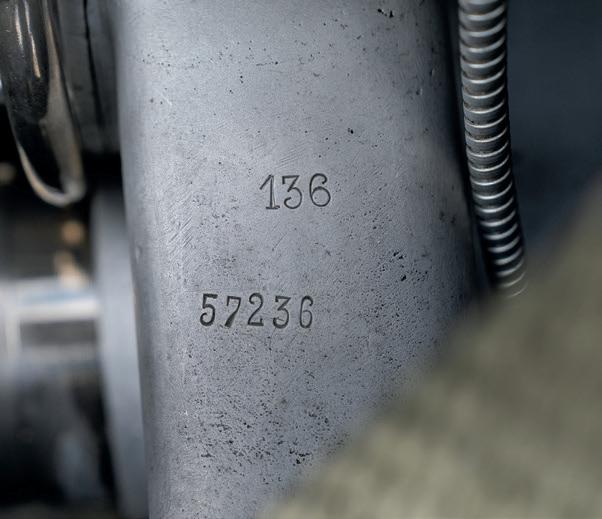
Bumper Guardian, Spring 2019 and never been in a garage outside the owner’s. The car is running as well as when bought, in fact the performance is better due to two modifications; a Scintilla Vertex and 1936 type inlet manifold.” He would go on to retain this Type 57 in Montreal, Canada, until his passing in 1966. The lovingly preserved, but slightly neglected drophead remained in the family until McConnell’s estate sold it in 1977.
Brian H. Pollock, then a resident of Vancouver, Canada, purchased the Bugatti and worked on and maintained the car until deciding to embark on a full-scale restoration. It was completed by Edwin Arnold in 1984, just in time to win its class at that year’s prestigious Pebble Beach Concours d’Elegance®. Beautifully preserved, but also actively used by Mr. Pollock and his family, the car was a frequent participant in concours as well as American Bugatti Club rallies on both East and West Coasts.
With Mr. Pollock’s passing in 2024, his 47-year custody of this graceful Type 57 James Young cabriolet has drawn to a close, offering a rare opportunity for the discerning collector to acquire not only a two-owner Bugatti from new, but also one of the handful of Bugattis to have come to North America when new and to have remained here ever since.

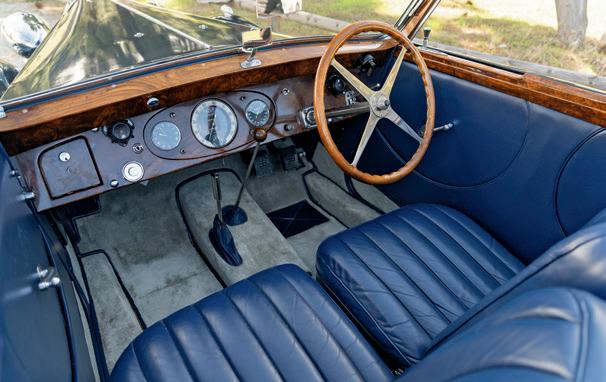
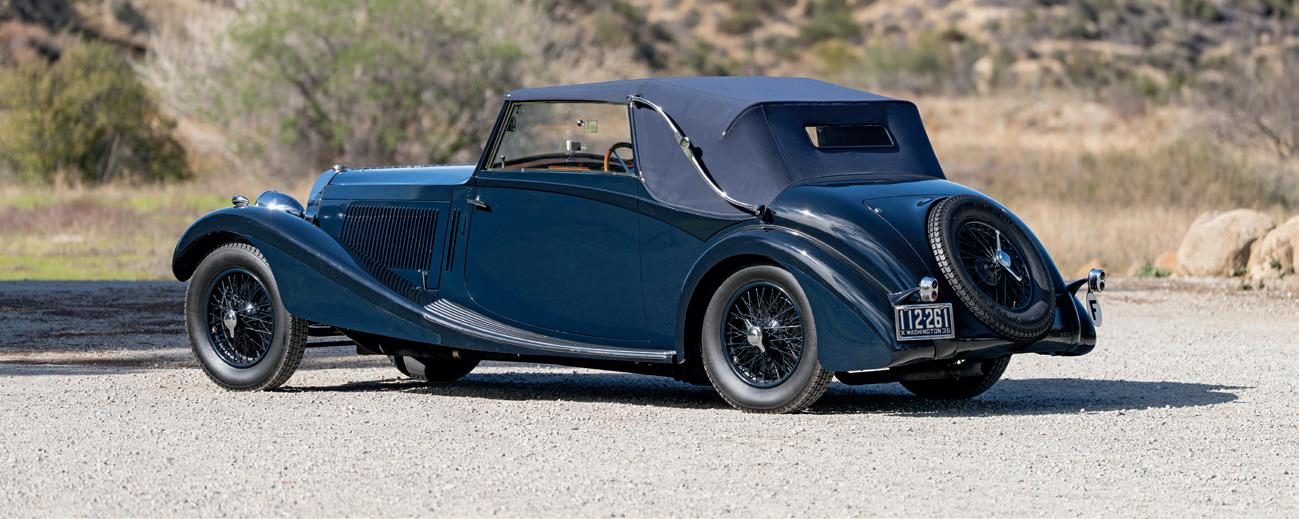
CHASSIS NO. 1E12465
ENGINE NO. 7E7730-9
$200,000–$250,000 without reserve
Built in January 1966, this E-Type Roadster was originally finished in a rare Black over Beige color combination and dispatched to Jaguar Cars New York. That spring, it was sold to its first owner, Archie Saccio of East Patchogue, Long Island. Remarkably, the car remained in his family’s ownership until earlier this year, when it was sold to the consignor.
Mr. Saccio, an Eastern Airlines pilot and WWII Air Force veteran, drove his Jaguar sparingly during the early years of his ownership, later limiting its use to occasional outings. Last registered in 1999, this E-Type presents in unrestored, untouched, garage-find condition and has not been driven for approximately 25 years. At the time of cataloguing, the odometer read just 12,808 miles.
HIGHLIGHTS
Desirable Series I 4.2-Litre Roadster in Striking Black over Beige Colors
Recent New York Garage Find; Single Family Ownership from 1966 to 2025
Well-Preserved Unrestored Example Showing Just 12,808 Miles from New Retains Matching-Numbers Chassis, Body, and Engine per Factory Records
Accompanied by JDHT Certificate, Owner’s Manual, Service Book, and Tool Roll
*Please note that this vehicle has been in long-term static storage and may not be currently operational. It will require mechanical attention prior to road use.
A true survivor, this E-Type retains its original paint, upholstery, soft top, Triplex glass, and serial-numbered components per the accompanying JDHT Certificate. Period accessories include a luggage rack, radio, Talbot Berlin mirror, Moto-Lita steering wheel, and ANSA exhaust system. The original dealer sticker – Trencher of Amityville – remains affixed to the rear panel, and the trunk contains the original tool roll, owner’s manual, maintenance booklet, manufacturer’s warranty, and service manual.
An important and iconic model from one of England’s most successful sports car manufacturers, the E-Type is one of the most enduring postwar classics. Finding a low-mileage Series I Roadster with ideal colors, original paperwork, and nearly 60 years of single family ownership is every collector’s dream.
4,235 CC DOHC Inline 6-Cylinder Engine
Three SU Carburetors
265 BHP at 5,500 RPM
4-Speed Manual Gearbox
4-Wheel Dunlop Disc Brakes, Inboard Rear
4-Wheel Independent Suspension




COACHWORK BY TOURING
CHASSIS NO. 0060 M
ENGINE NO. 0060 M
$4,500,000–$5,500,000
It was the Tipo 166, introduced in 1948 as a replacement for the 125 S, that first established Enzo Ferrari’s Modenese workshop as a premier manufacturer of racing cars. Powered by a two-liter, Colombo-designed V-12 engine, the 166 charted a course of development that would come to define the look, sound, and inimitable character of Ferrari automobiles.
While the earliest 166 Sports and Spider Corsas proved successful in their own right, it was the 166 Mille Miglia – or MM – that dominated sports car racing in the late 1940s and early 1950s. Remarkably, the Ferrari 166 MM remains the only model car to have won all three of the great European sports car races – the 24 Hours of Le Mans, the Targa Florio, and the 1000 Miglia.
HIGHLIGHTS
An Important, Even-Serial-Number Ferrari Competition Car
One of Only Five Touring Berlinettas Built on the 166 MM Chassis
The 1950 Paris Show Car; Sold New to Famed Sportsman Briggs Cunningham
Raced in Period at Sebring, Bridgehampton, Watkins Glen, and Torrey Pines
Retains Original Engine, Gearbox, and Differential per Factory Records
A Ticket to Major International Events from Pebble Beach to the 1000 Miglia
During these formative years, Carrozzeria Touring of Milan, led by Carlo Felice Bianchi Anderloni, was the coachbuilder most closely associated with the Ferrari marque. Touring’s exquisite designs and innovative Superleggera construction were ideally suited to the sporting nature of the 166 MM chassis. Their nowiconic 166 MM Barchetta, or “Little Boat,” emerged from this collaboration, culminating in the development of a more purposeful competition car: the 166 MM Berlinetta Le Mans.
Unveiled at the Geneva Motor Show in 1950, the Berlinetta Le Mans was a striking fastback whose lineage echoed the streamlined Alfa Romeo racing cars of the late 1930s. Sculpted from lightweight aluminum, it was, in essence, a
2,341 CC SOHC Alloy V-12 Engine
Three Weber 32 DCF Carburetors
Estimated 170 BHP at 7,000 RPM
5-Speed Manual Gearbox
4-Wheel Hydraulic Drum Brakes
Front Independent Suspension with Transverse Leaf Spring
Rear Live Axle with Semi-Elliptical Leaf Springs


Briggs Cunningham, Greens Farms, Connecticut (acquired new in 1950)
Peter and Robert Yung, Long Island, New York (acquired from the above in 1952)
Henry N. Manney III, Los Angeles, California (acquired from the above in June 1952)
John Fox, San Francisco, California (acquired from the above circa 1952)
Louie Ganz, California (acquired from the above circa 1953)
George Metzger, California (acquired from the above circa 1953)
Henry N. Manney III, Los Angeles, California (acquired from the above circa 1955)
John Cannon, Los Angeles, California (acquired from the above circa 1956)
Russell Martin, Beverly Hills, California (acquired from the above in 1962)
( continued )
Gerald D. Wilburn, Hawthorne, California (acquired from the above in 1965)
Lawrence A. Knaack, Long Grove, Illinois (acquired from the above in 1965)
John Hajduk, Chicago, Illinois (acquired from the above in 1976)
Donald Dethlefsen, Chicago, Illinois (acquired from the above in 1977)
Peter Agg, UK (acquired from the above in 1978)
Peter Briggs, Perth, Australia (acquired via Coys of Kensington in 1981)
Symbolic Motor Company, La Jolla, California (acquired from the above in 1998)
Bruce Lustman, Aspen, Colorado (acquired from the above in 1999)
William Jacobs, Joliet, Illinois (acquired from the above in 2006)
Private Collection (acquired from the above circa 2008)
Current Owner (acquired from the above)
more aerodynamically effective Barchetta. Designed for high-speed endurance racing, the Berlinetta featured a spartan, purposeful cockpit and was equipped with distinctive competition details including leather bonnet straps, large external fuel fillers, and Plexiglas windows. In both concept and execution, these early 166 MM Berlinettas laid the foundation for Ferrari’s enduring line of dual-purpose grand touring competition cars.
The Ferrari presented here, chassis 0060 M, is the last of just five 166 MM chassis originally fitted with Touring’s Berlinetta Le Mans coachwork. Each of these cars was unique in its individual details, and this example, bearing body no. 3461, was originally finished in a striking light blue livery. The coachwork fashioned for 0060 M is distinguished by its horizontal hood vents, rear quarter window louvers, faired-in fog lamps, and a one-off dashboard layout featuring elegant, white-faced Jaeger instruments centrally placed.
Constructed in May and June 1950, chassis 0060 M made its public debut at the prestigious Paris Motor Show, held October 5-12, 1950. Positioned prominently on Luigi Chinetti’s stand – flanked by a 166 MM Barchetta and a 166 Inter Cabriolet by Stabilimenti Farina – the blue Berlinetta drew significant attention from the motoring elite.
The exhibition proved successful, and in November 1950, chassis 0060 M was sold to the legendary American sportsman, race team owner, and car collector Briggs Cunningham. Having been impressed by the performance of similar berlinettas at Le Mans earlier that year, Cunningham planned to campaign the car in the US for the upcoming season. To ensure it would be competitive, he had Ferrari upgrade 0060 M to full 195 S specification, as confirmed by handwritten notations on the factory build sheets.
Developed in 1950 to contend with larger-displacement rivals, the 195 S was essentially a more powerful 2.3-liter version of the same Colombo V-12, achieved by increasing the bore by 5 mm. Topped by three Weber carburetors and a cold air box, the 195 S engine produced approximately 170 bhp at 7,000 rpm – a substantial performance gain over the standard 166 MM specification. In addition to increased power, the 195 S offered greater torque at lower rpm, making it more tractable.
The upgraded Berlinetta arrived in New York in December 1950, becoming the first closed Ferrari competition car delivered to the US. Shortly thereafter, it was registered in Connecticut and driven to Florida for its competitive debut in the Sam Collier Memorial Sebring Six-Hour Grand Prix of Endurance on December 30, 1950.
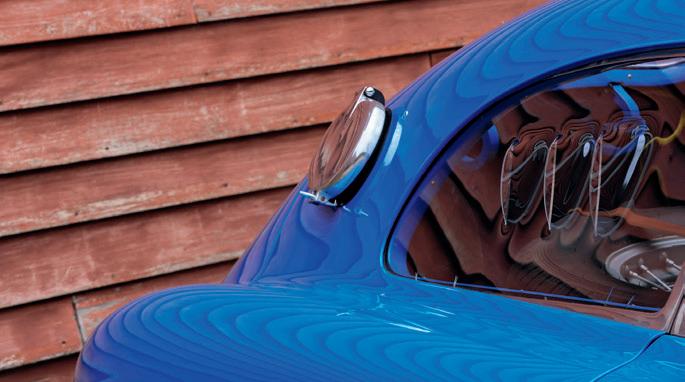

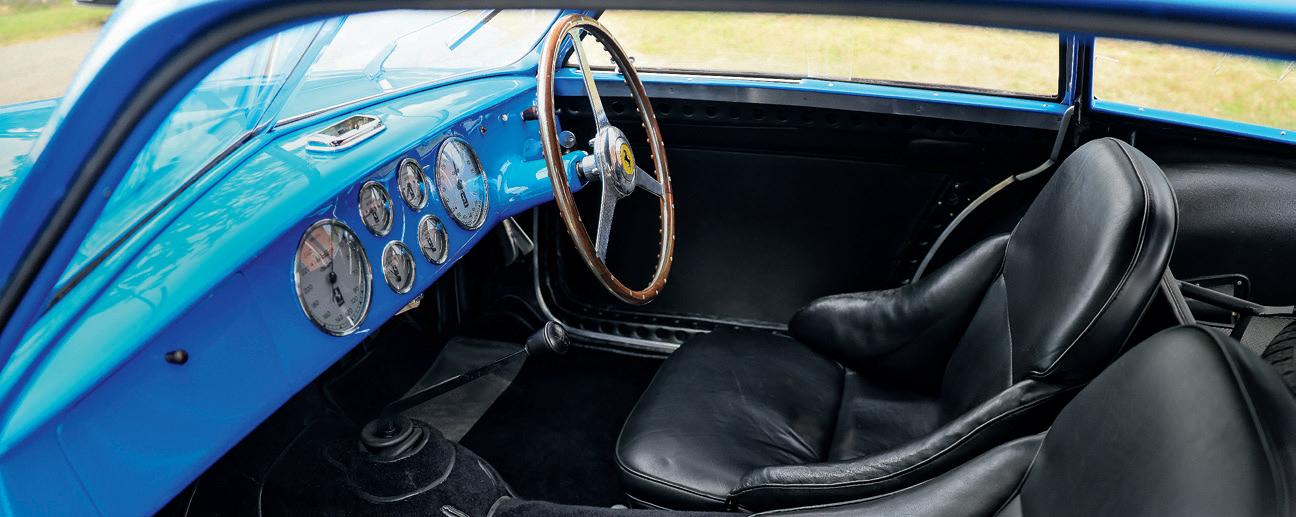
Sam Collier Memorial Sebring Six-Hour Grand Prix of Endurance, 1950, Chinetti, No. 17 (7th Overall, 1st in Class)
Sports Car Grand Prix of Buenos Aires, March 1951, Kimberly, No. 6 (7th Overall, 1st in class)
Mecox Trophy at Bridgehampton, June 1951, Walters, No. 56 (2nd Overall, 1st in Class)
Watkins Glen Grand Prix Seneca Cup, September 1951, Fitch, No. 98 (2nd Overall)
Bridgehampton Cup, May 1952, Wallace, No. 19 (8th Overall)
San Diego Cup at Torrey Pines, December 1952, Fox, No. 36 (DNF)

The official program for this inaugural Sebring race lists Cunningham as the entrant of three cars: an Aston Martin DB2, a Nash-Healey, and 0060 M. With his formidable record in endurance racing, Luigi Chinetti was given the wheel of the 2.3-liter Ferrari. He delivered a brilliant performance, finishing 7th Overall and 1st in Class, with an average speed of 60.7 mph.
Following Sebring, the Ferrari was invited to compete in a prestigious sports car race in Buenos Aires, hosted by Argentine president General Juan Perón. In this highly publicized event, Jim Kimberly drove 0060 M to a respectable 7th Place finish.
After its South American outing, 0060 M returned to the US, where it competed in two of the country’s premier racing events: Bridgehampton and Watkins Glen.
In 1952, Cunningham sold the Ferrari to Peter and Robert Yung of Long Island, New York, who entered it in the 4th Annual Bridgehampton Cup that May.
The following month, the Yung brothers traded 0060 M to Luigi Chinetti in exchange for a Vignale-bodied 225 S. Chinetti subsequently sold the Ferrari to Henry N. Manney III.
A name well known among automotive enthusiasts, Manney would later become
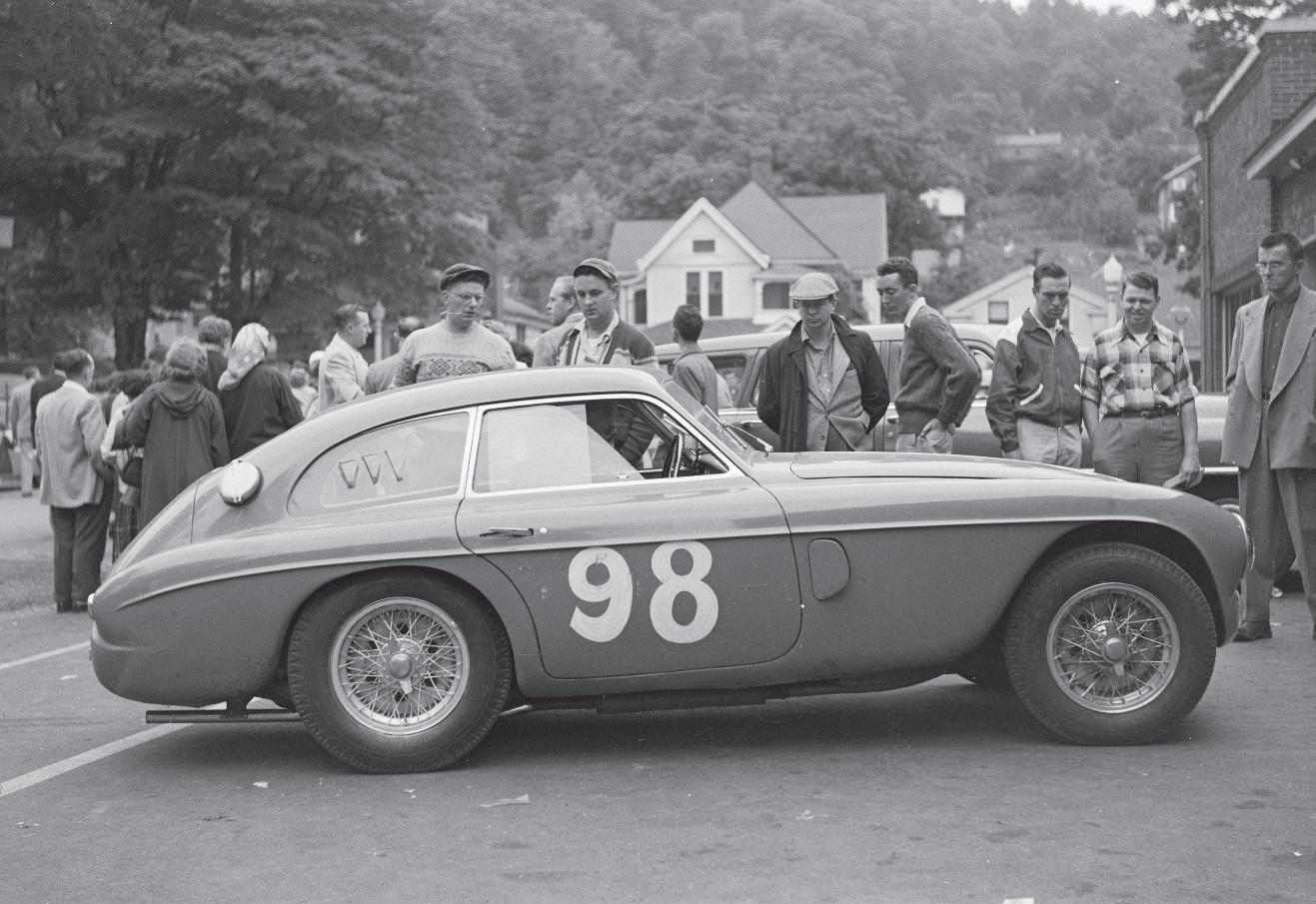

Paris Auto Show, 1950
Oakland International Sports Car Show, California, 1952 (First in Class)
FCA National Meeting, Illinois, 1971
FCA National Meeting, New York, 1977 (Best of Show)
1000 Miglia (1984, 1988, 1990, 1995)
Grandes Marques Seydoux Rallye, 1984 (3rd Overall)
Goodwood Festival of Speed, 1994
Louis Vuitton Bagatelle Concours d’Elegance, England, 1995
Ferrari Owners Club UK Annual Concours d’Elegance, England, 1995
Monaco Historic Grand Prix, 1997

(continued)
50th Anniversary of Ferrari, Italy, 1997
Concorso Italiano, California, 1998
Cavallino Classic VIII, Florida, 1999
Pebble Beach Concours d’Elegance®, 2001 (Second in Class)
Road & Track magazine’s European editor and one of the most beloved voices in motor sports journalism. In 1952, at just 30 years old, he proudly displayed the Ferrari at the Oakland International Sports Car Show, where it earned First Place in the “Cars Over $6,000” class.
Later that year, Manney traded the Ferrari to John Fox, US agent for Cooper Cars, in exchange for a new Aston Martin DB2 and a Cooper-Norton. Fox entered 0060 M in its final race, the San Diego Cup at Torrey Pines. The Berlinetta then passed among various Southern California owners before being acquired in 1965 by Lawrence A. Knaack of Long Grove, Illinois. Mr. Knaack exhibited the Ferrari at the 1971 FCA National Meeting in Chicago. Later, under the ownership of noted Chicago collector Donald Dethlefsen, 0060 M won Best of Show honors at the 1977 FCA National Meeting in Watkins Glen. In 1981, the car was acquired by respected Australian collector and vintage racer Peter Briggs. During his long-term stewardship, 0060 M demonstrated its versatility by participating in such important international events as the 1000 Miglia, Goodwood Festival of Speed, and Louis Vuitton Bagatelle Concours d’Elegance.
In 1998, the Touring Berlinetta returned to the US and was soon acquired by Ferrari enthusiast Bruce Lustman of Colorado. Determined to restore the car to its original splendor, Mr. Lustman commissioned a concours-quality restoration
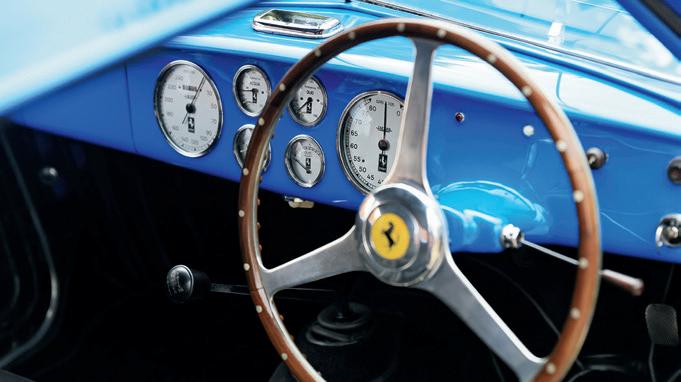
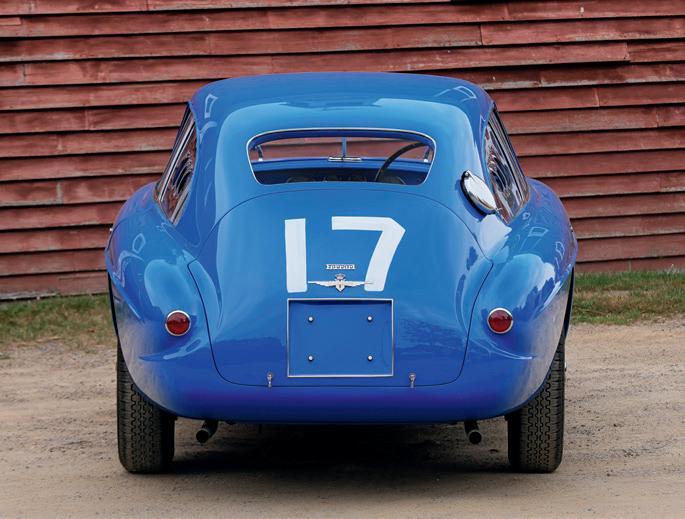
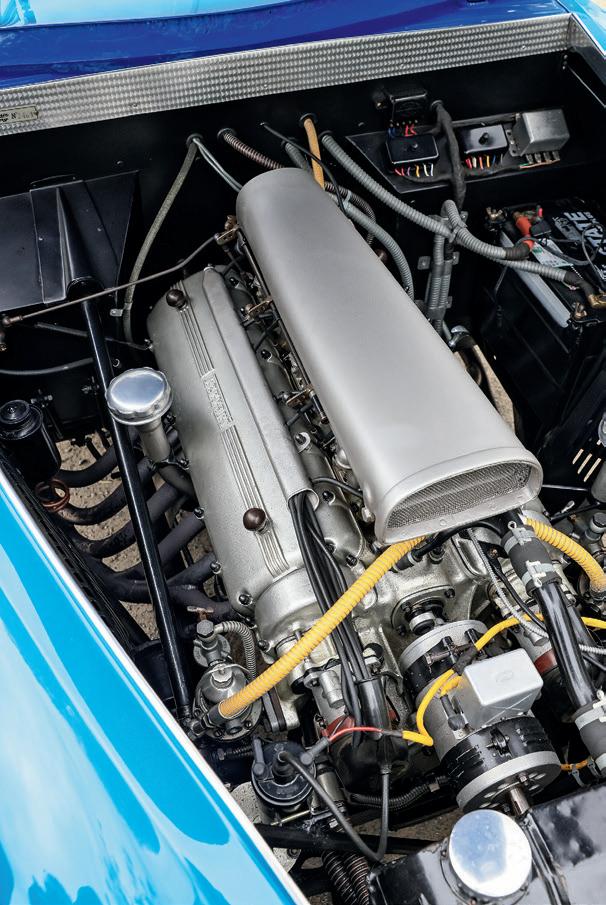

Auto Speed and Sport, August 1952
Automobile Quarterly, Volume 15, No. 1, December 1977
Bridgehampton Racing: From the Streets to the Bridge, by Joel E. Finn
The Complete Ferrari, by Godfrey Eaton
Cunningham: The Life and Cars of Briggs Swift Cunningham, by Dean Batchelor and Albert R. Bochroch
Cunningham: The Passion, The Cars, The Legacy, by Richard Harman
Ferrari au Salon de Paris, by Dominique Pascal
Ferrari: The Sports/Racing and Road Cars, by Godfrey Eaton
Ferrari Tipo 166: The Original Sports Ferrari, by Angelo Tito Anselmi
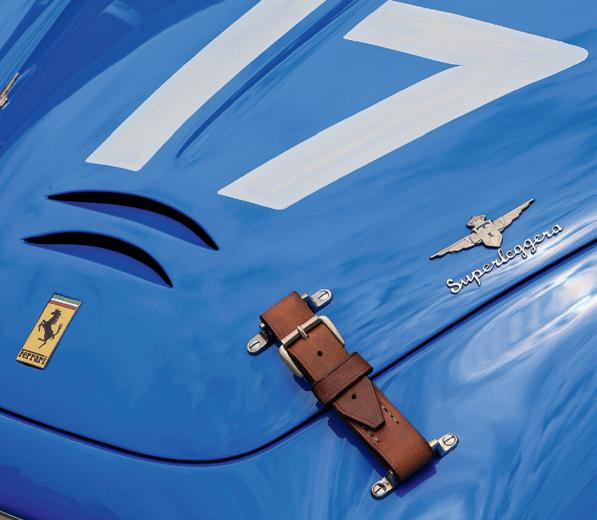
( continued )
Prancing Horse, No. 52, 1977
Prancing Horse, No. 143, 2002
Road & Track, August 1951
Watkins Glen: The Street Years 1948–1952, by Philippe Defechereux
by Mike Dopudja of MPH in Englewood, Colorado. Completed over two years, the restoration culminated in a Second in Class award at the Pebble Beach Concours d’Elegance® in August 2001.
Over the past decade, 0060 M has remained in two distinguished US collections and has made only limited public appearances. Faithfully presented today in its original Sebring livery, it is a jewel of a sports car. Importantly, the stamped components – chassis, engine, gearbox, and rear end – all correspond with the factory build sheets. Most recently, the car has been maintained by the esteemed Paul Russell and Company, renowned worldwide for their excellence in Ferrari restoration. Under the consignor’s care, the Berlinetta performed flawlessly on a private rally from Palm Beach to Naples, Florida.
Well known and highly regarded among marque experts, 0060 M is a historically significant, even-serial-number Ferrari that embodies every quality desired in a collectible automobile: aesthetic beauty, mechanical sophistication, rarity, an outstanding period racing history, and exceptional provenance. With most 166 MMs now firmly held in major collections, the offering of this Touring Berlinetta Le Mans at auction represents a significant opportunity to acquire one of Ferrari’s first great competition cars.


COACHWORK BY REUTTER
CHASSIS NO. 160904
$250,000–$300,000 without reserve
This 356 C Cabriolet was completed on July 20, 1964, and sold new to J.L. Hutchinson of Garland, Texas, via Porsche Cars Southwest. It was originally equipped with a green-tinted windshield, Speedster-style trim strips, and chrome wheels.
While little is known of its earliest history, the Cabriolet eventually passed through the hands of respected Porsche specialist Weldon Scrogham before receiving an extensive restoration by Carolina Coach Crafters of Mooresville, North Carolina. According to restoration records on file, the body was stripped to bare metal and refinished in Signal Orange (6916) – the color listed on the Porsche Certificate of Authenticity. It should be noted that the Kardex and
HIGHLIGHTS
One of Only 588 Porsche 356 C Cabriolets Built for the 1965 Model Year
Extensive Restoration Completed in 2016 by Carolina Coach Crafters
Finished in Striking Color Scheme of Orange over Black Leather
Offered with Tools, Jack, Spare, Kardex, Porsche COA, and Restoration Records
Award Winner at PCA Werks Reunion, Atlanta, and Hilton Head Concours d’Elegance
Reutter tag record the original color as Signal Red. The interior was reupholstered in black leather, while brightwork, glass, and seals were restored or replaced. Mechanical components, including the unstamped, correct-type replacement engine, were given similar attention.
Completed in 2016, this 356 debuted at the Concours on the Avenue in Carmel and won the Palmetto Award at Hilton Head that same year. It went on to claim 356 Open Class honors at the Amelia Island PCA Werks Reunions in 2017 and 2018 and was named Best Porsche at the 2017 Atlanta Concours. Offered with tools, jack, spare, and documentation, this beautiful 356 C Cabriolet represents the final and most refined iteration of Porsche’s landmark model.
1,582 CC OHV Flat 4-Cylinder Engine
Twin Zenith 32 NDIX Carburetors
75 BHP at 5,200 RPM
4-Speed Manual Transaxle
4-Wheel Hydraulic Disc Brakes
4-Wheel Independent Suspension with Torsion Bars
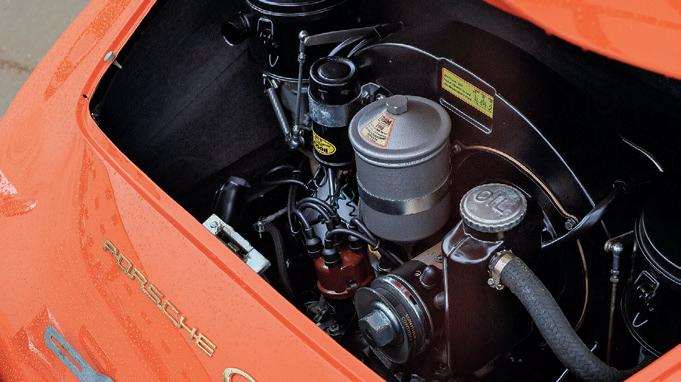
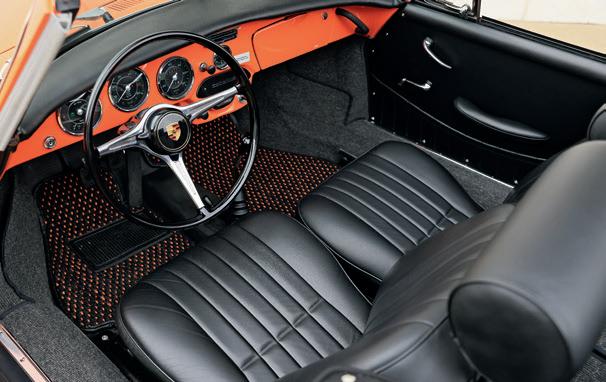


CHASSIS NO. 27119
$250,000–$350,000
As with many companies, the name BNC can be attributed to the marriage of an engineer and a supporting financial backer – such was the case with Lucien Bollack, formerly of Hispano-Suiza, and René Netter, his financier. Bollack, Netter, et Compagnie began producing automobiles in 1923. History records that their cars were attractive and enjoyed success in regional competition, but a runway of sales eluded them.
The Model 527 was an undeniably attractive sports car, with the influence of its French contemporaries, yet with a more low-slung frame and swept-back radiator. Under the hood was a Ruby-built 1,100 cc side-valve engine mated to a three-speed transmission. Of the catalogued factory body designs, this
“The Caswell BNC” – Extremely Rare Survivor of Lesser-Known French Sports Car
Well-Documented History Since Arriving in the US, Circa 1942
Participated in Landmark American Sports Car Races Between 1947 and 1951
Achieved 8th Place at the Inaugural Watkins Glen Grand Prix in 1948
Painstakingly Restored to Concours Standards by Lowrey’s Auto Restoration
Offered with Exceptional File of Supporting Documentation
*Please note that this vehicle is sold on a Bill of Sale.
example complies most closely to the Torpédo Sport Paris-Biarritz.
One of very few survivors, this BNC is accompanied by an extensive documentation file, which traces its history to the original owner, M. Tremel of France. Following a brief gap in the record, the car later surfaced in the US, though the circumstances of its transatlantic journey remain unknown. Circa 1942, the voiturette was offered for sale by motorcycle dealer George Taylor and subsequently acquired by George Caswell. In a clever bit of engineering, Caswell shoehorned a Ford V8-60 engine into the BNC’s frame without substantially altering the bodywork and created something of a “wolf in sheep’s clothing.” It has stayed in this form ever since.
136 CID Ford Flathead V-8 Engine
Single Stromberg 97 Downdraft Carburetor
3-Speed Manual Gearbox
4-Wheel Hydraulic Drum Brakes
Front Solid Axle with Semi-Elliptical Leaf Springs and Shock Absorbers
Rear Live Axle with Cantilever Leaf Springs
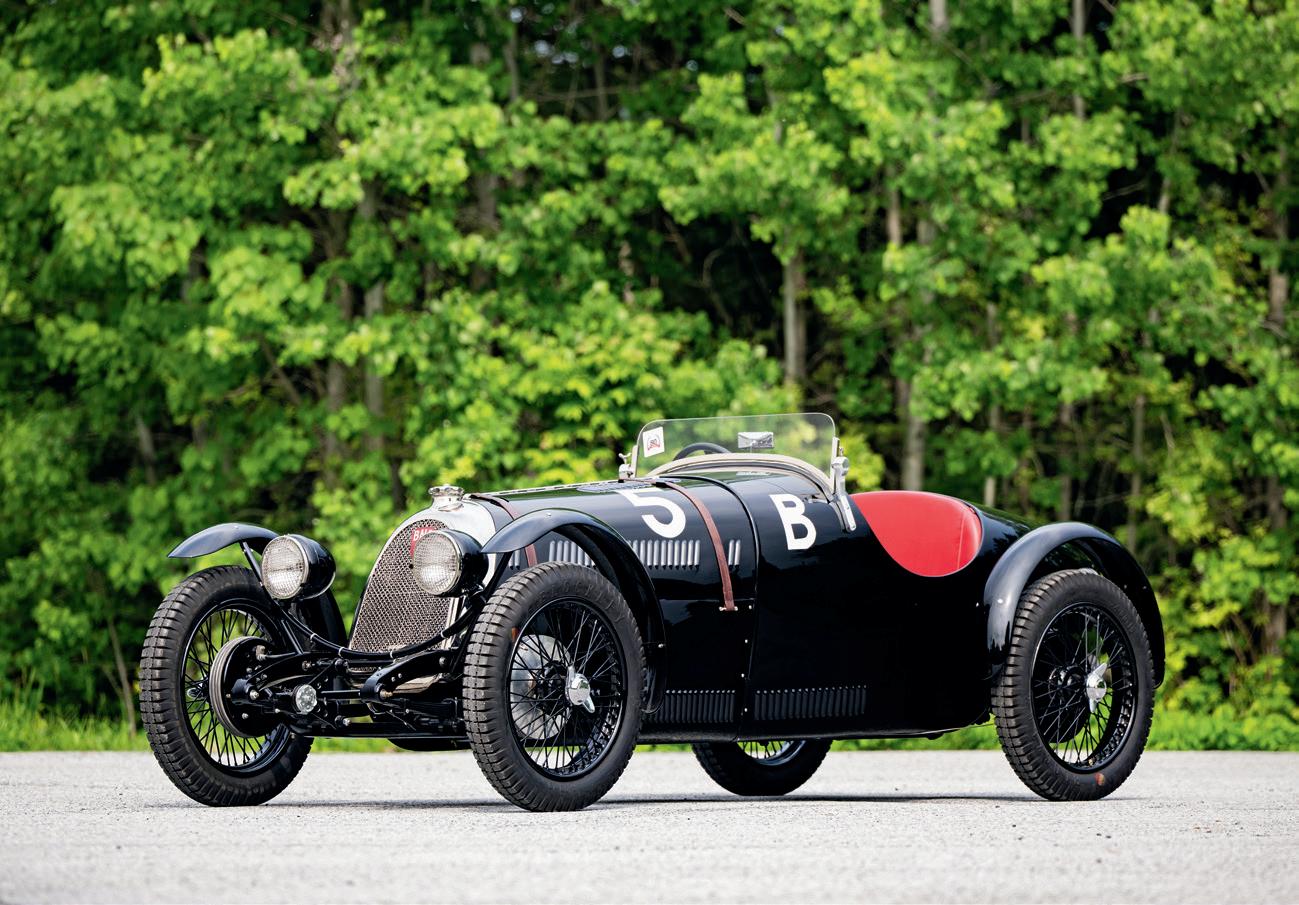

M. Tremel, France (acquired new in 1930)
George Caswell, Upper Darby, Pennsylvania (acquired via George Taylor circa 1942)
Eric “Sonny” Grainger, Islip, New York (acquired by 1953)
Chuck Molin, Bay Shore, New York (acquired from the above in 1953)
John Gianella, Brightwaters, New York (acquired from the above in 1960)
George Lymber, Port Jefferson, New York (acquired from the above in 1998)
Current Owner (acquired in 2014)
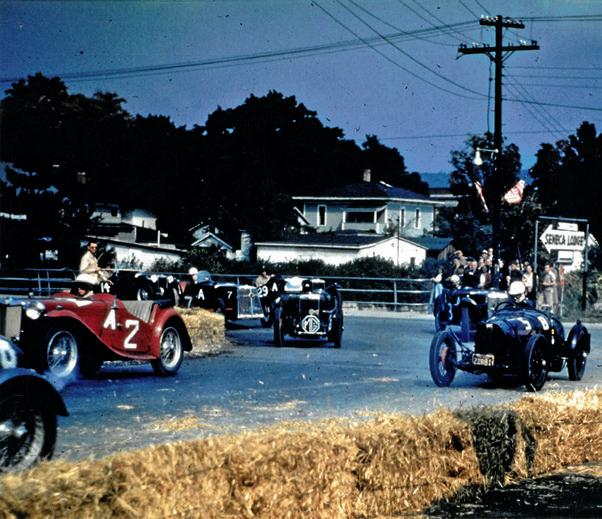
Fairfield Hillclimb, Connecticut, October 1947 (2nd in Class)
Thompson Speedway Pursuit Race, Connecticut, October 1947, Linton (1st)
Langhorne Speedway, Pennsylvania, 1948 (1st)
Watkins Glen Grand Prix, October 1948, Caswell, No. 5 (8th)
Thompson Speedway 1501–3000 CC Class, Connecticut, 1949 (1st)
Giants Despair Hill Climb, 1951 (1st in Class)
Amelia Island Concours d’Elegance, 2022
This BNC was subsequently actively raced by Caswell and Otto Linton in the incubatory 1940s US racing scene. In this “anything goes” era of motor sports, the car achieved a solid 8th place at Watkins Glen in 1948. Images on file show this voiturette competing against everything from MG Midgets to an Alfa Romeo 2.9 and a Teardrop Talbot-Lago. Caswell’s custody ran for a decade, until 1953, by which time the car’s rear axle had been replaced with a beefier unit and larger wheels. It is believed that the next owner was Eric “Sonny” Grainger, one of the founders of Bridgehampton. From 1953 to 1960, Chuck Molin followed in these same footsteps, before passing the car to John Gianella, who replaced the V8-60 with a Midget race car engine. His ownership extended all the way to 1998, when his friend George Lymber gently assumed its tenure. Lymber kept the car until his passing in 2013, and it was acquired by the current owner a year later. Arriving in a well-worn state, the car underwent an extensive restoration, which placed it in the exquisite order seen today. This work was carried out by Lowrey’s Auto Restoration of New Hampshire.
This jewel-like, Franco-American hybrid blends elegant European torpédo styling with the punch of a compact V-8 – certain to prompt more than a few double takes from passersby. With its well-documented provenance and early American racing history in the mix, this makes an extremely appealing voiturette for the discerning enthusiast.
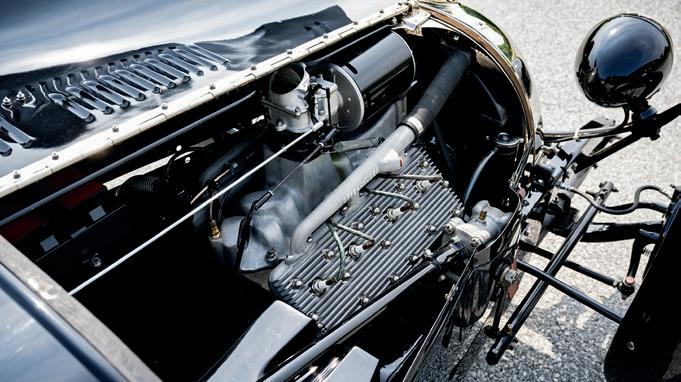
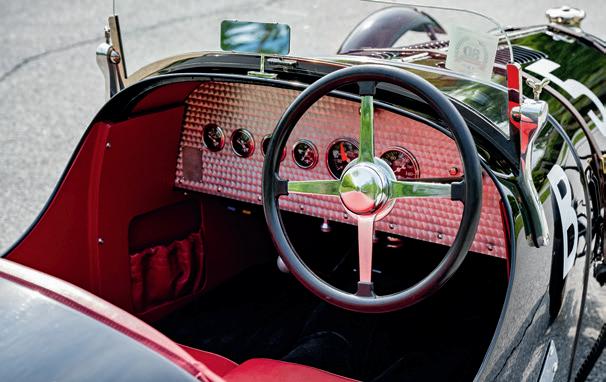

COACHWORK BY CHAPRON
CHASSIS NO. 47545
ENGINE NO. 64068
$700,000–$850,000
Unveiled to the public in 1935, the Delahaye 135 marked a bold shift for the venerable French automaker. Delahaye embraced a sporting spirit with the new 135 – an elegant, competition-borne thoroughbred that would go on to become the marque’s crowning achievement. Rightly regarded as Delahaye’s finest hour, the 135 proved its mettle on both track and tarmac, taking outright victories at the 24 Hours of Le Mans and the Monte Carlo Rally. In road-going form, it became a canvas for some of the most dramatic and beautiful coachbuilt designs of the era.
Built on a chassis featuring advanced, independent front suspension, a well-located rear live-axle, and cable-operated Bendix drum brakes at each corner, the 135
HIGHLIGHTS
One of Just Seven Examples Fitted with Similar Chapron Roadster Bodywork
Coveted Three-Carburetor Performance Model
Equipped with Scarcely Seen and Extremely Desirable Manual Gearbox
Recent Seven-Figure Restoration and Pebble Beach Class Win
Accompanied by Hundreds of Documents Detailing an Incredible Provenance
earned praise for its superb handling and road manners. The high-performance Coupe des Alpes variant, named for the rugged Alpine rally it helped tame, added a trio of 40 mm Solex downdraft carburetors to its robust overhead-valve inline-six, the result of which was a broad, torquey powerband and a marked increase in output. Most examples were fitted with Cotal preselector gearboxes, but the car offered here is unusually equipped with a traditional four-speed manual gearbox – a setup preferred by keen drivers seeking a more involved experience.
All Delahayes were delivered as rolling chassis, and chassis 47545 had the rare good fortune to be bodied by Henri Chapron, one of Europe’s most revered
SPECIFICATIONS
2,996 CC OHV Inline 6-Cylinder Engine
Three Solex 40 FILP Downdraft Carburetors
110 BHP at 4,000 RPM
4-Speed Manual Gearbox
4-Wheel Servo-Assisted Drum Brakes
Front Independent Transverse Semi-Elliptical Leaf Spring Suspension
Rear Live-Axle with Semi-Elliptical Leaf Spring Suspension
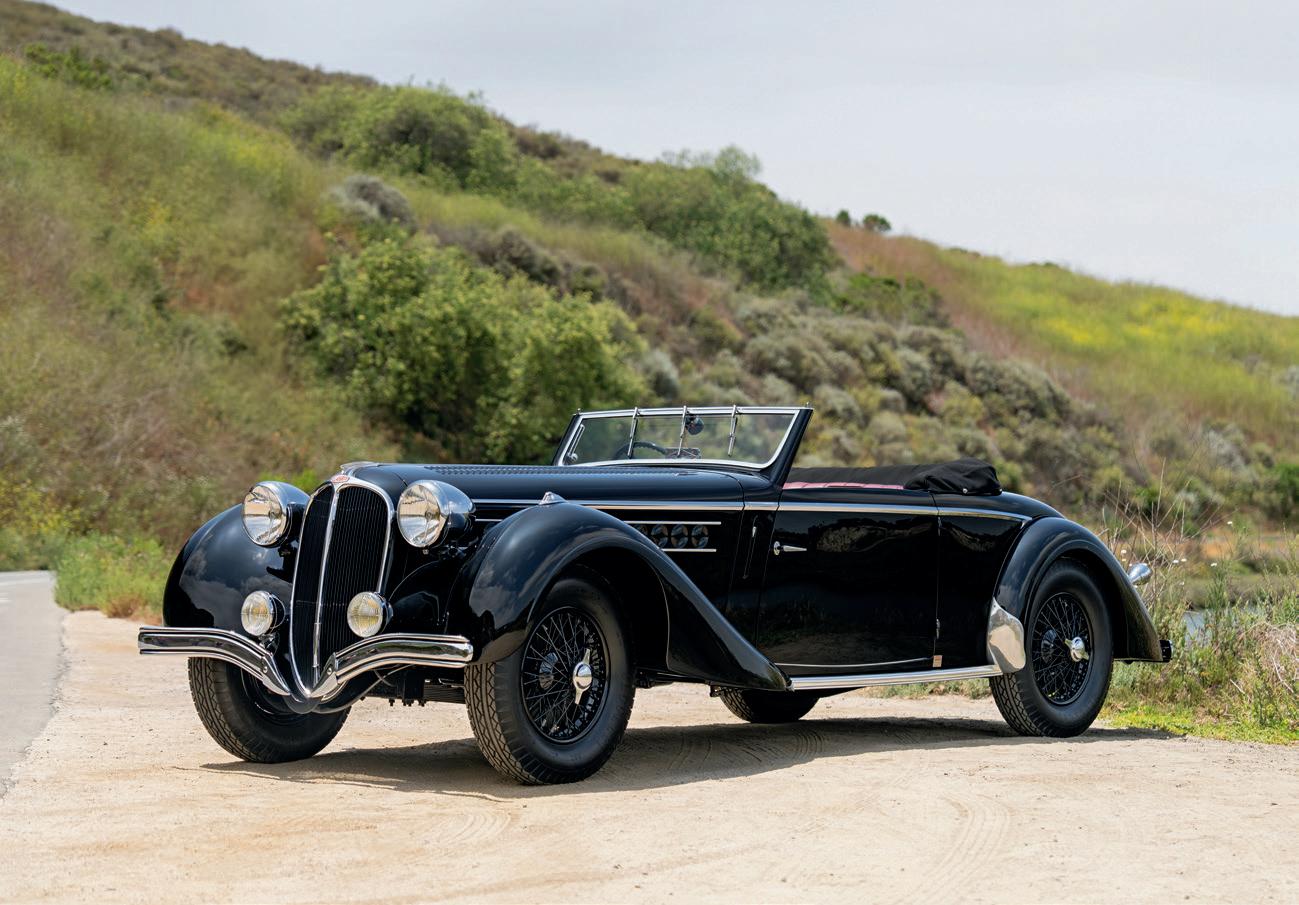

Cyriel Depery, Haute-Savoie, France (acquired new in 1937)
Eugene Juillard, Douvaine, France (acquired from the above circa 1951)
Georges Lombard, Chambéry, France (acquired from the above circa 1961)
Jon Shirley, Bellevue, Washington (acquired from the above via Richard Adatto in 2015)
Mark Hyman, St. Louis, Missouri (acquired from the above in 2020)
Bob Dean Jr., Louisiana (acquired from the above in 2021)
John Shibles, Sea Girt, New Jersey (acquired from the above in 2022)
Current Owner (acquired from estate of the above)
Pebble Beach Concours d’Elegance®, 2016 (First in Class)
Audrain Newport Concours d’Elegance, Newport, Rhode Island, 2024 (First in Class, Best of Show Finalist)
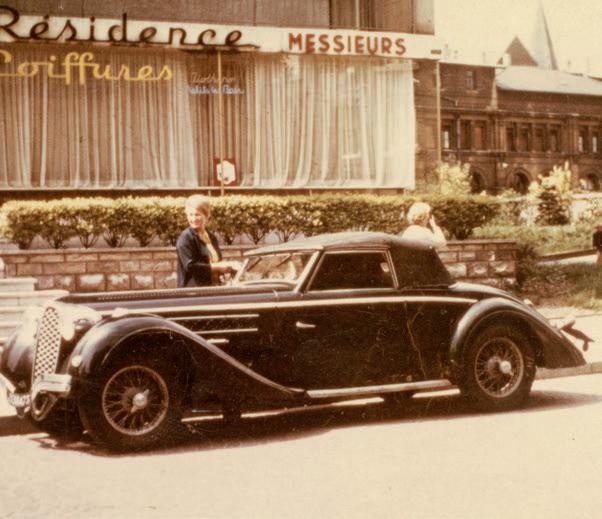
coachbuilders. One of just seven 135s believed to have received this exquisitely proportioned and elegantly flowing roadster coachwork, the example at hand stands out further for its unusual dickey seat – a feature rarely seen on continental coachwork of the period. Its striking black over red color scheme, retained today, has adorned the car for the majority of its known and remarkable life. Hidden away during WWII, 47545 is reputed – by both written history and period photography – to have taken part in the Liberation Day parade in Annecy, France.
Acquired in 2015 by revered collector Jon Shirley, the car then underwent a fastidious five-year restoration by renowned artisan Butch Dennison and his team at Dennison International. Supported by extensive records and invoices totaling well over one million dollars, the quality of refurbishment work was affirmed by a Best in Class win at the 2016 Pebble Beach Concours d’Elegance®. Later owned by the respected enthusiast John Shibles, it now resides with another dedicated West Coast connoisseur of high repute.
Accompanied by a treasure trove of documentation, including period photographs, handwritten records, including a letter from Noëlle Chapron, this extraordinary Delahaye 135 Coupes des Alpes Cabriolet offers an unrepeatable opportunity to acquire one of the most captivating and exotic French automobiles ever built.



COACHWORK BY PININFARINA
CHASSIS NO. 07465
ENGINE NO. 07465
$1,450,000–$1,650,000 without reserve
At the Paris Motor Show in October 1964, Ferrari introduced a replacement for its long-running 250 GT series. Featuring a new 3.3-liter V-12 and rear-mounted five-speed transaxle for improved weight distribution (a near 50:50 split), the 275 was also the first Ferrari road car to be offered with independent front and rear suspension. The 275 benefited from KONI telescopic dampers, as well as front and rear anti-roll bars. This all-new model was offered in berlinetta and spider body styles, but the two coachwork designs differed dramatically. In combination with a luxuriously appointed interior, the Pininfarina-bodied 275 GTS exuded the sophisticated elegance requisite of an open Ferrari grand tourer. Just 200 examples of the GTS Spider were built through early 1966, making the model considerably rarer than its Berlinetta counterpart – of which over 450 were built.
HIGHLIGHTS
A Well-Presented and Highly Evocative 275 GTS Concours-Quality Restoration Performed by the Renowned DK Engineering
Timeless Pininfarina Design; One of Only 200 Built Ferrari Classiche Certified; Finished in Its Stunning Original Colors
Accompanied by Owner’s Manual, Tool Roll, Jack, and Massini Report
Chassis 07465 was completed by August 1965, and bound for Auto Becker of Düsseldorf, Germany, where it was delivered new to Dr. Zwick in the striking color combination of Grigio Azzurro (Blue Gray) over a Pelle Blu (Blue Leather) interior. As with many 275 GTS examples, 07465 was delivered with the desirable Borrani wire wheels. After a couple of years, in August 1967, the GTS was offered for sale by its supplying dealer, Auto Becker. By May 1969, the car was still for sale – this time offered directly by Dr. Zwick. It was described as: “never raced, second car, Nardi steering wheel, in absolutely excellent condition, like new.”
SPECIFICATIONS
3,285 CC Tipo 213 SOHC V-12 Engine
Three Weber 40 DCZ6 Carburetors
260 BHP at 7,000 RPM
5-Speed Manual Transaxle
4-Wheel Hydraulic Disc Brakes
4-Wheel Independent Suspension with Parallel Wishbones and Coil-Over Shock Absorbers
*Please note that this vehicle is titled as 275GTS07465.
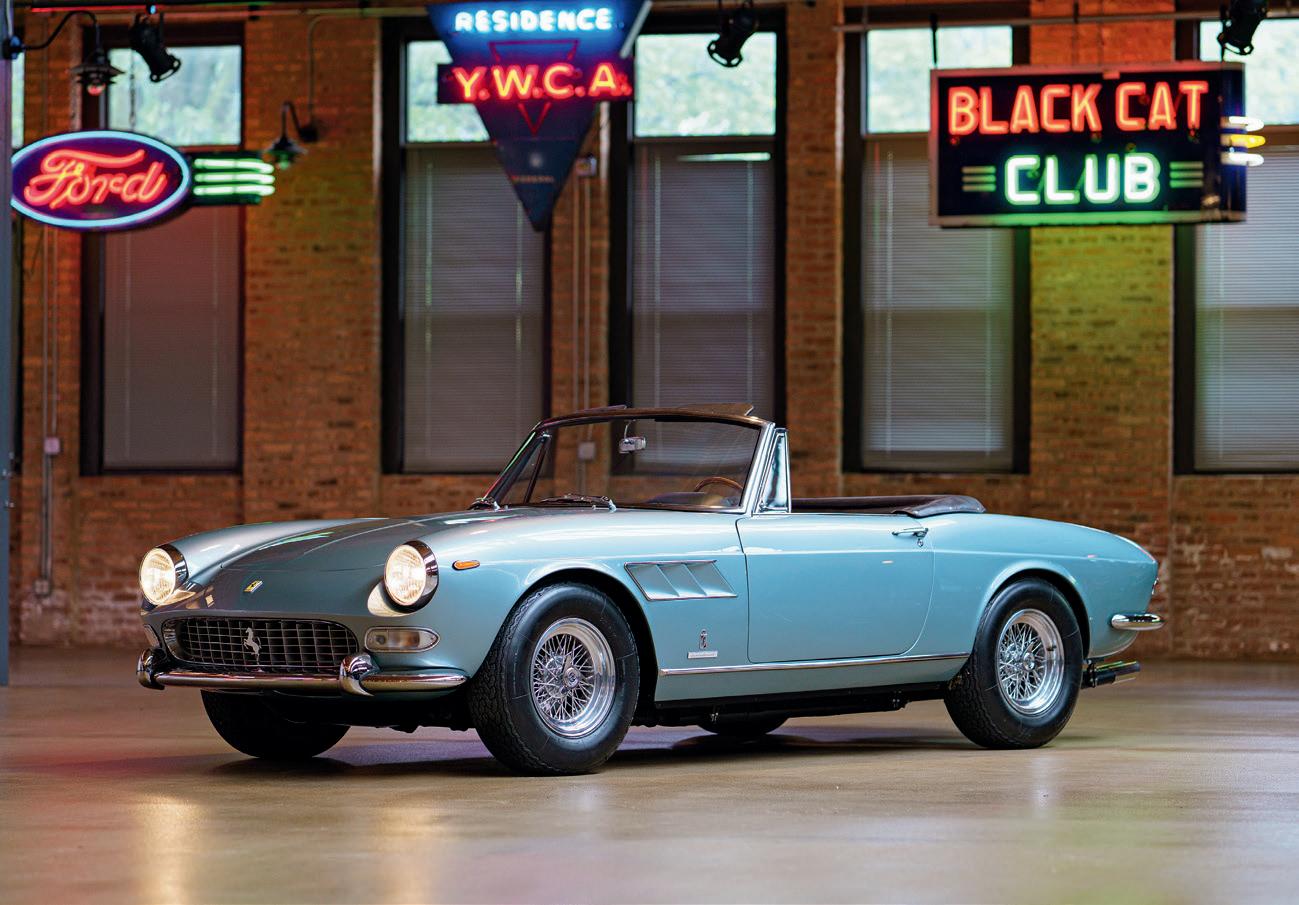

Dr. Zwick, Germany, (acquired new via Ferrari dealer Auto Becker of Düsseldorf in 1965)
Earl Waggoner, California (acquired by 1975)
Current Owner (acquired from the above via DK Engineering in 2017)

By 1975, the GTS had sustained some damage and been repainted red. It had also made its way to the Midwest, where it was purchased by well-known Ferrari enthusiast Earl Waggoner of California and placed in storage. Chassis 07465 must have made quite an impression on Mr. Waggoner, as just a couple of years later, in 1977, he acquired another 275 GTS for his collection.
In 2014, Mr. Waggoner sent 07465 to Ferrari specialist DK Engineering in the UK, to carry out a restoration and bring the GTS back to its former glory. A letter from James Cottingham of DK Engineering, addressed to the current owner, states: “During the restoration the car was taken back to a bare shell and every component was skillfully restored to original correct specification and to the highest quality. No nut or bolt was left untouched.”
The original engine, as well as the transaxle and rolling components were carefully disassembled and rebuilt. At Mr. Waggoner’s request, the color was changed to Verde Metallizzato (Metallic Green). The interior, however, was re-trimmed in its original shade of blue – ensuring that with a simple color change of the exterior back to Grigio Azzurro, 07465 would be restored to its as-delivered color combination.
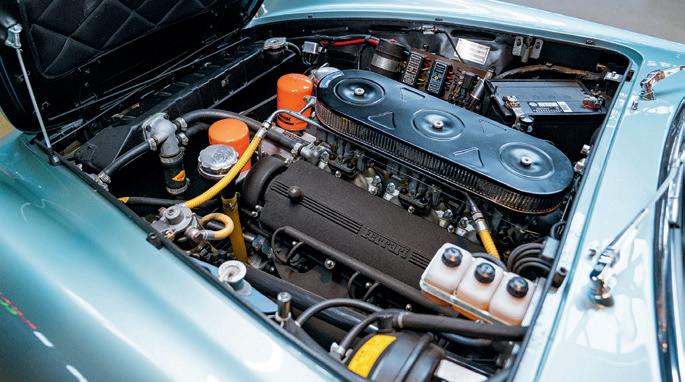
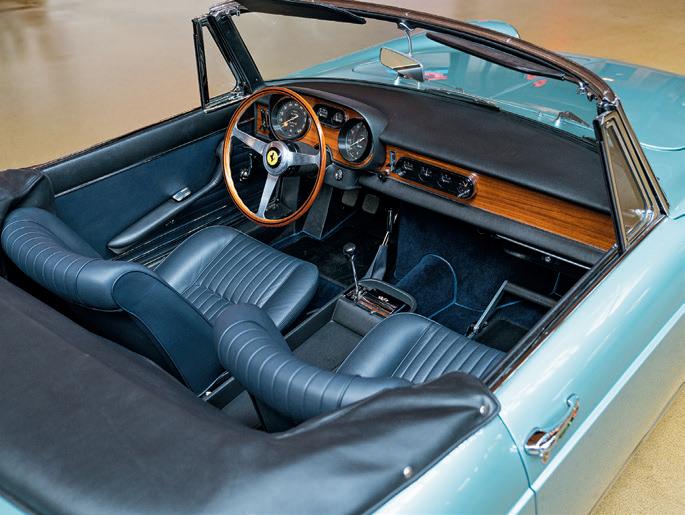



In February 2017, the consignor, a respected longtime Ferrari enthusiast, purchased 07465 from Mr. Waggoner, who had by then partnered in the car with DK Engineering. That same month, the GTS was issued its all-important Ferrari Classiche certification. In addition to its Red Book, the 275 GTS is accompanied by a history report from Ferrari historian Marcel Massini, showing the car’s known ownership and factory specification, as well as past ownership documents, service receipts, and a restoration book from DK Engineering. The sale also includes an owner’s manual, tool roll, and jack. More recently, the current owner had the 275 GTS repainted back to its original color of Grigio Azzurro.
Complete with factory accessories, this highly evocative 275 GTS is a brilliant example of Maranello’s elegant mid-1960s spider. It would be ideal for any collector or discerning Ferrari enthusiast. This handsome and thrilling Ferrari 275 GTS will be at home in any fine collection of Italian icons or on its own as the ideal open 1960s Ferrari.
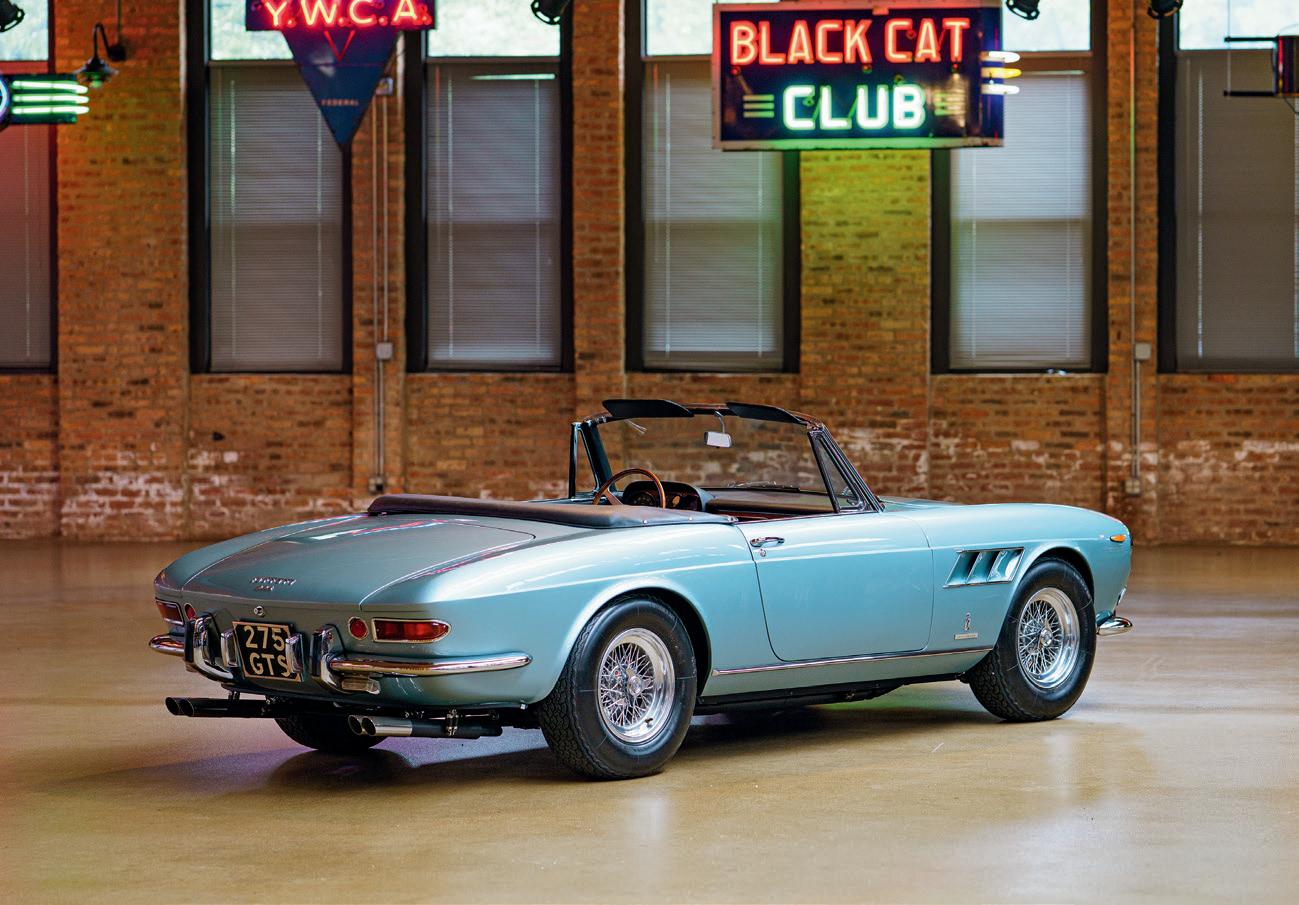
COACHWORK BY DIETRICH
CHASSIS NO. KB2005
ENGINE NO. KB2005
$275,000–$350,000
Although Lincoln catalogued the KB Dietrich Convertible Sedan for the 1933 model year, only 15 of the splendid automobiles were created. Today, just six of these exclusive automobiles are known to exist in any form. The Dietrich Convertible Sedan presented here, chassis KB2005, is the earliest of the six surviving examples, and the only one known that features the beautiful early style open fenders. Shortly after production commenced, these attractive wings were revised with more modern skirting.
Tracing back to its beginnings, this Lincoln was originally delivered to a customer in Long Island, New York. In the 1950s, Jack Pope of Indianapolis acquired the KB, and earned Senior Classic status from the CCCA. In 1971, Mr. Pope sold
HIGHLIGHTS
One of Just Six Extant KB Convertible Sedans by Dietrich
The Only Open-Fendered 1933 Example Known to Survive
Beautifully Maintained Fran Roxas Restoration in its Factory Original Colors
Recipient of First in Class and Most Elegant Honors at Pebble Beach
Formerly a Part of Otis Chandler’s Revered Collection of Significant American Classics
An Ideal Open Classic for Tour or Show
the KB to Art Graver of San Francisco, California, who enjoyed the car for a number of years, and by the end of the decade, Mr. Graver had disassembled the Lincoln to begin an extensive restoration. The engine and top were sent to specialists, while the balance of the car remained in his garage.
In 1991, Lincoln enthusiast Lee Gurvey purchased the Lincoln, still disassembled, from Mr. Graver’s widow and entrusted its completion to the noted Chicago restorer Fran Roxas. Subsequently, every aspect of the KB was addressed and, discovering intact original finishes, the restoration was completed in the car’s original colors. After a year of expert work, the KB returned to the road, looking as splendid as the day it was delivered.
448 CID L-Head V-12 Engine
Single Stromberg Dual-Throat Downdraft Carburetor
150 BHP at 3,400 RPM
3-Speed Manual Gearbox with Freewheeling
4-Wheel Mechanical Drum Brakes
Front Beam Axle with Semi-Elliptical Leaf Springs
Rear Live Axle Suspension with Semi-Elliptical Springs
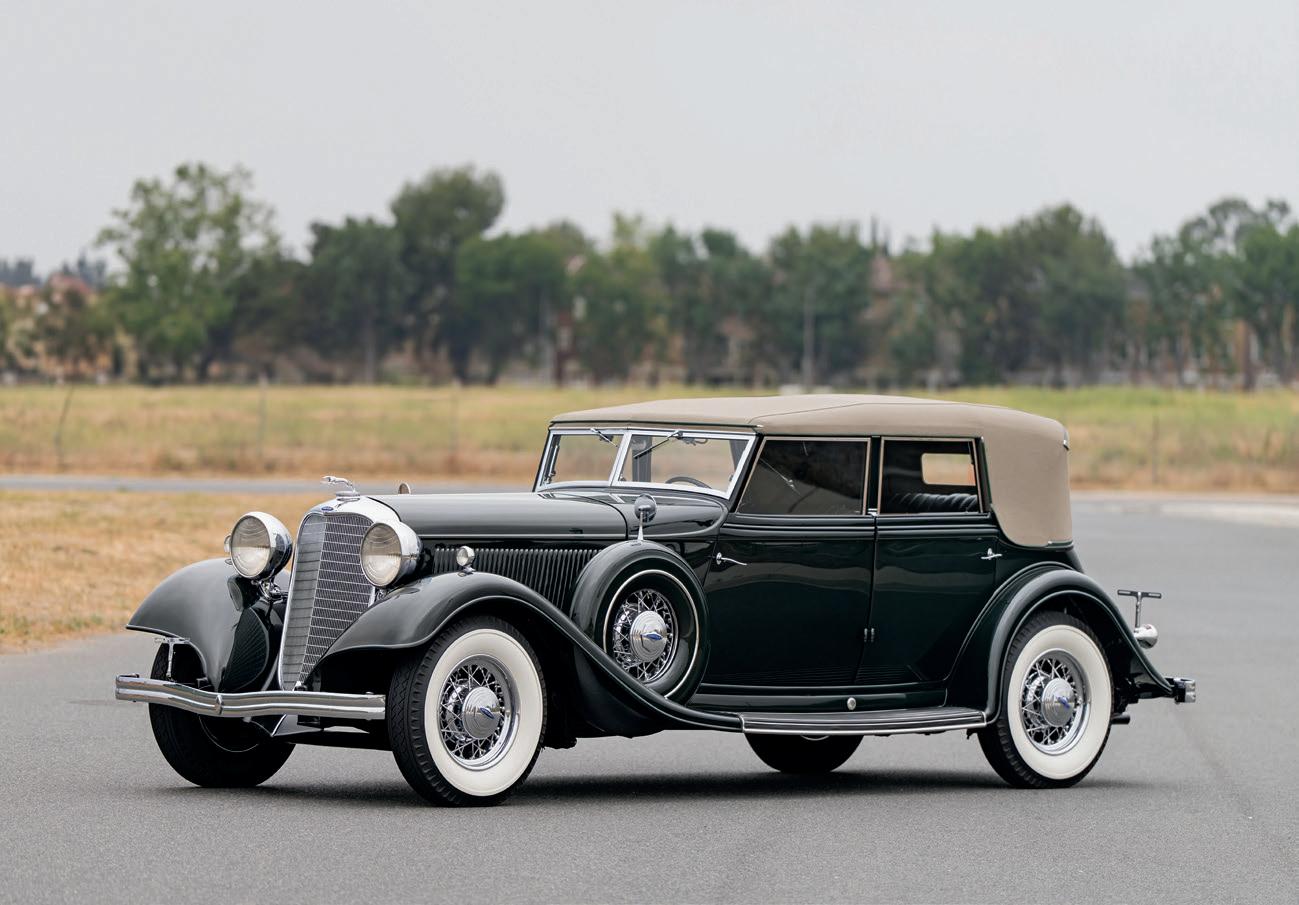

First Owner, Long Island, New York (acquired new in 1933)
Jack Pope, Indianapolis, Indiana (acquired circa late 1950s)
Art Graver, San Francisco, California (acquired from the above in 1971)
Lee Gurvey, Riverwoods, Illinois (acquired from the above in 1991)
Otis Chandler, Los Angeles, California (acquired from the above in 1997)
Private Collection, California (acquired from the estate of the above in 2006)
John Shibles, Sea Girt, New Jersey (acquired from the above in 2013)
Current Owner (acquired from the estate of the above)
Illinois Regional Concours d’Elegance, 1992 (100-Point Score)
Pebble Beach Concours d’Elegance®, 1992 (First in Class, Most Elegant Convertible)
AACA Eastern Division National Fall Meet, Pennsylvania, 1992 (AACA Junior Award, President’s Cup)
CCCA Grand Classic, Michigan, 1993 (Premier Award)
Pebble Beach® Motoring Classic, 2015
Pebble Beach Concours d’Elegance®, August 2015 (Lincoln Trophy)
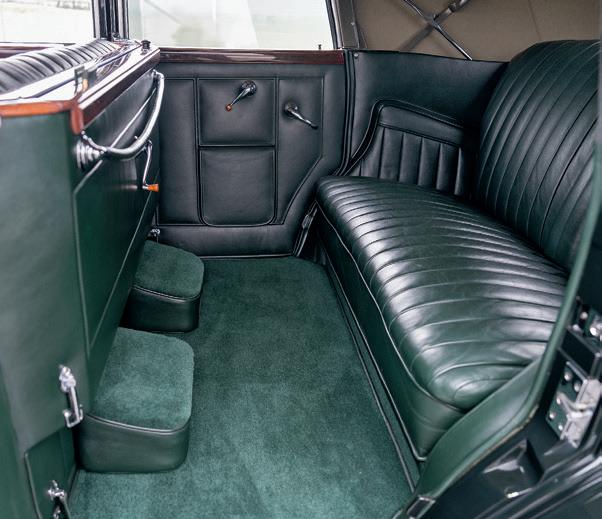
Over the next few years, the Lincoln embarked on a grand tour of American concours events, collecting a number of notable honors along the way. The magnificent classic received a perfect score at the Illinois Regional Concours d’Elegance, an AACA Junior Award and President’s Cup at the Hershey Meet, and a CCCA Premier Award at a Grand Classic. Perhaps the most significant awards were earned at the Pebble Beach Concours d’Elegance® in 1992, where the Dietrich-bodied Lincoln achieved First in Class as well as the coveted Most Elegant Convertible award. In 1997, after years of accumulating trophies, famed collector Otis Chandler purchased the much-admired KB and kept it in his peerless collection of American classics until his passing in 2006, when it became part of the collection of another respected California enthusiast. In 2013, the KB was acquired by the admired collector John Shibles of Sea Girt, New Jersey, where it remained until his recent passing, prior to its acquisition by the consignor.
Accompanied by a significant file of records, there is much to admire about this coachbuilt KB. With its elegant design, high-quality coachwork, impressive provenance, and award-winning restoration, there is no doubt that it will occupy a place of distinction in the collection of its next caretaker.

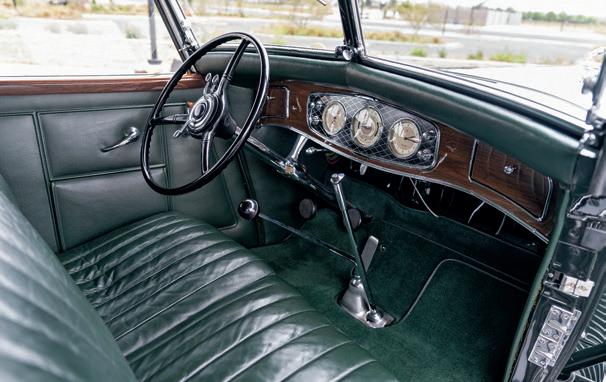
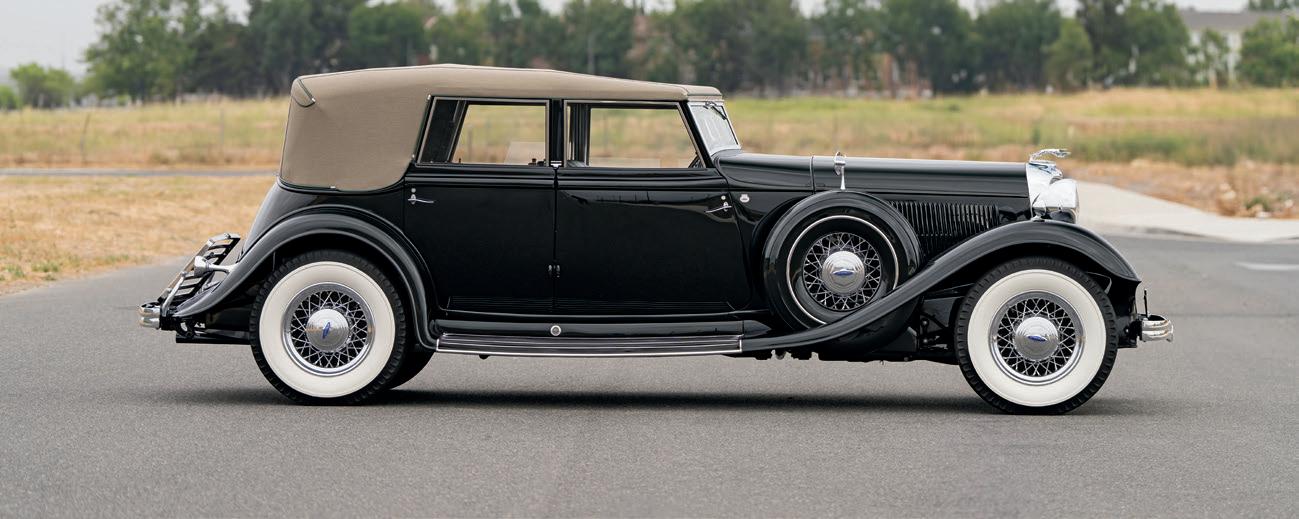
CHASSIS NO. 029
$700,000-$800,000
Conceived in secrecy following GM’s 1963 ban on corporate racing, the Bill Thomas Cheetah was Chevrolet’s unofficial answer to Carroll Shelby’s Cobra. Developed by Corvette performance specialist Bill Thomas, the Cheetah was a no-compromise sports racer – an audacious design with a front-mid-mounted 327 cid V-8. Weighing under 1,600 pounds and capable of over 180 mph, the Cheetah was a fearsome competitor in SCCA racing, setting speed records at Elkhart Lake and winning 11 races in 1964. But the dream was short-lived. By 1965, new FIA homologation rules increased the production minimum from 100 to 1,000 units. Only about two dozen Cheetahs were ever built, and only 12 were fully completed as turnkey cars by Bill Thomas Race Cars; chassis 029 is the final example completed.
The Final Cheetah Built at Bill Thomas Race Cars in Anaheim, California
Exceptionally Original and Unrestored Time Capsule
Fully Documented History with Period Photos and Correspondence
Just Four Devoted Owners from New Chevrolet’s Unofficial Answer to Carroll Shelby’s Cobra
Awarded Second Place in the Postwar Preservation Class at Pebble Beach in 2008
Commissioned in late 1965 by Edward King of Hamilton, Ohio, this Cheetah was intended as a street car. Construction began in December, and the car was completed in April 1966, making this the final Cheetah built at Bill Thomas Race Cars in Anaheim, California. Upon delivery, Mr. King made a handful of road-going modifications to satisfy state requirements, including the addition of mufflers, a windshield wiper, and driving lights. He also installed a Vertex magneto, favoring it over the standard Corvette distributor.
Mr. King’s ownership was brief; after just two years of careful ownership, he sold the car to Peter A. Holowczak of Parma, Ohio, in July 1968, trading it for a 1963 Split-Window, Fuel-Injected Corvette and a $4,500 loan. Mr. Holowczak
327 CID OHV V-8 Engine
Rochester Ramjet Mechanical Fuel Injection
375 BHP at 6,200 RPM
4-Speed Manual Gearbox
4-Wheel Hydraulic Cerametallic Drum Brakes
4-Wheel Independent Suspension


Edward King, Hamilton, Ohio (acquired new via Bill Thomas Race Cars in 1966)
Peter A. Holowczak, Parma, Ohio (acquired from the above in 1968
Mark Boen, Carmel, California (acquired from the above in 2007)
Current Owner (acquired from the above)
Pebble Beach Concours d’Elegance®, 2008 (2nd in Class)
The Quail, A Motorsports Gathering, 2019 (1st in Class)
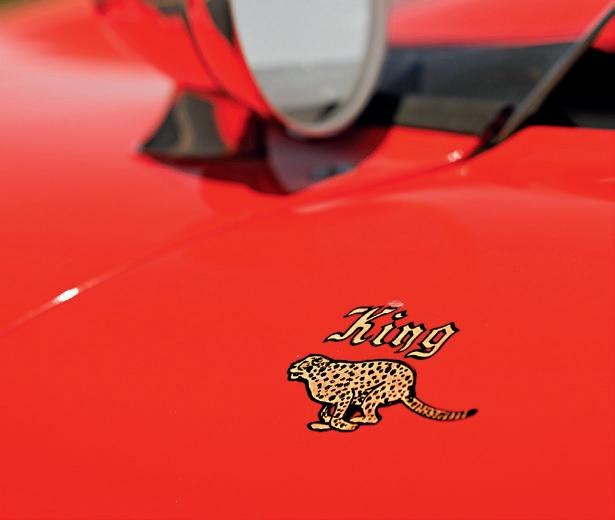
recalled working two jobs to pay off the debt, and so began an extraordinary 39-year period of preservation. During his ownership, from 1968 to 2007, the car was sparingly driven and carefully stored, retaining its original paint, interior, mechanicals, wheels, and even the same Firestone Indy tires it wore in 1968.
Mr. Holowczak’s passion also led to fastidious record-keeping. He documented his ownership with period photographs, detailed notes, and correspondence with fellow enthusiasts, including one admirer who would pursue the car for nearly three decades. That admirer was Mark Boen, who first contacted Holowczak in 1980 after seeing a classified ad in Autoweek. For 27 years, Mr. Boen maintained contact through letters and phone calls. Finally, in 2007, Mr. Holowczak agreed to sell, and the car was shipped to Mr. Boen in Carmel, California, the following month. Over the next 15 years of ownership, Mark and Veronica Boen would go on to carefully preserve the Cheetah, showing it at the Pebble Beach Concours d’Elegance®, where it received an impressive Second Place in the Postwar Preservation Class, and The Quail, A Motorsports Gathering until selling the car to its current owner in 2022.
Today, this extraordinary Cheetah remains in highly original condition, thanks to the stewardship of just four devoted owners, offering a time capsule example from one of the most ambitious chapters in American motor sports history.



COACHWORK BY PININFARINA
CHASSIS NO. 13047
ENGINE NO. 13047
$225,000–$275,000 without reserve
First shown at the Paris Motor Show in 1967, the 365 GT 2+2 was the most luxurious and best-equipped Ferrari model built to date. Featuring bodywork designed and built by Pininfarina, the 365 GT 2+2 was the first Ferrari equipped with standard power steering and brakes, as well as with the company’s first self-leveling rear suspension. The 320 bhp, 4.4-liter V-12 featured three twin-choke Weber carburetors and was good for sprints from rest to 60 mph in just over seven seconds, and a top speed of over 145 mph. Production of the model ceased in 1971, with just 809 examples built.
According to the research of marque historian Marcel Massini, this Ferrari 365 GT 2+2, chassis 13047, was completed in December 1969 and is believed to
HIGHLIGHTS
One of Only 809 Examples Built
US-Specification Model Delivered New Through Hollywood Sport Cars
Retains Matching-Numbers Engine and Original Oro Nasrullah Livery
Ferrari Classiche Certified; Offered with Books, Tools, and Warranty Card
Documented by Ferrari Historian Marcel Massini
be the first US-specification version built for the 1970 model year. Originally finished in the striking color scheme of Oro Nasrullah (Nasrullah Gold) over black leather upholstery, the Ferrari was delivered to Bill Harrah’s Modern Classic Motors, the factory’s official West Coast distributor.
Originally retailed through Chic Vandagriff’s Hollywood Sport Cars in Los Angeles, the Ferrari’s first owner was Walter Earl Brown, a Los Angeles resident. While it is not known how long Mr. Brown retained the Ferrari, it was later exported to Europe and sold to Dr. Norbert Reuter of Konstanz, Germany. Dr. Reuter undertook a cosmetic restoration, converted the instrumentation to kilometers for use in Europe, and fitted Plexiglas headlamp covers.
SPECIFICATIONS
4,390 CC SOHC V-12 Engine
Three Weber 40 DFI/5 Carburetors
320 BHP at 6,600 RPM
5-Speed Manual Gearbox
4-Wheel Hydraulic Disc Brakes
4-Wheel Independent Suspension with Coil Springs
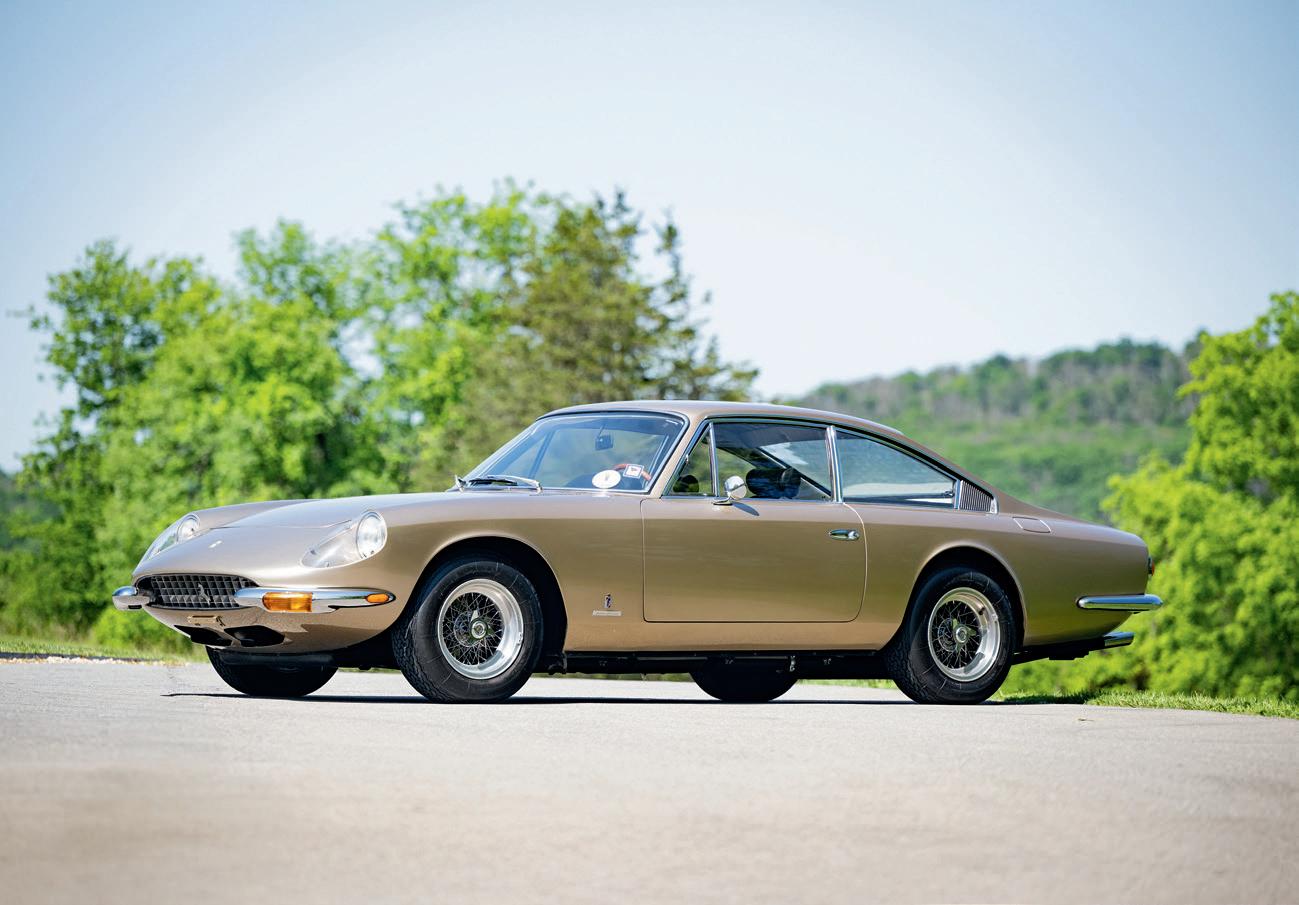

Walter E. Brown, Los Angeles, California (acquired new via Hollywood Sport Cars in 1970)
Dr. Norbert Reuter, Konstanz, Germany
Vantage Motorworks, Miami, Florida
Jean-Pierre Lacombe, Bernardsville, New Jersey
Motorcars of Distinction, West Palm Beach, Florida (acquired from the above in 2009)
Mark Sange, Bolinas, California (acquired in 2009)
Dr. Ajai Cadambi, Fort Worth, Texas (acquired from the above in 2012)
Private Collection, Houston, Texas (acquired from the above)
Current Owner (acquired from the above in 2017)
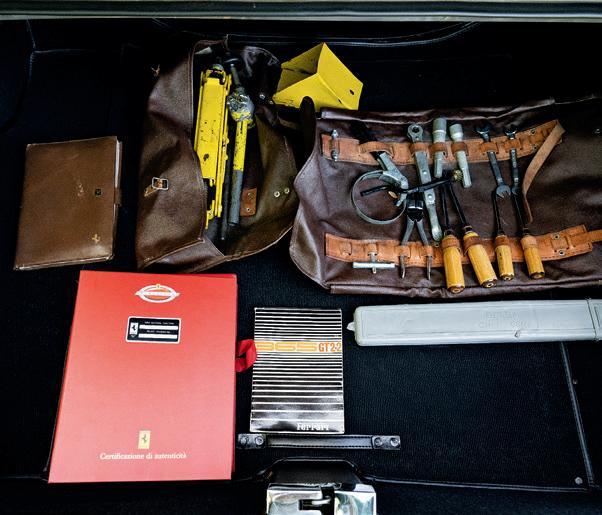
Ninth Annual Italian Carfest, Texas, 2012 (First in Class)
The next recorded private owner, Jean-Pierre Lacombe of Bernardsville, New Jersey, owned the Ferrari until 2009, and it then passed to California collector and vintage racer Mark Sange. Records on file document that Sange entrusted the 365 GT 2+2 to respected Ferrari specialist Patrick Ottis for service and maintenance. In 2012, Dr. Ajai Cadambi of Fort Worth, Texas, acquired the car from Sange and, during his ownership, displayed it at the Ninth Annual Italian Carfest, where it received a First in Class award.
Since 2017, 13047 has been tuned and maintained in the consignor’s formidable collection of postwar sports cars, and presents today as an excellent example of the fast and comfortable 365 GT 2+2. Beautifully finished in its striking original color scheme and equipped with optional Borrani wire wheels, it is accompanied by several important accessories, including a tool roll and handbook set, which contains the operation manuals as well as a warranty card, dealer directory, and Borletti air-conditioning pamphlet. Also included with the sale are the Ferrari Classiche Red Book, a report produced by Ferrari historian Marcel Massini, and a file of assorted service records and ownership documents. Impressively presented with a distinctive appearance and desirable features, this is a 365 GT 2+2 worthy of serious consideration.

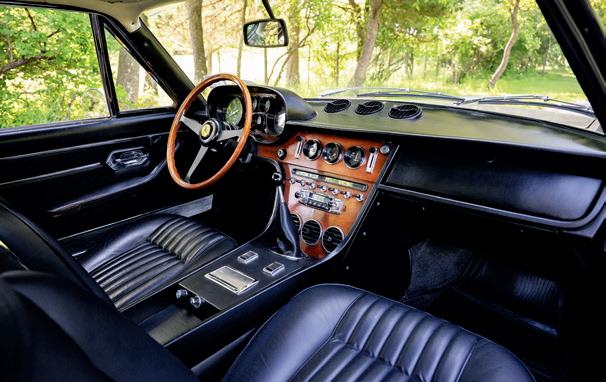

COACHWORK BY STABILIMENTI FARINA
CHASSIS NO. 183 SC
ENGINE NO. 286
$400,000–$500,000
Cisitalia’s founder Piero Dusio was not only an influential design visionary but also a gifted racing driver, finishing 1st in Class at the 1000 Miglia in 1937 and 4th Overall in 1938. By that time, he had created Compagnia Industriale Sportiva Italia (Cisitalia) and postwar, the company built the D46 Monoposto, the first race car to use a full space-frame chassis. At the 1000 Miglia in 1947, Cisitalia debuted the stunning, streamlined 202 SMM sports-racing car and Tazio Nuvolari piloted it to one of the most legendary drives in history, finishing 2nd to Clemente Biondetti’s mighty Alfa Romeo 8C 2900.
Cisitalia next created an advanced, road-going sports car based on the spaceframe design of its race cars. The resulting 202 SC Coupe debuted in 1947
HIGHLIGHTS
Beautiful Example of a Landmark Postwar Italian Sports Car
Benefits from Restoration Work by Italian Car Specialist Gipimotor of Belgium
Shown at Pebble Beach, Villa D’Este, and Amelia Island
A Veteran of Multiple Runnings of the 1000 Miglia Since 2012
Retains Matching-Numbers Engine per Original Data Tag
Accompanied by Tool Roll, FIVA Identity Card, and Extensive Documentation
and was immediately hailed as a design masterpiece. New York’s Museum of Modern Art (MoMA) famously exhibited an example in 1951, and a 202 remains in MoMA’s permanent collection to this day, along with only one other car, a Jaguar E-Type. Cabriolet versions of the 202 SC were even rarer than the coupes, and marque authority Nino Balestra believes only about 60 were built.
According to a summary of the car’s history on file, this gorgeous Stabilimenti Farina-bodied example, chassis 183 SC, was originally delivered to Bruno de Cillia of Austria. The Cisitalia eventually made its way to Belgium, and by the 2010s was owned by an enthusiast who wanted to enter it in the 1000 Miglia. He had noted Italian-car specialist Gipimotor of Belgium carry out substantial
SPECIFICATIONS
1,089 CC OHV Inline 4-Cylinder Engine
Twin Weber 36 DR3 Carburetors
63 BHP at 6,000 RPM
4-Speed Manual Gearbox
4-Wheel Hydraulic Drum Brakes
Front Independent Suspension with Transverse Leaf Spring
Rear Live Axle with Semi-Elliptical Leaf Springs
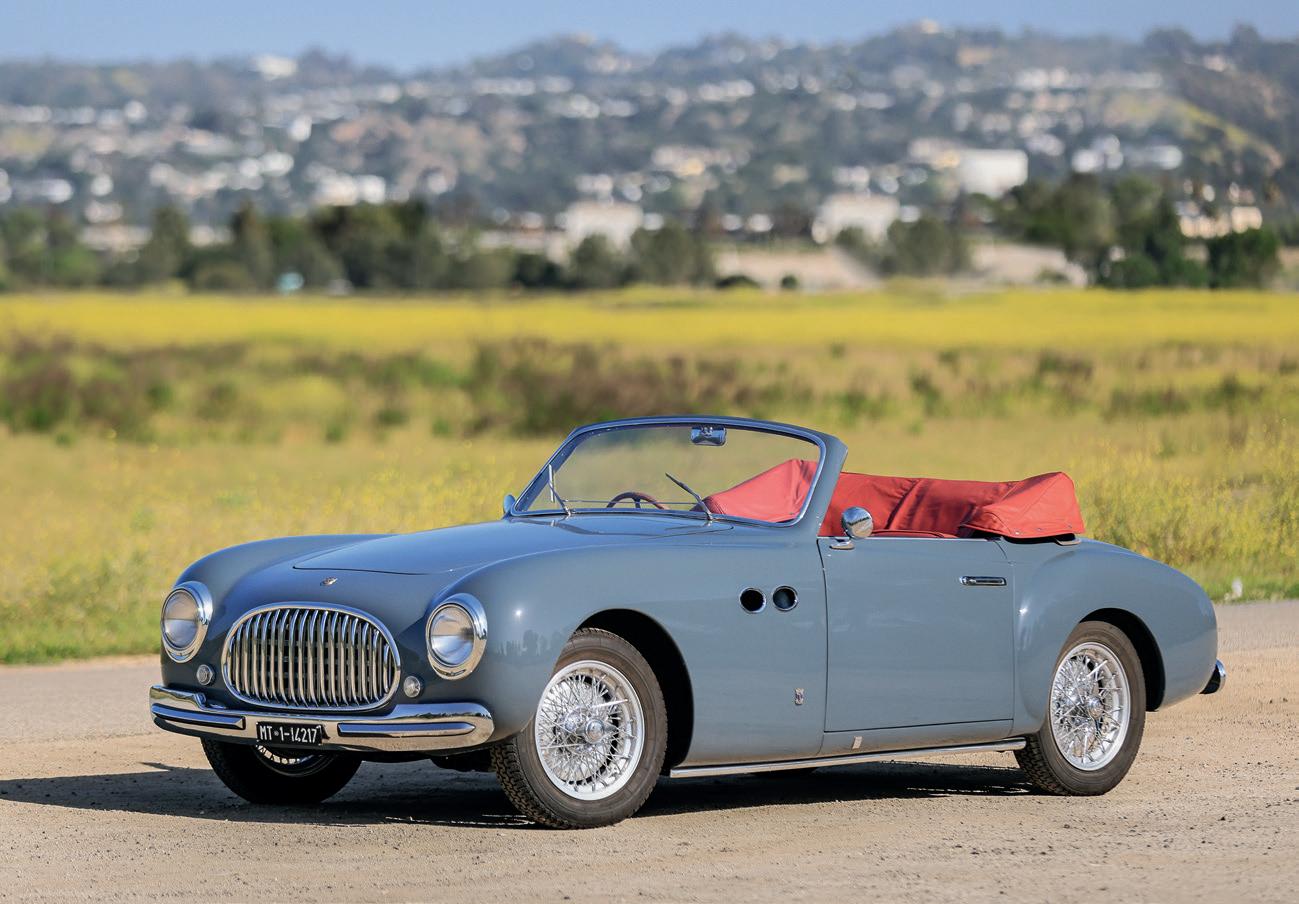

Bruno de Cillia, Austria (acquired new in 1952)
M. Bonnet, Brussels, Belgium (acquired circa 2008)
Current Owner (acquired in 2013)
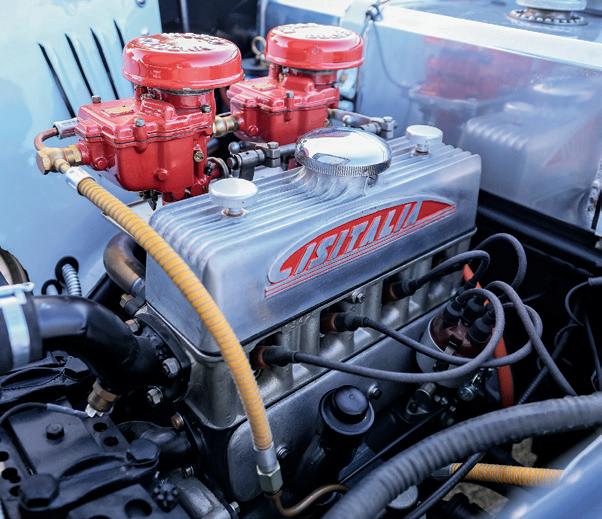
Uniques Special Ones Concours, Italy, 2012
1000 Miglia, Italy (2012, 2013, 2014)
Pebble Beach Concours d’Elegance®, 2014
Amelia Island Concours d’Elegance, 2015
Concorso d’Eleganza Villa d’Este, Italy, 2015
Cisitalia Catalogue Raisonne 1945-1965, by Bruno Alfieri and Cesare De Agostini
mechanical work in preparation, and the Cisitalia went on to participate in three runnings of the famous event. The 202 SC was sold into current family ownership in 2013, joining an impressive stable of some of the rarest coachbuilt Italian cars. After being treated to further restoration work, the Cisitalia was shown at the 2014 Pebble Beach Concours d’Elegance®, the 2015 Amelia Island Concours d’Elegance, and the 2015 Concorso d’Eleganza Villa d’Este – a testament to its quality and enduring historical significance.
In addition to its impressive exhibition history, this 202 SC has incredible visual appeal, with its Stabilimenti Farina coachwork finished in an elegant shade of gray over a stunning red interior. Importantly, the Cisitalia retains its matching-numbers engine per its original data tag, which has been carefully preserved in the car’s accompanying file. Further documentation includes extensive records, correspondence, photos, and a FIVA identity card.
Having participated multiple times in one of the world’s most challenging rallies and exhibited at the most exclusive concours d’elegance, this Gran Sport Cabriolet is a truly outstanding example of the groundbreaking Cisitalia 202 SC – one of the most influential automobiles of the 20th century.

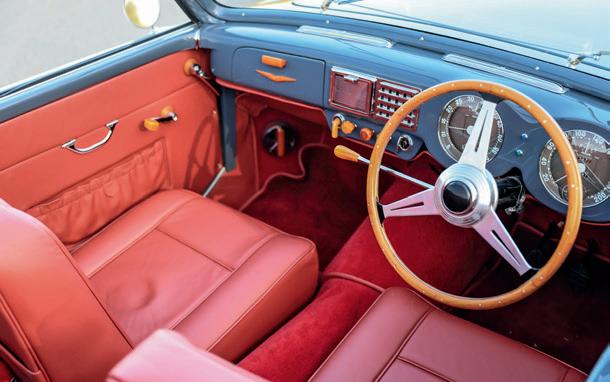

CHASSIS NO. CSX 3011
$2,250,000–$2,750,000
In late 1963, a group of Shelby American employees led by racing driver Ken Miles met to conceive the company’s next Cobra-based racing car with a goal of besting Ferrari on long European circuits like the Nürburgring, Monza, and Le Mans. The outgoing 289-powered Competition Cobras were campaigned with immense success, but could not reliably produce over 400 hp, which was needed to compete going forward. The solution proposed by Miles was to install Ford’s NASCAR-specification 427 cid big-block V-8 engine which featured cast-aluminum heads, oil pan, high-rise manifold, and timing chain. This platform could reliably produce 485 hp at 6,500 rpm for hours on end.
In order to house the new engine in the Cobra’s chassis, the distance between
HIGHLIGHTS
Exceedingly Rare as One of Just 23 Competition Examples Built
Retained by Shelby American for the Cobra Caravan Press Tour
Featured in the 1966 Elvis Presley Film Spinout
Originally Owned and Raced by Formula One Driver Moisés Solana
Restoration Performed by Specialists Cobra Automotive Inc.
the front longitudinals was widened from 17” to 22”, leading to wider bodywork, which required the construction of a new body buck at AC Cars. Additionally, the front suspension was upgraded from the outgoing transverse leaf spring to modern independent front suspension utilizing swing arms and integral coil shocks. Shelby set out to build 100 examples of the 427 Competition to meet FIA homologation requirements, but ultimately just 23 examples were completed, meaning the car’s competition application was limited to privateer teams competing in SCCA as opposed to larger venues in Europe.
The Cobra 427 Competition model presented here, chassis CSX 3011, was invoiced by AC Cars on January 11, 1965, and completed by Shelby American
427 CID OHV V-8 Engine
Holley 4-Barrel 780 CFM Carburetor
Estimated 485 BHP at 6,500 RPM
4-Speed “Top-Loader” Gearbox
4-Wheel Girling Disc Brakes
4-Wheel Fully Independent Suspension with A-Arms and Integral Coil
Shock Absorbers

Moisés Solana, Mexico City, Mexico (acquired new via Shelby American in 1966)
Juan Carlos Bolaños, Mexico City, Mexico (acquired from the estate of the above in 1969)
Jim Southard, Marietta, Georgia (acquired in 1978)
Lorne Leibel, Ontario, Canada (acquired in 1980)
Private Collection (acquired from the above in 1993)
Lorne Leibel, Ontario, Canada (reacquired from the above in 2006)
Current Owner (acquired from the above)
on May 14. Built as part of the first run of nineteen 427 Competition chassis, this car was the only example of this initial group that was not invoiced to a privateer racing team. Instead, the car was retained by Shelby American for promotional purposes.
By September 1965, the Cobra was painted Guardsman Blue with white stripes. Shelby lent the car, along with a road-going 427, to Jerry Titus for the November 1965 issue of Sports Car Graphic magazine. In the article, “Cobras for Street & Competition,” Titus tests the car at Riverside Raceway and summarizes its driving dynamics, writing, “Obviously, the 427 Cobra is a brute. There’s no other word for it…it took a lot of horsing and a very hot approach to get hung into a drift that would allow the power to be turned back on. Otherwise, throttle-application only produces more of the ‘let’s-go-straight’ attitude.”
This 427 was also part of the famed Cobra Caravan, a publicity tour in which a GT 350 R, Cobra Daytona Coupe, and GT40 were shown alongside this car in 12 cities around America to celebrate the Daytona Coupe’s 1965 World Championship victory.
Next, in February 1966, CSX 3011 was loaned to MGM Studios for use as the hero car in the film Spinout, starring Elvis Presley. MGM retained the car for 10
Shelby American Automobile Club Convention 32, Utah, 2007
Shelby American Automobile Club Convention 36, Virginia, 2011 (Gold Award in Class)
weeks at a cost of $4,000. In the film, Presley plays rock singer Mike McCoy, who is touring with his band and also races a white Cobra, towing the car to the Santa Fe Road Races with a Duesenberg Model J Sport Phaeton (J-116). Original Guardsman Blue paint is visible under the Cobra’s hood in various scenes.
CSX 3011 found its first private owner in October 1966, in Formula 1 driver Moisés Solana. He ordered the racing Cobra through Ford of Mexico, at a cost of $11,393 and specified that shoulder harnesses be fitted. Solana reportedly campaigned the car throughout Mexico and the US under Grupo Iuso sponsorship, as seen in copies of period photographs on file.
Solana would retain the Cobra until his untimely passing on July 27, 1969, when he wrecked a McLaren M6B at the Valle de Bravo-Bosencheve Hillclimb, west of Mexico City. His friend and fellow racing driver Juan Carlos Bolaños purchased the Cobra from his estate and continued to campaign it throughout Mexico. At the Presidential Grand Prix in 1973, Bolaños was leading when he pulled the Cobra into the pits, and a fire broke out due to a fuel spill. Following this pit fire, the Cobra was repainted red. Bolaños continued to race the car until, one day at the Hermanos Rodriguez circuit, he lent the car to driver Manuel Cardona. Cardona lost control on the circuit’s famous banked Peraltada corner, damaging the Cobra’s nose.


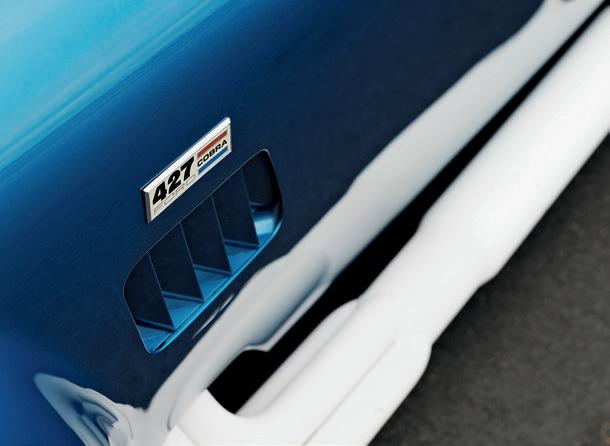
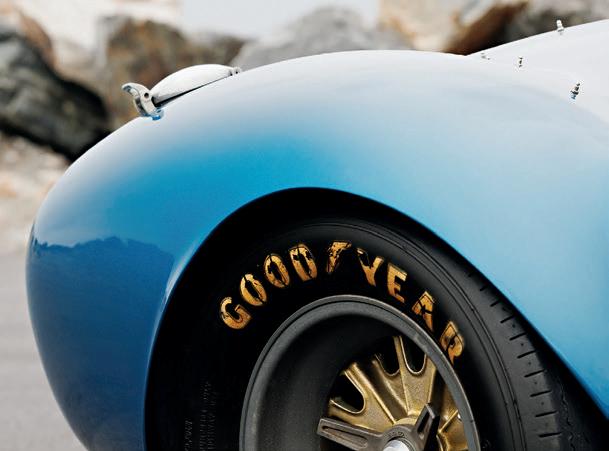

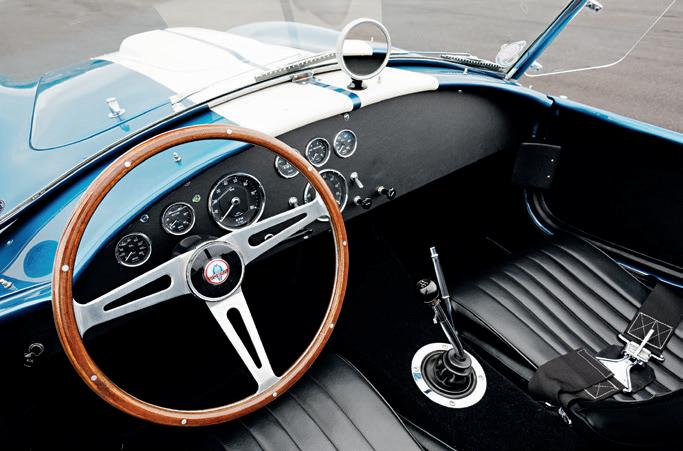
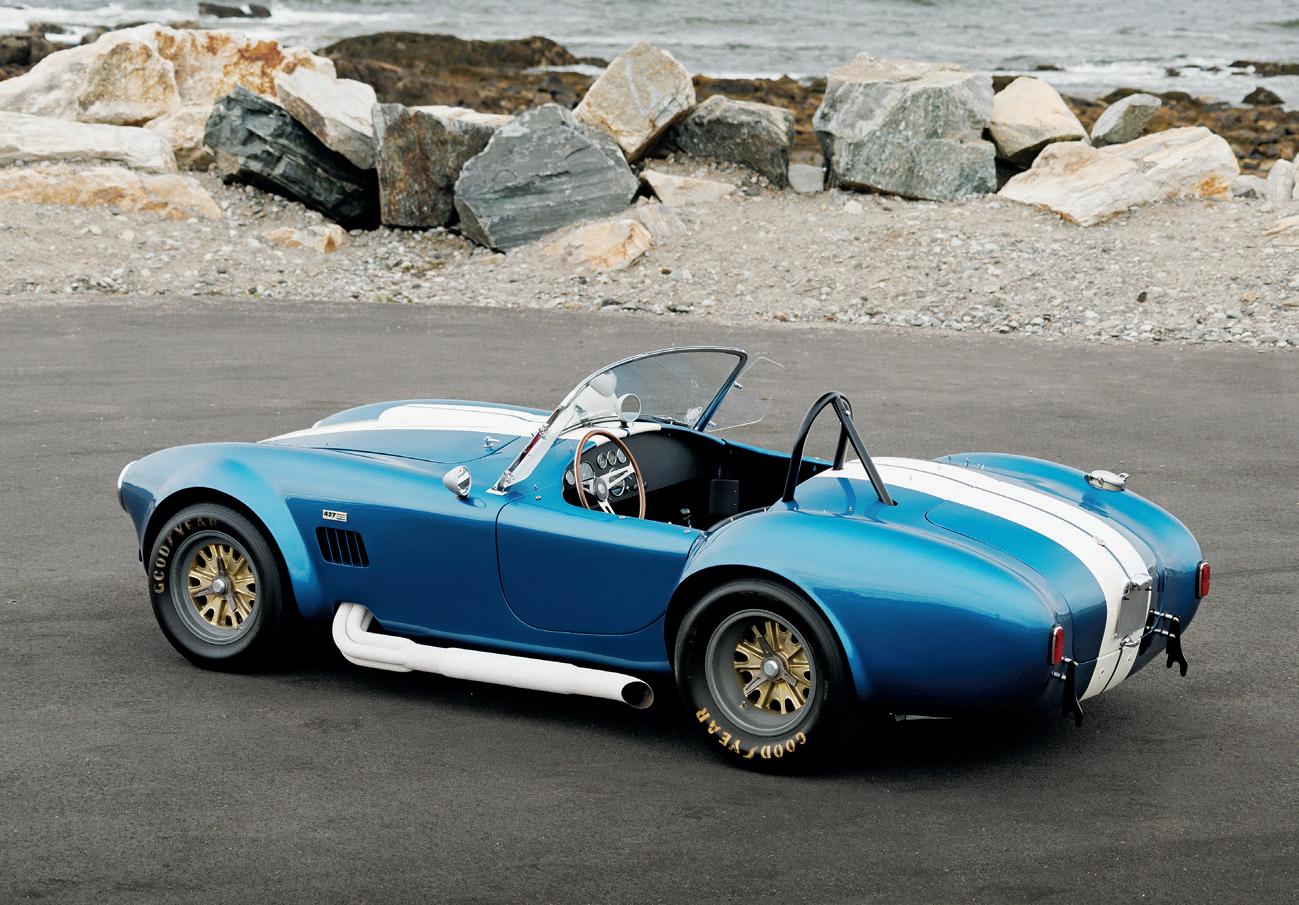

Spinout, 1966, film
Sports Car Graphic, November 1965, “Cobras for Street & Competition,” by John Christy and Jerry Titus
World Registry of Cobras & GT40s, by Rick Kopec
Well-known Cobra and sports car enthusiast Jim Southard of Marietta, Georgia, discovered the dormant Competition Cobra in Mexico in 1978, and later sold the car to collector Lorne Leibel of Ontario, Canada, on April 9, 1980. Leibel enlisted Chuck Gutke’s Cobra Restorers of Kennesaw, Georgia, to restore the aged Cobra, utilizing new aluminum coachwork built by Brian Angliss. During this restoration, the car was finished in Rangoon Red. The 427 engine’s aluminum cylinder heads were also replaced at this time and semi-competition-style twin Holley carburetors were installed.
Leibel sold the Cobra to a private collector in 1993 and reacquired it in 2006, having regretted parting with the car.
In an effort to return CSX 3011 to its press duties specifications, Leibel entrusted specialists Cobra Automotive Inc. of Wallingford, Connecticut, to perform a complete restoration. Multiple SAAC judges and other Shelby historians were engaged to restore the car as accurately as possible – and correspondence on file documents over $282,000 in expenses. The Cobra made its post-restoration debut at the 2011 SAAC-36 in Alton, Virginia, where the incredibly powerful and fast Competition Cobra was met with great acclaim and awarded Gold in Class.
Now a part of a significant collection of sports and racing cars in the Northeastern US, CSX 3011 sits in a league of its own, with its early Shelby American press duties and Elvis Presley screen time. Moreover, it is one of just 23 Competition chassis built – only a handful of which exist today.
Having been returned to its September 1965 configuration of Guardsman Blue with white stripes, black-painted, single-roll hoop, full windshield, white exhaust pipes, and proper single Holley 780 CFM carburetor, this Competition Cobra is sure to be a welcome entry at the most exclusive concours, vintage racing events, and vintage Shelby and Cobra gatherings worldwide.
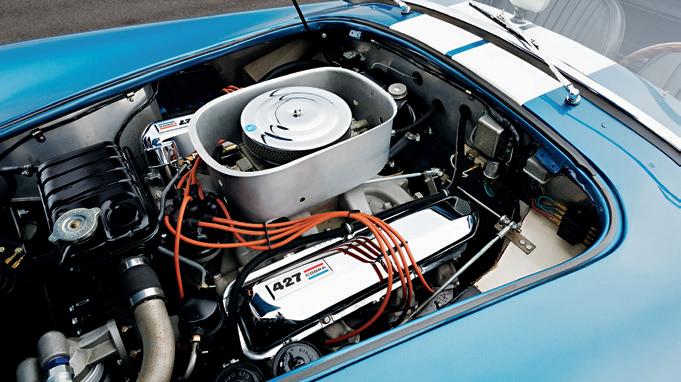


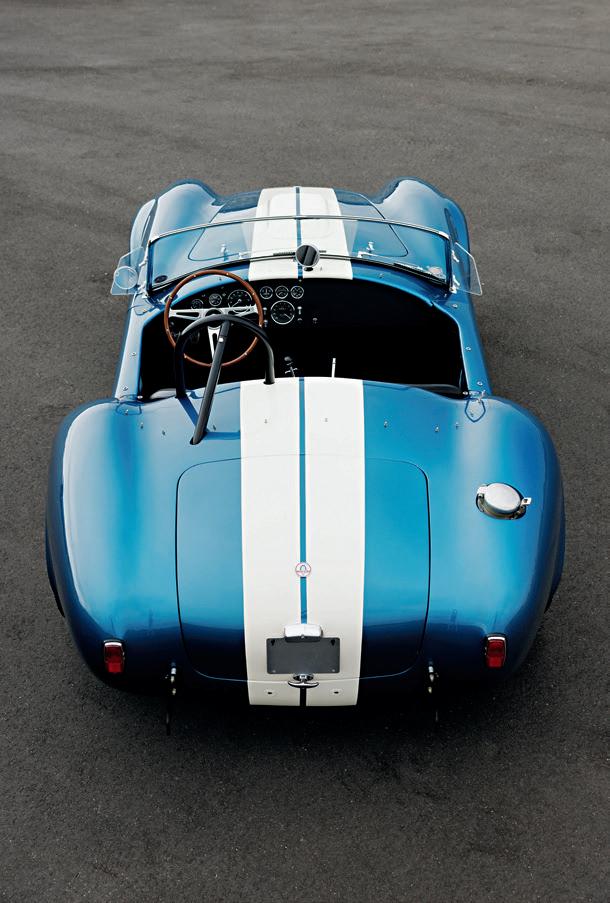
COACHWORK BY TOURING
CHASSIS NO. 826.134-1098
ENGINE NO. 826.100 *1385*
$180,000–$220,000 without reserve
Exceedingly rare as one of only 180 examples bodied with Superleggera (Superlight) coachwork by Carrozzeria Touring, this Lancia Flaminia 2800 3C Convertible is also equipped with the most powerful “3C” V-6 engine displacing 2.8-liters with three Weber downdraft carburetors. It benefits from photo-documented restoration work which commenced in 2019. Restoration highlights included a repaint in red, including the removable hard top, reupholstering in Biscuit leather, and installation of the refurbished black soft top. Its carburetors were rebuilt and tuned, and a new exhaust system was installed along with an MSD capacitive discharge ignition system. The undercarriage and suspension were also attended to and refinished, the radiator was restored, a new water pump was installed, and the brake servo was rebuilt. In fine Lancia tradition,
HIGHLIGHTS
One of 180 Convertibles Built with Carrozzeria Touring Coachwork
Highly Desirable Triple-Carbureted 3C Specification
Benefits from Photo-Documented Restoration Work
Fitted with Desirable and Recently Repainted Hardtop
Accompanied by Workshop and Parts Manuals, Restoration Photographs, Tool Kit, and Documentation
stopping is provided by four-wheel disc brakes, inboard at the rear. Refinished, 16" factory steel wheels were mounted with Michelin radial tires. Its lovely Jaeger instruments include an integrated clock, 140 mph speedometer, and 6,500 rpm tachometer. Other features include a Becker Mexico AM/FM radio and wood-rimmed, three-spoke steering wheel.
The Lancia’s documentation dates to the 1990s and a March 1979 Lanciana publication shows the Flaminia’s engine had been rebuilt at 58,000 miles, with the car showing approximately 85,000 miles at the time of cataloguing. A charming convertible and rare piece of Lancia history, this Flaminia is sure to excite even the most seasoned Italian car enthusiast.
SPECIFICATIONS
2,775 CC OHV Alloy V-6 Engine
Three Weber Downdraft Carburetors
146 BHP at 5,400 RPM
4-Speed Manual Transaxle
4-Wheel Servo-Assisted Disc Brakes, Inboard Rear
Front Independent Double-Wishbone Suspension with Coil Springs
Rear De Dion Axle with Semi-Elliptical Leaf Springs and Panhard Rod


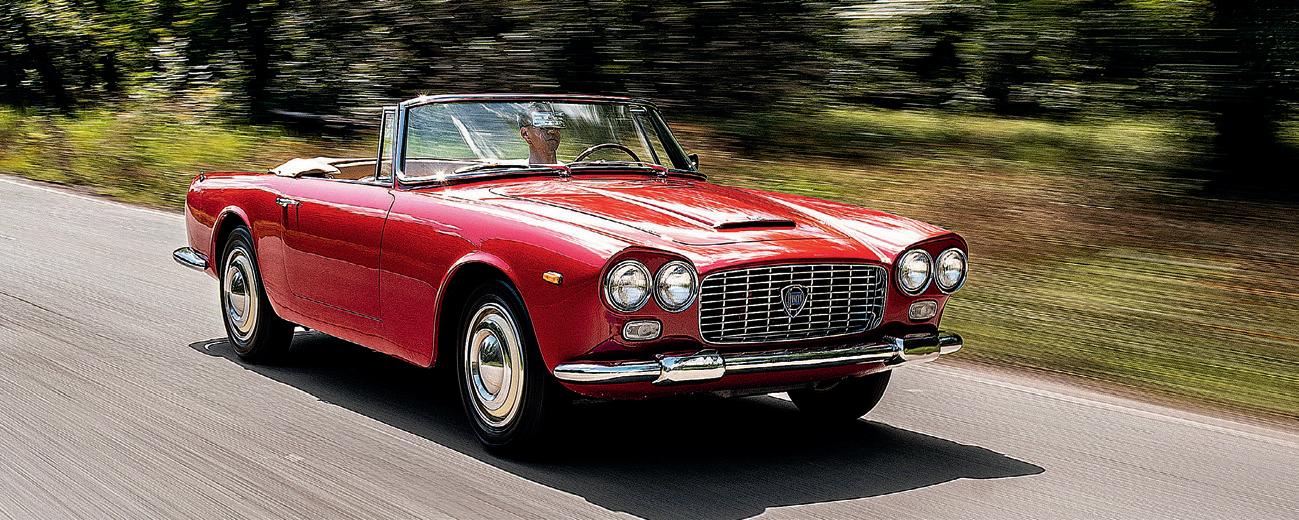

COACHWORK BY PININ FARINA
CHASSIS NO. 0379 GT
ENGINE NO. 0379 GT (SEE TEXT)
$1,000,000–$1,200,000
At the Paris Salon de l’Automobile, held in October 1954 at the magnificent Grand Palais, Ferrari introduced an important new model – the 250 Europa GT.
The previous year, Ferrari had unveiled the 250 Europa, a companion to the exclusive 375 America. The two models were virtually identical, with the exception of their engine displacement: the 375 America featured a 4.5-liter Lampredi V-12, while the 250 Europa was fitted with a similar V-12 of three-liter capacity.
The foundation of the new Europa GT was the thoroughly redesigned Tipo 508 chassis, which featured a wider track and shorter wheelbase. Most significantly, the Europa GT benefited from independent coil-spring front suspension, a major
HIGHLIGHTS
A Landmark Ferrari Road Car; The 12th of Only 43 Europa GTs Built Displayed on the Pinin Farina Stand at the 1955 Torino Motor Show Delivered with Unique Nose Treatment and Rectangular Driving Lights
Accompanied by Original Block and Other Major Engine Components
An Ideal Candidate for a Concours-Quality Restoration Documented by Marcel Massini and Copies of Factory Build Sheets
improvement over the previous model’s transverse leaf-spring arrangement. Thanks to its modern coil-spring front suspension and more manageable proportions, the 250 Europa GT offered superior road holding, more precise handling, and greater stability at speed.
Whereas the original 250 Europa was powered by a three-liter version of the Lampredi long block, the new Europa GT was the first road-going 250 model to utilize the classic Colombo-designed V-12. This family of engines can be traced back to the earliest days of the marque, and were responsible for some of Ferrari’s greatest achievements in motor sports. In addition to its upgraded engine, the Europa GT featured an improved gearbox, utilizing Porsche-type
SPECIFICATIONS
2,953 CC Tipo 112 SOHC 60º V-12 Engine
Three Weber 36 DCZ3 Carburetors
Estimated 220 BHP at 6,600 RPM
4-Speed Manual Gearbox
4-Wheel Hydraulic Drum Brakes
Front Independent-Wishbone Suspension with Coil Springs and Shock Absorbers
Rear Live Axle with Semi-Elliptical Leaf Springs
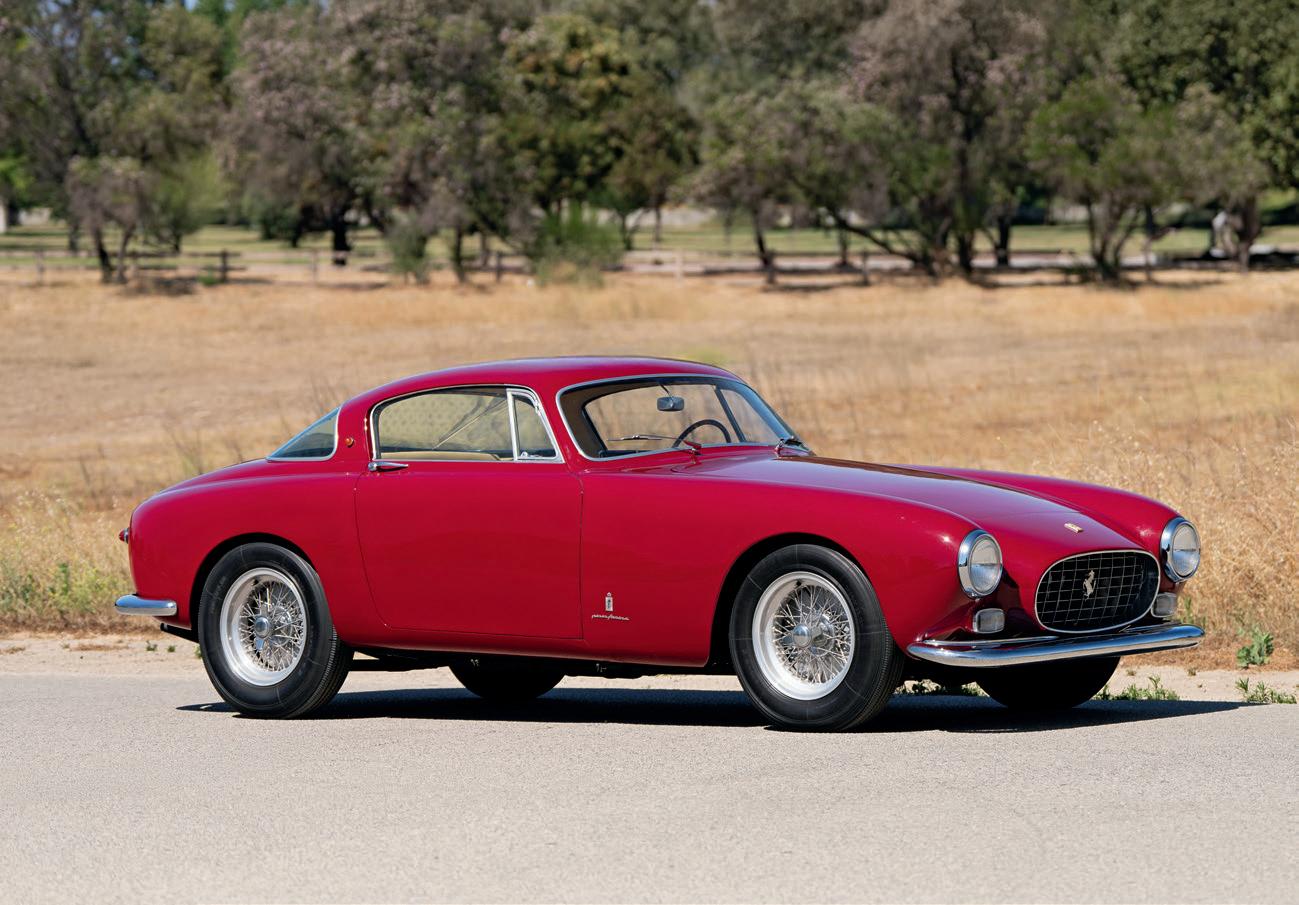

Commendatore Francois Ferrario, Rome, Italy (acquired new in 1955)
Mr. Copecki, US (acquired circa 1958)
Mr. Rossi, US (acquired from the above circa 1962)
Tiebo P. Vos, South Carolina (acquired circa 1970s)
James A. Piper, Newport Beach, California (acquired circa 1982)
Robert Butler, Los Angeles, California (acquired circa 1991)
Private Collection, US (acquired in 1995)
Current Owner (acquired from the above)
synchromesh on all four forward gears, allowing for fast, seamless shifting.
As with the original Europa, the GT chassis was almost exclusively tailored by Carrozzeria Pinin Farina. The handsome design was instrumental in defining the “Ferrari look,” with its imposing eggcrate grille, elegant proportions, and restrained yet sporting lines. Though similar to the original 250 Europa and 375 America, Pinin Farina’s design for the 250 Europa GT is perhaps even more harmonious due to the compact scale of the chassis.
Although it was primarily designed for high-speed grand touring, the 250 Europa GT was so technically advanced that many owners entered the model in motor sports events such as the Tour de France, where they were immediately successful and highly competitive.
Ferrari completed the Europa GT offered here, chassis 0379 GT, on November 27, 1954. The 12th example of 43 units built, it was sent to the Pinin Farina workshops, where it was cloaked in its elegant and unique bodywork. Displayed by the coachbuilder at its stand during the 1955 Torino Motor Show and depicted in Antoine Prunet’s The Ferrari Legend: The Road Cars, this particular Europa GT was distinguished by additional fared-in rectangular driving lights, with distinctive chrome trim and a cavallino rampante (prancing horse) adorning
Torino Motor Show, Italy, 1955
Pebble Beach Concours d’Elegance®, 1989
the typical Pinin Farina eggcrate front grille.
After the show, this Europa GT was sold to its first owner, Commendatore Francois Ferrario, a prominent cinematographer in Rome who also owned an earlier 250 Europa Coupe. As noted by Ferrari historian Marcel Massini, two years later this car was sold and exported to the US, where it evidently changed hands several times and was separated from its original engine.
Circa 1982, the Europa GT was sold to James A. Piper of Newport Beach, California, who commissioned Rod Drew’s Francorchamps of America to restore the car. Refinished in its present color combination of deep red over tan leather interior, the Europa GT was exhibited by Mr. Piper at the 1989 Pebble Beach Concours d’Elegance®. Chassis 0379 GT eventually joined a large private collection in the mid-1990s and remained a fixture in an impressive stable of classic Ferraris until its recent acquisition by the consignor.
Today, this unique Europa GT still presents well cosmetically. However, with limited use following its refurbishment, and a long period in static storage, it may require recommissioning work. The interior configuration differs from other Europa GT models and features a competition-style dashboard and bucket seats instead of the typical appointments. Mechanically, this car is fitted with a

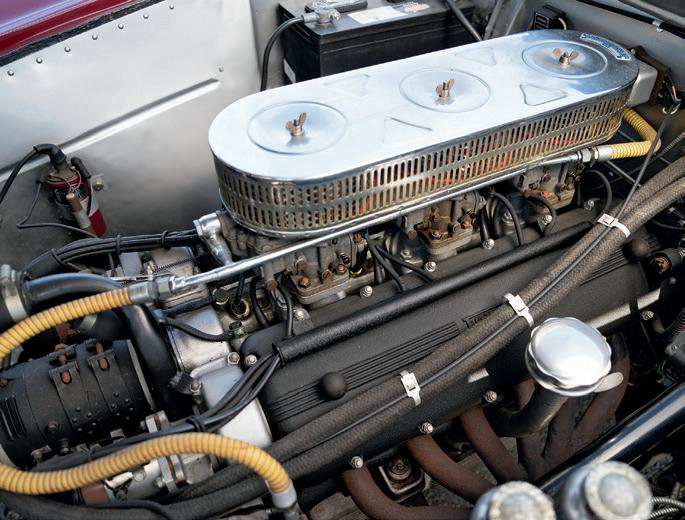


The Ferrari Legend: The Road Cars, by Antoine Prunet Ferrari Serial Numbers, Part I, by Hilary A. Raab Jr. Prancing Horse, No. 94, 1990, “250 Europa & 250 GT Europa,” by Alan Boe
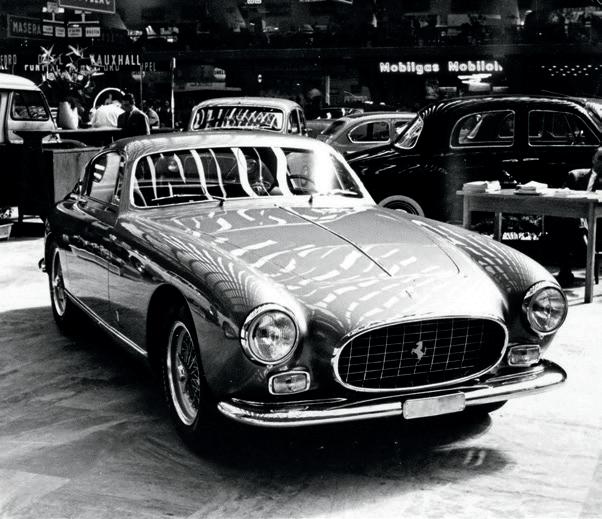
tipo 128C inside-plug 250 GT engine (internal no. 0246C) with front-mounted distributors and Weber 36 DCZ3 carburetors. Most importantly, the car also is accompanied at auction by its original, disassembled engine, correctly stamped 0379 GT with internal no. 329. This block shows significant welding around the cylinder bores and will require repairs. The engine also comes with cylinder heads, timing chest, liners, carburetors, sump, and other major components, all of which will be available for viewing at the auction site.
One of the first road-going Ferraris to bear the famed 250 moniker, the Europa GT is eligible for a variety of prestigious motoring events. Due to this Europa GT’s custom coachwork, and its history as the 1955 Torino show car for Pinin Farina, this example presents an even more exceptional proposition. It awaits an astute collector who will decide how to write the next chapter of its history.
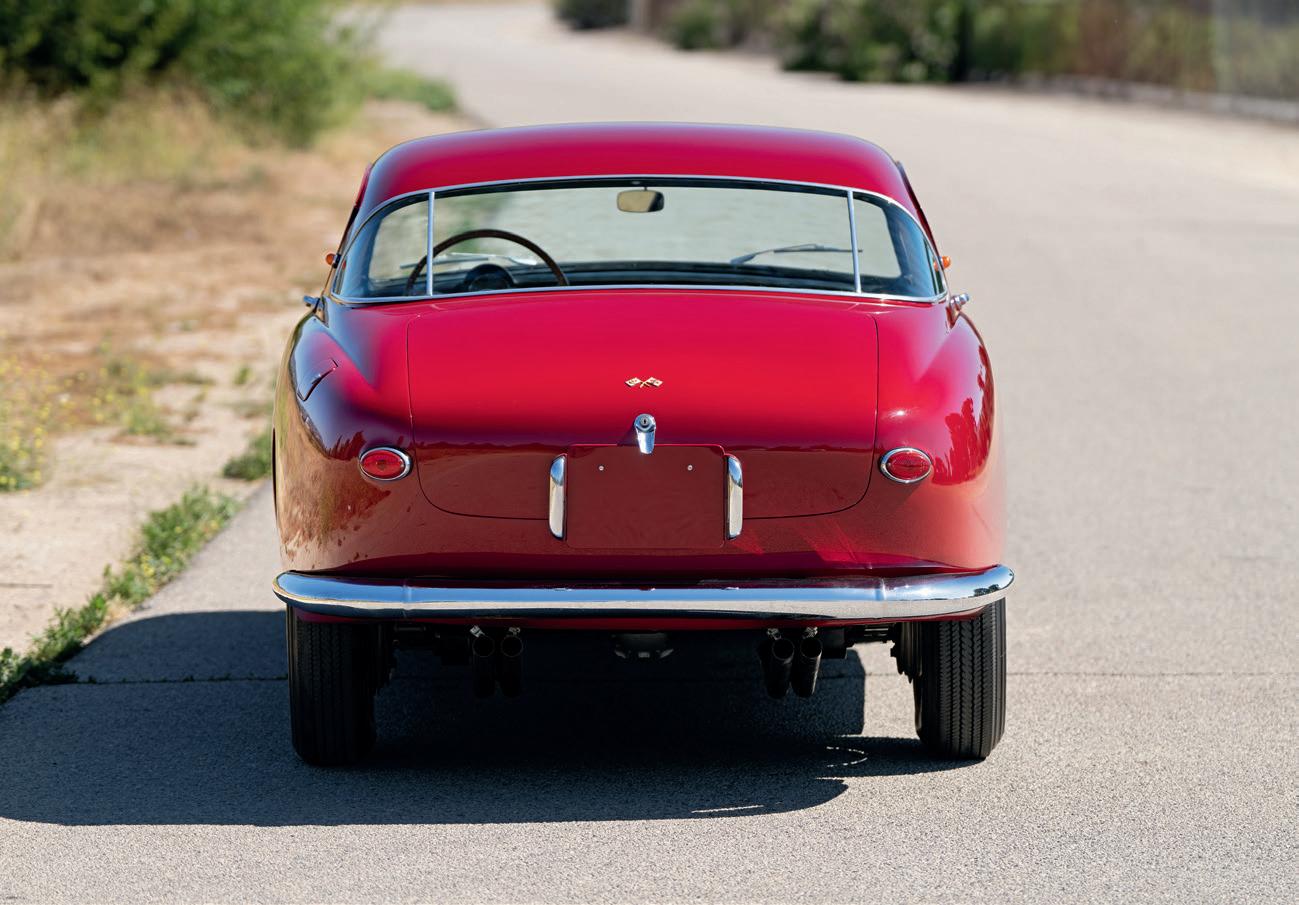
VIN. WP0CF2A91KS172355
$400,000–$450,000
Porsche officially unveiled the 991-generation Speedster at the April 2019 New York International Auto Show, marking the 70th anniversary of the marque’s first production car. With production limited to just 1,948 examples worldwide, the new Speedster was both a tribute to the original 356 Speedster and a swan song for the outgoing 991 series.
Although visually distinctive with its shortened, steeply raked windscreen and signature double-hump rear deck lid, the Speedster was underpinned by proven GT3 hardware. Power came from a naturally aspirated 4.0-liter, flat-six engine derived from the 991.2 GT3, developing 502 hp at 8,400 rpm. The engine was paired exclusively with a six-speed manual gearbox, eschewing Porsche’s
HIGHLIGHTS
One of 1,948 Type 991 Speedster Models Built
Finished in Paint-to-Sample Brewster Green with Special Wish Interior Pristine Example Displaying 656 Miles when Catalogued
Generously Equipped; Original Retail Price of $326,180
Accompanied by Original Window Sticker, Owner’s Manuals, Service Records, Car Cover, and CARFAX Vehicle History Report
dual-clutch PDK gearbox in favor of a more involving analog driving experience. Performance was impressive, with Porsche claiming 0–60 mph in 3.8 seconds and a top speed of 192 mph, remarkable figures for a car that prioritized driver connection over outright efficiency. Chassis components, including rear-wheel steering, dynamic engine mounts, and carbon ceramic brakes, were also sourced from the GT3. Carbon fiber front fenders, hood, and rear deck lid, along with a manually operated fabric roof, contributed to a curb weight of 3,230 pounds, just 36 pounds more than the GT3.
This 2019 Porsche 991 Speedster is finished in paint-to-sample, non-metallic Brewster Green over a special wishes, custom-tailored extended black leather
3,996 CC DOHC Flat 6-Cylinder Engine
Direct Fuel Injection
502 BHP at 8,400 RPM
6-Speed Manual Transaxle
4-Wheel Carbon Ceramic Brakes
Front Independent Suspension with MacPherson Struts
Rear Independent Multi-Link LSA Suspension
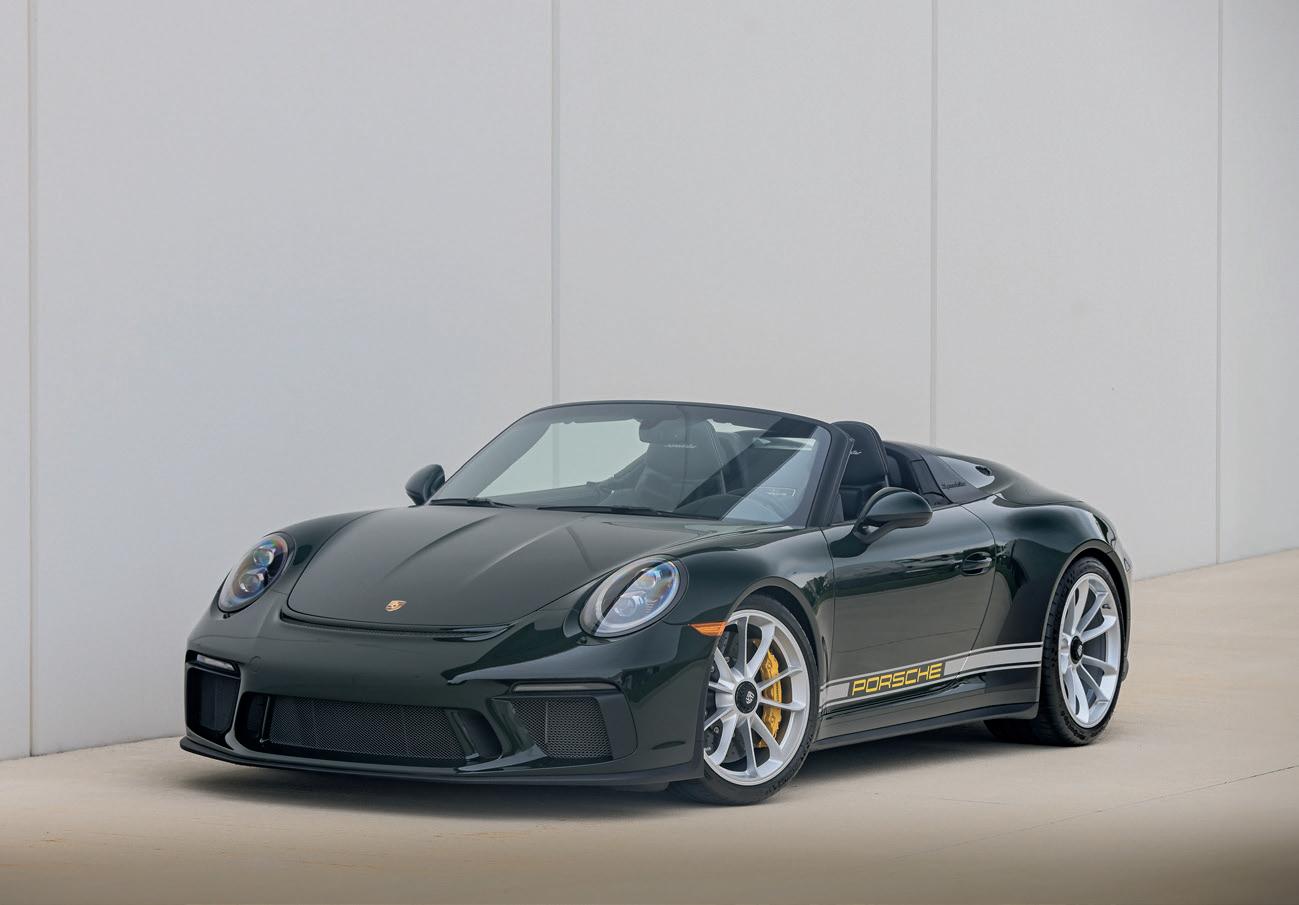

Private Collection, Texas (acquired new in January 2020)
Rene Isip, Frisco, Texas (acquired in September 2020)
Current Owner (acquired from the above)
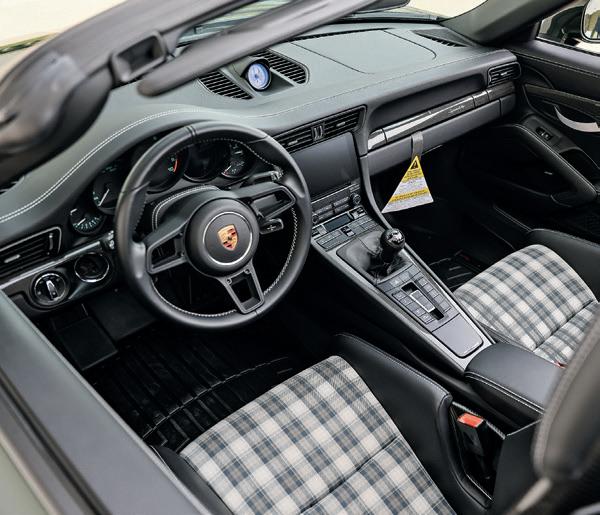
interior with tartan cloth inserts and deviated silver stitching. As the 1,237th of 1,948 units built per its serialized plaque, this car was delivered new via Porsche North Houston in Texas, in January 2020.
According to its accompanying window sticker, which displays a total price of $326,180, this car was generously optioned with additional features and customizations including a front-axle lift system, extended-range 23.7-gallon fuel tank, Satin Aluminum-finished wheels, light design package, Bose surround sound system, leather-wrapped air vent surrounds and slats, leather door panel trim, auto-dimming mirrors with integrated rain sensor, Chrono package, LED headlights with Porsche Dynamic Light System (PDLS), and silver-gray seat belts.
Acquired by the consignor in 2021, this Speedster appears virtually as new, showing just 656 miles when catalogued and maintained within the owner’s collection. Accompanied by its original window sticker, manuals, service records, car cover, and CARFAX Vehicle History Report, this exceptionally preserved 991 Speedster offers a rare mix of motor sports pedigree, bespoke options, and limited-production appeal. With GT3 performance and a striking paint-to-sample finish, it stands as a tribute to Porsche’s heritage and a highlight of the modern era.

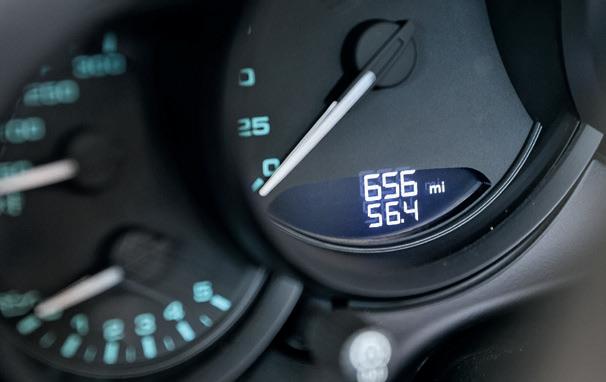

2019 PORSCHE 991 SPEEDSTER LOT 174
COACHWORK BY H.J. MULLINER
CHASSIS NO. BC2LC
ENGINE NO. BCC2
$900,000–$1,200,000
With all the accolades given to vintage Bentleys, one postwar model – the R-Type Continental Fastback – stands apart as a true masterpiece.
Unveiled at the 1951 Paris and London motor shows, the “Continental Sports Saloon” was hailed as the fastest, true four-seater in the world and the most expensive production car at £4,980. Owners enjoyed a top speed of 120 mph with effortless comfort and unmatched style.
Of the 207 R-Type Continentals built, 192 were bodied by H.J. Mulliner in the now-iconic Fastback style. Based on the prototype affectionately known as “Olga,” the design is a stunning example of custom coachbuilding in the early
HIGHLIGHTS
Elegant, Tastefully Restored Example of an Iconic Bentley Model
One of Only 207 R-Type Continentals Built; Just 43 in Left-Hand Drive
Factory Equipped with Lightweight Seats, Manual Gearbox, and Radio
Delivered New to DuPont Heir William Kemble Carpenter
Provenance Includes Dr. Samuel L. Scher and John Seward Johnson II
Maintained in Private East Coast Collections for the Past 25 Years
postwar era. From the raked grille and curved windscreen to the finned rear fenders, the design perfectly captures the Continental’s graceful, high-speed capabilities.
Mulliner collaborated extensively with Bentley’s design team and even consulted Pinin Farina in the early stages. Aerodynamic testing with a quarter-scale clay model helped achieve a drag coefficient of just .388 – better than the Malcolm Sayer-designed Jaguar E-Type. Weight reduction was also central to the design, achieved through Mulliner’s all-aluminum construction using Reynolds alloy. Even the carpets, leather, and “aero-grade” glass were selected for their lightweight properties.
SPECIFICATIONS
4,566 CC OHV Inline 6-Cylinder Engine
Twin SU H6 Carburetors
Estimated 153 BHP
4-Speed Manual Gearbox
4-Wheel Servo-Assisted Drum Brakes
Front Independent Coil-Spring Suspension
Rear Live Axle with Semi-Elliptical Leaf Springs
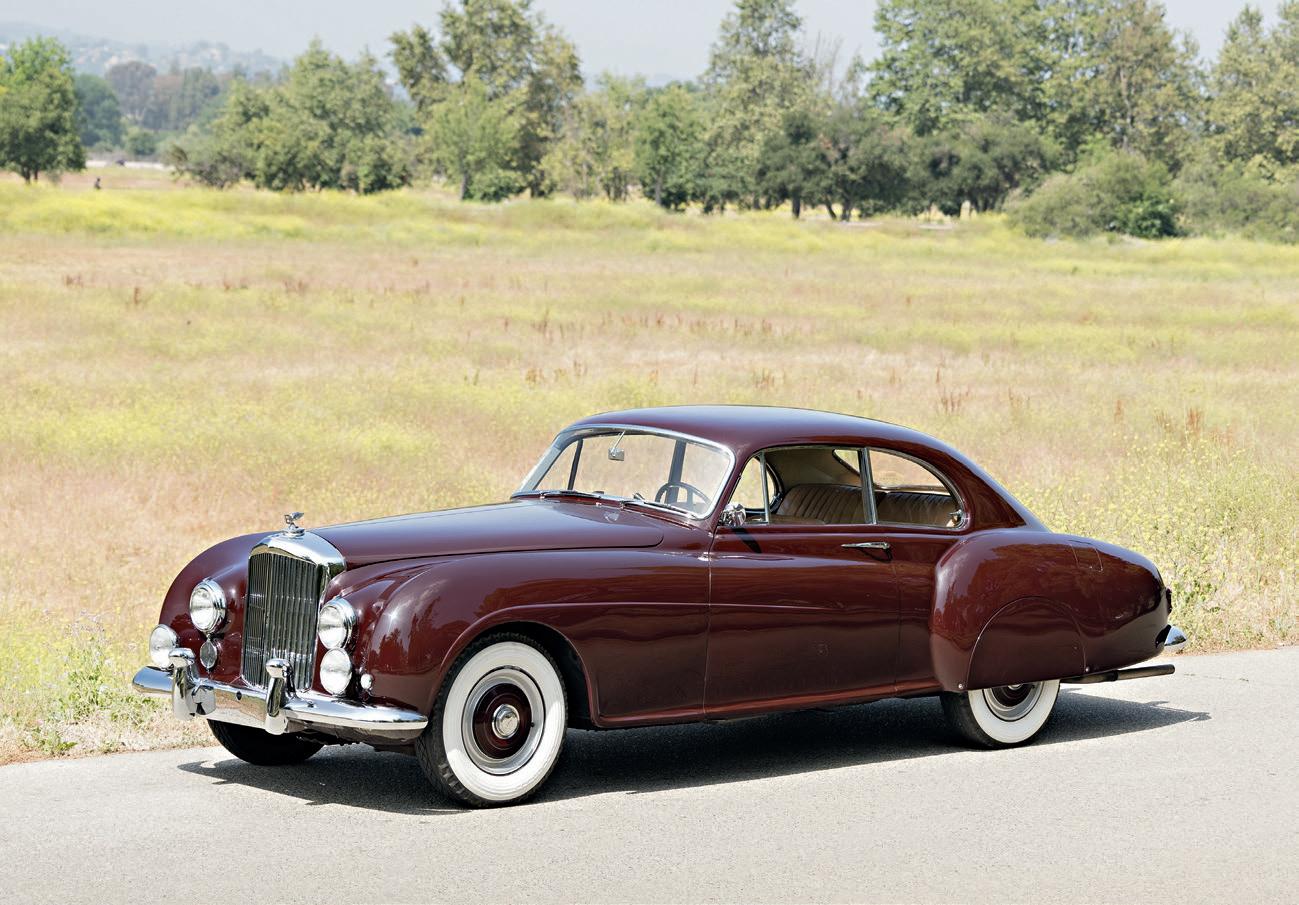

William Kemble Carpenter, Montchanin, Delaware (acquired new via J.S. Inskip Inc. in 1953)
John Hays, New York (acquired via Bill Frick Motors in 1954)
Dr. Samuel L. Scher, New York City, New York (acquired in 1955)
Harold Kaye, London, England (acquired by 1963)
Irwin E. Friedman, Bridgeport, Connecticut (acquired by 1969)
John Seward Johnson II, Skillman, New Jersey (acquired from the above in 1971)
Dr. Mark Clark, US (acquired from the above in 1998)
Dr. Frank E. Gump, New York City, New York (acquired from the above in 1999)
Private Collection, New York (acquired from the above in 2003)
Current Owner (acquired from the above)
The R-Type Continental’s ideal blend of luxury, performance, and exclusivity attracted elite buyers including aristocrats, industrialists, and sportsmen – among them Aristotle Onassis, Gianni Agnelli, and Briggs Cunningham – cementing its status as the ultimate postwar Bentley.
The R-Type Continental presented here, chassis BC2LC, was sold new to DuPont heir William Kemble Carpenter of Montchanin, Delaware. A true sportsman who enjoyed yachting and competitive sportfishing, Carpenter also had a passion for high-performance automobiles: in addition to this Bentley, he owned several Pinin Farina-bodied Ferraris, including a 500 Mondial, 375 America, and 410 Superamerica.
As noted in The Continental Register, this C-Series car was specified in left-hand drive and delivered with engine no. BCC2, which it retains today. Of the 43 left-hand-drive R-Type Continentals built, BC2LC is notable as one of just 34 originally specified with a manual gearbox, and one of only 11 equipped with the rare left-hand-drive-only column shift.
Completed on March 4, 1953, BC2LC was sent to H.J. Mulliner and fitted with Fastback coachwork, internally designated by design no. 7277. This body, numbered 5564, was originally finished in the seldom-seen combination of
Pale Green over gray and green Connolly leather. Factory records show it was outfitted with lightweight seats, Wilmot-Breeden bumpers, twin fog lamps, and an S. Smith and Sons “Radiomobile” radio.
Shipped from London to New York aboard the SS Andria in September 1953, the Bentley did not remain long with Mr. Carpenter. In 1954, it was consigned to Bill Frick Motors in Rockville Centre, New York, and sold that summer to John Hays. By January 1955, it had been acquired by Dr. Samuel L. Scher, the renowned New York plastic surgeon and collector who assembled an extraordinary stable of Rolls-Royce and Bentley motorcars.
In 1963, presumably during the ownership of Harold Kaye, the car returned to England, where it was refurbished by Reall Coachbuilders Ltd. of Slough. Later in the 1960s, it crossed the Atlantic again to join the collection of Irwin E. Friedman, a prominent attorney in Bridgeport, Connecticut.
In 1971, Friedman sold BC2LC to John Seward Johnson II, a well-known sculptor and heir to the Johnson & Johnson fortune. During his long-term ownership, the car was sparingly driven and eventually sold at Christie’s Pebble Beach Auction in 1998. A subsequent owner, Dr. Frank E. Gump, commissioned a complete restoration carried out between 1999 and 2001, finishing it in the


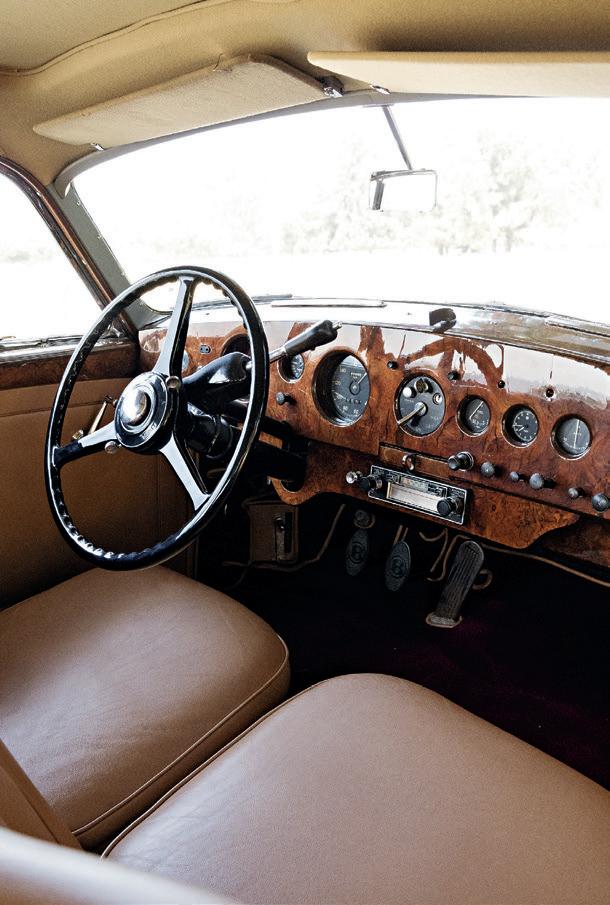

The Continental Register, by Christian Hueber and David A. Sulzberger
Bentley Continental: Corniche & Azure, by Martin Bennett

elegant burgundy over tan color scheme it wears today. Since 2003, the car has been part of two private East Coast collections, enjoying continued careful use.
Owned by knowledgeable collectors for more than half a century and maintained in good, serviceable condition, this highly regarded R-Type Continental Fastback represents the pinnacle of mid-century luxury motoring. Its beautiful styling, smooth powertrain, and refined road manners create an experience that transcends its peers. As a capable and elegant machine, this Bentley rightly deserves a place in any top-tier collection.

CHASSIS NO. 12758
$400,000–$600,000
The P1800 was always an outlier for Volvo. As a company known for producing restrained and safe sedans and station wagons, the stunningly beautiful two-door coupe showed the breadth of the Swedish manufacturer’s abilities. With the first cars going on sale at the end of 1960, the P1800 was underpinned by a similar drivetrain to Volvo’s Amazon 122 passenger car, meaning that the P1800 was remarkably stout, but hardly a performance vehicle.
In 2021, Cyan Racing set out to give the classic P1800 a resto-mod treatment. Since 1996, Cyan Racing has successfully campaigned Volvo race cars around Europe and sought a new challenge. Starting with an original P1800, Cyan Racing essentially builds a new car from the ground up. Although the carbon
HIGHLIGHTS
Cyan Racing’s Take on Volvo’s First Sports Car
Featuring a Full Carbon Fiber Body
Finished in Porsche GTS Red over Tan Leather and Cloth Interior
Thrilling to Drive; Weighing Less than 2,300 Pounds
A Truly Unique Resto-Mod Example
fiber body retains the original car’s shape, the front wheels are moved forward, the rear overhangs are shortened, and the wheel arches have integrated flares to house the wide tires.
Like the original P1800, the Cyan utilizes a four-cylinder engine from Volvo’s passenger cars. However, unlike the original, this modern engine features dual overhead cams and a turbocharger. Producing 413 hp and 336 lbs./ft. of torque, power is sent through a five-speed manual gearbox built by racing parts supplier Holinger America to the rear wheels via a carbon fiber driveshaft and limited-slip differential. Weighing in at less than 2,300 pounds, the Cyan P1800 offers serious thrills behind the wheel, with no traction control,
SPECIFICATIONS
2,000 CC Inline 4-Cylinder Engine
BorgWarner EFR Turbocharger
420 BHP at 7,000 RPM
5-Speed Holinger Manual Gearbox
4-Wheel AP Racing Disc Brakes
Front and Rear Double-Wishbone Suspension with Öhlins Adjustable Dampers


Current Owner (acquired via Graham Rahal Performance in 2024)
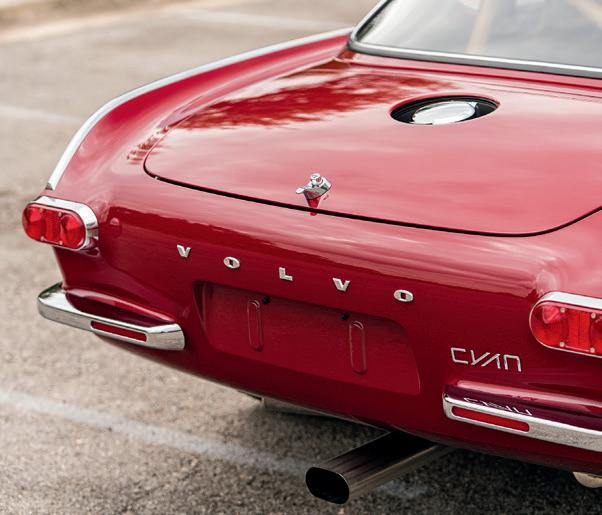
stability control, or power brakes.
This Volvo Cyan P1800 is the second chassis built by the manufacturer and carried a base cost of $550,000. It is finished in Porsche GTS Red with a dark red accent around the lower portion of the car, with a matching hood and roof stripe. The wheels are finished in stunning satin bronze, with matching AP Racing brake calipers behind them.
The interior is finished in an appealing combination of materials, with the bucket seats upholstered in tan leather with fabric centers, and the door cards featuring a combination of textile cloth and black leather. The metal dashboard is painted to match the exterior color, and the classic P1800 gauges have been replicated with updated units to suit the car’s current powertrain.
Utilizing Cyan Racing’s experience building racing Volvos, the company’s P1800 provides the driver with a near-race car experience, just dialed back a few notches to remain enjoyable on the street. Pairing the attractive styling that people fell in love with more than 60 years ago with modern technology and performance, makes the Cyan P1800 a fitting tribute to Volvo’s first sports car.

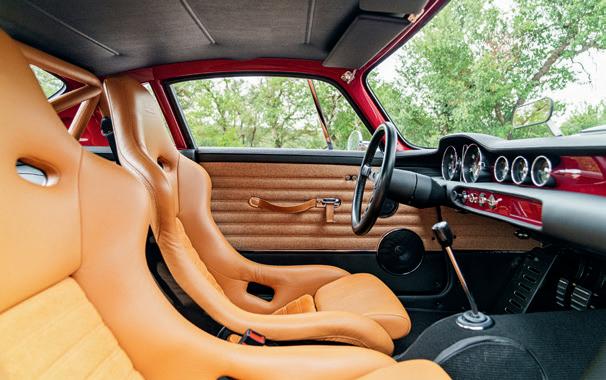

COACHWORK BY PININFARINA
VIN. ZFFGT61A350145414
$350,000–$400,000
A stylistic and technical tour de force on every level, Ferrari’s 575 Superamerica stands as a true open supercar capable of nearly 200 mph flat out while being eminently capable of regular use and enjoyment. With its variable-opacity Revocromico hardtop – an industry first – plus distinctive colors and the most sought-after factory options, this example demands serious consideration as a rare, limited-production modern classic. This was one of the first open-top, front-engine V-12 models offered by Ferrari since the 365 GTS/4 Daytona Spider of the early 1970s. Just 559 Superamericas were built in all.
Delivered new to North America, this 575 was finished in Argento Nürburgring (Nürburgring Silver) over Pelle Charcoal leather upholstery with Daytona-style
HIGHLIGHTS
One of 559 Built and Just 170 Delivered to the US; Finished in Distinctive Colors
Desirable Specification with Daytona-Style Seats and $20,000 Handling GTC Package
Displayed Just 15,277 Miles when Catalogued; Recent Timing Belt Replacement
Delivered New to Prominent Diplomat; Ferrari Classiche Certified Accompanied by Original Books, Stamped Warranty Card, Tool Kit, Covers, and Tire Inflator
seats. In addition to its outstanding colors, this Superamerica also sports the highly sought-after Handling GTC Package, a comprehensive factory performance option also known as the “HGTC” package that cost approximately $20,000. Among the many exclusive features of this option are enhanced stopping power delivered via Brembo carbon ceramic disc brakes, titanium sport exhaust tips with a unique finned inner-ring design, carbon fiber interior trim surrounding the HVAC panel and stereo, HGTC 19" modular wheels, faster F1 Shift Logic, and suspension upgrades.
The Ferrari was delivered new on December 20, 2005, by Ferrari-Maserati of Long Island to Steven C. Witkoff – the prominent New York City-based
5,748 CC DOHC V-12 Engine
Bosch Motronic ME7 Fuel Injection
533 BHP at 7,250 RPM
6-Speed Automated F1 Manual Transaxle
4-Wheel Carbon Ceramic Disc Brakes with ABS
4-Wheel Independent Suspension with Coil Springs and Telescopic Shock Absorbers
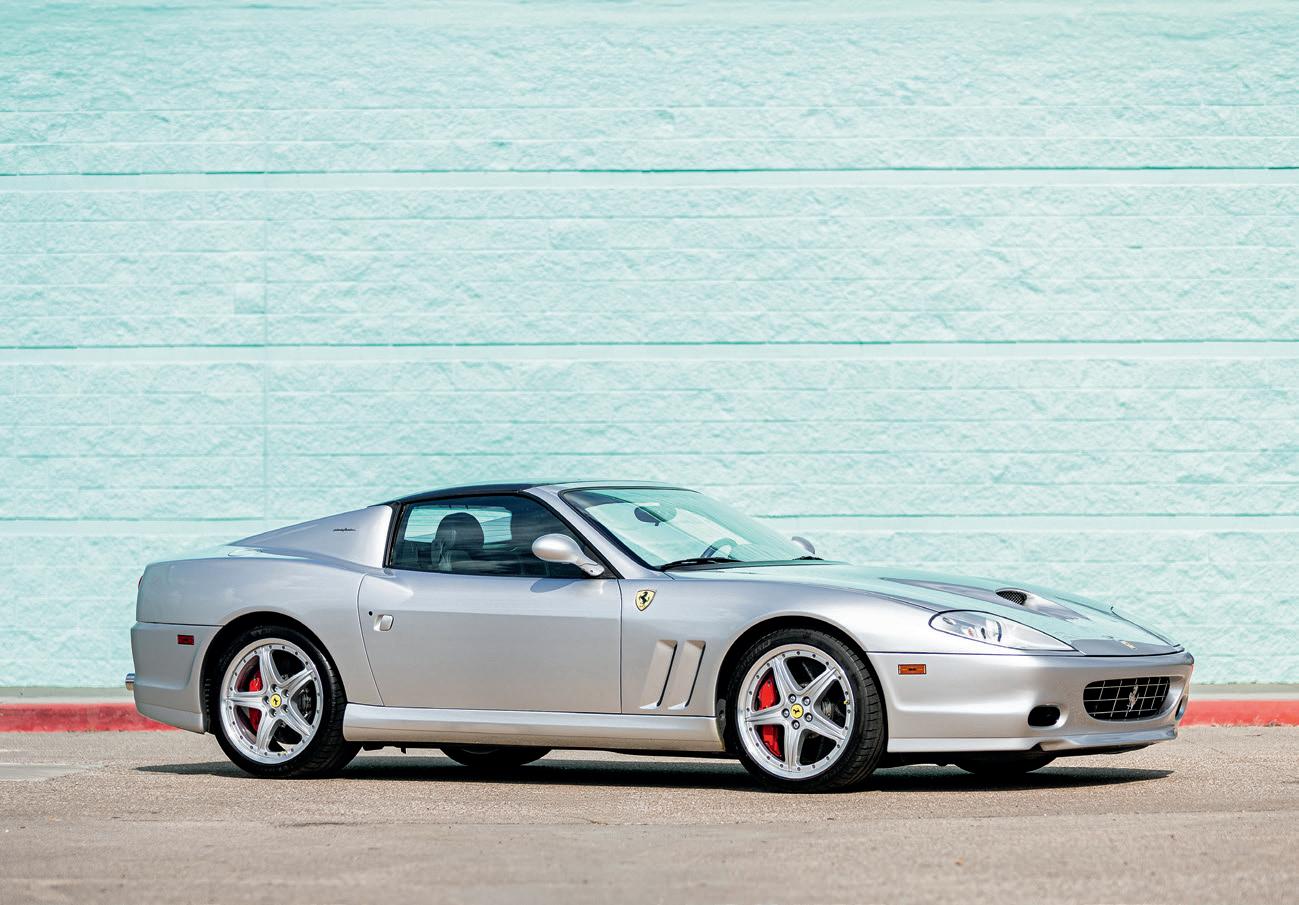

Steven C. Witkoff, New York City, New York (acquired new via FerrariMaserati of Long Island in 2005)
Private Collection, Florida (acquired from the above in 2008)
Dr. William J. Lehrich, Oakland, California (acquired from the above in 2018)
Current Owner (acquired from the above)
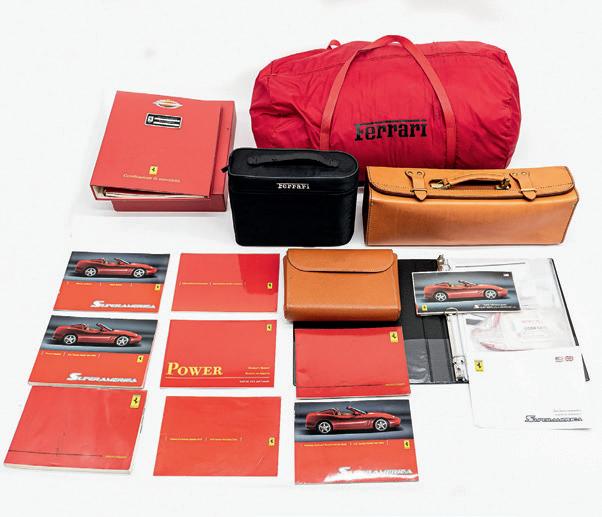
lawyer, real estate developer, and diplomat. After just 1,269 miles of use, the Superamerica was acquired in 2008 by a Florida-based collector, who drove the car up to 7,130 miles during his decade of care. In June 2009, the Superamerica received Ferrari Classiche certification and, in 2018, it was sold to its next owner based in California. According to its CARFAX Vehicle History Report, the Superamerica received service and maintenance almost exclusively at factory-authorized Ferrari dealerships. Most recently, under its current ownership, a timing belt replacement was performed. This attractive example showed just 15,277 miles at the time of cataloguing.
As expected for a top-tier example such as this, included with the sale are original factory-issued manuals, its stamped warranty card, Ferrari Classiche Red Book, and factory accessories, including a tool kit and tire inflator. Simply put, this is a collector-quality, investment-grade example of the Ferrari 575 Superamerica. Its fantastic colors, original accompanying items and desirable options places it among the top examples of this important modern Ferrari.
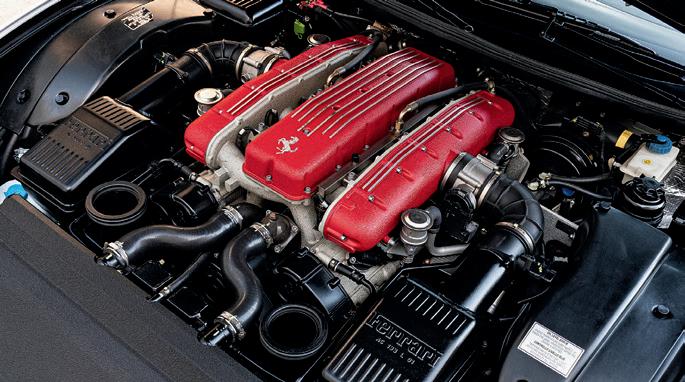


COACHWORK BY FISHER
ENGINE NO. 3000409
$200,000–$275,000 without reserve
According to famed design professor and automotive scholar Strother MacMinn, by the early 1930s, The General Motors Fisher Body Division was keen on constructing a line of custom bodies for Cadillac, in an effort to provide a distinctly different series that would be priced between the standard line and the ultra-exclusive offerings from Fleetwood. It is believed that there may have only been four examples built: three Roadsters and one Dual-Cowl Phaeton. Presumably, internal business affairs prevented the production of any further examples.
According to a copy of its original build sheet, the Roadster offered here was delivered new to Brooklyn, New York, and given its unique coachwork. It may have been intended to be displayed at the New York Auto Show. With its Heron hood ornament, Pilot Ray driving lights, and dual side-mounted spares, the Cadillac makes a striking impression and, in the 1960s, it was awarded a National First Prize by both the AACA and CCCA.
Believed to be One of Just Three Fisher-Bodied Roadsters Built Delivered New to Brooklyn, New York per Copy of Its Factory Build Sheet Features Pilot Ray Driving Lights, Dual Side-Mounted Spares, and Luggage Rack
Shown at The Elegance at Hershey and the Boca Raton Concours d’Elegance
An AACA and CCCA National First-Prize Winner and Significant Piece of GM History
*Please note that this vehicle is registered by its engine number.
This fine automobile’s sophisticated appearance and rarity contribute to its status as one of the most significant V-8 Cadillacs of the era. These qualities, combined with its eligibility for a variety of events and its singular character, mean that this Fisher Roadster is deserving of a place in any collection of important American classics.
353 CID L-Head V-8 Engine
Single Cadillac Carburetor
125 BHP at 3,000 RPM
3-Speed Manual Gearbox
4-Wheel Mechanical Drum Brakes
Front Solid Axle with Semi-Elliptical Leaf Springs
Rear Live Axle with Semi-Elliptical Leaf Springs


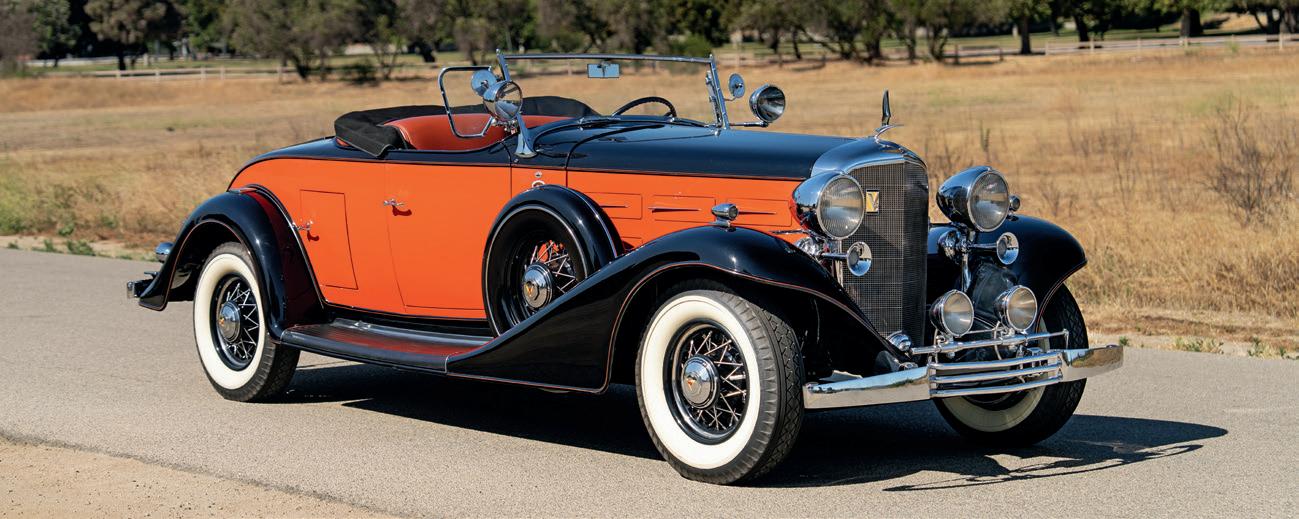

COACHWORK BY LEBARON
CHASSIS NO. 7803648
ENGINE NO. CL 1355
$375,000-$575,000
In 1926, Chrysler decided to build a luxury car to take on the likes of Packard and Cadillac, and named their new model the Imperial. In 1931, the Imperial 8 was introduced, powered by a robust 385 cid, straight-eight engine producing 125 hp. These eight-cylinder cars were among the finest automobiles of their time, offering hydraulic brakes and effortless performance along with undeniably attractive styling.
The Imperial offered here, chassis 7803648, is a CL Custom model, all of which wore bodies built by LeBaron and featured attractive, full-length hoods and split windscreens. With beautiful and versatile dual-windshield phaeton coachwork, this example is one of just 36 built in this style. In 1933, it was Chrysler’s most
HIGHLIGHTS
Among the Rarest Classic Era Chryslers and a Multiple Concours Award Winner
Delivered New in New York City to Toy Manufacturer Louis Marx & Company
One of Just 36 Imperial Custom Phaetons Built in 1933
Retains Matching-Numbers Engine per FCA Build Record Certificate
Well-Documented with 72-Page History Report, Extensive Records, and Archival Photographs
expensive car at $3,395.
According to its FCA Build Record Certificate, the Chrysler was delivered new to New York City in 1933 to either David or Louis Marx, the pioneering brothers who co-founded Louis Marx & Company. Most famous for its tin toys, model cars, and trains, Rock’em Sock’em Robots, and Big Wheel Tricycles, they were the largest toy manufacturer in the world by the 1950s. Louis Marx was likely the first owner, as he collected cars and later even owned a one-off H.J. Mulliner-bodied Rolls-Royce.
The Imperial was then sold by Marx to George Dressler, the general manager
SPECIFICATIONS
385 CID L-Head “Red Head” Inline 8-Cylinder Engine
Single Stromberg Carburetor
125 BHP at 3,200 RPM
4-Speed Manual Gearbox
4-Wheel Hydraulic Drum Brakes
Front Solid Axle with Semi-Elliptical Leaf Springs
Rear Live Axle with Semi-Elliptical Leaf Springs
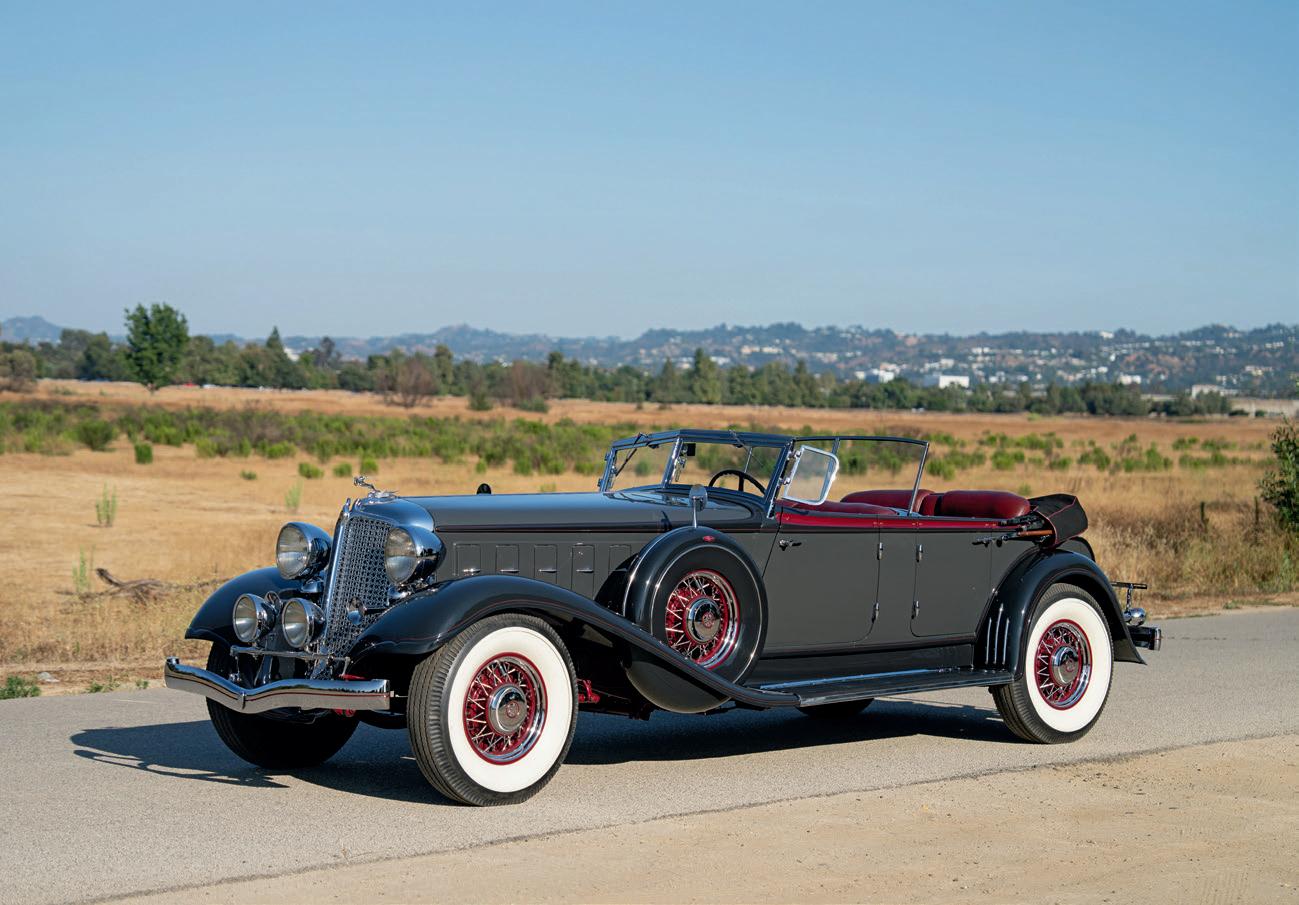

Louis Marx & Company, New York City, New York (acquired new in 1933)
George Dessler, Manassas, Virginia (acquired from the above)
Edgar Rohr, Manassas, Virginia (acquired from the above in 1947)
Rick Carroll, Jensen Beach, Florida (acquired from the above circa 1978)
Don Mayoras, Pennsylvania (acquired from the above circa 1985)
David Huckins, Tilton, New Hampshire (acquired from the above in the late 1980s)
Current Owner (acquired from the estate of the above in 2014)
Amelia Island Concours d’Elegance, 2014 (Most Elegant Chrysler)
Greenwich Concours d’Elegance, Connecticut, 2014 (Most Distinguished PreWar Automobile)
The Elegance at Hershey, Pennsylvania, 2014 (High Society Award)
St. Michaels Concours d’Elegance, Maryland, 2014 (Most Elegant Open Car)
Boca Raton Concours d’Elegance, Florida, 2015 (Excellence in Class)

of the company. By 1947, Dressler was living in Manassas, Virginia, where he met fellow resident Edgar Rohr, who recounted that he spotted the Chrysler because he needed new tires for his work truck and saw that the Imperial’s tires were the same size. Tires were hard to come by, and Rohr offered $125 for the set. Dressler refused to sell just the tires, so Rohr purchased the entire car for the same price. Never actually removing the tires, Rohr fell in love with the car, painted it bright red with yellow stripes because he was a volunteer fireman, and used it to promote his business. A wonderful array of photos of the car during this time accompany the sale.
Rohr kept the Phaeton until circa 1978, when he sold it to noted collector
Rick Carroll, and by the late 1980s the Imperial was owned by David Huckins of New Hampshire, who restored it and owned it for more than 20 years. The consignor acquired the Chrysler in 2014 and has shown it at various concours events, winning multiple best in class awards and it has since been used sparingly.




One of the rarest Classic Era Chryslers, this Custom Phaeton sets itself apart with its remarkable history and extensive documentation, making it a true prize for the discerning collector of 1930s automobiles.
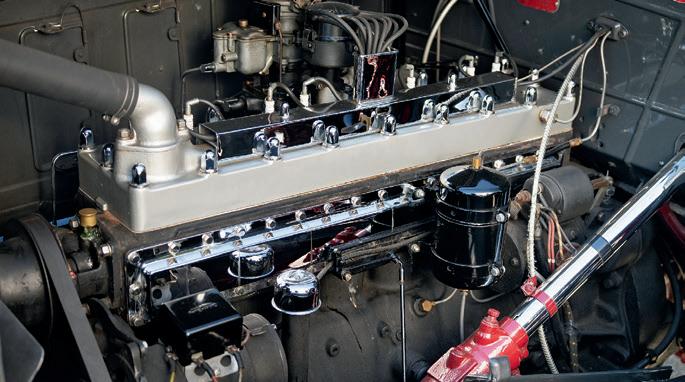


PACKARD VEHICLE NO. 739-19
ENGINE NO. 902554
$275,000–$350,000
Packard’s Eleventh Series models from 1934 are widely considered some of the most important and collectible ever built by the Detroit-based manufacturer. 1934 was the final year for Packard’s gracefully skirted traditional fenders and chrome-plated headlamp housings with V-profile lenses, marking the end of an era. The Eleventh Series was also mechanically advanced, offering an adjustable suspension and Bijur automatic lubrication.
According to the data tag on its firewall, this lovely example was sold new through Los Angeles dealer Earle C. Anthony. The former owner of the Packard reports that according to the research of a prior owner, the car is believed to have been sold new to movie producer Joseph E. Levine. Levine was responsible for the American releases
HIGHLIGHTS
Shown at the Amelia Island and Boca Raton Concours d’Elegance
Formerly of the Thomas Kerr Packard Collection
Sold New via Los Angeles Dealer Earle C. Anthony
Presented in Elegant Dark Blue over Black Color Combination
A Beautiful Example of the Packard Twelve at Its Finest
of Godzilla, King of the Monsters!, Attila, and Hercules, which helped revolutionize American film marketing. Levine’s biggest hit, however, was director Mike Nichols’ The Graduate, a landmark film that ushered in the New Hollywood movement and made Dustin Hoffman a superstar.
This Packard Twelve was acquired by the consignor in 2014, joining his collection of rare American classics. Reportedly restored in 2011 by Jim Cox of Missouri, the Packard makes a striking impression with its dark blue paint, red pinstriping, and black upholstery. Formerly of the Thomas Kerr Packard collection and shown at multiple concours d’elegance, this Coupe Roadster is a study in Jazz Age glamour with its generous 142” wheelbase chassis and elegant, yet decidedly sporting, open coachwork.
SPECIFICATIONS
445 CID L-Head V-12 Engine
Single Stromberg Downdraft Carburetor
160 BHP at 3,200 RPM
3-Speed Selective Synchromesh Manual Gearbox
4-Wheel Vacuum-Assisted Mechanical Drum Brakes
Front Solid Axle with Semi-Elliptical Leaf Springs
Rear Live Axle with Semi-Elliptical Leaf Springs
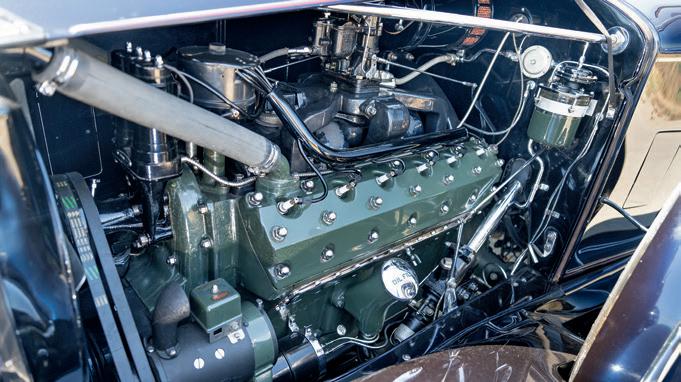

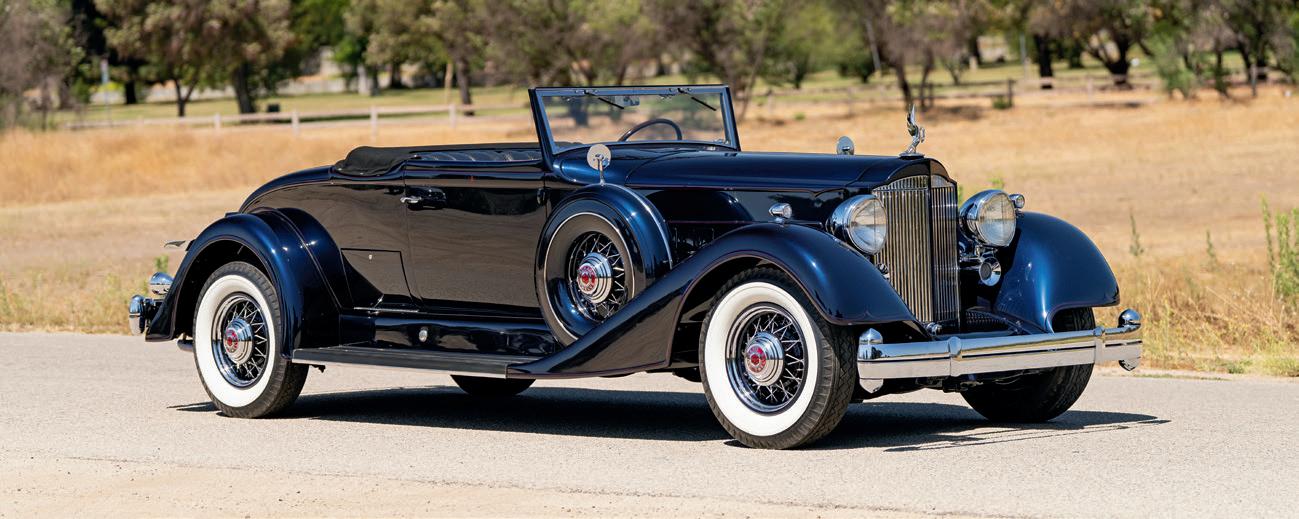


Mitchell Rasansky’s passion for automobiles has spanned more than 70 years. In his early teenage years, he was finding ways to buy and trade old cars, and by the 1950s he was drag racing the very same 1932 Ford “Mitchell Auto Co. Special” Roadster offered here. Over the years, an extraordinary array of cars has passed through his hands – including Bugattis, Jaguars, numerous Ferraris, prewar icons such as the Alfa Romeo 6C and 8C, and a whole host of important American race cars such as Miller.
The cars being offered, and those that preceded them, have been exhibited at a variety of different events – from race meetings such as the Goodwood Festival of Speed and the annual Harry Miller Club event, to significant concours, including many appearances at the Pebble Beach Concours d’Elegance®.
Using his eye for detail, Mr. Rasansky sourced missing features for his collection of cars, improved aesthetic and technical aspects, and even managed entire restoration projects from start to finish – as with his 1927 Miller Model 91 Front Wheel Drive. In the case of his exquisite Jaguars, which he acquired in more recent times, they were simply bought as the best example of each model that he could find.
As he now approaches his 90th year, he has made the decision to part with his cherished collection, sharing this extraordinary group of 10 cars with other enthusiasts. In doing so, there are opportunities at all levels of budget and genre of performance, each with fascinating histories to tell.

CHASSIS NO. X75
ENGINE NO. 246
$40,000–$60,000 without reserve
During the Great Depression and in the years following WWII, American midget racing became a national obsession. Across county fairgrounds and city speedways, open-wheel racers tore through dirt and pavement oval tracks. These cars were the machines of legends, and no name looms larger in the golden age of midget racing than Kurtis-Kraft.
This 1950 Kurtis-Kraft Midget Racer is an authentic example of Frank Kurtis’ renowned craftsmanship, a builder whose dominance in Midgets, Sprint Cars, and IndyCars reshaped American racing. Purchased in 1990 by Mitchell Rasansky, this car was entrusted to motor sports specialist Bob Willey of Moline, Illinois, for a concours-quality restoration. Notably, Willey is the son of an original Kurtis-Kraft
HIGHLIGHTS
Restored to Concours Condition by Motor Sports Specialist Bob Willey
Powered by Legendary Offenhauser Racing Engine
Displayed at the Dallas Concours d’Elegance
A Striking Example from the Golden Era of American Midget Racing
Correctly Finished in Ivory White with Red Scallops and Gold-Leaf Livery
distributor, lending the project both historical insight and mechanical integrity. Restored in period-correct ivory white livery with red scallops, the No. 75 and “Dalton Offy” are proudly lettered across its nose in engine-turned gold leaf, and the driver seat is trimmed with pleated red upholstery.
Powering this Midget Racer is the legendary 110 cid Offenhauser DOHC inline-four engine paired with twin Riley sidedraft carburetors, a powerplant that dominated midget racing of the era. Power routes through a direct in-out gearbox to a Halibrand quick-change rear end. Whether destined for a concours lawn or race paddock, this Kurtis-Kraft Midget Racer offers a rare opportunity to own a tangible piece of American racing heritage.
110 CID Offenhauser DOHC Inline 4-Cylinder Engine
Twin Riley Sidedraft Carburetors
Estimated 100 BHP at 6,000 RPM
In-Out Direct Drive Transmission
4-Wheel Drum Brakes
Front Tubular Axle with Transverse Leaf-Spring Suspension
Rear Halibrand Quick-Change Axle with Houdaille-Style Shock Absorbers
*Please note that
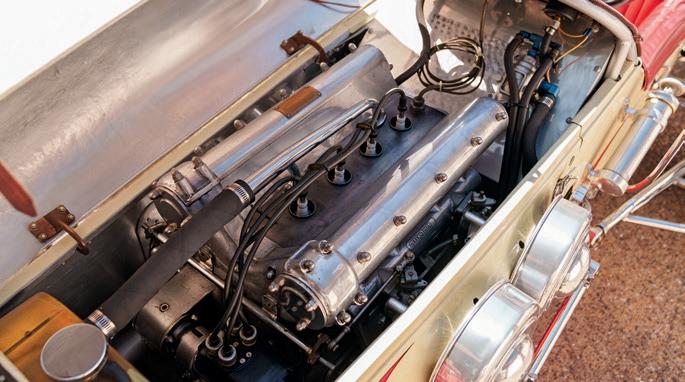
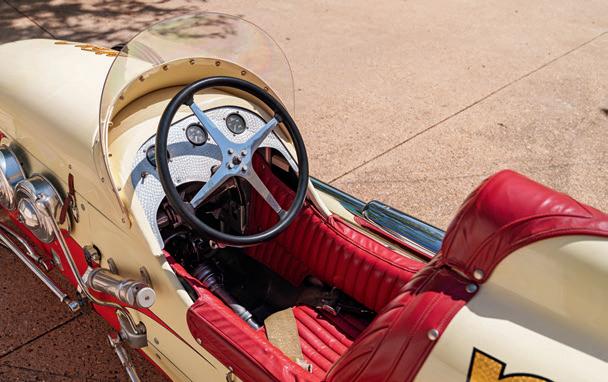

CHASSIS NO. 4817
ENGINE NO. 126T
$2,500,000-$3,000,000
Considered by many to be the finest racing car of its period and one of the most enduring automotive designs of all time, the Type 35 Grand Prix is the definitive Bugatti.
Unveiled at the 1924 Grand Prix of Lyon, Ettore Bugatti’s Type 35 was immediately hailed as a modern marvel, combining advanced engineering with masterful aesthetic design. Equipped with an overhead-cam, eight-cylinder engine, the original Type 35 produced 95 hp, an impressive figure for a naturally aspirated two-liter machine of the era. The car’s extremely lightweight chassis showcased Bugatti’s revolutionary hollow front axle and cast aluminum wheels with integrated brake drums, while the main mechanical components were clothed
HIGHLIGHTS
A Historically Significant Grand Prix Bugatti with Period Competition History
Multiple Race-Winning Car in the Hands of Louis Chiron
A Fixture in the Renowned Dr. Peter Williamson Bugatti Collection for Decades; Just Two Owners Since 1964
Retains Matching-Numbers Chassis, Engine, and Data Tag per Factory Records
Documented by Noted Bugatti Historian Pierre-Yves Laugier
in a streamlined two-seat aluminum body that was both elegant and purposeful. The entire car was beautifully made, from its horseshoe radiator to tapered tail, with scraped or polished metal finishes and fine detailing throughout.
Bugatti built several different variations of the Type 35 through 1931, when the model was replaced by the Miller-inspired twin-cam Type 51. Early Type 35s generally followed the pattern set by the original Lyon cars, while more powerful supercharged models of varying engine capacity appeared in 1926. Altogether, the Bugatti works at Molsheim built approximately 350 Type 35s.
A credit to their technical achievements and versatile performance, Bugatti
2,262 CC SOHC Inline 8-Cylinder Engine
Single Solex Carburetor
Roots-Type Supercharger
Estimated 130 HP at 5,500 RPM
4-Speed Manual Gearbox
4-Wheel Cable-Operated Mechanical Drum Brakes
Front Solid Axle with Semi-Elliptical Leaf Springs
Rear Live Axle with Reversed Quarter-Elliptical Leaf Springs

Giraud & Hoffman, Marseille, France (acquired new in March 1927)
Société Nerka (acquired from the above in 1928)
Louis Decaroli, Nice, France (acquired in 1929)
Roger Morand, Nice, France (acquired circa 1932)
Alphonse Guillot, Nice, France (acquired circa 1932)
Suzanne Reitz, Nice, France (acquired circa 1933)
Joseph Louis Cesari, Nice, France (acquired circa 1935)
René Brooke-Beer, Nice, France (acquired from the above in March 1935)
Maurice Blot, Nice, France (acquired from the above in April 1935)
Casimir Brarda, Var (acquired from the above in March 1936)
Marceau Seassau, Nice, France (acquired from the above in May 1936)
M. Mahoudeau, Nice, France (acquired from the above in 1937)
( continued )
René de le Beaume, Montpellier, France (acquired from the above in 1939)
Alfred Wegener, Montpellier, France (acquired from the above in 1942)
Pierre Bardinon, France (acquired by 1951)
François Guerineau, Paris, France (acquired from the above in 1953)
Le Haras des Purs Sang de l’Auto, Neuilly-sur-Seine, France (acquired from the above in 1955)
Dr. Milton Roth, Los Angeles, California (acquired via Otto Zipper and Bob Estes circa 1955)
Bob Hammel, Los Angeles, California (acquired from the above circa 1957)
Dr. Peter Williamson, Lyme, New Hampshire (acquired in 1964)
Mitchell Rasansky (acquired from the estate of the above in 2008)
Type 35s dominated racing throughout the late 1920s and early 1930s, with over 1,000 wins in a variety of competitions. It has been said that the Type 35 averaged 14 race wins per week and, by the close of 1926, the model set 47 individual speed records. The Type 35 took the Grand Prix World Championship title in 1926, won the Monaco Grand Prix three times, and the Targa Florio five times. Bugatti’s success attracted the most famous drivers of the day – Nuvolari, Varzi, Divo, Costantini, Chiron, Dreyfus, and Williams all contributed to the legend of the Type 35 Grand Prix.
The Bugatti presented here is a Type 35B – the designation for a 2.3-liter, eight-cylinder model fitted with a Roots-type supercharger. As noted in historian Hugh Conway’s definitive reference book Grand Prix Bugatti, this car, chassis 4817, was originally equipped with engine no. 126T. According to an extensive history report on file by historian Pierre-Yves Laugier, this Type 35B was sold to Giraud & Hoffman for 135,000 FF on March 16, 1927. Five days later, it was driven to Marseille by Marius Giraud and Louis Chiron, the legendary Monegasque driver who won nearly every significant European Grand Prix during his extraordinary three-decade career.
Owned by Giraud, and then listed under Hoffman’s spark plug business, Société Nerka, the car was invariably driven by Chiron. Out of 10 races and hill climbs
in the 1927 and 1928 seasons, he won or achieved the fastest time of the day in all but one, in which he placed 2nd. Perhaps the highlight was the 1928 Antibes Grand Prix, where he won ahead of the significant competition of Grover Williams and Rene Dreyfus. The race was immortalized by Geo Ham in an instantly recognizable piece of artwork depicting Chiron being chased along the French coastline. The successes were frequently attributed in the press to Nerka’s spark plugs, turning them into something of a promotional tool as well.
After two years of service for Giraud, Hoffman, and Nerka, Chiron was then driving more often for the Bugatti Works. Chassis 4817 was then used or sold to Guy Bouriat and then to Louis Decaroli – although it was not registered to him until July 1929; it appears that he had use of the car also in advance of its purchase. Decaroli’s entries in Provençal hill climbs and minor circuit races provided initial success, winning at the Domaine Rothschild Hillclimb and Alpilles Hillclimb, but he did not race it through 1930, despite occasional entry listings. Starting in 1931, it was campaigned by Roger Morand of Nice on and off for the next four years, despite only officially acquiring the Bugatti in June 1932. Next followed a series of custodians: Alphonse Guillot, Suzanne Reitz, and Joseph Louis Cesari, who are each listed as new owners, yet all resided at Morand’s address. Morand was similarly successful in various events in the south of France. The Bugatti continued to reside in Nice through its next ownerships
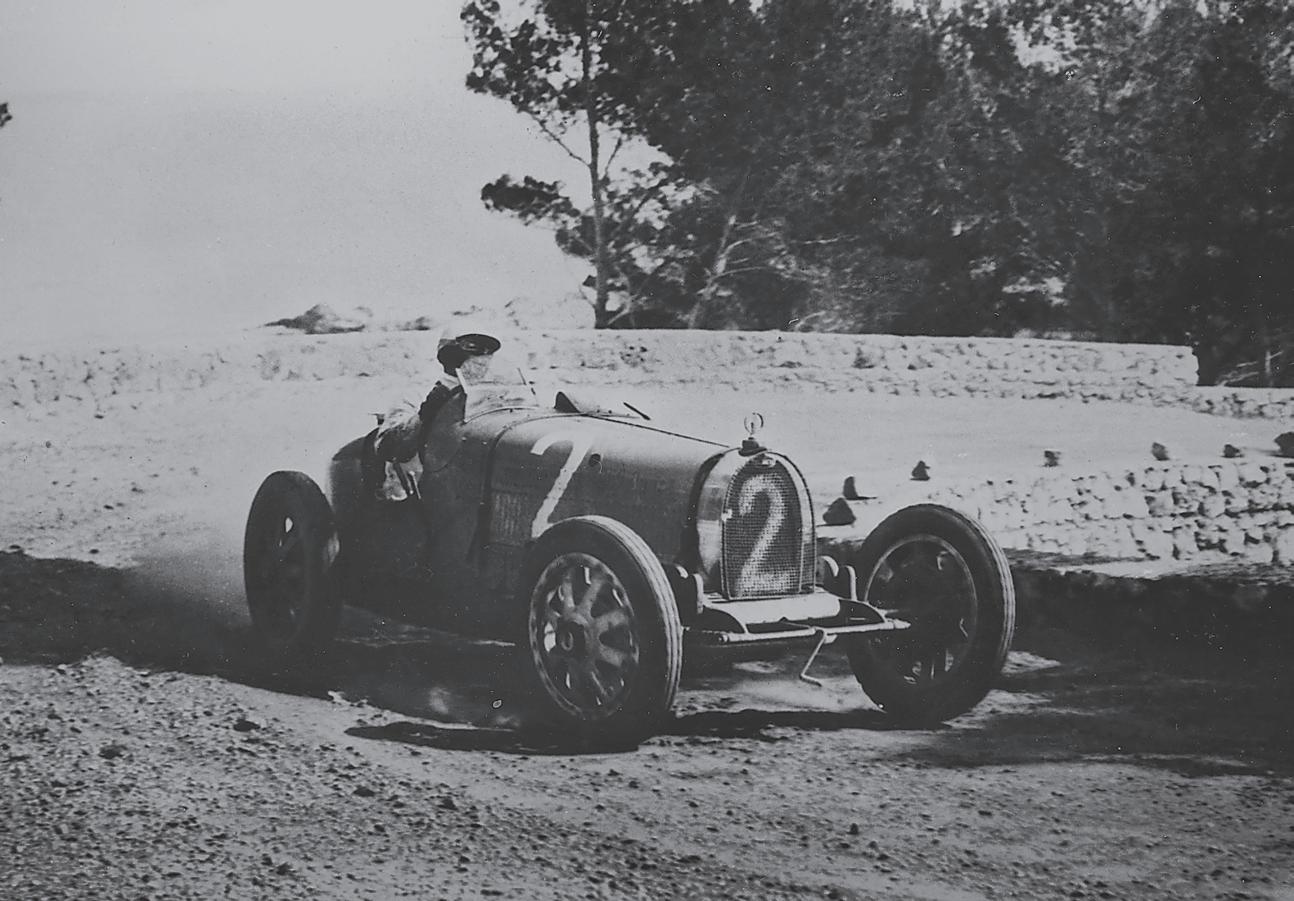
Grand Prix de Provence, Miramas, Chiron, March 1927 (1st)
Limonest Hillclimb, Chiron, June 1927 (1st, Record Time)
Formule Libre Race, A.C.F., Montlhéry, July 1927, Chiron, No. 16 (2nd)
Col de Peyresourde Hillclimb, Chiron, August 1927 (Fastest Time of the Day)
Klausenrennen Hillclimb, Chiron (Société Nerka), 1927 (Fastest Time of the Day)
Arcachon Speed Trial, Chiron, August 1927 (Fastest Time of the Day)
Moureflos Hillclimb, Chiron, August 1927 (Fastest Time of the Day)
Circuit de la Riviera, Super Cannes, April 1928, Chiron (1st)
Grand Prix d’Antibes, April 1928, Chiron, No. 2 (1st)
Grand Prix De La Marne, Reims, July 1928, Chiron (1st)
Grand Prix D’Europe, Monza, September 1928, Bouriat (7th)
( continued )
Domaine Rothschild Hillclimb, Grasse, February 1929, Decaroli (1st)
Circuit Esterel Plage, Saint Raphael, March 1929, Decaroli (2nd)
Alpilles Hillclimb, Saint Remy de Provence, May 1929, Decaroli (1st)
Coppa Ciano, July 1929, Decaroli (14th)
Alpilles Hillclimb, Saint Remy de Provence, May 1931, Morand (1st)
Val de Cuech Hillclimb, May 1931, Morand (1st, Fastest Time for Class)
Camp Hillclimb, May 1931, Morand (1st)
Alpilles Hillclimb, Saint Remy de Provence, May 1932, Decaroli (Fastest Time of the Day, Hill Record)
Grabels Hillclimb, June 1932, Morand (1st)
Automobile Club de Nice, November 1932, Morand
under Maurice Blot and René Brooke-Beer, then moved to the Var with Casimir Brarda for a matter of months, before returning to Nice and Marceau Seassau, then Mahoudeau. Only then did it head east to two Montpelier ownerships, that of René de le Beaume and Alfred Wegener.
Most likely hidden during the war, by 1951 it became the property of a young Pierre Bardinon, a name now synonymous with Ferrari for the extraordinary collection that he amassed and his Mas-du-Clos race circuit. In this period, Bardinon’s father Jean corresponded with his friend Count de Boigne, the husband of Lidia Bugatti, to access some parts from the factory. Having undergone a rebuild, the car was in fine fettle – until, in the days leading up to his wedding, it was involved in a crash on an icy road in January 1952. Although not documented, the car must have been repaired and subsequently sold to a Parisian friend, François Guerineau, in March 1953. Retaining the car for two more years, he sold it to “le Haras des Purs Sang de l’Auto” – or, “the thoroughbred stud farm” – which was run by Francis Mortarini and Armand Beressi, who clearly specialized in “la marque.” The pair of thoroughbred traders would funnel a number of Bugattis to America, usually through Bob Estes and Otto Zipper in Los Angeles.
The car’s condition at this point is unclear; however, its later history suggests that the engine had likely been exchanged with that of chassis 4939, and that
its chassis plate was retained by Mortarini and Beressi. For a time, the car was identified solely by the only visible evidence of a chassis number – 4939 stamped on the engine bearer. Estes and Zipper sold the car to Dr. Milton Roth, who only owned the car briefly before he passed it on to Bob Hammel, also in Los Angeles. It is listed with him in a 1962 American Bugatti Club Register as chassis 4939, with engine 194T. Hammel is believed to have restored the car, replacing much of the bodywork – which must have been well worn by this stage of its life. He used it for a few years before selling it to Dr. Peter Williamson of Lyme, New Hampshire in 1964. It would reside with him for the next 44 years, resting inside one of the greatest Bugatti collections ever amassed. It included Grand Prix cars, two type 57S Atalantes, and the incomparable 57SC Atlantic. Restorations over this period are reported to have been carried out by Bunny Phillips and later by Don Leffert’s Vintage Auto Restoration.
Upon Dr. Williamson’s death, the majority of the collection was sold at Pebble Beach in 2008, where Mitchell Rasansky acquired this Type 35B Grand Prix. By now, with the advent of increased knowledge and the incredible active participation of a number of Bugatti archivists, its engine and identity switch were fully apparent.
Always curious and keen to improve a car in its detail and research, Mr. Rasansky

Paris-Nice Rallye, Speed Race, March 1933, Morand (8th)
La Baronne Hillclimb, March 1933, Morand (1st)
Boulevard Michelet Race, Marseille, March 1934, Morand
Paris-Nice Rallye, Flying 500M Race, March 1934, Morand (2nd)
Paris-Nice Rallye, 500M Flying Start and Arrival, Morand (6th)
La Turbie Hillclimb, March 1934, Morand (3rd)
Klausenrennen, August 1934, Morand
Pebble Beach Concours d’Elegance®, 2009
Harry Miller Club Meet, Multiple Appearances Since 2010
American Bugatti Register and Data Book, by Sandy Leith and Kees Jansen
The Bugatti Book, by Baryy Eaglesfield and C.W.P. Hampton
The Bugatti Register and Data Book, by Hugh G. Conway
Memoirs of a Bugatti Hunter: Archives of a Passion, by Antoine Raffaeli
commissioned Pierre-Yves Laugier to produce a comprehensive report on 4817. This produced not only a race history in its absolute minutiae, but also two other aspects emerged. By visiting the widow of Armand Beressi (former owner of the car) one year during the Paris Rétromobile show, the original brass chassis plate for 4817 was discovered and acquired, confirming that more than likely it had been removed by them before it left France.
Secondly, a quest to retrieve the car’s original engine began, with Mr. Rasansky tracking this down to Roger Howard in Canada, whose own Bugatti Type 35 was powered by that unit, no. 126T. After years of negotiations and tentative agreements to make an exchange, Howard was never able to commit, and would pass before this took place. By chance, the correspondence on file was enough for his estate to reach out to Mr. Rasansky – and while they would not entertain a switch – he was able to acquire the car outright and facilitate his goal. Jim Stranberg carried out this work, which included fitting a brand new crankshaft and rebuilding the original engine, with the two cars returning to Dallas, and 4817 now proudly wearing its original chassis plate and matching-numbers engine casing. The ex-4939 unit from that point on has lived in the ex-Howard car, also offered in this sale (Lot 189).
During the 17 years of his custody, Mr. Rasansky has truly enjoyed his ownership of the Type 35B, displaying it at the Pebble Beach Concours d’Elegance® in 2009 as well as at the Harry Miller Club Meet in Milwaukee on occasion. With its classic horseshoe radiator, pointed tail, and alloy wheels, there is no mistaking 4817 for anything but the quintessential Bugatti Grand Prix car, one of the great icons of prewar motoring. As an original Type 35B, it represents the ultimate evolution of Ettore Bugatti’s original, groundbreaking design.
This Type 35B possesses a brilliant racing history, winning at almost every event it contested in the hands of the legendary driver Louis Chiron. The car’s postwar history is well established, having been owned by Bob Hammel and Dr. Peter Williamson from the 1950s to 2008.
Unlike many Bugatti competition cars, it remains in fundamentally original order, surviving over 90 years with its original chassis and matching-numbers engine intact. It is presented in proper, period-correct Grand Prix specification and is well documented, both in various books and club registers, as well as in reports produced by the leading marque historians. This Bugatti Type 35B Grand Prix is, quite simply, one of the most desirable automobiles of all time. ( continued )
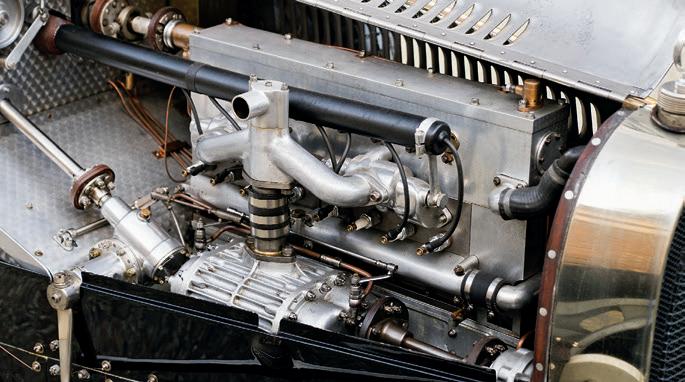
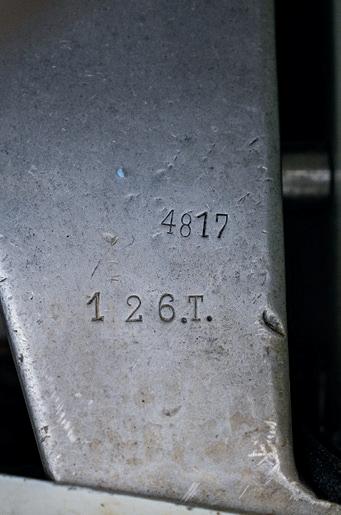

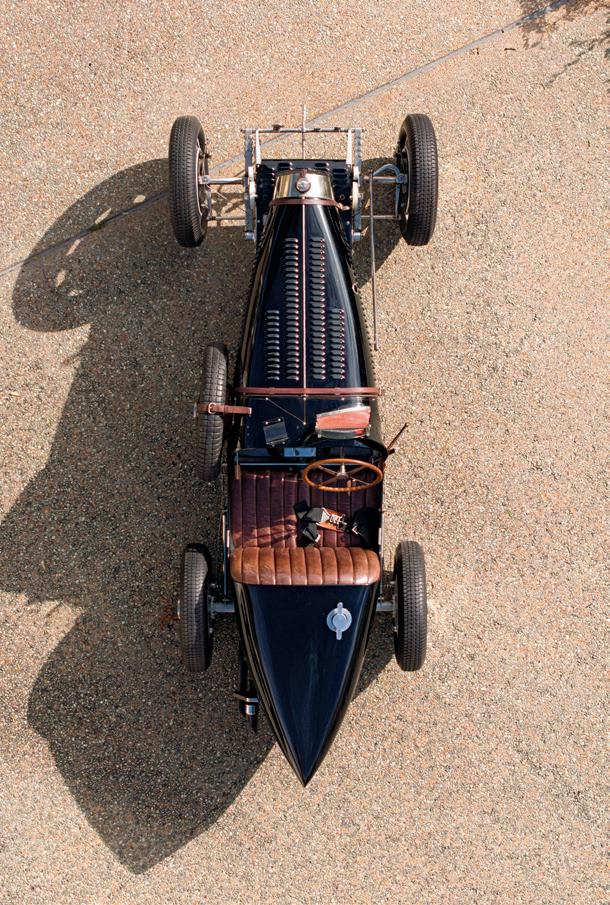
FROM THE MITCHELL RASANSKY COLLECTION
CHASSIS NO. T831342DN
ENGINE NO. VS1403-9
$175,000–$225,000 without reserve
Launched in 1958, the XK150 S represents the ultimate development of Jaguar’s legendary line of XK sports cars. In its original 3.4-litre form, the “S” model yielded significant performance dividends, with three SU carburetors, straight-port intake manifolds, and upgraded camshafts contributing 60 hp over the standard XK150. Equipped with Le Mans-proven Dunlop disc brakes, these Jaguars were among the fastest and most comfortable GT cars of the late 1950s. The most sporting version was the Roadster, of which only 888 were built.
This open two-seater was dispatched to Jaguar Cars New York in precisely the form that we see the car today, according to its Jaguar Daimler Heritage Trust (JDHT) Certificate. It has 3.4 “S” specifications, with the addition of the
HIGHLIGHTS
One of Just 888 XK150 S 3.4-Litre Roadsters Built Presented in Striking Original Black over Red Color Scheme
Retains Matching-Numbers Engine with Desirable Overdrive per JDHT Certificate
Eligible for Numerous Tours, Shows, and Club Events
Final and Most Developed Iteration of Jaguar’s Legendary XK Line
practical Laycock de Normanville electric overdrive (suffix DN) and is further finished in black with a red interior and black top.
Having acquired a Jaguar XK140, Mitchell Rasansky’s search for that model piqued interest in its successor, the XK150. When he discovered this example near the completion of its restoration, it proved irresistible. When finished, its transaction was completed and the car arrived in Texas.
Never toured or shown by Mr. Rasansky, the Jaguar remains in extremely good aesthetic order, and should prove to be a popular show car.
SPECIFICATIONS
3,442 CC DOHC Inline 6-Cylinder Engine
Three SU HD8 Carburetors
250 BHP at 5,500 RPM
4-Speed Manual Gearbox with Overdrive
4-Wheel Dunlop Disc Brakes
Front Independent Suspension with Torsion Bars and Shock Absorbers
Rear Live Axle with Semi-Elliptical Leaf Springs and Shock Absorbers

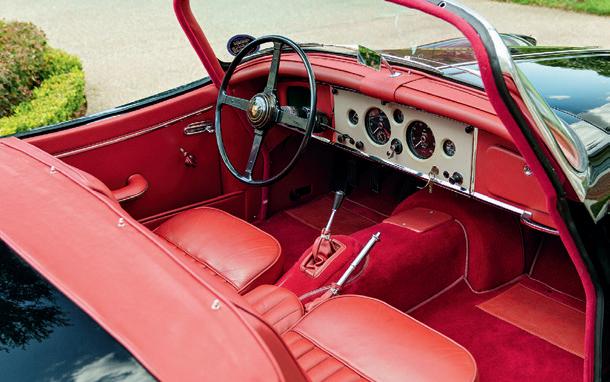

FROM THE MITCHELL RASANSKY COLLECTION
CHASSIS NO. 18-178144
ENGINE NO. 99A-217466
$250,000–$350,000
Few automobiles so completely embody the spirit of American hot rodding as the 1932 Ford Roadster. Affectionately known as the “Deuce,” the ’32 Ford became the blueprint for generations of racing machines stripped down and built up in garages across postwar America. Among the countless cars that raced across dry lakes, city streets, and drag strips, few can match the provenance of the “Mitchell Auto Co. Special.”
The early history of this 1932 began with a young Air Force captain named Chuck Adams, who drove the car daily while stationed in Denver. A Texas native, Adams would return to Dallas after his military service to found Custom Automotive, a pioneering speed shop at the heart of Texas hot rod culture. In
HIGHLIGHTS
Period Race History at Daytona and Bonneville in 1951 and 1952
Single Ownership Spanning over 60 Years
Flathead V-8 Constructed by Legendary Engine Builder Vern Tardel Campaigned Extensively Throughout the 1950s and Early 1960s
Beautifully Restored to Its Original Race-Ready Configuration
Displayed at the 2007 Pebble Beach Concours d’Elegance®
1951, this Roadster made its national debut at the Daytona Beach Speed Trials before heading west to Bonneville, where Adams achieved an impressive 136.363 mph. Determined to go faster, Adams returned home and, with guidance from Bill Meeks, an engine builder for Vic Edelbrock, rebuilt the car with even greater performance in mind. When Adams returned to Bonneville in 1952, the results were dramatic, with the roadster recording a remarkable 152.57 mph.
In 1956, the Roadster passed to fellow Dallas native, Mitchell Rasansky, who has been the faithful steward for this car ever since. Though Adams retained the record-setting engine, Rasansky purchased the rolling chassis and commissioned famed flathead builder Vern Tardel to build a new powerplant. The result was
SPECIFICATIONS
286 CID Flathead V-8 Engine
Four Stromberg 97 Carburetors
Estimated 140+ BHP at 4,200 RPM
3-Speed Manual Gearbox
2-Wheel Hydraulic Rear Brakes
Front Solid Axle with Transverse Leaf Springs and Tubular Shocks
Rear Halibrand Quick Change Axle with Transverse Leaf-Spring Suspension

Chuck Adams, Dallas, Texas (acquired circa 1940s)
Mitchell Rasansky, Dallas, Texas (acquired from the above in 1956)
Bonneville Salt Flats, 1951, Adams (136.363 mph)
Bonneville Salt Flats, 1952, Adams (152.57 mph, 4th in C Roadster)
Caddo Mills Dragway, Texas, 1950s–early 1960s, Rasansky
Pebble Beach Concours d’Elegance®, 2007

a 286 cid flathead V-8, fed by four Stromberg 97 carburetors to deliver more than 140 hp – making the car a period-correct drag racing masterpiece.
Rasansky campaigned the Roadster extensively at Texas drag strips, including the famed Caddo Mills Dragway, where the car consistently turned 10.5 second passes at over 128 mph. Its lightweight and powerful setup helped the car win numerous Middle Eliminator trophies.
In a testament to its historical significance, Rasansky meticulously restored the car to its original configuration in time for the 75th anniversary of the 1932 Ford, where this car was honored with an invitation to the 2007 Pebble Beach Concours d’Elegance® and displayed in a special class celebrating the most important hot rods ever built.
Now offered after over 60 years of single ownership, this 1932 Ford Roadster is not merely a car, it is a running chronicle of early American speed culture. A proven competitor at Daytona, Bonneville, and Texas drag strips alike, with a direct lineage to some of the most respected names in hot rod history, this car stands as a monument to both Dallas and national hot rod heritage.



ENGINE NO. 140
$100,000-$150,000 without reserve
An iconic piece of American open-wheel history, this 1950 Sprint Car affectionately known as the “McNamara Special” was originally commissioned by Lee Elkins of McNamara Trucking, an ambitious freight shipping magnate with a taste for speed. This Sprint Car was built by master mechanic Harry Turner in Kenosha, Wisconsin, whose craftsmanship would come to define the car’s early dominance.
From the outset, the McNamara Special was a front-runner. In 1952, this chassis carried Joey James to a National Sprint Car Championship. By 1954, Harry Turner, alongside Indy crew chief Charles Szkendy, reengineered the car into its current form. Over its competitive lifespan, it was piloted by some of the sport’s most daring talents, including “Iron Mike” Nazaruk, Andy Linden, and
1952 National Championship-Winning Sprint Car Driven by Joey James
Built by Harry Turner for the Legendary Lee Elkins of McNamara Trucking Driven by Icons Joey James, Mike Nazaruk, Andy Linden, and Ed Elisian
Successfully Campaigned until the 1959 Season
A True Artifact of Postwar American Sprint Car Racing Heritage
Ed Elisian. Notably, Elisian captured a USAC feature win at Dayton in this chassis, contributing to its 6th Place finish in the 1958 USAC Season Championship.
Campaigned at storied tracks such as Winchester, Salem, and Fort Wayne’s high banks, the McNamara Special became synonymous with raw speed, capable of exceeding 100 mph on the straights. During its career, it raced under several numbers: 3, 73, and 83. Sold to Ohio racer Homer Allen in 1958, the car ran its final competitive season in 1959 before being carefully stored. Rediscovered in 1985 in remarkably original condition, the McNamara Special has since been authentically restored to the configuration in which it last raced.
220 CID DOHC Offenhauser Inline 4-Cylinder Engine
Hilborn Fuel Injection
Estimated 220 BHP at 6,600 RPM
In-Out Manual Gearbox
4-Wheel Halibrand Disc Brakes
Front Tubular Axle with Transverse Leaf Spring
Rear Halibrand Quick-Change with Radius Arms and Torsion Bars
*Please note that this vehicle is sold on a Bill of Sale.


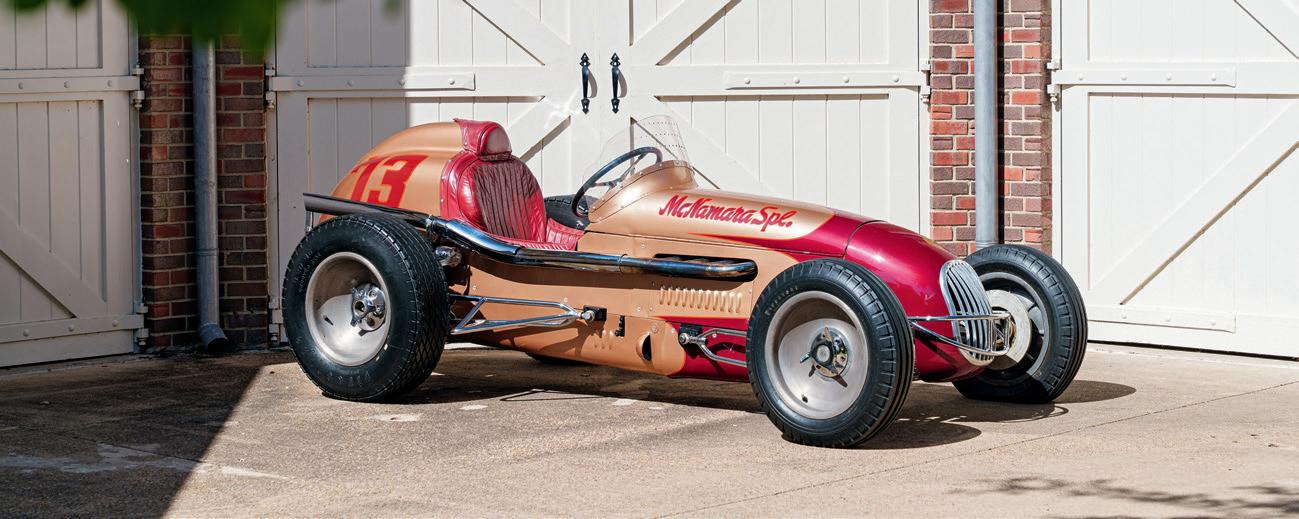
ENGINE NO. N6
$600,000–$900,000
The contributions of Harold Arminius Miller to the early years of motor sports are essentially impossible to overstate. Miller-designed or powered cars won the Indianapolis 500 a then unprecedented 12 times, beginning in 1922, when a Miller-powered Duesenberg claimed victory at the Brickyard. His concepts led to some of the very first purpose-built race cars that were not merely modified road equipment. Over 100 years later, the sheer beauty and functionality of Miller’s groundbreaking designs, and his fanatical attention to detail, continue to be a source of marvel. He pioneered the use of lightweight materials, supercharging, and front-wheel- and four-wheel-drive chassis. Surviving Miller cars and components are extremely rare and prized on an unprecedented level.
The Miller car on offer, a front-drive Model 91, is one of just 12 to 15 examples thought to have been made. According to Miller historian and author Mark Dees’volume on the marque, it is believed that the car was built from the damaged components of front-drive No. 4, which had been part of Earl Cooper’s team. It was driven by Jules Ellingboe at the 1927 Indianapolis 500, but crashed on the 25th lap. Dees contends that the components of No. 4 – and possibly No. 5 as well – were rebuilt by Texas-based racer Phil “Cowboy Red” Shafer within the AC spark plug workshops of General Motors, with Indy in his sights. Finished with a distinctly louvered hood, a dramatically flared cowl, and a higher-profile tail, the car raced at Indianapolis in 1928 and 1929, placing 6th and 12th respectively.
Participated in the 1928 and 1929 Indianapolis 500 Prior to Reconstruction
Driven to Numerous Speed and Track Records by Gwenda Stewart-Hawkes as the Derby-Miller
Retains a Significant Number of Original Components
Frame Built to Original Dimensions by Respected Engineer Peter Shaw
A Truly Historic Miller Offered for the First Time Since Assembly and Restoration
*Please note that this vehicle is sold on a Bill of Sale.
Estimated 1,671 CC DOHC Inline 8-Cylinder Engine
Estimated 250 BHP at 8,000 RPM
Single Miller-Type Downdraft Carburetor
Centrifugal Supercharger
4-Wheel Drum Brakes, Front Inboard
Front Live Axle with Semi-Elliptical and Quarter-Elliptical Leaf Springs
Rear Solid Axle with Semi-Elliptical Leaf Springs
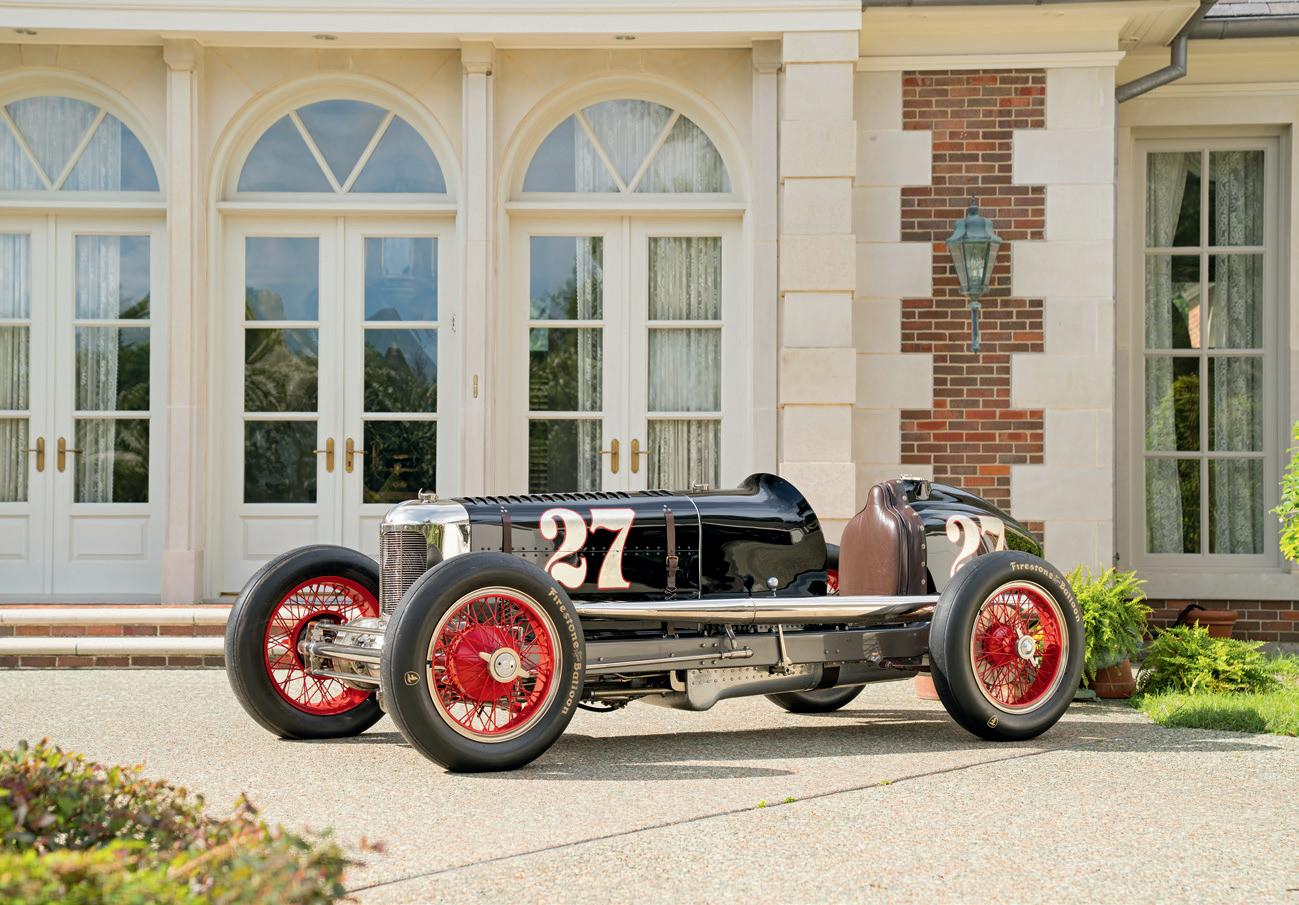
Indianapolis 500, 1928, Stapp, No. 7 (6th) Indianapolis 500, 1929, Shafer, No. 17 (12th)
Montlhéry, Class F, 1,500 CC, 1930 (100 Mile, 1 Hour, 200 Km Records, 118 mph)
Montlhéry, Class E, 2,000 CC, 1930 (5 Km Record, 129.01 mph)
Montlhéry, Class E, 2,000 CC, 1930 (5 Mile Record, 128.14 mph)
Montlhéry, 1930 (World 10 Mile Record, 137.20 mph)
Montlhéry, 1931 (5 Km Record, 140.47 mph)
Montlhéry, 1931 (5 Mile Record, 139.48 mph)
Montlhéry, 1932 (10 Km Record, 141.36 mph)
Montlhéry, 1934 (2 Mile Record, 143.29 mph)
Montlhéry, 1934 (World 10 Mile Record, 138.34 mph)
English racing driver Douglas Hawkes saw Shafer’s Miller in action at the 1929 race and arranged to purchase it, as rule changes would soon render it obsolete in the US. Hawkes, along with Lt. Col. Stewart and his wife Gwenda – herself a formidable driver at the limit – had set several speed and endurance records at the Montlhéry circuit. They knew that to sustain their success, they would need a Miller to achieve ever higher speeds – and front drive, to raise the profile of the design – as their French company, Derby, was advancing the concept.
Gwenda Stewart had driven ambulances in WWI and is described by Dees as “one of the most remarkable people of her time, and probably the bravest, most skillful woman ever to hold the steering wheel of a racing car.” In her “office,” driving the Miller at Montlhéry in 1930, she was successful in breaking the 100-Mile 1-Hour, and 200 Km records. They would by no means be the last records to fall as a result of her efforts.
In 1931, following engine failure at Brooklands while attempting to break Leon Duray’s flying kilometer record, the powerplant was substantially rebuilt by Derby and enlarged slightly to run in the 2,000 cc category. More records fell, Gwenda’s popularity soared, and the Derby-Miller was steadily improved throughout; however, at Brooklands in August 1931, the engine failed once more. A new emboldened crankcase was fashioned using metric threads,
the compression ratio was raised, and new superchargers were built. The gearbox was similarly strengthened and spring rates were optimized to handle the increased power. As a result of their efforts, the Derby-Miller was the most highly developed of all 91 front-drives, remaining on its original chassis through at least 1935. In August of that year at Brooklands, Gwenda and the Derby-Miller – with a smooth-paneled bonnet in place of Shafer’s louvered unit – took part in a match race with Kay Petre, who was driving an 11-liter Delage. Despite the 9-liter delta in displacement between the women’s cars, Gwenda posted a lap time less than 1 mph behind Petre, and the event marked the final contest for Gwenda and her mighty Derby-Miller.
The following year, the car, and its patterns and spares were offered for sale. They were purchased by Bobby Baird, proprietor of the Belfast Telegraph in Northern Ireland, where it was largely disassembled. The engine was found decades later by Griff Borgeson and made its way to the Indianapolis Motor Speedway Museum.
Long-missed collector Bob Sutherland was a true enthusiast and catalyst for two aspects of the hobby that we enjoy today. Firstly, he founded the Colorado Grand, still one of the most popular 1000 Miglia-style retrospectives in America, and one that spawned any number of similar events. In addition, he

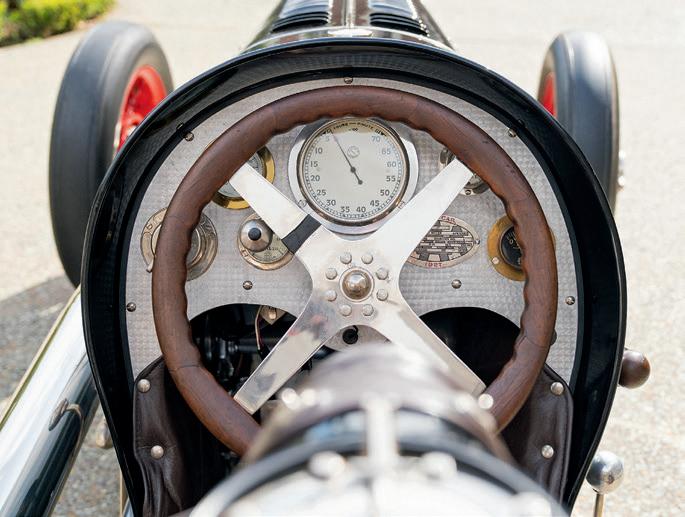

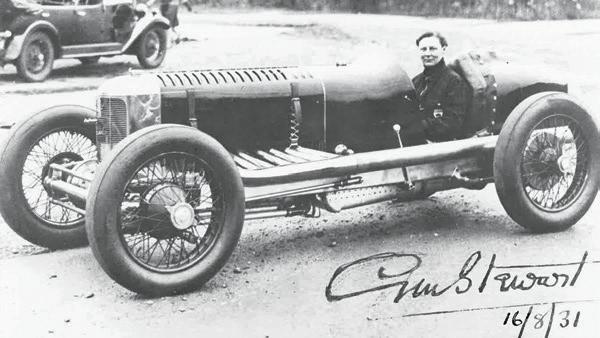
Pebble Beach Concours d’Elegance®, 2000, 2010
Harry Miller Club Meet, multiple occasions since 2000
was passionately interested in the evolution of the 1930s twin-cam engine cars of both American and European construction. Consequently, in his stable when he passed were Grand Prix Maseratis and Bugattis and a number of Millers.
He and a handful of others are directly responsible for the revival of enthusiasm in the Miller marque. Frequently traversing the UK, Europe, and America in the mid-1990s, he learned of surviving components from a FWD Miller discovered in the UK by David Harrison. This led him to purchase the engine from the Indianapolis Motor Speedway Museum and enlist renowned sleuth Richard Crump to source more parts from an exploratory trip to Belfast, including an original hood panel still marked with “Derby.” Intent on building a modern-day reconstruction of this fabled and accomplished Miller, the final piece was to commission a FWD frame to be built by expert engineer Peter Shaw.
Ultimately, when his appetite for projects waned, Mitchell Rasansky stepped in to follow the venture through to completion, with assistance from Bob Willey and Chuck Davis. A new body was constructed, including the hood, in order to preserve the original as a piece of history, rather than risk losing its original finish. The Gwenda Stewart-Hawkes car made its debut in restored form at Pebble Beach in 2000, where it wowed spectators with its striking appearance and visceral motive power.
Since 2000, this Miller has been shown around the world, including on multiple occasions at the Goodwood Festival of Speed and the annual Harry Miller Meet at the Milwaukee Mile. This historic Miller 91 remains a captivating sight to behold and hear — its survival is a lasting testament to Mitchell Rasansky and the late Bob Sutherland.
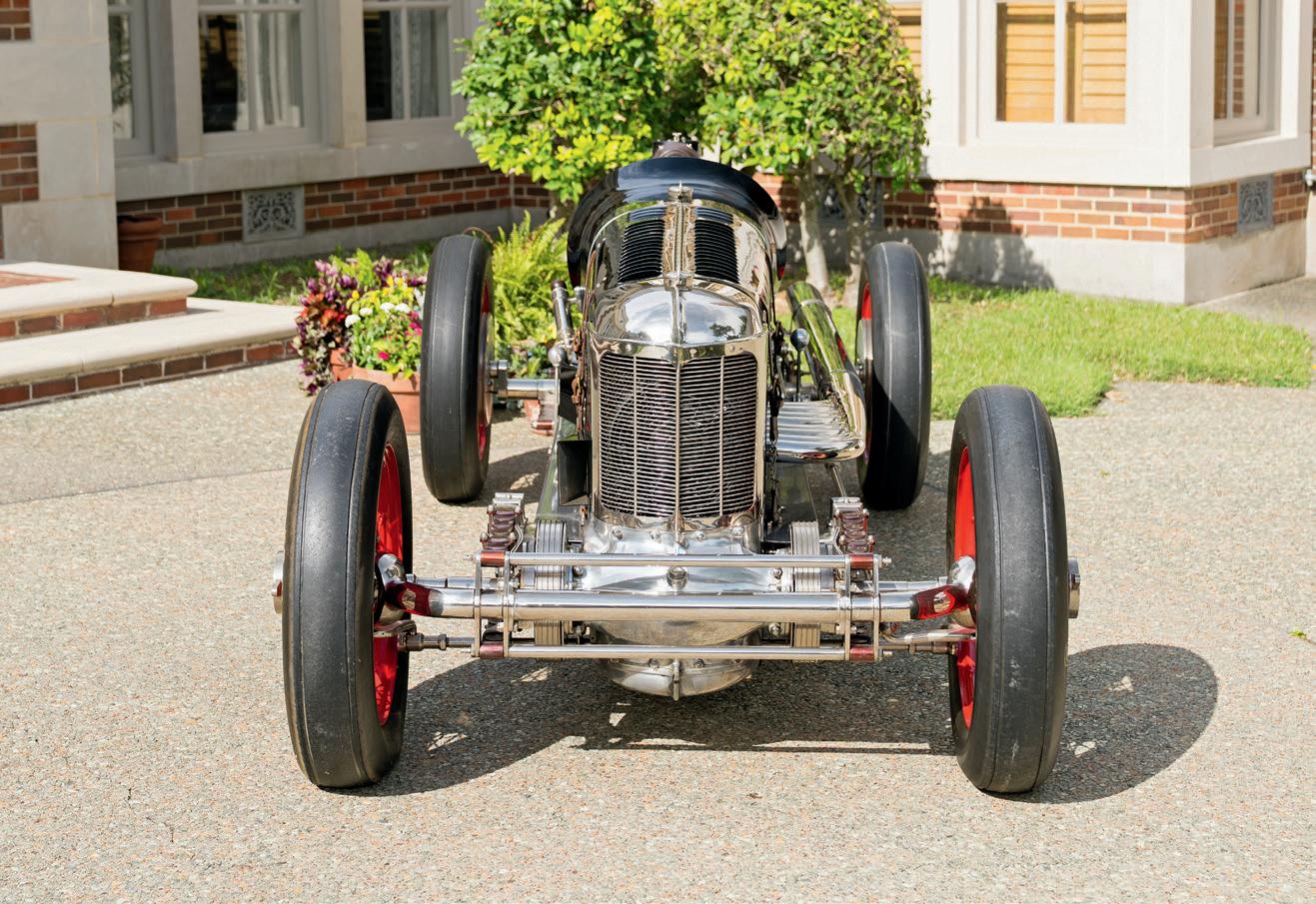
FROM
CHASSIS NO. S812297DN
ENGINE NO. G7200-8S
$125,000–$175,000 without reserve
Jaguar’s XK140 added several meaningful developments to its predecessor, the XK120, honed from their C-Type’s 1951 and 1953 Le Mans wins. Notably, the XK140’s optional MC package included a C-Type cylinder head, larger carburetors, dual exhaust, wire wheels, and fog lamps.
According to its JDHT Certificate, this is one of those desirable MC models, further enhanced with overdrive – signified by its “DN” suffix. Recorded as shipped to Jaguar Cars New York, it was then sold through the St. Louis, Missouri agent to Charles King in April 1956. The XK was discovered in the late 2000s in need of refurbishment by Philip Taxman, also of St. Louis, suggesting that it may have remained in that area throughout its life.
HIGHLIGHTS
Extremely Desirable Combination of Roadster Bodywork, MC Package, and Overdrive
Retains Matching-Numbers Engine per JDHT Certificate
Eye-Catching, High-Quality Restoration
Former JCNA Concours Winner, Judged at 99.98 Points in 2011
Displayed at the 2012 Indianapolis 500 Celebration of Automobiles
An extensive rebuild followed, and the completed car debuted at Jaguar Club North America events in 2011. At the Kemp Auto Museum Concours in October of that year, it earned a score of 99.98 points. It was also shown at the 2012 Celebration of Automobiles at the Indianapolis Motor Speedway and is noted as a 2014 JCNA Class 3 Champion.
One of Mr. Rasansky’s earliest automotive acquisitions had been an XK140 Roadster, leading him on a nostalgic search for another one. After reviewing a number of fully restored examples, he ultimately selected chassis S812297DN in the mid-2010s. In his years of tenure, the Jaguar has remained cherished in his motor house, rarely being used.
SPECIFICATIONS
3,442 CC DOHC Inline 6-Cylinder Engine
Twin SU H8 Carburetors
210 BHP at 5,750 RPM
4-Speed Manual Gearbox with Electric Overdrive
4-Wheel Hydraulic Drum Brakes
Front Independent Suspension with Torsion Bars and Telescopic Shock Absorbers
Rear Live Axle with Semi-Elliptical Leaf Springs
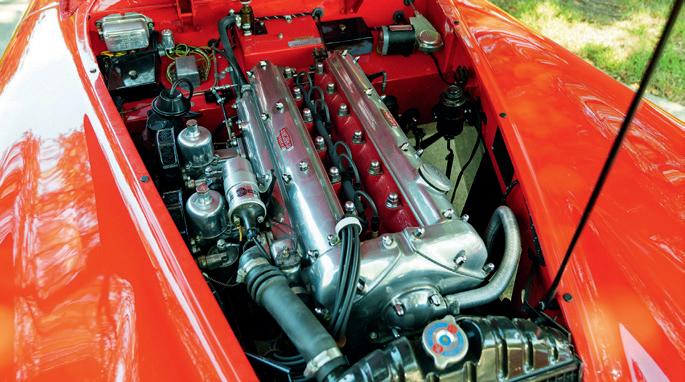


$40,000–$60,000 without reserve
This 1939 Kurtis-Kraft Midget Racer is a handcrafted artifact from the formative years of Frank Kurtis’s legendary career, built for Texas racer Gene Fredericks and powered by an early dual overhead cam engine developed by Barnes & Hubbard Machine Co.
According to correspondence included in the history file, this example was constructed in 1939, shortly after Kurtis completed a run of six customer midgets. Built before WWII, the car predates the formal production runs that would later cement Kurtis’ reputation, making it one of the earliest known Kurtis-bodied midget racers. At the time of construction, Barnes & Hubbard was developing an innovative dual overhead cam engine, which was fitted to this car and remains in place today.
HIGHLIGHTS
Built by Frank Kurtis in 1939 for Racer Gene Fredericks
Features Rare Barnes & Hubbard Dual Overhead Cam Engine
Winner of the 500-Lap General Wainwright Classic in 1950
Extensive Documentation Includes Photos, Correspondence, and Period References
Historic Example from the Founding Era of American Midget Racing
*Please note that this vehicle is sold on a Bill of Sale.
This Midget Racer was originally commissioned by team owner Gene Fredericks, one of the Southwest’s most active and competitive dirt track racers. Fredericks campaigned the car extensively throughout the 1940s and famously drove it to victory in the grueling 500-lap General Wainwright Classic in Tulsa in 1950. Offered today with an extensive history file, this Kurtis-Kraft Midget Racer stands as an authentic and remarkably preserved link to the golden age of American midget racing. Built by one of the most influential names in American race car design and raced by one of Texas’ most decorated oval track drivers, this car presents a rare opportunity to acquire a cornerstone of oval track racing history.
SPECIFICATIONS
90 CID Barnes & Hubbard Machine Co. DOHC Inline 4-Cylinder Engine
Twin Sidedraft Riley Carburetors
Estimated 110 BHP
In-Out Manual Gearbox
2-Wheel Rear Drum Brakes
Front Tubular Axle with Transverse Leaf Spring and Torsion Bars
Rear Quick-Change Live Axle with Torsion Bars and Radius Rods
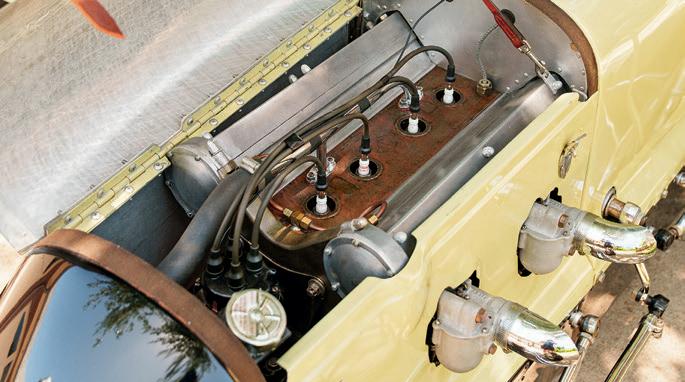
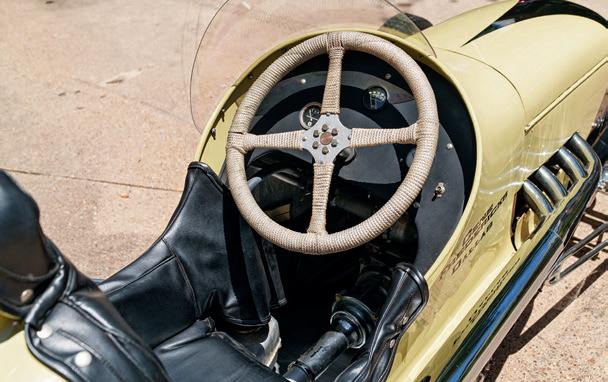
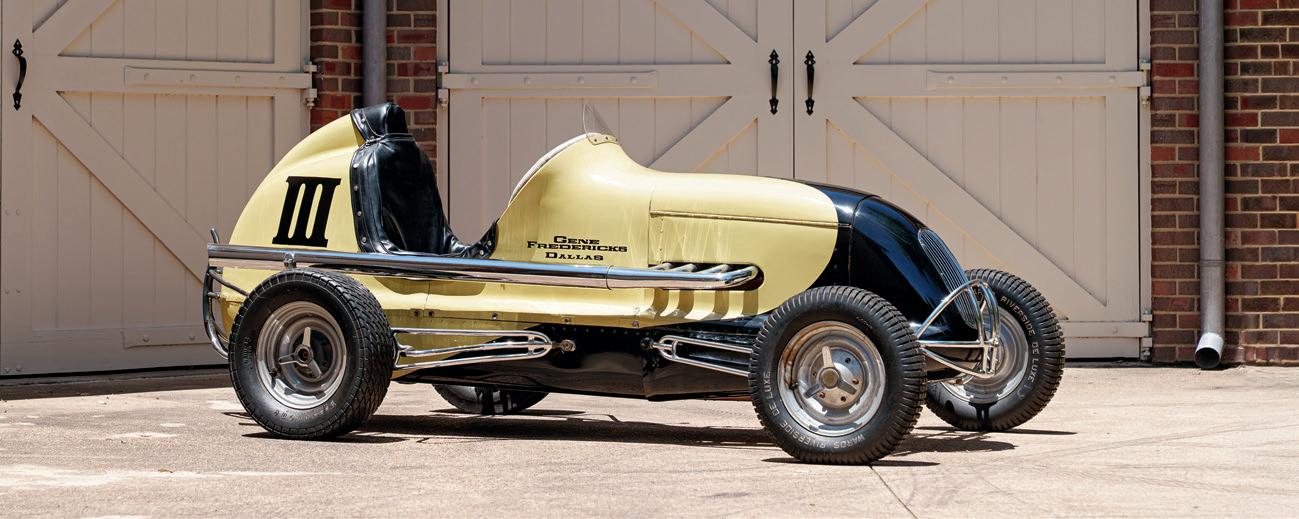
CHASSIS NO. BC035
FRAME NO. 179
ENGINE NO. 194T (EX-4939)
$625,000–$850,000
The Bugatti Type 35 was first unveiled to the public at the Grand Prix of Lyon in 1924, and was built in several different naturally aspirated and supercharged variations through 1931. Widely considered the finest racing car of the period, the Type 35 was highly successful throughout the late 1920s and early 1930s, with over 1,000 wins in a variety of competitions, including the Monaco Grand Prix three times and Targa Florio five times.
The Type 35 was mechanically impressive, boasting a supercharged 2.3-liter single overhead-cam, inline eight-cylinder engine in its late 35B form, capable of producing 130 hp at 5,500 rpm. The car’s extremely lightweight chassis showcased Bugatti’s revolutionary hollow front axle and cast aluminum wheels
HIGHLIGHTS
Grand Prix Type 35 Using Numerous Molsheim Components
Desirable Supercharged Configuration, Ideal for Vintage Racing and Rallies
Consists of Molsheim Engine Crankcases, Numbered Frame, Hood, Scuttle and Tail Section, Gearbox, and Rear Axle
Actively Campaigned in American Bugatti Club and VSCCA Events
Equipped with Fenders and Headlights for Touring Use
with integrated brake drums, while the main mechanical components were clothed in a streamlined, two-seat body that was both elegant and purposeful.
This Type 35 consists of a number of components manufactured at the Bugatti factory in Molsheim. These include the frame (no. 179), engine crankcases (no. 194T), gearbox and rear axle (from Type 37 no. 37163), steel scuttle and tail section (from Type 37 no. 37141), dash panel (from Type 35 no. 4849) and radiator (from Type 51 no. 51126).
It was acquired in pieces circa 1971 by the late London-based vintage car dealer Dan Margulies, from Bugatti restorer Ray Jones. By 1980, it was in the ownership
SPECIFICATIONS
2,262 CC SOHC Inline 8-Cylinder Engine
Roots-Type Supercharger
Single Carter Carburetor
Estimated 130 BHP at 5,500 RPM
4-Speed Manual Gearbox
4-Wheel Cable-Operated Mechanical Drum Brakes
Front Solid Axle with Semi-Elliptical Leaf Springs and Shock Absorbers
Rear Live Axle with Reversed Quarter-Elliptical Leaf Springs and Shock Absorbers

Dan Margulies, London, England (acquired circa 1971)
Dick Crosthwaite and John Gardiner, Buxted, England (acquired by 1980)
Jonathan Meadow, England (acquired from the above)
Terry Cardy, Suffolk England (acquired from the above)
Roger Howard, Quebec, Canada (acquired from the above in 1985)
Mitchell Rasanksy (acquired from the estate of the above in 2017)
International Bugatti Rally, Vermont, 1995
American Bugatti Club 1st Canadian Grand Prix & Rally, Canada, 2013
of restorers Dick Crosthwaite and John Gardiner, founders of the renowned prewar restoration workshop Crosthwaite & Gardiner in Buxted, England.
Following a few more UK-based owners, the Type 35 was acquired by Bugatti collector Roger Howard, who brought the car with him on his move from England to Canada. He spent many years buying, selling and trading parts in a concerted effort to create a complete and running supercharged Grand Prix Bugatti with as many original Molsheim parts as possible. Following his successful completion, the car was granted a ‘BC’ chassis plate from the Bugatti Owners’ Club in England in September 1987.
Howard campaigned the powerful supercharged Bugatti on a number of American Bugatti Club events, including the International Bugatti Rally in Vermont in 1995 and the American Bugatti Club 1st Canadian Grand Prix & Rally in 2013. Most remarkably, he always drove his supercharged Type 35 to these events from Quebec.
The engine crankcase currently fitted to this Type 35 (no. 194T) was originally fitted to Chilean grand prix racing driver Juan Ernesto Zanelli’s Type 35B, chassis 4939. Zanelli campaigned that car at numerous events, including the 1930 Monaco Grand Prix.
Mitchell Rasanksy, who has a passion for prewar racing cars – and particularly those with supercharged eight-cylinder engines such as the Bugattis and the Miller offered here from his collection – carefully sought out this car because of its high percentage of original Molsheim components. During his ownership, Mr. Rasansky painted the Bugatti in a shade of flat black which, in combination with its patinated leather interior, create a truly appealing feel appropriate to the model’s racing origins.
All told, this beautifully assembled Type 35 is equipped with numerous factory components and would make a highly eligible entry at a plethora of Bugatti Club rallies and Vintage Sports Car Club events worldwide.
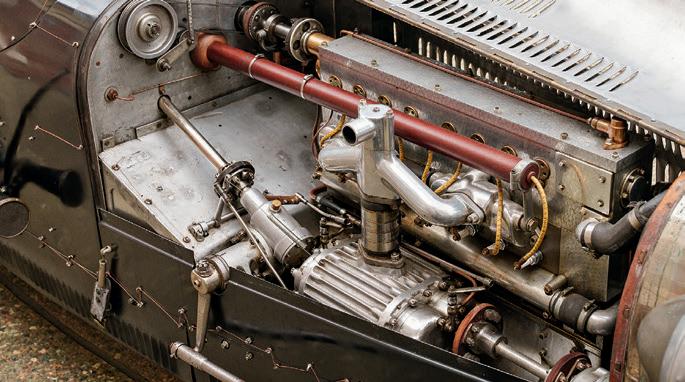

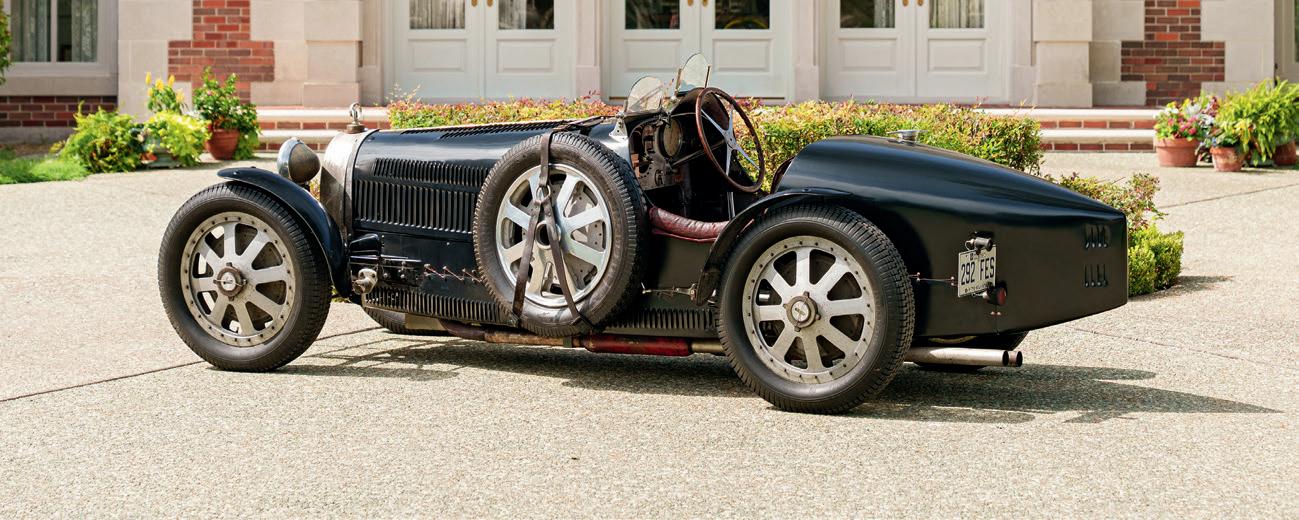
FROM THE MITCHELL RASANSKY COLLECTION
CHASSIS NO. 18-114654
$50,000–$70,000 without reserve
Few American automobiles have had as profound and lasting an influence on car culture as the 1932 Ford Roadster. Revered as the “Deuce,” it marked the debut of Ford’s flathead V-8 engine, an innovation that placed affordable performance within reach of a new generation of speed seekers. In the years that followed WWII, the ’32 became the cornerstone of the hot rod movement, embraced by builders and racers from the dry lakes of Southern California to Main Streets across America.
This particular 1932 Ford Roadster stands as a thoughtfully constructed homage to that golden era of postwar hot-rodding. Acquired by Mitchell Rasansky in June 2022 from a Southern California collection, the car embodies the spirit
HIGHLIGHTS
Powered by a Mercury 239 CID Flathead V-8 Engine
Striking Full-Fendered Steel Body with Tasteful Period Accessories
Classic Black Exterior with Matching Roll-and-Pleated Interior
Authentic Postwar Styling with a Host of Period-Correct Hot Rod Components
A True Tribute to the Golden Age of American Hot-Rodding and Craftsmanship
of early period-correct hot rod craftsmanship. While little is known about the early history of this car, every component echoes late -1940s hop-up practice.
Under the hood is a Mercury 239 cid flathead V-8, a period upgrade among traditional hot-rodders for its increased displacement. Fuel delivery is handled by a pair of Stromberg 97 carburetors, while finned Edmunds aluminum heads add performance and vintage flair. Power is routed through a desirable 1939 Ford three-speed manual gearbox, known for its improved synchros and durability. Finished in deep black with matching roll-and-pleated upholstery, this Roadster retains its fenders, and features a charming rumble seat, offering collectors the purest distillation of hot rod history.
SPECIFICATIONS
239 CID Mercury Flathead V-8 Engine
Twin Stromberg 97 Carburetors
Estimated 100 HP at 3,800 RPM
3-Speed Manual Transmission
4-Wheel Hydraulic Drum Brakes
Front Solid Axle with Semi-Elliptical Leaf Springs
Rear Live Axle with Semi-Elliptical Transverse Leaf Springs

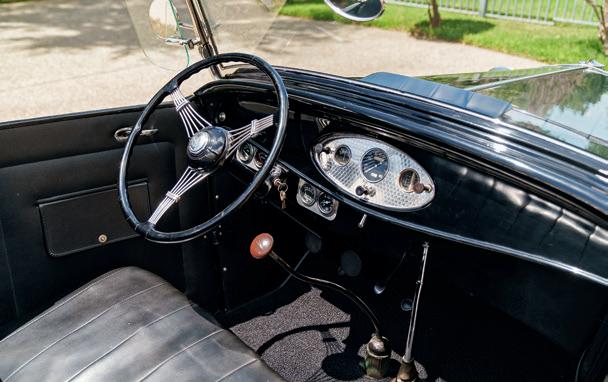
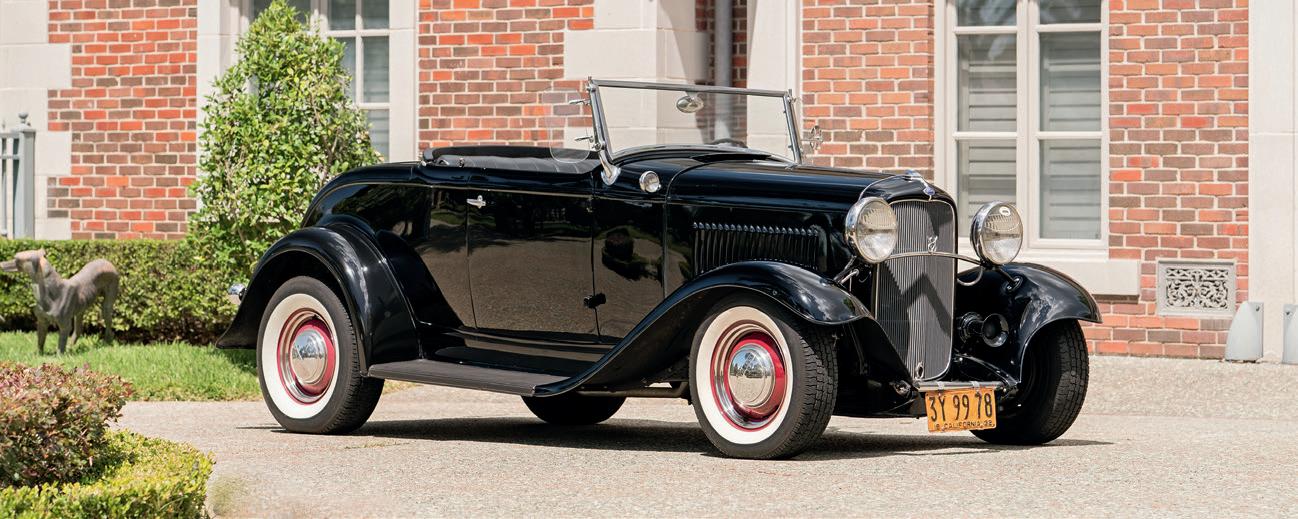
VIN. W1KYJ8BA6MA041713
$300,000–$350,000
Much as exclusive fashion ateliers reserve their “black label” creations for the most discerning clients, Mercedes-AMG bestows the coveted Black Series name upon its most extreme and uncompromising machines. Unveiled in 2020 as the apotheosis of the GT lineage, the GT Black Series was engineered with a singular purpose: to deliver unparalleled track capability in a package just tame enough for the road. Powered by a hand-built, flat-plane crank variant of AMG’s formidable twin-turbocharged V-8 – good for a staggering 720 hp – the GT Black Series shattered the Nürburgring production car lap record upon debut, affirming its status as a modern exotic performance car icon.
Even half a decade on, the GT Black Series remains the most singularly focused
HIGHLIGHTS
Features Black Series-Exclusive Flat-Plane Crankshaft and Carbon Ceramic Brakes
Documented with Original Window Sticker and Equipped with $4,500 Burmester Audio System
The Nürburgring Nordschleife Production Car Lap Record Holder from 2020 to 2021
One of Only 11 US-Delivery Examples Finished in Gorgeous Selenite Grey Metallic
Offered from Original Ownership with Under 920 Miles when Catalogued
member of an elite lineup, featuring an array of specification changes and material upgrades – chief among them a switch from aluminum to predominantly carbon fiber bodywork. Other key enhancements include thoroughly revised suspension geometry, carbon ceramic brakes, and aggressive active aerodynamics capable of generating nearly half a ton of downforce at 155 mph – well shy of its 202 mph claimed top speed. Showing less than 920 miles when catalogued and offered from single ownership, this Black Series is one of just 11 US-delivered examples in Selenite Grey Metallic and features black Exclusive upholstery with orange stitching and AMG matte carbon fiber trim. This exceptional automobile represents a rare opportunity to acquire the pinnacle of AMG’s Black Series heritage.
3,982 CC Twin-Turbocharged V-8 Engine
Electronic Fuel Injection
720 BHP at 6,700 RPM
7-Speed AMG Speedshift DCT Gearbox
4-Wheel Carbon Ceramic Disc Brakes
Front and Rear Double-Wishbone Suspension with AMG Coil-Overs and Adaptive Damping
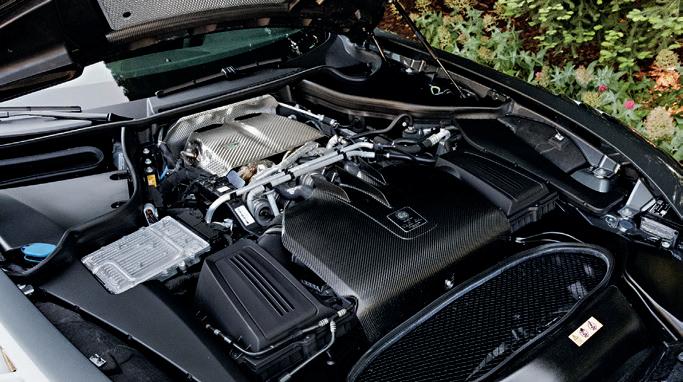
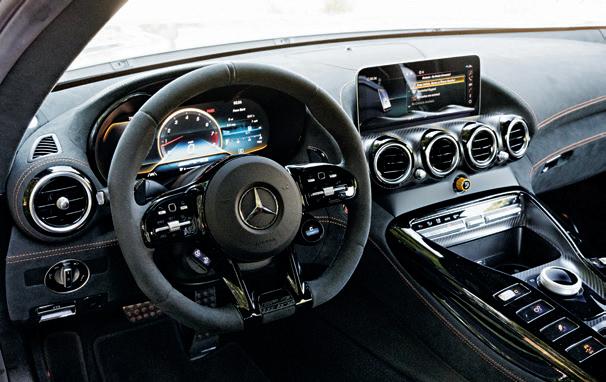


CHASSIS NO. 57297
ENGINE NO. 151
$250,000–$325,000 without reserve
Introduced in 1934, the Type 57 is widely regarded as a masterpiece by the hand of Jean Bugatti. According to a copy of the American Bugatti Register and Data Book entry on file, this Type 57 was ordered on November 30, 1934, and delivered on January 25, 1935, to its first owner, Jean Verdier, through Bugatti agent Dominique Lamberjack in Paris. M. Verdier paid 66,240 French francs for his new Bugatti, which was fitted with Ventoux coupe-style coachwork and engine no. 151, which it retains today.
In 1938, M. Verdier traded this Type 57 towards another example (chassis 57389), and it was later sold by Lamberjack to Léon Givon. By 1963, the Ventoux was owned by noted early Bugatti collector John Shakespeare of Centralia,
HIGHLIGHTS
Formerly Part of the Schlumpf Reserve and Mullin Automotive Museum Collections
An Unrestored Example Retaining Its Original Body and Engine
Known History and a Perfect Candidate for Concours Restoration
Formerly Owned by Early Bugatti Collector John Shakespeare
An Ideal Entry Point into the Fabled Bugatti Marque
*Please note that this vehicle has been in long-term static storage and may not be currently operational. It will require mechanical attention prior to road use.
Illinois, whose collection came to the attention of Swiss textile magnate Fritz Schlumpf. Schumpf purchased the Ventoux, along with 29 other Bugattis from Shakespeare, on March 1, 1964.
A part of the famed Schlumpf Reserve Collection, this Type 57 remained in static storage and unrestored in Malmerspach, France, until 2008 when Peter Mullin purchased the entire collection. He displayed the Ventoux in the Mullin Automotive Museum for 13 years and it was subsequently purchased by the consignor. Remaining in unrestored condition and retaining its original engine and coachwork, this Type 57 would be an ideal candidate for a concours-level restoration.
SPECIFICATIONS
3,257 CC DOHC Inline 8-Cylinder Engine
Single Stromberg UUR-2 Carburetor
135 BHP at 5,000 RPM
4-Speed Manual Gearbox
4-Wheel Mechanical Drum Brakes
Front Solid Axle with Semi-Elliptical Leaf Springs and Shock Absorbers
Rear Live Axle with Reversed Quarter-Elliptic Leaf Springs and Shock Absorbers
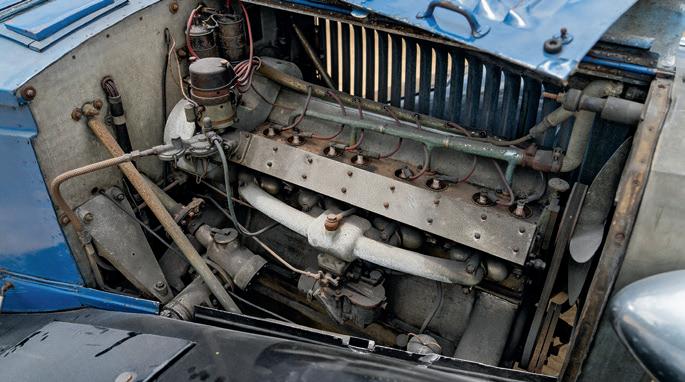
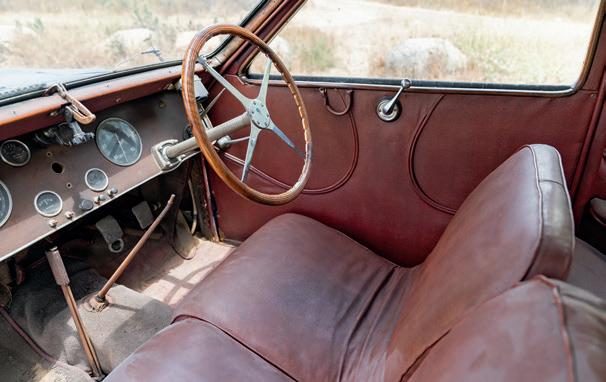


VIN. WP0ZZZ96ZNS491917
$325,000–$425,000
Introduced for the 1992 model year, the Porsche 964 Carrera RS marked the revival of the Rennsport nameplate for the first time since the iconic 911 Carrera RS 2.7 of 1973. Developed as a homologation model for Group N racing, it emphasized reduced weight, mechanical simplicity, and heightened driver involvement.
Weighing just 2,706 pounds – approximately 286 pounds lighter than the standard Carrera 2 – the RS achieved its weight savings through extensive measures. These included the removal of sound insulation and undercoating, and the deletion of features such as power windows, rear seats, airbags, and air-conditioning. Additional weight was shed through thinner side and rear
Remarkable Time Capsule Example Showing Less than 4,000 Km (2,485 Miles) when Catalogued
Sold New at Mizwa Motors in Tokyo and Complete with Rare Mizwa Accessories Box
Serviced by Noted Porsche Specialist Klub Sport Racing in 2021
Just Three Known Owners from New; Features Original Japanese Stickers Throughout
Accompanied by Books, Tools, Records, Jack, and Spare
glass, an aluminum front lid, a smaller battery, a reduced wiring harness, and lightweight 17” magnesium Cup wheels. The RS also featured seam-welded chassis reinforcements.
Power came from a 3.6-liter flat-six engine, designated M64/03, producing 260 hp at 6,100 rpm and 240 lbs./ft. of torque at 4,800 rpm. Enhancements over the standard M64/01 engine included matched pistons and cylinders, stiffer engine mounts, and retuned engine management. The engine was paired with a G50/10 five-speed manual transaxle featuring shorter gear ratios, a limitedslip differential, and a lightweight single-mass flywheel to sharpen response. Turbo-specification brakes, firmer springs and Bilstein dampers, and a 40 mm
3,600 CC Type M64/03 SOHC Flat 6-Cylinder Engine
Bosch Electronic Fuel Injection
260 BHP at 6,100 RPM
5-Speed Manual Transaxle with Limited-Slip Differential
4-Wheel Ventilated Disc Brakes
Front and Rear Independent Suspension with Coil Springs
*Please note that this vehicle will not be sold for use or resale in California or to a non-dealer California resident.
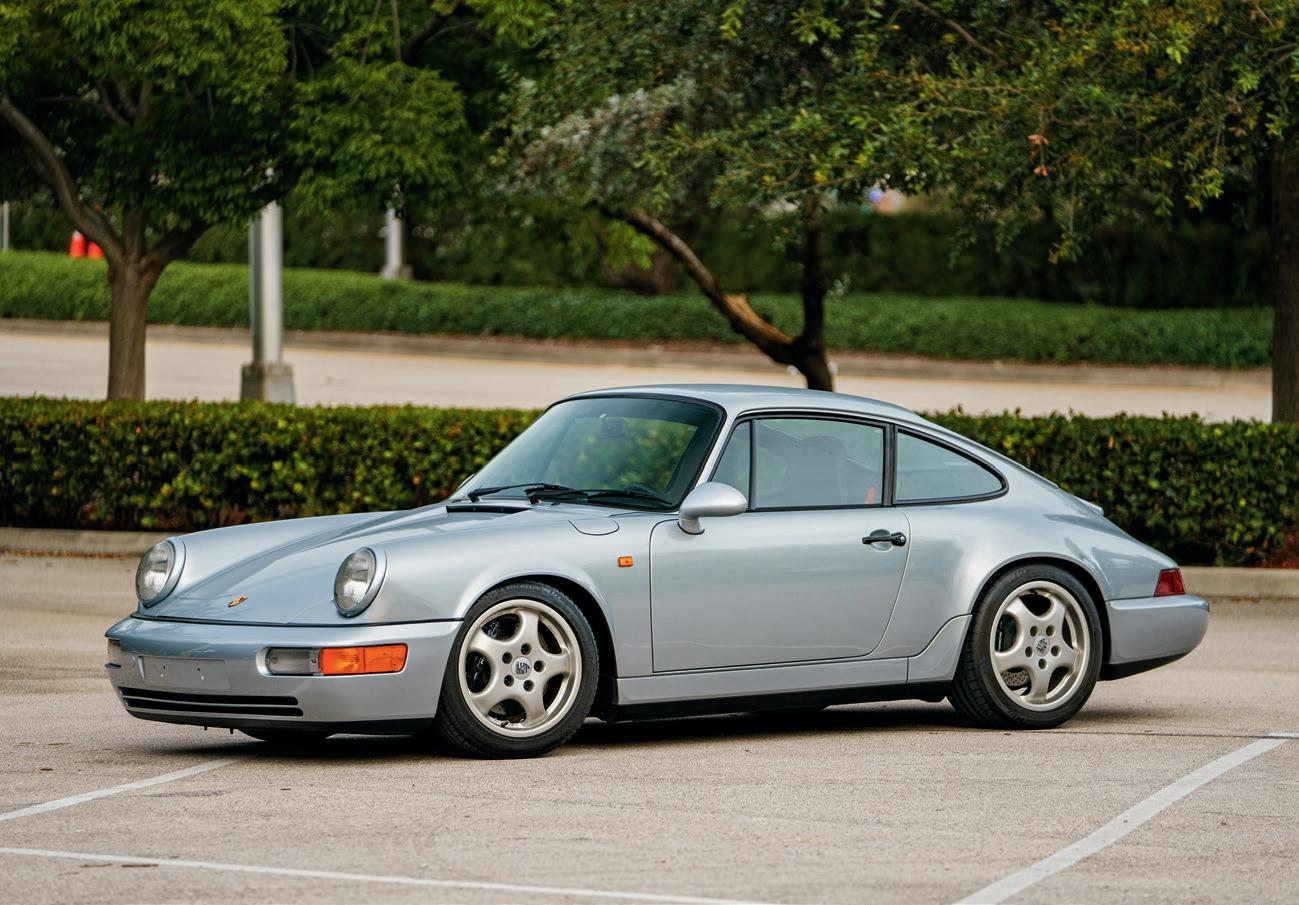

Private Collection, Japan (acquired new via official Porsche distributor Mizwa Motors)
Private Collection, New York (acquired in 2016)
Current Owner (acquired from the above)
ride height reduction completed the RS’s focused chassis setup.
This 1992 Porsche 964 RS is finished in Polar Silver over a Black leatherette interior with black leather Recaro bucket seats featuring grey inserts. One of just 1,910 lightweight RS models built between 1991 and 1992, it was delivered in Japan via Mizwa Motors in Tokyo, the official Porsche distributor at the time. Believed to have remained in a private Japanese collection since its sale in 2016, it was exported to the US in May of that year, where it joined a private, New York-based collection.
Acquired by the consignor, a knowledgeable and meticulous Porsche collector, in May 2021 – with guidance from noted marque experts Jeff Smith and Prescott Kelly – and showing just 378 km (235 miles) on the odometer, this RS was sent to specialist Klub Sport Racing in Riviera Beach, Florida, for recommissioning work, ensuring the car was properly prepared for use. Now showing less than 4,000 km (2,485 miles) at the time of cataloguing, this RS has been selectively driven by an owner who values both use and preservation. Remarkably original throughout, it still displays factory-applied Cosmoline coating on the chassis, Japanese stickers throughout, and its lightweight magnesium Cup wheels retain their original finishes. The car remains in excellent condition, supported by service records and invoices documenting consistent, expert care.
This 964 Carrera RS is supplied with its books, tools, keys, jack, spare, documentation, and its uncommon Mizwa “box” containing a number of branded accessories including gloves, protective vinyl seat covers, and a purple beacon intended for roof placement in case of nighttime breakdown or emergency.
Combining exceptional originality, low mileage, specialist care, and rare delivery items, this extremely well-preserved RS presents a standout opportunity for collectors seeking a highly authentic example of Porsche’s celebrated lightweight homologation model.
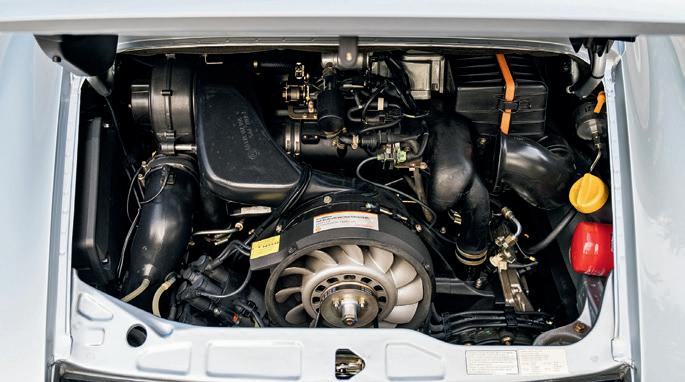


CHASSIS NO. 683044
ENGINE NO. 5302261
$90,000–$120,000 without reserve
This 1961 Volkswagen Type 2 11-Window Bus was built in November 1960, and delivered to Miller Motors in Steubenville, Ohio. Its original owner drove the car until 1968, at which point it was stored due to transmission failure.
Only in 1994 did an astute Volkswagen enthusiast rediscover the Bus, finding the car to be well-preserved after decades of storage. After bringing the Bus back to working order, the new owner commissioned an extensive reconditioning with an emphasis on originality. It was repainted in its original color scheme of Mango Green and Seagull Grey, while the interior required less attention, and the dash and floors retained their original paint, upholstery, and switchgear. Several wins on the AACA circuit corroborate the quality of this reconditioning.
HIGHLIGHTS
Well-Preserved Interior Retaining Original Upholstery and Finishes
Repainted in Original Colors with Correct Orange Peel and Weld Textures
Retains Matching-Numbers 1,200 CC Engine per Volkswagen Zertifikat
Showing Less than 30,000 Miles when Catalogued
Well Awarded on the Concours Circuit
The car retains its original, matching-numbers engine, noted for its untouched engine case as a symbol of its authenticity. Additionally, this 11-Window Bus is accompanied by its Volkswagen Zertifikat, periodicals featuring the car, original sales literature, purchase documentation from Miller Motors, awards, and relevant memorabilia. Furthermore, the car retains its original tool roll, jack, owner’s manual, and spare key. Showing under 30,000 miles, this example is heralded by those well-versed in the marque as one of the finest extant Volkswagen Buses. An excellent and highly original example of an iconic automobile, a discerning collector will appreciate this 11-Window Bus for years to come.
1,192 CC Air-Cooled Flat 4-Cylinder Engine
Single Solex 28 PCI Carburetor
34 BHP at 3,900 RPM
4-Speed Manual Gearbox
Front and Rear Drum Brakes
Front Independent Suspension with Torsion Bars
Rear Swing Axle with Torsion Bars




COACHWORK BY H.J. MULLINER
CHASSIS NO. BC43LCZ
ENGINE NO. C42BC
$300,000–$400,000
When introduced in 1959, the S2 Continental represented the ultimate in British motoring – the latest ultra-exclusive, high-performance model from Bentley. Befitting its elite nature, the S2 Continental was available in an array of body styles from England’s premier coachbuilders. H.J. Mulliner maintained its reputation as the coachbuilder of choice for those desiring the most sporting Continental. In fact, many aficionados consider Mulliner’s Two-Door Saloon (design no. 7514) the most attractive body style ever fitted to the chassis. Of the 388 S2 Continentals built, fewer than 100 were supplied with this elegant coachwork – the vast majority of which were specified in right-hand drive.
The S2 Continental presented here is among the most rare and sought-after
HIGHLIGHTS
Among the Most Rare and Sought-After Postwar Bentleys
One of Only 26 Left-Hand-Drive Examples of Mulliner’s Two-Door Saloon, Design No. 7514
Delivered New to Prominent Italian Industrialist Count Paolo Orsi Mangelli
Retains Matching-Numbers Engine and Original Coachwork per Factory Records
A Magnificently Presented and Well-Documented S2 Continental
of all postwar Bentleys – one of just 26 left-hand-drive examples built. Constructed from lightweight aluminum at the coachbuilder’s West London works, this top-of-the-line Bentley was custom-tailored for its original owner, Count Paolo Orsi Mangelli.
Born into nobility in 1880, Count Orsi Mangelli was an influential member of Italian society. A successful entrepreneur, he established a business empire with interests in agriculture, textiles, and tobacco. He was also one of the country’s most important horse breeders, known as “the father of the Italian trot.”
Completed in October 1961, chassis BC43LCZ was delivered new to Italian
SPECIFICATIONS
6,230 CC OHV Alloy V-8 Engine
Twin SU HD6 Carburetors
Estimated 178 BHP
4-Speed Automatic Transmission
4-Wheel Servo-Assisted Drum Brakes
Front Independent Coil-Spring Suspension
Rear Live Axle with Semi-Elliptical Leaf Springs
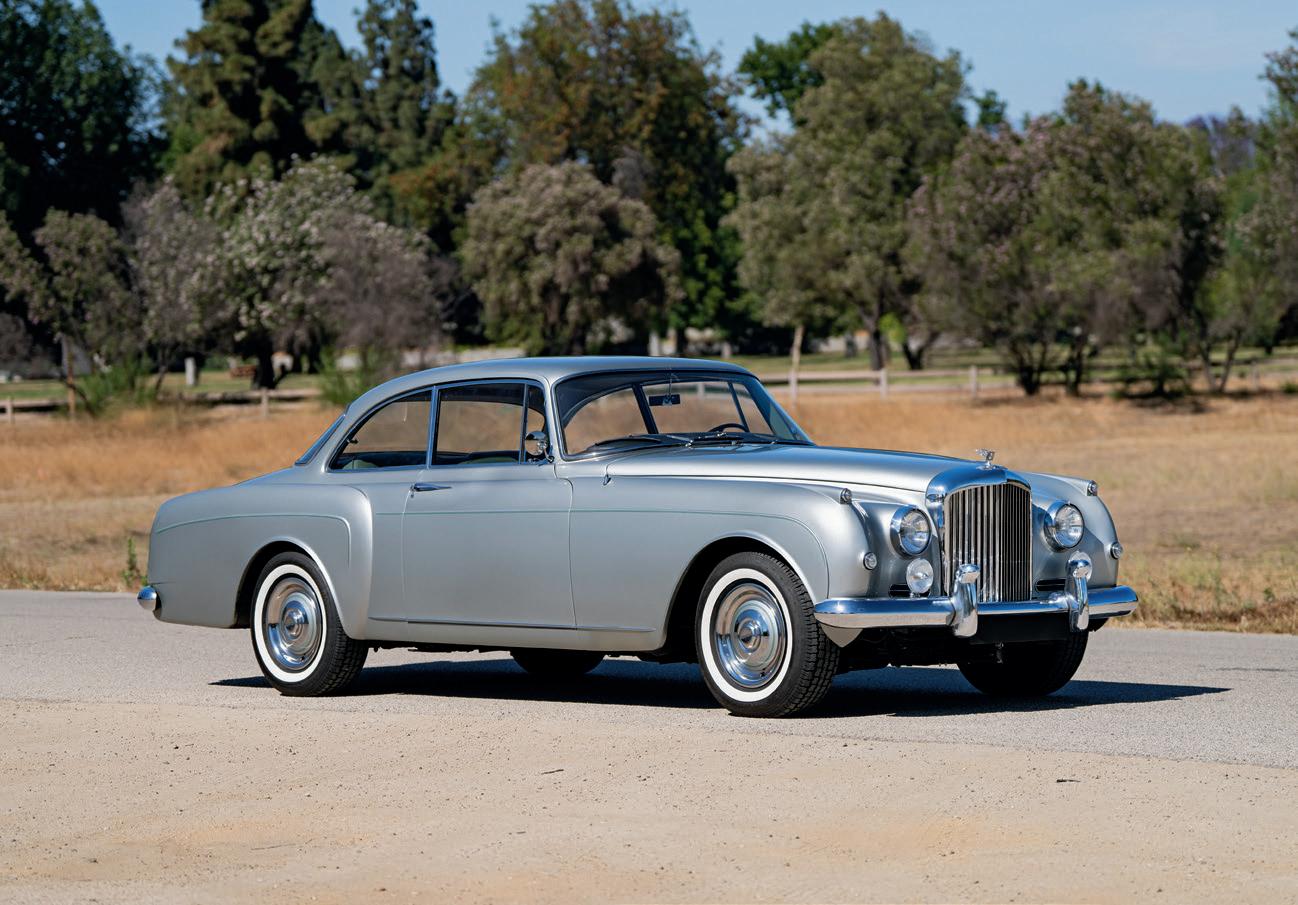

Count Paolo Orsi Mangelli, San Remo, Italy (acquired new via Fernando Martorelli & Figli in 1961)
Jack Bellin, Hawaii (acquired in the late 1970s)
Greg Bellin, Sherman Oaks, California (acquired from the above in 1987)
The Chequered Flag, Los Angeles, California (acquired from the above in 1992)
Ed Waterman, Fort Lauderdale, Florida (acquired from the above in 1992)
Steve Foley, Northbrook, Illinois (acquired from the above in 1996)
Lorna Marsh, Lake Forest, Illinois (acquired from the above in 1996)
Peter Charles Lambert, Muir Beach, California (acquired from the above in 2007)
Kurt Furger, Conifer, Colorado (acquired from the above in 2014)
Current Owner (acquired from the above)
Hillsborough Concours d’Elegance, California, 2008 (Second in Class)
Bentley Continental: Corniche & Azure, 1951–2002, by Martin Bennett

Rolls-Royce agent Fernando Martorelli & Figli. According to accompanying factory records, the Bentley was finished in Sand over green Connolly leather and specified “for use in Italy,” with metric instruments, high-frequency horns, and Dunlop whitewall tires. Other notable features included electric windows, Tudor-type sun visors, custom cabinetwork, and lightweight front seats.
The Bentley remained in Italy until the late 1970s, when Jack Bellin bought it and shipped it to his home in Hawaii. In 1996, Lorna Marsh of Illinois acquired the Continental and commissioned a high-quality cosmetic restoration in the current pewter over green color scheme. The next owner, Peter Charles Lambert of Muir Beach, California, successfully campaigned the Bentley in the Marin Sonoma, Hillsborough, and Palo Alto Concours d’Elegance. Most recently, the Continental was owned by Kurt Furger of Colorado, a member of the Bentley Drivers Club. Today, BC43LCZ remains in lovely condition and is accompanied by an impressive file containing copies of factory build records, ownership documents, and service receipts.
A postwar Bentley of distinction, this left-hand-drive Mulliner Two-Door Saloon needs only a new caretaker to continue in its grand manner and unsurpassed style.
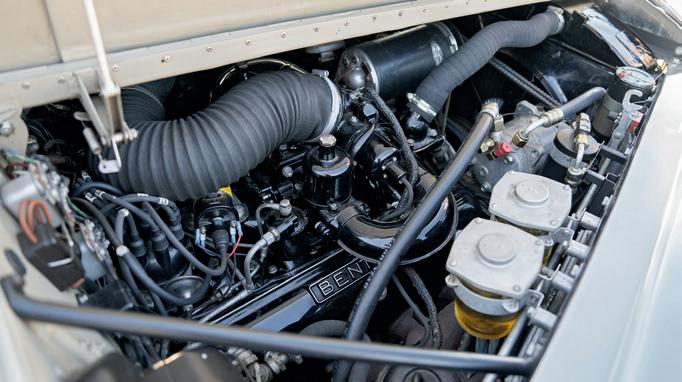
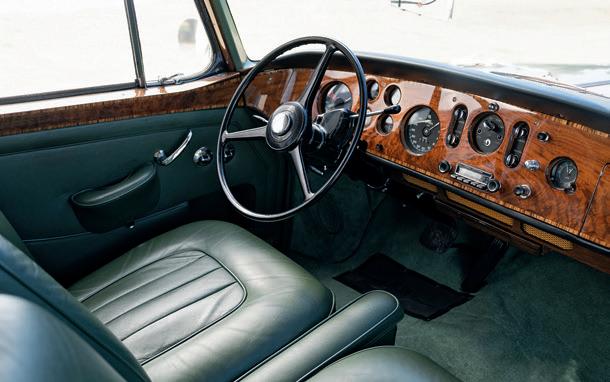
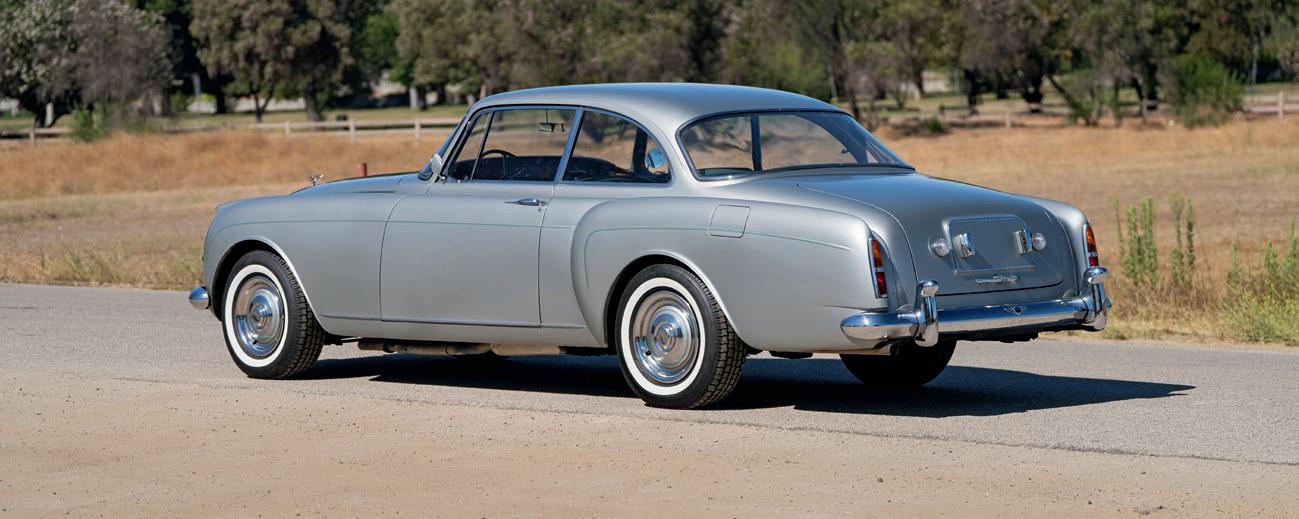
COACHWORK BY DUVAL CHASSIS NO. 9175
$60,000-$80,000 without reserve
Founded in Paris in 1921 by Joseph Lamy and Emile Akar, the Amilcar car company started out manufacturing cyclecars, but soon progressed to voiturettes – still small, but more practical vehicles for the general public. The Amilcar CC model was followed by the C4 and, in 1924, the CS, which provided a prospective owner with an inexpensive, light, and economical sports car mildly reminiscent of the popular Bugatti grand prix and sports cars. It was during this time that the Amilcar came to be known as “the poor man’s Bugatti.”
This Amilcar CS Torpédo was originally delivered to England and registered with the distinctive number “YN 16.” Regrettably, little else is known of its early history. In 1958, it was imported to Malaya by G.D. “Denny” Needham,
Beautiful Example of Amilcar’s First Overt Sporting Model
Striking Duval Coachwork with Staggered Seating for Two Well-Documented History for the Last 67 Years
Award Winner at the 2023 Keels & Wheels Concours
Accompanied by the Original Generator, Windshield, and Cowl with Brooklands Racing Screens
who is believed to have been the car’s third owner. The CS had two additional owners in neighboring Singapore before eventually making its way to Europe, and later joining the esteemed Abraham Kogan collection. When the previous owner, Piers Gormley of Houston, Texas, acquired the car, he changed its color scheme of white with black fenders to British Racing Green, due to his English background. He also performed an extensive rebuild of the unnumbered engine.
Maintained in current ownership since 2014, the Amilcar CS Torpédo presents nicely and would enhance any collection of French prewar sports cars.
SPECIFICATIONS
1,003 CC L-Head 4-Cylinder Engine
Single Solex Sidedraft Carburetor
Estimated 25 HP
3-Speed Manual Gearbox
4-Wheel Mechanical Drum Brakes
Solid Front Axle with Hartford Lever Shock Absorbers
Rear Live Axle with Reversed Quarter-Elliptical Leaf Springs
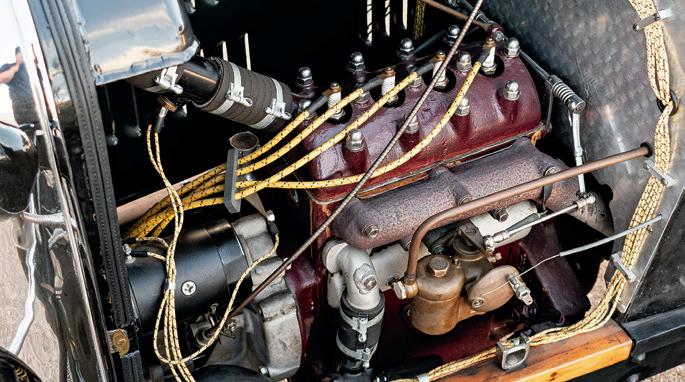
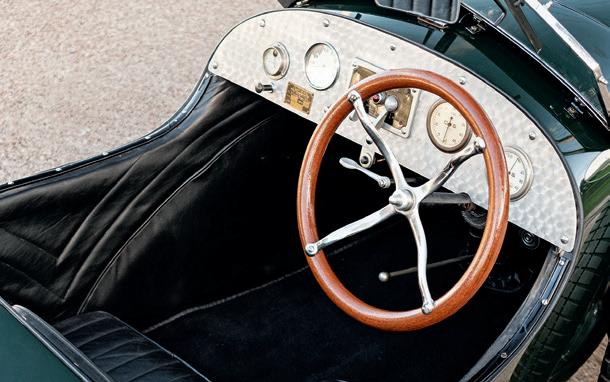


COACHWORK BY H.J. MULLINER
CHASSIS NO. 27 TA
ENGINE NO. VS 95
$250,000–$350,000
One of just 279 Phantom II Continentals built, chassis 27 TA was delivered new in December 1934 to Clifford Whitney of Regent’s Park, London. The capable chassis was fitted with H.J. Mulliner body no. 4163, one of eight Continentals equipped with this handsome three-position Drophead Sedanca Coupe design.
Chassis 27 TA arrived stateside in 1959 and was purchased by the East Coast-based Fuller family in 1963 before being acquired by noted collector William Ruger in 1999. Acquired from Mr. Ruger’s estate in 2002 by a Rolls-Royce enthusiast and class judge at the Pebble Beach Concours d’Elegance®, it has been cherished as part of a collection that includes two other Phantom IIs.
Still retaining its original chassis, engine, and coachwork, this beautiful Sedanca
HIGHLIGHTS
One of 279 Phantom II Continentals Built, and Very Few Unrestored Extant
Attractive and Versatile Three-Position Drophead Sedanca Coachwork
Known History Beginning with Original Owner; Over Two Decades in Current Ownership
Well Preserved with Original Body, Chassis, and Engine per Factory Record
One of Eight Continentals Fitted with this Particularly Elegant H.J. Mulliner Coachwork Design and Only Four Known to Survive
Includes Period Manual and Dedicated Copy of Rolls-Royce Phantom II Continental, by André Blaize
has never been fully restored and is finished in two shades of gray with a red leather interior, which the consignor believes to be largely original. The Mulliner design features an integrated trunk, which contains the original toolbox.
Chassis 27 TA is well documented in both the Raymond Gentile and André Blaize Phantom II Continental books, in addition to having known ownership since new. Just four Continentals with this style of H.J. Mulliner coachwork remain, and this well-preserved example can be enjoyed as presented and appreciated for its originality, or treated to a restoration for future concours accolades.
7,668 CC OHV Inline 6-Cylinder Engine
Single Rolls-Royce Carburetor
120 HP at 3,500 RPM
4-Speed Manual Gearbox
4-Wheel Mechanical Drum Brakes with Servo Assist
Front Solid Axle with Semi-Elliptical Leaf Springs and Hydraulic Dampers
Rear Live Axle with Semi-Elliptical Leaf Springs and Hydraulic Dampers

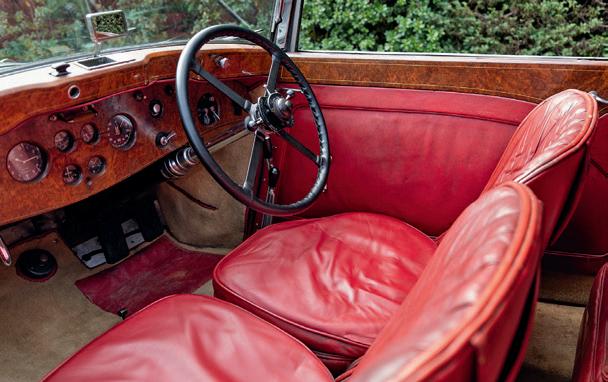
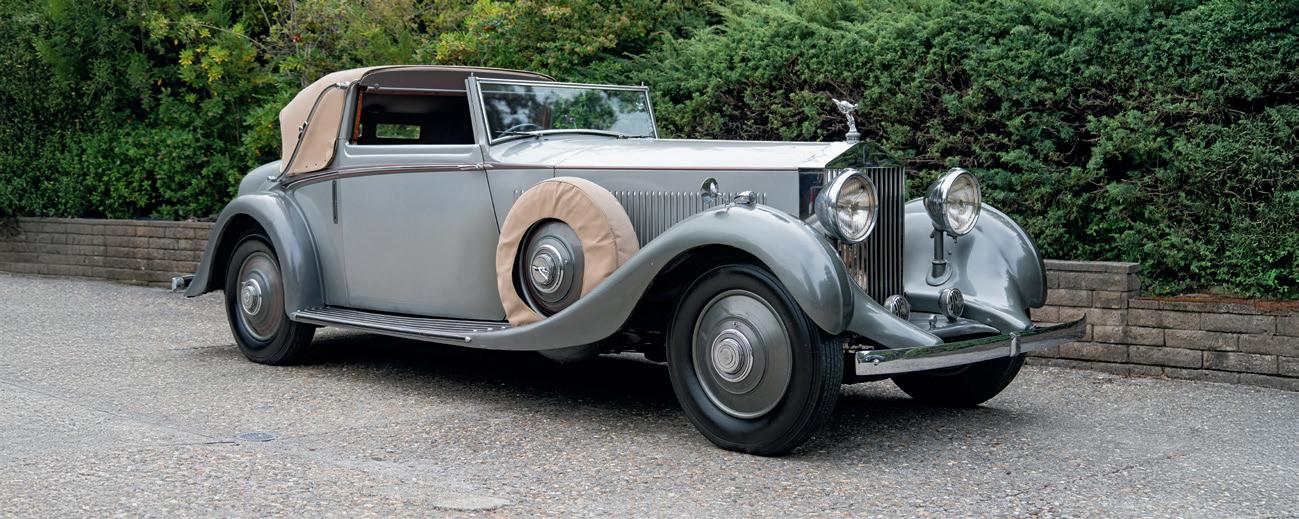

PACKARD VEHICLE NO. 759-144
ENGINE NO. 753611
$175,000–$225,000 without reserve
For 1934, Packard offered the Super Eight in 13 different body styles. None provided the rare blend of grace and sportiness like the Coupe Roadster model. Powered by a 385 cid straight-eight engine, the 1934 Super Eight produced an impressive 145 hp – 40% more power than when the model was first introduced in 1927.
According to its cowl tag, this example was delivered on April 16, 1934, through famed Los Angeles Packard dealer Earle C. Anthony. Later acquired by collector Larry Justice of Seattle, this Packard received a perfect 100-point score at the CCCA Annual Meeting in Bellevue, Washington, and successfully completed a CCCA Pacific Northwest Region CARavan the following year. In 2010, while in
HIGHLIGHTS
One of Just 18 Known Eleventh-Series Super Eight Coupe Roadsters
Awarded First Place at the 1985 CCCA Annual Meeting
Unique and Stylish Rear-Mounted Spare
Striking Two-Tone Exterior Paintwork Complemented by Chrome Wire Wheels
Successfully Participated in the 2010 Pebble Beach® Motoring Classic
the collection of Neil DeAtley of Asotin, Washington, the Packard participated in the 1,600-mile Pebble Beach® Motoring Classic.
With its roll-up side windows, this Super Eight provides enclosed driving during cooler conditions, but can easily be configured into an open conveyance by lowering the convertible top, which folds flush with the car’s beltline. Of the 1,920 examples of the 1934 Super Eight that Packard produced across all body styles, just 18 examples of the Coupe Roadster are accounted for today. The peak of Packard styling and an ideal configuration for all weather touring, this Super Eight is sure to appeal to any discerning American car collector.
385 CID L-Head Inline 8-Cylinder Engine
145 HP at 3,200 RPM
Stromberg Downdraft Carburetor
3-Speed Manual Gearbox
4-Wheel Vacuum-Assisted Mechanical Drum Brakes
Front Solid Axle with Semi-Elliptical Leaf Springs
Rear Live Axle with Semi-Elliptical Leaf Springs
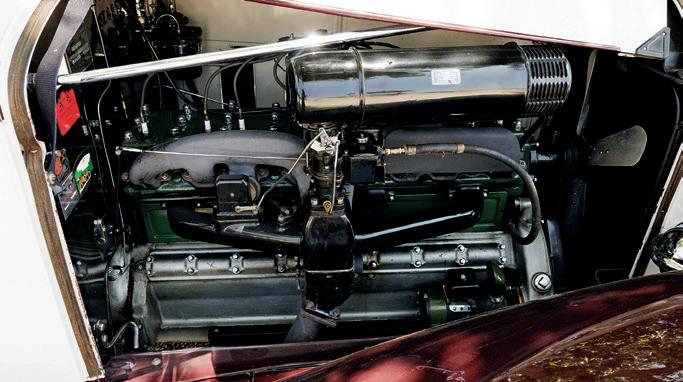
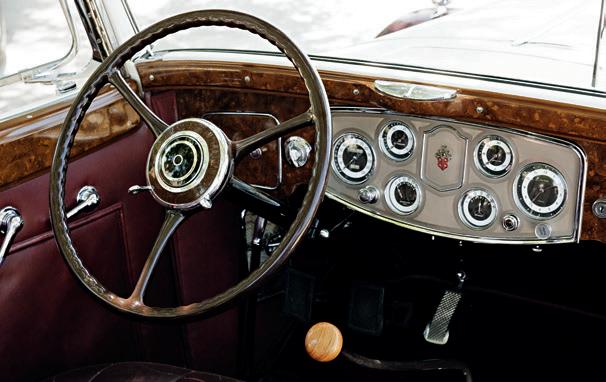


COACHWORK BY REUTTER CHASSIS NO. 81088
$200,000–$250,000 without reserve
Introduced in 1954, the Porsche 356 Speedster featured an easily removable windshield, lightweight bucket seats, a basic folding top, and side curtains –measures taken to reduce both cost and weight. Popular among club racers and weekend drivers, the Speedster played a key role in establishing Porsche’s presence in the US, with 4,145 examples built through 1958.
According to a copy of its factory Kardex, this 1955 Porsche 356 Pre-A Speedster is a transition model completed by the factory on December 16, 1955, and dispatched to Hoffman Motor Company in New York. Finished in Signal Red over Black leatherette, it was equipped with a Type 616/2, 1.6-liter “Super” engine, sealed-beam headlights, tachometer in miles per hour, and
HIGHLIGHTS
Black-Plate California Car Offered for the First Time in Decades
Retains Original Numbered Hood and Deck Lid
Long-Term Ownership from 1971 to Present
Accompanied by Kardex, Workshop Manual, and Service Records
An Attractive Example of One of Porsche’s Greatest Models
coupe-style seats. The Kardex lists its first owner as Kenneth Tatton, with a dealer service at Hoffman logged in September 1956. While its earliest history is not known, this Speedster was acquired by Santa Barbara, California personality and historian Thad MacMillan in October 1971. Retaining its original, numbered hood and deck lid, this Speedster was repainted dark blue and fitted with a higher-performing Type 616/7 unit from a 356 B Super 90 – fitted with an Isky cam and paired with a Bursch exhaust. Used for many years as a regular driver, this Speedster is offered with a 356 B workshop manual, Kardex copy, and service records dating to 1985. A candidate for light recommissioning or restoration, this well-documented example offers a rare opportunity to return one of Porsche’s most iconic models to the road.
SPECIFICATIONS
1,582 CC OHV Air-Cooled Flat 4-Cylinder Engine
Twin Zenith Carburetors
90 BHP at 5,500 RPM
4-Speed Manual Transaxle
4-Wheel Hydraulic Drum Brakes
4-Wheel Independent Torsion-Bar Suspension with Shock Absorbers
*Please note that this vehicle is titled 1956.
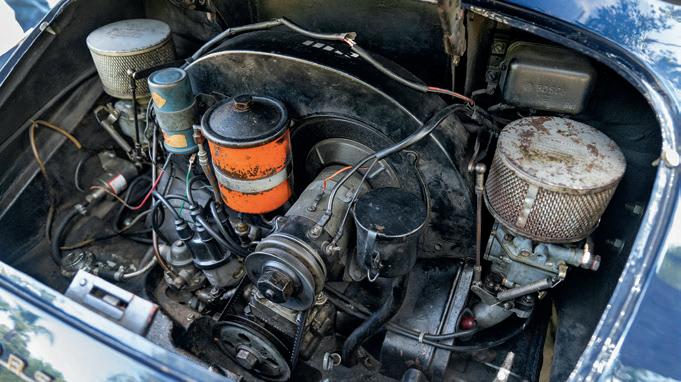

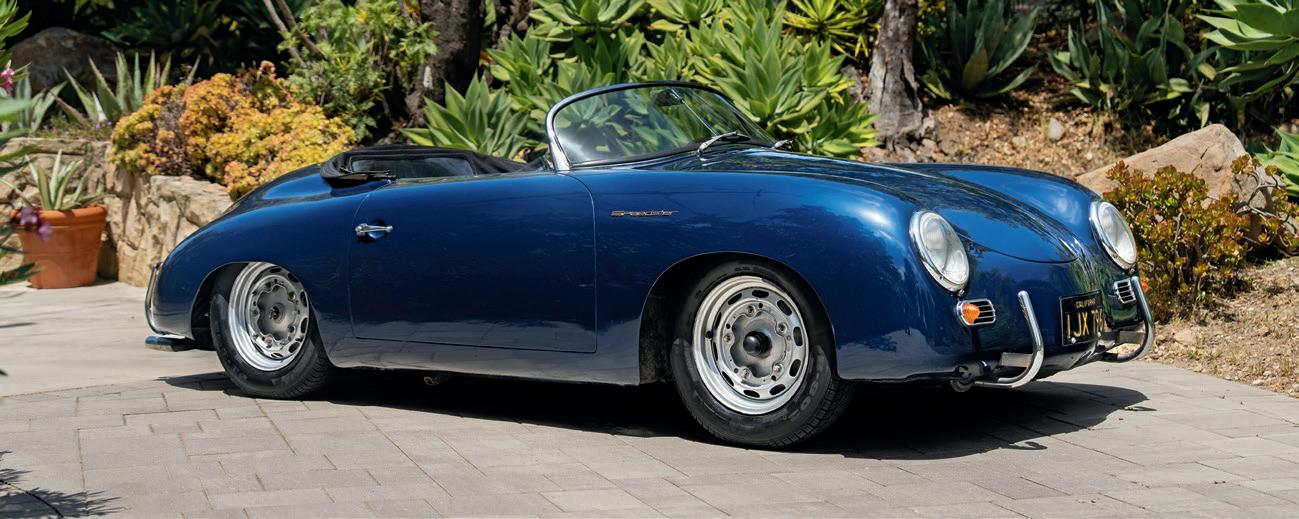

CHASSIS NO. 15983298
$70,000–$90,000 without reserve
This is one of 2,480 Super Estate Wagons built for Buick’s 1950 model year – the rarest and most expensive offering in the Super lineup. The Estate Wagon was “crafted of seasoned wood and stout metal” by artisans at Ionia Manufacturing Company of Ionia, Michigan. Traditional Buick styling cues, including the prominent chrome grille and signature hood ventiports, are complemented by polished wood trim applied to the upper door and window frames, side-body contours, and the rear clamshell tailgate. The interior panels of the tailgate are also finished in matching wood and open to reveal a flat storage deck, which can be expanded by folding the rear seat forward. The interior is finished in red leatherette with matching carpeting throughout, contrasting nicely with the Carlsbad Black exterior paintwork.
HIGHLIGHTS
Buick’s Interpretation of the Wood-Bodied Station Wagon
Handcrafted Woodwork by Ionia Manufacturing Company
Well Equipped with Buick’s Dynaflow Transmission, Radio, Heater, and Clock
Striking Color Combination of Carlsbad Black over Red Leatherette
A Delightful Blend of Mid-Century American Automotive Utility and Style
Mechanical upgrades for 1950 included a new, larger-displacement 263 cid Fireball engine producing 128 hp with power delivered through Buick’s optional Dynaflow automatic transmission. This well-equipped example also features a radio, heater, clock, backup lights, outside rearview mirror, and whitewall tires.
Buick was the last American manufacturer to build a true wood-bodied station wagon and in its day, the Estate Wagon was perfectly suited for city and country excursions. Today, its stylish utility exemplifies mid-century automotive Americana, at-home and tailgating events, or serving as the center point of any automotive gathering.
SPECIFICATIONS
263 CID OHV Inline 8-Cylinder Engine
Single-Barrel Downdraft Carburetor
128 BHP at 3,600 RPM
2-Speed Dynaflow Automatic Transmission
4-Wheel Hydraulic Drum Brakes
Front Independent Suspension with Coil Springs
Rear Live Axle with Semi-Elliptical Leaf Springs

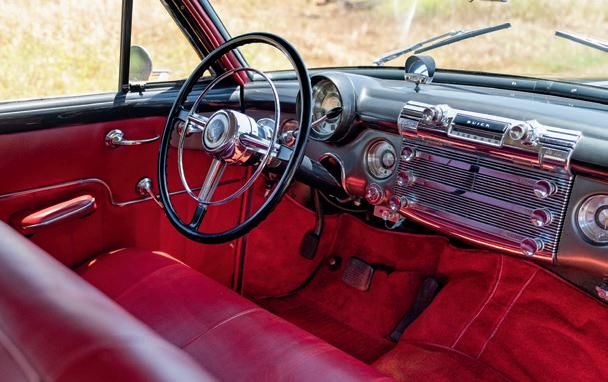


Please read the following conditions of sale (“Conditions of Sale”) carefully prior to attending or registering to bid in any Gooding & Company, LLC ("Gooding Christie's") auction event (“Auction”). As used herein, “General Conditions” refers to, collectively, the terms and conditions of (i) these Conditions of Sale, (ii) the Bidder Registration Application, (iii) the Telephone and Absentee Bidder Registration Application, and (iv) any notices posted by Gooding Christie's on the “Important Notices” or “Event Information” pages of Gooding Christie's website (at goodingco.com) (the “Site”), at the location of the Auction, or in any published catalogue or Lot description.
All Lots in the Auction are offered by Gooding Christie's as agent for the seller of the Lot (the “Seller”) and not on behalf of Gooding Christie's. The General Conditions constitute the sole and entire agreement between, as applicable, Gooding Christie's and/or the Seller, on the one hand, and any bidder or the Buyer (as defined below), on the other hand, under which Gooding Christie's will offer on behalf of the Seller, and the Seller will sell, items, including vehicles (“Vehicles”) and automobilia (each item, a “Lot”), in any Auction(s) for which a registration application has been accepted and concerning the respective parties’ rights and obligations with regard to the matters addressed herein. The General Conditions may only be amended by written saleroom addenda or announcements during an Auction(s) by a Gooding Christie's representative or the individual conducting the Auction (“Auctioneer”), or any notices or revised notices by Gooding Christie's on the “Important Notices” or “Event Information” pages of the Site, if any, or in a written agreement between the respective parties. Gooding Christie's uses a third-party service provider (“Service Provider”) to provide online bidding functionality on the Site and the Gooding Christie's mobile application (the “App”). In addition to the General Conditions, bidders may be required to accept the Service Provider’s terms and conditions as a condition to participating in an Auction via the Site or App.
By attending, registering to bid or placing a bid at an Auction – whether in person, through an agent or representative, by absentee bid, by telephone bid, by online bid via the Site or App, or by otherwise attending or participating in the Auction – each bidder, Buyer and person so attending or participating represents, warrants and covenants to and with Gooding Christie's that such bidder, Buyer or person attending or participating, as the case may be, has reviewed, understands, and accepts and agrees to be, and is, bound by the General Conditions, including the paragraphs labeled “Limitation on Damages” and “As Is – No Warranty,” which set forth Gooding Christie's obligation and maximum liability in the event of loss or damage to any bidder, Buyer or attendee.
Registration Required. No person may bid at an Auction unless registered. Prospective bidders may submit a request to register for an Auction by following the instructions displayed on the registration page of the Site (at goodingco.com/register).
Financial Guarantee. In each instance, prospective bidders will be required to complete and execute the applicable registration application forms and provide an original bank letter of guarantee or other form of proof of ability to pay for purchases, in either case, in an amount and in a form acceptable to Gooding Christie's in its sole discretion (the “Guarantee”). Prospective bidders authorize the release of financial information to Gooding Christie's for the purpose of verifying ability to pay for purchases. The Bidder Registration Application, Telephone and Absentee Bidder Registration Application and a sample bank letter of guarantee are provided at goodingco.com/register.
Registration Timing Requirements. With respect to “Geared Online”-branded Auctions, which are conducted by an online system that performs the functions traditionally performed by an Auctioneer (e.g., assessment and acceptance of bids, advancement of bidding increments) (such system, the “Online Bidding System”, and each such Auction, an “Online-Only Auction”), requests to register as a bidder must be received at least 24 hours prior to 12:00 am Pacific Time on the last day of the Auction (i.e., the day all Lots are scheduled to close). With respect to Auctions that are conducted by an Auctioneer (each, a “Live Auction”), requests to register as an absentee and telephone bidder must be received at least 24 hours prior to the scheduled start of the session of the Auction in which the bidder wishes to bid. Gooding Christie's will issue each registered bidder a paddle, paddle number and/or other identifier for purposes of identification during the Auction (“Paddle”).
Gooding Christie's Discretion. Gooding Christie's is an equal opportunity company that does not discriminate on the basis of race, color, national origin, gender, religion, age or disability in the provision of services. Subject to the foregoing, Gooding Christie's reserves the right, in its sole discretion, to refuse admission to the premises of an Auction or to register and/or issue a Paddle to any person or to revoke a Paddle granted to any bidder with or without cause.
Principal/Agent. Unless Gooding Christie's is notified in writing by the principal in advance of the Auction on a form and in a manner acceptable to Gooding Christie's in its sole discretion that the bidder is acting as an agent for the principal (an "Agent"), and Gooding Christie's in its sole discretion acknowledges in writing such agency and issues a Paddle to such agent as an agent for the designated principal, each bidder shall be deemed to be bidding as a principal for its own account and shall be personally responsible for payment in full of the Purchase Price (as defined below) and other amounts due as Buyer and for fulfillment of all Buyer’s obligations and covenants under the General Conditions.
Each bidder is personally responsible for any use of its Paddle, and each bidder agrees that, except as otherwise provided above with respect to agents, it is personally liable under the General Conditions for the full Purchase Price (as defined below) and other amounts due if the Paddle is used in the winning of any Lot(s), whether by the respective bidder or by any other person.
Compliance with Law. By participating in the Auction and/or bidding, each bidder and Buyer is expressly representing and warranting to Gooding Christie's that it is complying with and agrees to comply with all applicable laws, rules and regulations, and the General Conditions. Further, each bidder and Buyer expressly represents, warrants and covenants that: (i) they are not subject to any economic sanctions and export controls restrictions administered or enforced by any relevant sanctions authority (including U.S. Department of the Treasury’s Office of Foreign Assets Control (OFAC) and Department of Commerce’s Bureau of Industry and Security (BIS), the United Nations, the European Union and in the United Kingdom (UK), Her Majesty’s Treasury’s Office of Financial Sanctions Implementation (OFSI) or the UK Export Control Joint Unit (ECJU)) (“Sanctions”) or owned, partially owned or controlled by an individual or entity subject to Sanctions, and they have not been charged with or convicted of money laundering, terrorism or other crimes (whether in the United States or elsewhere); (ii) funds used for their purchase at the Auction are not connected with or derived from any criminal activity (whether in the United States or elsewhere); (iii) funds used for their purchase at the Auction will not be transferred from, or otherwise involved in any financial transaction related to the purchase, any financial institution subject to Sanctions or owned, partially owned or controlled by an individual or entity subject to Sanctions; and (iv) items purchased at the Auction are not being, and shall not be, transferred to or used in any jurisdiction in contravention of any Sanctions or purchased or to be used in any way connected to the facilitation of breaches of applicable tax, money-laundering or anti-terrorism laws and regulations.
Each Agent represents, warrants and covenants that: (i) they have conducted due diligence into their principal to (a) confirm whether the principal is subject to any Sanctions, or owned, partially owned or controlled by an individual or entity subject to Sanctions, and (b) verify the source of the principal’s funds, and they shall make due diligence records available for inspection on request from Gooding Christie's; (ii) their principal is not subject to any Sanctions or owned, partially owned or controlled by an individual or entity subject to Sanctions, and they have no reason to suspect that their principal has been charged with or convicted of money laundering, terrorism or other crimes (whether in the United States or elsewhere); (iii) funds used for their purchase at the Auction are not connected with or derived from any criminal activity (whether in the United States or elsewhere); and (iv) items purchased by the Agent at the Auction are not being, and shall not be, transferred to or used in any jurisdiction in contravention of any Sanctions or purchased or to be used in any way connected to the facilitation of breaches of applicable tax, money-laundering or anti-terrorism laws and regulations.
Compliance with Policies. Each bidder, Buyer, and other person attending or participating in an Auction further agrees to comply with all applicable policies and procedures Gooding Christie's may communicate from time to time, including any posted signage.
No Photography. Without limiting the generality of the foregoing, each bidder, Buyer and attendee agrees that: (i) they shall not conduct any photography, audio, video,
or other recording or broadcast of any kind inside any bidding tent without an official Gooding Christie's-issued press pass and an executed photography and video agreement; and (ii) any photography, audio, video, or other recording they capture outside the bidding tent is solely for their own personal use and shall not be redistributed or rebroadcast in any medium, nor used for any commercial purpose.
All Lots in the Auction are offered by Gooding Christie's as agent for the seller of the Lot (the “Seller”) and not on behalf of Gooding Christie's. Gooding Christie's shall not have any liability or responsibility for any act, omission, default or failure by any Seller.
Any written or oral descriptions of the Lots or related information, including any published catalogue, Lot description or other Auction-related materials, postings, announcements, press releases, advertisements, bill of sale or invoice, or statements or affirmations made by or on behalf of Gooding Christie's prior to or at the Auction, including any reference to a Lot as being a particular model, make, or type or the rarity or uniqueness or provenance thereof, are only statements of opinion and not statements of fact and do not, and shall not under any circumstances be deemed to, create or constitute representations or warranties of any kind by Gooding Christie's or the Seller. Each bidder and Buyer hereby acknowledges and agrees that they are not entitled to rely, and they each agree not to rely, upon any of such descriptions, statements, affirmations, information or materials for any purpose, and that none of the foregoing are a part of the basis of the bargain of the purchase and sale of any Lot, nor do or shall any of the foregoing supersede or modify any of the General Conditions.
Viewing Hours and Appointments. During viewing hours or by appointment (as applicable), bidders are provided an opportunity to inspect the Lots prior to bidding and are invited and strongly encouraged to conduct, and must solely rely upon, their own independent inspection and examination of any Lot and all matters relating thereto before placing any bid. Refer to the published event information, including the “Event Information” page on the Site, for the viewing hours and information for scheduling appointments.
Buyer Responsibility. Gooding Christie's has no obligation or responsibility, and does not assume any obligation or responsibility, to undertake an inspection of any Lot prior to the Auction. Bidders are solely responsible for inspecting the Lots prior to bidding (regardless of whether Gooding Christie's conducts its own inspection of the Lot) and satisfying themselves as to the condition of the Lots and all other matters relating to the Lots, including condition, title, importance, value, quality, authenticity, description (including the published Lot description), provenance and whether or not any Lot complies with any applicable federal, state or other laws or regulations of any kind, and to identify any repairs, restoration or replacement parts
and to ascertain completeness. As the condition and other potentially relevant matters related to a Lot are not necessarily easily determined, and Gooding Christie's does not claim or possess any peculiar knowledge or experience in determining such matters and does not have access to relevant information, Gooding Christie's does not, and does not assume any obligation or responsibility to, undertake a level of inspection necessary to obtain or verify such information, including any published Lot description or other description or announcement or affirmation, and Gooding Christie's relies upon information provided by the Seller.
No Warranty on Condition. Gooding Christie's does not assume any responsibility to determine the condition of any Lot, and any condition report (and/or any other description or information provided relating to the Lot, including in the published Lot description, in any statement by any employee, officer, agent, or representative of Gooding Christie's, or in any other Auctionrelated materials) is not intended to and does not negate or modify the paragraph labeled “As Is – No Warranty” or any other provisions of the General Conditions, contains only statements of opinion and not statements of fact, and shall not be deemed to create representations or warranties of any kind. In no event shall Gooding Christie's or any of its directors, employees, officers, agents or representatives have any liability or responsibility for any matters relating to or arising out of such report and/or the condition of any Lot, regardless of the content or omissions of, or any errors in, the report. The absence with regard to a Lot of any mention of repairs, damage, replacement parts or restoration in any condition report, published Lot description or statements by Gooding Christie's shall not be deemed to mean the Lot is free of the foregoing, nor shall reference to any of the foregoing be deemed to exclude any others.
Gooding Christie's makes no representation or warranty with respect to any existing certificate of title or registration with regard to any Lot. It is each bidder’s and Buyer’s responsibility to make their own independent investigation with regard to the title, including examining any and all documentation pertaining to the title or registration provided by the Seller and made available by Gooding Christie's prior to the Auction, and determining whether a Lot is or can be registered. Gooding Christie's does not guarantee or make any representation or warranty that any or all title or registration documentation will satisfy the requirements of any state in the United States or of any foreign jurisdiction, and Gooding Christie's shall not be liable under any circumstances with regard to whether or not such documentation is acceptable, complete or adequate, or otherwise in connection therewith. All such title documentation is provided by the Seller, and Gooding Christie's does not assume any responsibility or liability with regard to such title documentation or the quality or marketability of title to any Lot.
The Buyer of a Lot is solely responsible for complying with all registration requirements as to such Lot. Subject to the foregoing, for Vehicles purchased at any Live Auction held in California or Online-Only Auction, Gooding Christie's will manage the title transfer process on the Buyer’s behalf, send the Buyer the title by courier after the Auction and assess a documentation fee in the amount of $80.00 per Vehicle. Upon receipt of such title, the Buyer is responsible for registering the Vehicle at its final destination.
Generally. Subject to availability during the Auction and prior approval in Gooding Christie's discretion, with respect to one or more Lots as determined in Gooding Christie's discretion,
Gooding Christie's, only as an accommodation and convenience, may offer absentee, telephone and online bidding to bidders who cannot attend a Live Auction, as well as absentee and telephone bidding to bidders participating in an Online-Only Auction. Telephone bids and the bidder’s telephone conversation with Gooding Christie's employee, officer, agent or representative may be recorded, and by participating or bidding at the Auction by phone the bidder expressly consents to all such recording.
Bidding Increments. Bidding will be opened at a level determined by Gooding Christie's (via the Online Bidding System) or the Auctioneer, as applicable (“Auction Conductor”), and will generally advance in increments of approximately 10% or as may be otherwise set forth in notices posted by Gooding Christie's on the “Important Notices” or “Event Information” pages of the Site. Absentee, telephone or online bids that do not conform to these increments may be lowered to the next bidding increment as determined by the Auction Conductor. Gooding Christie's will attempt to execute absentee bids and any emergency covering bids for telephone bidding and online bids at the lowest price, taking into account reserves and bids from all other parties and determining bid precedence in the event of simultaneous or nearsimultaneous bids. Each bidder also authorizes Gooding Christie's to bid on the bidder’s behalf on the Lots specified up to the amount specified by the bidder.
Countdown Clock. With respect to any Lot in an Online-Only Auction, at least three minutes must elapse between placement of the final bid and the close of bidding. In furtherance of the foregoing, with respect to any such Lot, if a bid is placed with fewer than three minutes remaining on the countdown clock for bidding (“Countdown Clock”), then the bidding period will be extended and the Countdown Clock will be reset at three minutes, and such extensions will continue indefinitely until there is no more bidding activity on the Lot for a period of three consecutive minutes. The extension of any one Lot’s closing time will not affect other Lots’ closing times; therefore, in any Online-Only Auction, Lots may close out of numerical Lot order.
Gooding Christie's may provide a currency converter during the Auction as an accommodation to bidders who wish to follow the bidding in foreign currencies, and any rates quoted or displayed are only indications of the conversion amount and shall not be relied upon by any bidder or Buyer for any purpose, including bidding. Gooding Christie's shall not be liable or responsible for any errors or omissions in connection with such currency conversions or rates, and the bidder accepts and assumes all responsibility and liability for any errors or omissions relating thereto and for calculating any conversion rates. Currency conversion rates may change from the time of bidding to the time of payment. All bids are made in and must be paid in U.S. Dollars. With respect to Online-Only Auctions, bids will display in U.S. Dollars only.
Estimates for the Lots published in any Lot description do not include the Buyer’s Premium (as defined below) or any taxes, are only opinions, are prepared well in advance of the Auction, are subject to change, and may be amended either orally or in writing prior to or at the Auction. Estimates should not be relied upon, and each bidder and Buyer hereby agrees not to rely upon any estimate, as fact or a guarantee or prediction of the actual selling price or value of a Lot, and Gooding Christie's shall not have any liability with regard to any estimates under any circumstances.
Unless otherwise specified in the published Lot description or announced at the Auction, the Lots will be offered subject to a reserve, which is the minimum amount that the Seller is willing to accept with regard to the respective Lot. Reserves are confidential and will not exceed the low presale estimate. Gooding Christie's may act to protect the reserve by bidding through the Auction Conductor, which may open bidding below the reserve by placing a bid on behalf of the Seller, place bids on behalf of the Seller up to the reserve amount, place bids in response to other bidders or elect to withdraw the Lot from bidding if the opening bid is below the reserve. The Auction Conductor shall not be obligated to specifically identify bids placed on behalf of the Seller to protect the reserve nor will the Auction Conductor place a bid on behalf of the Seller at or above the reserve. Sellers may not bid on Lots they have consigned to Gooding Christie's without prior announcement at the Auction.
Generally. The Auction Conductor has the absolute right and ability to refuse any bid or to split or advance bidding in any increments, regardless of any increment parameters set forth in the published Lot description or otherwise. The Auction Conductor makes the final determination about the validity of any bid, any error relating to bidding or any bid (including error by the Auction Conductor or Gooding Christie's), or any dispute between bidders, whether bids are made in person, through an agent or representative, by absentee bid, by telephone bid, by online bidding, or by otherwise attending or participating in the Auction. The Auction Conductor has the absolute right and ability to choose to continue bidding, refuse a bid, cancel a bid, determine the successful bidder (including in the event of simultaneous or near-simultaneous bids), withdraw a Lot, reoffer a Lot, reopen bidding or restart the bidding, as the case may be, including in the event of concern, error, dispute or doubt with regard to any bid or bidding. In any dispute, Gooding Christie's records (including the records of the Online Bidding System, as applicable), in each case whether audio, visual or written, are conclusive.
Buyer’s Premium; Taxes. Bid amounts, including the amount of any winning bid or final bid price, do not include the Buyer’s Premium (as defined below) or any taxes.
Bids Are Final. Each bid is final, binding, and irrevocable, and bidders may not change, retract or rescind any bid once made.
Binding Contract. The buyer (“Buyer”) is the highest bidder acknowledged by the Auction Conductor and accepted by Gooding Christie's, subject to the reserve, if any, and the terms of the General Conditions. The fall of the Auctioneer’s hammer (with respect to Live Auctions) or the moment when the Countdown Clock reaches zero (with respect to Online-Only Auctions), as applicable (the “Fall of the Hammer”), marks the acceptance of the Buyer’s bid and a contract of purchase and sale is made between the Buyer and Seller. Gooding Christie's is not a party to the contract of purchase and sale and Gooding Christie's shall not be liable or responsible for any breach or default of such contract by either Buyer or Seller. All sales are final.
Risk of Loss. Upon the Fall of the Hammer, the Buyer is thereupon responsible for and assumes all risk of loss or damage to such Lot. Gooding Christie's, its employees, officers, directors, agents and representatives shall not be liable for any loss or damage to or any loss or damage caused by any Lot at any time.
Confirmation of Purchase. With respect to Live Auctions, immediately following the Fall of the Hammer, any Buyer that is physically present at the Auction shall be required to execute a Confirmation of Purchase, which confirms Buyer’s purchase of the Lot as announced by the Auctioneer.
In addition to the final bid price, the Buyer is required to pay Gooding Christie's a percentage of the final bid price, which Gooding Christie's retains (the “Buyer’s Premium”). Gooding Christie's Live Auctions in the U.S. and Online-Only Auctions will have the following Buyer’s Premiums:
• For Vehicle Lots: Live Auctions in the U.S.: (a) For a final bid price of $250,000 and below, Gooding Christie's will receive a Buyer’s Premium of 12% of the final bid price; and (b) for a final bid price of above $250,000, Gooding Christie's will receive a Buyer’s Premium of 12% on the first $250,000 and 10% on the remainder of the final bid price. Online-Only Auctions: Gooding Christie's will receive a Buyer’s Premium of 10% of the final bid price.
• For Automobilia Lots: Gooding Christie's will receive a Buyer’s Premium of 25% of the final bid price.
Purchase Price. The purchase price to be paid by the Buyer is, and the Buyer acknowledges it is responsible for and agrees to timely pay, the sum of the final bid price (the highest bid acknowledged and accepted by the Auction Conductor), plus (i) the Buyer’s Premium and (ii) all applicable state and local sales and/or use taxes and license fees (such taxes and fees to be determined by Gooding Christie's in its sole discretion) (collectively, the “Purchase Price”).
Payment Terms. Payment of the full Purchase Price is due to Gooding Christie's no later than the Wednesday following completion of the Auction by (x) 5:00 pm local time of the Auction location with respect to Live Auctions or (y) 5:00 pm Pacific Time with respect to Online-Only Auctions.
Late Payment Fees. Gooding Christie's and/or the Seller reserves the right to charge interest to the Buyer of up to a maximum of 18% per annum (or the maximum rate permitted by law if less than 18%) on any portion of the Purchase Price if the Buyer does not make timely payment of the Purchase Price when due under these Conditions of Sale. Such interest shall be calculated from when the Purchase Price (or any part there of) became due, until it is paid.
Other Amounts. In addition, the Buyer acknowledges it is responsible for, and agrees to timely pay, (a) any and all costs and expenses incurred on behalf of the Buyer and/or as a result of the Buyer’s failure to timely and fully comply with the General Conditions, including removal, transport and storage costs for the Lot and taxes thereon and (b) all other amounts due and owing pursuant to the General Conditions.
Payment Method. All payments must be made by wire transfer, certified bank check, cashier’s check or, with prior approval of Gooding Christie's finance department, personal or company check. Unless otherwise agreed to by Gooding Christie's in writing, Gooding Christie's will not accept payment of any portion of the Purchase Price from any party other than the Buyer.
Passage of Title. Title to a Lot does not pass to the Buyer until good and cleared funds in the amount of the full Purchase Price are received by Gooding Christie's.
Gooding Christie's may offer certain promotional pricing (including waiving certain fees) from time to time that differs from standard rates for registration and the like (“Promotional Pricing”), and may discontinue such Promotional Pricing at any time. Such Promotional Pricing is offered in Gooding Christie's sole discretion, and offering Promotional Pricing to one or more individuals on a particular occasion does not constitute a commitment to offer the same Promotional Pricing on any other occasion, or to any other individuals on any particular occasion.
Following the Auction, Buyer must remove all Lots from the Auction site, Gooding Christie's facility or other location as directed by Gooding Christie's (as applicable) at Buyer’s risk and expense, no later than (x) 5:00 pm local time on the Wednesday following completion of the Auction with respect to Live Auctions or (y) 5:00 pm Pacific Time on the Friday following completion of the Auction with respect to Online-Only Auctions (or such other time communicated by Gooding Christie's to bidders and/or Buyers). If not removed timely by Buyer, in addition to any and all other remedies and rights Gooding Christie's may have, Gooding Christie's shall have the right (but not the obligation) to remove any Lot at Buyer’s sole risk and expense and store it, at Buyer’s expense, including removal, storage, transportation and handling expenses and costs and applicable taxes, at a third-party warehouse, and Buyer hereby grants Gooding Christie's an irrevocable power of attorney to remove and store such Lots at Buyer’s expense. Except in Gooding Christie's sole discretion, no Lot shall be released to Buyer until Gooding Christie's has received payment in full, in good, cleared funds, of the Purchase Price for the Lot, and Buyer has fully complied with the General Conditions.
Notwithstanding any oral or written statement or description of any kind regarding any Vehicle, whether by or on behalf of Gooding Christie's or Seller, including in the published Lot description, all Vehicles are sold “as is” and only as collector’s items and Vehicles may not be suitable for use on the road. The Buyer of any Vehicle who intends to use the Vehicle on the road is responsible for determining roadworthiness and for complying with all applicable regulations regarding title, registration, insurance, emission control and safety equipment and the Buyer assumes all risk of whether any such Vehicle will or does comply, and neither Gooding Christie's nor Seller shall have any liability or responsibility of any kind for failure to comply by or lack of roadworthiness of any Vehicle.
The Buyer is responsible for determining whether or not an export permit is required to export a Lot and for obtaining and paying the costs of any permits or licenses necessary to export any Lot from the United States or any other country where it is registered and/or import it into any other country, and for the payment of any import duty that may be levied by the country of import. Gooding Christie's makes no representation or warranty of any kind with regard to whether or not any Lot can be exported or imported or the issuance of an export or import permit for any Lot.
Gooding Christie's will hold and process your personal information and may pass it to another "Christie’s Group" company for use as described in, and in line with, our privacy notice at
christies.com/about-us/contact/privacy (available also at goodingco.com/privacy) and if you are a resident of California you can see a copy of our California Consumer Privacy Act statement at www.christies.com/about-us/contact/ccpa (available also at goodingco.com/ privacy). Christie’s Group is Christie’s International Plc, its subsidiaries and other companies within its corporate group, including but not limited to Gooding & Company, LLC.
Gooding Christie's shall own the copyright in all photographs, videos, illustrations and written descriptions of the Lots created by or for Gooding Christie's. Without limiting the foregoing, Gooding Christie's shall have the right to use, publish, display and reproduce any and all of the foregoing for any purpose and in any media at its discretion at any time in any manner whether before and/or after the Auction, and no bidder or Buyer shall have any right, title or interest to any of the foregoing. Each bidder and Buyer agrees they will not use, reproduce or publish for any purpose any such photographs, videos, illustrations or written descriptions created by or for Gooding Christie's.
Each bidder, Buyer, or other person attending or participating in an Auction or inspection grants all necessary rights to Gooding Christie's and agrees that Gooding Christie's has permission and license to use his or her likeness for television, video, online, social media, still photography and/or any other visual or audio recording, display, transmission, broadcast and/ or publication for any and all purposes (including advertising and marketing), worldwide, at any time or times in perpetuity, including concurrent with and/or subsequent to the Auction or inspection, and waives all rights or claims (including residual rights and rights of privacy and publicity) that might arise from use of any attendee’s image, voice, picture or likeness for any purpose, including at any future date, under all applicable laws, including common law or by statute.
Gooding Christie's reserves the right, in its sole discretion, to (a) withdraw any Lot at any time prior to or at the Auction, (b) postpone or cancel the Auction of any or all of the Lots for any reason, (c) reject or refuse any bid from any party before or during the Auction, (d) revoke any bidder’s Paddle or otherwise withdraw Gooding Christie's permission for the bidder to participate in the Auction or use the Site or App, (e) terminate a registered bidder’s bidding account, or (f) rescind or terminate any sale if Gooding Christie's determines in its sole discretion that it cannot complete the transaction for any reason, in which event Gooding Christie's shall refund any payment by Buyer which has not yet been transferred to Seller, as well as any Buyer’s Premium paid to Gooding Christie's, and Buyer shall have no further remedy of any kind against Gooding Christie's notwithstanding anything to the contrary in the General Conditions. Each bidder and/or Buyer agrees that Gooding Christie's shall not have any liability whatsoever to any bidder for exercise of any of the foregoing rights, or for any errors in execution or failure to execute any bid(s), regardless of circumstances or events of any kind.
Remedies. If the Buyer or a bidder fails to comply with any of the General Conditions, including if a Buyer or bidder fails to timely pay the full Purchase Price and/or remove a Lot when and as required by these Conditions of Sale, the Buyer or bidder, as the case may be, shall be in breach
and default of the General Conditions, and shall be liable to Gooding Christie's, and each bidder and Buyer agree that Gooding Christie's shall be entitled to recover from such Buyer or bidder, as the case may be, any and all damages, costs, expenses, fees (including attorneys’ fees) and other amounts suffered and/or incurred by Gooding Christie's as a result of such failure to comply (including any such damages, costs, expenses, fees and other amounts suffered or incurred as a result of suit(s) by the Seller or other third parties). Further, in such event of a failure to comply, Gooding Christie's may, in its sole discretion, at any time and from time to time, in addition to all other available remedies under the General Conditions, at law and otherwise, and without any notice to such Buyer or bidder, take any one or more of the following actions to the fullest extent allowed by law: (a) hold the defaulting Buyer or bidder, as the case may be, liable for the Purchase Price, all other amounts due under the General Conditions, and all damages, costs and expenses suffered or incurred by Gooding Christie's and/or the Seller as a result of such default and failure to comply, including initiating legal action against the Buyer or bidder, including an action for specific performance; (b) cancel or rescind the sale; (c) resell the Lot(s) with or without reserve privately or at public auction, in which case the Buyer or bidder shall be liable for any deficiency between the Purchase Price and other amounts due under the General Conditions (plus all damages, costs, expenses, fees (including attorneys’ fees) incurred by Gooding Christie's and/or the Seller as a result of noncompliance and all commissions, premiums and fees applicable to such resales) and the price received upon the resale; (d) remove or arrange for the removal and storage of the Lot at the sole risk and cost of such defaulting Buyer or bidder; (e) offset any sums due from Gooding Christie's to the Buyer or bidder against the Purchase Price and all other amounts due and owing by the Buyer or bidder under the General Conditions; (f) repossess the Lot(s) for which the Purchase Price or any portion thereof is unpaid, and resell such Lot(s) and apply the sale proceeds against amounts owed by such Buyer or bidder under the General Conditions; and/or (g) take any other action that Gooding Christie's in its sole discretion deems necessary or desirable, including any combination of the foregoing remedies.
Short Payments. If Buyer or bidder has purchased more than one Lot and Gooding Christie's receives less in payment than the total due for all Lots purchased, Gooding Christie's may apply the funds received toward payment of whichever Lot(s) it selects in its sole discretion, regardless of what the Buyer or bidder may or may not direct.
Security Interest. By registering to bid or by placing a bid at the Auction, each Buyer and bidder hereby agrees to grant Gooding Christie's, and Gooding Christie's shall be deemed to have, a first priority security interest in, and Gooding Christie's may retain as collateral security for such Buyer’s or bidder’s obligations to Gooding Christie's, any Lot and any other property in Gooding Christie's possession owned by such Buyer or bidder and any and all proceeds (including proceeds as defined under the Uniform Commercial Code in effect in California), including insurance proceeds, of any of the foregoing. Gooding Christie's shall have all the rights and remedies provided to a secured party under the UCC and shall be entitled to file one or more financing statements as Gooding Christie's may desire, with regard to any and all such Lots and other personal property, and shall be entitled to sell any such property in Gooding Christie's possession and apply against the Purchase Price and other amounts due and owing by the Buyer or bidder the proceeds from such sale. If Buyer or bidder defaults and Gooding Christie's elects its discretion to pay the Seller a portion of the net proceeds due Seller with regard to the sale of the Lot, Gooding Christie's shall have all the rights and remedies of Seller against the Buyer or bidder, including the right to pursue the Buyer or
bidder for all such amounts and any and all other amounts, damages, costs, fees and expenses as may be available under the General Conditions, at law, in equity or otherwise.
California Law. The Auction, the General Conditions and the relationship and rights and obligations of the parties shall be governed solely and exclusively by the laws of the state of California, without regard to such state’s choice of law rules and regardless of where the bidder or Buyer is located or received any Auction materials.
Binding Arbitration. Each bidder and Buyer agree that any dispute (including any claim, counterclaim or other action) or controversy arising out of or relating to any of the General Conditions, the Auction or any Lot shall be brought and determined by arbitration in Los Angeles, California before one arbitrator. The arbitration shall be administered by JAMS pursuant to its Comprehensive Arbitration Rules and Procedures or pursuant to JAMS’ Streamlined Arbitration Rules and Procedures. The determination of the scope or applicability of this Agreement to arbitrate shall be solely determined by JAMS. Judgment on an award may be entered in any court having jurisdiction. In the event that any party seeks relief under this Agreement in any venue other than through JAMS (including federal or state court), then the complaining party shall pay all of the costs, fees, including attorneys’ fees, and expenses of the responding party. Each party shall pay its own proportionate share of arbitrator fees and expenses. The parties waive their right to a jury trial and the right of appeal. In the event that either files any claim against any shareholder, employee, officer, director, member, manager, representative, principal, or agent of the other party, then the parties hereby agree that any such claims shall also be subject to this dispute resolution section. Each bidder and Buyer, by registering to bid at or participating in the Auction (whether in person, through an agent or representative, by absentee bid, by telephone bid, by online bid, or by otherwise attending or participating in the Auction), and any person attending the Auction, hereby submits to the jurisdiction of state and federal courts in California.
Waiver of Service of Process. Each bidder and Buyer by registering to bid at or participating in the Auction (whether in person, through an agent or representative, by absentee bid, by telephone bid, by online bid, or by otherwise attending or participating in the Auction), and any person attending the Auction, hereby consents to waiver of service of process pursuant to California or federal rules of civil procedure, so long as notice is provided in English via Federal Express or similar courier, with copies via facsimile or e-mail.
The General Conditions shall be binding on each attendee or participant, as the case may be, in the Auction, and each bidder and Buyer and Gooding Christie's, and their respective agents, heirs, executors, legal representatives, successors and assigns.
If Gooding Christie's engages counsel to assist it to enforce any part of the General Conditions, with regard to any bidder, attendee, Buyer or other party, then such bidder, attendee, Buyer or other party, as the case may be, shall be responsible for all reasonable fees (including attorneys’ fees), costs and all expenses incurred by Gooding Christie's (including costs and all expenses related to evaluating, analyzing, assessing, enforcing, preparing for and conducting litigation of any kind or nature), whether or not legal proceedings are commenced.
Presentation of Claims; Exclusion of Certain Liabilities. BY ATTENDING OR PARTICIPATING IN THE AUCTION WHETHER IN PERSON, THROUGH AN AGENT OR REPRESENTATIVE, BY TELEPHONE BID, ONLINE BID OR ABSENTEE BID, EACH ATTENDEE AT THE AUCTION AND EACH BIDDER AND BUYER AGREES THAT (A) ANY CLAIMS RELATING TO THE AUCTION, SALE OF A LOT OR THE GENERAL CONDITIONS MUST BE FIRST PRESENTED DIRECTLY TO GOODING CHRISTIE'S BEFORE FILING A LEGAL ACTION AND (B) GOODING CHRISTIE'S SHALL NOT HAVE ANY LIABILITY TO ANY ATTENDEE, BIDDER, BUYER OR OTHER PARTY FOR INJURY OR DAMAGE OF ANY KIND RESULTING FROM OR RELATING TO THE NEGLIGENCE OF GOODING CHRISTIE'S OR ANY OF ITS DIRECTORS, OFFICERS, EMPLOYEES, AGENTS OR REPRESENTATIVES, ACTIVE OR OTHERWISE, OR RELATING IN ANY WAY TO ANY LOT(S) OR THE AUCTION OR ANY ACT OR OMISSION OF ANY OF THE FOREGOING, UNLESS GOODING CHRISTIE'S OR ITS EMPLOYEES, OFFICERS, DIRECTORS, AGENTS OR REPRESENTATIVES ARE GROSSLY NEGLIGENT.
Liability Cap. GOODING CHRISTIE'S SOLE LIABILITY AND DAMAGES, AND EACH ATTENDEE’S, BIDDER’S, BUYER’S AND OTHER PARTY’S SOLE AND EXCLUSIVE REMEDY, IF ANY, AT LAW, UNDER THE GENERAL CONDITIONS AND OTHERWISE AND ARISING OUT OF OR DIRECTLY OR INDIRECTLY RELATING IN ANY WAY TO THE AUCTION, ANY LOT(S) (INCLUDING ANY INABILITY TO DELIVER POSSESSION OF A LOT TO THE BUYER), THE GENERAL CONDITIONS OR OTHERWISE, ARE IN ALL EVENTS AND CIRCUMSTANCES LIMITED EXCLUSIVELY TO AND SHALL NOT EXCEED AN AMOUNT EQUAL TO THE BUYER’S PREMIUM PAID BY SUCH BUYER TO GOODING CHRISTIE'S WITH REGARD TO SUCH RESPECTIVE LOT, IF ANY, OR ADMITTANCE OR REGISTRATION FEES, IF ANY, PAID TO GOODING CHRISTIE'S BY THE RESPECTIVE BUYER, ATTENDEE OR BIDDER TO ATTEND AND/OR BID AT THE AUCTION, AS THE CASE MAY BE.
No Special, Indirect, Punitive, Consequential or Incidental Damages. THE AMOUNTS PAYABLE BY ANY ATTENDEE, BIDDER OR BUYER ARE NOT SUFFICIENT TO WARRANT GOODING CHRISTIE'S ASSUMING ANY RISK OF DAMAGES OF ANY KIND, INCLUDING CONSEQUENTIAL DAMAGES TO THE BIDDER, ATTENDEE OR BUYER AS A RESULT OF OR RELATING TO ANY NEGLIGENCE, BREACH OR FAILURE TO PERFORM BY GOODING CHRISTIE'S OR ANY OF ITS DIRECTORS, OFFICERS, EMPLOYEES, AGENTS OR REPRESENTATIVES. IN NO EVENT SHALL GOODING CHRISTIE'S OR ANY OF ITS DIRECTORS, OFFICERS, EMPLOYEES, AGENTS OR REPRESENTATIVES BE LIABLE FOR: (I) ANY SPECIAL, INDIRECT, PUNITIVE, CONSEQUENTIAL OR INCIDENTAL LOSS, (II) ANY LOST PROFIT, (III) LOSS OF APPRECIATION, (IV) LOSS OF SALES OR BUSINESS, (V) LOSS OF OPPORTUNITY, (VI) LOSS OF OR DAMAGE TO GOODWILL, OR (VII) LOSS OF INVESTMENT, OF ANY KIND ARISING OUT OF OR DIRECTLY OR INDIRECTLY RELATING IN ANY WAY TO THE GENERAL CONDITIONS, THE AUCTION OR ANY LOT(S), REGARDLESS OF THE ACTS OR OMISSIONS OR FAULT OF GOODING CHRISTIE'S OR ANY OF ITS DIRECTORS, OFFICERS, EMPLOYEES, AGENTS, OR REPRESENTATIVES.
No Liability for Repairs, Restoration or Replacement. NEITHER GOODING CHRISTIE'S NOR THE SELLER SHALL BE RESPONSIBLE OR LIABLE FOR ANY REPAIRS, RESTORATION, REPLACEMENT OF PARTS OR ANY OTHER MATTER, COST OR EXPENSE RELATING TO ANY LOT, WHETHER BEFORE OR AFTER THE AUCTION, AND BY PARTICIPATING IN THE AUCTION EACH BIDDER AND BUYER EXPRESSLY WAIVES, AND AGREES
THAT IT WILL NOT SEEK ANY RECOVERY FROM OR PURSUE ANY CLAIM AGAINST GOODING CHRISTIE'S OR THE SELLER, RELATING TO ANY OF THE FOREGOING, INCLUDING FOR REPAIRS, RESTORATION, OR REPLACEMENT OF PARTS. THIS NOTICE IS A PART OF THE GENERAL CONDITIONS AND IS NOT INTENDED TO LIMIT ANY OF THE OTHER TERMS OF SUCH GENERAL CONDITIONS.
“AS IS” – NO
“As Is – Where Is.” ALL SALES ARE “AS IS – WHERE IS” AND WITH ALL FAULTS. BIDDERS AND BUYERS ARE INVITED AND STRONGLY ENCOURAGED TO CONDUCT THEIR OWN INDEPENDENT INSPECTION AND EXAMINATION OF THE LOTS AND ARE SOLELY RESPONSIBLE FOR INSPECTING THE LOTS PRIOR TO BIDDING, AND SATISFYING THEMSELVES, AS TO THE CONDITION OF THE LOTS AND ALL OTHER MATTERS RELATING TO THE LOTS PRIOR TO BIDDING, INCLUDING ANY DESIRED OR NECESSARY REPAIRS, RESTORATION OR MISSING PARTS.
Disclaimer. NOTWITHSTANDING ANY LOT DESCRIPTION, AUCTION ANNOUNCEMENT, AFFIRMATION, ADVERTISEMENT, PRESS RELEASE, CONDITION REPORT, STATEMENT, ASSURANCE, OR PROMISE (VERBAL OR WRITTEN) BY OR ON BEHALF OF GOODING CHRISTIE'S OR ANY OF ITS EMPLOYEES, AGENTS OR REPRESENTATIVES, AND/OR SELLER, WHENEVER AND HOWEVER MADE, INCLUDING IN THE CATALOGUE, BILL OF SALE, TITLE DOCUMENTS, INVOICE OR OTHER WRITING, ALL SALES ARE MADE WITHOUT ANY REPRESENTATIONS OR WARRANTIES OF ANY KIND, AND NO LOT DESCRIPTION, AUCTION ANNOUNCEMENT, WRITTEN OR VERBAL INFORMATION, DESCRIPTION, POSTING, REFERENCE, ADVERTISEMENT, PRESS RELEASE, STATEMENT (VERBAL OR WRITTEN) BY OR ON BEHALF OF GOODING CHRISTIE'S AND/OR SELLER, WHENEVER AND HOWEVER MADE, IS INTENDED TO BE, OR SHALL BE DEEMED TO BE OR DEEMED TO CREATE, A REPRESENTATION OR WARRANTY OR ASSUMPTION OF ANY LIABILITY BY GOODING CHRISTIE'S OR SELLER. NEITHER GOODING CHRISTIE'S NOR THE SELLER MAKES ANY REPRESENTATION OR WARRANTY OF ANY KIND, EXPRESS, IMPLIED OR STATUTORY, AS TO TITLE WITH REGARD TO ANY LOT. FURTHER, REGARDLESS OF ANY ANNOUNCEMENT, STATEMENT, AFFIRMATION OR DESCRIPTION (WHETHER ORAL OR WRITTEN), NEITHER GOODING CHRISTIE'S NOR THE SELLER MAKES ANY REPRESENTATION OR WARRANTY OF ANY KIND, EXPRESS, IMPLIED OR STATUTORY, AS TO MERCHANTABILITY, FITNESS FOR A PARTICULAR PURPOSE, CORRECTNESS, ACCURACY OR ADEQUACY OF ANY DESCRIPTION (INCLUDING THE LOT DESCRIPTION), PERFORMANCE, ROADWORTHINESS, CONDITION, AUTHENTICITY, QUALITY, PROVENANCE, TITLE, RARITY OR HISTORICAL RELEVANCE WITH REGARD TO ANY LOT OR WHETHER OR NOT ANY LOT COMPLIES WITH ANY FEDERAL, STATE OR FOREIGN LAWS, REGULATIONS OR ORDINANCES OF ANY KIND, NOR DO GOODING CHRISTIE'S OR THE SELLER ACCEPT OR ASSUME ANY LIABILITY OR RESPONSIBILITY FOR ANY OF THE FOREGOING. GOODING CHRISTIE'S AND THE SELLER HEREBY EXPRESSLY DISCLAIM ANY AND ALL REPRESENTATIONS AND WARRANTIES, INCLUDING ANY EXPRESS, IMPLIED OR STATUTORY WARRANTIES, INCLUDING ANY REPRESENTATIONS OR WARRANTIES RELATING TO TITLE, WARRANTY FOR A PARTICULAR PURPOSE, MERCHANTABILITY, QUALITY, VALUE, ESTIMATES, ACCURACY OF INFORMATION OR DESCRIPTION AND ANY WARRANTY OF CONDITION OF THE LOT (INCLUDING AS TO ANY CONDITION REPORT).
Errors. NEITHER GOODING CHRISTIE'S NOR THE SELLER SHALL HAVE ANY LIABILITY OR RESPONSIBILITY FOR ANY ERRORS, OMISSIONS AND/OR INACCURACIES IN
ANY DESCRIPTION, ANNOUNCEMENT, POSTINGS, STATEMENTS, DOCUMENTS OR MATERIALS, INCLUDING IN ANY PUBLISHED MATERIALS, REGARDLESS OF WHEN MADE. EACH BIDDER AND BUYER ACKNOWLEDGES AND AGREES THAT THEY ARE NOT ENTITLED TO RELY AND THEY EACH AGREE NOT TO RELY, UPON ANY OF SUCH ORAL OR WRITTEN DESCRIPTIONS, STATEMENTS, ANNOUNCEMENTS, INFORMATION OR MATERIALS OF ANY KIND FOR ANY PURPOSE.
Absentee, Telephone and Online Bidding. WHILE GOODING CHRISTIE'S ENDEAVORS TO PROVIDE A SAFE, SECURE, AND FUNCTIONING AUCTION, THERE IS NO GUARANTEE OF THE CONTINUOUS OPERATION OF OR ACCESS TO THE AUCTION OR A BIDDER’S ABILITY TO CONNECT AND NAVIGATE THE AUCTION. BID UPDATE AND OTHER NOTIFICATION FUNCTIONALITY IS SUBJECT TO DELAYS BEYOND GOODING CHRISTIE'S CONTROL AND MAY NOT OCCUR IN REAL TIME. BIDDERS AGREE THAT THEY ARE MAKING USE OF ABSENTEE, TELEPHONE OR ONLINE BIDDING AT THEIR OWN RISK AND THAT SUCH FUNCTIONALITY IS BEING PROVIDED TO BIDDERS ON AN “AS AVAILABLE” AND “AS IS” BASIS WITHOUT ANY WARRANTY OR CONDITION, EXPRESS, IMPLIED OR STATUTORY. WITHOUT LIMITING THE FOREGOING, NEITHER GOODING CHRISTIE'S NOR ANY OF ITS EMPLOYEES, DIRECTORS, OFFICERS, AGENTS OR REPRESENTATIVES SHALL HAVE ANY LIABILITY OR RESPONSIBILITY OF ANY KIND IF GOODING CHRISTIE'S ELECTS OR IS UNABLE TO PROVIDE ABSENTEE, TELEPHONE OR ONLINE BIDDING, OR FOR ANY FAILURE TO RECEIVE OR EXECUTE SUCH BIDS FOR ANY REASON WHATSOEVER, INCLUDING ELECTRONIC, SOFTWARE, HARDWARE, TELECOMMUNICATION, INTERNET, CONNECTION, TRANSMISSION OR WI-FI FAILURES, DELAYS, DEFECTS, PROBLEMS OR ERRORS, OR FOR ANY ERRORS OR OMISSIONS IN CONNECTION THEREWITH, AND THE BIDDER ACCEPTS AND ASSUMES ALL RESPONSIBILITY AND LIABILITY FOR ANY ERRORS OR OMISSIONS RELATING THERETO OR FAILURE TO RECEIVE OR EXECUTE (INCLUDING TIMELY EXECUTION THEREOF) ANY BID REGARDLESS OF REASON, NEGLECT OR FAULT. GOODING CHRISTIE'S DOES NOT REPRESENT OR WARRANT THAT ANY AUCTION PLATFORM, INCLUDING THE SITE, APP AND ONLINE BIDDING SYSTEM, WILL BE ERRORFREE, FREE OF VIRUSES OR OTHER HARMFUL COMPONENTS, OR THAT ANY DEFECTS WILL BE CORRECTED. GOODING CHRISTIE'S RESERVES THE RIGHT TO SUSPEND OR TERMINATE ANY ASPECT OR FEATURE OF ONLINE BIDDING (INCLUDING ONLINE BIDDING IN ITS ENTIRETY) AT ANY TIME, WITH OR WITHOUT NOTICE. WITHOUT LIMITING THE FOREGOING, GOODING CHRISTIE'S MAY SUSPEND ACCESS TO ONLINE BIDDING TO CARRY OUT SCHEDULED OR UNSCHEDULED MAINTENANCE OR FOR ANY REASON OR FOR NO REASON AT ANY TIME.
Bidders and Buyers agree to provide all information and assistance reasonably requested by Gooding Christie's to comply with Gooding Christie's Anti-Money Laundering processes and to comply with any and all Anti-Money Laundering laws and regulations.
Headings are for ease of reference only and may not be used to interpret the substance of the section to which they apply. All uses of the word “including,” “include” and “includes” shall not be limiting, and shall be deemed to be followed by “without limitation.” If any term, provision, condition or covenant of the General Conditions or its application to any party or circumstance shall be held, to any extent, invalid or unenforceable, the remainder of the General Conditions, or the application of the term, provision, condition or covenant
to persons or circumstances other than those as to whom or which it is held invalid or unenforceable, shall not be affected, and shall be deemed modified to the minimum extent to be valid and enforceable to the fullest extent permitted by law. In the event of a conflict between these Conditions of Sale and any other document constituting a part of the General Conditions, the Conditions of Sale shall prevail unless the other conflicting provision is more strict against the Buyer or bidder. Time is of the essence for bidders’ and Buyer’s performance under the General Conditions.
Except as otherwise expressly provided herein, no employee, officer, agent, representative or contractor of Gooding Christie's is authorized by Gooding Christie's to modify, waive or contradict any of the General Conditions. No act, omission, statement, promise, assurance or commitment of Gooding Christie's or any of its employees, officers, agents, representatives, or contractors shall be or be deemed to be, or operate as, a waiver or amendment of any of the General Conditions or of any of Gooding Christie's rights and remedies thereunder or constitute a representation or warranty of any kind and shall not have or be of any force or effect. Any statements, terms, conditions, representations or warranties relating to any Lot or the Auction not expressly set forth in the General Conditions shall not be, or be deemed to be, of any force or effect, regardless of how or when made.
If the Seller is a natural person or legal entity in the business of selling automobiles and acting for purposes related to such business (a “Business”) and the Buyer is a consumer that has a right of withdrawal against the Seller on the basis of EU consumer protection laws, then the Buyer may have an automatic statutory right to rescind the purchase of a Lot in an OnlineOnly Auction for 14 calendar days after the Buyer becomes responsible for taking possession of the Lot. Gooding Christie’s reserves the right to make the reasonable determination as to whether a Seller meets the definition of “Business.” A Buyer who exercises the foregoing right to rescind is responsible for any and all expenses associated with the Lot, including transportation, duty, storage, insurance, and taxes. If the Buyer exercises this right, the Buyer bears all risk of loss, and is therefore advised to insure the Lot, until the Seller re-takes possession of the Lot.
Pursuant to California law, Gooding Christie's offers any Buyer who purchases a used Vehicle for less than $40,000 at Auction the option to purchase a two-day cancellation option agreement, subject to statutory conditions. There is no cooling-off period unless the Buyer obtains a contract cancellation option agreement.
BRIAN HENNIKER
Lots: 3, 4, 5, 10, 11, 16, 23, 27, 37, 39, 50, 64, 79, 83, 106, 115, 117, 129, 140, 141, 148, 150, 151, 156, 161, 168, 171, 175, 191, 198
MATHIEU HEURTAULT
Lots: 1, 6, 9, 15, 17, 18, 19, 22, 24, 25, 26, 29, 30, 32, 34, 35, 38, 41, 44, 45, 46, 49, 52, 54, 55, 62, 63, 65, 68, 69, 76, 107, 110, 118, 119, 121, 125, 126, 130, 138, 143, 144, 145, 146, 162, 163, 170, 174
MATT HOWELL
Lot: 154
JOSH HWAY
Lots: 7, 13, 28, 31, 33, 36, 47, 48, 51, 57, 60, 61, 66, 71, 72, 73, 77, 78, 105, 131, 132, 133, 134, 135, 136, 137, 147, 152, 166, 176, 181, 182, 183, 184, 185, 186, 187, 188, 189, 190, 193
MIKE MAEZ
Lots: 14, 20, 59, 102, 103, 104, 111, 112, 113, 114, 120, 122, 124, 127, 128, 142, 149, 153, 157, 158, 159, 160, 165, 167, 173, 178, 179, 180, 192, 195, 197, 199, 200
JUAN MARTINEZ
Lots: 42, 53, 67, 70, 81, 108, 123, 172, 177, 196
JOSHUA SWEENEY
Lots: 2, 8, 12, 40, 58, 74, 80, 82, 109, 139, 164, 169, 194
TRAVIS YATOMI
Lot: 49
ADDITIONAL PHOTO CREDITS
Images for Lots: 21, 43, 56, 75, 101, 116, and 155 were kindly provided by their owners.
All original images © 2025 Gooding & Company, LLC, except as otherwise noted. All rights reserved.

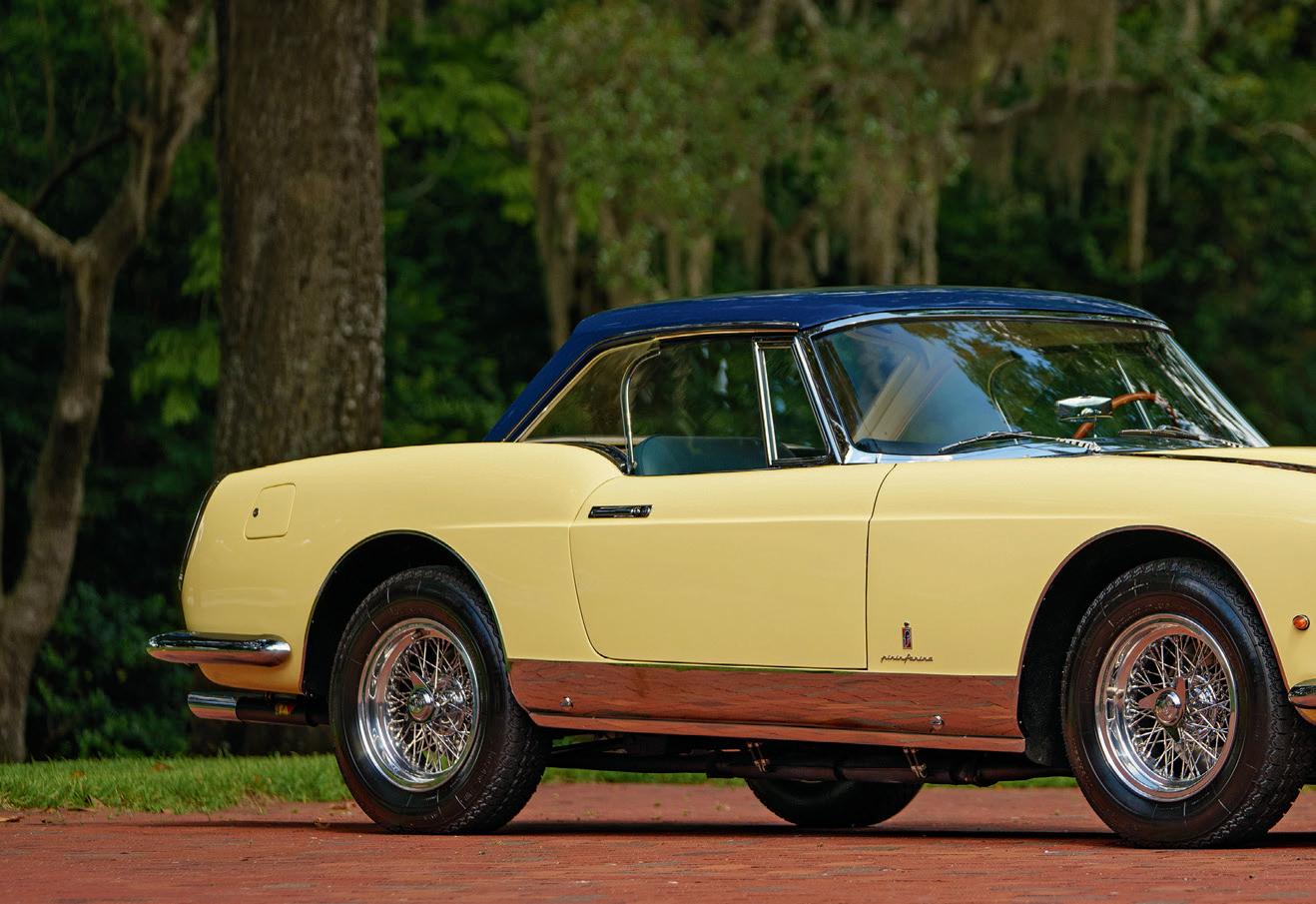
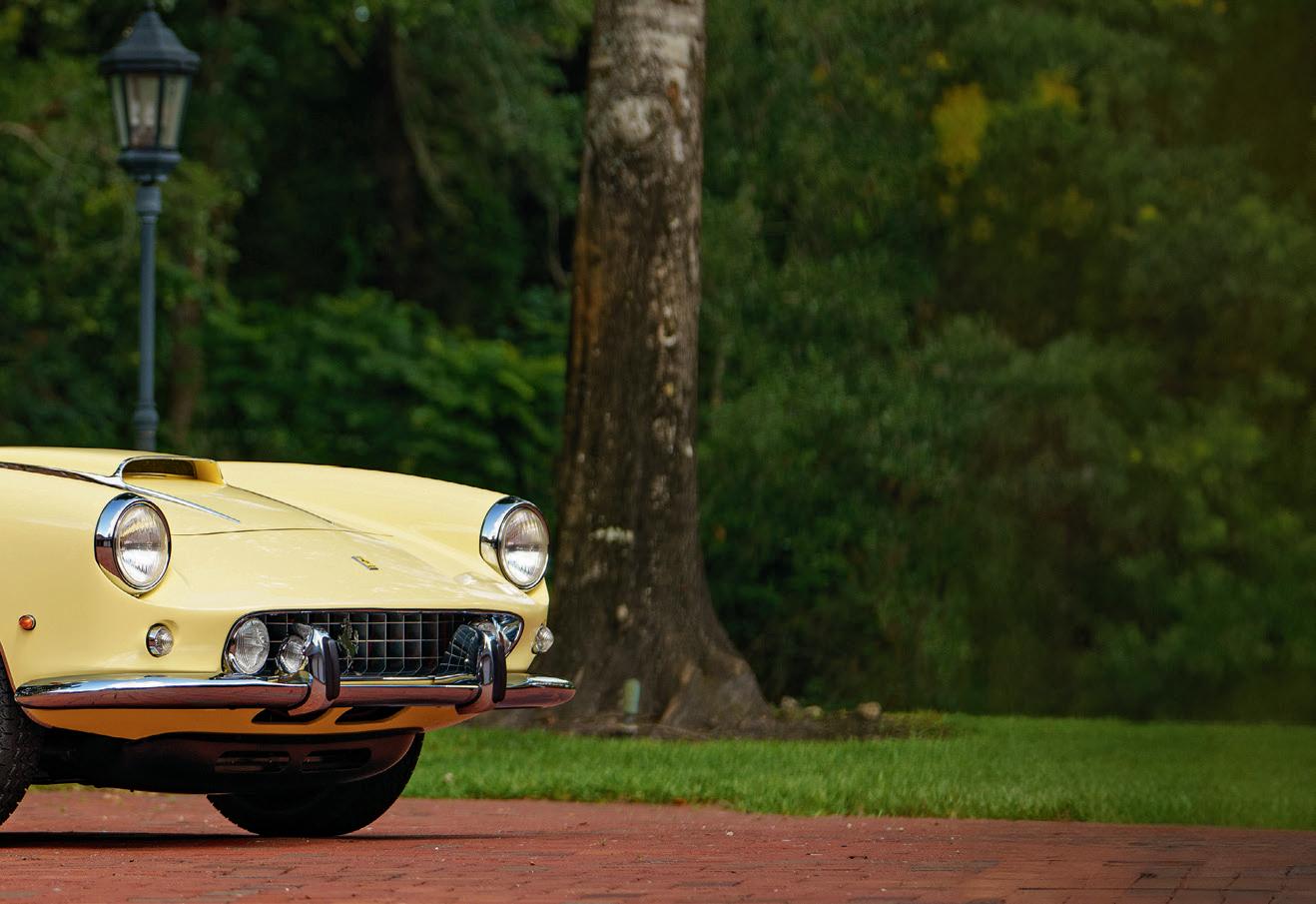
152 | 1961 FERRARI 400 SUPERAMERICA SERIES I CABRIOLET





